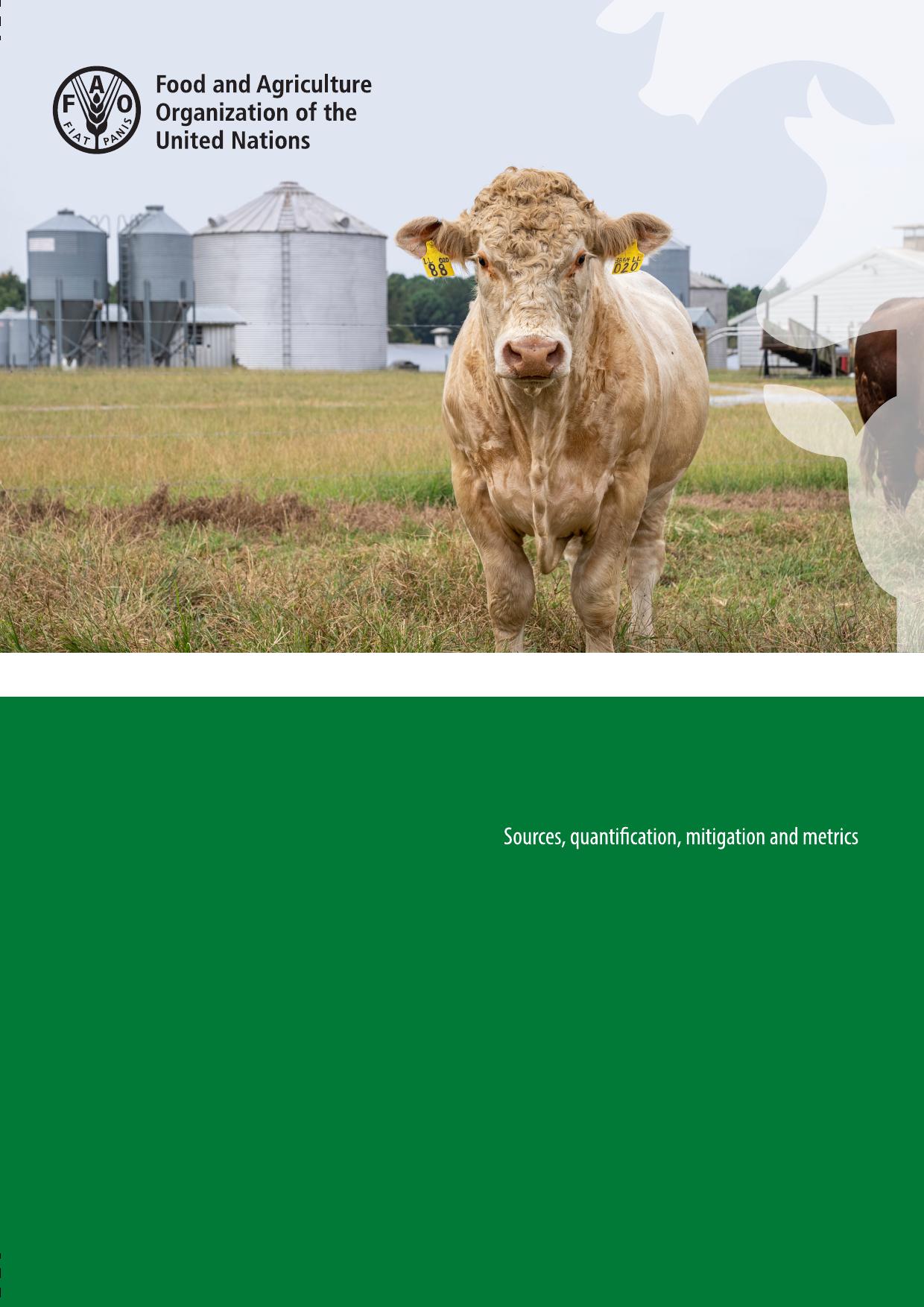MethaneemissionsinlivestockandricesystemsMethaneemissionsinlivestockandricesystemsSources,quantication,mitigationandmetricsFOODANDAGRICULTUREORGANIZATIONOFTHEUNITEDNATIONSRome,2023Requiredcitation:FAO.2023.Methaneemissionsinlivestockandricesystems–Sources,quantification,mitigationandmetrics.Rome.https://doi.org/10.4060/cc7607enThedesignationsemployedandthepresentationofmaterialinthisinformationproductdonotimplytheexpressionofanyopinionwhatsoeveronthepartoftheFoodandAgricultureOrganizationoftheUnitedNations(FAO)concerningthelegalordevelopmentstatusofanycountry,territory,cityorareaorofitsauthorities,orconcerningthedelimitationofitsfrontiersorboundaries.Thementionofspecificcompaniesorproductsofmanufacturers,whetherornotthesehavebeenpatented,doesnotimplythatthesehavebeenendorsedorrecommendedbyFAOinpreferencetoothersofasimilarnaturethatarenotmentioned.ISBN978-92-5-138148-9©FAO,2023Somerightsreserved.ThisworkismadeavailableundertheCreativeCommonsAttribution-NonCommercial-ShareAlike3.0IGOlicence(CCBY-NC-SA3.0IGO;https://creativecommons.org/licenses/by-nc-sa/3.0/igo/legalcode).Underthetermsofthislicence,thisworkmaybecopied,redistributedandadaptedfornon-commercialpurposes,providedthattheworkisappropriatelycited.Inanyuseofthiswork,thereshouldbenosuggestionthatFAOendorsesanyspecificorganization,productsorservices.TheuseoftheFAOlogoisnotpermitted.Iftheworkisadapted,thenitmustbelicensedunderthesameorequivalentCreativeCommonslicence.Ifatranslationofthisworkiscreated,itmustincludethefollowingdisclaimeralongwiththerequiredcitation:“ThistranslationwasnotcreatedbytheFoodandAgricultureOrganizationoftheUnitedNations(FAO).FAOisnotresponsibleforthecontentoraccuracyofthistranslation.Theoriginal[Language]editionshallbetheauthoritativeedition.”DisputesarisingunderthelicencethatcannotbesettledamicablywillberesolvedbymediationandarbitrationasdescribedinArticle8ofthelicenceexceptasotherwiseprovidedherein.TheapplicablemediationruleswillbethemediationrulesoftheWorldIntellectualPropertyOrganizationhttp://www.wipo.int/amc/en/mediation/rulesandanyarbitrationwillbeconductedinaccordancewiththeArbitrationRulesoftheUnitedNationsCommissiononInternationalTradeLaw(UNCITRAL).Third-partymaterials.Userswishingtoreusematerialfromthisworkthatisattributedtoathirdparty,suchastables,figuresorimages,areresponsiblefordeterminingwhetherpermissionisneededforthatreuseandforobtainingpermissionfromthecopyrightholder.Theriskofclaimsresultingfrominfringementofanythird-party-ownedcomponentintheworkrestssolelywiththeuser.Sales,rightsandlicensing.FAOinformationproductsareavailableontheFAOwebsite(www.fao.org/publications)andcanbepurchasedthroughpublications-sales@fao.org.Requestsforcommercialuseshouldbesubmittedvia:www.fao.org/contact-us/licence-request.Queriesregardingrightsandlicensingshouldbesubmittedto:copyright@fao.org.Coverphotograph:©MarkStebnickionPexelsContentsForewordxviAcknowledgementsxviiiDevelopmentprocessofthemethanereportxixMulti-stepreviewprocessxxiiiTheLivestockEnvironmentalAssessmentandPerformance(LEAP)PartnershipxxivAbbreviationsxxviExecutivesummaryxxxINTRODUCTION1PART1SOURCESANDSINKSOFMETHANEEMISSIONSINAGRICULTURE31.SOURCESOFMETHANE51.1Ruminantlivestockandentericmethanogenesis51.2Biochemistryofmethaneproductioninmicrobialanaerobicecosystems61.2.1Rumenmethanogenesis61.2.2Manure91.2.3Soil111.3Methaneemissionsduringthestorageofmanure141.4Methaneemissionsfollowingtheapplicationofmanure141.5Trade-offbetweenGHGandothergaseousemissions151.6Spatio-temporalvariationinmethaneemissions151.7Contributionofhumanfoodandanimalfeedwastetomethaneemissions161.8Anaerobicdigestion171.8.1Leakageofmethanefromanaerobicdigestionfacilities182.METHANESINKS192.1Soilmethanesink192.1.1Factorsaffectingthesoilmethanesinkcapacity192.1.2Landmanagementeffectsonthesoilmethanesink20PART2QUANTIFICATIONOFMETHANEEMISSIONS233.MEASUREMENT253.1Animal-basedtechniques253.1.1Gasexchangetechnique273.1.2Tracertechnique293.1.3Open-pathlasertechnique303.1.4Invitrotechniques31iii3.2Facility-basedtechniques313.2.1Manurestorages313.2.2Soilfluxes343.3Large-scaletechniques373.3.1Aircrafts373.3.2Satelliteanddroneimagery373.4Uncertainties384.ESTIMATION404.1Bottom-upapproaches404.1.1Modellingtoestimateentericmethane404.1.2Modellingtoestimatemanuremethane444.1.3Soil/cropmodelling444.2Top-downapproaches474.2.1Comparisonbetweenbottom-upandtop-downapproaches48PART3MITIGATIONOFMETHANEEMISSIONS495.MITIGATIONSTRATEGIESFORMETHANEEMISSIONS515.1Animalbreedingandmanagement:Increasedanimalproduction525.1.1Description525.1.2Modeofaction525.1.3Efficacy525.1.4Potentialtocombinewithothermitigationstrategies535.1.5Effectsonotheremissions535.1.6Productivityandthequalityofmeat,milk,manure,crop,andair535.1.7Safetyandhealthaspects535.1.8Adoptionpotential535.1.9Researchrequired535.2Animalbreedingandmanagement:Selectionforlowmethane-producinganimals545.2.1Description545.2.2Modeofaction545.2.3Efficacy545.2.4Potentialtocombinewithothermitigationstrategies545.2.5Effectsonotheremissions545.2.6Productivityandthequalityofmeat,milk,manure,crop,andair545.2.7Safetyandhealthaspects555.2.8Adoptionpotential555.2.9Researchrequired555.3Animalbreedingandmanagement:Improvedfeedefficiency555.3.1Description555.3.2Modeofaction565.3.3Efficacy565.3.4Potentialtocombinewithothermitigationstrategies565.3.5Effectsonotheremissions565.3.6Productivityandthequalityofmeat,milk,manure,crop,andair565.3.7Safetyandhealthaspects56iv5.3.8Adoptionpotential565.3.9Researchrequired565.4Animalbreedingandmanagement:Improvedanimalhealth575.4.1Description575.4.2Modeofaction575.4.3Efficacy575.4.4Potentialtocombinewithothermitigationstrategies575.4.5Effectsonotheremissions575.4.6Productivityandthequalityofmeat,milk,manure,crop,andair585.4.7Safetyandhealthaspects585.4.8Adoptionpotential585.4.9Researchrequired585.5Animalbreedingandmanagement:Improvedanimalreproduction585.5.1Description585.5.2Modeofaction595.5.3Efficacy595.5.4Potentialtocombinewithothermitigationstrategies595.5.5Effectsonotheremissions595.5.6Productivityandthequalityofmeat,milk,manure,crop,andair595.5.7Safetyandhealthaspects595.5.8Adoptionpotential595.5.9Researchrequired605.6Feedmanagement,dietformulationandprecisionfeeding:Increasedfeedinglevel605.6.1Description605.6.2Modeofaction605.6.3Efficacy605.6.4Potentialtocombinewithothermitigationstrategies615.6.5Effectsonotheremissions615.6.6Productivityandthequalityofmeat,milk,manure,crop,andair615.6.7Safetyandhealthaspects615.6.8Adoptionpotential615.6.9Researchrequired625.7Feedmanagement,dietformulationandprecisionfeeding:Decreasedforagetoconcentrateratio625.7.1Description625.7.2Modeofaction625.7.3Efficacy625.7.4Potentialtocombinewithothermitigationstrategies635.7.5Effectsonotheremissions635.7.6Productivityandthequalityofmeat,milk,manure,crop,andair635.7.7Safetyandhealthaspects635.7.8Adoptionpotential645.7.9Researchrequired645.8Feedmanagement,dietformulationandprecisionfeeding:Starchconcentratesourcesandprocessing645.8.1Description645.8.2Modeofaction645.8.3Efficacy65v5.8.4Potentialtocombinewithothermitigationstrategies655.8.5Effectsonotheremissions655.8.6Productivityandthequalityofmeat,milk,manure,crop,andair655.8.7Safetyandhealthaspects665.8.8Adoptionpotential665.8.9Researchrequired665.9Feedmanagement,dietformulationandprecisionfeeding:Supplementationoflipids665.9.1Description665.9.2Modeofaction665.9.3Efficacy675.9.4Potentialtocombinewithothermitigationstrategies685.9.5Effectsonotheremissions685.9.6Productivityandthequalityofmeat,milk,manure,crop,andair685.9.7Safetyandhealthaspects685.9.8Adoptionpotential685.9.9Researchrequired695.10Forages:Foragestorageandprocessing695.10.1Description695.10.2Modeofaction695.10.3Efficacy695.10.4Potentialtocombinewithothermitigationstrategies705.10.5Effectsonotheremissions705.10.6Productivityandthequalityofmeat,milk,manure,crop,andair705.10.7Safetyandhealthaspects705.10.8Adoptionpotential705.10.9Researchrequired705.11Forages:Increasedforagedigestibility715.11.1Description715.11.2Modeofaction715.11.3Efficacy715.11.4Potentialtocombinewithothermitigationstrategies715.11.5Effectsonotheremissions725.11.6Productivityandthequalityofmeat,milk,manure,crop,andair725.11.7Safetyandhealthaspects725.11.8Adoptionpotential725.11.9Researchrequired725.12Forages:Perenniallegumes725.12.1Description725.12.2Modeofaction735.12.3Efficacy735.12.4Potentialtocombinewithothermitigationstrategies735.12.5Effectsonotheremissions735.12.6Productivityandthequalityofmeat,milk,manure,crop,andair745.12.7Safetyandhealthaspects745.12.8Adoptionpotential745.12.9Researchrequired74vi5.13Forages:High-starchforages755.13.1Description755.13.2Modeofaction755.13.3Efficacy755.13.4Potentialtocombinewithothermitigationstrategies755.13.5Effectsonotheremissions755.13.6Productivityandthequalityofmeat,milk,manure,crop,andair765.13.7Safetyandhealthaspects765.13.8Adoptionpotential765.13.9Researchrequired765.14Forages:High-sugargrasses775.14.1Description775.14.2Modeofaction775.14.3Efficacy775.14.4Potentialtocombinewithothermitigationstrategies775.14.5Effectsonotheremissions775.14.6Productivityandthequalityofmeat,milk,manure,crop,andair785.14.7Safetyandhealthaspects785.14.8Adoptionpotential785.14.9Researchrequired785.15Forages:Pasturesandgrazingmanagement795.15.1Description795.15.2Modeofaction795.15.3Efficacy795.15.4Potentialtocombinewithothermitigationstrategies805.15.5Effectsonotheremissions805.15.6Productivityandthequalityofmeat,milk,manure,crop,andair805.15.7Safetyandhealthaspects805.15.8Adoptionpotential805.15.9Researchrequired815.16Rumenmanipulation:Ionophores815.16.1Description815.16.2Modeofaction815.16.3Efficacy815.16.4Potentialtocombinewithothermitigationstrategies825.16.5Effectsonotheremissions825.16.6Productivityandthequalityofmeat,milk,manure,crop,andair825.16.7Safetyandhealthaspects825.16.8Adoptionpotential835.16.9Researchrequired835.17Rumenmanipulation:Chemicalinhibitorsofmethaneproduction835.17.1Description835.17.2Modeofaction835.17.3Efficacy835.17.4Potentialtocombinewithothermitigationstrategies845.17.5Effectsonotheremissions845.17.6Productivityandthequalityofmeat,milk,manure,crop,andair845.17.7Safetyandhealthaspects84vii5.17.8Adoptionpotential845.17.9Researchrequired855.18Rumenmanipulation:3-nitrooxypropanol(3-NOP)855.18.1Description855.18.2Modeofaction855.18.3Efficacy855.18.4Potentialtocombinewithothermitigationstrategies865.18.5Effectsonotheremissions865.18.6Productivityandthequalityofmeat,milk,manure,crop,andair875.18.7Safetyandhealthaspects875.18.8Adoptionpotential885.18.9Researchrequired885.19Rumenmanipulation:Immunizationagainstmethanogens895.19.1Description895.19.2Modeofaction895.19.3Efficacy895.19.4Potentialtocombinewithothermitigationstrategies895.19.5Effectsonotheremissions895.19.6Productivityandthequalityofmeat,milk,manure,crop,andair895.19.7Safetyandhealthaspects895.19.8Adoptionpotential905.19.9Researchrequired905.20Rumenmanipulation:Bromoform-containingseaweeds(Asparagopsissp.)905.20.1Description905.20.2Modeofaction915.20.3Efficacy915.20.4Potentialtocombinewithothermitigationstrategies915.20.5Effectsonotheremissions915.20.6Productivityandthequalityofmeat,milk,manure,crop,andair915.20.7Safetyandhealthaspects925.20.8Adoptionpotential925.20.9Researchrequired935.21Rumenmanipulation:Otherseaweeds935.21.1Description935.21.2Modeofaction935.21.3Efficacy935.21.4Potentialtocombinewithothermitigationstrategies935.21.5Effectsonotheremissions945.21.6Productivityandthequalityofmeat,milk,manure,crop,andair945.21.7Safetyandhealthaspects945.21.8Adoptionpotential945.21.9Researchrequired955.22Rumenmanipulation:Defaunation955.22.1Description955.22.2Modeofaction955.22.3Efficacy965.22.4Potentialtocombinewithothermitigationstrategies965.22.5Effectsonotheremissions96viii5.22.6Productivityandthequalityofmeat,milk,manure,crop,andair965.22.7Safetyandhealthaspects975.22.8Adoptionpotential975.22.9Researchrequired975.23Rumenmanipulation:Alternativeelectronacceptors975.23.1Description975.23.2Modeofaction975.23.3Efficacy985.23.4Potentialtocombinewithothermitigationstrategies995.23.5Effectsonotheremissions995.23.6Productivityandthequalityofmeat,milk,manure,crop,andair1005.23.7Safetyandhealthaspects1005.23.8Adoptionpotential1005.23.9Researchrequired1015.24Rumenmanipulation:Essentialoils1015.24.1Description1015.24.2Modeofaction1015.24.3Efficacy1025.24.4Potentialtocombinewithothermitigationstrategies1035.24.5Effectsonotheremissions1035.24.6Productivityandthequalityofmeat,milk,manure,crop,andair1035.24.7Safetyandhealthaspects1035.24.8Adoptionpotential1045.24.9Researchrequired1045.25Rumenmanipulation:Tanninextracts1045.25.1Description1045.25.2Modeofaction1045.25.3Efficacy1045.25.4Potentialtocombinewithothermitigationstrategies1055.25.5Effectsonotheremissions1055.25.6Productivityandthequalityofmeat,milk,manure,crop,andair1065.25.7Safetyandhealthaspects1065.25.8Adoptionpotential1065.25.9Researchrequired1075.26Rumenmanipulation:Saponins1075.26.1Description1075.26.2Modeofaction1075.26.3Efficacy1075.26.4Potentialtocombinewithothermitigationstrategies1085.26.5Effectsonotheremissions1085.26.6Productivityandthequalityofmeat,milk,manure,crop,andair1085.26.7Safetyandhealthaspects1085.26.8Adoptionpotential1095.26.9Researchrequired1095.27Rumenmanipulation:Biochar1095.27.1Description1095.27.2Modeofaction1095.27.3Efficacy109ix5.27.4Potentialtocombinewithothermitigationstrategies1105.27.5Effectsonotheremissions1105.27.6Productivityandthequalityofmeat,milk,manure,crop,andair1105.27.7Safetyandhealthaspects1105.27.8Adoptionpotential1105.27.9Researchrequired1105.28Rumenmanipulation:Direct-fedmicrobials1115.28.1Description1115.28.2Modeofaction1115.28.3Efficacy1115.28.4Potentialtocombinewithothermitigationstrategies1125.28.5Effectsonotheremissions1125.28.6Productivityandthequalityofmeat,milk,manure,crop,andair1125.28.7Safetyandhealthaspects1125.28.8Adoptionpotential1125.28.9Researchrequired1135.29Rumenmanipulation:Earlylifeinterventions1135.29.1Description1135.29.2Modeofaction1135.29.3Efficacy1135.29.4Potentialtocombinewithothermitigationstrategies1145.29.5Effectsonotheremissions1145.29.6Productivityandthequalityofmeat,milk,manure,crop,andair1145.29.7Safetyandhealthaspects1155.29.8Adoptionpotential1155.29.9Researchrequired1155.30Rumenmanipulation:Phageandlyticenzymesactiveagainstmethanogens1155.30.1Description1155.30.2Modeofaction1165.30.3Efficacy1165.30.4Potentialtocombinewithothermitigationstrategies1165.30.5Effectsonotheremissions1165.30.6Productivityandthequalityofmeat,milk,manure,crop,andair1165.30.7Safetyandhealthaspects1165.30.8Adoptionpotential1165.30.9Researchrequired1175.31Summarytables1176.M�ITIGATIONSTRATEGIESFORMETHANEEMISSIONSFROMANIMALHOUSING,MANUREMANAGEMENTANDLANDAPPLICATION1256.1Biogascollectionandutilization1276.1.1Description1276.1.2Modeofaction1276.1.3Efficacy1276.1.4Potentialtocombinewithothermitigationstrategies1276.1.5Effectsonotheremissions1276.1.6Productivityandthequalityofmeat,milk,manure,crop,andair1276.1.7Safetyandhealthaspects127x6.1.8Adoptionpotential1286.1.9Researchrequired1286.2Decreasedmanurestoragetemperature1286.2.1Description1286.2.2Modeofaction1286.2.3Efficacy1286.2.4Potentialtocombinewithothermitigationstrategies1286.2.5Effectsonotheremissions1286.2.6Productivityandthequalityofmeat,milk,manure,crop,andair1286.2.7Safetyandhealthaspects1286.2.8Adoptionpotential1286.2.9Researchrequired1296.3Manureacidificationthroughdietarymeasures1296.3.1Description1296.3.2Modeofaction1296.3.3Efficacy1296.3.4Potentialtocombinewithothermitigationstrategies1296.3.5Effectsonotheremissions1306.3.6Productivityandthequalityofmeat,milk,manure,crop,andair1306.3.7Safetyandhealthaspects1306.3.8Adoptionpotential1306.3.9Researchrequired1306.4Manureacidificationthroughdirectamendment1306.4.1Description1306.4.2Modeofaction1306.4.3Efficacy1306.4.4Potentialtocombinewithothermitigationstrategies1306.4.5Effectsonotheremissions1306.4.6Productivityandthequalityofmeat,milk,manure,crop,andair1316.4.7Safetyandhealthaspects1316.4.8Adoptionpotential1316.4.9Researchrequired1316.5Methaneinhibitors1316.5.1Description1316.5.2Modeofaction1316.5.3Efficacy1316.5.4Potentialtocombinewithothermitigationstrategies1316.5.5Effectsonotheremissions1326.5.6Productivityandthequalityofmeat,milk,manure,crop,andair1326.5.7Safetyandhealthaspects1326.5.8Adoptionpotential1326.5.9Researchrequired1326.6Decreasedmanurestorageinterval1326.6.1Description1326.6.2Modeofaction1326.6.3Efficacy1326.6.4Potentialtocombinewithothermitigationstrategies1326.6.5Effectsonotheremissions132xi6.6.6Productivityandthequalityofmeat,milk,manure,crop,andair1326.6.7Safetyandhealthaspects1336.6.8Adoptionpotential1336.6.9Researchrequired1336.7Solid–liquidseparation1336.7.1Description1336.7.2Modeofaction1336.7.3Efficacy1336.7.4Potentialtocombinewithothermitigationstrategies1336.7.5Effectsonotheremissions1336.7.6Productivityandthequalityofmeat,milk,manure,crop,andair1336.7.7Safetyandhealthaspects1336.7.8Adoptionpotential1346.7.9Researchrequired1346.8Manurecomposting/aeration1346.8.1Description1346.8.2Modeofaction1346.8.3Efficacy1346.8.4Potentialtocombinewithothermitigationstrategies1346.8.5Effectsonotheremissions1346.8.6Productivityandthequalityofmeat,milk,manure,crop,andair1346.8.7Safetyandhealthaspects1356.8.8Adoptionpotential1356.8.9Researchrequired1356.9Biofiltersandscrubbers1356.9.1Description1356.9.2Modeofaction1356.9.3Efficacy1356.9.4Potentialtocombinewithothermitigationstrategies1356.9.5Effectsonotheremissions1356.9.6Productivityandthequalityofmeat,milk,manure,crop,andair1356.9.7Safetyandhealthaspects1356.9.8Adoptionpotential1356.9.9Researchrequired1366.10Manureincorporationandinjection1366.10.1Description1366.10.2Modeofaction1366.10.3Efficacy1366.10.4Potentialtocombinewithothermitigationstrategies1366.10.5Effectsonotheremissions1366.10.6Productivityandthequalityofmeat,milk,manure,crop,andair1366.10.7Safetyandhealthaspects1376.10.8Adoptionpotential1376.10.9Researchrequired1376.11Manureapplicationtiming1376.11.1Description1376.11.2Modeofaction1376.11.3Efficacy137xii6.11.4Potentialtocombinewithothermitigationstrategies1376.11.5Effectsonotheremissions1376.11.6Productivityandthequalityofmeat,milk,manure,crop,andair1386.11.7Safetyandhealthaspects1386.11.8Adoptionpotential1386.11.9Researchrequired1386.12Nutritionalstrategies1386.12.1Description1386.12.2Modeofaction1386.12.3Efficacy1386.12.4Potentialtocombinewithothermitigationstrategies1386.12.5Effectsonotheremissions1386.12.6Productivityandthequalityofmeat,milk,manure,crop,andair1386.12.7Safetyandhealthaspects1386.12.8Adoptionpotential1396.12.9Researchrequired1396.13Grazingpractices–Productionsystem1397.MITIGATIONOFMETHANEEMISSIONFROMRICEPADDIES1407.1Watermanagement1407.2Organicamendments1417.3Fertilizerandotheramendments1427.4Plantingmethodsandcropmanagementpackages1427.5Selecting/breedingricevarieties1437.6Reducingmethanefromstrawburning1437.7Choiceofoptions1447.8Newlyemergingtechnologies1458.CROSS-CUTTINGMETHANEMITIGATION1468.1Generalguidancefortakinganintegratedapproachtomethanemitigationstrategies1468.2LCAscenarioanalysisforintensivesystems1498.3LCAscenarioanalysisforlessintensivesystems150PART4METRICSFORQUANTIFYINGTHEIMPACTOFMETHANEEMISSIONS1539.INTRODUCTION1559.1Contextanddefinitions1579.1.1KeyprinciplesofGHGemissionmetrics1579.1.2Pulse-emissionmetrics1599.1.3Step-pulsemetrics1619.1.4Keydifferencesbetweenstep-pulseandpulse-metrics1659.1.5Timehorizon/endpointformetrics1689.1.6Discountratesconsideration1689.1.7Non-radiativeforcingimpacts1699.2TheuseofGHGmetricsinimpactandmitigationapplications1709.2.1Lifecycleassessmentandcarbonfootprinting171xiii9.2.2Cost-benefitassessmentofclimatechangemitigation1729.2.3Cost-effectivenessofdifferentmitigationoptions1749.2.4Overallemissionreductionpolicyandtheroleofagriculture1759.2.5Cross-sectorcomparisons1789.2.6AggregationofdifferentGHGsforreportingandaccounting1809.2.7Biogenicmethane–Implicationsformetrics1809.3Climatetargetsandrelatedissues1819.3.1TheParisAgreement1829.3.2Climateneutrality1849.3.3Methaneabatementandsustainableagriculture1889.3.4Equityconsiderations1889.4Metricselectionguide1909.4.1Pointstoconsider1909.4.2Examples1969.4.3SummaryofkeyfeaturesandlimitationsofGWP,GWPandGTP203CONCLUSION205REFERENCES207APPENDIX307DETAILSOFCASESTUDIES309TABLES1.Characteristicsofdifferenttechniquesusedtomeasuremethane262.Summaryofentericmethanemitigationstrategiesforconfinedruminant(beef,dairyorother)systems1193.Summaryofentericmethanemitigationstrategiesforextensivepastoral/ranchingsystems(beef,dairyorother)basedongrazingwithoutsupplementation1214.Summaryofentericmethanemitigationstrategiesformixedgrazingwithsupplementationofconcentrates,by-productsandconservedforages1235.Mitigationstrategiesformethaneemissionsfromanimalhousing,manurestorageandlandapplication1266.GWPvaluesfromtheIPCC’sSixthAssessmentReport(AR6)1607.GTPvaluesbasedonformulaefromtheIPCC’sSixthAssessmentReport(AR6)1618.GWPvaluesformethaneacrossthedifferenthistoricalIPCCreports1839.AnnualemissionsassociatedwiththefarminExample119610.Changeinannualemissionsfromusingthefeedadditivecomparedtothecontrolfarm,aggregatedusingGWP,GTPandGWP197A1.Absoluteemissionswhenusingthefeedadditive,relativetonoemissions,aggregatedusingGWP,GTPandGWP310xivFIGURES1.Mainbiochemicalpathwaysinrumenfermentation72.Simplifiedschemeofthemainpathwaysofanaerobicdigestion103.Methanedynamicsinfloodedricesoil134.Aschematicflowchartofcurrenttechniquesusedtodeterminemethaneemissionsattheanimal,facilityandlarge-scalelevels255.SystemboundaryofthelifecycleassessmentfortheCalifornianmilkproduction1516.Thecause–effectchainfromemissionstoclimatechangeimpacts1577.Differenteffectsonradiativeforcingandtemperaturechangeoronegigatonne(Gt)ofCO2,CH4andN2Opulseemissions1588.Anillustrationofhowrising(left),constant(middle)andfalling(right)emissionsofCO2(red)andCH4(blue)affectlevelsofglobalwarming1639.CumulativeCO2-equivalentemissionsofmethaneareshown,calculatedusingdifferentmetrics,fortwomitigationscenariosnamedSSP4-6.0(panela)andSSP1-2.6(panelb)16410.ContributionstoglobalwarmingfromglobalnetCO2emissionsandglobalCH4emissionsfromlivestock,inapathwaythatlimitsglobalwarmingto1.5degreeswithlimitedovershoot16611.Sectoralcontributiontoannualtotalgreenhousegasemissionsin2010weightedbythreedifferentgreenhousegasmetrics,GWP100,GWP20andGTP10017912.Modelledglobaltemperatureanomaliesfrom1850to2015forallanthropogenicemissions17913.Scenarioscomputedusingtheaggregatedcarboncycle,atmosphericchemistryandclimate(ACC2)model19914.CO2eqandCO2-weemissionsfromthethreefarmscalculatedusingGWP100andGWP202A1.AdditionalresultsforExample1311A2.DetailedresultsforExample1(evaluationofemissionmetricsinrepresentingthebenefitsofusingafeedadditive)312A3.DetailedresultsforExample2(illustratingthepathdependencyofstep-pulsemetricsinrepresentingtheimpactofthreefarmerswithdifferenthistoricalemissions)313xvForewordMethaneisashort-livedgaswithanatmosphericlifetimeofaroundadecade,whereasthedominantgreenhousegas,carbondioxide,affectstheglobalclimateforhundredsofyears.Accordingtothe2021SixthAssessmentReportoftheIntergovernmentalPanelonClimateChange,methaneemissionsfromanthro-pogenicactivitiescurrentlycontributeabout0.5°Ctoobservedglobalwarming.Reducingmethanelevelshasbeenidentifiedasacrucial–andrapid-steptowardsslowingdownglobalwarming.Mostanthropogenicmethaneemissionsfromagrifoodsystemsresultfromtheentericfermentationofruminantlivestockandtheanaerobicdigestionofanimalmanureaswellasotherorganicwastes,whichinvolvecomplexmetabolicinteractionsbetweenmicrobialgroups.Byjoiningoureffortstoreducemethaneemissionsfromlivestockandricesystems,agrifoodsystemswillcontributetotheGlobalMethanePledge,anon-bindinginitiativesignedby150countriesatthe26thUNClimateConferencein2021.Curbingmethaneemissionsisanintegralpartofthestrategiesaimedatlimitingtheglobaltemperatureincreasetowellbelow2°Candpreferablyto1.5°Cabovethepreindustriallevel,inlinewiththeParisAgreementandwithSustainableDevelopmentGoal13onclimateaction.Thisgoalalsochimeswiththecalltoraiseambitionsforthemitigationcommitmentsandtargetsoutlinedinnation-allydeterminedcontributions.Forthefirsttime,FAO,throughtheLivestockEnvironmentalAssessmentandPerformancePartnership(LEAP),providesacomprehensivepictureandrobustanalysisofmethaneemissionsinlivestockandricesystems.DevelopedbytheFAOLEAPPartnershiptechnicaladvisorygrouponmethane,amultidisciplinaryteamcomposedof54internationalscientistsandexperts,thisreportanalysesthesourcesandsinksofmethanerelatedtolivestockaswellasriceproductionsystems,summa-rizesexistingtechnicalandinnovativemitigationsolutions,andevaluatesmetricstoquantifytheimpactsofmethaneemissionsontheclimate.Thegroupanalysedawiderangeofscientificpaperstooffervaluableinsightsandprovidescientificevidencethatpolicymakersandstakeholders–includingthepublic,theprivatesector,non-stateentitiesandproducers’organizations–canusetodesignandimplementtechnicalmitigationstrategiesandformulatepolicyframeworkstoenhanceclimateactionsinthecontextoflivestockandricesystems.ReducinggreenhousegasemissionsisanimportantcomponentoftheFAOStrategyonClimateChangeandoftheOrganization’sStrategicFramework2022-2031foundedonbetterproduction,betterlife,betternutritionandbetterenviron-ment.ThisreportcontributestoabetterenvironmentandsupportsMembersininte-gratingspecificmethanemitigationinterventionsandtargetsintonationalclimateactionsasrequestedatthefirstsessionoftheSub-CommitteeonLivestockofFAO’sCommitteeonAgriculture(COAG)(https://www.fao.org/3/ni966en/ni966en.pdf,paragraph25).xviIhopethattheresultsandrecommendationsofthisreportbolstertheeffortsofcountriesandstakeholderscommittedtoreducingmethaneemissionsand,indoingso,movesustowardsmoreefficient,inclusive,resilient,low-emissionandsustainableagrifoodsystems.MariaHelenaSemedoDeputyDirector-GeneralxviiAcknowledgementsThisreportwaspreparedbythetechnicaladvisorygrouponmethane(MethaneTAG)oftheFAOLivestockEnvironmentalAssessmentandPerformancePartnership(FAOLEAPPartnership).TheSteeringCommitteeofFAOLEAPPartnershipprovidedtheoverallguidanceforthedevelopmentofthisreport.ThePartnershipwasco-chairedbyTimMcAllister,AgricultureandAgri-FoodCanada(2021),HenningSteinfeld,FAO(untilJuly2022),HsinHuang,InternationalMeatSecretariat(2022),ThanawatTiensin,DirectorofFAOAnimalProductionandHealthDivision(sinceJanuary2023),JulieAdamchick,WorldWildlifeFoundation(sinceFebruary2023).TheSecretariatoftheFAOLEAPPartnershipwascoordinatedbyTimRobinson,FAO(untilJune2022)andAimableUwizeye,FAO(fromAugust2022).CamilloDeCamillis,FAO(untilApril2022)andXiangyuSong,FAO(fromDecember2022)wereresponsiblefortheday-to-daymanagementoftheFAOLEAPPartnership.xviiiDevelopmentprocessofthemethanereportTheMethaneTAGwascomposedof54internationalexpertsinanimalsciences,climatesciences,physics,plantsciences,soilsciencesandenvironmentalsciences.TheMethaneTAGwasestablishedinDecember2020andmetvirtuallyinthecourseofseveralmeetings.Itwasco-ledbyErmiasKebreab(Co-Chair,UniversityofCalifornia,Davis,UnitedStatesofAmerica),MichelleCain(Co-Chair,CranfieldEnvironmentCentre,CranfieldUniversity,UnitedKingdomofGreatBritainandNorthernIreland)andJunMurase(Co-Chair,GraduateSchoolofBioagriculturalSciences,NagoyaUniversity,Japan),withthetechnicalsupportofAimableUwizeye(CoordinatorofFAOLEAPSecretariat,Italy).PART1.SOURCESANDSINKSOFMETHANEEMISSIONSINAGRICULTUREDavidKenny(Teagasc,AnimalandGrasslandResearchandInnovationCentre,Ireland)ledtheresearchandwritingofthispart.Itwasco-authoredbyEmilioM.Ungerfeld(CentroRegionaldeInvestigaciónCarillanca,InstitutodeInvestigacionesAgropecuarias[INIA],Chile),ClementinaÁlvarez(DepartmentofResearch,TINESA,Norway),MélyndaHassouna(NationalInstituteforAgriculture,FoodandEnvironment[INRAE],InstitutAgroRennes,France),RogerioM.Mauricio(DepartmentofBioengineering,FederalUniversityofSãoJoãodel-Rei,Brazil),PhilippeBecquet(InternationalFeedIndustryFederation,Germany),AdibeL.Abdalla(CenterforNuclearEnergyinAgriculture,UniversityofSãoPaulo,Brazil),DiptiPitta(UniversityofPennsylvania,UnitedStates),Jean-BaptisteDollé(IDELE,France),MariaPazTieri(FONTAGRO,Spain),MichaëlMathot(AgriculturalSystemsUnit,WalloonAgriculturalResearchCentre,Belgium),BrianG.McConkey(VirescoSolutionsInc.,Canada),AlexandreBerndt(EmbrapaSoutheastLivestock,Brazil),JuliánChará(CenterforResearchonSustainableAgriculture[CIPAV],Colombia)andJunMurase(NagoyaUniversity,Japan).PART2.QUANTIFICATIONOFMETHANEEMISSIONSLuisO.Tedeschi(DepartmentofAnimalSciences,TexasA&MUniversity,UnitedStates)ledthewritingofthispart.Itwasco-authoredbyAdibeL.Abdalla(CenterforNuclearEnergyinAgriculture,UniversityofSãoPaulo,Brazil),ClementinaÁlvarez(DepartmentofResearch,TINESA,Norway),SamuelW.Anuga(EuropeanUniversityInstitute,Italy),JacoboArango(InternationalCenterforTropicalAgriculture[CIAT],Colombia),KarenA.Beauchemin(AgricultureandAgri-FoodCanada,LethbridgeResearchandDevelopmentCentre,Canada),EmilioM.Ungerfeld(CentroRegionaldeInvestigaciónCarillanca,InstitutodeInvestigacionesAgropecuarias[INIA],Chile),PhilippeBecquet(InternationalFeedIndustryFederation,Germany),AlexandreBerndt(EmbrapaSoutheastLivestock,Brazil),RobertBurns(UniversityofTennessee,Knoxville,UnitedStates),CamilloDeCamillis(AnimalProductionandHealthDivision,FAO,Italy),JuliánCharáxix(CenterforResearchonSustainableAgriculture[CIPAV],Colombia),JavierM.Echazarreta(CentroCarnes–InstitutoNacionaldeTecnologíaIndustrial[INTI],Argentina),MélyndaHassouna(NationalResearchInstituteforAgriculture,FoodandEnvironment(INRAE),InstitutAgroRennes,France),DavidKenny(Teagasc,AnimalandGrasslandResearchandInnovationCentre,Ireland),MichaëlMathot(AgriculturalSystemsUnit,WalloonAgriculturalResearchCentre,Belgium),RogerioM.Mauricio(DepartmentofBioengineering,FederalUniversityofSãoJoãodel-Rei,Brazil),ReinerWassmann(Independentresearcher,previouslyworkingfortheInternationalRiceResearchInstitute),VinisaSaynes(LandandWaterDivision,FAO,Italy),ShelbyC.McClelland(AnimalProductionandHealthDivision,FAO,Italy,SoilandCropSciences,SchoolofIntegrativePlantScience,CornellUniversity,UnitedStates),MutianNiu(InstituteofAgriculturalSciences,ETHZürich,Switzerland),AliceAnyangoOnyango(MazingiraCenter,InternationalLivestockResearchInstitute[ILRI]andDepartmentofChemistry,MasenoUniversity,Kenya),RanjanParajuli(EcoEngineers,UniversityofArkansas,UnitedStates),LuizG.RibeiroPereira(Embrapa,Brazil),AgustíndelPrado(BasqueCentreforClimateChange[BC3]andIkerbasque,BasqueFoundationforScience,Spain),MariaPazTieri(FONTAGRO,Spain),AimableUwizeye(AnimalProductionandHealthDivision,FAO,Italy),JunMurase(NagoyaUniversity,Japan),andErmiasKebreab(DepartmentofAnimalScience,UniversityofCalifornia,Davis,UnitedStates).Part1andPart2weresummarizedandpublishedinapeer-reviewedjournal:Tedeschietal.2022.Quantificationofmethaneemittedbyruminants:Areviewofmethods.JournalofAnimalScience,100(7):1-22,https://doi.org/10.1093/jas/skac197.PART3.MITIGATIONOFMETHANEEMISSIONSKarenA.Beauchemin(AgricultureandAgri-FoodCanada,LethbridgeResearchandDevelopmentCentre,Canada)andEmilioM.Ungerfeld(CentroRegionaldeInvestigaciónCarillanca,InstitutodeInvestigacionesAgropecuarias[INIA],Chile)ledthedevelopmentofthispart.Itwasco-authoredbyAdibeL.Abdalla(CenterforNuclearEnergyinAgriculture,UniversityofSãoPaulo,Brazil),ClementinaÁlvarez(DepartmentofResearch,TINESA,Norway),ClaudiaArndt(InternationalLivestockResearchInstitute[IRLI],Kenya),PhilippeBecquet(InternationalFeedIndustryFederation,Germany),ChaoukiBenchaar(SherbrookeResearchandDevelopmentCentre,AgricultureandAgri-FoodCanada,Canada),AlexandreBerndt(EmbrapaSoutheastLivestock,Brazil),AgustíndelPrado(BasqueCentreforClimateChange[BC3],Ikerbasque,BasqueFoundationforScience,Spain),DavidKenny(Teagasc,AnimalandGrasslandResearchandInnovationCentre,Ireland),JohnLynch(UniversityofOxford,UnitedKingdom),RogerioM.Mauricio(DepartmentofBioengineering,FederalUniversityofSãoJoãodel-Rei,Brazil),TimA.McAllister(AgricultureandAgri-FoodCanada,LethbridgeResearchandDevelopmentCentre,Canada),MutianNiu(InstituteofAgriculturalSciences,ETHZürich,Switzerland),WalterOyhantçabal(FacultaddeAgronomía,UniversidaddelaRepública,Uruguay),AndyReisinger(Independentconsultant,NewZealand),SaheedA.Salami(MootralLtd,UnitedKingdom),LaurenceShalloo(Teagasc,AnimalandGrasslandResearchandInnovationDepartment,Ireland),YanSun(CargillInc.,UnitedStates),MariaPazTieri(FONTAGRO,Spain),JuanM.Tricarico(InnovationCenterforU.S.Dairy,UnitedStates),AimableUwizeye(AnimalProductionandHealthDivision,xxFAO,Italy),CamilloDeCamillis(AnimalProductionandHealthDivision,FAO,Italy),MartialBernoux(OfficeofClimateChange,BiodiversityandEnvironment,FAO,Italy),TimothyRobinson(AnimalProductionandHealthDivision,FAO,Italy),JunMurase(NagoyaUniversity,Japan),andErmiasKebreab(DepartmentofAnimalScience,UniversityofCalifornia,Davis,UnitedStates).Part3wassummarizedandpublished:Beaucheminetal.2022.Invitedreview:Currententericmethanemitigationoptions.JournalofDairyScience,105(12):9297-9326.https://doi.org/10.3168/jds.2022-22091.PART4.METRICSFORQUANTIFYINGTHEIMPACTOFMETHANEEMISSIONSThedevelopmentofthischapterwasledbyMichelleCain(CranfieldUniversity,UnitedKingdom),withsectionsco-ledbyJohnLynch(UniversityofOxford,UnitedKingdom)forSection9,WilliamJ.Collins(DepartmentofMeteorology,UniversityofReading,UnitedKingdom)forSection9.1,MikoKirschbaum(ManaakiWhenua–LandcareResearch,NewZealand)forSection9.2,BradRidoutt(CommonwealthScientificandIndustrialResearchOrganisation[CSIRO],AgricultureandFood,AustraliaandDepartmentofAgriculturalEconomics,UniversityoftheFreeState,Bloemfontein,SouthAfrica)andAgustíndelPrado(BasqueCentreforClimateChange[BC3]andIkerbasque,BasqueFoundationforScience,Spain)forSection9.3,whileKatsumasaTanaka(LaboratoiredesSciencesduClimatetdel’Environnement[LSCE],FranceandNationalInstituteforEnvironmentalStudies[NIES],Japan)co-ledSection9.4.Thispartwasco-authoredbyJuanM.Tricarico(InnovationCenterforU.S.Dairy,UnitedStates),AdibeL.Abdalla(CenterforNuclearEnergyinAgriculture,UniversityofSãoPaulo,Brazil),AlexandreBerndt(EmbrapaSoutheastLivestock,Brazil).JavierM.Echazarreta(CentroCarnes–InstitutoNacionaldeTecnologíaIndustrial[INTI],Argentina)ClementinaÁlvarez(DepartmentofResearch,TINESA,Norway),LuizG.Ribeiro(Embrapa,Brazil),LuisO.Tedeschi(DepartmentofAnimalSciences,TexasA&MUniversity,UnitedStates),EmilioM.Ungerfeld(CentroRegionaldeInvestigaciónCarillanca,InstitutodeInvestigacionesAgropecuarias[INIA],Chile),ErmiasKebreab(UniversityofCalifornia,Davis,UnitedStates),MunavarZhumanova(CenterforGlobalChangeandEarthObservations,MichiganStateUniversity,UnitedStates),BrianG.McConkey(VirescoSolutionsInc.,Canada),KarenA.Beauchemin(AgricultureandAgri-FoodCanada,LethbridgeResearchandDevelopmentCentre,Canada),AndyReisinger(Independentconsultant,NewZealand),AnnaFlysjö(ArlaFoods,Sweden),DiptiPitta(UniversityofPennsylvania,UnitedStates),Jean-BaptisteDollé(IDELE,France),JuliánChará(CenterforResearchonSustainableAgriculture[CIPAV],Colombia),MariaPazTieri(FONTAGRO,Spain),FrankMitloehner(UniversityofCalifornia,Davis,UnitedStates),SamuelWenifaAnuga(EuropeanUniversityInstitute,Italy),SaheedA.Salami(MootralLtd,UnitedKingdom),AndréMazzetto(AgResearch,NewZealand),ClaudiaArndt(InternationalLivestockResearchInstitute[IRLI],Kenya),ChaoukiBenchaar(AgricultureandAgri-FoodCanada,Canada),JacoboArango(InternationalCenterforTropicalAgriculture[CIAT],Colombia),JoeriRogelj(CentreforEnvironmentalPolicy,ImperialCollegeLondon,UnitedKindom),MutianNiu(InstituteofAgriculturalSciences,ETHZürich,Switzerland),StephanPfister(ETHZürich,Switzerland),Carl-FriedrichSchleussner(HumboldtUniversitätxxizuBerlin,Germany),WalterH.Oyhantçabal(Cironi,MinistryofLivestock,AgricultureandFisheries,Uruguay),RanjanParajuli(EcoEngineers,UniversityofArkansas,UnitedStates),DavidKenny(Teagasc,AnimalandGrasslandResearchandInnovationDepartment,Ireland),JacobP.Muhondwa(ArdhiUniversity,Tanzania),MélyndaHassouna(NationalResearchInstituteforAgriculture,FoodandEnvironment[INRAE],InstitutAgroRennes,France),HongminDong(ChineseAcademyofAgriculturalSciences[CAAS],China),JunMurase(NagoyaUniversity,Japan),TimMcAllister(AgricultureandAgri-FoodCanada,Canada),MichaëlMathot(AgriculturalSystemsUnit,WalloonAgriculturalResearchCentre,Belgium),PhilippeBecquet(InternationalFeedIndustryFederation,Germany),RobertT.Burns(UniversityofTennessee,Knoxville,UnitedStates),RogerioM.Mauricio(DepartmentofBioengineering,FederalUniversityofSãoJoãodel-Rei,Brazil),StephenWiedemann(IntegrityAg&Environment,Australia),AliceAnyangoOnyango(InternationalLivestockResearchInstitute,Kenya),LaurenceShalloo(Teagasc,AnimalandGrasslandResearchandInnovationDepartment,Ireland),YanSun(Cargill,UnitedStates),andAimableUwizeye(AnimalProductionandHealthDivision,FAO,Italy).ThedevelopmentofPart4wasalsobasedonthescopinganalysisbyMarc-AndreeWolfandAimableUwizeye,Evaluationofclimatechangemetricsformethaneemissionsfromtheagrifoodlivestocksystems(unpublished).xxiiMulti-stepreviewprocessThereportbenefittedfromthetwo-stepreviewprocesses:technical(January2022)andpublicreviews(fromOctober2022toJanuary2023).FAOisgratefultothefollowingtechnicalreviewersandorganizationsinparticular:•ClaudiaArndt(InternationalLivestockResearchInstitute,Kenya);•AndreBannink(WageningenUniversityandResearch,KingdomoftheNetherlands);•OlivierBoucher(InstitutPierre-SimonLaplace,SorbonneUniversity,France);•AlexandradeAthayde(InternationalFeedIndustryFederation,Germany);•PabloManzano(InternationalUnionforConservationofNature,Spain);•BrunoNotarnicola(UniversityofBariAldoMoro,Italy);•NicoPeiren(InternationalDairyFederation,Belgium);•CarlosAlbertoRamírezRestrepo(CREco-efficientAgricultureConsultancy,Australia);•MaríaSánchezMainar(InternationalDairyFederation,Belgium);•SabineVanCauwenberghe(DSM,Switzerland);•RonaldVargas(LandandWaterDivision,FAO,Italy);and•TheFAOLEAPSecretariat.FAOisalsogratefultothefollowingscientistsandorganizationsthatreviewedthisreportduringthepublicreview:•UshaAmaranathan(ZestBiotech,NewZealand);•MichaelBinder(Evonik,Germany);•AntonyDelavois(EuropeanSpaceAgency,France);•BaishaliDutta(GroupeAGÉCO,Canada);•AlisonEagle(EnvironmentalDefenseFund,UnitedStates);•BillGrayson(MorecambeBayConservationGrazingCompany,UnitedKingdom);•KriteeKritee(EnvironmentalDefenseFund,UnitedStates);•FranciscoNorris(ZELPLtd,UnitedKingdom);•MinistryforPrimaryIndustries,NewZealandrepresentedbyJennyReid;•PeriRosenstein(EnvironmentalDefenseFund,UnitedStates);•TianyiSun(EnvironmentalDefenseFund,UnitedStates);•BartTas(MootralLtd,UnitedKingdom);•JohnTauzel(EnvironmentalDefenseFund,UnitedStates);•PaulLovatt-Smith(UnitedKingdom);•SabineVanCauwenberghe(DSM,Switzerland);and•KimViggoWeiby(TINESA,Norway).xxiiiTheLivestockEnvironmentalAssessmentandPerformance(LEAP)PartnershipTheFAOLEAPisamulti-stakeholderinitiativelaunchedinJuly2012toimprovetheenvironmentalperformanceoflivestocksupplychains.HostedbytheFoodandAgricultureOrganizationoftheUnitedNations,thepartnershipbringstogethertheprivatesector,governments,academia,civilsocietyrepresentativesandleadingexperts,whohaveadirectinterestinthedevelopmentofscience-based,transparentandpragmaticguidancetomeasureandimprovetheenvironmentalperformanceoflivestockproducts.TheFAOLEAPPartnershipprovidesstate-of-the-artmethodsandmetricstoassessenvironmentalimpactsandbenchmarkperformanceacrosslivestocksupplychains.1THESTEERINGCOMMITTEEOFTHEFAOLEAPPARTNERSHIPFAOisverygratefulforallthevaluablecontributionsprovidedatvariouslevelsbytheFAOLEAPpartners.ParticulargratitudegoestothefollowingcountriesthatcontinuetosupportthePartnershipthroughfundingandoftencontributionsinkind:Australia,Brazil,Canada,China,CostaRica,France,Hungary,Ireland,Kenya,KingdomoftheNetherlands,NewZealand,Switzerland,UnitedStatesandUruguay.Thefollowinginternationalentitiesandcompaniesfromtheprivatesectoralsoprovidedfundingand/orin-kindcontributions:theInternationalFeedIndustryFederation(IFIF),theInternationalMeatSecretariat(IMS),theInternationalDairyFederation(IDF),theInternationalPoultryCouncil(IPC),theInternationalEggCommission(IEC),theWorldRenderersOrganization(WRO),theWorldFarmers’Organisation(WFO),theInternationalWoolTextileOrganisation(IWTO),theEUvegetableoilandproteinmealindustryassociation(FEDIOL),DSMNutritionalProductsAG,Evonik,andNovusInternational.FAOisalsogratefultothecivilsocietyorganizationsandnon-governmentalorganizationsthatprovidedin-kindcontributions:WorldWildlifeFund(WWF),WorldVisionInternational,WorldAllianceofMobileIndigenousPeoples(WAMIP),theInternationalPlanningCommitteeforFoodSovereignty(IPC),theInternationalUnionforConservationofNature(IUCN),theInternationalCooperativeAlliance(ICA),VétérinairesSansFrontières(VSF),theInternationalOrganizationforStandardization(ISO),BusinessforSocialResponsibility(BSR),andtheBill&MelindaGatesFoundation.THELEAPSECRETARIATFAOLEAPSecretariathascoordinatedandfacilitatedtheworkofthisTAG.TheSecretariatguidedandcontributedtothecontentdevelopment,aswellasensuringcoherencewithotherexistingguidelines.TheLEAPSecretariat,hostedatFAO,iscomposedofAimableUwizeye(FAOTechnicalOfficerandCoordinatorof1MorebackgroundinformationonthePartnershipcanbefoundatwww.fao.org/partnerships/leap/enxxivtheSecretariatsinceAugust2022),CamilloDeCamillis(PartnershipManageruntilApril2022),XiangyuSong(PartnershipManagersinceDecember2022),MonicaRulli(TechnicalSpecialist),MaríaSoledadFernándezGonzález(CommunicationSpecialistuntilJanuary2021),EmmieWachira(ProgrammeandOutreachSpecialistuntilDecember2021),SaraGiuliani(ProgrammeandOutreachSpecialistsinceMarch2022),TimRobinson(SecretariatCoordinatoruntilJuly2022),HenningSteinfeld(PartnershipCo-ChairuntilJuly2022),ThanawatTiensin(PartnershipCo-chairsinceJanuary2023).ADDITIONALCONTRIBUTIONSProfessionaleditingandproofreadingweredonebyAgnieszkaGratza.SaraGiulianilookedafterthecommunicationandpublicationmanagement.ClaudiaCiarlantini(FAO)andEnricoMasciwereresponsibleforthedesignandlayoutofthispublication.AdministrativesupportwasprovidedbyEvaMaríaPardoNavarroandIsabelBurgos.xxvAbbreviationsADanaerobicdigestionAFOLUagriculture,forestryandotherlanduseAR4FourthAssessmentReportoftheIntergovernmentalPanelonClimateChangeAR5FifthAssessmentReportoftheIntergovernmentalPanelonClimateChangeAR6SixthAssessmentReportoftheIntergovernmentalPanelonClimateChangeATPadenosinetriphosphateAWDalternativewettinganddryingBATbestavailabletechnologyBCMbromochloromethaneBESbromoethanesulfonateCFcharacterizationfactorCGTPcombinedglobaltemperaturechangepotentialCO2eqcarbondioxideequivalentCPcrudeproteinCTcondensedtanninsDMdrymatterDMIdrymatterintakeDNDCDeNitrification-DeCompositionEFemissionfactorFAOFoodandAgricultureOrganizationoftheUnitedNationsGCPglobalcostpotentialGDamPglobaldamagepotentialxxviGEgrossenergyGEIgrossenergyintakeGHGgreenhousegasGISgeographicinformationsystemGITgastrointestinaltractGTPglobaltemperaturepotentialGWPglobalwarmingpotentialGWPGWP-starHThydrolysabletanninsIAMintegratedassessmentmodelIDFInternationalDairyFederationIRRIInternationalRiceResearchInstituteIgGimmunoglobulinGIPCCIntergovernmentalPanelonClimateChangeISOInternationalOrganizationforStandardizationJRCJointResearchCentreoftheEuropeanCommissionLCAlifecycleassessmentLEAPFAOLivestockEnvironmentalAssessmentandPerformancePartnershipLMDlasermethanedetectorLUClandusechangeMCFAmedium-chainfattyacidsMCRmethyl-coenzymeMreductaseNASEMNationalAcademiesofSciences,Engineering,andMedicineNDFneutraldetergentfibreNOPA3-nitrooxypropionicacidxxviiOMorganicmatterOMDorganicmatterdigestedPUFApolyunsaturatedfattyacidsPGPRplantgrowth-promotingrhizobacteriaSETACSocietyofEnvironmentalToxicologyandChemistrySPSsilvopastoralsystemSRIsystemofriceintensificationTAGtechnicaladvisorygroupUNEPUnitedNationsEnvironmentProgrammeUNFCCCUnitedNationsFrameworkConventiononClimateChangeVFAvolatilefattyacidVRventilationrateWSCwatersolublecarbohydratesYmmethaneconversionfactor(percent)CHEMICALELEMENTSANDFORMULAE3-NOP3-nitrooxypropanolCcarbonCH4methaneClchlorineCO2carbondioxideFeSiron(II)sulphideH+proton,cationicformofatomichydrogenH2hydrogenxxviiiNnitrogenNAD+oxidizednicotinamideadeninedinucleotideNADHreducednicotinamideadeninedinucleotideNH3ammoniaN2OnitrousoxideO3ozoneOHhydroxylSF6sulphurhexafluoride,tracergasUNITSdegreeCelsiusgigatonne,metricunitequivalentto1billion(109)tonnes°CmegaJouleGtmegatonne,metricunitequivalentto1million(106)tonnesMJnanometreMtpartspermillionnmteragrsam,metricunitequivalentto1million(106)tonnesPpmWattTgWxxixExecutivesummaryThereportcontainsfourparts,addressing1.thesourcesandsinksofmethane(CH4)emissionsinagriculture;2.thequantificationofCH4emissions;3.themiti-gationofCH4emissionsand4.themetricsforquantifyingtheimpactofCH4emissions.ThemajorityofCH4emissionsfromtheagriculturalsectorareacon-sequenceofmicrobial-mediatedentericfermentationprocessesinruminantlive-stock,whichmakeupabout30percentofglobalanthropogenicCH4emissions.Anaerobicdigestionofanimalmanureandotherorganicwastes,whichinvolvescomplexmetabolicinteractionsbetweenmicrobialgroups,contributestoabout4.5percentoftheworld’santhropogenicCH4emissions.Ricepaddies,meanwhile,areestimatedtocontribute8percentoftotalhuman-causedCH4emissions.GlobalCH4emissionsarelargelyoffsetbytheatmosphericandsoilCH4sinks.Theatmo-sphericsinkoccursthroughthechemicaldegradationofCH4byhydroxyl(OH)andchlorine(Cl)radicalsinthetroposphereandstratosphereandisresponsiblefor90to96percentoftheglobalCH4sink.Thesoilaccountsforabout4to10percentoftheCH4degraded.TheoceanactsasasmallCH4sinkforatmosphericCH4.Methaneisashort-livedgaswhichhasanatmosphericlifetimeofaroundadecade,whereasthedominantgreenhousegas(GHG),carbondioxide,affectstheclimateforhundredsofyears,ifnotlonger.Becauseofthisdifferenceintheirrespectivelifetimes,theGHGemissionmetricsusedtocompareCH4withCO2(carbondioxide)varydependingonwhattimeframetheyconsider.Thisisnotanissuefornitrousoxide(N2O),forexample,asitslifetimeextendsbeyondacenturyandmetricstypicallycomparetimeframesofacenturyorless.TheappropriatequantificationofGHGemissions,specificallyCH4,hasraisedquestionsabouthowGHGemissioninventoriesarereportedand,perhapsmoreimportantly,howbesttomitigateCH4emissions.Thisreviewdocumentsexistingmethodsandmetho-dologiestomeasureandestimateCH4emissionsfromruminantanimalsandthemanureproducedthereinaccordingtovariousscalesandconditions.MeasurementsofCH4havefrequentlybeenconductedinresearchsettingsusingclassicalmethodologiesdevelopedforbioenergeticpurposes,suchasgasexchangetechniques(respirationchambers,headboxes).Whileveryprecise,thesetechniquesarelimitedtoresearchsettingsastheyareexpensive,labour-intensiveandappli-cableonlytoafewanimals.Head-stalls,asexemplifiedbytheGreenFeedsystem,havebeenusedtomeasureexpiredCH4forindividualanimalshousedaloneoringroups,inconfinementorgrazing.Thistechniquerequiresfrequentanimalvisita-tionoverthediurnalmeasurementperiodandanadequatenumberofcollectiondays.ThetracergastechniquecanbeusedtomeasureCH4fromindividualanimalshousedoutdoors,aslowbackgroundconcentrationsofmethanemakeiteasiertodetectemissions.Micrometeorologicaltechniques,suchasopen-pathlasers,canmeasureCH4emissionsoverlargerareasandfrommanyanimals,butlimitationsexist,includingtheneedtomeasureovermoreextensiveperiods.ThemeasurementofCH4emissionsfrommanuredependsonthetypeofstor-age,animalhousing,CH4concentrationinsideandoutsidetheboundariesofthetargetarea,andventilationrate(VR),whichislikelythevariablethatcontributesxxxthemosttomeasurementuncertainty.Chamber(open/closed)andmicrometeo-rologicalmethodsareusedtocollectCH4fluxesfromricepaddysoilsinsitu.Forlarge-scaleareas,aircraft,dronesandsatelliteshavebeenusedinassociationwiththetracerfluxmethod,inversemodelling,imagery,andlightdetectionandranging(LiDAR),butresearchislaggingbehindinvalidatingthesemethods.Bottom-upapproachestoestimatingCH4emissionsrelyonempiricalormechanisticmodel-lingtoquantifythecontributionofindividualsources(entericandmanure).Incontrast,top-downapproachesestimatetheamountofCH4intheatmosphereusingspatialandtemporalmodelstoaccountfortransportationfromanemittertoanobservationpoint.Whilethesetwoestimationmethodsrarelyagree,inpracticetheyhelpidentifyknowledgegapsandresearchrequirements.TheSixthAssessmentReportoftheIntergovernmentalPanelofExpertsonClimateChangefoundthatmethaneemissionsfromallhumanactivitiescontributedabout0.5°Ctothepresentobservedwarming.DecreasingtheemissionsofentericCH4fromruminantproductionisakeyelementofthestrategiesdesignedtolimittheglobaltemperatureincreaseto1.5°C.ResearchintheareaofentericCH4mitigationhasgrownexponentiallyinthelasttwodecades,andvariousstrategiesforentericCH4abatementhavebeeninvestigated:productionintensification,dietarymanipula-tion(includingsupplementationandprocessingofconcentratesandlipids,manage-mentofforageandpastures),rumenmanipulation(supplementationofionophores,3-nitrooxypropanol,macroalgae,alternativeelectronacceptorsandphytochemicals),andtheselectionoflowCH4-producinganimals.OtherentericCH4mitigationstrat-egies,althoughatlessadvancedstagesofresearch,arerapidlydeveloping.ThereportdiscussesandanalysesthecurrentlyavailableentericCH4mitigationstrategieswithanemphasisonopportunitiesandbarrierstotheirimplementationinconfinedandpartialgrazingproductionsystems,aswellasinextensiveandfullygrazingproductionsystems.ForeachentericCH4mitigationstrategy,thereportdiscussesitseffectivenessindecreasingthetotalCH4emissionsandemissionscal-culatedonaperanimalproductbasis,safetyaspects,impactsontheemissionsofotherGHGs,andothereconomic,regulatoryandsocietalissuesthatarekeytoimplementation.Mostresearchhasbeenconductedwithconfinedanimals,andcon-siderablymoreresearchisneededtodevelop,adaptandevaluateanti-methanogenicstrategiesforgrazingsystems.Ingeneral,fewoptionsarecurrentlyavailableforextensiveproductionsystemsthatdonotusefeedsupplements.FurtherresearchisneededtodevelopentericCH4mitigationstrategiesthatarelocallyapplicable.Thereisalackofinformationrequiredtocalculatecarbonfootprintsofinterven-tionsonaregionalbasis,whichwouldmakeitpossibletoevaluatetheimpactofmitigationstrategiesonnetGHGemissions.EconomicallyaffordableentericCH4mitigationsolutionsarealsoinshortsupply.Severalagriculturalpractices,includingwatermanagement,organicamendment,fertilizermanagementandcropmanage-ment,canmitigateCH4emissionsfromricepaddies.LocallyappropriateoptionsthatconsiderriceyieldsandtheriskofotherGHGemissions,likeN2O,shouldbeadopted.Asuccessfulimplementationofsafeandeffectiveanti-methanogenicstrategieswilldependondeliverymechanismsandadequatetechnicalsupportforproducersbutalsoonconsumerinvolvementandacceptance.Itcallsforaholisticapproachandbuy-inatalllevelsofthesupplychain.Part4ofthisreviewfocusesonmetricsusedtoquantifytheimpactofmethaneemissions,andthemitigationthereof.TheprimarypurposeofaGHGemissionxxximetricistoprovideinformationonhowdifferentGHGemissions(oremissionreductions)contributetoclimatechangeandtheresultingimpacts.ThemetriccanthenbeusedtoaggregatedifferentGHGemissionsintoatotal“CO2-equivalent”emission.EachGHGemissionmetricisdefinedbyagivenclimateimpact(e.g.tem-perature,radiativeforcing)overagiventime.Ametricthatestablishesequivalenceasregardsonekeymeasureoftheclimatesystem’sresponsetoemissionsdoesnotimplyequivalencewithrespecttootherkeymeasures.Themostappropriatemetricdependsonthepolicyobjectives(i.e.whataspectofclimatechangedoesthepolicyfocusonandoverwhichtimehorizon).ThemostcommonGHGemissionmetricistheglobalwarmingpotential(GWP)integratedover100years,whichisusedforreportingnationalemissionsinventoriestotheUNFCCC.ThecontextinwhichGHGmetricsareusedisreviewed,alongsidetechnicaldescriptionsofpulse-emissionmetricsandstep-pulsemetrics,includingadiscus-sionoftimehorizons,discountratesandnon-radiativeforcingimpacts.Pulse-emissionmetricscompare1kgofagasto1kgofanothergas,usuallyoverachosentimeframe(e.g.a100-yearperiodaftertheemission)orataparticulartimeinthefuture(e.g.50yearsaftertheemissionoccurs).Forshort-livedpollutantslikeCH4,thismeansthatthechoiceoftimehorizonhasalargeimpactontheirmetricvalue.TheGWPandtheglobaltemperaturepotential(GTP)arepulse-emissionmetrics.Takingadifferentapproachtocomparinggases,step-pulsemetricsaccountspecifi-callyfortheeffectsofsustainedshort-livedemissions.TheequivalenceisbasedonworkingbackwardsfromthetemperatureorradiativeforcingoutcomeofatimeseriesofCH4emissions,andapproximatingwhatCO2emissionswouldleadtothesametemperatureorradiativeforcingoutcome.Thestep-pulsemetricsexploredinthisreportaretheGWP(GWP-star)andthecombinedglobaltemperaturechangepotential(CGTP).Pulse-emissionmetricsprimarilyprovideinformationaboutthefutureclimateimpacts(asdefinedbythespecificmetric)thatwouldbecausedbyanextraunitofemissionofagivengas,comparedtohavingnoemission.Inthisreview,wecalltheseimpacts“marginal”,e.g.“marginalwarming”.Incontrast,step-pulsemetricshaveprimarilybeenusedtoshowthechangeintemperatureovertime,causedbyaparticularemissionspathway,relativetowarmingatareferencedateresultingfrompreviousemissions.Wecalltheseimpacts“additional”sincethereferencedate,e.g.“additionalwarming”.Itisimportanttonotethatthereisnopurelyscientificoruniversalbasistodeterminemetricchoice.Theuseofmetricsinassessmentsofimpactandmitigationisreviewed.Metricsareneededifpotentialtrade-offswithemissionsofotherGHGsaretobeevaluated,ortocomparedifferentsectorsoremitterswithavarietyofGHGsbeingemitted.IfareductiontargetforCH4aloneisunderconsideration,ametricwouldnotberequiredtotrackprogress,althoughitcouldbeusedtoevaluateorjustifythelevelofambition.Metricsusedinthelifecycleassessment(LCA)shouldbechosentomatchtheuser’simpactobjectives,whichcouldencompassavarietyofenviron-mentalimpactobjectives.Cost-benefitandcost-effectivenessassessmentaredis-cussed,andthisincludesarangeofdifferentmetricswhichfactorinassociatedcosts.IrrespectiveofthemethodusedtoaggregatedifferentGHGs,reportingtheemissionsofindividualGHGsisrecommendedtoensureclarityandtransparency.Usingarangeofmetricscanhelptotestthesensitivityofclimatechangeimpactassessmentstothechoiceofmetric.xxxiiMetricsareusedwithinawiderpolicyframeworkrelatingtoclimateactionandsustainabledevelopment.Hencethekeythemesrelevantformetricsoutlinedinthefinalpartofthereport,whichdiscussestheParisAgreement,differingdefinitionsofclimateneutralityandthecomplexitythisintroduces,sustainableagricultureandequityconsiderations,amongotherissues.Theseareofcrucialimportancewhenapplyingmetricsandmakingdecisionsabouttargetsandclimateaction.xxxiiiIntroductionAchievingthesustainabilityofagrifoodsystemsisurgentandtheglobalcommunityisexpectingeachsectoroftheeconomytoundertakethenecessarytransformativeactions.Sustainabilityremainsachallengefortheagrifoodsystemssectorbecauseofthesheervolumeoffood,andlivestockproductsinparticular,producedtomeetthenutritionalneedsofagrowingpopulationinthecontextofclimatechangeandotherenvironmentalimpacts.In2017,agrifoodsystems,includingagriculture,forestryandotherlanduse(AFOLU),wereresponsiblefor23percentoftotalanthropogenicgreenhousegas(GHG)emissionsglobally,assessedusingaglobalwarmingpotential(GWP)fora100-yearhorizon(IPCC,2019b).Livestocksupplychainsaloneplayanimportantroleinclimatechange,representing14.5percentofhumaninducedGHGemissions.TheshareofthelivestocksectorinGHGemissionsisregion-specificanddependsonthemagnitudeofothereconomicsectors,abovealltheenergysector.Forinstance,theUSEnvironmentalProtectionAgency(EPA)reportsthat,althoughagrifoodsystemsareresponsiblefor9to10percentoftotalGHGemissions,live-stockcontributeslessthan4percentofdirectemissions(Dillonetal.,2021;Tedeschi,2022).MostoftheemissionsfromAFOLUareintheformofmethane(CH4)origi-natingfromlivestocksystems(entericfermentationandmanuremanagementsys-tems,32percent)andfloodedpaddyriceproduction(8percent)(UNEPandCCAC,2020).AccordingtoFAOSTAT(2017),theglobalruminantpopulationincreasedby66percentfrom1960to2017,whereasthepopulationofnon-ruminantsincreasedevenmorerapidlyby435percentoverthesameperiod.Bothruminantandnon-ruminantpopulationsareprojectedtofurtherincrease,whichwillonlyexacerbateGHGemissions,inparticularCH4,fromlivestocksystems(FAO,2018b).Meatandmilkfromruminantlivestockprovideanimportantsourceofproteinandothernutri-entsdestinedforhumanconsumption.Althoughruminantshaveauniqueadvantageofbeingabletoconsumeforagesandgrazeonlandsnotsuitableforarablecropping,2to12percentofthegrossenergy(GE)consumedisconvertedtoentericCH4duringruminaldigestion.MoreCH4isalsoemittedinmanuremanagementsystems.Over150countriesandsupportershaveendorsedtheGlobalMethanePledge(www.globalmethanepledge.org),avoluntarycommitmentinitiatedbytheEuropeanUnionandtheUnitedStatesofAmericatocollectivelydecreaseCH4emissionsby30percentfrom2020levelsby2030.ReducingCH4by30percentwouldeliminateover0.2°Cofaverageglobaltemperatureincreaseby2050.DuetotherelativelyshortlifeofCH4intheatmosphereanditshighglobalwarmingpotential,decreasingCH4emissionsisseenasarapidwayofhelpingtolimitglobalwarmingto1.5°Cabovepreindustriallevels.TheFAOLivestockEnvironmentalAssessmentandPerformancePartnership(FAOLEAPPartnership)commissionedthisreport,whichwasdevelopedbyaninternationalgroupofscientistsandexpertsworkingonthesourcesandsinksofCH4,thequantificationofCH4emissions,andrelatedmitigationsandclimatemet-rics.ThereportaimstoprovideacomprehensivereviewandanalysisofCH4sourcesandsinksinagrifoodsystems,existingmitigationsolutionsandthosethatareatanexperimentalstage,andmetricsusedtoquantifytheimpactsofCH4emissions1Methaneemissionsinlivestockandricesystemsonclimate.InthecontextoftheGlobalMethanePledgeandtheParisAgreementgoals,thisreportprovidescomprehensivescientificinformationthatcanbeusedbydifferentstakeholders–includingthepublic,theprivatesector,non-stateentitiesandproducers’organizations–todesignandimplementtechnicalmitiga-tionstrategiesandprogrammesaimedatcuttingCH4emissionsinlivestockandricesystems.Italsocontainsusefulinformationdesignedtofacilitatepolicyworkandenhancenationalclimateactions.ThereportcomplementsthepreviousFAOLEAPguidelineswithdetailedinformationneededtoconductmitigationscenarioanalysis,usingthehighesttierfromtheIPCCguidelines.Thiswillcontinuouslyimprovetheaccuracy,transparency,consistency,comparabilityandcompletenessoftheinventoryofgreenhousegases,includingCH4,aswellasthemonitoringofmitigationprogrammesinlivestock.Thereportisdividedintofourparts:•Part1:Sourcesandsinksofmethaneemissionsfromfoodandagriculture•Part2:Quantificationofmethaneemissions•Part3:Mitigationofmethaneemissions•Part4:MetricsforquantifyingtheimpactofmethaneemissionsPart2waspublishedasTedeschietal.2022.Quantificationofmethaneemit-tedbyruminants:Areviewofmethods.JournalofAnimalScience,100(7):1-22,https://doi.org/10.1093/jas/skac197.Part3waspublishedasBeaucheminetal.2022.Invitedreview:Currententericmethanemitigationoptions.JournalofDairyScience,105(12):9297-9326.https://doi.org/10.3168/jds.2022-22091.2PART1Sourcesandsinksofmethaneemissionsfromfoodandagriculture1.SourcesofmethaneTheprovisionofqualityhumanfoodinthecontextofagrowingworldpopulationandtheneedforsustainablefoodproductionsystemsisamajorchallenge.Indeed,by2050theglobaldemandforanimalproductsisprojectedtoincreaseby60to70percent,withdevelopingcountriesaccountingforthemajorityofthisincrease(Makkar,2018).Globalwarmingasaconsequenceofanthropogenicemissionsofgreenhousegases(GHGs)hasbecomeamajorchallengetohumanityinrecentyears.AgriculturallyderivedGHGemissions,andinparticularmethane(CH4),primarilyresultfromentericfermentationofruminantlivestockand,toalesserextent,storageofmanure.Thelivestocksectoristhelargestland-usesystemonearth,occupyingbetween30(Herreroetal.,2013)and60percent(Manzano,2015)oftheworld’sice-freesurface.Livestocksupplychainsareestimatedtoaccountfor14.5percentoftotalhuman-inducedGHGemissions(Gerberetal.,2013a),anditisestimatedthatabout80percentoftheGHGemissionsfromlivestockand90percentofCH4emissionsisderivedfromruminantlivestock(Scholtz,NeserandMakgahlela,2020).Theworldruminantpopulationincreasedby66percentfrom1960to2017,whereasthepopulationofnon-ruminantshasincreasedevenmorerapidlyby435percentoverthesameperiod(FAOSTAT,2017).Bothruminantandnon-ruminantpopulationsareprojectedtofurtherincrease,whichwillfurtherexacerbateGHGemissionsfromanimalagriculture.Meatandmilkfromruminantlivestockpro-videanimportantsourceofproteinandothernutrientsforhumanconsumption.Althoughruminantshaveauniqueadvantageofbeingabletoconsumeforagesandgrazeonlandsnotsuitableforarablecropping,2to12percentofthegrossenergy(GE)consumedisconvertedtoentericCH4duringruminaldigestion,depend-ingonthetypeoffeedoffered,contributingtoapproximately6percentofglobalanthropogenicGHGemissions(Beaucheminetal.,2020).1.1RUMINANTLIVESTOCKANDENTERICMETHANOGENESISThemajorityofCH4emissionsfromtheagriculturalsectorareaconsequenceofmicrobial-mediatedentericfermentativeprocessesinruminantlivestock.Amongruminants,thehighestdailyemittersonaperanimalbasisarecattle,followedbysheep,thengoatsandbuffalo,whichhavesimilaremissions(Seijanetal.,2011).EmissionsofGHG,includingCH4,producedbybothlargeherbivorousnon-ruminantsandthesizeablepopulationofsmallfarmanimals,suchasswine,remainsubstantial(Patra,2014).Indeed,Claussetal.(2020)statedthatCH4emissionsfromsomenon-ruminants,whenexpressedintermsofintensity,remaincompa-rabletothoseofruminants.Misiukiewiczetal.(2021)recentlyproducedacompre-hensivereviewofmethanogenslivinginthegastrointestinaltract(GIT)ofvariousnon-ruminants,suchasswine,horses,donkeys,rabbitsandpoultry.EntericCH4emissionscanvarysubstantiallybetweenanimals,evenwithinthesamespecies,andthereisincreasingevidencethathostgeneticsplayanimportantroleinthis(seeSection1.2).Notwithstanding,factorssuchasthechemicalcom-positionofthediet,theleveloffeedingabovemaintenance,andtheinclusionofcertainfeedadditiveshaveagreaterinfluenceonindividualanimalemissionsthan5Methaneemissionsinlivestockandricesystemsgeneticmakeupperse.Indeed,themanipulationofenvironmentalfactorscanbeharnessedasmitigationstrategiestoreduceCH4emissions(seePart3).Therumenisacomplexecosystemcomposedofbacteria,fungi,protozoa,archaeaandbacteriophages,allofwhichcontributetodietaryenergyharvestingandresultantnutrientsupplytothehost(Abbottetal.,2020).Thesemicrobesinteractcloselytobreakdownstructuralplantcarbohydratesthatcannotbedigestedbyhumansandotheranimals,whileprovidingmetabolicenergytothehostand,inthecaseofarchaea,producingCH4(Huwsetal.,2018).MethaneisproducedfromreleasedhydrogenbeingutilizedtoreduceCO2bymethanogens,whichbelongtothedomainArchaea.Methaneproducedintherumenaccountsforupto90percentofruminantentericCH4emissions,whereasmicrobialfermentationinthelargeintestineaccountsfortheremainderofemissions.Largeintestinefermentationisalsoacharacteristicofnon-ruminantssuchasswineandhind-gutfermenterssuchashorses,whichalsoproduceCH4buttoamuchlesserextent.1.2BIOCHEMISTRYOFMETHANEPRODUCTIONINMICROBIALANAEROBICECOSYSTEMSInanaerobicenvironmentswithlowoxygenconcentrationsandlimitedmineralelectronacceptors,fermentationcanprovideGibbsenergytogenerateadenosinetriphosphate(ATP)necessaryformicrobialmaintenanceandgrowth.Fermentationisanincompleteoxidationandcarboncompoundsformedintheprocessaretheultimateelectronacceptors(Ungerfeld,2020).Thefollowingsectionfocusesonthreeanaerobicmicrobialecosystems,inwhichCH4isaprincipalelectronsink:therumen,manureandricesoils.1.2.1RumenmethanogenesisMethaneproductionisaubiquitous,apparentlyunavoidablesideeffectoffermen-tativefibredigestionbysymbioticmicrobiotainmammalianherbivores(Claussetal.,2020).Structuralandnon-structuralcarbohydratesarethemainsourceofenergyandcarbonforruminants.Intherumen,polymerssuchascellulose,hemi-celluloseandstarcharedigestedbyacomplexconsortiumofbacteria,protozoaandfungi,andtheresultingmonomersaremetabolizedintovolatilefattyacids(VFA;mainlyacetate,propionateandbutyrate),CO2andCH4asthemainfinalproductsoffermentation,withdihydrogen,formate,lactateandsuccinateasimportantelec-troncarrierintermediates(Figure1;RussellandWallace,1997;Ungerfeld,2020).Bluearrowssignaltransformationsofcarboncompounds.NotethatsmallerflowsofVFAinterconversionalsoexist(seesummarybyUngerfeldandKohn[2006]andmorerecentworkbyMarkantonatos,GreenandVarga[2008],Markantonatosetal.[2009],MarkantonatosandVarga[2017],Nolanetal.[2014]andGleason,BeckettandWhite[2022]).Purplearrowspointtosemi-reactionsofcofactorreduction.RedarrowsindicatedihydrogenproductionviaoxidationofreducedferredoxinsbyprototypicalorEchhydrogenases,orviaflavin-basedelectronconfurcation(UngerfeldandHackmann,2020).FormatemaybeformedinsteadofCO2anddihydrogenifpyruvateoxidativedecarboxylationiscatalyzedbypyruvate-formatelyases(RussellandWallace,1997).Lastly,theincorporationofmetabolichydrogeninreducedcofac-torsordihydrogen(orformate,notshown)intomethanogenesis,propionatefor-mationviarandomizing(succinate)andnon-randomizing(acrylate)pathways,andbutyrateformationaremarkedwithyellowarrows.Metabolichydrogeninreduced6SourcesandsinksofmethaneemissionsfromfoodandagricultureFigure1Mainbiochemicalpathwaysinrumenfermentation½HexoseNAD+NADH+H+PyruvateFdred2-+2H+H2CO2FdoxCH4SuccinateHS-CoALactateCO2Acetyl-CoAPropionateNADH½ButyrateAcetateSource:AdaptedfromRussell,J.B.&Wallace,R.J.1997.Energy-yieldingandenergy-consumingreactions.In:P.N.Hobson&C.S.Stewart,eds.Therumenmicrobialecosystem,pp.246–282.London,BlackieAcademic&Professional.https://doi.org/10.1007/978-94-009-1453-7_6andUngerfeld,E.M.2020.Metabolichydrogenflowsinrumenfermentation:Principlesandpossibilitiesofinterventions.FrontiersinMicrobiology,11:589.https://doi.org/10.3389/fmicb.2020.00589nicotinamideadeninedinucleotide(NADH)ataparticularpointintimemayormaynothavebeenpartofthedihydrogenpoolpriortoitsincorporationintoaparticu-larpathway,thereforeNADHshownasadirectelectrondonorinpropionateandbutyrateformationmayormaynothavebeenformedthroughreductionofoxidizednicotinamideadeninedinucleotide(NAD+)withH2inbifurcationwithferredoxin.Aswithotheranaerobicmicrobialecosystems,syntrophicinteractionsinthemicrobialcommunityarekeytorumenmetabolism.Centraltorumenfermentationisthetransferofmetabolichydrogen,inparticularastheinterspeciesdihydrogentransfer.Inglycolysisandpyruvateoxidativedecarboxylation,electronsaretrans-ferredtooxidizedcofactors(mainlyNAD+andoxidizedferredoxin;UngerfeldandHackmann,2020).Theresultingreducedcofactorsmustbereoxidizedforfermen-tationtocontinue(Wolin,MillerandStewart,1997).Cofactorreoxidationoccursmostlythroughhydrogen-evolvinghydrogenaseswhichtransferelectronstopro-tonstoformdihydrogen(Frey,2002)andformate(RussellandWallace,1997).Greeningetal.(2019)showedthepivotalroleinrumenfermentationofflavin-basedelectronconfurcationandbifurcation(BuckelandThauer,2013,2018a,2018b)intheformationandincorporationofdihydrogen.Dihydrogendoesnotaccumulateintherumenbecauseitistransferredtomethanogensandotherhydrogenotrophicmicroorganisms.Methanogensuti-lizedihydrogentoreduceCO2toCH4,whichisthemainelectronsinkinrumenfermentation.Theconsumptionofdihydrogenbymethanogenesisandotherdihy-drogen-incorporatingpathwayskeepsdihydrogenconcentrationlowandthermo-dynamicallyfavoursreoxidationofreducedcofactors,andthusallowsfermentation7Methaneemissionsinlivestockandricesystemstocontinue(Wolin,MillerandStewart,1997).Elegantexperimentsdemonstratinghowpureculturesofrumenmicroorganismsstoppedordecreasedtheproduc-tionofrumenfermentationintermediatessuchasdihydrogen,formateandetha-nolasfinalfermentationproducts,whencocultivatedwithmethanogensorotherhydrogenotrophs,illustratedtheroleoftheinterspeciestransferofdihydrogeninshapingrumenfermentation(e.g.Marvin-Sikkemaetal.,1990).Thecloseproxim-itybetweenhydrogenogensandhydrogenotrophsfavoursthekineticsofdihydro-gentransferanditsrapidutilization,asinmicrobialbiofilms(Leng,2014)andinprotozoal-methanogensymbiosis(Newboldetal.,2015).Methaneisgenerallythemostimportant,butnottheonlyelectronsinkinrumenfermentation.Propionateformationfromcarbohydratesviatherandomizingandnon-randomizingpathwaysresultsinanetuptakeofmetabolichydrogen.Butyrateformationfromcarbohydratesreleasesmetabolichydrogen,althoughtherearetworeactionsincorporatingmetabolichydrogenintheconversionofacetyl-CoAtobutyrate:thereductionsofacetoacetyl-CoAtoβ-hydroxybutyryl-CoAandofcro-tonyl-CoAtobutyryl-CoA(UngerfeldandHackmann,2020).Microbialbiomass,amorereducedthanfermentedsubstrate,constitutesanotherelectronsink.Mineralelectronacceptorssuchasnitrateandsulfatethermodynamicallyoutcompetemetha-nogenesis,yettheiravailabilityinmostdietslimitsmetabolichydrogenincorpora-tionintheirreduction(Ungerfeld,2020).Reductiveacetogenesis–thereductionofCO2withdihydrogentoacetateandwater–wasconsideredthermodynami-callyunfeasibleintherumen(UngerfeldandKohn,2006),andyetmorerecentfindingshaverevealedittobeaminorelectronsink(Raju,2016).Thepresenceofgenes(Denmanetal.,2015)andtranscripts(Greeningetal.,2019)ofhydrogenasesinvolvedinreductiveacetogenesishasalsobeenreportedtooccurintherumen.MostrumenCH4isproducedthroughthereductionofCO2withdihydrogen(Hungate,1967),inwhichformateisthesecondelectrondonorinimportance(Hungateetal.,1970).FormatemustbeoxidizedtoCO2anddihydrogenbyarchaeaorbacte-riabeforedihydrogenreleasedfromformateoxidationservesasanelectrondonorformethanogenesis(Thaueretal.,2008).Apartfromhydrogenotrophicmethanogenesis,methylotrophicmethanogenesisalsousesassubstratesmethanol,methylaminesandmethylatedsulphurcompounds,whichcanaccumulateintherumenfollowingtheingestionofsomediets,forexamplethosecontainingpectin(Söllingeretal.,2018).Theproductionofacetateand,toalesserextent,butyrateleadtothenetreleaseofmet-abolichydrogenandtheresultingformationofdihydrogen.Acetateproductionisthusassociatedwithmethanogenesis.Thereplacementofroughageswithconcentratestypi-callydecreasesCH4formedperunitoffermentedorganicmatter(OM)–notnecessarilythetotalamountofCH4produced,astheintakeofrumen-fermentedOMoftenincreaseswhenfeedingconcentrates–andshiftsrumenfermentationfromacetatetopropionate.AmechanismexplainingthisfermentationshifthasbeenproposedbyJanssen(2010),drawingontheMonodmodelofmicrobialgrowth,whichrelatesactualandtheoreticalmaximalmicrobialgrowthratetotheconcentrationofthesubstratemostlimitingforthegrowthofmicroorganisms–dihydrogeninthecaseofmostrumenmethanogens,sincetheyarehydrogenotrophs.Asconcentratesformanincreasingpartofaruminant’sdiet,thepassagerateincreases,resultinginanincreasedgrowthrateofmethanogensthatarenotwashedoutandcontinuetoproduceCH4.Agreatergrowthrateinturnleadstoanelevateddihydrogenconcentration,accordingtotheMonodfunction.Likewise,feedingruminantsconcentratesgenerallycausesrapidfermentationandrumenpHdecreases,8Sourcesandsinksofmethaneemissionsfromfoodandagricultureresultingindecreasedtheoreticalmaximalgrowthratesofmethanogens.Consequently,thereisanincreaseintheconcentrationofdihydrogen,whichinturnthermodynami-callyinhibitsacetateandfavourspropionateproduction(Janssen,2010).Similarly,whenmethanogenesisisinhibitedbychemicalcompounds,themaxi-malgrowthrateofmethanogensdecreasesanddihydrogenaccumulates(Janssen,2010).Inthisregard,itisworthbearinginmindthattheinhibitionofmethano-genesisisnotanisolatedinterventioninrumenfermentationandthatitwillhaveprofoundconsequencesontheflowsofmetabolichydrogen.WhenstrategiestomitigateCH4emissionsthroughtheuseofchemicalinhibitorsareconsidered,inhibitingCH4productionshouldthereforenotbeviewedasthesoleobjectiveoftheintervention;anotherapproach,onewhichwouldredirectmetabolichydrogentowardspathwaysthatcouldbenefitthenutritionofthehostruminantanimal,mightbesought.Forexample,dependingonthetypeofphysicochemicalcontrol,itmaybepossibletochannelpartofdihydrogentypicallyaccumulatingwhenmetha-nogenesisisinhibitedtoVFAproductionbyaddingelectronacceptorsthatareintermediatesofVFAformationorspecificmicrobialadditives(Ungerfeld,2020).1.2.2ManureAnaerobicdigestion(AD)ofanimalmanureandotherorganicwastesintoCO2andCH4alsoinvolvescomplexmetabolicinteractionsbetweenmicrobialgroups.Whilethephysicochemicalprinciplescontrollingbothsystemsarethesame,con-ditionssuchastemperature,fractionaloutflowratesandtypesofsubstratesdif-fer,resultinginsomedifferences.Anaerobicdigestionstartswiththehydrolysisofcomplexcarbohydratessuchascelluloseandhemicelluloseintomonosaccharides(Figure2).MonosaccharidesarethenfermentedtoVFAandalcohols,whicharesubsequentlyoxidizedtoacetate,CO2anddihydrogen.Finally,acetateandmethyl-containingone-carboncompoundsarereducedtoCH4byacetoclasticandmethy-lotrophicmethanogensrespectively,andCO2isreducedwithdihydrogenorfor-matetoCH4byhydrogenotrophicmethanogens.AcetateisalsooxidizedtoCO2anddihydrogen,whichserveassubstratesforhydrogenotrophicmethanogenesis.Ifpresent,sulfateandnitratealsoserveaselectronacceptors(Alvaradoetal.,2014;Ferry,2015)andthermodynamicallyoutcompetemethanogenesis,providedtheyarepresentathighconcentration.Hydrolysisofcarbohydratesisarelativelyslowprocesscarriedoutbyaverydiversegroupofbacteria.Inbiodigestersfedwithcattlemanure,bacteriafer-mentinghydrolysedmonomerspredominantlybelongtothegeneraClostridium,EubacteriumandBacteroides(Alvaradoetal.,2014).Biochemicalreactionsinanaer-obicdegradationareclosetothermodynamicequilibrium,andsyntrophyiscrucialtokeepconcentrationsofreactionproductslowandchemicalprocessesthermody-namicallyfeasible(Schink,2002).ImbalancebetweenfermentationandsyntrophycanresultinincreasedconcentrationofVFAandacidification,whichinhibitsfer-mentation.FortheoxidationofVFAlongerthantwocarbonstoacetatetobether-modynamicallyfeasible,theconcentrationofdihydrogenhastobekeptverylow,whichrequiresfunctionalmethanogenesis(Schink,2002;Ferry,2011;Alvaradoetal.,2014).Alowconcentrationofdihydrogen(aswellasapHoflessthan7andhightemperatures)isalsonecessaryforbacterialhomoacetogenstodissociateacetateintoCO2anddihydrogen,insteadofconductingthereverseprocess,reduc-tiveacetogenesis(Thaueretal.,2008).9MethaneemissionsinlivestockandricesystemsFigure2SimplifiedschemeofthemainpathwaysofanaerobicdigestionPolysaccharidesMonosaccharidesAlcoholsCO2+H2Volatilefattyacids≥3CCH4AcetateSource:AdaptedfromFerry,J.G.2015.AcetatemetabolisminanaerobesfromthedomainArchaea.Life,5(2):1454–1471.https://doi.org/10.3390/life5021454Thestabilityofanaerobicdigestionisthereforesensitivetoitslaststep,methanogen-esis.Methanogensarelessdiversethanothermicrobialgroupsandhighlyspecialized.MethanogenordersMethanobacteriales,MethanomicrobialesandMethanosarcinalesarefoundinanaerobicdigesters.MethanobacterialesandMethanomicrobialesusedihy-drogenasanelectrondonor,alongwithformate,ethanolandisopropanolinsomespe-cies.ExceptforthegenusMethanosphaera(Methanobacteriales),MethanobacterialesandMethanomicrobialescannotuseacetateasasubstrateformethanogenesis.Methanosarcinalescanalsousemethanol,methylaminesandothermethylatedcom-pounds,withthefamilyMethanotrichaceae(formerlyMethanosaetaceae)includingacetoclasticmethanogens(Alvaradoetal.,2014;Conrad,2020a).Thedifferentone-carbonreductionpathwaysinmethanogenesisfromvarioussubstrateshavetheirlaststepincommon,thereductionofmethyl-coenzymeMtoCH4.Inthecaseofacetoclasticmethanogenesis,themethylgroupinacetyl-CoAistransferredtocoenzymeMbymethyltetrahydromethanopterinormethyltetrahy-drosarcinapterin.Thecarbonylgroupinacetyl-CoAdonatesviacoenzymeBtheelectronpairnecessaryfordemethylatingmethyl-coenzymeMandproducingCH4(Ferry,1999,2015).GenerationofATPinmethanogenesisiscoupledwithtransmembraneelectro-chemicalgradients.MethanogenspossessingcytochromescangeneratemoreATPpermoleofCH4producedthanthosewhichdonot.However,methanogenswithcytochromeshaveagreaterhydrogenthresholdandtheycannotgrowataverylowhydrogenconcentration(Thaueretal.,2008).SynthropicmethanogenicfermentationofVFAtoCH4isassociatedwithaGibbsenergyvalueofclosetozero,whichallowsforlittleATPgeneratedforanabolicprocessesandveryslowmicrobialgrowthrates(Schink,2002).Thisexplainswhyacetateandlong-chainVFAarenotmetabolizedto10SourcesandsinksofmethaneemissionsfromfoodandagricultureCH4intherumen,asturnoverratesaremuchfasterintherumenthanisthecaseforanaerobicdigesters,whererumenorganismsneedtogenerateATPatahigheryieldandachieveafasterrateofgrowthtomatchrumenoutflowrates.1.2.3SoilRiceisamajorcropforthehumanpopulationglobally,oneforwhichthereisanincreasingdemand.ItisthereforeimportanttounderstandthemechanismsbehindCH4productionandoxidationinricesoilstodeviseCH4mitigationstrategiesforthecultivationofthiscrop(Liesack,SchnellandRevsbech,2000).Knowinghowtocontrolmajorflowsofcarbonandmetabolichydrogencanhelpdesignmoreappropriateinter-ventionsandcultivationpracticesaimedatmitigatingtheemissionsofCH4fromsoils.Theavailabilityofoxygeninthesoilisgreatlyaffectedbythedegreeofsoilwatercontentorsaturationlevel.Thepresenceofoxygenandotherelectronacceptors,car-bonsubstrates,water,redoxpotentialandpHhasanimpactonmethaneproductioninsoils.Thissectionwillfocusmainlyonricefieldsoils,whichareseasonallyflooded,alternatingoxidizingandreducingconditions.Ricepaddiesareestimatedtocontri-buteto5percentoftotalanthropogenicCH4emissions(Knief,2019).SimilartootheranaerobicenvironmentsinwhichCH4isapredominantelectronsink,anaerobicdegradationinsoilsisconductedbyacomplexmicrobialcommunityofferment-ingbacteriaandmethanogenicarchaea(Conrad,2020b);apartfrommethanogenicarchaea,soilfungihavealsobeenreportedtoproduceCH4frommethioninemetabo-lism(Knief,2019).Inaddition,asinotheranaerobicenvironments,thedegradationofpolymers,mainlypolysaccharidessuchascelluloseandhemicellulose,isthefirststeptoreleasingfermentablemonomers.Ricestrawisploughedunderthesoilafterharvest,thussettingthedegradationofpolysaccharidesinmotion(Liesack,SchnellandRevsbech,2000).Between80and90percentofricestrawisdegradedwithinthefirstgrowthseason(Conrad,2020a).TheamountofCH4emittedfromricestraw–eitheraftersoilincorporationorfromopenfieldburning–willdependonthechosentypeofricemanagementonthefarm(seeSection7).Moreover,OMprovidedbytherootsofriceplantsisalwaystheprimarycarbonsourceofCH4producedinricefieldsoil(Kimura,MuraseandLu,2004).Afterricepaddiesareflooded,oxygenisrapidlyconsumedbyaerobicbacteriaandabioticchemicalreactions.Immediatelyafterflooding,ahighconcentrationoftheoxidizedformsofinorganicoxidantscanmaintainreductantssuchasdihydrogenandacetateattoolowaconcentrationformethanogenesistobethermodynamicallyfeasible(Conrad,2020b).Organicmatterissequentiallyoxidizedbyavailableelectronacceptorsbasedontheirredoxpotential:nitrate>manganeseoxide>ferriciron>sulfate>CO2.Differencesintheredoxpotentialofeachelectronacceptor,includingoxygenatoxicinterphases,giverisetomicroscalespatial-temporalchemicalgradientsofaerobicbacteria,nitratereducers,manganesereducers,ironreducers,sulfateredu-cers,andfermentingbacteriaandmethanogens.Nitrateisformedintheoxicpartsofthericepaddy,suchaswaterandthewater-soilinterphase,fromammoniumreleasedfromureawhichisaddedtothesoilasafertilizer.Nitratecanbereducedtodinitrogen,nitrite,nitrousoxide(anothergreenhousegaswhichhashigherGWPthanCO2)orammonia.Inricesoils,ironcontentisusuallyhighenoughtopreventtheaccumula-tionofhydrogensulfide(Liesack,SchnellandRevsbech,2000).Importantly,reducedinorganicionsarereoxidizedwhenthesoilisaerated,orifastronginorganicelectronacceptorisaddedtothesoil(forexample,addingnitratewillregenerateferricironand11Methaneemissionsinlivestockandricesystemssulfate;Conrad,2020b).Also,thereoxidationofreducedelectronacceptorsoccursatthewater-soilandthesoil-rhizosphereinterphases.Thedepthandtheconcentra-tionofoxygenintheseoxicinterphasesincreasesduringthedaywithphotosynthesis(Liesack,SchnellandRevsbech,2000).Oncealloftheinorganicelectronacceptorsarereducedtosuchanextentthateachprocessreachesathermodynamicequilibrium,anaerobicdegradationtoCO2andCH4proceedsthroughfermentation,andacetoclasticandhydrogenotrophicmethanogenesis(Figure2andFigure3).Ligninandxylanscanalsocontributemethanol,whichcanserveasaminorsubstrateformethanogenesis,particularlyconsideringthatligninanaerobicdegradationisslowandincomplete(Benner,MacCubbinandHodson,1984).Thedegradationofricestrawreleasesphenyla-cetateandphenylpropionateasminorproducts,whicharedegradedexclusivelyviahydrogenotrophicmethanogenesis,astheyaremetabolizedtobenzoate,CO2anddihydrogen,butnotacetate.Whilethedegradationofricestrawprogresses,theproportionofCH4producedviahydrogenotrophicmethanogenesisincreasesandacetoclasticmethanogenesisdecreases,asmorerecalcitrantOMisdegradedtoCO2anddihydrogenwithnoacetateisbeingproduced(Liesack,SchnellandRevsbech,2000;Conrad,1999,2020a,2020b).Asinotheranaerobicenvironments,dihydrogenturnoverisveryhigh.Alowcon-centrationofdihydrogenapproachingthethermodynamicthresholdofmethano-genesismakesdihydrogen-releasingreactionsthermodynamicallyfeasible(Conrad,1999).MicroorganismsinvolvedinthedifferentphasesoftheOMoxidationinanaer-obicdegradationmustaccommodatetheiractivitiestothethermodynamicfeasibil-ityofchemicalprocesses,buttheycontributesignificantlytoacceleratingthekinet-icsofthoseprocesses.Theoretically,theanaerobicdegradationofcellulosewouldresultinequimolaramountsofCH4andCO2aswellasmorethantwo-thirdsofCH4formedfromacetateandlessthanone-thirdfromhydrogenotrophicmethanogenesis.However,theproductsofdegradationcanbemodifiedbyacetateoxidationfollowedbyhydrogenotrophicmethanogenesisandacetateoxidationbysoilorganiccom-pounds,andbyreductiveacetogenesis.Otherorganicandinorganicelectrondonors,acceptorsandcarriersalsofurtherinfluencethestoichiometryofthefinalproductsofanaerobicdigestioninsoils(Conrad,1999,2020a,2020b).Temperatureinfluencesthepredominantsubstratesformethanogenesis,witharelativeincreaseinacetateandadecreaseindihydrogenatlowtemperatures(ChinandConrad,1995;Conrad,2020a).Furthermore,atlowtemperatures,acetateproductionincreasesrelativetoCO2and,asaconsequenceofreductiveacetogenesis,dihydrogenisfavouredoverhydrogenotrophicmethanogenesis.Hydrogenotrophicmethanogensbegintobeoutcompetedbyreductiveacetogensatlowtemperaturesbecausebacterialesterlipidsaremorefluidthanarchaealetherlipidsatlowtemperatures,andbecausedihydrogenproductionandacetateoxida-tionarethermodynamicallylessfavourable(Conrad,2020a).DecreasesinsoilpHalsonegativelyimpactmethanogenesis,althoughtheratioofhydrogenotrophictoacetoclasticmethanogenesisisnotaffected(Conrad,2020a).Soilmethanogenesisisstronglyinhibitedbyoxygen,andyetsoilmethanogenshaveevolvedtoadapttosucceedingeventsoffloodinganddesiccation,andcantole-ratethepresenceofoxygen,despitenotformingsporesorcysts.Methanogenshavegenerallybeenfoundtodecline,butnotdisappear,withsoildesiccation(Conrad,2020b).Methanogenesishasbeennotedtooccureveninanoxicmicronichesinoxic12Sourcesandsinksofmethaneemissionsfromfoodandagriculturesoils.MethanogensbelongingtotheordersMethanocellales,MethanomicrobialesandMethanosarcinaleshavebeenreportedtocarrygenesinvolvedinresistancetooxygen(Knief,2019).Inthisregard,soilmethanogensmaydifferfrommethanogensfoundinsuchenvironmentsastherumenoranaerobicdigesters,whichliveundermorestable,anoxicconditions.Naturalwetlands,landfillsandricepaddiesallcontributetoCH4emissionsintheatmosphere,butbacterialmethanotrophsinwell-aeratedsoilsoxidizeabout4per-centofatmosphericCH4.TheactivitiesofCH4-cyclingmicroorganismsdeterminethenetproductionorconsumptionofCH4insoils(Knief,2019).Inmostdrysoils,however,theatmosphericconcentrationofCH4istoolowtoinduceaerobicCH4oxidizingactivity(Conrad,2020b).Andyetaerobicmethanotrophicbacteriasituatedinoxic/anoxicinterphasescanoxidizeupto80percentofsoil-producedCH4beforeitisreleasedintotheatmosphere(Knief,2019).Thepresenceofoxygenintherhizo-sphereofriceorotheraquaticplantsenablesCH4oxidationtooccur,especiallyduringdaytimewhentheextensionoftheoxicinterphasesincreasesduetophotosynthesis.Notwithstandingthis,muchCH4escapesintotheatmosphereasbubblesandaboveallthroughtheplants’aerenchyma(Liesack,SchnellandRevsbech,2000).AnaerobicCH4oxidation,conductedbybothbacteriaandarchaea,canalsoelim-inatesubstantialamountsofCH4formedinsomesoilsbeforeitreachestheatmo-sphere.Methaneoxidationcoupledwithsulfatereductionisimportantinmarinesediments,butitmayalsobeimportantinterrestrialsoilssubjectedtocyclesofsulphurreductionandoxidation.Nitrateandnitrite,ferricironandmanganesecanalsoactaselectronacceptorsinCH4oxidation(Knief,2019).Figure3MethanedynamicsinfloodedricesoilCH4CCHH44FloodingwaterOxidationOxiclayersoilAnoxiclayersoilCH4CO2DiffusionEbullitionOxidationOrganiccarbonCH4CO2(e.g.plantresidue,riceroots)AerenchymaltransportCH4AnaerobicAcetatedecompositionMethano-CO2,H2genesisSource:Authors’ownelaboration.13Methaneemissionsinlivestockandricesystems1.3METHANEEMISSIONSDURINGTHESTORAGEOFMANUREMethaneemissionsfrommanuremanagementareanimportantcontributortotheGHGbudgetforthefarmsandtheagriculturalsector(Cluettetal.,2020).Manuremanagementfromlivestock(ruminantsandnon-ruminants)hasbeenestimatedgloballyat2.52GtCO2eq,themainsourceofemissionbeingmanurestorageandparticularlyliquidmanurestoragewhereanaerobicconditionsaremaintained.Ruminantmanurecontributed2.3GtCO2eqandswinemanure0.2GtCO2eq;thetotalCH4productionfromlivestockmanurewasestimatedat17.5milliontonnesperyear,incomparisonto85.6milliontonnesperyearofentericCH4(Steinfeldetal.,2006).IntheUnitedStates,theEnvironmentalProtectionAgency(EPA,2006)estimatedtheCH4emissionfrommanureatbetween470and523megatonnes(Mt)CO2eqperyear.FortheEuropeanUnion,manureCH4emissionsrepresent44MtCO2eq(Eurostat,2018).Methaneisproducedunderanaerobicconditionbyarchaeamainlyinstorageconditions,usingtheOMpresentinanimalexcreta.Hence,theproductionofCH4frommanuremainlyoccursinslurryandliquidmanure.Chianese,RotzandRichard(2009)indicateanaverageCH4emissionfromcoveredslurryof6.5kg/m3peryear,whichisreducedinuncoveredslurryto5.4kg/m3,whiletheemissionsfromstackedmanureareestimatedat2.3kg/m3andvarywithbothambienttem-peratureandtimeinstorage(Hristovetal.,2013b).ThemagnitudeofCH4emissionsgeneratedduringstorageofmanuremainlydependonthedurationofmanurestorage,thestoragesystemused,temperatureandmanurecomposition(Dennehyetal.,2017;PhilippeandNicks,2015).Forinstance,Petersenetal.(2013b)foundthatthecumulativeCH4emissionsfromstoredpigmanureinsummerwereover100timesgreaterthanthoseinwinter;however,thisdependsonthegeographicalcontext.EmissionsofN2Otypicallyrangefromlessthan1to4.3percentofthetotalnitrogeninstoredcattleandpigfarmyardmanureheaps,butemissionsashighas9.8percenthavebeenreported(Chadwicketal.,2011).1.4METHANEEMISSIONSFOLLOWINGTHEAPPLICATIONOFMANUREWhilethevastmajorityofmanure-derivedCH4emissionsemanatefromstoredmaterial,therehasbeensomeinterestinquantifyingemissionsfollowingapplica-tiontosoil.Bourdinetal.(2014)investigatedtheimpactofslurrydrymatter(DM)content,theapplicationtechniqueandthetimingofapplicationontheoverallGHGbalancefromcattleslurryappliedtograsslandsoils.Thetreatmentsonplotswereacontrol,calciumammoniumnitrateandcattleslurryderivedfromeithergrass-basedormaize-baseddiets,withvaryingDMcontents,spreadbymimickingtrailing-shoeandsplash-plateapplications.ThestudyvariedtheDMcontentsbymixingdifferentratiosoffaecesandurine.Althoughammonia(NH3)volitalizationlossesweresubstantiallyincreasedonplotsspreadwithslurry,thecumulativedirectN2Oemissionsandcorrespondingemissionfactorsweresignificantlyhigherwhencalciumammoniumnitratehadbeenapplied.IntermsofGHGfieldbalance,thepotentialdecreaseinindirectN2Oemissions,calculatedfromareductionofNH3volitalizationlossesusingtrailing-shoeasopposedtosplash-platemethods,couldbeeasilyoffsetbyanincreaseindirectN2Oemissionsandecosystemrespiration.SwitchingfromsummertospringapplicationwasmuchmoreefficientinmitigatingbothNH3andGHGemissions,duetofavourablesoilandclimaticfactors,which14Sourcesandsinksofmethaneemissionsfromfoodandagricultureenhancedcropgrowth.Theauthorsconcludedthatanypotentialtrade-offbetweenNH3andN2Oemissionswascancelled,resultinginanoverallpositiveeffectonreactivenitrogenlossesandinagronomicbenefitsforfarmers.However,arecentanalysisofalargedatasetofCH4fluxesfromagriculturalsitesacrossIrelandandtheUnitedKingdomofGreatBritainandNorthernIrelandindicatethatthesesoilsaresmallnetemittersofCH4ratherthansinks,withfluxesoccurringfollowinganimalmanureapplicationsespecially(Cowanetal.,2021).TherehavebeenmanyreportedstudiesofN2Oemissionsfollowingmanurespreading.Emissionfactors(i.e.cumulativeN2O-NlossasaproportionoftotalNappliedtomanure)canrangefromlessthan0.1to3percent.Higheremissions(of7.3to13.9percent)havebeenmeasuredduringlandapplicationofpigslurry(Velthof,KuikmanandOenema,2003).TherangeinN2Oemissionfactorsfollow-ingslurryandsolidmanureapplicationsreflectsdifferencesinsoiltype,soilcondi-tions(temperatureorwater-filledporespace),manurecomposition(NH4+-N,Ccontentandform)andthemeasurementperiod.OtherinvestigatorshaveexaminedthepotentialCH4oxidizingcapacityofsoils,particularlyasregardsremovingCH4emissionsfrommanureanddigestateslurry.Themagnitudeoftheeffectdependsonthesoil’schemicalandphysicalpropertiesthatframethelivingconditionsofthemethanotrophicbacteria,aswellasonthetimeandintensityofexpositiontoCH4(Oonketal.,2015).1.5TRADE-OFFBETWEENGHGANDOTHERGASEOUSEMISSIONSAccordingtoareviewofCH4emissionfactorsbyO’BrienandShalloo(2016),severalcountriesrecognizethatCH4emissionsfromcattleandlivestockmanurearelinkedtootherGHGemissionsfrommanure,suchasN2O.Somecountriesuseaprocess-basedmodel,onethatsimultaneouslyquantifiesGHGandNH3emis-sionsfromlivestock,forconsistency.ReducedNH3lossesfrommanurespreadingarelikelytoincreaseNavailabilityinagriculturalsoilsandthis,inturn,mayaffecttheproductionandreleaseofN2O(Brink,KroezeandKlimont,2001).AsN2OisamuchmorepotentGHG(IPCC,2007),thiscouldberegardedaspollutionswap-ping(StevensandQuinton,2009)sinceattemptstoabatethereleaseofoneecologi-callyharmfulgasresultinanincreaseintheemissionsofanother.AnintegratedassessmentoftheeffectsofmitigationmeasuresonNH3,CH4and(directandindirect)N2Oemissionsiswarrantedacrossthewholemanuremanage-mentchain.Intheirmeta-analysis,Hou,VelthofandOenema(2015)foundthatloweringthecrudeprotein(CP)contentoffeedandacidifyingslurryarestrategiesthatconsistentlyreduceNH3andGHGemissionsinthewholechain.1.6SPATIO-TEMPORALVARIATIONINMETHANEEMISSIONSReliable,high-resolutionspatio-temporalinventoriesofCH4emissionfromlive-stockproductionsystemsarerequiredtoensureanaccurateandequitablenationalinventorypreparation.Forexample,thebalancebetweenentericandmanureemis-sionswillbeinfluencedbyseason(particularlyforpastoral-basedproductionsys-tems),theprevalentlivestockspecies,andthevectoralzonationofproductionsys-tems(forbothpastoralandmixedsystems).Asaconsequenceofthetemporalandspatialvariabilityofemissionsfromlivestockhousingandmanuremanagement,measurementsandmonitoringthatcoverboththedailyandseasonalvariationsinemissionsneedtooccuroverlongerperiodsoftimeinordertoaccuratelyreflect15Methaneemissionsinlivestockandricesystemsannualemissions(NASEM,2018).Herreroetal.(2015)highlightedtheproblemsassociatedwithquantifyingemissionsfromlivestockproduction.Theauthorsemphasizethelargespatialvariationsofemissionsduetodifferencesinsoiltype,climaticparametersandwaterconditions,orindeedvariedsoilfertilizationaswellasmanuremanagementpracticesandcomposition.Adetaileddiscussiononquan-tificationmethodsispresentedinSection2.Inaddition,theconditionsformanurearefarlesswellcontrolledthaninthecaseofentericemissions,wherethephysi-ologicalregulatorymechanismsoftheruminantareinplace.1.7CONTRIBUTIONOFHUMANFOODANDANIMALFEEDWASTETOMETHANEEMISSIONSFoodwastageisaglobalissueintrinsicallylinkedwiththegrowingchallengesoffoodsecurity,resourceandenvironmentalsustainability,andclimatechange.Indevelopedeconomies,thelargestfoodwastagestreamoccursintheconsumptionstageattheendofthefoodchain.Du,AbdullahandGreetham(2018)pointoutthat,historically,livestockanimalsfunctionedasbioprocessors,convertingmateri-alsinediblebyhumansintonutritiousmeat,eggsandmilk.Theauthorsconsiderthatcontemporarytreatmenttechnologiescanassistinconvertingfoodintosafe,nutritiousandvalue-addedfeedproducts,insteadofwastingit,anddeemrecover-ingunconsumedfoodforanimalfeedingtobeaviablesolutionthatsimultaneouslyaddressesthereductionoffoodwaste,foodsecurity,resourceconservation,andpollutionandclimate-changemitigation.Thereductionandsustainablemanagementoffoodwastearefundamentaltenetsofthecircularbioeconomyconcept.Globally,around1.3×109tonnesoffoodwastearedisposedofinlandfills(Hao,KarthikeyanandHeimann,2015).About13.8per-centoffoodproducedin2016waslostfromfarmtofork,excludingtheretailandhouseholdstagesoftheglobalfoodsupplychain(FAO,2019).Inaddition,theglobalannualgenerationoffoodlossandwasteisestimatedat4.4GtCO2eq,orapproxi-mately8percentoftotalanthropogenicGHGemissions(Maketal.,2020).Therecy-clingoffoodwastethatcouldnotbereducedbyamoreefficientfoodsupplychainandinformedconsumerbehaviourprovidesemployment,reducesGHGemissions,decreasesdisposalcosts,mitigatesthenegativeenvironmentalimpactsandsupportssustainablewastemanagementpracticesthatfallunderthebiocirculareconomycon-cept.Comparedwithtraditionaldisposalmethods(i.e.landfilling,incinerationandcomposting),anaerobicdigestionfollowedbyCH4usageasbiogasisapromisingtechnologyforfoodwastemanagement,butithasnotyetbeenfullyappliedduetoanumberoftechnicalandsocialchallenges(Xuetal.,2018).Indeed,intheUnitedStates,lessthan2percentoffoodwasteisanaerobicallydigested.Themanagementoffoodwastethroughbiologicalprocessingisamoreenvironmentallysustainableapproachthanthermo-chemicalconversionorlandfilling.ThecompositionandCH4generatingthepotentialofsomecommonfoodwastestreamshasbeensummarizedbyXuetal.(2018).However,thecomposition,andthephysico-chemicalandbiologicalcharacteristicsoffoodwaste,canaffecttheoverallbiologicalprocesswhenitcomestoproductyieldanddegradationrate.Thepretreatment(i.e.grindingordrying)offoodwasteaheadofanaerobicdigestionhasbeenproposedinordertoovercomethismajorbottleneckinthesystem.Codigestingfoodwastewithmanure,sewagesludgeandlignocellulosicbiomasscouldbebeneficialduetothedilutionoftoxicchemicals,enhancedbalanceofnutrientsandsynergisticeffectsofmicroorganisms.16SourcesandsinksofmethaneemissionsfromfoodandagricultureTherearemajorvariationsinlegislationaddressingtheinclusionofunconsumedhumanfoodintothedietsoflivestockbetweendifferentcountriesandcontinents.Thesevariationsrangefromreducingthefoodwasteenteringlandfillstofearsoverthehealthimplicationsofitsinclusioninlivestockdiets.1.8ANAEROBICDIGESTIONMethanegashasbeenidentifiedasapromisingalternativeintheglobalefforttoreplacefossilfuelswithmoreenvironmentallysustainableandrenewableenergysources.Thishasledtoarapidincreaseintheconstructionofbiogasplantsworld-wide.Inaddition,thepotentialofanaerobicdigestion(AD)tomitigateGHGemis-sionshasgainedattention.UndertheEURenewableEnergyDirective,bioenergypathwaysmustreachminimumthresholdsofGHGemissionssavingstocounttowardsrenewabletargetsandbeeligibleforpublicsupport(Giuntolietal.,2017).Thefeedstockbeingusedhasimportantimplicationsfortheoverallsustainabil-ityoftheADsystem.TheproductionofCH4throughbiologicalprocesses(biogas)hastheadvantageofusinglignocellulosicagriculturalandlivestock-derivedby-productswhich,followingbiologicallybasedprocessing,areconvertedtoelec-trical,heatandpowerenergiesthrougharelativelyeasy-to-manageprocessinsmallindustrialandagriculturalunits(Antoni,ZverlovandSchwarz,2007).Digesterdesignsvarywidelyinsize,functionandoperationalparameters,andhavebeenreviewedinthecontextofdifferentproductionsystemsbyHristovetal.(2013b).WhilestronglyrecommendingtheuseofanaerobicmanuredigestersasaCH4-mitigationstrategyfortheagriculturesector,Gerberetal.(2013b)cautionthatcarefulmanagementisnecessary,sothattheydonotbecomeemittersofCH4intotheatmosphere.Theauthorssuggestthattheadoptionofthistypeoftechnologyonfarmsofallsizesmaynotbewidelyapplicableandwillheavilydependonfinancialandtechnicalcapacity,climaticconditionsandtheavailabilityofalternativesourcesofenergy.Whenlivestock(i.e.cattleandpig)derivedslurriesareusedinAD,thereisgener-allyanimprovedenvironmentalperformancecomparedtotraditionalmanureman-agement(Vadenbo,HellwegandGuillen-Gosalbez,2014).Thisislargelyduetotheemissionsthataremitigatedthroughtraditionalmanurestorageandapplication(Hamelinetal.,2014).Asaresult,theuseofanimalwastessuchasmanuresandslurryinADisencouraged,withsomestudiessuggestingthatpolicyshouldpri-oritizethedigestionofmanurestomaximizeGHGmitigation(Styles,DominguezandChadwick,2016).Whilemanureshavealowerbiomethanepotentialincom-parisonwithotherfeedstocks,ithasbeensuggestedthatfocusingonsmallerbiogasplantswithlowerenergyconversionefficiencymaybepreferableasastrategyforwastemanagementtorenewableenergygeneration,wheretherearemoreefficientalternativesintermsofcostandlandrequirements,suchaswindandsolarenergy(Styles,DominguezandChadwick,2016).ThemethodologyappliedbytheJointResearchCentre(JRC)oftheEuropeanCommissiontocalculatetheGHGemissionsassociatedwithbioenergypathwaysoutlinedintheRenewableEnergyDirectiveisasimplifiedattributionallifecycleassessment(LCA)forGiuntolietal.(2017).AccordingtotheJRC,biogasproducedfrommanurecanreceiveemissioncreditsforemissionsavoidedfromthetraditionalmanagementofmanure,includingCH4andN2O,providedthatmanureisnotstoredfortoolong.UsingmanureinADsystemsisconsideredanimprovedagricultural17Methaneemissionsinlivestockandricesystemsmanagementtechniqueandtheemissionsavoidedthroughthemanagementoftherawmanurearecreditedtothebioenergypathway.Thevalueofthecreditisequalto-45gCO2eqperMJofmanureused(Giuntolietal.,2017).However,theJRCrecog-nizesthatthecreditsarenotanintrinsicpropertyofthebiogaspathwaybuttheresultofacommon,althoughlessthanoptimal,agriculturalpractice(Giuntolietal.,2017).Furthermore,itisacknowledgedthatifgas-tightstorageofrawmanurebecomesastandardpracticeinagriculture,thecreditformanureinthebiogaspathwaywouldceasetoexist.Anaerobicdigestersutilizetheenergeticpotentialcontainedinthemanurefortheproductionofheatandelectricity,whichreducesN2Oemissionduringthetreatmentthrougharelativelyclosedsystem,andresultsinbiogasdigestatethatmakesforavaluablefertilizerstillcontainingmostofthenitrogen(Kreidenweisetal.,2021).However,comparisonsbetweenopenandcloseddigestionsystemsofammoniaemissionsarelackingintheliterature.Existingpublicationscomparedigestedtorawmanure,whichisnottherightcomparisonforevaluatingtheoveralleffectofadigester.Closeddigestersdonotaddresstheconcernsforammoniaemis-sionlevelsinneighbouringcommunitiesthattendtobenearlargeanimalfeedingoperationstoagreaterextentthanopensystems.1.8.1LeakageofmethanefromanaerobicdigestionfacilitiesMethanefromthewastesectoraccountsforaround3percentofglobalanthropogenicGHGemissions(Bogner,PipattiandHashimoto,2008),andforabout12percentoftotalglobalanthropogenicCH4emissionsforthe2008–2017period.Bakkalogluetal.(2021)suggestthatCH4emissionsresultingfrombiogasgenerationmaybebetween0.4and3.8percentofthetotalgasproduction,andcouldaccountfor1.9percentofthetotalCH4emissionsintheUnitedKingdom,excludingsewagesludgebiogasplants.ScheutzandFredenslund(2019)recentlymeasuredtotallossesofCH4from23biogasplantsbyapplyingatracergasdispersionmethodacrossplantsthatvariedinsize,substratesusedandbiogasutilization.Methaneemissionratesvariedbetween0.4and14.9percentofbiogasproductionwithanaveragelossof4.6percent.Methanelossesfromthelargerbiogasplantsweregenerallylowerthanthosefromthesmallerfacilities.Ingeneral,CH4losseswerehigherinwastewatertreatmentbiogasplants(7.5percentonaverage)comparedtoagriculturalbiogasplants(2.4percentonaver-age).TheauthorsconcludedthatfugitiveCH4lossmayconstitutethelargestnegativeenvironmentalimpactonthecarbonfootprintofbiogasproduction.182.MethanesinksGlobalCH4emissionsarelargelyoffsetbytheatmosphericandsoilCH4sinks.TheatmosphericsinkoccursthroughthechemicaldegradationofCH4byhydroxyl(OH)andchlorine(Cl)radicalsinthetroposphereandstratosphere(IPCC,2007)andisresponsiblefor90to96percentofglobalCH4sink(WuebblesandHayhoe,2002;Shukla,PandeyandMishra,2013;Saunoisetal.,2019),equivalentto550Tgperyear.Thesoilaccountsforabout4to10percentoftheCH4degraded(Born,DorrandLevin,1990;DuxburyandMosier,1993;Saunoisetal.,2019).TheoceanactsasasmallCH4sinkforatmosphericCH4ofabout4Tgperyear(Shukla,PandeyandMishra,2013).2.1SOILMETHANESINKThemostimportantsoilsinkforCH4isuplandsoil,accountingfor6percentofthetotalCH4consumption,equivalentto30Tgperyear(IPCC,2001;Knief,LipskiandDunfield,2003;Tianetal.,2016)withanuncertaintyof11Tgto49Tgperyear(Tianetal.,2016;Saunoisetal.,2019).ThebacterialgroupresponsiblefortheCH4sinkactivityinthesoilsarespecializedmembersofeubacteria,calledmetha-notrophsandammoniumoxidizingbacteria(Shukla,PandeyandMishra,2013).ThekineticsofthisprocessisanaerobicreactionwiththeenzymeCH4mono-oxygenase,inwhichCH4isoxidizedasanenergyandcarbonsource(BenderandConrad,1992;Roslev,IversenandHenriksen,1997).Amonguplandsoils,forestsoilsarethemostefficientCH4sinkinbothtem-perateandtropicalregions(Henckeletal.,2000;Steinkamp,Butterbach-BahlandPapen,2001;Singhetal.,1997),withaglobalannualaverageuptakerateof5.7kg,3.3kgand2.64kgCH4/hafortemperate,tropicalandborealforestbiomes,respectively(DutaurandVerchot,2007).Grasslands,shrublands,andsteppeandsavannabiomeshaveanaverageannualuptakeof2.32kg,2.25kgand1.49kgCH4/ha(DutaurandVerchot,2007).Croplandanddeserthavethelowestuptakeratewithanannualmeanrateof1.23kgand1.1kgCH4/ha,respectively(DutaurandVerchot,2007).Methanesinkestimatebybiomevariesconsiderablydependingontheestimationmodel(Saunoisetal.,2019;ItoandInatomi,2012)but,owingtothecombinationofareaandoxidationrate,forestsrepresentthelargestCH4soilsinkfollowedbygrazinglands(Murguia-Floresetal.,2018;Yuetal.,2017).Withingrazinglands,thedrygrazinglandsinbothtemperateandtropicalclimateshaveabout2to3timestheuptakerateperhectareofmoistgrazinglands(Yuetal.,2017).2.1.1FactorsaffectingthesoilmethanesinkcapacityTheCH4oxidationpotentialandmethanotrophiccommunitysizeandstructurecanbeaffectedbymanyenvironmentalandanthropogenicfactors(Boeckx,VanCleemputandVillaralvo,1997).EnvironmentalfactorsaffectingthesoilCH4sinkcanbedividedintotwotypes:thosethathavepurelyphysicaleffects(primarilyondiffusion),andthosethatinfluencemethanotrophpopulationsandactivity.Watercontenthasbothphysicalandmicrobiologicaleffects(Dunfield,2007)asdrysoilincreasesgasdiffusionandCH4consumptionbutinsufficientsoilmoisturereducesmethanotrophactivity.19MethaneemissionsinlivestockandricesystemsChangingclimateandclimaticfactors,particularlyseasonalprecipitationvariationsinsemi-aridregionsanddrylands,likewiseaffectthesoilCH4sinkcapacity,directlyandindirectly.SoilOMalsoincreasesCH4consumptionthroughbothpathways–porespaceandporesizeincreasewithincreasingsoilOM,whilecarbonandnutrientsinsoilOMincreasemethanotrophnumbers(Gaticaetal.,2020;Tangetal.,2019b).Physicalfactorsincludetemperature(weakbecauseofcompetingeffectsonmethano-trophactivity,soilwatercontentandgasdiffusionrates),texture(uptakeincreasesassandincreases)andbulkdensity(uptakeincreasesasbulkdensitydecreases)(Shukla,PandeyandMishra,2013).ThelanddegradationthatreducessoilOMandincreasessoilbulkdensityconsequentlyreducesthesoilsinkcapacity,whereasrestorationincreasesthesink;however,theincreaseinsinkcapacitywithrestorationisslowerthanthelossofsinkcapacitywithdegradation(Wuetal.,2020).TheadditionofinorganicnitrogendepressesuptakebecauseammoniacompetesforCH4monooxygenaseenzymeactivesitesandnitriteproducedduringnitrificationand/ordenitrificationistoxictometha-notrophs(Dunfield,2007).Whennitrogenismixedwithorganicamendmentssuchasmanure,nitrogenhasalessereffectonCH4uptake.Pesticidesandherbicides,metalpollutionandlandusepatternscanalsohaveasignificanteffectonCH4oxidationandmethanotrophiccommunity(Boeckx,VanCleemputandMeyer,1998;PrieméandEkelund,2001;Shukla,PandeyandMishra,2013).2.1.2LandmanagementeffectsonthesoilmethanesinkI.PastureAglobalmeta-analysisshowedthataddingnitrogentopasturesreducedthesoilmethanesinkcapacitybymorethan10percent,butthattheapplicationofphos-phoruswiththenitrogenroughlyhalvedthatreduction(Zhang,L.etal.,2020).Thelivestockstockingrate,hasanimportantbutyettobequantifiedeffectonCH4uptake.Comparedwithmoderateorlightgrazing,heavygrazingintensityreducesthesinkcapacityby12percentglobally,duetotheeffectofheavygrazingpressurewhichreducesplantproductivityandsoilOMwhileincreasingsoilbulkdensityfromhoofaction(Tangetal.,2019b).Forlowproductivitygrazinglandswithlowlivestockstockingrates,thesoilsinkcanbeanimportantpartofthegrazingsys-tem’sCH4budget.AnempiricalmodelforthesteppesinChinashowedthatthepastureCH4sinkwasequalto50percentofCH4fromentericfermentationandmanurefromgrazingsheepatastockingrateof1sheep/haperyearand20percentatastockingrateof4sheep/haperyear(Tangetal.,2019a).Thereismuchinterestinadaptivemulti-paddockgrazing,butcarefulanalysisoftheliteraturerevealsafailuretocontrolkeyfactors,particularlystockingrates.Furtherresearchisneededtoensurethatstudiescontrolstockingrates,repeatsoilcarbonandmethanefluxmeasurements,andcollectotherpertinentfielddata.II.ForestryTreespeciescompositioninthesystemisafactorthataffectsthesoilCH4sink(Dunfield,2007)becausesoilsunderdifferentforestcompositionssupportdifferentCH4uptakerates(Borken,XuandBeese,2003).Theeffectsoftreespeciesareprob-ablymediatedthroughsoilchemistry,moistureandmicrobiology,buttheprecisemechanismsarecomplex(Dunfield,2007).Uptakeratesarehigherinprimaryfor-estthansecondaryforestorplantations(Gaticaetal.,2020).20SourcesandsinksofmethaneemissionsfromfoodandagricultureIII.CroplandCroplandtypicallyhasnitrogenadditionandthatreducesitsCH4sinkcapacity.Otherwise,theCH4sinkonuplandcroplanddoesnotappeartobestronglyaffectedbymanagementasthereisnoconsistenteffectofthetillagesystem(Venterea,BurgerandSpokas,2005;JacintheandLal,2005;Kessavalouetal.,1998),biocharaddition(Cong,MengandYing,2018)orcovercrops(Singh,AbaganduraandKumar,2020)onCH4uptake.IV.AgroforestryBecausesoilundertreestypicallyhasagreaterCH4uptakerate,thetreedpor-tionofthelandhasahighersinkthantheuntreedcropland(Amadi,VanReesandFarrell,2016).InanexperimentcarriedoutinColombia,anintensivesilvopastoralsystemactedasaCH4sinkwithanaccumulatedflowof-1.01mg/m2perhourcomparedwithanimprovedpasturethathademissionsequivalentto46.7mg/m2perhourduringthesameperiod(Rivera,CharáandBarahona,2019).Inaddition,thecarbonsequesteredintheshrubsand/ortreesofsilvopastoralsystemspro-videsanopportunitytooffsetsome(Monjardino,RevellandPannell,2010)orall(Torresetal.,2017)oftheglobalwarmingeffectofalllivestockrelatedCH4emissions.21PART2Quantificationofmethaneemissions3.MeasurementFigure4depictstheflowchartindicatingthecategorizationofcurrenttechniquesusedtodeterminemethaneemissionsattheanimal,facilityandlarge-scalelevels.3.1ANIMAL-BASEDTECHNIQUESTherearemanydifferenttechniquesandmethodologiesusedtomeasureCH4emis-sionsfromruminants(Hammondetal.,2016),includinggasexchangemeasurements(e.g.respirationchambers,headorfacemasks,orspotsampling),tracergasandopen-pathlasertechnologies(Hilletal.,2016;Lassey,2007;Stormetal.,2012).Table1outlinesthecriticalaspectsofdifferenttechniques.Thesetechniqueshavespecificrequirements(i.e.methodologies)andassumptionsthatmaylimittheirapplicationoutsideoftheirintendedpurpose,andexacerbateCH4measurementsifthecondi-tionsarenotconsistentwiththeoriginalassumptions.Forinstance,sometechniquesaremoresuitableforgrazinganimals(e.g.sulphurhexafluoridetracergas,SF6),whileotherscanmainlybeusedforconfinedanimals(e.g.open-pathlaser).TracerreleaserateorairflowratearethemostcriticalmeasurementstoderiveaCH4emissionsrate.Figure4Aschematicflowchartofcurrenttechniquesusedtodeterminemethaneemissionsattheanimal,facilityandlarge-scalelevelsAnimal-basedtechniquesFacility-basedtechniquesManurestoragesDirectgasmeasurementtechniquesDirectmethodsRespirationchambersVentilationrateClosedcircuitCO2balanceOpencircuitNon-CO2externaltracergasPolytunnelsSensorsBiodomesMethaneconcentrationSpotsamplingOthermethodsHeadstallsInversemodellingInlinesniffersStaticchambersPortablechambersFacemasksLarge-scaletechniquesHand-heldlaserdetectorAircraftSatelliteanddroneimageryTracertechniquesSulphurhexafluorideOpen-pathlasertechniquesInvitrotechniquesSource:AdaptedfromTedeschi,L.O.,Abdalla,A.L.,Álvarez,C.,Anuga,S.W.,Arango,J.,Beauchemin,K.A.,Becquet,P.,Berndt,A.,Burns,R.,DeCamillis,C.,Chará,J.,Echazarreta,J.M.,Hassouna,M.,Kenny,D.,Mathot,M.,Mauricio,R.M.,McClelland,S.C.,Niu,M.,Onyango,A.A.,Parajuli,R.,Pereira,L.G.R.,delPrado,A.,Tieri,M.P.,Uwizeye,A.&Kebreab,E.2022.Quantificationofmethaneemittedbyruminants:Areviewofmethods.JournalofAnimalScience,100(7):1–22.https://doi.org/10.1093/jas/skac19725MethaneemissionsinlivestockandricesystemsTable1.CharacteristicsofdifferenttechniquesusedtomeasuremethaneTechniquesCostLevelEnvironmentApplicationsAdvantagesDisadvantagesAnimal/ResearchResultsaredifferentfromRespirationGenerallymanureGrazing/Highlyaccurate,free-rangeanimals;configurationsandhighpasture,ResearchcontrolledstillvaryfromoneresearchgroupaccumulationAnimalindoorsfreeResearchenvironment;toanother;ananimaladaptationchambersstallortieinformationaboutperiodisrequired;every2–3hAnimalstallResearchindividualanimals;accumulationchambersmustHoodand/ModeratetoAnimalincludeemissionsreleaseCO2thatbuildsup;needorheadboxhighInvitroResearchandfromhindgutcalibration.systemscommercialfermentationPen/bar/DonotmeasurehindgutTracersModeratebuildingResearchPortableandlessemissions;ananimaladaptationPaddock/Researchexpensivethanaperiodisrequired;somemaybeGassensorLowpasturechamber;requirelessdesignedforgrazingsituations;capsulesBasin/regionspacerecoverytestneeded.DiverseInvitroLowAccurate;fewReliesonSF6,whichisaPastureinterferencesbygreenhousegasitself;techniquesothergases;doesnotcompletelycapturealltheanimalcantracersand,therefore,reliesonOpen-pathHighfree-rangespotconcentrationmeasurements;laserhighcontactwithanimal,whichCompatiblewithcandisruptnormalbehaviour;newelectronichighlylaborious.technologies;reliesonsmall,Informationabouttherelationlow-costsensors;betweenconcentrationandcontinuousflux(emission);stillundermeasurementsdevelopment.HighreproducibilityOutcomescanbedifferentfrombutusedtoactualmeasurements;methodrankfeedsforreliesondonoranimalsforrumenmethanogenicenvironment;standardizationcanpotentialratherthanbedifficult.measurementsofflux;allowsdifferentRequireexpensiveandaccuraterumenmicrobialmeasurementapproaches;dataenvironmentstobeprocessingheavilyinfluencedbyevaluatedmicroclimaticconditions;lossofdatacanbehigh.Informationaboutmanyanimals;Highvariabilityanddifficultyofdataproducedinairflowmeasurement.anaturalgrazingenvironmentUnpersonResearchandEstimatetheOnlyCH4concentrationaerial/groundcommercialdistributionofmeasurements.vehiclesproduction;not(UAV/UGV,ResearchandlimitedtoanyTheycanbedifferentfromrealdrones)commercialconfigurationscenarios;stillrelyoninputdatamadefromrespirationSatelliteandaccumulationchambersmeasurementsaswellastracerComputerLowmethods.modelsLiDARModerateGrazingResearchAirborne;detectsCO2andCH4concurrentlySource:BasedonHill,J.,McSweeney,C.,Wright,A.-D.G.,Bishop-Hurley,G.&Kalantarzadeh,K.2016.Measuringmethaneproductionfromruminants.TrendsinBiotechnology,34(1):26–35.https://doi.org/10.1016/j.tibtech.2015.10.00426Quantificationofmethaneemissions3.1.1Gasexchangetechnique3.1.1.1RespirationchambersRespirationchambershavebeenthegold-standardtechniquetodeterminetheenergyexpenditureofindividualanimals.TheindirectcalorimetrymethodologyreliesonthegasexchangeofmainlyO2,CO2andCH4,eitherusingopen-circuitchambersthatanalysethecompositionofinflowandoutflowairorclosed-circuitchambersthatanalysethecompositionofairaccumulatedoversometime(JohnsonandJohnson,1995).Alimitationofrespirationchambersisthatanimalsmaynotexhibitnormalbehaviours–theymight,forinstance,decreasetheirfeedconsump-tion–thusresultinginanunderestimationofactualCH4emissionswhencomparedtofree-ranginganimalsunderfarmconditions(Huhtanen,RaminandHristov,2019).Anumberoffactorsareessentialwhenusingthistechnologyforcontrolledexperi-ments,suchasgasrecovery,routinemaintenance,chambertemperature(<27°C),relativehumidity(<90percent),CO2concentration(<0.5percent)andventila-tionrate(250–260L/min),assuggestedbyPinares-PatiñoandWaghorn(2014).Theutilityofrespirationchambersisalsolimitedtoquantifyinggaseousemissionsfromrelativelyfewanimals(fewerthan20).Furthermore,emissionsfrommanure,ifaccumulatedinthechamber,mustbeaccountedfor(Mathotetal.,2016).Respirationchambersarerelativelyexpensivetobuildandmaintain,butlow-costsystemsexist(Abdallaetal.,2012;CanulSolisetal.,2017;Hellwingetal.,2012).Thesesystemsusethesameprinciplesasforopen-circuitindirectcalorim-etrybuttheyemploylocallyavailablematerialsforconstructionandtheair-con-ditioningsystemsthataresimplerthanthosedescribedforotheropen-circuitsys-tems.Thesystemistypicallylocatedinthedailyenvironmentofcows(CanulSolisetal.,2017;Hellwingetal.,2012)orsheep(Abdallaetal.,2012).Itmayconsistoftransparentpolycarbonatechambers,thermicpanelswithacrylicwindowsorsheepmetabolismcagescoveredwith3-mmtransparentpolycarbonatewalls,withatotalvolumeof9.97m3and17m3forcowsand1.9m3forsheep.Flowandgasconcentra-tionsmaybemeasuredcontinuouslyintheoutletorinairsampledfromtheoutlet,usinganinfraredanalyserorgaschromatograph.Averagerecoveryratesrangefrom99±7to104±9percent.Anevensimplerversionoftherespiratorychamberisthepolytunnelthatcon-sistsofonelargeinflatableortenttypetunnelmadeofheavy-dutypolyethyleneorpolyvinylchloridefilm,inwhichindividualorgroupsofcattlecanbeconfinedforselectedperiodsoftimeduringwhichtheamountofCH4theyproduceiscol-lectedandthenmeasured(Goopy,ChangandTomkins,2016).Polytunnelscanbeplaceddirectlyonpasturessimulatingsemi-normalgrazingconditions(Murrayetal.,2001)orfixedclosetothepastureswherethedailyofferandintakeofforagescanbemeasured(Gaviria-Uribeetal.,2020;Molinaetal.,2016).3.1.1.2SpotsamplingHeadstalls,alsoreferredtoasAutomatedHead-ChamberSystems(AHCS)(Hristovetal.,2015b)(e.g.GreenFeedEmissionMonitoring™system),andsniffers(e.g.GASMET4030system)arebasedonspotsamplingofeructatedandexhaledgasesfromtheanimals’mouthandnostrils.Sniffersonlymeasureconcentration.Headstallsareusuallyprogrammedtodeliverasmallamountoffeedtolureanimalstoinserttheirheadinsideachamberthatwillcollectthegasesusinganactiveairflow.MethaneemissiondeterminedwithGreenFeedandempiricalregressionsdevelopedfrom27Methaneemissionsinlivestockandricesystemsrespirationchambershadahighcorrelation(r=0.958)andlowmeanbias(12.9per-centoftheobservedmean)fordairycows(Huhtanen,RaminandHristov,2019).Theadequacyofheadstalls(e.g.GreenFeed)inmeasuringCH4highlydependsonthedailyfrequencyofthevisitsbytheanimal(within-dayvariation),animalbehaviour(within-animalvariation),trialdesignandthenumberofdaysofdatacollection(Hammondetal.,2015;ThompsonandRowntree,2020).GunterandBradford(2017)recommendedatleast2.4visitsperdayfor6.3days.Hristovetal.(2015b)proposedsamplingeighttimesduringa24-hourfeedingcycle,staggeredintimeover3days.Arbreetal.(2016)measureddailyvaluesandobtainedarepeatabilityof70percentin17days;theycouldincreaseitto90percentin40days.Coppaetal.(2021)reportedarepeatabilityof60percentforaone-weekmeasurementofdailyCH4thatheincreasedto78percentforaneight-weekmeasurementperiod.TheGreenFeedEmissionMonitoringSystemcanbeusedforlarge-scalemea-surementsandcommercialproductionconditionsoflargeandsmallruminants(Zhaoetal.,2020),butdifferentunitsareneededdependingonanimalsize.Thesystemissuitableforpasture(i.e.grazingconditions)andindoorfreestallsortiestalls,butrequiresanimaltraining.Formaximumaccuracy,onemustper-formCO2andCH4calibrationsfivetimesatthebeginningandthreetimesattheendofeachgasmeasurementexperiment.ItisalsonecessarytoperformtheCO2recoverytestatleastonce(threereleasesisaboutonecylinderofCO2)beforeeachgasmeasurementexperiment.Forcontinuousapplications,onemustperformtherecoverytestoncepermonth(Hristovetal.,2015b).Benefitsincludeitslowercostcomparedtorespirationchambersbut,similartosniffersandgastracers,itdoesnotconsiderCH4emissionsfromhindgutfermentation.Sniffersareplacedneartheanimal’smuzzleatthefeedorwatertroughs,andexhaledairiscontinuouslysampled.Unfortunately,theprecisionofsniffers(Belletal.,2014)islowerthanthatofrespirationchambers(Yanetal.,2010),likelybecauseCH4concentrationdependsonthedistancebetweenthesnifferandtheanimal’smuzzle;ideally,itshouldbelessthan30cm(Huhtanenetal.,2015).Portableaccumulationchambershavebeenusedfrequentlytodetermineshort-termCH4emissionsingrazingsheep(Goopyetal.,2011).Madewithplexiglassonthesidesandtop,thesearebottomlessboxesthatarelowereddownonanimalsandsealed(ThompsonandRowntree,2020).Therearethreesamplingportsonthetopoftheseboxes,whichallowtofollowgasaccumulationintime.Comparisonswithrespirationchambermeasurementshaveindicatedmoderatecorrelations(upto0.6)foruptotwo-hoursamplingdurations(Goopyetal.,2011;Goopyetal.,2015).Onelimitationofportableaccumulationchambersisthatmeasurementsareshortterm,andrepresentonlyaportionofthe24-houremissioncycle.Chagunda(2013)evaluatedthehand-heldlasermethanedetector(LMD)on-farm.TheLMDisaninfraredabsorptionspectroscopythatusesanexcitationsourceandthesecondharmonicdetectionofwavelengthmodulationspectroscopy.Thisnon-invasiveandnon-contacttechniqueenablesthemeasurementofCH4emissionsfromthebreathofruminantanimals.Somerecoverytestsmaybeneeded.Methanehastwostronggroupsofabsorptionlines,centredat3.3micrometres(v3band)and7.6micrometres(v4band).Mostlaser-baseddevicesoperateatnear-infraredwave-lengths,limitedtobelow2.2micrometres.ThemostrobustabsorptionbandofCH4islocatedat1.64to1.70micrometres(2v3band).Thiscorrespondstothesingle-mode,single-frequencyemissionwavelengthofindiumgalliumarsenide-distributed28Quantificationofmethaneemissionsfeedback(DFBlaserdiode).Hand-heldCH4detectionsystemsareusedinotherindustriesandhavebeendescribedbyvanWelletal.(2005).BecausetheinstrumentmeasuresCH4atarangeofseveralmetres,itdoesnotdisturbanimalbehaviour.TheinstrumentaccountsforthethicknessofanyCH4plumes,andtheresultisexpressedintermsofCH4concentration.TheLMDthusenablesreal-timemeasurementwithafastresponse.Furthermore,theLMDcansegregatetheCH4concentrationfromdairycowsperformingdifferentphysiologicalactivities,suchasruminating,feed-ingorsleeping.AstheLMDonlyspotsamplesananimal’sbreath,attemptshavebeenmadetousethesemeasurementstocalculatetotalemissions(gperday).OnestudyreportedthattheCH4measurementwiththeLMDhadastrongagreementwithmeasurementsinrespirationchambers(r=0.8)(ChagundaandYan,2011).OneofthechallengesofusingtheLMDisrelatedtotheabsenceofgassampling.Itisnecessarytoseparatetheeructationepisodesfromthenormalbreathcycleoftheanimals(exhalation-inhalationcycles).Torespondtothischallenge,athresholdvalueforseparatingthetwoeventsisbeingtested.Applyingthisapproachtograzingani-malsisalsochallengingbecausewindspeedanddirection,relativeairhumidityandatmosphericpressurecanhaveasignificanteffectontheresultantconcentrationofCH4.WindspeedisnegativelycorrelatedwithCH4concentration(r=-0.41).Anadditionallimitationisthatthedeviceshouldbeattherightdistancefromtheanimal(Sorg,2022)toavoidcontaminationfromaneighbouringanimal.TheLMDinstru-mentisrelativelynovelwhenitcomestoruminantanimals,andextensivestudieswillberequiredtodeterminethemeasurements’repeatability(Chagunda,2013),whichcouldbeusedtodevelopstandardprotocolsfordatameasurementandanalysis(Sorg,2022).Thatsaid,suchtechniquesmayhelpimprovetheaccuracyofthecurrentCH4inventoriesandmonitortheefficacyofmitigationoptions(Chagunda,2013).3.1.2TracertechniqueMethaneemissionscanalsobedeterminedbyusingaknownquantityoftracergas(e.g.SF6)releasedintherumen.TheCH4emissionrateisthencomputedbytheknownreleaserateofthetracergasandtheratioofCH4andtracergasconcentra-tions(Johnsonetal.,1994).Unfortunately,thedifferenceinmeasurementbetweentheSF6methodandrespirationchamberscanbegreaterthan10percent(Stormetal.,2012;Ramírez-Restrepoetal.,2020),likelyonaccountoftheinconsistentreleaseofSF6fromthepermeationtubesdepositedwithintherumen,variationsintheanimal’sbreathcollectionefficiency,interruptionofnormalbehaviourduetothesamplingequipmentharness,andinabilitytocollectCH4emissionsproducedinthehindgut(Lassey,2007).ToimprovethepredictabilityoftheSF6method,somemodificationshavebeenproposed,suchasthecontinuouscollectionataconstantratefor24hoursandtheincorporationoforificeplatesratherthancapillarytubestorestricttherateofsamplecollection(Deightonetal.,2014).Arbreetal.(2016)suggestedthatathree-daymeasurementperiodwasneededtoachievearepeatabilityof70percentforCH4emissionsperunitoffeedintake(i.e.CH4yield),withoutanyfurtherincreaseinrepeatabilityformoreextendedmeasurementperiods.TheSF6tracergastechniqueissuitableforlargeandsmallruminants,anditcanpotentiallybeusedinoutdoor(Ramírez-Restrepoetal.,2010)orindoor(Ramírez-Restrepo,ClarkandMuetzel,2016)systems.However,Hristovetal.(2016)notedthatSF6isbettersuitedforopenspacesorwell-ventilatedbuildingsbecause,inpoorlyventilatedbuildings,back-groundCH4couldaffecttheinterpretationofresults.Thetechniquecannotbeused29MethaneemissionsinlivestockandricesystemsclosetootherCH4sources(e.g.slurry,manure,otheranimalsandwetareas)andSF6sources(e.g.electricitytransformersandindustrialsites)(JonkerandWaghorn,eds.,2020).TheSF6techniqueisrelativelyinexpensive,butonlyoneanimalperunitcanbemeasured.Anadequatecalibrationofthereleaserateofthetracergasfromthepermeationtubeshouldbeconductedinadvanceofplacementintherumen,andtheexperimentshouldbecarriedoutsoonafterthiscalibrationsincethereisadecreaseinthepermeationrateofthetube.Adjustmentsforthechangingpermeationrateshouldbeperformedinlong-termtrials(JonkerandWaghorn,eds.,2020).Madsenetal.(2010)proposedpredictingCH4fromCO2calculatedbasedonbodyweight,energy-correctedmilkyieldandthedaysofpregnancy,providedthattheefficientenergyuseformaintenanceandproductionisconstantfordairycows.IndividualCH4concentrationwasrecordedforthreedaysinanautomaticmilkingsystemwithaportableairsamplerandanalyserunit,basedonFouriertransforminfra-reddetectionandusingCO2asatracergas(Lassen,LøvendahlandMadsen,2012).Airwasanalysedevery20secondswhentheanimalsweremilked,andtheratiobetweenCH4andCO2wasusedtomeasureCH4emissions.Therepeatabilityofthemeasure-ment(CH4:CO2ratio)was0.39and0.34forHolsteinandJerseycows,respectively(Lassen,LøvendahlandMadsen,2012).TheseresultssuggestedthattheCH4:CO2ratiocouldbeusedforgeneticevaluationsofdairycows(Lassen,LøvendahlandMadsen,2012).Unfortunately,efficientcows(i.e.thoseyieldingmoremilkperfeedconsumed)producelessheatandconsequentlylessCO2perunitofmetabolicbodyweightandenergy-correctedmilk;thus,thereisariskofoverestimatingtheirCH4production.Hence,thegeneticselectionforlowCH4emittersusingCO2productionrateasarefer-encewillfavourinefficientdairycows(Huhtanenetal.,2020).ThesemethodologicalissuesoftheCH4:CO2ratiotechniqueshouldbetakenintoaccount.3.1.3Open-pathlasertechniqueTheopen-pathlasertechniquequantifiesthedispersionofaspecificgasfromthesourceandusesthedownwindconcentrationofthegastoestablishtheemissionratebyadoptingan“inversedispersion”approach(McGinnetal.,2006).Thetech-niquehasbeenusedforCH4(McGinnetal.,2006)andNH3(McGinnetal.,2007)emissions.Validationassayshaveshownitslimitationswithregardstothetimeofdatacollection(McGinnetal.,2006,2008).Theopen-pathlasertechniquehasbeenupdatedbyhavingdifferentanalysersandatmosphericparametersintegratedintoaflyingplatform,thusshowingmorereliableandpromisingresults(Hackeretal.,2016).Theseauthorsindicatedthatwiththerevisedapproach,CH4andNH3couldbedetectedwithinadistanceofatleast25and7km,respectively,fromthesource.Tomkinsetal.(2011)comparedtheopen-pathlasertechniquewithanatmosphericdispersionmodelforgrazinganimalstoanimalswithrespirationchambersconsum-ingfreshlycutChlorisgayana.Dailyestimateswereof136gand114gCH4,respec-tively,andtheauthorsconsideredthatfurthercomparisonsusingdifferentforagesandherdswereneeded.Subsequently,TomkinsandCharmley(2015)testedtheopen-pathlasertechniquerelyingontheexpectedbehaviourofherdinganimalsaroundwaterpointsduringtheday.Themeasurementwasconductedover4to16daysfor78hours,withdatacollectedevery10minutes.Historicalmeteorologicaldataforwinddirectiondeterminedthephysicalarrangementofequipmentateachtestedsite.Thedataneededtobefilteredbasedonenvironmentalconditions,includinglightlevel,surfaceroughness,atmosphericstabilityandvariationofwinddirection,30Quantificationofmethaneemissionscomparedtohistoricaldata.Basedontheirresults,theauthorsconcludedthattheopen-pathlasertechniqueworkswellwhenusedonaggregationsofgrazingcattlefor7to8hoursperdayover7to14days,andthatitisalsoanoptionfordirectlymeasur-ingCH4emissionsfromcattleattheherd-scaleinextensivegrazingconditions.3.1.4InvitrotechniquesTheinvitrofermentationtechniqueshavebeenusedforseveralyearstoevaluateruminalfermentationoffeedstuffsand,morerecently,toassesstheeffectofdiffer-entnutritionalstrategiesinmitigatingCH4productionunderstandardizedcondi-tions(Yáñez-Ruizetal.,2016).DuetothecomplexityandcostofmethodologiesforevaluatingentericCH4emissionsdirectlyfromanimals,thepossibilityofobtainingresultsthroughinvitrosystemswouldbeanalternative,mainlyinprovidinganini-tialscreeningofalargernumberofsampleswithdifferentmethanogenesis-reducingoptions,suchastannins,plantsecondarymetabolitesandessentialoils(Tedeschietal.,2021).Availableinvitrotechniquesvaryfrombatchculturesystems(Mauricioetal.,1999;PellandSchofield,1993;Theodorouetal.,1994)tosemi-continuousfer-menterssuchasRUSITEC(CzerkawskiandBreckenridge,1977)orthedual-flowcontinuousculturesystem(HooverandStokes,1991).MostinvitrotechniquesarederivedfromTilleyandTerry’s(1963)two-stagemethod,whichconsistsofsimulatingrumenconditions(temperature,pH,anaerobiosis)usingarumeninoculum(strainedrumenfluid),abuffertoavoidsignificantpHvariation,andmediatoprovideneces-sarynutrientstorumenmicrobiota.TheCH4productionisusuallyexpressedperincubatedunitoronadigestedDMorOMbasis.3.2FACILITY-BASEDTECHNIQUES3.2.1ManurestorageThreedifferentapproachestothequantificationofmanureCH4emissionsfromanimalhousingfacilitiesarecommonlyused:directmeasurementmethods,inversemodelling(manureandanimals)andthechambertechnique(manureemissions)(HassounaandEglin,2016).Atthebarnlevel,theremovalofcattletoestimateemis-sionsfrommanurehasbeenperformed(Edouardetal.,2019;Mathotetal.,2012,2016).Themeasurementmethodsthatexisttodayweredevelopedforscientificpur-poses,whichiswhysomeofthesemethodscanbeimplementedformeasuringemis-sionsfrombarnandmanurestorageatanexperimentalscale(Mathotetal.,2016).Theirimplementationincommercialfarmsistooexpensiveandtime-consuming.Sincethereisnointernationalstandardizationofthesemethodstodate,itisyettobeclearlydemonstratedthatthemeasurementofventilationratecanhaveanimpactontheresultobtained(Quetal.,2021).Moreover,oneofthecurrentchallengesisthedevelopmentofnewmethods,whichwouldbeeasiertoimplement,lessexpensive(Robinetal.,2010;Hassounaetal.,2010)andadaptabletodifferentcontexts,soastomeetobjectivessuchasthecertificationofemissionreductionsinrealconditionsorthequantificationofemissionfactorstakingintoaccountintracategoryvariability.3.2.1.1DirectmethodsDirectmethodsarethemostwidelyused.Anemissionrateiscalculatedastheproductofthehousingventilationrateandthein-houseCH4concentration,minusthebackgroundconcentration(Hassounaetal.,2021).Amethodologytoquan-tifytheuncertaintyofaerialemissionsforthedirectmethodshasbeenoutlinedby31MethaneemissionsinlivestockandricesystemsGatesetal.(2009),onewhichcombinesthestatisticaluncertaintyoftheemissionsconcentrationmeasurementandtheventilationratemeasurement.Measurementsassociatedwiththeventilationratehavebeendemonstratedtobethemajorcon-tributortotheemissionsrateuncertaintywhenrelyingonthedirectmethods.3.2.1.1.1VentilationrateFortheventilationratequantification,threemethodshavebeenimplementedmainlyinstudiesandcomparedinliterature:internalgasandexternaltracergas(indirectmethods),andtheuseofsensors(directmethod).i.CarbondioxidebalanceForthismethod(Barreto-Mendesetal.,2014;Liu,PowersandHarmon,2016),whichusesCO2asthetracergas,themainhypothesisisthattheVRdeterminestherelationshipbetweenCO2productioninthebarnandthedifferenceinCO2concen-trationsbetweentheinsideandoutsideofthebarn(ΔCO2).Inthebarn,CO2pro-ductioncomesfromanimals,deeplitter,andgasorfuelheatingsystemsifapplicableinthebarn.Pedersenetal.(2008)donotrecommendusingthismethodtocalculatetheventilationrateinananimalhousewithdeeplitterbecauseofitshighandvari-ableCO2production.AnimalCO2productioncanbeestimatedfromanimalheatproduction,theCO2productionperheatunitandanimalactivity.Inmanystudies,theseparametersarecalculatedwithmodelsgivenbytheInternationalCommissionofAgriculturalEngineering(CIGR,2002).AccordingtoZhang,PedersenandKai(2010),associatederrorsrangingfrom10to20percentandmorerecentmodelsthattakeintoaccounttheprogressofanimalgeneticsshouldbetakenintoconsiderationtoimprovetheaccuracyoftheVRestimations.ConcerningtheaccuracyofVR,Calvetetal.(2011)demonstratedthatthedailyvariationofCO2productionthatdependsonanimalactivityshouldbeconsideredtohaveanaccurateestimationofthedailyvariationoftheventilationflow.ThisCO2balancemethodalsorequiresΔCO2.VanOuverkerkandPedersen(1994)suggestedthatΔCO2valuesshouldnotbelowerthan200ppminorderforthemethodtoyieldreliableresults.ii.ExternaltracergasThetracergasmethodformeasurementoftheemissionsinlivestockbuildingsreferstoatechniquethatreliesonthereleaseofatracergasthatisnotproducedinthebarn.Thismethodisoftenusedinnaturallyventilatedbuildings(Oginketal.,2013).ThemostwidelyusedgasisSF6becauseitiseasytodetect,chemicallyinertandnotproducedinthebuilding.Thebarnventilationrateiscalculatedusingthetracergasinjectionrateandthetracerconcentrationgradient,assumingtheperfectmixingoftheairinsidethebarn,aswellassteady-stateconditions.BecauseofthehighGWPofSF6,lowconcentrationsofSF6shouldbeinjected,andtheconcentrationmeasure-mentshavetobedoneusingasensorwithalowdetectionlimit.Inlivestockbuildings,thismethodcouldbeimplementedbymeansoftwodifferentapproaches:aconstantdosingofthetracergasorwithspotinjections(concentrationdecaymethod).Fortheconstantinjectionmethod,thetracergasisdosedintothebarnor,moregenerally,closetoanemittingareaorpointsource.ThistracergasmimicsthedynamicflowanddilutionofCH4orothertargetgasessuchasN2OorNH3(Schradeetal.,2012).Forthetracerdecaymethod,adoseoftracergasisinjectedandmixedintothehous-ingunituntilthedesiredthresholdisachievedandauniformdistributionofthetracer32Quantificationofmethaneemissionsgasisreached.Thentheinjectionisstopped,andthedecreaseoftracergasconcentra-tionismonitoredforagivenperiodtocalculatethebarn’sVR(Mohnetal.,2018).Thismethodrequiresasensorordevicetomeasuretracerconcentrationwitharea-sonablyfastanalysisfrequencyinhighlyventilatedbarnssuchasopenbarns,andisnotsuitableforlong-termairflowmeasurements(Oginketal.,2013).ManystudieshavecomparedthismethodwiththeCO2methodindifferenttypesoflivestockbuildings.Edouardetal.(2016)foundthatbothmethodsyieldedsimilarresults,withtheCO2massbalancemethodbeingquantitatively10to12percentlowerintheestimateofemissionscomparedtotheSF6tracermethods.iii.SensorsInmechanicallyventilatedhouses,continuousmonitoringofthestaticpressuredif-ferentialandtheoperatingstatus(on-off)ofeachfancanbeusedtoestimatethefan’sVR,basedonitstheoreticalormeasuredperformancecharacteristics.Ideally,theinsituperformanceofeachfanisdeterminedfirst,andtheVRofthehousecanbeesti-matedbysummingupalloperatingfanflowrates.Gatesetal.(2004,2005)developedandimprovedafanassessmentnumerationsystem(FANS)tomeasuretheinsituper-formancecurveofventilationfansoperatinginanegativepressure,mechanicallyven-tilatedanimalhouse.Thisapproachcanprovideventilationestimateswithuncertain-tiesoflessthan10percentinlowairflowconditionsandlessthan25percentinhigherairflowconditionswhenregularinsitucalibrationisconducted(Gatesetal.,2009).Fornaturallyventilatedhouses,Jooetal.(2014)proposedamethodthatreliesontheimplementationofahighnumberofultrasonicanemometersattheopeningsofthebarn.Inthemethodstheydeveloped,anypositivevelocitiesindicatedairoutflows,whilenegativevelocitiesdenotedairflowingintothebarns.Thetotalairinflowratewasassumedtobethesumofairinflowsattheinlets,whilethetotalairoutflowratewasthesumofairoutflowratesattheoutlets.3.2.1.1.2MethaneconcentrationmeasurementsForthequantificationoftheemissionrate,CH4concentrationshavetobemeasuredinsideandoutsideofthebarn.Mostofthetime,thesamedeviceisimplementedforbothmeasurements,whichimpliesthatthedevicehastohavetheadapteddetec-tionrange.PowersandCapelari(2016)listedmanytechniquesthatarecommonlyimplementedforCH4concentrationmeasurements,includinggaschromatography,infraredspectroscopy,Fouriertransforminfraredspectroscopytechnologies,pho-toacousticspectroscopy,massspectroscopy,tunablediodelaserabsorptionspec-troscopytechnology,andsolid-stateelectrochemicaltechnology.Thesetechniquesaremainlyspectroscopicandportable,buttechniqueswithaveryselectivedetec-tionsystem(suchaslasers)arepreferredforcontinuousmeasurements.Hassounaetal.(2013)highlightedinterferenceproblemswithnon-selectivemethodssuchasthe(commonlyused)photoacousticinfraredspectroscopythatcanleadtoover-estimationCH4emissions.Gaschromatographycanalsobeimplemented,butthecontinuousmeasurementismorecomplicatedoncommercialfarmsbecauseregu-larcalibrationisrequired.Nevertheless,notallsensorsandgasanalysersonthemarketaresuitablefordetectingCH4inbarnsduetotheadverseconditionsfoundthere(dust,moisture,NH3,animals).Thereliabilityofmeasurementsovertimeisnotalwaysguaranteed.Testingnewequipmentcanrequirealongperiodoftime.Moreover,theavailablesensorsanddevicesaretypicallycostly.33Methaneemissionsinlivestockandricesystems3.2.2SoilfluxesForthecollectionofsoilCH4fluxesinsitu,thetwopossibleapproachesdrawonchamberandmicrometeorologicalmethodsthatcomeinmanifolddesignsandhavevaryinglevelsofcomplexity.ThesuitabilityofagiventechniquefordeterminingCH4fluxratesdependsonmultiplefactors,including,butnotlimitedtothepur-poseoftheexperimentalstudy,thegeographicscale,measurementfrequency,rep-licabilityaswellasavailablefundsandlabour.ThesetechniquesalsorelyonthedeploymentofdifferentgasanalyserstoquantifyCH4fluxeswithdifferentlevelsofprecisionandtemporalresolution.3.2.2.1ChambertechniquesBothclosedandopenchamberscanbeusedforthecollectionofCH4fluxesfromricepaddysoilsandfromvariousmanurehandlingsystems,includingliquidandsolidstoragesystems(Husted,1993;KreuzerandHindrichsen,2006).Theprin-ciplesforcollectionandmeasurementviachambersapplytobothsoilsandmanurestoragesystems.Asolidorclearopen-bottomedchamberofaknownvolumeisfittedontoapermanentlyinstalledringorcollartoencloseagivenheadspace.Forclosedorstaticchambers,theconcentrationofCH4buildsupintheheadspaceofthechamberovertimeandairsamplesfrominsidethechamberareextractedatgiventimeintervals(e.g.at0,10,20,30andupto45minutes),dependingontherateofCH4evolution,thekindsofmanualchambersemployedorthetypeofequationsusedtoderivetheemissionrates(Tiwarietal.,2015).Fornon-CO2tracegaseslikeN2OandCH4,longertimeintervalsareoftenrequiredduetothelow,negligibleornegativefluxesofthesegases(Collieretal.,2014).Methanemeasurementinricefields,however,havetoenclosetheplantsinthechamberastheplant’saerenchymaisaconduitofCH4.TheenclosureintervalitselfisclearlylimitedduringdaytimetoprotecttheplantsfromthestresscausedbyincreasingtemperatureandCO2deple-tion.Alternatively,tolimitthese,closedchambersmayalsobeexposedatnight-time(Wassmann,2019).Althoughemissionratesareloweratnight,thediurnalpat-ternsmaybetakenintoaccountforintercomparisonsofvarietiesandtreatments.Oneortwosmallfansaretypicallyinstalledinsidethechambertothoroughlymixtheatmosphericgases(Tiwarietal.,2015).Gassamplescanbecollectedviasyringeandtransferredintovialsforoffsiteanalysis(Sassetal.,1990,1991)orinsituanalysisifusingadynamicsystemwithautomatedsamplingdevices(Wassmann,PapenandRennenberg,1993;Wassmannetal.2000;Hall,WintersandRogers,2014).Theobviousadvantagesofdynamicsystemsarethehightemporalresolu-tionsandseamlessobservationperiods,asinwhentheemissionmeasurementsencompasstwo-hourintervalsoverentire24-cyclesandstretchovertheentirecroppingseason(Wassmann,NeueandLantin,2000).Thesedirectmeasurementsystemscanbevaluableincombinationwithmodellingapproaches,namelythevalidationofTier2regionalequationscreatedusingsuchmeasurementsorsimula-tionmodelsasDayCentorLandscapeDNDCappliedtothespecificconditionsofricefields(Welleretal.,2016;Krausetal.,2016;Janzetal.,2019).ItisvitaltonotethatsometimessimulationmodelsrequirealotofinputdatawhichisnotavailableforsmallholderfarmsinAsiaandAfrica.Intermsofapplicability,theclosedchambersystemswithmanualsamplingpro-ceduresrepresentbyfarthemostcommonapproachusedforricefieldsandarenowoperatedbymanyresearchgroups.AliteraturesearchinGoogleScholarfor34Quantificationofmethaneemissionstheterms“rice”and“closedchamber”hasyielded23hitsfortheyear1991,101for2001,241for2011and632for2021,illustratingthegrowingnumberofthesemeasurements.Atthispoint,closedchambermeasurementsinricefieldshavebeenconductedinalmostallrice-producingcountriesoftheworld–inmanycasesaspartofTier2approachesofGHGinventoriesundertheNationalCommunicationstotheUnitedNationsFrameworkConventiononClimateChange(UNFCCC).Thecaveatofthesewide-rangingapplicationsisthatthemeasurementresultsoftenremainas“greyliterature”withnopeer-reviewedpublicationsandarenotalwaysavailabletoaninternationalaudience;forexample,theIPCCemissionfactordata-baseshowsonly24emissionfactorsbasedonmeasurementsforCH4inricepro-duction(asofJanuary2022).Whiletherearealotmorepeer-reviewedpublica-tionsthanincludedinthedatabase,theprocessofenteringemissionfactorsintotheIPCCdatabaseisnotstraightforwardandhencethereareveryfewentriesinthisdatabase.Openchambers,i.e.dynamicorsteady-statechambers,replaceairinsidethehead-spacewithambientairthroughaninletport,andtheCH4fluxisestimatedasthedifferencebetweenthegasconcentrationsattheinletandoutletports(Pumpanenetal.,2004).Aswithclosedchambers,gasanalysiscanoccurinsituorthroughcol-lectioninglassvialsforoffsiteanalysis.Althoughthesesystemscaninprinciplebeusedforemissionmeasurementsforallkindsofgases,theirrealadvantagescomeintoplayforhighlyreactivegasessuchastheNO-NO2-O3triad(Breuningeretal.,2012).Giventhecomplexityofthegassamplingpatterns,however,dynamicchambersystemsarerarelyusedfornon-reactivegaseslikeCH4,i.e.thecurrentspikeinavailableemissionmeasurementsinricefieldsisexclusivelybasedonclosedcham-bersystems.GaschromatographyistheconventionalmethodusedtoanalyseCH4concen-trationsingassamplesfromsoilsandmanurehandlingsystems.AsforCH4analy-sis,theflameionizationdetector(FID)(Weiss,1981)isthegaschromatographydetectorofchoice,whereasotherdetectorsmaybedeployedforspecificpurposes,suchasmassspectrometry(Ekebergetal.,2004)todetermineisotopiccompositionofoneormultiplegasanalysissystemsfortheparallelassessmentofseveralGHGs(Hedley,SaggarandTate,2006;Sitaula,LuoandBakken,1992).Lasertechnolo-gies,Fourier-transforminfraredandotheropticaltechniquescontinuetogrowinpopularityforanalysingCH4concentrationsbecauseoftheirlowdetectionlimits,higherdegreeofprecision,andabilitytomeasuremultipleGHGssimultaneouslyatthesamplinglocation(Brannonetal.,2016;Harveyetal.,2020).Theavailableoptionsincludethequantumcascadelaser(Cowanetal.,2014;Nelsonetal.,2002)andotherspectroscopictechniqueswithquantumcascadelasersuchascavityring-downspectroscopy(Brannonetal.,2016;Christiansenetal.,2015)aswellasoff-axisintegratedcavityoutput(Waldoetal.,2019;Brannonetal.,2016)(Harveyetal.,2020).Infraredabsorptionmeasurementdetectorsarewellsuitedforsitua-tionsthatrequirefrequent,highprecisionmeasurements,e.g.tocapturedielvaria-tionandforshort-termresponsestoexperimentaltreatments(Ruanetal.,2014).Otherauxiliarymeasurementslikesoilandwatertemperature,airtemperatureinsideandoutsidethechamber,andsoilmoistureshouldbecollectedatthetimeofcollection(Pavelkaetal.,2018)foruseinseasonalandannualCH4fluxcalculations.Regardlessofchambertype,careshouldbetakentoensurethatthecollectionofgassamplesdoesnotintroduceartificialenvironmentsorconditionsthatalterthe35MethaneemissionsinlivestockandricesystemsCH4flux.Collectionsringsorcollarsshouldbeinstalledwellinadvanceofsamplecollection,i.e.morethan24hours,toallowthediffusionofgasfromthesoilorlit-terlayertotheatmospheresufficienttimetoequilibratefollowingthedisturbanceevent.Moredetailsaboutrobusttracegasestimationwithclosedandopencham-berscanbefoundinPavelkaetal.(2018),Collieretal.(2014),andRochetteandHutchinson(2005).Bothopenandclosedchambersarewidelyacceptedintheliterature,butselectingbetweenchambertypesdependsoncostconsideration,labouravailability,experimentaldesignandsamplingconditions(e.g.siteaccessibility,climate,soiltype).Closedchamberswithmanualsamplingareadvantageousbecausetheyrequireonlylowinvestmentandaresimpletodeploy,buttheyinvolvegreatermanuallabourcosts(Savage,PhillipsandDavidson,2014).Bothnon-flow-throughandflow-throughchamberscanalterthetemperature,moistureandgasdiffusiondynamicsduringsamplecollection(Husted,1993)leadingtoerrorsinfluxestimation(Pihlatieetal.,2013;Ueyamaetal.,2015).Errorsinfluxestimationwithclosedchamberscanbesignificantlyreducedbyincreasingchambersize,i.e.height,areaandvolume(Pihlatieetal.,2013).Thelongtimeneededformeasurementwithclosedchamberscanalsoalterthediffusiongradients(Davidsonetal.,2002;Savage,PhillipsandDavidson,2014).Openchambers,particularlyflow-throughsystems,allowformorefrequent,andlesstime-andlabour-intensivemeasurements(Ueyamaetal.,2015;Savage,PhillipsandDavidson,2014).Furthermore,openchambersmaybemoreappropriateformanurehandlingsystemsgiventhedifferencesinthegasdiffusiondynamicsrela-tivetosoils(Husted,1993).However,thesechambersrequiregreatercapitalinvest-mentsandmaintenance,andmaynotbesuitableinlowinfrastructurecontexts(Collieretal.,2014).Detailedinstructionsonhowtocustomizemanualchamberdesignfortropicalorsemi-aridregionsoftheworldandotherlowinfrastructurecontextsareprovidedbyTiwarietal.(2015).3.2.2.2MicrometeorologicaltechniquesThemainmicrometeorologicaltechniqueformeasuringCH4fluxesfromsoilsisbyeddycovariance.Eddycovariancereliesoninstantaneouscovariancemeasurementsofupanddowndraftsofair,i.e.“eddies”,andtheconcentrationofCH4orotherGHGswithintheatmosphericboundarylayer(Baldocchi,2014,2003;Baldochi,HinksandMeyers,1988).Samplesaretakenrapidly(morethan10timespersecond)forlongdurations(ofmorethan30minutes)tocalculateGHGfluxdensitybetweenthesoiland/orvegetationandtheatmosphere,thusprovidingrelevantspatio-temporalfluxestimatesforwholeecosystems(Baldocchi,2014).Oneofthemainadvantagesofmicrometeorologicaltechniquesisthattheyallowforcontinuousgassampling,andthattheycancapturetemporalvariabilityinGHGfluxes,whichisamajorchallengewithchambertechniques.Theyalsoofferlow-tono-disturbanceandnon-destructiveecologicalsampling(EugsterandMerbold,2015;Baldocchi,HinksandMeyers,1988).However,eddycovarianceislesswellsuitedforsmall-scalemanipulationexperi-ments,andexhibitssomebiaswithrespecttospatiallyheterogeneousgaseslikeCH4andN2O(Baldocchietal.,2012).EddycovariancemaythereforebemoreappropriateforecosystemmonitoringofCH4fluxesand,whenappliedinexperimentalcontexts,itshouldbecombinedwithchamber-basedmethodsratherthancompletelysubsti-tutedforthem(EugsterandMerbold,2015).Anotheraspecttoconsideristhelarge36Quantificationofmethaneemissionsarea(“fetch”)requiredforeddycovariancemeasurementsthatconstitutesamajorimpedimentforintercomparisonsofdifferentagronomictreatments.Whilethemini-mumfetchforeddycovariancemeasurementsdependsontheheightwherethesensorsareplaced,thetypicalsetupofatwo-metre-highmastinaricefieldtranslatesintoa100-metreradiusandacoherentexperimentalfieldof4ha(Albertoetal.,2009).Giventhatthesemeasurementsystemsarerelativelyexpensive,apracticalsolutioncanbea“rovingtower”thatisroutinelyshiftedfromoneexperimentalfieldtoanother(Albertoetal.,2012).Whilethefluxrecordsthatintegrateoverlargerareasdonotpresenttheartificialpatchinessofchambermeasurements,theneedforasteadyhorizontalairflowwithinthefetchputsadditionalconstraintsoneddycovariancemeasurements.Thiscrucialrequirementoftenleadstogreaterdatagapsduringnight-timeandeffec-tivelyprecludeseddycovariancemeasurementsduringperiodsofhighturbulence,whichareoftenthecaseintropicalregionsduringtherainyseason.EddycovariancemeasurementstodetermineCH4emissionsfromricefieldshavebeenappliedinsev-eralcountries,e.g.theUnitedStates(Rebaetal.,2020),China(Geetal.,2018),India(Swainetal.,2018)andthePhilippines(Albertoetal.,2014).Additionalresearchisneededtounderstanddifferencesinseasonalfluxestimatesforricepaddiesmeasuredwithchambersversuseddycovariance(Rebaetal.,2020).3.3LARGE-SCALETECHNIQUES3.3.1AircraftsAirborneCH4measurementsofdairyfarmscanbeconductedusingaseriesofcon-centric,closedflightpaths,theemissionratesbeingestimatedbyapplyingGauss’stheorem(Conleyetal.,2017).Atthebarnlevel,theCH4mixingratio,pressure,temperatureandhorizontalwindaremeasuredwhileanaircraftisflyingaseriesofconcentricclosepathsaroundthefarmfacilitiestocalculatetheCH4emissionsforthewholefacility.InCaliforniandairies,aircraftmeasurementswerecomparedtoopen-pathmeasurementsusinginversedispersionmodellingandvehiclemeasure-mentsmadewiththetracerfluxratiomethod.TheestimatedCH4emissionrateswerecomparedonawhole-farmlevelandforprimarysourceswithinafarm,suchasanimalhousingandliquidmanurelagoons(Arndtetal.,2018;Daubeetal.,2019).3.3.2SatelliteanddroneimageryPrecisionimagery,suchasdroneorsatelliteimagery,canbeutilizedtodetermineandmonitorsoilandcrophealth,andtoestimatetheyieldofcropsgiventhegoodcorrelationbetweentheleafareaindexandthenormalizeddifferencevege-tationindex(Lambetal.,2011;Nagy,FehérandTamás,2018;Wahab,HallandJirström,2018).Dronesandsatelliteshavealsobeenusedtotrackandcountanimals(Laradjietal.,2020)andtodetectCH4leaksfromoilandgasfacilitiesinnaturalgaspipelines(Barchyn,HugenholtzandFox,2019;Lauvauxetal.,2022;Tannantetal.,2018;Varonetal.,2018).Thereisapotentialforadaptingthesetechnologiestoassessandbenchmarklivestock-relatedCH4emissionsonfarms.Anewgenerationofremotesensingandsatellite-basedmonitoringsystemscon-tinuetosupportthequantificationandmonitoringofCH4fluxesfromricepro-duction.SatellitemeasurementsofCH4emissionsprovidebetterspatio-temporalcoverageofemissionsandemissionshotspotsthanmoretraditionalinsitumeasure-menttechniques.EarlysatellitemeasurementsofglobalCH4emissionsweremadewithSCIAMACHY(Frankenburgetal.,2006),andlaterwithGOSAT(Kuze37Methaneemissionsinlivestockandricesystemsetal.,2016;Houwelingetal.,2014).ThenumberofdedicatedCH4-focusedmissionshaveincreasedoverthepastseveralyearsandincludeGHGSat(Varonetal.,2018),GOSAT-2(Glumb,DavisandLietzke,2014),geoCARB(Polonskyetal.,2014),andMethaneSAT(Staebelletal.,2021).Eventhoughsomemissionsquali-fiedashyperspectralimagersorknownasimagingspectrometersarenotoptimizedforCH4mapping,theysamplethestrongCH4absorptionat2300nmwithtensofspectralchannels,whichcanbeexploitedforCH4retrieval(Varonetal.,2021;Guanteretal.,2021).Satellite-basedmeasurementsrelyoninversemodellingtounderstandandquantifyCH4emissionsatregionalandglobalscales(UNEPandCCAC,2021).Underinversemodelling,theatmosphericmeasurementsmadewithsatellitesareusedtoback-calculateboththelocationofanemissionssourceandtherateofemission(Houwelingetal.,2014;UNEPandCCAC,2021).ZhangG.etal.(2020)usedSCIAMACHYandGOSATatmosphericCH4-concentrationmeasurementscombinedwithMODIStimeseriesimageryofricepaddyproductiontobetterunderstandspatio-temporaldynamicsofriceCH4emissionsincontinentalmonsoon-proneAsia.TheyfoundastrongcorrelationbetweenareaswherericeisproducedatthecontinentalscaleandatmosphericCH4concentration,andconsistenciesinseasonalricegrowthandatmosphericCH4concentrations.Thecombinationofgeographicinformationandsatellitemeasure-mentscouldhelpreducethespatialuncertaintiesassociatedwithriceCH4estimatesinempiricalandprocess-basedmodels(ZhangG.etal.,2020).However,Zengetal.(2021)reanalysedthesameatmosphericCH4concentrationdatawithCH4simula-tionsfromachemicaltransportmodel,andfoundinsufficientevidencetosupporttheclaimthatspatialareasofriceproductionandatmosphericCH4concentrationsarecorrelated.Theseauthorscautionagainsttheuseofcorrelation-basedinferencetoestimateCH4emissionsfromriceproductionatregionalandcontinentalscales,andpointoutthatmoreworkcombiningsatelliteobservationsandmodelsimula-tionsisneededtoparseoutdifferentCH4emissionssources(Zengetal.,2021).Airborneandground-basedinsitumeasurementscontinuetobethemainmethodsformeasuringCH4concentrationsdespitetheirlimitations.Workpre-viouslycarriedoutinCaliforniaonrice(Peischletal.,2012)anddairy(Arndtetal.,2018)productionsystemsshowshowremotesensingtechniquescancaptureseasonalCH4emissionsdynamicsforthoseregionalproductionsystemsthatarenotaccountedforintraditionalbottom-upapproaches.Thesemeasurementtech-niquesarealsosensitivetocapturingCH4emissionsdynamicsunderdifferenttypesofmanagementsystems,i.e.residueburningvsresiduesoilincorporation(Peischletal.,2012),liquidslurryvsdrymanurestorage(Arndtetal.,2018),withimplica-tionsforGHGinventoriesandclimateactions.3.4UNCERTAINTIESMeasurementerrorassociatedwiththequantificationofaerialpollutants,suchasCH4,comprisesbothsystematicandrandomcomponents.Uncertaintyrep-resentsthequantificationoftherandomcomponent.Becauseuncertaintyestab-lishestherangeofvaluesthatthetruevalueofthemeasurementwillbewithin,theuncertaintyofemissionsmeasurementsmustbeknownwhenusingthemeasure-mentstodevelopemissioninventories,identifyemissionfactorsorcertifyemis-sionmitigation.Gatesetal.(2009)demonstratedhowcomponenterroranalysiscouldbeusedtoquantifyuncertaintiessuchastheairflowassociatedwithdirect38QuantificationofmethaneemissionsmeasurementofaerialpollutantemissionssuchasCH4.Hristovetal.(2018)examinedtherootsofuncertaintiesinpredictingCH4forinventorypurposes,andreportedthatanimalinventory,dry-matterfeedintake,thechemicalcompositionofthediets,CH4emissionfactorsandpredictionsofentericCH4emissionsarethemainculprit.Unfortunately,untilnow,uncertaintyhasnotbeenevaluatedforallpublishedemissionsvalues,whichmakescomparingresultsbetweenthedifferentpapers,evaluatingthequalityoftheresultsandcertifyingtheemissionreductionsdifficult.Onefuturechallengewillbeprovidingastandardmethodologyforuncer-taintyassessmentassociatedwithemissionmeasurements.Hristovetal.(2018)concludedthatquantitativeattributionofchangesinatmosphericCH4concentra-tionstoCH4sourcesbasedonδ13CH4data(stableisotopesignature,specifically13C/12Cusedintop-downmethodology)isatleastquestionable.394.Estimation4.1BOTTOM-UPAPPROACHESTheso-called“bottom-up”approachessumuptheestimatesofallidentifiedsourcecomponentsofagivenregionorboundarytoachieveanestimateoftheglobalsourceofCH4emitters,includingenteric,manureandsoil/cropemissions.AccordingtoLassey(2008),manyofthesecomponentsareill-quantifiedandthereisalackofagreementbetweendistinctestimates.The“bottom-up”approachesseemtofol-lowamoremechanistic,conceptual,build-upratherthanareconciliatoryapproach(e.g.“top-down”)thatmaybeunsuitableiftheactualsourcesarenotknown,andleadtoincorrectlyassigningestimatesharestoknownsources.Vibartetal.(2021)providedanextensivediscussionofmathematicalmodelsthatcanpredicton-farmCH4andN2Oemissions.4.1.1ModellingtoestimateentericmethaneTherearemanydifferenttypesofmathematicalmodellingmethodsinagriculture;themostcommononescanbeclassifiedaseitherempiricalormechanistic,stochas-ticordeterministicandstaticordynamic(FranceandKebreab,2008;ThornleyandFrance,2007).Forpredictabilitypurposes,somemathematicalmodelsofnutritionmayincorporatedifferent(andsometimescomplementary)methods,oftencalledlevelsortiersofsolutions(TedeschiandFox,2020a).Thesimplicityofempiricalmodelsiscommonlythedominantfactorinthedecision-makingprocesswhenselectingmodelstopredictCH4emissions.Inpart,themodels’simplicityisafunctionoftheinputsrequiredfortheexecutionofthemodel(essentiallyderivedfromstatisticalregressionmodelsandmethods),whichfavourstheselectionofempiricalmodelsovermorecomplex(andsometimesmorecomplete)typesofmodellingsuchasmechanisticorevenagent-basedmodels.Empiricalmodelsdonottakeintoaccounttheunderlyingbiologicalmechanismsbehindanaturalphe-nomenon,buttheyservetheirintendedpurposeofmakingdeterministicpredic-tions(TedeschiandFox,2020a)ifallinputs(e.g.variables)areavailableandwithintherangeoftheoriginaldatasetusedtodevelopthestatisticalregression.Anotherfactorwhichisrarelyconsideredisthatthenewinputsmusthavesimilarcorrela-tionsamongthemselvesastheinputsoftheoriginaldataset;otherwise,thevari-able’scoefficientsmightbeincorrect,andthepredictionwillbebiased.Cautionarynotesshouldthereforeaccompanymodelpredictionsbecausetheirlimitationsandintendedusemaynotbetheappropriatemathematicalmodelforalltypesofpro-ductionscenariosandspecificconditions.Ideally,differentalternativesformodelpredictabilityusingcontrastingmodellingmethodsshouldbeavailableandcon-sidered.Forinstance,theBeefCattleNutrientRequirementsModel(BCNRM)bytheNASEM(2016)providedempiricalandmechanisticoptionstopredictCH4productioninbeefcattle.TheBCNRM’sempiricaloptionwasdevelopedbasedonselectedempiricalequationsfortypicalbeefcattleproductionscenariosinNorthAmerica(Escobar-Bahamondesetal.,2017),whereasitsmechanisticoptionwasdevelopedbasedonmechanisticandempiricalapproachestomodeltherumenfunctions(Foxetal.,2004;NRC,2000),oftencalledfunctionalmodelsbecause40Quantificationofmethaneemissionstheysimultaneouslyhaveempiricalandmechanisticelementstosupportaspe-cificpredictivegoal(TedeschiandFox,2020a).Unfortunately,fewmathemati-calnutritionmodelshaveexplicitlymodelledCH4emissionfromthehindgutofruminants,inpartbecausetherumenrepresentscloseto90percentoftheCH4emission(Murrayetal.,1976;TedeschiandFox,2020a),andalsobecausethereisalackofinterestinpredictingthefermentationdynamicsinthehindgutbecausetheycontributelittle,ifatall,toruminantanimalperformanceandproduction.4.1.1.1EmpiricalmodelsBottom-upmodelsforpredictingemissionshavebeenusedinlieuofactualmea-surement.Thesemodelsdrawonregionalactivitydatatoestimateemissions.TheIPCC(2019)developedstandardpredictivebottom-upmodels.Thesemodelsaregenerallystratifiedintotiersdependingonthelevelofcomplexity.Tier1usesdefaultemissionfactorsbasedongeneralliteratureduetothepaucityofdatainaregion.Itdoesnotconsiderthecharacterizationoflivestocksystemsprevalentinaregion,suchasbreedtypes,ageofanimals,physiologicalstates,levelofproduc-tivity(exceptforcattleandbuffaloinTier1a),anddiet(intakeandcomposition).Tier2isbasedonemissionfactorsrefinedtoconsiderfeedandanimalcharacteriza-tion.Theemissionfactorsforeachlivestockcategoryareestimatedbasedonthegrossenergyintake(GEI)andCH4conversionfactor(Ym,expressedinpercentofGEIconvertedtoCH4).Tier3isbasedonyearsofextensiveresearchintheregion.TheIPCCmodelshavebeencriticizedbecausetheyassumeadlibitumfeedintakeandthatuncertaintiesaccompanyingthederivedemissionfactorsareill-defined,whichisoftenthecasewhenprevailingconditionsinaregionarenotconsidered(Goopyetal.,2018).Thereareseveralempiricalpredictionmodelsthathavebeendevelopedinthelastdecade(e.g.Benaoudaetal.,2019;Moraesetal.,2014;Niuetal.,2018;vanLingenetal.,2019).Thesemodelsarebasedondietaryintake,proportionsandcompositions,andanimalcharacteristics.ThereisageneralagreementwithinthescientificcommunitythatDMIiscrucialinpredictingCH4production.Forinstance,Benaoudaetal.(2019)reviewed36empiricalmodelsinvolving16dietaryandanimalvariables,andfoundthat56percentofthemodelsusedDMIasthebestpredictorofentericCH4productionwhile28percentofthemodelsselectedGEIasthemainpredictorofCH4production.Niuetal.(2018)developed42empiricalmodelsandsuggestedthatincreasedcomplexityimprovedprediction.TheyalsoreportedthatmodelswithDMIonlyhadagoodaccuracyofpredictionwhileotherdietaryvariablesfurtherimprovedthepredictionofthemodels.ThesefindingsareconsistentwiththosediscussedbyAppuhamy,FranceandKebreab(2016),whoreviewed40modelswith20variablesandfoundthat43percentofthemodelsusedDMItopredictCH4production.DeterminingDMIforstall-fedandconfinedanimalsisstraightforward,butmanylivestocksystemsinvolveruminantsgrazingonnativepastures,theirdietsupplementedwithcropresiduesandcultivatedfodder/forageinmixedcrop-livestocksystems.Workingoutthedietaryamountsandcompositioninthesesys-temsiscomplicated.Inpart,voluntaryfeedintakedependsonthedigestibilityofthediet(orthedigestibleenergy),which,inturn,dependsonthelevelofintake(Tedeschietal.,2019).Thisproblematicnaturebecomesmoreinvolvedstillowingtoalackofpropercharacterizationoftheprevailinglivestocksystems(i.e.numbers,41Methaneemissionsinlivestockandricesystemsbreeds,herdstructures,bodyweight,physiologicalstatesandlevelofproductivity)aswellasoftheterrestrialcharacterizationofthepastureland.TypicalmethodsforestimatingDMIincludeemployingempiricalmodelssuchasthosebasedonthenetenergysystem(NASEM,2016;NRC,2001;NRC,2007)orthosefactoringinani-malcharacteristics,pastureconditionsandsupplementation(CSIRO,2007),theuseofinternalandexternalmarkers,andherbagedisappearance(Macoonetal.,2003;Undietal.,2008).Thesemethods,beingestimates,haveinherentuncertaintiesthatcompoundandincreaseuncertaintiesinCH4predictivemodels.Insuchcases,itwouldbeadvisabletoadaptDMIestimatestolocalconditionsasmuchaspossible.Onesuchadaptationistherecoursetoa“feedbasket”,atermreferringtopropor-tionsoffeedsonofferinagivenseasonandinagivenregion,makinguptheseasonaldietoflivestockinthatlocality(Goopyetal.,2018;Marquardtetal.,2020).Anypredictivemodelisasgoodastheaccompanyinglevelofuncertainty.Itispossiblethatthemoreregion-specificthedataandmodel,thelowertheaccompa-nyinguncertainty.Predictivemodelsareusedtodevelopnationalemissioninven-toriesformonitoring,reportingandverifyingnationallydeterminedcontributionstowardsthemitigationofemissions(Bodanskyetal.,2016).Additional,targetedinputsmightfurtherimprovetheadequacyandpredictabil-ityofempiricalmodels.Anexampleisthemid-infraredspectrumofmilkcom-ponentsasaproxyforestimatingindividualCH4emissionswithchemometricmodels.Indeed,commonmetabolicprocesseswillaffectboththeamountoferuc-tatedCH4andthelevelofmilkcomponents(e.g.fattyacids).Milkmid-infraredspectrarepresentthechemicalbondsfromthecomponentspresentinthemilk.Moreover,milkmilk-infraredspectracanbeobtainedroutinelyatareasonablecost(alreadycollectedformilkpayment,milkrecordingorboth).Thisproxypresentsasignificantinterestforlarge-scalestudies(thatcompareanimals,herds,periods,geographicalregions,geneticstudies)(Vanlierdeetal.,2020),buttheinformationaboutthelimitationandapplicabilityofmilkmid-infraredspectraofmilkcompo-nentsisstilllacking.4.1.1.2MechanisticmodelsMechanisticmodelsrepresenttheunderlyingprocessesthatcontrolemissionsandtheirinteractions.ThereareveryfewmechanisticmodelsdevelopedtopredictCH4emissions.Adynamicmechanisticmodeldesignedtosimulatedigestion,absorp-tionandoutflowofnutrientsintherumenwasdevelopedbyDijkstraetal.(1992).Themodelcontains19statevariablesrepresentingN,carbohydrate,lipidandvol-atilefattyacid(VFA)pools.EntericCH4productionisestimatedbasedonVFAstoichiometrydevelopedbyBanninketal.(2006),whichrelatestheVFAproducedtothetypeofsubstratefermentedintherumen.Theassumptionisthatthehydro-genproducedintherumenfromthefermentationofcarbohydrateandproteinisused:i.)tosupportrumenmicrobialgrowth,ii.)forbiohydrogenationofunsatu-ratedfattyacidsandiii.)forproductionofglucogenicVFA(propionateandvaler-ate).TheremaininghydrogenisusedforthereductionofCO2toCH4.Thepre-dictionfromrumenmethanogenesisandhindgutfermentationisdescribedbyMillsetal.(2001).ThemodelhasbeenusedtoestimateentericCH4emissions,mostlyfromdairycattle(Alemu,OminskiandKebreab,2011;Kebreabetal.,2008;Morvayetal.,2011).AversionwithanupdatedVFAstoichiometrythatincludestheeffectofrumenpHonthestoichiometryofVFAformeduponthefermentationofsoluble42Quantificationofmethaneemissionssugarsandstarch(Bannink,ReijsandDijkstra,2008)isusedasaTier3methodforCH4inventoryintheKingdomoftheNetherlands(Bannink,vanSchijndelandDijkstra,2011).Ellisetal.(2010)introducedmodificationstothemodelinordertobeabletohandlepredictionsforbeefcattlebetter.MOLLYisanotherdynamicmechanisticmodelthatsimulatesrumendigestionandwhole-bodymetabolisminlactatingdairycows(Baldwin,FranceandGill,1987;Baldwin,FranceandGill,1987;Baldwin,ThornleyandBeaver,1987;Baldwin,1995).Themodelwasconstructedinasimilarwayasdescribedabove,buttheVFAstoichiometryisbasedontheequa-tionsdevelopedbyMurphy,BaldwinandKoong(1982),andlaterupdatedbyArgyleandBaldwin(1988),whichrelatetheamountofVFAproducedtothetypeofsub-stratefermentedintherumen.Inadditiontothestoichiometricdifferencesdescribedabove,thetwomechanisticmodelsdifferinthenumberofmicrobialpools;MOLLYusesonemicrobialpool,whereasthemodelproposedbyDijkstraetal.(1992)usesthreepools(amylolytic,fibrolyticandprotozoal).Severalstudieshaveevaluatedthepredictivepotentialofempiricalandmechanis-ticmodelsforentericCH4productionfromcattleusingindependentdatasources(Alemu,OminskiandKebreab,2011;Benchaaretal.,1998;Kebreabetal.,2006,2008).Benchaaretal.(1998)comparedthepredictivecapacityoftwomechanis-ticandtwolinearmodelswithadatabaseconstructedfromexistingliterature.Predictionsfromlinearequationswerepoor;themodelsexplainedbetween42and57percentofthevariation.Themechanisticmodels,ontheotherhand,explainedmorethan70percentofthevariation.Alemu,OminskiandKebreab(2011)com-paredempiricalmodelsandtheVFAstoichiometryusedinmechanisticmodelstoestimateandassesstrendsinentericCH4emissionsfromwesternCanadianbeefcattle.Theauthorsconcludedthatamorerobustapproachmightbetousemecha-nisticmodelstoestimateregionalYmvalues,whichwouldthenserveasinputforIPCCmodelsforinventorypurposes.AnothermathematicalmodelforpredictingVFAandruminalpHthatcanbeusedtoforecastCH4emissionwasdevelopedbyPittetal.(1996)andPittandPell(1997)withintheCornellNetCarbohydrateandProteinSystemframework.Basedonthemassbalanceapproach,theassumptionsindevelopingthemodelincluded:i.)theruminaldegradationoftrueproteinyieldsnegligibleamountsofVFAandCH4;ii.)CH4isthemainsinkofH2;iii.)ruminalNbalanceispositive;andiv.)theendproductsofruminalfermentationareessentiallycomputedasoneminusbacterialyield,multipliedbytheamountofruminallydegradedcar-bohydratecorrectedforbacterialash,CPderivedfromNH3-Nandthecarbonskeletonsofnon-carbohydratesources(TedeschiandFox,2020a,2020b).FurtheradditionstoPitt’smodelwerediscussedbyTedeschiandFox(2020a,2020b)andincorporatedintotheNASEM(2016),includingtheimpactofpectinonruminalpH,adjustmentsforbacterialnitrogen,andoptimizationforruminalpHgiventheratesofdegradationandescapeofcarbohydrates,VFAandlactate,andbuf-feringcapacityfromsalivaproductionandfeedcomposition.DespitethelimitedevaluationoftheVFA-pH-CH4modelconductedbyPittetal.(1996),theCH4emissionhasnotbeenfullyvetted.ThemodeldevelopedbytheFrenchInstituteforAgriculturalResearch(INRA,2018)servesasthebaseofaTier3methodtoestimateCH4emissionsofindoorandgrazingproductionsystems,givenavailableinformationonthetypeofanimal,productionlevel,anddietcharacteristicsandconsumption(Eugèneetal.,2019).43Methaneemissionsinlivestockandricesystems4.1.2Modellingtoestimatemanuremethane4.1.2.1EmpiricalmodelsSimilartoentericCH4,IPCC’sguidelinesfornationalgreenhousegasinventories(2019)indicatethreetiersofcomplexityinestimatingCH4producedduringthestorageandtreatmentofmanureandfrommanuredepositedonpasture.TheTier1approachisbasedondefaultemissionfactorspervolatilesolid(VS)unitbyanimalcategoryandmanurestoragesystem.Tier2isbasedoncountry-specificestimatesofVSandtheimpactofinteractionsbetweenmanuremanagementsystemsandanimalcategoriesontotalCH4emissionsduringexcretionandstorage,includingmanuretreatmentssuchasbiogasproduction.RecentemissionfactordatabasesmayhelptorefinetheTier2approachinlinewiththedistributionofclimateregionswithinacountry(Beltranetal.,2021;Viganetal.,2019;vanderWeerdenetal.,2020).Finally,Tier3requiresspecificmodellingapproachestailoredtocountry-specificmethodo-logiesormeasurement-basedapproachestoquantifyingemissionfactors.Likewise,severalmodelshavebeenusedtoestimatetheCH4emissionsfrommanurestoragesystems,buttheypossessahigherdegreeofuncertainty.Forexample,usingtheIPCCTier2methodforthemanagementofliquidmanureinanaerobiclagoonsandslurrystoragesystems,thereportedCH4emissionswereintherangeof368±193and101±47kgCH4/headperyear,respectively(OwenandSilver,2015).4.1.2.2MechanisticmodelsMechanisticmodellingofCH4emissionsischallengingbecauseofthecomplexdatarequirementandmodelparameterization(Lietal.,2012),whichlimitstheiruseforregionalorcountryestimates.Furthermore,theuseofmechanisticmodelsinLCAanalysisremainselusive.Asinthecaseofentericemissions,mechanisticmodelsofmanureemissionsarescarce.Onesuchmodel,Manure-DNDC(Lietal.,2012)isanextendedversionoftheDeNitrification-DeComposition(DNDC)model(Li,Frolking,S.andFrolking,T.,1992).Manure-DNDCwasdevelopedtosimulatebiogeochemicalcyclesofC,Nandphosphorus(P)inlivestockfarmsandcanbeappliedtosimulateGHG,ammoniaandnitricoxideemissionsfrommajorcompo-nentsoflivestockproductionfacilities.Themodelcontainsfundamentalprocessesdescribingtheturnoverofmanure’sOM.Arelativelycompletesuiteofbiogeochem-icalprocesses,includingdecomposition,ureahydrolysis,ammoniavolatilization,fermentation,methanogenesis,nitrificationanddenitrification,havebeenembed-dedinManure-DNDC,whichallowsthemodeltocomputethecomplextransferandtransformationsofC,NandPinlivestockproductionsystems.ThemodelhasbeenextensivelycalibratedforCaliforniancroppingsystemsandusedfordevelopingCalifornianCH4emissionsinventoryfromricepaddiesandN2Oemissionsinven-toryfromsyntheticfertilizersandcropresidue(Dengetal.,2018a,2018b).4.1.3Soil/cropmodelling4.1.3.1Empiricalmodels/IPCCmethodologyTheIPCCmethodologyforestimatingCH4emissionsfromricecultivationwasapprovedinternationallyasapartoftherevisedIPCCguidelinesfornationalgreenhousegasinventoriesin1996(IPCC,1996).Therespectiveguidelineswereupdatedin2006(IPCC,2006),followedbythe2019refinement(IPCC,2019).Theguidelinesforricecultivationcompriseafairlysimpleempiricalmodelbasedonemissionandscalingfactorsincombinationwithactivitydataoncropstatisticsand44Quantificationofmethaneemissionsmanagementinformation.ItshouldbenotedthattheseguidelinesweredevelopedforestimatingemissionsatthenationalscaleasrequiredintheGHGinventoriesunderthenationalcommunicationstobesubmittedtotheUNFCCC.Inthemean-time,however,themethodologyhasbeenappliedinavarietyofcontexts,rangingfromthelocaltotheglobalscale,andthusdevelopedintoastandardapproachforcalculatingCH4emissionsfromriceproduction.4=∑(,,×,,×,,×10−6),,Where:CH4Rice=annualmethaneemissionsfromricecultivation,GgCH4yr-1EFijk=adailyemissionfactorforconditionsi,j,andk,kgCH4ha-1day-1tijk=cultivationperiodofriceforconditionsi,j,andk,dayAijk=annualharvestedareaofriceforconditionsi,j,andk,hayr-1i,j,andkrepresentdifferentecosystems,waterregimes,typeandamountoforganicamendments,andotherconditionsunderwhichmethaneemissionsfromricemayvaryThedifferentconditionstobeconsideredinclude:i.)riceecosystemtype(irri-gated,rainfed,deepwater,anduplandriceproduction);ii.)floodingpatternbeforeandduringricecultivationperiod;andiii.)typeandamountoforganicamend-ments.OtherconditionssuchassoiltypeandricecultivarcanbeconsideredforthedetailedestimationifthespecificinformationabouttherelationshipbetweentheseconditionsandCH4emissionsisavailable.Threetierscanbeuseddependingondataavailability.Tier1appliestocoun-trieswhereeitherCH4emissionsfromriceproductionarenotakeycategoryorwherecountry-specificemissionfactorsdonotexist.InTier1,CH4emissionsareestimatedbasedontheavailabledataregardingtheannualharvestareaofriceafterthedisaggregationoftheareaaccordingtoitswaterregime:irrigated,rainfedandupland.Thecalculationsaredoneseparatelyforeachwaterregimeandorganicamendment.Tier2appliesthesamemethodologyasTier1,butcountry-specificemissionfactorsand/orscalingfactorsshouldbeused.Tier3comprisestheappli-cationofsimulationmodelsthatmustbevalidatedbyindependentobservationsfromcountryorregion-specificstudies(IPCC,2006).Irrespectiveofthetier,IPCCrecommendsusingactivitydatathatisdisaggregatedatthesubnationalleveluptothebest-possibleresolutionavailableforarespectivecountry.Ideally,theactivitydatawillroutinelybeupdatedthroughmonitoringnetworkstailoredtoaddressthenationalcircumstancesofricecultivation.4.1.3.1.1DailyemissionfactorandscalingfactorsAglobalCH4baselineemissionfactorproposedinthe2019refinementis1.19kgCH4ha-1d-1,withaconfidenceintervalof0.80to1.76.RegionalCH4baselineemis-sionfactors,rangingfrom0.65to1.32kgCH4ha-1d-1(IPCC,2019),arealsopro-posedtoenablethecollectionofmoredisaggregatedactivitydata.Theemissionfactorisadjustedtodifferentscalingfactorsinordertoaccountforthedifferenceinwaterregimeduringandbeforethecultivationperiod,andthetypeandamountoforganicamendmentapplied(IPCC,2019).InTier2,thescalingfactorsforsoiltypeandricecultivarcanbeincluded.45MethaneemissionsinlivestockandricesystemsInthecaseofcontinuouslyfloodedfields,thescalingfactorforwaterregimesdur-ingthecultivationperiodrangesfrom0.06fordeep-waterriceto0.71forafieldwithasingledrainageperiod(IPCC,2019).Thescalingfactorforuplandricecultivationiszero.Forwaterregimesbeforethericecultivationperiod,itrangesfrom0.59incaseoffieldswithoutafloodedpreseasonoveroneyearto2.41forthosewithafloodedpreseasonlongerthan30days.Thescalingfactorfororganicamendmentsisdeterminedasafunctionofboththeapplicationrateandthetypeoforganicamendments.Thelattercomprisescon-versionfactorsrangingfrom1forfreshricestrawto0.17,thelowestvalue,forcompost(IPCC,2019).4.1.3.1.2ActivitydataEstimationofCH4emissionsfromricecultivationbyempiricalmodelsisprimar-ilybasedonharvestedareastatistics,whichshouldbeavailablefromanationalstatisticsagency.Inmanyricegrowingcountries,thedurationofthecultivationperiodcanalsobeobtainedfromstatisticsbecausethisfactoriscloselyrelatedtothericevariety.Intherefinementof2019,thedefaultcultivationperiodofriceisestimatedonaglobalscale(113dayswithanerrorrangeof74to152days)aswellasonasubcontinentalscale(102to139days)(IPCC,2019).Acorrelationoflocallyverifiedcultivationareaswithavailabledatafortheemissionfactorswouldbeinvaluable.Internationaldatasourcesarealsoavailablefortheannualharvestedareaofrice,althoughthosedonotdistinguishbetweenriceecosys-tems(irrigatedvsrainfedrice),whichisanimportantfeatureofthemethodologyusedtoestimatemethaneemissions.DatarelatingtothericeareaharvestedcanbeobtainedfromFAOSTATontheFAOwebsite(www.fao.org/faostat).TheRicepediaonlinesourceprovidedbytheInternationalRiceResearchInstitute(IRRI,https://ricepedia.org/rice-around-the-world)featuresharvestedareasofricebyecosystemtypeformajorrice-producingcountries,alongsideotherusefulinformationsuchasaricecropcalendarforeachcountry.4.1.3.2MechanisticmodelsAmongthesoilbiogeochemicalprocess-basedmodels,theDeNitrification-DeComposition(DNDC)modelisprobablythemostwidelyusedtoevaluateGHGemissionsfromriceproduction(Gilhespyetal.,2014).However,othersoilbiogeochemicalmodelsliketheDailyCentury(DayCent;Partonetal.,1998;DelGrossoetal.,2001)andCH4MOD(Huangetal.,2004)havealsobeenusedforreportingnationalGHGemissionsattheTier3levelintheUnitedStates,andJapanandChina,respectively(IPCC,2019).TheDayCentmodelhasalsobeenparameterizedandvalidatedforChinesericeproductionsystems(Chengetal.,2013,2014).Bymeansofaspecificmethanogenesissubmodel,DayCentintegratessoilredoxpotential,soiltemperatureandCsubstratesupplydynamics–viathesoilorganicmatter(SOM)andplantproductionsubmodels–tosimulateCH4produc-tion(Chengetal.,2013).TheDNDCmodelisalsowellparameterizedforestimatingCH4emissionsfrommajorriceproductionregions(Giltrap,LiandSaggar,2010),anditisusedasaTier3methodinJapanforitsnationalGHGinventory(IPCC,2019;Katayanagietal.,2017).Themodelwasexplicitlydevelopedtorepresentcarbonsequestrationandtracegasemissionsinagriculturalproductionsystemsbymodellingmicrobial46Quantificationofmethaneemissionsactivitiesinresponsetoaerobicandanaerobicconditions,thelatterbeingcriticaltotheformationofCH4insoils(Li,2007).Forexample,theuseoftheDNDCsimu-lationsofCH4emissionswasabletobetterrepresentinbothJapan(Katayanagietal.,2017)andIndia(Pathak,LiandWassmann,2005)themanagementfactorsthatinfluenceCH4productioninricesystems–thatis,organicmatterinputs,totalproductionarea,drainageclasstypesandwatermanagement.InJapan,theDNDCmodelsimulationswereusedtogeneraterevisedemissionfactors(EF),whichresultedinhighernationalCH4emissionsthanpreviouslycalculatedbutreduceduncertaintyrelativetoTier1estimates(Katayanagietal.,2017).Whilemostsoilbiogeochemicalprocess-basedmodelssimulateabove-andbelow-groundplantCandNinputs,thesemodelswerenotdevelopedwiththeintentofrigorouslymodellingtheimpactsofvaryingcultivartypesandcertainenvironmentalconditionssuchaspestoutbreaksoncropyields,andtheresultingvariationinplantCandNinputstosoils.AsimportantdriversofsoilCseques-trationratesandtracegasemissions,theoverorunderproductionofcropCandNinputsdirectlyinfluencestheGHGbalanceofthecropproductionsystem(Katayanagietal.,2017).Inordertoovercomethischallenge,Tianetal.(2021)combinedthedecisionsupportsystemforagrotechnologytransfer(DSSAT)(Jonesetal.,2003;Sarkar,2012;Tianetal.,2014)cropgrowthmodel,whichincorpo-ratesricegeneticparameters,withDNDCtobetterrepresentcropyield,GHGemissionsandwateruse,andtoidentifybestmanagementpracticesforminimiz-ingthefood-water-GHGemissionstrade-offsinChina.FutureeffortstocombinecropgrowthandproductionmodelswithsoilbiogeochemicalmodelscouldhelpimproveGHGemissionestimatesfromricepaddysystemsbutalsoidentifyco-benefitsandtrade-offsassociatedwithmanagementdecisions.Unlikeinotherscientificfields,theuseofensemblemodellingisstillnotcom-moninsoilscience.AnensemblemodellingapproachcombinesmultiplemodelsormodelversionstosimulateGHGemissions.Thisapproachhelpsaddressuncer-taintyinrepresentingGHGemissionsdynamics,whichgenerallystemfromdif-ferencesinmodelstructureandrepresentationofdifferentbiogeochemicalpro-cesses(Parker2013),butalsotheuseofdifferentmodelinputdatasets(Tianetal.,2019).Whilesomeresearchinthisareahasaddressedcropproductionandyields(Assengetal.,2013),thereislimitedworkonapplyingensemblemodelsimulationstosoilN2O(Ehrhardtetal.,2018;Tianetal.,2019)andsoilCdynamics(Sándoretal.,2020).ThesubjectofensemblemodelsimulationsofCH4emissionsfromriceproductionremainsamajorgapintheliteratureandakeyareaforfutureresearch.4.2TOP-DOWNAPPROACHESTop-downapproachesmayprovidethemostaccurateestimatesofglobalCH4aftermassbalanceisappliedtoglobalsourcesandsinks(Lassey,2008).MeasurementsofCH4emissionsaremadealongaspectrumofspatialandtemporalscales,rang-ingfrominstantaneousforindividualsourcestoglobalassessmentsofannualCH4emissions.Bottom-upapproachestypicallyinvolvemeasuringatthescaleofindividualCH4emitters,suchaslivestockormanurestoragefacilities.Theseapproachesuseemissionsfactorsdevelopedbasedondatacollectedfromindivid-ual,activityandsometimesmechanisticmodels.Top-downapproaches,incontrast,estimateemissionbyusingobservationsofatmosphericCH4concentrationsandmodelsthataccountforatmospherictransportfromanemittertoanobservation47Methaneemissionsinlivestockandricesystemslocation(NASEM,2018).TheisotopiccharacterizationofCH4emissionsmaypro-videpowerfuldiscriminationbetweensources(Nisbetetal.,2020).Theproportionofbiogenicemissions(fromwetlands,ruminantsorwastes)resultsinashifttonegativevaluesofδ13CCH4(atmosphericCH4changingthecarbonisotoperatio)(Nisbetetal.,2019).Varioustop-downtechniquesareusedformeasuringCH4emissions,includingremoteobservation(e.g.atmosphericCH4byinfraredspec-trometry),towers,aircraftandsatellites.Manymodellingapproachesaresuitableforspatialscalesof10to100m(Lassey,2007).However,suchestimatesstillhaveahighuncertaintyandalsomaybedisputed,asinthecaseofHristovetal.(2013a).4.2.1Comparisonbetweenbottom-upandtop-downapproachesComparingestimatesproducedfrombottom-upandtop-downtechniqueshashelpedidentifyinformationgapsandresearchneeds.Insomecases,top-downesti-matesofemissionsandbottom-upinventorieshavesignificantlydiffered,leadingtoare-examinationofestimatesfrombothapproaches(NASEM,2018).Thechal-lengefortop-downapproachesisthatestimatesincludeemissionsfromallsourcesandmayhavedifficultyinattributingemissionstospecificsources.Bottom-upapproaches,ontheotherhand,provideestimatesfromspecificsources.Milleretal.(2013)usedatmosphericCH4observations,spatialdatasetsandahigh-resolu-tionatmospherictransportmodeltoestimateCH4sourcesintheUnitedStates.Theauthorsconcludedthatemissionsduetoruminantsandmanureareuptotwicethemagnitudeofthebottom-upapproachesusedbytheUSEnvironmentalProtectionAgency(EPA).Hristov,JohnsonandKebreab(2014)challengedtop-downestimatesmadebyMilleretal.(2013),andshowedthattheEPAestimatesagreewellwithothermorerefinedmodelsusedtoquantifyemissionsattheindi-vidualscale.AccordingtoNASEM(2018),uncertaintiesintop-downCH4emis-sionestimatesariseduetouncertaintiesintheatmospherictransportmodels.Furthermore,NASEM(2018)reportsthatcurrentglobalandregionalatmospherictransportmodelsareunlikelytobeabletoaccuratelyrepresentsmall-scalepro-cesses,makingitdifficultforthemtoaccuratelysimulateobservedCH4atcon-tinentalsites.Contemporaneoustop-downandbottom-upmeasurementswereconductedbyArndtetal.(2018).Theauthorsshowedthatwhole-facilityCH4emissionestimateswerecomparableinopen-path,vehicleandaircraftmeasure-ments.EmissionsfromanimalhousingweresimilartoEPAestimates,butCH4emissionsfromliquidmanurestoragewere3to6timesgreaterduringthesummerthanduringthewintermeasurementperiods.Short-termmeasurementsshouldthereforenotreplacelong-termmeasurements.Top-downandbottom-upmethodscouldbecomplementaryinidentifyinggapsandmayleadtoabettercharacterizationofCH4emissions.48PART3Mitigationofmethaneemissions5.MitigationstrategiesformethaneemissionsInthissectionweprovideabriefdescriptionofstrategieswithapotentialtodecreaseentericCH4emissionsfromruminantproductionsystems.Theapproacheshavebeenbroadlyclassifiedas:i.)animalbreedingandmanagement;ii.)feedmanagement,dietformulationandprecisionfeeding;iii.)forages;andiv.)rumenmanipulation.Someofthestrategiesarewellresearchedandavailableforimmediateadoptionwhileothersareconsideredexperimental.Inallcases,theadoptionpotentialofagivenstrat-egydependsontheproductionsystemandtheregionalorlocalconditions;hencetheneedfornumerousapproaches.Strategiesthatdifferinmodeofactionmayhavepotentiallyadditiveeffectswhencombined;however,thereisstillaneedforresearchontheefficacyofcombinedmitigationapproaches.Extensiveproductionsystemswithgrazingruminantsrepresentauniquechallengeformitigationbecausemanyofthedietaryandrumenmanipulationstrategies(e.g.feedadditivesupplementation)maynotalwaysbeapplicableinthosesystems.Forthosesystems,itwillbenecessarytoevaluatethemitigationoptionsandanypossiblelimitations.SeveralmetricsmustbeconsideredwhenaddressingtheefficacyofaparticularentericCH4mitigationstrategy.Somestrategiesdecreaseabsoluteemissions(gramsofCH4peranimalperday),somedecreaseemissionsyield(gramsofCH4perkilogramofDMI),andothersdecreaseemissionsintensity(gramsofCH4perkilogramofmeatormilkproduced).MethanemitigationcanalsobeevaluatedintermsofCH4energylossasaproportionofingestedgrossenergy(GE,Ym),andasCH4producedperkilogramofdigestedOM.Methaneyield,CH4producedperkilogramofdigestedOM,andYmareimportantvariablesforhelpingtounderstandhowemissionsaremitigatedbyacertainstrategyandthepotentialconsequencesitmayhaveontheanimal’senergyutilizationefficiency.ByadjustingforDMI,CH4yieldassesseshowefficaciousamitigationstrategymaybeindependentlyofpossiblechangesaffect-ingfeedintake,giventhatfeedintakeisthemainfactoraffectingCH4production.MethaneproductionperkilogramofdigestedOMfurtheradjustsfortheproportionofingestedfeedthatisactuallydigested.AsaproxyofthefeedfermentedintherumenavailabletoproduceCH4,itcanreflectchangesintherumenfermentationprofile.Inturn,YmprovidesametricofhowmuchextraingestedenergyispotentiallyavailableforanincreaseinanimalproductionwhenCH4formationintherumenisdecreased.Inthisdocument,wehavesubjectivelydefinedlowefficacyasdecreasesinCH4emissions(anymetric)lowerthan15percent,moderateefficacyasdecreasesbetween15and25percent,andhighefficacyasdecreaseshigherthan25percent.ItisimportanttoconsiderthatmitigationofentericCH4emissionsfromafarm,aregion,asectororacountry,orglobally,doesnotdependsolelyontheeffectsofamitigationstrategyonabsoluteCH4emissionsoronCH4emissionintensity.Mostrumenmanipulationstrategiestargetruminalmethanogenesisandthusdecreaseabsoluteemissions,withoutaffectinganimalperformance.StrategiesthatincreaseanimalperformanceandefficiencyofproductiontendtodecreaseCH4intensitybecausetheydilutethefeedenergyassociatedwithanimalorherdmaintenance.51MethaneemissionsinlivestockandricesystemsWhiledecreasedCH4emissionintensityrepresentsadesirableimprovementinGHGefficiency,absoluteCH4emissionscanactuallyincreaseiffeedconsumptionandproductionincreaseproportionallymorethanthedecreaseinCH4emissionintensity.However,thisisnotcommonlyobserved.RespiratoryCO2andCO2ofrumenoriginexpelledbyanimalsdonothavegreenhouseeffectsbecausetheyresultfromtheoxidationoforganiccarboncom-poundsingestedbytheanimals,whichareinturntheresultofplantbiomassaccre-tionfromatmosphericCO2byphotosynthesis;thus,CO2expelledbyanimalsisagrossbutnotanetsourceofCO2intheatmosphere.5.1ANIMALBREEDINGANDMANAGEMENT:INCREASEDANIMALPRODUCTION5.1.1DescriptionIncreasingbeefandmilkproductionthroughimprovementsinmanagement,nutri-tion,diseasepreventionandtreatment,andselectivebreedingorgeneticimprove-mentreducesCH4emissionintensitybutinmostcaseswillincreaseabsoluteemis-sionsonadailybasis.Variouspracticesandtechnologiesinanimalfeedingandhusbandrycanbeusedtoincreaseanimalproduction,suchasimproveddietfor-mulation,reducedenvironmentalstress,diseasepreventionandselectivebreedingforgreaterweightgainormilkyield(Knappetal.,2014;Beaucheminetal.,2020).5.1.2ModeofactionIncreasedanimalproductionreducesCH4emissionintensitybythedilutioneffectofmaintenance(CapperandBauman,2013),astheproportionofingestedfeedthatsupportsanimalmaintenancefunctionsisdecreased,whileincreasingthepropor-tionoffeedthatsupportsmeatand/ormilkproduction.However,increasedanimalproductionisgenerallyassociatedwithincreasedintakeandabsoluteemissions,unlessfeedconversionefficiencyisalsoimprovedsothattheincreaseinproductionisobtainedwithoutanincreaseinfeedconsumption.5.1.3EfficacyThemagnitudeofCH4intensitymitigationisvariable,rangingfromhightolow.Mitigationpotentialislargerinlow-producingthaninhigh-producinganimalsystems(Gerberetal.,2013a).Themitigationpotentialisgreatestforsmallholdersinlow-incomecountriesthattypicallyrelyonlargenumbersoflow-producinganimalstomeetthedemandforfoodproduction(Tricarico,KebreabandWattiaux,2020).Forexample,thereductionsarelargestindairysystemsthatproducelessthan2000kgoffat-andprotein-correctedmilkpercowannually,withreductionsinCH4intensitybecomingsmallerasproductionincreases(Gerberetal.,2011).Inallcases,thereductioninCH4emissionintensitymustbeaccompaniedbyareductioninanimalnumberstodecreaseabsolute(daily)CH4emissions.Thisisbecausehigherproducinganimalsconsumemorefeedtomeetnutrientrequirementsforgreaterproduction,therebyproducingmoreentericCH4andmanuredaily.Therefore,theincreaseinindividualdailyCH4emissionsmustbecompensatedbyaproportionallygreaterreductioninthenumberofanimalstodecreasethetotalemissionsofthecountryorregion.Replacingspecializedbeefherdsorsomeportionthereofwithdairyherdspro-ducingbeefdeservesconsideration.Bymakingmaintainingorevenincreasingbeefproductionpossiblewithfeweranimals,thiscoulddecreaseabsoluteemissionsand52Mitigationofmethaneemissionsemissionintensity.Butsuchasolutionmaynotbeapplicabletoallsituations,asinmanycountriesorregionsbeefcalvesareraisedonpastureswithlowerqualitysoilsthatcanonlymeettheenergyrequirementsofbeefcowsforgestationandlactation,ratherthanforfatteninganimals.Thus,semi-intensiveorintensivedairyproductionmaynotbepossibleunderthoseconditions.5.1.4PotentialtocombinewithothermitigationstrategiesIncreasedanimalproductioncanbeachievedusingacombinationofvariousprac-ticesandtechnologiesinanimalfeeding,breedingandhusbandry(CapperandBauman,2013).ThepotentialforcombiningthesepracticesandtechnologieswithmorefocusedCH4mitigationstrategies,suchastheuseoffeedadditivesormanurehandlingtechnology,isveryhigh(Knappetal.,2014).5.1.5EffectsonotheremissionsIncreasinganimalproductionmayincreaseCH4andN2Oemissionsfrommanurestorageandlandapplication,owingtotheincreaseinfeedintake(Gerberetal.,2013b).Inaddition,upstreamCO2emissionsmayalsoriseasaresultofgreaterenergyuseforcropcultivationandanimalmanagementassociatedwithincreasedanimalproduction.Ifgrazinglandsareabandonedasaconsequenceofincreasedanimalproduction,wildherbivorepopulationsmayreoccupytheecologicalnichesoflivestock,causinganetincreaseinCH4emissions(ManzanoandWhite,2019).5.1.6Productivityandthequalityofmeat,milk,manure,crop,andairAnimalproductionisincreasedalongwithmanureproductionandcropcultivationduetotheincreasedfeedintakebyindividualanimals.However,resourceuseeffi-ciencyandemissionsincreaseperunitofproductdecrease.ThiscanincreasefarmprofitabilitywhilereducingCH4emissionintensity(Knappetal.,2014).Increasinganimalproductioncanminimizethetrade-offsbetweenCH4mitigation,foodsecu-rityandproducerwelfare,particularlyinlow-producingsystems.5.1.7SafetyandhealthaspectsMostanimalfeedingandhusbandrypracticesleadingtogreateranimalproductionaresafefortheanimalsasarethefoodproductsderivedfromthem(FAOandIDF,2011).5.1.8AdoptionpotentialTheadoptionpotentialforpracticesandtechnologiesthatincreaseanimalproduc-tionishighinallanimalproductionsystems,butespeciallythosecharacterizedbylowproductivity.Educationandknowledgetransfer,availabilityofnaturalandtech-nologicalresources,andapositivereturnoninvestmentforproducersareneededtoimplementthesestrategies.Furthermore,successfuladoptionrequirestheidentifica-tionandbreakdownofbarriersfordifferentlivestocksystemsandregions,asdemon-stratedbyfailuresandsuccessesinadoptingrecognizedbestpracticesforincreasinganimalproductioninlow-incomecountries(Owen,SmithandMakkar,2012).5.1.9ResearchrequiredStudiesquantifyingtheeffectsofimprovednutrition,health,reproductionandgene-ticstoincreaseanimalproductionanddecreaseCH4emissionintensityarerequiredonaregionalbasissothatthesemeasuresarerelevantandcanbeimplemented.53MethaneemissionsinlivestockandricesystemsThisinformationisneededtohelpfarmersmakemanagementdecisionsbasedoneconomicandenvironmentaloutcomes.Akeyresearchquestioncentresonthepoliciesimplementedtoachievelowerglobalemissionsfromlivestockproduction.Iffeedconversionefficiencyisnotimprovedorifanimalnumbersarenotcapped,thengreaterproductivityincreasesCH4emissions.Reducingemissionintensitybecomesmoreimportantwhenexpandingruminantproductiontomeetthedemandforfoodofagrowingpopulation.5.2ANIMALBREEDINGANDMANAGEMENT:SELECTIONFORLOWMETHANE-PRODUCINGANIMALS5.2.1DescriptionAnimalbreedingthatexploitsnaturalanimalvariationinCH4emissionsisaninex-pensive,permanentandcumulativemitigationstrategy(Hayes,LewinandGoddard,2013).AtpresentthereareonlyafewinstanceswhereCH4istakenintoconside-rationinbreedingprogramsaroundtheworld,includingalarge-scalecommercialtrialwithsheepfarmerscurrentlyunderwayinNewZealandandaprogramintheKingdomoftheNetherlandswhichintegratesCH4emissionsintothebreedingdairyvalues(Roweetal.,2019;deHaasetal.,2021).5.2.2ModeofactionAnimalbreedingexploitsnaturalbetween-animalvariationinCH4emissions(deHaasetal.,2017).Variouspossiblemodesofactionhavebeenidentified:lowerfeedrequirement,increasedfeedefficiency,increasedfeeddigestibility,decreasedrumensize,increasedrateofpassage,improvedhealthandadifferentrumenfermentationprofile,hydrogendynamicsandmethanogenactivity.5.2.3EfficacyThemagnitudeofpossibleCH4mitigationisnotfullyunderstood.Earlierstudieshavebeenrelativelysmall-scale(Chagunda,RossandRoberts,2009;Garnsworthyetal.,2012;LassenandLøvendahl,2016),andlarger-scalestudiesareneededtodrawdefini-tiveconclusionsonthepotentialforincludingCH4inbreedingprograms(deHaasetal.,2017).IthasbeenestimatedthatdecreasesinCH4intensityindairyproductionrangingfrom13to24percentarepossiblebetween2018and2050,theirmagnitudedependingontheeconomicweightofCH4production(deHaasetal.,2021).5.2.4PotentialtocombinewithothermitigationstrategiesGiventhatgeneticselectionisbothcomplementaryandadditionaltoothermitiga-tionstrategies,geneticselectionforCH4canbecombinedwithothermitigationstrategies.AchallengingaspectisthatselectionforaCH4traittakesselectionpres-surefromothereconomicallyimportanttraitsofinterest.5.2.5EffectsonotheremissionsSelectionfordecreasedCH4mayalterOMdigestibility.5.2.6Productivityandthequalityofmeat,milk,manure,crop,andairSelectingsolelyforalowtotalCH4productionmaysimplyselectforlowerDMIandcanresultinlowerproduction(LassenandLøvendahl,2016;deHaasetal.,2017;Breider,WallandGarnsworthy,2019).Also,lowCH4-producinganimals54Mitigationofmethaneemissionsshouldintheoryhaveabetterconversionofdigestibletometabolizableenergy;however,theirlowerrumenretentiontimesmayresultinlowerdigestibility(McDonelletal.,2016;Løvendahletal.,2018).ToincludeatargetedselectionforCH4productionwithinabreedingprogram,thelinkbetweenCH4,animalproduc-tivityandeconomicsneedstobeconsidered.5.2.7SafetyandhealthaspectsNoadverseissuesrelatedtobreedinghavebeenreportedintheliterature.5.2.8AdoptionpotentialTheadoptionpotentialishighbutrequiresconsiderableinvestmentbyindustrytomeasureandidentifylowCH4phenotypes.Assessingananimal’sCH4phenotypeisdifficultbecauseCH4mustbemeasuredoveranextendedperiodoftime(weeks),andmeasurementsofthousandsofindividualsarerequiredtoincorporatethistraitintogeneticselectionprograms.ProxiesorindicatorsofCH4productionarebeingexploredasanalternativemeansofphenotypinglow-CH4animals.Oncethetraitisintegratedintothebreedingprogram,thereshouldbelittleimpedimentforadoption.Aconside-rabledifferenceintheadoptionpotentialinlow-incomeandhigh-incomecountriesistobeexpected.Aninvestigationofgenotypebyenvironmentinteractionwoulddeter-minewhetheroptimumgeneticsidentifiedinonecountryissuitableforanothercoun-tryorregion.Interactionswithdiettypesneedtobeexplored.5.2.9ResearchrequiredInformationisneededonlow-CH4animalphenotypes,whichwillinvolvemeasuringCH4productiononalargecohortofanimals(morethan2000)(deHaasetal.,2017).Substantialanalysisisrequiredtodeterminethemostappropriatetraitsforinclusioninaselectionindex;forexample,CH4emission(g/day),CH4intensity(g/kgproduct),CH4yield(g/kgDMI)orother.Eachtraitwillneedtobeevaluatedtoensurethattherearenonegativeconsequences.GeneticbreedingvalueswillhavetobedevelopedandestimatedagainsttheCH4traitofrelevance.Thefinalstepistoincludethetraitofinterestintheselectionindex.ThiscallsforalinkagebetweentheCH4traitofinterestandeconomics,whichcouldbedonebyplacingapriceonCH4emissions.5.3ANIMALBREEDINGANDMANAGEMENT:IMPROVEDFEEDEFFICIENCY5.3.1DescriptionImprovingfeedefficiency,definedastheratioofanimalproducttofeedintake(i.e.kgofmeatormilkperkgDMI),reducesCH4emissionintensity.Feedefficiencymaybeimprovedbyincreasingthenutrientdensityorfeeddigestibility,alteringtherumenmicrobialcomposition,enhancingfeedmanagementpractices(Knappetal.,2014),andselectivelybreedingforanimalswithnegativeresidualfeedintake2(Løvendahletal.,2018;Beaucheminetal.,2020)andsmallermetabolicbodyweight(VandeHaaretal.,2016),oracombinationoftheabove.2Residualfeedintakeisdefinedasthedifferencebetweenananimal’sactualfeedintakeanditsexpectedfeedintakebasedonitssizeandgrowth.55Methaneemissionsinlivestockandricesystems5.3.2ModeofactionImprovedfeedefficiencyreducestheamountoffeedanimalsconsumetomeetnutrientrequirementsinordertoproduceaunitofproduct(Løvendahletal.,2018).5.3.3EfficacyThepotentialforCH4mitigationthroughimprovedfeedefficiencyislowtomod-estindairycows(Knappetal.,2014),butmaybelargerinbeefcattleduetogreatergeneticvariability(Hristovetal.,2013a).5.3.4PotentialtocombinewithothermitigationstrategiesImprovingfeedefficiencycanpotentiallybecombinedwithothermitigationstrategies.5.3.5EffectsonotheremissionsImprovingfeedefficiencywillreduceabsoluteCH4emissions,CH4intensityandupstreamemissionsassociatedwithfeedproductionbecauselessfeedisrequiredtoproduceagivenquantityofanimalproduct.Inaddition,CH4andN2Oemissionsfrommanurestorageandlandapplicationarealsoreducedbecauselessmanureisproduced.Aswitchfromfibre-richforagetostarch-andprotein-richcultivatedfodderswillresultinincreasedfossilCO2emissions.DependingonthemagnitudeofthenaturalCH4emissionbaseline(ManzanoandWhite,2019)thisswitchmaynotresultinanetreducedwarmingeffect.5.3.6Productivityandthequalityofmeat,milk,manure,crop,andairImprovingfeedefficiencyincreasesanimalproductivityperunitoffeedandmayincreasefarmprofitabilitydependingonthecostoffeedwithrespecttothereve-nuesfrommeatandmilk.5.3.7SafetyandhealthaspectsCautionshouldbeexercisedinimplementingcertainanimalnutritionpracticesthatimprovefeedefficiencywhileincreasingtheriskofdigestiveupset,suchasagreaterinclusionofstarchorfatinruminantdiets(Knappetal.,2014).Cautionshouldalsobeexercisedwhenusinganunbalancedselectionfornegativeresidualfeedintakeasitcouldleadtoundesirableeffectsduetonegativelycorrelatedtraits(Løvendahletal.,2018).5.3.8AdoptionpotentialTheadoptionpotentialforimprovingfeedefficiencyrestsontheabilitytosafelyincreasethenutrientdensityordigestibilityoffeed,andthedevelopmentandincor-porationofacomplexfeedefficiencytraitinbalancedselectionindexes.Currently,genotypingananimalforfeedefficiencyiscostly.Howanimprovedfeedefficiencywillimpactonprofitabilitywillalsoneedtobeclearlydefined.5.3.9ResearchrequiredStudiesarerequiredtounderstandtheinteractionsbetweenfeedefficiencyandentericCH4emissions,astherehavebeenreportsofnegativecorrelationsbetweenthesevariables(FreetlyandBrown-Brandl,2013;Flayetal.,2019;Renandetal.,2019).UnderstandinghowthebiologicalfactorsthatinfluencefeedefficiencyandentericCH4emissionsinteract(Cantalapiedra-Hijaretal.,2018;Løvendahl56Mitigationofmethaneemissionsetal.,2018)requiresfurtherresearch.ResearchisalsoneededtostudytheeffectsonentericCH4emissions(bothintensityandabsoluteemissions)ofimprovingfeedefficiencyundervariousgenotypebyenvironmentbydietaryconditions.Thepotentialforcumulativeorsynergisticeffectsofimprovedfeedefficiencyandstra-tegicdietarymanagementaswellassupplementationshouldbeexamined.Aholis-ticbioeconomicevaluationofimprovingherdfeedefficiencyovertimeiscalledfor.Geneticselectionforfeedefficiencyisnotyetabreedingobjectiveinmostsystemsduetothelackofgenomictoolsdesignedtopredictfeedefficiency.5.4ANIMALBREEDINGANDMANAGEMENT:IMPROVEDANIMALHEALTH5.4.1DescriptionAnimalhealthimprovedthroughbreeding,diseasepreventionandtreatment,enhancednutritionorhusbandryisboundtoreduceCH4emissionintensity.5.4.2ModeofactionImprovedanimalhealthtypicallyincreasesanimalproduction(Dürretal.,2008;Hand,GodkinandKelton,2012)andimprovesfeedefficiency(Potter,ArndtandHristov,2018).Itdecreasesthefeedenergyandnutrientsusedbytheimmunesys-teminresponsetodiseaseandformaintainingtheanimal.Forexample,whenmas-titisoccurs,animmuneresponseiselicitedand,dependingonthepathogen,aseriesoflocalandsystemiceffectsmayoccur,includingadeclineinDMI(Ballou,2012)increasingemissionintensity.Ratherthanmobilizingtissuereservestocompensateforthislossofdietaryenergy,nutrientpartitioningchangesandanimalproductiondeclines(Ballou,2012).5.4.3EfficacyEfficacydependsonwhetherthediseaseitselfnegativelyaffectsfeedintake,digest-ibilityand/oranimalproductivity.ImprovedhealthislikelytoincreaseabsoluteentericCH4emissionsbuttodecreaseCH4emissionintensity(Potter,ArndtandHristov,2018).Areviewthatmodelledtheincreasedintakeandproductionaswellasanimallongevityresultingfromimprovedanimalhealthshowedareducedemis-sionintensity(vonSoostenetal.,2020).OtherstudieshavesuggestedthattherewouldbenoeffectorreductionofdailyentericCH4emissionsandlowtohighreductionsinemissionintensity(Hristovetal.,2015a;ÖzkanGülzari,VosoughAhmadiandStott,2018;Potter,ArndtandHristov,2018;vonSoostenetal.,2020).TheoveralleffectofimprovinganimalhealthonCH4emissionswillthusdependonwhetheranimalperformanceisnegativelyaffectedbydisease,andwhetherimprovedhealthincreasesproductivity.5.4.4PotentialtocombinewithothermitigationstrategiesMitigationeffectsofimprovedhealthareassumedtobecumulativewithotherCH4mitigationstrategies.5.4.5EffectsonotheremissionsImprovedanimalhealthislikelytoincreaseupstreamemissionsassociatedwithcropproductionifthefeedintakeandanimalperformanceincrease.Nitrousoxideemissionsfrommanuremightdecreaseiftheanimalsproducemore,asmoredietary57Methaneemissionsinlivestockandricesystemsnitrogenwouldberetainedinmeatandmilk(Arndtetal.,2015a).However,ifthereisanincreaseinfeedintake,theremayalsobeincreasedN2Ofrommanureasaresultofincreasednitrogenexcretion.5.4.6Productivityandthequalityofmeat,milk,manure,crop,andairAnimalproductionlossesandcostsofimprovinganimalhealthcanvarydependingonmanyfactors,suchasanimalageandpreviousinfections.Forexample,lossesfrommastitisvarydependingonthestageoflactationatthetimeofinfection,pre-viousinfections(Chaetal.,2013),parity(Bartlettetal.,1991)andthecausativepathogen(Chaetal.,2011).Milkproductionlosseshavebeenshowntorangefromaslittleas0.35kg/day(Halasaetal.,2009)toasmuchas4.18kg/day(Wilsonetal.,2004).Chaetal.(2011)reportedthat,onaverage,asinglecaseofmastitiscostfarmersbetweenUSD95.31andUSD211.03forthetreatment,thediscardedmilk,labourandculturingtests.Similarly,gastrointestinalparasitismineweshasbeenshowntoincreaseentericandmanureCH4intensity,andmanureN2Ointensity,by11,32and30percent,respectively(Houdijketal.,2017).Ingeneral,decreasingthemortalityofyounganimalswilllessenGHGemissions,asfewernon-productiveanimalswillhavetobemaintainedintheherd.Improvedanimalhealthalsodimin-ishesadultanimalcullingandtheneedforgrowingreplacements(Hristovetal.,2013b).5.4.7SafetyandhealthaspectsNoadverseeffecthasbeenreportedintheliterature.5.4.8AdoptionpotentialTheadoptionpotentialforexistingstrategiestoimproveanimalhealthisgreaterinhighincomecountries.However,inlow-andmiddle-incomecountries,itislowtomediumbecauseofthecostsoftreatmentsandpreventivecare,andofaccesstotreatments.5.4.9ResearchrequiredMostoftheresearchontheeffectofanimalhealthonCH4productionisbasedonmodelling(ÖzkanGülzari,VosoughAhmadiandStott,2018;vonSoostenetal.,2020)andonlyafewstudieshavemeasureddirectlytheeffectofhealthonentericCH4emissions(Arndtetal.,2015a;Houdijketal.,2018).Ingeneral,itispossibletocalculatetheimpactofthedecreasedmortalityofyoungandadultanimalsonthenumberofreplacementsandherdemissionsofentericCH4.MoreresearchisneededtobetterunderstandhowimprovementsinhealthimpactonentericCH4emissionofindividualanimalsbyaffectingDMI,includingitsmetabolismanddigestiveaspects.5.5ANIMALBREEDINGANDMANAGEMENT:IMPROVEDANIMALREPRODUCTION5.5.1DescriptionIncreasingthereproductiveperformanceofsucklerruminantsthroughmanage-ment,nutritionandbreedingresultsintheneedforfewernon-productivereplace-mentanimalswithinaherd.Indairyproduction,improvedreproductionincreasestheproportionoflactatinganimals.Improvedreproductiveperformancecanoccur58Mitigationofmethaneemissionsduetoreproductivemanagementandgeneticselectionforherdfertility.Theseapproachesshortenthecalvingintervalandageatfirstcalving,andincreasethelongevityofanimalsinaherd.5.5.2ModeofactionIncreasedfertilityreducesCH4emissionintensityofmeatandmilkproductionbyreducingthenumberofreplacementanimalsintheherd.However,theageprofileoftheherdincreases,andthisincreasesthetotaldailyemissionsfromtheherd.5.5.3EfficacyThemagnitudeofCH4mitigationdependsonthereproductivestatusoftheherd.Researchconductedgenerallyinvolvesmodellingatherdlevelratherthanthefarmsystemlevelwhichtakesintoaccountthegrowingandnon-productiveanimalsrequiredforeachproductiveanimalintheherd(Lovettetal.,2006a,2008;O’Brienetal.,2010;Lahartetal.,2021).5.5.4PotentialtocombinewithothermitigationstrategiesThepotentialtocombineincreasedreproductiveperformancewithothermitiga-tionstrategiesisveryhigh(Knappetal.,2014).5.5.5EffectsonotheremissionsImprovedreproductiveperformanceallowstoproducethesameamountofmilkorbeefwithfeweranimals.FeweranimalsdecreasethemanureoutputandassociatedemissionsofCH4andN2O.Inpasture-basedsystems,wherethelengthofthegraz-ingseasonislinkedtothecalvingdate,N2Oemissionsmaychangesubstantiallywithchangesinthelengthofthegrazingseasonandtherequiredfeedproduction.5.5.6Productivityandthequalityofmeat,milk,manure,crop,andairIncreasingreproductiveperformancemayincreaseanimalproductionifthepro-portionofmultiparouscowsintheherdincreases,becausetheyhavegreatermilkyieldsthanprimiparouscows(Hutchinson,ShallooandButler,2013).Increasinganimalfertilityshouldincreasefarmprofitability(Shalloo,CromieandMcHugh,2014)giventhatfewerreplacementanimalswouldberequiredtomaintaintheherd.Ifexcessreplacementheifersareusedtoproducebeef,thetotalanimalnumberswillincreasealongwithassociatedemissions.However,greaterbeefproductionfromexcessdairycalvescouldpotentiallyoffsetbeefproductionandemissionselsewhere.5.5.7SafetyandhealthaspectsNoadverseeffecthasbeenreportedintheliterature.5.5.8AdoptionpotentialAbalancedapproachisneededforgeneticselectionprogramstoincorporaterepro-ductivetraitsinadditiontoothereconomicallyimportanttraits.Selectingsolelyonthebasisofimprovedanimalproductionhasbeenassociatedwithreductionsinherdfertility.Theadoptionpotentialforpracticesandtechnologiesthatincreasefertilityishigh.However,therequirementsforsuccessfuladoptionareeducation,knowledgetransfer,availabilityofandaccesstoresources,andapositivereturnon59Methaneemissionsinlivestockandricesystemsinvestment.Implementationwillalsodependontheavailabilityofgeneticselectionprogramsthatincludefertilityinthebreedingobjectives.Inlow-incomecountries,theremaybelimitationsduetomanyofthesecomponents.5.5.9ResearchrequiredStudiesquantifyingtheeffectsofimprovedreproductiononCH4emissionsareneeded.Thisvaluableinformationwillenablefarmerstomakemanagementdeci-sionsbasedonbotheconomicandenvironmentaloutcomes.TheimpactonCH4emissionsofusingsexedsemenandembryotransfertoincreasethebeefmeritofanimalsfromthedairyherdshouldbequantified.Theuseofsexedsemenalongwithgoodherdfertilitycouldallowtargetedbreedingtomaximizegeneticgainwhileatthesametimemaximizingbeefmerit,therebylimitingherdexpansion.5.6FEEDMANAGEMENT,DIETFORMULATIONANDPRECISIONFEEDING:INCREASEDFEEDINGLEVEL5.6.1DescriptionInthissection,wediscusstheisolatedeffectsofincreasingthefeedintakeofanimals(i.e.feedinglevel)withoutalteringdietcomposition.Thatsaid,inpractice,theremaybefewproductionsituationsinwhichanimalscanbefedextrafeedwithoutalteringdietcomposition.Forexample,supplementinggrazinganimalswithcon-centratewilldecreasetheforagetoconcentrateratio.Atallerpasturewithgreatergrassavailabilitywilllikelybelessdigestible.Alteringfeedintakeanddietcompo-sitionaffectsanimalproduction.5.6.2ModeofactionIncreasingthefeedintakeofruminantsdecreasestheretentiontimeoffeedintherumenduetohigherpassagerates.ShorterretentiontimelimitsmicrobialaccesstoOM,thusreducingtheextentofruminalfermentation(GalyeanandOwens,1991)andleadingtoadeclineinCH4lossesperunitofDMIorasapercentageofgrossenergyintake(GEI).Inaddition,arapidpassagerateincreasesthegrowthrateofmethanogensandH2concentration,inhibitingacetate,H2andCH4productionandfavouringpropionateproduction,whichisacompetitivepathwayfortheuseofH2(Janssen,2010).Importantly,increasedfeedintakedecreasestheproportionofingestedandabsorbednutrientsandofenergyassociatedwithanimalmaintenance.Asaresult,increasedfeedintakedilutesCH4productionduetomaintenance,andagreaterproportionofCH4emittedisassociatedwithanimalproduction(Capper,CadyandBauman,2009).TheconsequenceofthisisthatthetotalCH4productionincreasesbecausethereismorefeedtoferment,butCH4asaproportionofDMIorGEIandCH4perunitofanimalproductusuallydecreaseathigherintakes.5.6.3EfficacyIncreasingfeedintakeincreasestotalCH4emissionsbutreducesCH4emissionrate(percentofGEIorYm)andyield(CH4/kgDMI)(BlaxterandClapperton,1965;Yanetal.,2010).Forexample,BeaucheminandMcGinn(2006)reportedthatYmdeclinedby0.77percentageunitsperunitincreaseinthelevelofintakeabovemain-tenance,whileHammondetal.(2013)observedadeclineintheCH4yieldofupto11percentperunitofDMIwithatwofoldincreaseinDMI.JohnsonandJohnson(1995)reportedanaverage1.6percentageunitdecreaseinYmperincreasedlevel60Mitigationofmethaneemissionsoffeedintakeabovemaintenance.Moreover,CH4intensity(perunitofproduct)decreaseswithincreasingintake,asincreasedintakeispositivelyrelatedtoincreasedproductivity.Knappetal.(2014)reporteda2to6percentdecreaseofCH4perenergy-correctedmilkforeachkilogramincreaseinDMI.EmpiricalpredictionmodelsforCH4productionshowgreatestaccuracywhenDMIisincludedasavariable(Appuhamy,FranceandKebreab,2016;Hristovetal.,2017;Niuetal.,2018),demonstratingthehighimpactofDMIonCH4pro-duction.Inthesemodels,thepositivelinearrelationshipbetweenDMIandpre-dictedCH4yieldshowedvariabilityacrossmodels(11.3to15.3gCH4/kgDMI),andwasmainlyattributedtodifferentchemicalcompositionanddigestibilityofdietswithinthedatasetsusedtodevelopthedifferentmodels(Niuetal.,2018),althoughthemeasurementtechniqueemployedcouldalsohaveaffectedtheestima-tions(Hristovetal.,2018).5.6.4PotentialtocombinewithothermitigationstrategiesWhileeasytocombine,inpracticetheeffectoffeedintakecaninteractwithotherstrategies(e.g.dietqualityandcomposition).Moreover,otherCH4mitigationstrategies,suchastheinclusionoftannins(Jayanegara,LeiberandKreuzer,2012)orcoconutoil(HollmannandBeede,2012)andotherlipids,maydepressfeedintake.5.6.5EffectsonotheremissionsAsisthecaseforincreasedabsoluteCH4emissionswithincreasedfeedintake,thetotalCO2andN2Oemissionsmayalsoincreaseduetotheadditionalfeedrequired,althoughCO2eqemissionsperunitofproductdecrease(Capper,CadyandBauman,2009).5.6.6Productivityandthequalityofmeat,milk,manure,crop,andairIncreasingthefeedinglevelcanincreaseproductivitydependingontheanimalcate-gory.Forexample,sucklerbeefcowsandsheepinthefirsttwo-thirdsofgestationmaynotbenefitfromincreasedoradlibitumfeedintakeduetotheirrelativelylowenergyrequirements.Inaddition,greaterintakeincreasestheexcretionoffecesandurine,potentiallyaffectingmanurecompositionandemissions(Hristovetal.,2013b),althoughperhapsnotperunitofanimalproduct.5.6.7SafetyandhealthaspectsThisisasafemitigationstrategyfortheanimal,theenvironmentandconsumers,onewhichhasbeenimplementedbyproducersandwhichdoesnotcallforgovern-mentregulations.However,anincreasedintakeofhighgraindietscanraisetheriskofrumenandsystemicacidosisandshouldbecarefullymanagedandmonitoredundersuchfeedingconditions.5.6.8AdoptionpotentialThismitigationstrategyiseasilyadoptableinproductionsystemswhereitispos-sibletoofferincreasingfeed.However,inextensivegrazingproductionsystemsthepossibilitiesofincreasingfeedintakecanbelimitedormayrequireconsider-ableadditionalexpense.Inallcases,decisionsaboutsupplementingextrafeedwilldependontheeconomicreturn.61Methaneemissionsinlivestockandricesystems5.6.9ResearchrequiredThegeneralprinciplesthatdeterminetheeffectsofincreasingfeedintakeondiges-tion,fermentationandCH4productionarewellestablished.However,itisimpor-tanttorefineexistingpredictionmodelsthatestimateCH4productioninresponsetoDMI,andtodevelopnewmodelsforparticularregionsordiets.Itisrecom-mendedthatthismitigationstrategybeaccompaniedbyabroaderevaluationofdietcharacteristicsthatcouldimpactefficacy.StudiesrelatedtoincreasingfeedintakeshouldalsoconsideritseffectontheemissionsofotherGHGs.5.7FEEDMANAGEMENT,DIETFORMULATIONANDPRECISIONFEEDING:DECREASEDFORAGETOCONCENTRATERATIO5.7.1DescriptionDecreasingtheforagetoconcentrateratioofthedietinordertoincreasetheenergydensityofthediet.5.7.2ModeofactionForagesarecomposedofmainlystructuralcarbohydrateswhileconcentratesarehighinsugars,starchandhighlyfermentablefibre.ThecompositionofthecarbohydratesconsumedaffectstheVFAprofileandCH4production(JohnsonandJohnson,1995).Aceticacidproductionispromotedinhigh-foragediets,resultingingreaterCH4productionperunitoffeed(HegartyandGerdes,1998;Janssen,2010).Ahigherpro-portionofconcentratesinthedietdecreasesthestructuralcarbohydrateproportionandincreasestherumenoutflowrate.HighergrowthratesofmethanogenscauseH2toaccumulate,whichinhibitsacetateandCH4productionandfavourspropionicproductionasanalternativesinkofmetabolichydrogen(HegartyandGerdes,1998;Benchaar,PomarandChiquette,2001;Janssen,2010).Moreover,therapidfermenta-tionrateofgrainslowersruminalpH,whichinhibitsthegrowthofmethanogensandprotozoa(vanKesselandRussell,1996;Hegarty,1999;Janssen,2010),therebydecreasingCH4productionperunitoffeedfermented.5.7.3EfficacyThereisgeneralagreementthatfeedingconcentratestoruminantsreducesCH4emissions,expressedrelativetoGEI,DMIandproduct,althoughtheadducedmagnitudevaries.JohnsonandJohnson(1995)reporteda2to3percentageunitdecreaseinGElostasCH4infeedlotsusinghighconcentratediets(i.e.morethan90percentconcentrate).McAllisteretal.(1996)reporteduptoa3.9percentageunitreductioninthepercentageofGEIlostasCH4withincreasingconcentrateintakebetween40and68gDM/kg0.75perday.BeaucheminandMcGinn(2005)reported1.5percentageunitlessCH4(4.5percentvs6.0percentofGEI)frombeefcattlefedprimarilygrainasopposedtoforagediets.Knappetal.(2014)reporteda2per-centdecreaseintheCH4toenergy-correctedmilkratioforeach1percentincreaseofnon-fibrecarbohydratesinthediet,uptoamaximumof15percentdecrease.SauvantandNozière(2016)quantifiedtheeffectsofconcentratepercentageonCH4/OMDfromtheresultsofcalorimetricmeasurementsgatheredinthe“Rumener”database,concludingthatenergylostasCH4isminimizedwithahighpercentageofconcentratefedathighintakelevels.ThedifferenceinmagnitudeoftheeffectofconcentratesonCH4,especiallyinmixeddiets,dependsonthe62Mitigationofmethaneemissionsproportionofconcentrateinthediet,thetypeofconcentrateandthefermentationcharacteristics(Moss,GivensandGarnsworthy,1994).SomeexperimentsevaluatingconcentratesupplementationofgrazinganimalshaveshownadecreaseofCH4perDMIandenergy-correctedmilk(Jiaoetal.,2014),whileothersreportednochange(Muñozetal.,2015;Lovettetal.,2005;YoungandFerris,2011).Thediscrepanciesforpasturestudiesmaybeattributedtothesubstitutionrate(concentratevspasture),pasturecharacteristicsordifferencesinmethodologyusedtoestimateDMI.AlthoughincreasingconcentratesupplementationdecreasesCH4productionperkilogramofDMI,OMDandanimalproduct,itcanleadtoanincreaseinabsoluteemissionsofCH4.ThisisbecauseconcentratesupplementationcanincreaseDMIanddigestibility(especiallyinlowqualityforagesystems),resultinginmoreOMfermentedintherumen.5.7.4PotentialtocombinewithothermitigationstrategiesThisstrategycanbeeasilycombinedwithothermitigationstrategies.SeveralstudieshaveshownadditiveeffectsofconcentrateandoilinclusiononmitigatingtotalCH4emissionsandemissionintensity(Lovettetal.,2003;Bayatetal.,2017).Methanogenesisinhibitorssuchas3-nitrooxypropanol(3-NOP)showsynergywithconcentrates,wherebythemitigationpotentialofinhibitorsinhighconcen-tratedietsisincreased(Schildeetal.,2021).Yeastshowedanadditiverelationshipwithincreasedconcentrateproportioninaninvitrostudy(Phesatchaetal.,2020);thoseresultswouldneedtobeconfirmedinvivo.5.7.5EffectsonotheremissionsIncreaseduseofgraintodecreaseCH4outputperproductwill,however,beaccompaniedbyincreasedemissionsofCO2andN2Ofromthefossilfuelsandnitrogenfertilizerusedtoproducethegrain(Boadietal.,2004;Beauchemin,McAllisterandMcGinn,2009).Conversionofpasturelandtocroplandresultsinthelossofsoilcarbon.SomestudieshaveshownareductionoftotalCO2eqperunitofproductwithincreasedconcentrate(Johnson,PhetteplaceandSeidl,2002;Lovettetal.,2006a).ThisemphasizestheneedtoevaluatetotalCO2eqemissionsusinganLCAforindividualfarmsandgeographicalregions(Beaucheminetal.,2008).ChangesinsoilcarbonneedtobeincorporatedintotheLCA.5.7.6Productivityandthequalityofmeat,milk,manure,crop,andairConcentratesarehighlydigestibleandthusfeedingconcentratesingeneralallowsforhigherlevelsofanimalproductivity.Milkandmeatfromanimalsfedconcen-trateshasmoresaturatedfatandfewerpolyunsaturated,rumenicandvaccenicacidscomparedtoanimalsfedconservedforages,especiallygrazinganimals.Ifincreasingconcentratepercentageinthedietincreasesintake,theamountofmanuremayalsobeincreaseddependingondigestibility.5.7.7SafetyandhealthaspectsIncreasingthepercentageofconcentratesinthedietisconsideredsafe,anditdoesnotrequireregulatoryapproval.However,increasingconcentratepercentageinruminantdietscancauseclinicalandsubclinicalacidosisandshouldthereforebeimplementedandmonitoredcarefully.63Methaneemissionsinlivestockandricesystems5.7.8AdoptionpotentialCerealgrainscanbeconsumedbyhumansandnon-ruminantanimals,whereasrumi-nantscanconvertfibrousfeedsthatareunsuitableforhumanconsumptiontohigh-qualityproteinsources(i.e.milkandmeat).Inthisregard,feedingruminantsconcen-tratesthatareediblebyhumansimpliesafeedvsfoodcompetition,andisregardedasundesirable.Inadditiontoforages,non-humanediblecropco-productsareconsumedinabundancebyruminantlivestock.ThisnicheroleofruminantsshouldthereforebebalancedagainstthedecreaseinCH4emissionsyieldandintensity(Boadietal.,2004),consideringalsothatanincreaseinabsoluteCH4emissionsmightoccur.Thisstrategyiseasilyadoptableinproductionsystemsinwhichintensificationispossible.Substantialincreasesincerealgrainusewouldbedifficultorevenimpossibletoimplementinmanyareasoftheworld,wherecerealcropscannotbegrownoraretooexpensive(Beauchemin,McAllisterandMcGinn,2009).However,ruminantsconsumeconsider-ablequantitiesoffoodwasteandco-products,convertingtheselow-valuematerialsintohigh-qualityproducts.Thereisanopportunitytoincreasetheuseofthesemateri-alsfromgrainsandoilseedsnotsuitableforhumanconsumption(e.g.frozen,off-grade,distillersgrainsandsoon)(Ominskietal.,2021).Adoptionwilldependonavailabilityandthecost-benefitratioofconcentratesupplementation.Itshouldalsobeconsideredthatsomeconsumerspreferanimalproductsfromgrazinganimals.5.7.9ResearchrequiredGiventhatthegeneralscientificconceptsarewellestablished,furtherresearchshouldbefocusedontheadoptionpotentialataregionalscale,usingtheLCAapproach.AquantificationofnaturalbaselineCH4emissionsinnaturalorrewildedgrazingecosystemsisneededtoassesshoweffectiveanincreasedratioofconcen-trateisinmitigatingglobalwarming.5.8FEEDMANAGEMENT,DIETFORMULATIONANDPRECISIONFEEDING:STARCHCONCENTRATESOURCESANDPROCESSING5.8.1DescriptionProcessingofgrainsandfeedingspecificsourcesofconcentratestopromotestarchfermentationintherumenand/orshiftthesiteofstarchdigestionfromtherumentotheintestines.5.8.2ModeofactionPromotingstarchfermentationintherumenincreasespropionateproduction,whichservesasanalternativesinkofmetabolichydrogentomethanogenesis(McAllisterandNewbold,2008;Ungerfeld,2015).Moreover,increasingstarchfermentationdecreasesruminalpHandinhibitstheproliferationofmethanogenicarchaea(vanKesselandRussell,1996)whiledecreasingtheabundanceofrumenprotozoa(FranzolinandDehority,2010).Theinhibitoryeffectonprotozoalimitstheirsymbioticroleinpro-tectingmethanogensfromoxygentoxicityandreducesthegenerationofH2assub-strateformethanogensinCH4formation(Newboldetal.,2015).Inaddition,theprocessingmethodandsourceofgraincanaffectDMandstarchdegradabilityintherumen.SlowerratesofruminalOMdegradabilitywillallowagreaterproportionofOMdigestiontooccurintheintestines,decreasingtheavailabilityofsubstrateforCH4productionintherumen.64Mitigationofmethaneemissions5.8.3EfficacyTheanti-methanogeniceffectofgrain-baseddietsdependsonthetypeofgrainandtheprocessingmethod(JohnsonandJohnson,1995).ThemagnitudeofCH4abatementfromgrainsourcesappearstofollowtheorder:wheat>corn>barley(BeaucheminandMcGinn,2005;Moateetal.,2017,2019).Feedingdairycowsawheat-baseddietreducesCH4emissions,yieldandintensitybyanaverageof30,48and41percent,respectively,comparedtocorn-basedandbarley-baseddiets.Similarly,Raminetal.(2021)reportedthatanoat-baseddietdecreasedCH4emissionsindairycowsby5percentcomparedtoabarley-baseddiet.Ithasalsobeenshowninfinishingfeedlotcattlethatfeedingacorn-baseddietreducedCH4yieldby30percentincomparisonwithabarley-baseddiet(BeaucheminandMcGinn,2005),possiblyduetodecreasedruminalstarchdigestibility(Yangetal.,1997).Furthermore,grainprocessingme-thods(theapplicationofvariouscombinationsofheat,moisture,timeandmechanicalactions)canmodifytheruminaldigestionofstarch(Theurer,1986),whichcouldinflu-encetheamountofCH4produced.Comparedtoadry-rolledcorn-baseddiet,feedingasteam-flakedcorn-baseddiettosteersreducedCH4yieldby17percent(Hales,ColeandMacDonald,2012).However,theanti-methanogeniceffectofgrainprocessingisvariableacrossstudies,andisgreatestforanimalsfedhigh-concentratediets.Methaneemissiondidnotdifferbetweensingle-rolledordouble-rolledbarley-baseddietsfedtodairycows(Moateetal.,2017),norforground-versuspressure-cookedcorn-baseddietsfedtocalves(Pattanaiketal.,2003).5.8.4PotentialtocombinewithothermitigationstrategiesThereislimitedinformationonthesynergisticeffectofcombiningthismitigationstrategywithothers.However,itappearsfeasibletocombinethiswithotherCH4mitigationstrategies,particularlytheuseofmethanogenesisinhibitors.InvitroexperimentshaveshownthattheCH4mitigatingeffectofwheatwasgreaterwhencombinedwithmethanogenesisinhibitors(nitrate,fator3-NOP),comparedtotheindividualeffectofwheat(Alvarez-Hessetal.,2019).5.8.5EffectsonotheremissionsFeedinggrain-baseddietsmayincreasetheGHGemissionsassociatedwithfeedproduction,especiallyifthegrainprocessingmethodinvolvestheuseoffossilfuelforthermaltreatment.Digestibilityofnutrientsmightdifferdependingonthegrainsourceandprocessingmethod,whichmightincreasetheexcretionofnutrientssuchasfermentableOMandnitrogen(BeaucheminandMcGinn,2005;Hales,ColeandMacDonald,2012),andtheamountofCH4,ammoniaandN2Oemissionsfrommanure(Gerberetal.,2013b).5.8.6Productivityandthequalityofmeat,milk,manure,crop,andairThisstrategyisexpectedtomaintainorimproveanimalperformance(milkyieldorweightgain)iftherationformulationiswellbalancedtosupplythenutrientrequire-mentsoftheanimals.However,milkproteinandfatconcentrationsmightdecreasewhenfeedingwheat-oroat-baseddiets,comparedtocorn-orbarley-baseddiets(Moateetal.,2019,2017;Ramin,FantandHuhtanen,2021)ifrumenpHdeclines.Thedecreaseinmilkcomponentscouldreducetheprofitabilityofdairyproducers.655.8.7SafetyandhealthaspectsGrainshavebeenroutinelyfedtohigh-producingruminantsanddonotposesafetyissues.However,feedinghigh-concentratedietscontaininggrainssuchaswheatandbarleycanlowerrumenpHandincreasetheriskofsubacuteacidosisandothermetabolicincidences,suchaslaminitisandliverabscesses,whichcouldimpairani-malhealth.5.8.8AdoptionpotentialThisCH4mitigationstrategyisreadilyavailableandcanbeeasilyimplementedinintensiveorconfinedfeedingsystemsbuthaslimitedpotentialforapplicationingrazingsystems.Processingandfeedingvariousgrainsourcesiseasilycarriedoutbyfarmersanddoesnotrequiregovernmentapproval.Formulatingdietswithgrainsourcescallsforsometechnicalexpertisetoensurethatthenutrientrequire-mentsoftheanimalsaremet.Thesuccessofthisstrategywilldependonthetypeofgrainavailable,thepricevolatilityofgrainsandthecostofprocessinggrains.Thecombinationofthesefactorscouldincreasefeedcostsandlimitthepotentialforadoptionofthismitigationstrategy.Moreover,aswellasmodifyingtheforagetoconcentrateratio(seeSection5.9),thisstrategycanincreasefood-feedcompeti-tionandmaycontrastwiththepositiveimageofruminantsasutilizinghuman-inediblefeedresources.5.8.9ResearchrequiredWhileaconsiderableamountofresearchondairycowshasbeenconducted,moreresearchisrequiredtocharacterizehowthegrainsourceandprocessingmethodcouldinfluenceentericCH4emissioninbeefcattleandsmallruminants.Theeffectofthegrainprocessingmethodanddegreeofprocessingontherateandextentofstarchdigestionneedstobeclarifiedwithregardtotheimpactonmetabolicdisor-derssuchasacidosis.AlthoughthemagnitudeofCH4abatementofwheat-baseddietsisattractivecomparedwithothergrains,thewideadoptionofthisfeedingstrategymightbelimitedduetothenegativeeffectonmilkfatproductionandprofitability.Thus,furtherresearchisrequiredtoidentifytheappropriaterationformulationbalancewithwheat-baseddietsthatwouldcounteractthenegativeeffectonmilkfatwhileretainingitsCH4mitigationpotential.Finally,theimpactofthisCH4mitigationstrategyonfeedemissionsandnutrientexcretionshouldbeconsideredwhenaccountingforthenetreductioneffectontheemissionintensityofmeatormilk.5.9FEEDMANAGEMENT,DIETFORMULATIONANDPRECISIONFEEDING:SUPPLEMENTATIONOFLIPIDS5.9.1DescriptionDietarysupplementationoflipids.5.9.2ModeofactionDietarylipidsproducetheirCH4mitigatingeffectthroughvariousmechanismsthatmodifytherumenecosystemandfermentation.Thesemechanismsincludetoxic-ityagainstmethanogensandprotozoa;biohydrogenationofunsaturatedfattyacidsservingasaminoralternativeH2sink;shiftingtheruminalfermentationprocesstopromotetheproductionofpropionateresultinginlowerCH4production;and66Mitigationofmethaneemissionsdecreasingfeedfermentabilityintherumen(Newboldetal.,2015;Honanetal.,2021).Lipidscanencapsulatefeedparticles,whichreducesrumenfermentation,leavingdigestiontooccurinthesmallintestine.Inaddition,aslipidsarelargelyunferment-able(exceptfortheglycerolmoiety),thereplacementofcarbohydrateswithlipidsreducesfermentableOM,thuscontributingtoadecreaseinentericCH4emissions.5.9.3EfficacySupplementationofdietarylipidsisaneffectiveCH4mitigationstrategy,althoughefficacydependsontheform(refinedoilvsoilseeds),sourceandamountofsupple-mentalfat,degreeofsaturationandnumberofcarbonsofthefattyacidsinthesupple-mentalfat,andnutrientandfattyacidcompositionofthebasaldiet(GraingerandBeauchemin,2011;Patra,2013).Variousmeta-analysisstudieshavebeenconductedtoelucidatetheCH4mitigatingeffectofdietarylipidsinruminants(Beaucheminetal.,2008;Eugèneetal.,2008;GraingerandBeauchemin,2011;Patra,2013,2014;Arndtetal.,2021).Thesestudiesshowthattheanti-methanogeniceffectsofdietarylipidsvaryconsiderablyoverabroadrangeofconditions.Beaucheminetal.(2008)reportedthataddingfattothedietsofsheep,beefanddairycattlereducedCH4yield(g/kgDMI)by5.6percentper10g/kgDMinclusionofsupplementalfat.Inothermeta-analysisstudies,CH4yielddecreasedby3.77percentincattle(Patra,2013)and4.30percentinsheep(Patra,2014)forevery10gfat/kgDMaddedtothediet.Patra(2014)indicatedthattheanti-methanogeniceffectofdietarylipidsisgreaterinsheepthanincattleduetothecomparativelylowerdepressionofDMdigestionandconsequentlowerdecreaseofCH4production.Medium-chainfattyacids(MCFA;lauric,myris-tic,andcapricandcaprylicacids)andpolyunsaturatedfattyacids(PUFA)arethemosteffectivefattyacidsforreducingCH4emissions.FeedingrefinedoilsrichinMCFA(e.g.coconutoilandpalmkerneloil)orpurifiedformsofMCFAsuchasmyristicacid(Machmüller,2006;Odongoetal.,2007;Hollmannetal.,2012)havebeenshowntoreduceCH4emissions.Similarly,feedingoilsoroilseedsrichinPUFAsources(e.g.fishoil,sunflower,canola,linseed,cottonseed,camelina,soybean,rapeseed)haveprovedeffectiveinreducingCH4emissions(Fievezetal.,2003;Jordanetal.,2006a;Martinetal.,2008;Graingeretal.,2010;Bayatetal.,2015;Ramin,etal.,2021).Mostoilseedsneedtobeprocessedpriortofeedingtoensureavailabilityofthelipidsintherumen.Oilsaretypicallymoreeffectivethancrushedoilseeds(Beaucheminetal.,2008),althoughthisdependsontheextenttowhichtheoilseedshavebeenprocessed.Inameta-analysis,Arndtetal.(2021)showedthatfeedingoils/fatsandoilseedshadcomparablemitigationeffectsondailyCH4production(-19percentand-20percent),CH4yield(-15percentand-14percent)andCH4intensityformilk(-12percentand-12percent).However,feedingoilseedshadnoeffectonCH4intensityforweightgain,whereassupplementaloilsandfatsreducedCH4intensityofweightgainby22percent(Arndtetal.,2021).Fewstudieshaveexaminedthelong-termeffectsofdietarylipidsonCH4emission;whilesomeresultsindicatethatlipidsupplementationhaspersistentanti-methanogeniceffects(Jordanetal.,2006b;Graingeretal.,2010),arecentstudyundergrazingconditionsshowedotherwise(Muñozetal.,2021).ExtrusionoflinseedbutnotofrapeseediseffectivefordecreasingCH4yieldandintensityindairy(Martinetal.,2011).TheinhibitoryeffectofdietarylipidsonCH4emissionisgreaterincon-centrate-basedasopposedtoforage-baseddiets(Patra,2013),possiblyduetolowerrumenpHassociatedwithconcentrate-baseddiets,whichenhancestheinhibitionoffattyacidsonmethanogens(Zhouetal.,2015).67Methaneemissionsinlivestockandricesystems5.9.4PotentialtocombinewithothermitigationstrategiesThesynergisticeffectofcombiningdietarylipidswithothermitigationstrategieshasbeeninvestigatedinonlyafewstudies.AnadditiveeffectofdietarylipidsonCH4abatementwasconfirmedwhencanolaoilwascombinedwith3-NOP(Zhangetal.,2021)andwhenlinseedoilwascombinedwithnitrate(Guyaderetal.,2015).However,therewasnoadditiveeffectwhensoybeanoilwascombinedwithanextractrichintannins(Limaetal.,2019)orsaponins(Maoetal.,2010).5.9.5EffectsonotheremissionsFeedingfatscancreateemissiontrade-offsfromfeedandmanure.Supplementingfatscanleadtoanincreaseinfeedemissionsassociatedwiththecultivation,pro-cessingandtransportationofrefinedoilsorprocessedoilseeds.TheeffectonfeedemissionscanbegreaterinthecaseofsoybeanandpalmkerneloilsourcedfromsomepartsofLatinAmericaandAsiaduetothehigherglobalwarmingpoten-tialassociatedwithsubstantialland-usechanges.Feedingahighconcentrationoffatscandecreasefeeddigestibility(Patra,2013,2014),whichmightincreasetheexcretionofOMandCH4lossesfrommanure(Mølleretal.,2014;HassanatandBenchaar,2019).However,feedingsupplementalfatsatlevelsthatdonotaffectfeeddigestibilitymightnotaffectemissionsfrommanure(Hristovetal.,2009).5.9.6Productivityandthequalityofmeat,milk,manure,crop,andairSupplementingfatsforupto4to6percentofthedietaryDM(totaldietaryfatof6to8percentmaximum)canimprovemilkproductionwhilereducingCH4emissions(-15percent)incattle(Patra,2013).However,feedinghigherconcen-trationsoffatscanhavedetrimentaleffectsonrumenfermentation,feeddiges-tionandanimalperformance(GraingerandBeauchemin,2011;Patra,2013,2014).Themeta-analysisconductedbyArndtetal.(2021)quantitativelyshowedthatfeedingoilsandfatsdecreasedDMI(-6percent)anddigestibility(-4percent)buthadnoeffectonmilkproductionorweightgain.FeedingoilseedsdidnotaffectDMIbutdecreaseddigestibility(-8percent)andweightgain(-13percent),withnoeffectonmilkproduction(Arndtetal.,2021).Supplementingdietarylipidsrichinlong-chainunsaturatedfattyacidscanimprovethenutritionalqualityofmeatormilkbyincreasingthecontentofhealthfulfattyacids,includingPUFA,conjugatedlinoleicacidsandvaccenicacid(Flowers,IbrahimandAbuGhazaleh,2008;Bayatetal.,2015).5.9.7SafetyandhealthaspectsThisstrategyisnotknowntoposearisktothesafetyofanimalsandhumansandisnotsubjecttoregulatoryapprovalprocesses.5.9.8AdoptionpotentialThisCH4mitigationstrategyisreadilyavailableandcanbeeasilyimplementedinintensiveandconfinedfeedingsystems.Rationformulationrequiressometechni-calexpertiseconsideringthatsupplementalfatsalsosupplydigestibleenergy,andcaremustbetakentoensurethatdietaryfatlevelsdonotexceedthethresholdof6to8percentofDMinthediet.Feedingrefinedoilscanbecostly,withlimitedpotentialforcommercialapplication.Asanalternative,processedoilseedscanbelessexpensiveandmightstimulatetheadoptionofsupplementingdietarylipids.68MitigationofmethaneemissionsAlthoughlimitedoptionsexisttoimplementthisstrategyingrazingsystems,pro-misingeffortshavebeenmadetobreedgrasseswithhighlevelsoffatsrichinPUFA(Winichayakuletal.,2008)orprovidingsupplementalfatthroughdrinkingwater(Osborneetal.,2008).5.9.9ResearchrequiredTostimulateuptake,furtherresearchisrequiredthatwouldidentifycost-effectivefatsourcesandtheirrespectivesupplementalleveltoreduceCH4emissionswithoutimpairingfeeddigestibilityandanimalproduction.Theinteractionoffatsandfattyacidswithotherdietaryfactors(suchasNDFandnon-fibrecarbohydrate)shouldbebetterunderstood,particularlyasregardstheCH4inhibitoryeffectofdietarylipids.ItmustbeensuredthatCH4inhibitionduetolipidsupplementationofdietsisnottheresultofadecreaseinfibredigestibility.Studiesarealsoneededtoascer-tainthelong-termeffectofsupplementalfatsinsuppressingCH4emissions.Givenitspotentialimpactonfeedemissionsandnutrientexcretion,theeffectivenessofthismitigationstrategyshouldbeaddressedusingLCA.5.10FORAGES:FORAGESTORAGEANDPROCESSING5.10.1DescriptionForagemanagementatorafterharvesting,suchastheformofpreservationorthealterationofparticlesize,tomodifyitsphysicochemicalcharacteristics.5.10.2ModeofactionMorethanonemodeofactionmaybeinvolved.Comparedtoitspreservationashay,ensilingforagecandecreaseCH4productionbecausethesolublecarbohy-dratefractionsfermentduringsilagemaking,therebyreducingrumenfermentation(McDonald,HendersonandHeron,1991).Processingstrategiessuchaspelletingincreasetherumenoutflowrate.ThegreaterpassageratedecreasesOMdegradationintherumen(Thomson,1972;HuhtanenandJaakkola,1993;Hironakaetal.,1996;LeLibouxandPeyraud,1999),whichresultsinlowerCH4production.Moreover,anincreasedpassagerateincreasesthegrowthrateofmethanogens,andconse-quentlytheH2concentrationincreasesaccordingtotheMonodfunction.AgreaterH2concentrationthermodynamicallyinhibitsH2production,withtheresultthatacetateproduction,whichreleasesH2,isalsoinhibited.LessH2beingproducedmeanslessH2beingincorporatedintotheCH4production.Fermentationisshiftedtowardspropionateproduction(Janssen,2010).5.10.3EfficacyJohnson,WardandRamsey(1996)reportedadecreaseofCH4yieldbetween20to40percentwhenforagewasgroundorpelleted,comparedwithfeedingani-malslongforage.Benchaar,PomarandChiquette(2001)reportedsimilarfindingsinasimulationstudy,withapproximatelya20percentreductionofCH4produc-tion(g/dayandpercentageofGEI)forpelletedincontrasttolongalfalfahay.TheefficacyofforageprocessingindecreasingCH4productionisgreatestwhenanimalsarefedadlibitumratherthanrestrictively(JohnsonandJohnson,1995;LeLibouxandPeyraud,1999).PelletingalsopromotesincreasedDMIwhenintakeislimitedbyrumenfill(Vermorel,BouvierandDemarquilly,1974),withtheeffi-cacyofpelletingbeingmorepronouncedforlow-qualityforages(Hironakaetal.,69Methaneemissionsinlivestockandricesystems1996).RelativelyfewstudieshaveexaminedtheeffectoftheforagepreservationmethodonCH4production(Knappetal.,2014).Benchaar,PomarandChiquette(2001)simulated33percentlessCH4(g/day,percentofGEI)foralfalfasilagecom-paredwithalfalfahay,duetoalowerruminaldegradationofOMascarbohydratesarepartlyfermentedinsilagemaking(McDonald,HendersonandHeron,1991).However,adecreaseinCH4productionduetothereducedruminaldigestionofOMwhenensilingorpelletingfeedmaynotdecreaseCH4perunitofmeatandmilkproduced,unlessDMIandanimalproductionincrease.Theeffectsofthepre-servationmethodwilldependonforagespeciesandthestageofmaturityoftheharvestedforage(Evans,2018).5.10.4PotentialtocombinewithothermitigationstrategiesForageprocessingandstoragemethodsareeasilycombinedwithotherCH4mitiga-tionstrategies,butwhethertheinteractionsarepositiveornegativeandwhethertheeffectsareadditivewillhavetobeevaluatedineachcase.5.10.5EffectsonotheremissionsEnsilingandprocessingincreasestheuseoffuelandresultsinadditionalCO2emis-sionsascomparedtograzingonfreshherbage.Moreover,reducedNDFdigestibi-lityduetoprocessingcanleadtoincreasedmanureemissionsofCH4(Knappetal.,2014).Therefore,awhole-farmLCAanalysis(Beaucheminetal.,2008)isneeded.5.10.6Productivityandthequalityofmeat,milk,manure,crop,andairNomajorconcernsinthisregardbecausedecreaseddigestibilityisgenerallymorethancompensatedbyincreasedintake,resultinginanincreasedintakeofdigestiblenutrients.DecreasedNDFdigestibilitycouldreducemilkfatproduction(Boadietal.,2004).5.10.7SafetyandhealthaspectsFinegrindingcanincreasetheriskofruminalacidosis(Boadietal.,2004).Itwouldhavetobecarefullymanagedbyadaptingtheanimalsgraduallyandmonitoringtheintakeofindividualanimals.5.10.8AdoptionpotentialEasytoadoptinnon-grazingsystems.Foragepreservationmethodsthatoptimizethenutritionalqualityoffeed,andhenceanimalperformance,arerecommended.Thesestrategies(especiallyensiling)arealreadyadoptedinmanypartsoftheworld.However,thegreaterneedformachineryorcontractingservicesleadstoadditionalcosts.5.10.9ResearchrequiredWhilestorageandprocessingofforagehasbeenshowntodecreaseCH4yield,itisnotcleariftheCH4perunitofanimalproductisalsodecreasedasthereislimitedliteratureonthissubject.Studiesneedtoconsiderwhole-farmCO2eqemissionsasadecreaseinentericCH4productionmayincreaseemissionselsewhereinthefarmingsystem.Sincethiscanvarywidelybetweensystemsandregions,studiesparameterizinglocalproductionsystemsareneededtodeveloppredictivemodels.70Mitigationofmethaneemissions5.11FORAGES:INCREASEDFORAGEDIGESTIBILITY5.11.1DescriptionIncreasingforagedigestibilityleadstoimprovedanimalperformance,decreasingtheemissionsofCH4perunitofproduct.5.11.2ModeofactionForagesaremoredigestiblewheninavegetativephenologicalstageofmaturity.Inpastoralsystems,foragedigestibilitycanbeincreasedbyoptimizinggrazingmanage-mentsothatthepre-grazingherbalmassandheightarenotexcessive.ThedigestibilityofOMisoftenhigherforlowthanforhighherbalmassswards.Thedigestibilityofforagesconservedashayorsilagecanbemaximizedbycuttingandpreservingatavegetativephenologicalstage.Treatmentswithalkalis,urea,fibrolyticenzymesandlignolyticfungihavealsobeeninvestigatedtoseewhethertheyincreasethedigesti-bilityofmatureforages(Adesoganetal.,2019).Increasingforagedigestibilityraisesanimalproductivity,forageintakeanddigestion.Responsestoincreasedforagedigesti-bilityintermsofabsoluteCH4productioncanbevariable,butabsoluteCH4produc-tionusuallyincreaseswithgreaterDMIandincreasedOMfermentationintherumen.Whenmeasuredinvitro,concentrationsofneutraldetergentfibreandindigestiblefibrereduceCH4production,whileconcentrationsofwater-solublecarbohydratesandOMdigestibilityoftheforageincreaseCH4production(Weibyetal.,2022).Thus,selectingforagesthatincreaseinvitroCH4productionwilllikelydecreaseCH4inten-sity(CH4perkgofDMI,milkormeat).TheamountsofadditionalCH4producedwhenfeedinglow-fibre,highlydigestibleforagesarerelativelylowerthanthosepro-ducedbytheanimalproduct(Beauchemin,McAllisterandMcGinn,2009).5.11.3EfficacyGreaterforagedigestibilitycanincreaseabsoluteCH4emissions,butitgenerallyresultsinlowtomoderatedecreasesinCH4emissionintensity(Beaucheminetal.,2020).DairycowsgrazingonswardsdifferinginpregrazingherbalmassproducedsimilaramountsoftotaldailyentericCH4percow,buttheincreaseinmilkproduc-tionwithlowherbagemassresultedina10percentlowerentericCH4intensity(Muñozetal.,2016).Cowsfedfreshherbagegrasscutafterashorterregrowthperiodproducedmorefat-andprotein-correctedmilkandthesametotalamountofCH4,butCH4intensitywas12percentlowerwiththeshortergrassregrowthperiod(Warneretal.,2015).Warneretal.(2016)comparedgrassensiledatthreestagesofmaturity,andreportedthatensilinglessmaturegrassresultedingreaterDMintensity,DMdigestibilityandmilkproduction.AbsoluteCH4productionwas6percentgreaterwiththeearliestcutgrass,butCH4intensitywas24percentlower.Macomeetal.(2018)evaluatedgrassensiledatfourdifferentstagesofmaturity,andconcludedthatCH4yield,CH4productionperkilogramofingesteddigestibleOMandCH4intensityofdairycowswere16,24and21percentlower,respectively,fortheyoungestcomparedtotheoldestcutgrass.5.11.4PotentialtocombinewithothermitigationstrategiesFromapracticalpointofview,improvedforagedigestibilityiseasytocombinewithotherCH4mitigationstrategiesatthefarmlevel.Whetherbiologicalresponsesareadditive,orwhetherpositiveornegativeinteractionsexistremainstobeinvestigated,whenincreasedforagedigestibilityiscombinedwithotherCH4mitigationstrategies.71Methaneemissionsinlivestockandricesystems5.11.5EffectsonotheremissionsEmissionsofGHGotherthanentericCH4willbealteredbygrazing(e.g.changesinstockingrates)orchangesincuttingmanagementthataffectthedigestibilityofconservedforages.Earlierherbagecuttingforensilageorhay-makingwillresultinalowergrassbiomassavailable,thusaffectingthefossilfuelemissionsofCO2perkilogramofDMconserved,althoughlessfossilfuelperhectaremaybeneededtoharvestandensileorbaletheforage.Downstreamemissionswillalsobeaffected,asagreaterdigestibilitywilldecreasetheoutputofmanureaswellaschangingitscomposition,andperhapsdecreasetheemissionsofCH4frommanureaccordingly.Nitrogenexcretioninurineandfecesmayalsobeaffected,asforagescontainmoreNatvegetativestages.Bestpracticesingrazingandbettermovementofanimalsonpasturecanreducetheheterogeneousdistributionofmanure,thusreducingN2Oemissions.AnLCAwillbeneeded,andlocalresearchisrecommendedtoestablishreliablepracticesforeachregion.5.11.6Productivityandthequalityofmeat,milk,manure,crop,andairAnimalproductivityisexpectedtoincreaseasforagequalityincreases,whereasmanureoutputisexpectedtodecrease.Changesinmanurecompositionanddegra-dationcharacteristicsaswellasitsmethanogeniccapacityneedtobeinvestigated.Higherstockingratescanresultinincreasedammoniaemissionsfrommanuredepositedtosoils,whichleadstoairqualitydegradation.5.11.7SafetyandhealthaspectsTherearenosafetyconcernsforanimals,humans,foodortheenvironment.Noapprovalsfromgovernmentagenciesarerequired.5.11.8AdoptionpotentialIncreasingforagequalitywithresultingincreasesinanimalproductivityisregardedfavourablybyproducers(Knappetal.,2014).However,cuttingearlyreducestheoverallforagebiomassformakinghayorensilinganditwillincreasecosts,whichcanmakeitunattractivetosomeproducers,unlessoverallbenefitsinproductionandprofitabilitycanbedemonstrated.Localresearchtodeterminetheoptimalcut-tingstagesisrecommended.Demonstrationsystemsatmodelcommercialfarmsmaybeneededforthewidespreadadoptionofeconomicallybeneficialsystems.5.11.9ResearchrequiredTherequiredknowledgeregardingthebiologicalresponsesandthenecessarytech-nologiesexistandareavailable.MoreresearchisneededonhowforagecharacteristicsaffectCH4emissions.Localresearchisrecommendedforestablishingoptimalcut-tingtimesforforages,onesthatmaximizeanimalproductionandfarmprofitability.Lifecycleassessmentsconductedattheregionallevelareneeded.Suchresearchwillalsohelptoestablishemissionfactorsspecifictoeachtypeofgrasslandandpasture.5.12FORAGES:PERENNIALLEGUMES5.12.1DescriptionIncreasingtheproportionoflegumeforages(e.g.alfalfa)inruminantdiets.72Mitigationofmethaneemissions5.12.2ModeofactionThehighlyvariablenutritiveprofileofforagesaffectsentericCH4production.Atthesamephysiologicalstageofmaturity,legumeforagescontainlessneutraldeter-gentfibre(NDF)thangrasses,andalthoughthefibreinlegumesismorelignified,thedeclineinfibredigestibilitywithadvancingmaturityismuchgreaterforgrassesthanforlegumes.Fibrethatismoredigestibleresultsinaruminalfermentationthatdecreasestheacetatetopropionateratioandmethanogenesis.Inaddition,legumescontainsecondarycompoundsthatdecreaseCH4production(i.e.condensedtan-ninsandsaponins;seeSection5.25andSection5.26),althoughconcentrationsofthesecompoundsarehighlyvariable(MacAdamandVillalba,2015;AboagyeandBeauchemin,2019;Kozłowskaetal.,2020).Thereisinterestintannin-containingtropicallegumessuchasLeucaenaleucocephalaandDesmanthusspp.(Suybengetal.,2019).Lastly,animalperformanceisoftenincreasedwiththeinclusionoflegumesinruminantdiets,whichdecreasesCH4intensity.5.12.3EfficacyThefactthatthereductioninCH4productionduetothedietaryinclusionoflegumesdependsonthequalityoftheforagesbeingcomparedmakesitdifficulttoquantify,asdifferencesinfeedintakeanddigestibilityrendertheresultsconfusing.Fortemperateforages,ameta-analysis(n=112treatmentmeans)byArchimèdeetal.(2011)reportednodifferenceinCH4betweenlegumesandC3grasses.Inotherstudiescomparingtemperateforages,reductionsinCH4productionduetofeedinglegumesratherthangrasseshavebeennon-existentorinconsistent(Chavesetal.,2006;Dinietal.,2012;Hassanatetal.,2013,2014;Arndtetal.,2015b).Whenitcomestoforagesgrowninwarmerenvironments,Archimèdeetal.(2011)reportedthatlegumesproducedlessCH4perkilogramofintake(DM,-19percent;OM,-24percent;digestibleOM,-26percent)thanC3orC4grasses.However,thoseresultswerenotsubstantiatedbyKennedyandCharmley(2012)whoreportedthatCH4forcattlefedtropicalgrassesaccountfor5.4to7.2percentofGEI(10.9–13.4percentofdigestibleenergyintake),whereasfortropicalgrass–legumemixtures,thevalueswere5.4to6.5percentofGEI(8.6–13.0percentofdigestibleenergyintake).ThenotableexceptionwasthelegumeLeucaenaleucocephala,whichdecreasedCH4yieldby11percentwhenitsinclusionratewasdoubled;similareffectswerenotobservedforotherlegumespecies(KennedyandCharmley,2012).Thus,theuseoflegumesmaybeaCH4mitigationstrategyinareaswithwarmerclimateswherethedigestibilityofgrassesdeclinesrapidlywithincreasingmatu-rity,themitigationeffectbeinghighlydependentonforagespeciesandquality.Whenthenutritivevalueofthediet(digestibility,CP)increaseswiththeincor-porationoflegumes,animalperformancewouldbeexpectedtoincrease,therebydecreasingCH4intensity.5.12.4PotentialtocombinewithothermitigationstrategiesItcanbeeasilycombinedwithotherstrategies,especiallythosewithdifferentmodesofaction.5.12.5EffectsonotheremissionsPerenniallegumeforagesbiologicallyfixN,whichreducestheamountofNfertil-izerusedandconsequentlytheCO2emissionsfrommanufacturingN-containing73Methaneemissionsinlivestockandricesystemsfertilizers(Rochonetal.,2004;Lüscheretal.,2014).BiologicalfixationofNalsoincreasestheNavailableforassociateandsubsequentcrops(Schultze-Kraftetal.,2018).Thenitrogenfixedbylegumeforagesisstillsubjecttolosses,andthuscontributestoN2Oemissionswhentheirresiduesdecay(Guyaderetal.,2016),althoughemissionsofN2Obylegumesarelowercomparedtothosegeneratedbygrassswards(Lüscheretal.,2014).Perennialforagescanincreasesoilcarbonstor-age(Littleetal.,2017),helpingtorehabilitatedegradedsoils,especiallyintropicalareas(Schultze-Kraftetal.,2018).Changesinthedietaryforagesourcecanaffectthephysicochemicalcharacteristicsofmanure.Forexample,CH4emissionsfrommanureslurrywerelowerwhenfeedingdairycowsalfalfacomparedwithmaizesilage(Masséetal.,2016).FossilfuelCO2emissionsfromtheuseoffarmequip-mentarealsolowerforperennialcomparedwithannualforages,suchasmaizesilage(Hawkinsetal.,2015).Foragelegumesgenerallyhavehighnutritivevalue(digestibleenergyandcrudeprotein),whichcandecreasetheuseofpurchasedsup-plementsandofassociatedcostsandemissions(Schultze-Kraftetal.,2018).5.12.6Productivityandthequalityofmeat,milk,manure,crop,andairTheeffectsonanimalproductivityofincreasingtheproportionofforagelegumesinthedietarehighlydependentontheproductionsystemandspecificforages,andthuscannotbebroadlyquantified.Rochonetal.(2004)estimatedpositiveeco-nomicbenefitsfromlegumeandlegume-grasssilagescomparedwithgrasssilageintheUnitedKingdomandtheEuropeanUnion.Johansen,LundandWeisbjerg(2018)conductedameta-analysisoftemperateforagesindairycows’dietsandcon-cludedthat,overall,legume-baseddietsresultedinhigherDMIandmilkyieldthangrass-baseddietsbuttherewasnodifferenceinfeedconversionefficiency.Milkfatandmilkproteinconcentrationswereloweronlegume-baseddietscomparedwithgrass-baseddiets.However,thereweredifferencesinDMIandenergy-correctedmilkamongthelegumes,andthusnotalllegumesareequallyeffective.Bothanimalandforageproductivityneedtobeconsideredwhenconductingasystemanalysis.5.12.7SafetyandhealthaspectsNomajorconcerns.Grazedcloversandalfalfacancausebloat(timpanism),butthisaspectisknownandcangenerallybewellmanagedbyfarmers.Itshouldbecon-sideredthatsomelegumescontaintannins,whichifconsumedinexcesscandepressdigestibility.Acceptedbyregulatoryofficials.5.12.8AdoptionpotentialTheadoptionpotentialishigh,buthighlydependentonclimate,soilandthegrow-ingenvironment.Aregionalapproachusinglifecycleassessmentisneeded,priortorecommending.MayhavegreaterCH4mitigationpotentialintropicalareas,wherethedigestibilityofgrassesrapidlydeclineswithincreasingmaturity,andwherecon-centrationsofsecondaryplantcompoundsarerelativelyhigh.Legumesfixnitrogenandthusdecreasetheneedfornitrogenousfertilizers,althoughtheycanincreasetheneedforapplyingphosphorus.5.12.9ResearchrequiredLifecycleassessmentstudiesthatconsiderclimate,soiltype,landuseandproduc-tionsystemsarenecessarytodeterminetheoptimumuseoflegumesindifferent74Mitigationofmethaneemissionslocations.Theseassessmentsshouldcompareanimalproductivityunderdifferentforagemanagementsystemstoidentifytheoptimumlegumeforinclusion,onewhichminimizesemissionintensity.Forageproductivityandpersistencemustalsobeconsidered.Thereisaneedforcontrolledanimalresearchstudiesthataccountfordifferencesinintake,digestibilityandplantsecondarycompoundstoexaminethetrueCH4mitigationpotentialoftropicalandtemperatelegumes.Plantsecond-arycompoundsindifferentlegumespeciesshouldbequantified,factoringinthestageofmaturityoftheplantsandthedurationoftheirstorage.5.13FORAGES:HIGH-STARCHFORAGES5.13.1DescriptionUseofforageswithhigh-starchconcentration(i.e.wholeplantcereals,sorghumandmaize).5.13.2ModeofactionWithhigh-starchforagethereisanincreaseinstarchandadecreaseinthefibreconcentrationofthediet,resultinginarumenfermentationthatpromotespro-pionateproduction(Arndtetal.,2015a),whichcompeteswithmethanogenesisformetabolichydrogen.ItmayalsodecreaserumenpH(Hassanatetal.,2013),whichinhibitsmethanogens.TheseforagescanenhanceanimalperformanceduetoahightotaldigestiblenutrientcontentandagreaterDMI(Benchaaretal.,2014;Gislonetal.,2020).5.13.3EfficacyMethaneproductionmayincrease,remainstableordecrease,dependingonchangesinDMI(increasingtheenergydensityofthedietcanincreaseintakewhendietsarelimitedbyrumenfill).Upto15percentlessCH4fordietscontainingmaizesilagecomparedwithsomeotherforageshasbeenreported(Hassanatetal.,2013;Benchaaretal.,2014;Gislonetal.,2020).However,theeffectsonCH4perunitofanimalproductivityarehighlyvariable,andmaydifferaccordingtonutritionalvaluesofharvestedforages(Arndtetal.,2015b).Theefficacyofhigh-starchforagesinreducingCH4dependsonthestageofmaturityofthevariousforages(i.e.timeofharvest)andtherelativedifferencesinstarchconcentration.5.13.4PotentialtocombinewithothermitigationstrategiesItcanbeeasilycombinedwithotherstrategies,especiallythosewithdifferentmodesofaction.5.13.5EffectsonotheremissionsAchangeinforagesourcewillimpactotheremissions,thereforepromotinghigh-starchforagesasaCH4mitigationstrategyneedstobeassessedatthefarmscaleusingLCA.Forageproductionsystemsarehighlyvariableanddependentonfarmsiteconditions(e.g.soiltypeandfertility,water,climate)andmanagementpractices.Thesefactorsaffectforageyieldandnutritivevalue,fieldemissions,animalperfor-mance,andmanurecharacteristicsandemissions.Rotz,MontesandChianese(2010)reportedthatincreasingtheratioofmaizesilagetoalfalfasilageindairycowdietsresultedinNbeingusedmoreefficiently,whichbroughtaboutasmalldecreaseinexcretedmanureNthatreducedtheemissionofN2Ofromcropland.Maizesilage75MethaneemissionsinlivestockandricesystemsproductionledtofewerCO2emissionsfrommachineryandfuelcomparedwithalfalfa,withthenetresultofa13percentdecreaseinCO2eqemissionsperkilogramofmilk.Incontrast,Uddinetal.(2021)reportedonlya2.5percentdecreaseintheCO2eqperkilogramofmilkformaizesilagecomparedwithalfalfasilageinthedietoflactatingdairycows.However,carbonstorageinsoilswasnotconsideredbyRotz,MontesandChianese(2010)orUddinetal.(2021).Littleetal.(2016)showedthat,althoughreplacingalfalfasilagewithmaizesilageinthedietoflactatingdairycowsloweredYmby10percent,differencesbetweenthetwoforagesystemsforCO2eqemissionsperkilogramofmilkwereminimal.Furthermore,theperennialforagehadgreaterpotentialtostoresoilcarbonthanthemaizesilagerotation,illustratingtheimportanceofconsideringallemissionsourcesandsoilcarbonchangespriortorecommendinghigh-starchforagestodecreaseentericCH4production.5.13.6Productivityandthequalityofmeat,milk,manure,crop,andairTheeffectsofhigh-starchforagesonanimalproductivitydependonthenutritivevalueofforages.Thechemicalcompositionanddigestibilityofmaizesilagehybridsishighlyvariable(FerrarettoandShaver,2015;Zardinetal.,2017),asisthecasewithmostforages.Ameta-analysisof547treatmentmeansformaizesilagedietsindicatedthatmilkyieldpertonneofDMwashighlypositivelycorrelatedwithstarchcontent(r=0.65)andNDFdigestibility(r=0.49)andnegativelywithNDFcontent(r=-0.72)(García-Chávezetal.,2020).TheuseofmaizesilagecandecreasetheNcontentofdiets,andhasbeenassociatedwithgreaterNuseefficiencyinani-mals,decreasedmanureNexcretion,andreducedammonia-NandN2Oemissionsfrommanure(Ardntetal.,2015a).TheeffectsonCH4emissionsfrommanurearenotwellknown.5.13.7SafetyandhealthaspectsNomajorconcernsandacceptedbyregulatoryofficials.5.13.8AdoptionpotentialMaizesilageisalreadywidelyusedinthedietsofbeefanddairycattlearoundtheworld,wherethegrowingconditionsarefavourable.Maizeisawarm-seasoncrop,anditisthusnotagronomicallysuitableinmanylocationsacrosstheglobe.Otherhigh-starchforagessuchassmall-graincereals(barley,oat,triticaleandwheat)arewidelygrownintemperatelocations,whilesorghumismoresuitableforsemi-arid,warmerclimates.5.13.9ResearchrequiredFeedinghigh-starchforagestoreduceentericCH4emissionsisnotrecommendedunlessaccompaniedbyanLCAindicatingthatthenetemissionsofmeatandmilkproductionarealsodecreased.Thegreatestpotentialofhigh-starchforagestoreducetotalCO2eqemissionsmaybewhenusedtoreplaceanotherannualforagecrop.Asforagequalitydirectlyaffectsanimalproductivity,furtherresearchshouldexaminethepotentialforusinglocallyadaptedhigh-starchforagestoincreaseanimalproduc-tivityandlowertheCO2eqemissionintensityofanimalproducts.Theresearchneedstotakeintoaccountlocalagronomicalandanimalproductionconditions.Acompari-sonoftheyieldsofforagesandthefeedingvaluetheyproduceperhaisneeded.76Mitigationofmethaneemissions5.14FORAGES:HIGH-SUGARGRASSES5.14.1DescriptionTheuseofhigh-sugargrasses(mainlycultivarsofperennialryegrass,LoliumperenneL.)withanelevatedwater-solublecarbohydrate(WSC)concentration.TheWSCcontentsaretypicallyincreasedinhigh-sugargrassesto250g/kgofDM,butcanbeashighas350g/kgofDM(Lovettetal.,2006b;Riveroetal.,2020).TheWSCconcentrationismainlyincreasedattheexpenseofCPand,insomecases,NDFcontent.TheconcentrationofWSCvarieswithcultivar,stageofmaturityandforagemanagement(Lovettetal.,2006b;Riveroetal.,2020).5.14.2ModeofactionThegreaterconcentrationofreadilyavailablecarbohydratesdecreasestheacetatetopropionateratioinrumenfermentation,andconsequentlyCH4productionisreduced(Riveroetal.,2020).High-WSCgrassesalsoimprovetherateoffermenta-tionandrumenmicrobialproteinsynthesis,withlessammonia-Nabsorbedandexcretedasureaintheurine.ThebalanceofcarbonandNintherumenisimproved,leadingtoenhancedNutilizationbythemicroorganisms.5.14.3EfficacyInvitrostudiesgenerallyreportlessCH4forhigh-versuslow-sugargrasses(Lovettetal.,2006b;Wangetal.,2020),butinvivoresultsareinconsistent.Ellisetal.(2012)estimatedthatanincreaseinWSCconcentrationof40g/kgofDMormoremayberequiredtoalterinvivoCH4production.ThemitigationpotentialalsodependsontheconcomitantchangesinCPandNDFconcentrationanddigestibility.Usingamodel-lingapproachinwhichhigh-sugargrasseswereincorporatedintodairycowdiets,Ellisetal.(2012)concludedthatCH4(g/dayandpercentageofGEI)actuallyincreased,especiallywhenWSCincreasedattheexpenseofCP.YetthesimulatedCH4intensitydecreasedbyupto17percentwhenDMIincreasedduetofeedinghigh-sugargrasses.Zhao,O’ConnellandYan(2016)fedfreshperennialryegrasstosheepandreportedmoderatecorrelations(r=0.44to0.54)betweenWSCconcentrationandvariousexpressionsofCH4production.However,withdriedforages,therewasnodiffer-enceinCH4production,yieldorintensityfordairycowsfedhigh-versuslow-sugargrasses(193versus103gWSC/kgDM;Staerfletal.,2012b).ItappearsthattheCH4mitigationpotentialofhigh-sugargrassesmaybereducedwhenconservedashay.5.14.4PotentialtocombinewithothermitigationstrategiesCanbeeasilycombinedwithotherstrategies,especiallythosewithdifferentmodesofaction.Thetypeofinteraction(negative,positiveoradditiveeffects)willneedtobeexaminedineachcase.5.14.5EffectsonotheremissionsHigh-sugargrasscultivarshavebeenshowntodecreasethetotalNexcretion,andparticularlytheproportionofNexcretedinurine(Staerfletal.,2012b;FoskolosandMoorby,2017).Consequently,ammoniaandN2Oemissionsarereduced.AlifecycleassessmentofmilkproductionindicatedthatthetotalCO2eqperkilogramofmilkwasreducedby3percentwhendairycowswerefedonhigh-sugarcomparedwithconventionalryegrasspastures(Soteriadesetal.,2018).77Methaneemissionsinlivestockandricesystems5.14.6Productivityandthequalityofmeat,milk,manure,crop,andairIntheory,anincreasedsupplyofreadilyfermentablecarbohydratesshouldraiseanimalproductivityinamannersimilartosupplementationinthecaseofcon-centrates.Increased(+9percent)DMIduetoincreaseddigestibilitywasreportedfordairycowsinearlylactationthathadbeenfedfreshhigh-sugargrass(243vs161gWSC/kgofDM;Moorbyetal.,2006).Ameta-analysisbyEllisetal.(2012)reporteda3.3percentaverageincreaseinDMIwithincreasedWSCconcentration(+39g/kgofDM)ofgrassleadingtoincreasedmilkyield.However,amorerecentmeta-analysisindicatedthat,onaverage,feedingdairycattlehigh-sugargrassesdidnotincreasemilkproduction,althoughurinaryNexcretionwasdecreasedby26percent(FoskolosandMoorby,2017).Additionally,thelowerCPconcentra-tionofhigh-sugargrassesmaynegativelyaffecttheproductivityofhighproducingruminantsifproteinrequirementsarenotmet.Forexample,milkproductionwas18percentlowerwhendairycowswerefeddriedhigh-sugarcomparedwithcon-trolledryegrass(193vs103gWSC/kgDM),possiblybecausethedietswerenotisonitrogenous(158vs254gcrudeprotein/kgofDM,respectively;Staerfletal.,2012b).Theproductivityandotheragronomiccharacteristicsofhigh-sugargrasseswillalsohavetobeconsidered,astheymayimpacttheareaofgrasslandnecessarytosustainacertainlevelofproduction.Anydifferencesinpersistencecouldaffecthowsoonapastureneedstoberesown,whichwillaffecttheemissionsofCO2andN2Oassociatedwiththeuseoffossilfuelsandfertilizers.5.14.7SafetyandhealthaspectsNomajorconcernsandacceptedbyregulatoryofficials.5.14.8AdoptionpotentialPerennialryegrassiseasytoestablishandmanageinagronomicallysuitableareas.Itgrowswellinawiderangeofsoilfertilityconditions,withhigh-forageyieldsanddigestibility.However,itsproductivityandnutritionalcomponentsaregreatlyaffectedbyseason,fertilizationrateandcultivar(Rivera,CharaandBarahona,2019).Theadoptionpotentialofhigh-sugarryegrasscultivarsisconsiderableintemperateareaswhereryegrassiscommonlygrown.Priortorecommendinghigh-sugargrassesforCH4mitigation,theclimate,soil,thegrowingenvironmentandyieldpotentialmustbeconsidered.Perennialhigh-sugargrassesarecurrentlynotavailableintropicalorsubtropicalareas.5.14.9ResearchrequiredMostoftheresearchtodateonhigh-sugargrasscultivarshasbeenlimitedtotheUnitedKingdom,theKingdomoftheNetherlandsandNewZealand,andanexpandedgeographicalanalysisisthusrequired.Furtherinvivostudiesareneededtoquantifytheeffectsofhigh-sugargrassesonCH4production,yieldandanimalperformanceforvariousproductionsystems.WhetherCH4mitigationeffectsdif-ferforpastureversusconservedhigh-sugargrassshouldbeexamined.Amorein-depthunderstandingofthechemicalcompositionanddigestibilityofhigh-sugargrassesisalsolacking.Finally,LCAstudiesthatconsiderclimate,soiltype,landuseandproductionsystemsareneededtodeterminetheoptimumuseofhigh-sugargrassesindifferentgeographicallocations.78Mitigationofmethaneemissions5.15FORAGES:PASTURESANDGRAZINGMANAGEMENT5.15.1DescriptionGrasslandsareimportantsourcesoffeedforruminantsandprovidesecurelive-lihoodsandeconomicopportunitiesforruralcommunities(Charáetal.,2017;Mottetetal.,2018).Grazingsystemsvarywithclimate,plantspecies,soiltypesandlivestock,andincludeseason-longcontinuousgrazing,rest-rotationgrazing,deferred-rotationgrazingandintensivelymanagedgrazing.Thesesystemsmanagepasturestoprovideforageresourcesforanimalsbybalancinglivestockdemandwithforageavailability(bothintermsofquantityandquality),whilepromotingrapidpastureregrowthduringthegrazingseasonaswellaslong-termpastureper-sistence.Adequategrazingmanagementcanimproveherbagequantityandqual-ity,leadingtoincreasedanimalproductionperhectare(Congioetal.,2018;Savianetal.,2018),withincreasedsoilcarbonstocksanddecreasedCH4intensity(Guyaderetal.,2016;deOliveiraSilvaetal.,2016;Makkar,2018;Savianetal.,2018).TheuseofpasturesforsustainableproductionandtheproductionofanimalproteinsourcescontributestoFAO’sSustainableDevelopmentGoals.Inadditiontotraditionalpasture-basedsystems,silvopastoralsystems(SPS)thatincorporatetreesandshrubsinpasturesincreasetheamountofbiomassperunitofareaandprovideotherecosystemandbiologicalservices,includingincreas-ingbiodiversity,firecontrolandwatermanagement(Murgueitioetal.,2011).Silvopastoralsystemspromoteasustainableintensificationoflandwithoutusingfossilfuels,whileincreasingbiodiversity,wateruseefficiencyandbiomassproduc-tion,andrespectinganimalwelfare(Mauricioetal.,2019).TheuseofSPScanbeaviableoptionespeciallyinLatinAmerica.Vandermeulenetal.(2018)showedthatSPSwithmultipurposeshrubsandtreeswerebeneficialfortheecosystemwhilethewoodyfodderimprovedruminalproteindigestion,reducedparasiticinfesta-tionanddecreasedCH4emissions,butlimitationssuchastoxinscanrestricttheiruse.Mauricioetal.(2019)demonstratedthatSPSbasedondifferentforagespecies,shrubsandtreesenhancedthecapacitytoproducemeatandmilkwithouttheuseofgrain.5.15.2ModeofactionThisstrategyisbasedontheintensificationofgrazingsystems.Theintentionistoimproveherbagequalityandquantitythroughgrazingmanagementsystemsthatpromoterapidregrowth.Thesesystemsconsiderpre-grazingandpost-grazingswardheight,maximizeherbagenutritionalqualityandincreasedigestibleOMintakebygrazingruminants,andimprovelanduse(Muñozetal.,2016;Gregorinietal.,2017;Congioetal.,2018;Savianetal.,2018).5.15.3EfficacyGrazingmanagementcanlowerentericCH4yieldandintensity,butCH4produc-tionisnotexpectedtochange,althoughitmayincreaseifDMIisincreased,andiftheexpandedforageproductionentailsgreaterstockingrates.TheextenttowhichgrazingmanagementlowersCH4intensityvariesextremely,dependingontheproductionsystemandlocalconditions.Forexample,rotationalgrazingbasedonswardpre-andpost-grazingheightsincreasedthedigestibleOMintakeofsheepgrazingonItalianryegrass(Loliummultiflorum),thusreducingCH4intensityby79Methaneemissionsinlivestockandricesystems17percent,althoughtheabsoluteCH4productionwasnotaffected(Savianetal.,2018).Fordairycattle,managingtheswardheightoftropical,non-irrigatedele-phantgrass(PennisetumpurpureumSchum.cv.Cameroon)decreasedCH4inten-sityby21percentduetoincreasedmilkproduction,althoughitdidnotaltertheabsoluteCH4production.Inthecaseofbeefcattle,CH4intensity(g/kgcarcass)was10percentlowerforheavyversuslight,continuousgrazing,althoughthesoilcarbonsequestrationwaslowerforheavygrazing(Alemuetal.,2017).Pasturespeciesmayalsocontainphytocompoundssuchascondensedandhydro-lysabletanninsthatreduceentericCH4production(Vandermeulenetal.,2018;Stewartetal.,2019;Ku-Veraetal.,2020).Thepresenceofshrubsorlegumeforages(e.g.Macrotylomaaxillare)inpasturelandscanimprovethenutritionalqualityofthedietwhilereducingCH4emissionsduetothepresenceoftannins(Limaetal.,2020).TheinclusionofdiversifiedforagespeciesinpasturescanthereforeincreasethequantityofbiomassforanimalswhiledecreasingentericCH4emissions.5.15.4PotentialtocombinewithothermitigationstrategiesItisexpectedthatgrazingmanagementanduseofSPSwouldaddtotheeffectsofotherCH4mitigationstrategies.5.15.5EffectsonotheremissionsGrazingmanagementaffectstheCO2eqintensityofbeefproductionbyinfluencingdietquality,animalperformanceandsoilcarbonreserves.ThetreespeciesintheSPScanaffectsoilCH4sinks(Borken,XuandBeese,2003)duetocomplexmechanismshavingtodowiththechemicalcomposition,moistureandmicrobiologyofthesoil(Dunfield,2007).Higherfeedintakemayincreasemanureemissionsunlessfor-agedigestibilityisalsoincreased.However,theintensificationofanimalproductionwouldbeexpectedtodecreasethetotalCO2eqemissionsperunitoflivestockprod-uct(Capper,CadyandBauman,2009);therefore,anLCAisneededwhenassessingthestrategy’sefficacy.5.15.6Productivityandthequalityofmeat,milk,manure,crop,andairInmoststudies,improvedgrazingmanagementhasimprovedanimalproduction,duetoincreasedDMIandimprovedforagequality.Forexample,optimizinggraz-ingefficiencyandherbagequalityinthestudyconductedbyCongioetal.(2018)improvedmilkproductionefficiencyby51percent,whiledecreasingCH4emis-sionintensityandCH4yieldby20percentand18percent,respectively.GreatermilkproductionefficiencyincreasedCH4emissionsperhectareby29percent.Theauthorsconsideredthatstrategicgrazingwascosteffective.5.15.7SafetyandhealthaspectsNomajorconcernsandacceptedbyregulatoryofficials.5.15.8AdoptionpotentialItispossibletoimplementimmediatelytheimprovedmanagementofpasturesinextensiveandintensivelivestocksystems.Theselectionofforages,shrubsandfod-derspeciestobeusedneedstobetailoredtoeachregionandgrazingmanagementsystem.Thehighcostofimplementingrotationalsystems(fences,watertroughs)limitsadoptionprospects.Nevertheless,pasturemanagementcanbeimplemented80Mitigationofmethaneemissionsatfarmlevel,issuitableforallgrazingruminantcategories,andhashighfarmerandconsumeracceptance.Therearelimitationsthatneedtobeovercome,suchastheneedforexternalinputs(e.g.fertilizer),potentialdecreasesinbiodiversityinsomecasesandanegativeimpactonanimalwelfare(e.g.heatstress).ImplementingtheSPSisanobjectiveoftheGlobalAgendaforSustainableLivestock(GASL,2021).5.15.9ResearchrequiredAholisticapproachinvolvingmultidisciplinaryresearchteamsandstakeholders(ruralextensionservices,associations,cooperativesandfarmers)isneededtoimprovepasturesthatpromotecarbonsequestrationandCH4sinksinsoils,reduceexternalinputs(energy,fertilizers)andimproveanimalwelfare.Alifecycleassess-mentofpasture-basedsystemsneedstoencompasssoilcarboninadditiontoaccu-rateestimatesofentericCH4emissionsandexcretaaswellasotheraspectsofthelandscapeandenvironment.Long-term,regionallyfocusedresearchisneeded.Extensionservicessupportedbypublicpolicies(i.e.paymentforenvironmentalservices)maybeneededtoencourageadoption.5.16RUMENMANIPULATION:IONOPHORES5.16.1DescriptionDietarysupplementationwithionophorestoimprovefeedefficiencyanddecreasetheacetate/propionateratiointherumen,therebymitigatingentericCH4emissions.5.16.2ModeofactionIonophoresarecarboxylicpolyethersubstancesthatinterferewiththeiontrans-portacrosscellmembranesofgram-positivebacteriaandprotozoa.Ionophoresmodifytheiontransportfluxacrosscellmembranesofmicroorganisms,increas-ingtheconcentrationofprotons(H+)inthecytoplasm(DuffieldandBagg,2000;Duffield,RabieeandLean,2008a,2008b;HersomandThrift,2012;Azzaz,MuradandMorsy,2015).Formaintainingcellequilibrium,thebacterialcellsuseenergytoextrudeH+,whichresultsinreducedgrowthandthedeathofcells(DuffieldandBagg,2000).Duetothestructureofcellmembranes,ionophoresaremainlyactiveagainstgram-positivebacteriaandprotozoa(Beaucheminetal.,2009;HersomandThrift,2012;Azzaz,MuradandMorsy,2015),buttheydonottargetmethanogensdirectly(Mathisonetal.,1998;Beaucheminetal.,2009).Byshiftingthebacterialpopulationoftherumen,ionophoresmodifytheVFAproductionfromacetate(H2source)topropionate(H2sink),thusleadingtoreducedmethanogenesis(Mathisonetal.,1998;DuffieldandBagg,2000;Duffield,RabieeandLean,2008a;Hristovetal.,2013;Azzaz,MuradandMorsy,2015).Anincreasedfeedefficiency(HersomandThrift,2012;Hristovetal.,2013)alsoreducesCH4emissionintensity.Thepotentialfortherumenmicrobestoadapttoionophoresisnotclear,withsome(Mathisonetal.,1998;Beaucheminetal.,2009)butnotall(Appuhamyetal.,2013)reportsindicatingtime-limitedeffects.5.16.3EfficacyIntheirmeta-analysisof22publishedstudies,Appuhamyetal.(2013)demon-stratedthatmonensinreducedYm,theCH4conversionfactor,by0.5percentunits(5.97vs5.43forcontrolandtestgroups,respectively)inbeefcattle,withdietshighinNDFconcentrationshowingthegreatesteffects.However,therewasnoeffect81MethaneemissionsinlivestockandricesystemsofmonensinontheYmvaluefordairycows.Differentdosesweretestedinthebeefanddairystudies.Whenadjustedtothemonensindose,theCH4mitigationeffectsweresimilarfordairycowsandbeefsteers(-12+6g/dand-14+6g/d,respectively).WhenfactoringinDMIdifferences,monensinreducedYmindairycowsandbeefsteersby0.23+014and0.33+0.16,respectively.Thedurationofthetreatmentperioddidnotsignificantlymodifythemonensineffect.5.16.4PotentialtocombinewithothermitigationstrategiesUsingcombinationsofionophoresortherotationalfeedingofionophoresmayhelpavoidmicrobialadaptation(Mathisonetal.,1998).Ithasagoodpotentialtocomplementotherstrategieswithdifferentmodesofaction.Nointeractioneffectswereobservedwhenmonensinwascombinedwith3-nitrooxypropanolinthedietsfedtobeefcattle(Vyasetal.,2018).5.16.5EffectsonotheremissionsWithimprovementsinfeedconversionefficiencyduetomonensin,thequantityofOMexcretedinthemanuremightbereduced,furtherreducingCH4emissionsfromafarm.AnitrogenmetabolismimprovedthroughionophoresreducesurinaryNexcretionandassociatedpotentialemissionsofNH3andN2O.Themonensindoseinthedietbeingsmall,theincreaseinCO2emissionsfromtheuseoffossilfuelsinmonensinmanufactureandtransportisconsequentlythoughttoberathersmall.5.16.6Productivityandthequalityofmeat,milk,manure,crop,andairIonophoresareusedtoimprovefeedefficiencyandtheproductivityofbeefcattleanddairycows(HersomandThrift,2012).Ionophoresalsoimprovefeedefficiency(astheyreducefeedintakebyabout0.3kg/dayandincreasemilkyieldby0.7kg/dayinthecaseofmonensinfedtodairycows;monensinbeingthemostextensivelystudiedionophore[Duffield,RabieeandLean,2008b]),whichleadstoagreaterproductionforthesameamountoffeedconsumed(Mathisonetal.,1998;DuffieldandBagg,2000;Duffield,RabieeandLean,2008b;Beaucheminetal.,2009;HersomandThrift,2012;Hristovetal.,2013).Theuseofionophoresmayaffectthefattyacidprofileofmilkthroughreducingtheshortchainfattyacidsandstea-ricacidwhileincreasingtheconjugatedlinoleicacid(Duffield,RabieeandLean,2008b).Inadditiontoproductivitybenefits,ionophoresmayalsoimproveruminanthealth,particularlyastheydiminishtheriskofsub-clinicalketosis(DuffieldandBagg,2000;Duffield,RabieeandLean,2008a),subacuteacidosis(Appuhamyetal.,2013)andbloat(DuffieldandBagg,2000;Duffield,RabieeandLean,2008a,2008b;Appuhamyetal.,2013).5.16.7SafetyandhealthaspectsTheconcentrationofionophoresinthedietshouldbelimitedtoavoidtoxicity(Novilla,1992;Hall,2000)and,aswithanyfeedadditive,careshouldbeexertedduringhandling.Theuseofmonensinissubjecttoapprovalbyregulatoryagen-cies,anditisbannedinsomecountries,includingintheEuropeanUnion.Ithasbeenquestionedwhetherthewidespreaduseofionophorescontributestothecross-resistancetootherantibiotics(Wong,2019).82Mitigationofmethaneemissions5.16.8AdoptionpotentialWhentheuseofionophoresisauthorized,theadoptionpotentialcanbehighinproductionsystemswheredairycowsandbeefcattlearesupplementedwithmineralsorcompoundfeeds.Ionophoresaresupplementedviafeed(HersomandThrift,2012)andthereforedonotnecessitatespecificinvestmentsonthefarm.Theimprovementsinanimalperformanceprovideeconomicbenefitsthatgenerallyoff-setthecostoftheionophore.Ionophorescanalsobeprovidedintheformofslow-releasecapsules,whichcanbeusefulformoreextensivepasture-basedsystems.5.16.9ResearchrequiredTheuseofionophoresinbeefanddairycattlefeediswellknownanditscommer-cialapplicationiswidespread.Numerousstudiesandmeta-analyseshavedemon-stratedthebenefits;however,itisrecommendedthatmeta-analysesbeupdatedtoincludemorerecentlypublishedinformation.5.17RUMENMANIPULATION:CHEMICALINHIBITORSOFMETHANEPRODUCTION5.17.1DescriptionSeveralchemicalcompoundsinvestigatedsincethe1960sinhibittheformationofCH4inrumenfermentationwhenpresentinthedietinsmallconcentrations.Theinvestigationalcompound3-nitrooxypropanol(3-NOP),whichiscommer-ciallyavailableinsomecountries,isdiscussedseparatelybelow(5.18).Studiesinvestigatingtheuseofchemicalinhibitorsofmethanogenesisinpreruminantani-malsarediscussedinSection5.19.5.17.2ModeofactionChemicalinhibitorstargetmethanogensbutnotallofthemthroughdirectlyinhibitingmethanogenesis.Halogenatedmethaneanalogues–chloroform,bro-moform,iodoform,bromochloromethane(BCM),carbontetrachlorideandothers(Bauchop,1967;Treietal.,1971;Lanigan,1972)–inhibitthelaststepofmetha-nogenesisbyreactingwithvitaminB12toblockthecobamide-dependentmethyltransfer(Woodetal.,1968).CoenzymeManaloguesbromoethanesulfonate(BES;Gunsalus,RomesserandWolfe,1978)and3-NOP(Duinetal.,2016)alsoinhibitthelaststepofmethanogenesisbyblockingmethyl-coenzymeMreductase.Hydroxymethylglutaryl-SCoAinhibitorsmevastatinandlovastatininhibitthesynthesisofmembranelipidsinarchaea(MillerandWolin,2001).Itwasspeculatedthat9,10-antraquinonemaydisruptelectrontransferandhinderATPgenerationinmethanogens(Garcia-Lopez,Kung,Odom,1996).Directinhibitionofmethano-gensbyotherchemicals,suchaspyromelliticdiimide(MartinandMacy,1985),andhalogenatedcompounds2,2,2-trichloroacetamide(Treietal.,1971)andhemiacetalofchloralandstarch(Trei,ScottandParish,1972),amongothers,isevidencedbytheaccumulationofH2,buttheirexactmechanismsofactioninthemethanogencellhasnotbeendemonstrated.5.17.3EfficacyIntworecentmeta-analysesofinvivostudies(Venemanetal.,2016;Arndtetal.,2021),chemicalinhibitorsofmethanogenswerefoundtocausethestrongestdecreaseinabsoluteCH4productionofallthevariousanti-methanogenicstrategies.83MethaneemissionsinlivestockandricesystemsInsomeinvivostudies,absoluteCH4productionwasinhibitedbymorethan90percentcomparedwithcontrolledtreatments(MathersandMiller,1982;McCrabbetal.,1997;Mitsumorietal.,2012).ThehighlyspecificmethanogenesisinhibitorBESisverypotentinvitro,butitseffectslastedforonly3daysinvivo(Immigetal.,1995).Conversely,along-terminhibitionofmethanogenesisinvivobydifferentchemicalcompoundshasbeenobservedinotherstudies(e.g.Treietal.,1971;Trei,ScottandParish,1972;Clapperton,1974,1977;Daviesetal.,1982;Tomkins,ColegateandHunter,2009).5.17.4PotentialtocombinewithothermitigationstrategiesThehighspecificityofthesecompoundsmakesitpossibletofindadditiveeffectswhentwoormorecompoundswithdifferentmechanismsofactionarecombinedand,likewise,whencoupledwithotheranti-methanogenicstrategiesthathavedifferentmechanismsofaction.Differentmethanogensareinhibitedbychemi-calcompoundstodifferentextents(Ungerfeldetal.,2004;Duinetal.,2016),andthuscombiningorrotatingdifferentinhibitorsofmethanogenesisisaninterestingresearchdirection.Invitroexperimentsasaproofofconceptarerecommended(e.g.ZhangandYang,2012;PatraandYu,2013).5.17.5EffectsonotheremissionsManufacturingandtransportingthesechemicalcompoundsresultinemissionsoffossilfuel-generatedCO2.However,becausetheirdietaryconcentrationisverylow,thesignificanceoftheseemissionsonthedailyCO2eqproductionorintensitybasisisverylow.5.17.6Productivityandthequalityofmeat,milk,manure,crop,andairIngeneral,inhibitingmethanogenesiswithchemicalcompoundsdoesnotaffectani-malproductivity(Ungerfeld,2018;Arndtetal.,2021).DigestibilityisnotaffectedbutDMImostlydecreases(Ungerfeld,2018).Theamountandchemicalcomposi-tionofmanureisprobablylittleaffected,butthepassageofchemicalinhibitorstomanurehasnotbeenevaluated(exceptfor3-NOP).5.17.7SafetyandhealthaspectsCompoundssuchashalogenatedCH4analoguescanbetoxictotheanimal,arevolatileandcandepletetheozonelayeroftheatmosphere.TheconcentrationofBCMinmuscle,fatandoffalofsteersfedBCMwaswithinmaximumlimitsinAustralia,althoughpotentiallossesduetovolatilitywerenotconsidered(Tomkins,ColegateandHunter,2009).Thechemicalinhibitors’toxicity,theirpassagetoani-malproductsandvoidingintotheenvironmentmustbecarefullyexaminedbeforethesecompoundscanberecommendedandmarketed.5.17.8AdoptionpotentialChemicalinhibitorscanallowastrongandconsistentdecreaseinentericCH4emissionswithminimaleffectsonotherGHGemissionsbuttheresearchisyettodemonstratethisclearly.Theinclusionofaninhibitorinadietisboundtoincreasecostsandwillbeunattractivetoproducers,unlessaccompaniedbythehigherpricethatproductsassociatedwithalowercarbonfootprintcommand.Itmayalsobepossibletotakeadvantageofagreaterenergyretentionandchanges84Mitigationofmethaneemissionsinrumenandanimalmetabolismtoincreaseanimalproductivity,butmoreresearchisneededtoexplorethosepossibilities.Chemicalinhibitorsmaynotbesuitableforgrazingsystemsinwhichanimalsarenotsupplemented,unlessslow-releaseformsadequateforthosesystemscanbeformulatedoralowerefficacyaccepted.Approvalbygovernmentagenciescanbelengthyandexpensive.Consumersmaybereluctanttoacceptthem,butweareunawareofpublishedconsumersurveysonthismatter.5.17.9ResearchrequiredThisresearchareaisofmuchinterestduetothehighestefficacyobserved.Methanogenenzymesarebeingscreenedforthedevelopmentofnewchemicalinhibitors(Carboneetal.,2018),andadditionalinhibitorsarebeinginvestigated(e.g.ZhangZ.-W.etal.,2019a,2019b).Atthesametime,thereareolderreportsinwhichsomecompoundswereshowntohavelong-lastingeffectsonmethano-genesis;wearenotawareoffurtherinvestigationsregardingthetoxicity,passagetoanimalproductsordamagetotheenvironmentofthosecompounds,andthoselinesofresearchwereprobablyabandonedbecauseofthedifficultiesinvolvedinhandlingthesecompoundsinthefeedorfoodchain.Moreover,furtherresearchtounderstandchangesinrumenmicrobiomeandwholeanimalmetabolisminducedbyinhibitionofmethanogenesisisrecommendedinordertooptimizetheresultsoftheinterventions(Ungerfeld,2018;UngerfeldandHackmann,2020).5.18RUMENMANIPULATION:3-NITROOXYPROPANOL(3-NOP)5.18.1Description3-nitrooxypropanol(3-NOP)isaCH4inhibitordevelopedandcommercializedbyDSMNutritionalProducts(Basel,Switzerland).Thismononitrateesterof1,3-propanediolhastheHOCH2CH2CH2ONO2formula(Duinetal.,2016;Yu,BeaucheminandDong,2021).5.18.2Modeofaction3-NOPisasmallmoleculewithashapesimilartothatofmethyl-coenzymeM(methyl-CoM;Duinetal.,2016).Methyl-CoMisasubstrateofcoenzymeMreductase(MCR)inthelaststepofmethanogenesis.Asananalogueofmethyl-CoM,3-NOPselectivelybindsintotheactivesiteofMCRinapositionsimilartonaturalligandmethyl-CoMandinactivatesMCRbyoxidizingtheactivesitenickel+1incofactorF430.Additionally,3-NOPiscleavedbyanelectrontransferprocessintonitriteand1,3-propanediol,whichalsoinactivatesMCR.Itisworthnotingthatthetotalityofthemodeofactionisreversibleuponremovalof3-NOP(Duinetal.,2016).Asaresult,CH4productionisinhibitedandtheflowofmetabolichydrogeninrumenfermentationshiftsfromacetateandCH4towardspropionate,butyrateandvalerate(Romero-Perezetal.,2014;Schildeetal.,2021).5.18.3EfficacyThereisagrowingnumberofscientificpublications(greaterthan50)describingitsefficacyfordairyandbeefcattleinarangeofdifferentdietsandmanagementsystems,withseveralreviewsandmeta-analyses(Dijkstraetal.,2018,Jayenagaraetal.,2018;Kimetal.,2020;Arndtetal.,2021;Yuetal.,2021;Kebreabetal.,2023).Thisextensive85Methaneemissionsinlivestockandricesystemsbodyofpublisheddata(invitro,short-termandlong-termstudies),inconjunctionwithstudiesrununderthespecificguidelinesandrequirementsneededtoregister3-NOPinEurope,allowedtheevaluatingpaneltoassessandconcludethat3-NOPhasthepotentialtobeefficaciousinthecaseofallruminantspecies(Bampidisetal.,2021).Themeta-analysesbyDijkstraetal.(2018)andKimetal.(2020)establishedlineardecreasesinCH4productioncorrespondingto3-NOPdosage.Inthemeta-analysisbyDijkstraetal.(2018),meanresponsesweregreaterindairy(38.2±3.33percentand34.9±3.43percentforCH4productionandyield,respectively)com-paredwithbeefcattle(26.1±2.76percentand21.1±2.99percentforCH4produc-tionandyield,respectively).Thosemeta-analyseswerelatelyupdatedfordairycowstoincludethemostrecentstudies(Kebreabetal.,2023)andtotakeintoaccounttheeffectofdietcomposition(NDF,EEandstarchcontent).Modelsincludingonlythe3-NOPdoseindicatedadecreaseof32.7,30.9and32.6percentforCH4production(g/d),yield(g/kgDMI)andintensity(g/kgenergy-correctedmilk),respectively,atanaverage3-NOPdoseof70.5mg/kgDM.Theresponseto3-NOPdeclinedwithincreasingdietaryNDFandEE.Althoughmostlong-termstudieshaveshownthat3-NOPeffectivenessremainedconstant,acoupleofstudiesreportedthat3-NOPeffectivenessdeclinedslightlyovertime,whichmightberelatedtothelowdosageused(Yu,BeaucheminandDong,2021).5.18.4PotentialtocombinewithothermitigationstrategiesGoodpotentialtocombinewithotherstrategiesthathavedifferentmodesofaction.IncrementalmitigationeffectsonCH4yieldwerereportedfor3-NOPwhencom-binedwithunsaturatedlipids(Zhangetal.,2021),higherconcentrateproportion(Schildeetal.,2021)andmonensinionophores(Vyasetal.,2018).5.18.5EffectsonotheremissionsTheemissionsfromproducing3-NOPinsmall-scaleconditionswerereportedas48to52kgCO2eq/kg3-NOP(Alvarez-Hessetal.,2019;FengandKebreab,2020.Thiswouldrepresentapproximately6gCO2eq/kgdietDM,assumingadoseof118mg3-NOP/kgDM.Forexample,foradairycowdailyconsuming25kgDMandemitting274gofCH4(~100kgperyear),theincreaseinCO2eqemis-sionsduetofeeding3-NOPwouldrepresentabout2percentofthebasalCO2eqemissionsfromentericCH4(calculationsnotshown),notcountingemissionsofCO2eqfrommanure,N2Oandfossilfuels.Nkemka,BeaucheminandHao(2019)showednoresidualeffectsoffeeding3-NOPtobeefcattleonmanureCH4emis-sionswhenusedinananaerobicdigester.Owensetal.(2020)likewiseestablishedinfieldconditionsthatmanurefromcattlefed3-NOPhadunchangedemissionspat-terns.Tofurtherstudyemissionsuponmanurespreading,Weberetal.(2021)con-ductedalab-scalestudyusingsoilsamendedwithmanurefromcattlefed3-NOPandconcludedthatGHGemissionsweredependentonsoiltexture.Forcoarse-texturedsoil(blackChernozemic),GHGemissionsweregreaterwhenamendedwithmanurefromcattlefed3-NOPcomparedwithcontrolmanure(mainlyduetoincreasedN2Oemissions),butthiseffectwasnotobservedforothersoiltypesorwhenthemanurewasfirstcomposted.Thisaspectthusneedsfurtherstudy.86Mitigationofmethaneemissions5.18.6Productivityandthequalityofmeat,milk,manure,crop,andairStudiesreportnonegativeeffectsof3-NOPondigestibility,withpossiblesmallincreasesindigestibilityinsomecases(Zhangetal.,2012;vanGastelenetal.,2020).Accordingtomostdairystudies,supplementingdietswith3-NOP(40to80mg/kgDM)hasnotimprovedanimalperformance(Arndtetal.,2021;Jayanegaraetal.,2018),nordiditaffectDMI,milkyield,milkcomponentyieldorfeedefficiency.Itdidslightlyincreasebodyweightgain(Haisanetal.,2014;Hristovetal.,2015a;vanGastelenetal.,2020),andsmallchangesinmilkcomponents(Jayanegaraetal.,2018;Schildeetal.,2021)werenotedinsomestudies.Dependingonthedietandthedoseof3-NOP(100to200mg/kgDM),mostbeefcattlestudiesreportadecreaseinDMIof2to6.5percent(Alemuetal.,2020,2021),withnonegativeeffectsonanimalperformance(Alemuetal.,2020,2021;Vyasetal.,2016,2018),exceptwhenfeedingahigh-graindietwithahigh3-NOPdose(200mg/kgDM).Anenhancedgaintofeedratio(by2.5percentto5percent)wasreportedinsome(Alemuetal.,2021;Vyasetal.,2016,2018)butnotallbeefcattlestudies(K.Beauchemin,personalcommunication).Theimpactof3-NOPonrumenfermentationwasassessedforbothbeefanddairycattle.Adistinctshifttowardsgreaterpropionateandbutyrateconcentrationandareductionintheacetatetopropionateconcentrationratiouponsupplementationwith3-NOPwereobserved(Jayanegaraetal.,2018).Ithasbeenhypothesizedthatthisshiftmightleadtohigherenergyandglucoseavailabilityfortheanimal(Ungerfeld,2018;Ungerfeld,BeaucheminandMuñoz,2022).RuminalpHwasalsoshowntobehigherwith3-NOPsupplementation,indicatingareducedriskofrumenacidosis(Jayanegaraetal.,2018).5.18.7SafetyandhealthaspectsThesafetyof3-NOPforanimaluseandhumansconsumingmeatandmilkfromanimalsfed3-NOPwasassessedanditsuseapprovedonthebasisofanextensivesetofstudies,initiallybyregulatoryofficialsinBrazilandChile,followedbytheEuropeanUnion(Bampidisetal.,2021),Argentina,Australia,Pakistan,Switzerland,TürkiyeandUruguay,anditiscurrentlybeingassessedbyregulatoryofficialsinotherjurisdictions.TheEUmarketauthorizationprocessforfeedadditivesdeclaredtheproducttobesafefordairycowsandcowsintendedforreproduction,theconsumerandtheenvironment,whenadministereduptothemaximumrecom-mendeddoseof88mg3-NOP/kgcompletefeed(withaDMcontentof88percent)(Bampidisetal.,2021).3-NOPisrapidlyhydrolysedintherumenpost-dosing(2to3hours;Thieletal.,2019a)to1,3-propanediolandnitrate,whicharelow-toxicitycompoundsnaturallyoccurringintherumenofnon-3-NOPsupple-mentedcows.1,3propanediolisfurtherhydrolysedandusedinenergymetabolismwith3-NOPcarbonincorporatedintocarbohydrates,aminoacidsandfattyacids(Thieletal.,2019a).Inlactatinggoats,3-NOPwasshowntobeextensivelymetabo-lizedtoCO2,withlessthan5percentofradioactivityofdosed14C-labelled3-NOPexcretedviaurineandfeces,withminutequantitiesinmilklactose(Thieletal.,2019a).3-NOPanditsmetabolitesarenotexpectedinmilkfatorproteinbecauseoftheirhighwater-solubilities.Residuesinbeefmeatwereshowntobeminuteornon-existent(Thieletal.,2019a).Thieletal.(2019b)reportedthatinrats3-NOPanditsmetabolitesposenomutagenicandgenotoxicpotential.Basedonextensiveexami-nationofgenotoxicity,Bampidisetal.(2021)didnotruleoutthat3-NOPmaybe87Methaneemissionsinlivestockandricesystemsgenotoxic.However,thosefindingswerenotconsideredrelevantforthesafetyofthetargetspeciesandconsumers,because3-NOPisrapidlymetabolizedintherumenandpost-absorption.Bampidisetal.(2021)statedthatfeeding3-NOPexposestheconsumerto3-nitrooxypropionicacid(NOPA),anon-genotoxiccompound.However,NOPAisanintermediarymetaboliteofabsorbed3-NOPinrodents,andnotamainendproductfor3-NOPmetabolismandelimination.Furthermore,inruminants,rumenmetabolismof3-NOPsharplydecreasestheplasmaconcentra-tionofNOPAafteringestionof3-NOPincomparisontorodents.Evenwithdosesof3-NOPattwicethemaximalrecommendeddose,thepassageofNOPAtothemilkofdairycowswasalmostalwaysundetectableoroccurredataverylowcon-centration,andhumanintakeofNOPAfrommilkproducedbycowsfed3-NOPwasestimatedtobenegligibleandsafeforconsumers(Bampidisetal.,2021).Justasotherfeedadditives,3-NOPshouldbehandledwiththenecessarycare,bothinthesupplychainandbyfarmersandfarmworkers,toavoidpotentialirritation.5.18.8Adoptionpotential3-NOPisalreadyapprovedforuseinBrazil,ChileandtheEuropeanUnion,andtheauthorizationprocessisongoingforothermarkets.Itiscommerciallyavailableinsomemarketsandhasclearpotentialforadoptionbyconfinementsystemsusingtotalorpartialmixedrations.Initscurrentform,3-NOPmaynotbesuitableforgrazingruminantsbecauseitismosteffectivewhenmixedintotherationsuchthatitisconsumedthroughouttheday(unlessalowereffi-cacyorhigherdosingisaccepted),thusmatchingthefermentationoffeedandproductionofCH4.Preliminarystudiesusingaprototypeslow-releaseformof3-NOPhaveprovensuccessful(Muetzeletal.,2019)butwillrequirefurthertest-inginlargerscalestudies.3-NOPrequiresapprovalbyregulatoryofficials.Someadvantagesofusing3-NOPinrationsareitsloweffectivedose(1-2g/d),highspecificitytowardsmethanogens,relativelysustaineddecreaseinCH4overlongperiodsoftime(i.e.months)andsafety.Including3-NOPinanimaldietswillresultinincreasedfeedcosts,aswillbethecaseformanyotherCH4inhibitors,andunlessthereisanincrementinthepriceofanimalproductsproducedwithalowercarbonfootprint,oraconsistentimprovementinanimalperformance,pro-ducersmaynotreadilyadopttheinclusionof3-NOPindiets.Asurveyregardingfarmerorsectorexperiencewith3-NOPindairydietswillstartintheKingdomoftheNetherlandsin2022.Wearenotawareoftheexistenceofsurveysregardingconsumeracceptanceof3-NOP.5.18.9ResearchrequiredResearchisneededtodevelopastableformof3-NOPforgrazinganimalsoraslow-releaseformthatcouldbefedlessfrequently.Theoptimumdoseindietsthatvaryinchemicalcompositionneedsrefining.Theefficacyofusing3-NOPinlong-termbeefanddairycowstudiesundervariousconditionsrequiresadditionalvalidation.Studiesthatcombine3-NOPwithothermitigationstrategiesarelacking.FurtherevaluationoftheGHGemissionsfrommanureofanimalsfed3-NOPisneeded,althoughnonegativeimpactsondigestibilityhavebeenobserved.Moreresearchisalsoneededtoachieveabetterunderstandingofthechangesintherumenandthewholeanimalmetabolismthatresultfrominhibitingrumenmethanogenesis,whichmaypotentiallytranslateintoanimprovedanimalproductivity.88Mitigationofmethaneemissions5.19RUMENMANIPULATION:IMMUNIZATIONAGAINSTMETHANOGENS5.19.1DescriptionVaccinationagainstrumenmethanogens.5.19.2ModeofactionStimulationoftheruminant’simmunesystemtoproduceantibodiesagainstmetha-nogens.Antibodiesaredeliveredtotherumenviasaliva.5.19.3EfficacyTheeffectsonCH4yieldhavebeenmildornon-existentinsheep(Wrightetal.,2004;Leslie,AspinandClark,2008;Williamsetal.,2009)andgoats(Zhangetal.,2015).TheantibodiesagainstmethanogensdecreasedCH4productioninmixedrumencultures,accordingtoanon-peerreviewedstudy(BakerandPerth,2000),andeffectswerevariableasstatedbyanothermixedrumenculturesstudy(Cooketal.,2008).GrowthandCH4productionofapurecultureofMethanobrevibacterruminantiumwereinhibitedbyantibodiesagainstmethanogens(Wedlocketal.,2010).Invivostudieswithsheephaveshownthatvaccinationwithamodelmetha-nogenantigenincreasedconcentrationsofantibodiesinsaliva,estimatedtoresultinupto104moleculesofantigen-specificIgGpermethanogencellintherumen(Subharatetal.,2016).5.19.4PotentialtocombinewithothermitigationstrategiesItappearsfeasible,butexperimentshavenotbeenconductedtoinvestigatesyner-gismsamongmitigationstrategies.Providedthatvaccinescanbeefficacious,theuseofotheradditivesthatdirectlytargetmethanogenscouldamounttoduplicativemitigation.5.19.5EffectsonotheremissionsItseemslikelythatCO2emissionsfromfossilfuelsgeneratedbymanufacturing,packaging,transportingandstoringvaccineswouldbeminimal.Itisassumedthatdigestibilityandnutrientexcretionwillnotbeimpactedbyvaccination.5.19.6Productivityandthequalityofmeat,milk,manure,crop,andairTherehavebeennoeffectsofmethanogensvaccinesonDMintakeandbodymassgain(Wrightetal.,2004;Williamsetal.,2009).Anon-peerreviewpublicationclaimedgreaterDMIandwoolgrowthinsheepvaccinatedagainstmethanogens(BakerandPerth,2000).Ifanefficaciousvaccinethatclearlydemonstratesareduc-tioninCH4emissionsisdeveloped,theeffectsonanimalperformanceandproductqualitywouldneedtobethoroughlyevaluated,asotherCH4-mitigatingmeasuresdonotnormallyhavesuchbeneficialeffects.5.19.7SafetyandhealthaspectsUnknownatpresent,butitcanbesupposedtoposealowrisk,asantibodiesnatu-rallyoccurinanimaltissueseatenbyhumans.Oncedeveloped,thevaccineswouldneedtogothroughappropriateregulatoryapprovalprocesses.89Methaneemissionsinlivestockandricesystems5.19.8AdoptionpotentialThisentericCH4mitigationstrategyisattractiveforextensivegrazingproduc-tionsystemsthatusesupplementsinfrequentlyornotatallandthathavealimitedpotentialforintensification.ThefactthatitisunlikelytosignificantlyaffecttheemissionsofotherGHGs,thatitwouldbeeasyandsafetoapply,notrequirespe-cializedtechnicalskillsandlikelybeacceptabletogovernmentagenciesandcon-sumersalsomakesitinteresting.Ifproveneffective,thedevelopmentofvaccinesagainstmethanogensisperhapsthemostdesirableapproachforcontrollingCH4emissionsduetoextensiveruminantproductionsystems.5.19.9ResearchrequiredThisCH4mitigationstrategyisatpresentataproof-of-conceptstage,asshownbyantibodyresponsesthatthevaccinationinducedinserum,salivaandrumenfluid(Wrightetal.,2004;Zhangetal.,2015;Subharatetal.,2015,2016).Theidentifica-tionofmembrane-associatedandsurface-exposedproteinspresentinabroadrangeofrumenmethanogensthatcanserveasantigensisnecessarytodevelopasuccess-fulvaccine.Thegenomesequencingofrumenmethanogenshasbeenusefultoiden-tifypotentialantigens(Leahyetal.,2013;Wedlocketal.,2013).Vaccinationagainstmethanogenshasbeenshowntoinducetheproductionofantibodiesinsalivaandtheirdeliverytotherumen(Subharatetal.,2015,2016).Ithasbeendemonstratedthatantibodiesagainstmethanogenshavesomestabilityinrumenfluid(Subharatetal.,2015)andthattheyagglutinatemethanogensinvitro(Wedlocketal.,2010).However,eventhoughindividualstepsinthedevelopmentofvaccinesagainstmethanogensseemtohavebeensuccessful,invivoeffectsonCH4productionhavesofarbeenminorornon-existent(Baca-Gonzálezetal.,2020).Itissomewhatsurprisingthattherearemorepeer-reviewedstudiesinwhichCH4productionhasbeenexaminedinvivo(Wrightetal.,2004;Leslie,AspinandClark,2008;Williamsetal.,2009;Zhangetal.,2015)thaninmixedcultures(Cooketal.,2008).Vaccinationdidnotaffecttheabundanceofmethanogensbutitincreasedtheirdiversity,suggestingthatthelackofeffectsonCH4productionmightbeduetoalackofbroad-spectrumvaccinesusedagainsttherumenmethanogeniccommunity(Williamsetal.,2009).Moreworkisrequiredtoselectappropriateantigenspresentacrossdiverserumenmethanogensclades,determinetheirefficacyagainstcultivablerumenmethanogensaswellasinvitromixedbatchandcontinuouscultures,developadequateadjuvantsandassessthepersistenceofimmuneresponsesacrossruminantpopulations.5.20RUMENMANIPULATION:BROMOFORM-CONTAININGSEAWEEDS(ASPARAGOPSISSP.)5.20.1DescriptionSomeredseaweeds(macroalgae)inhibitmethanogenesisduetotheircapacitytosynthesizeandaccumulatehalogenatedcompounds,suchasbromoformanddibromochloromethane(Machadoetal.,2016).Tworedseaweeds,AsparagopsistaxiformisandAsparagopsisarmata,haveshownhighinhibitoryeffectsonCH4productioninvitroandinvivo(Kinleyetal.,2016;Lietal.,2016;Roqueetal.,2019a,2021;Stefenonietal.,2021).90Mitigationofmethaneemissions5.20.2ModeofactionTheanti-methanogenicpropertyofAsparagopsisisduetoitscontentofhalogenatedcompounds,ofwhichbromoformisthemostabundant(Machadoetal.,2016).HalogenatedCH4analoguesreactwithvitaminB12toblockthecobamide-dependentmethyltransfer(Woodetal.,1968)intomercaptoethanesulfonate(coenzymeM)toproducemethyl-coenzymeM,whichisitselfthemethyldonorinthelaststepofmethanogenesis(HarmsandThauer,1996).5.20.3EfficacyInvivostudieswithsheep,steersanddairycowsreporteddose-dependentdecreasesbetween9to98percentofCH4productionwhensupplementingthedietwithAsparagopsis(Lietal.,2016;Kinleyetal.,2020;Roqueetal.,2019a,2021;Stefenonietal.,2021).Asevereinhibitionofmethanogenesis(>50percent)wasobservedwith1percentorlessAsparagopsisinthediet(Lietal.,2016;Kinleyetal.,2020;Roqueetal.,2019a,2021).TheefficacyofAsparagopsisonCH4mitigationdependsonitsconcentrationofbromoform,whichrangedfrom3.28to39×10-3µg/kgDMIindifferentstudies(Kinleyetal.,2020;Roqueetal.,2019a,2021).Additionally,AsparagopsismaybemoreeffectiveatdecreasingCH4productioninhigh-concentratethaninhigh-foragediets(Roqueetal.,2021).Stefenonietal.(2021)concludedthattheefficacyofAsparagopsisgraduallydiminishedprobablyduetoinstabilityandlossofbromoformfromtheproductwithtime,ratherthananadaptationoftherumenmicrobes,althoughthisshouldbeinvestigatedfurther.However,Roqueetal.(2021)didnotreportalossofefficacyfromtheproductoverafive-monthperiod.5.20.4PotentialtocombinewithothermitigationstrategiesHowtheuseofAsparagopsiscombineswithothermitigationstrategieshasnotbeenexperimentallyexamined,butitisexpectedtohavepotentialwhendifferentbioac-tivecomponentsormodesofactionareinvolved.CombiningitwithotherCH4mitigationstrategiesmayallowdecreasingtheconcentrationofbromoforminthediettoalleviatepotentiallydetrimentaleffectsonDMI,healthandsafety(seesec-tion5.20.7below).5.20.5EffectsonotheremissionsTheCO2eqemissionsfromgrowing,harvesting,processing(drying),storingandtransportingAsparagopsisonalargescaleneedtobeconsideredinanLCAtodeter-minethenetimpactonGHGintensityofmeatandmilkproduction.Theassess-mentofozone-relatedenvironmentalimpactsprobablydeservesconsiderationasbromoformisdocumentedasanozone-depletingsubstance(Papanastasiou,McKeenandBurkholder,2014);inapreprintcurrentlyunderreview,thepoten-tialglobaldepletionofstratosphericozonewasestimatedtoberelativelysmallforAsparagopsisgrowthconditionsinAustralia(Jiaetal.,2022).5.20.6Productivityandthequalityofmeat,milk,manure,crop,andairAdietarysupplementationwithAsparagopsisreducedfeedintakeinmost(Roqueetal.,2019a,2021;Stefenonietal.,2021;Muizelaaretal.,2021),butnotall(Kinleyetal.,2020),experiments.AfeedsupplementcontainingAsparagopsiswasrejectedbysomesheep(Lietal.,2016)anddairycows(Muizelaaretal.,2021)thathadbeenfedhighlevelsofseaweed.Asparagopsisincreased(Kinleyetal.,2020)ordidnotaffect91Methaneemissionsinlivestockandricesystems(Roqueetal.,2021)bodymassgainofsteers,althoughinbothstudiesfeedefficiencywasimprovedduetothereductionoffeedintake.TheinclusionofAsparagopsisinthediethadnoeffectsoncarcassormeatquality(Kinleyetal.,2020;Roqueetal.,2021).Milkproductionwasdecreasedduetosupplementationwith1percentDMAsparagopsisbecauseoftheDMIreduction(Roqueetal.,2019a;Stefenonietal.,2021).TheeffectofAsparagopsisonmanureGHGemissionisunknown.5.20.7SafetyandhealthaspectsLong-termoralexposureofanimalstobromoformcancauseliverandintes-tinaltumors.ItisthereforeclassifiedintheUnitedStatesasaGroupB2,prob-ablehumancarcinogen(EnvironmentalProtectionAgency[EPA],2000).Bromoformresidueswerenotdetectedinmeat,fat,organsorfecesfromsheepandbeeffedAsparagopsis(Lietal.,2016;Kinley,etal.,2020;Roqueetal.,2021),butanaccumulationofiodineinmeatwasreported(Roqueetal.,2021).Roqueetal.(2019a)andStefenonietal.(2021)didnotfindanypassageofbromoformtomilkfromdairycowsfedAsparagopsis,althoughMuizelaaretal.(2021)withnocon-trolanimalsintheirstudy,reportedpassageofbromoformtomilkinnon-adapteddairycows.AccordingtoStefenonietal.(2021),iodineandbromideaccumulatedinmilkfromcowsfedAsparagopsis.TheruminalmucosaofanimalsthatconsumedAsparagopsisshowedpathologicalsignsinsheep(Lietal.,2016)andcows(Muizelaaretal.,2021).Asinthecaseofotherfeedadditives,Asparagopsisshouldbehandledwiththenecessarycare.5.20.8AdoptionpotentialBromoform-containingseaweedwillnotbereadyforadoptionuntilvariouschal-lengesaresuccessfullymet,notablythepotentialsafetyrisksitposesforanimalsandhumans.Sofar,invivostudieshaveusedwild-harvestedAsparagopsiswithvari-ablebromoformcontent(Vijnetal.,2020).Asuccessfuladoptionwillrequirecon-sistentlygrowingandprocessingseaweedspeciestoaccumulatehalogenatedcom-poundsandmaintaintheirconcentrationswhentransporting,handlingandfeed-inganimals.Bromoformandotherhalogenatedalkanesareaconcernforanimal,foodandenvironmentalsafetythatwillneedtoberesolved,ifthisstrategyistobeadopted.ThepassageofbromoformtomilkinanimalsfedAsparagopsisisinconsis-tent(Roqueetal.,2019a;Stefenonietal.,2021;Muizelaaretal.,2021).Animalandfoodsafetyconcernsrelativetothetransferandaccumulationofiodineandbro-mideinmilkandmeatwillalsoneedtobeexaminedandsuccessfullyaddressedforseaweed-basedmitigantstobeadopted.Iftheinclusionofbromoform-containingseaweedsatlowlevelscouldberegardedasacceptable,theadministrationofpurebromoforminotherforms(e.g.slowrelease)couldequallybeconsidered.Thiscri-terionmightbeextendedtoothermethanogenesis-inhibitinghaloalkanes,suchaschloroformandbromochloromethane,althoughanencapsulatedformofbromoch-loromethanewasdeemedunlikelytobeapprovedforcommercialuseinAustralia(Tomkins,ColegateandHunter,2009),astheproductionofbromochloromethanewasbannedin2002undertheMontrealProtocolbecauseofitsozone-destroyingproperties.Thus,itcurrentlycannotbeconsideredforuseasaCH4mitigationtechnology.Finally,aswithanyotheradditive,theinclusionofAsparagopsisinani-malfeedwillinvolveanextraexpenditure,andthereforeitscost-effectivenessmustbeconsidered.92Mitigationofmethaneemissions5.20.9ResearchrequiredMoreinvivoresearchisneededtodetermineCH4mitigationandproductivitychangesunderdifferentdietandmanagementconditions.Effectivemethodsforgrowing,pro-cessingandstoringAsparagopsis,howtoimproveitspalatabilityandthebestdeliverymethodswillneedtobeestablished.GrowthconditionsthatpromotebromoformarekeytoAsparagopsisefficacy,andyetthepotentialthreatthatbromoformposestoanimals,farmers,consumersandtheenvironmentareaconcernwhenitcomestoitsuse.Themetabolicfateofbromoformingestedbyanimalsandthedistributionofingestedbromideamongthedifferentexcreta(viafeces,urine,milkandexhala-tion)needstobeestablished.Thebromide-containingcompoundspresentinmilk(Stefenonietal.,2021)shouldbeidentifiedtodeterminepossibleriskstoconsumers.Safetyissuesassociatedwithiodineandheavymetalsalsoneedtobeaddressed.ItisrecommendedtostudythecombinationofAsparagopsiswithotherCH4mitigationstrategies.Bromoformvolatilizationfromproductionsitesshouldbeprevented.5.21RUMENMANIPULATION:OTHERSEAWEEDS5.21.1DescriptionSeaweeds(macroalgae)otherthanAsparagopsismayinhibitmethanogenesisduetothepresenceofspecificbioactivecomponents,buttheresearchonthesealternativeseaweedsislimitedmainlytoinvitrostudies(asreviewedbyAbbottetal.,2020).5.21.2ModeofactionSeaweedshaveahighlyvariablechemicalcomposition,dependingonthespecies,timeofcollectionandgrowthenvironment.Theanti-methanogenicpropertyofthesealternativeseaweedsmaybeduetolowconcentrationsofbromoformandnumerousotherbioactiveconstituents,includingpolysaccharides,proteins,peptides,bacterio-cins,lipids,phlorotannins(similartocondensedtanninsfoundinterrestrialplants;onlyfoundinbrownseaweeds),saponinsandalkaloids(Moraisetal.,2020;Abbottetal.,2020).ThesecompoundsareknowntodecreaseCH4productionbysuppress-ingarchaeaandprotozoa,resultinginashiftinrumenfermentationpathways,andinsomecasesanundesirabledecreaseinsubstratedegradability.Someoftheseseaweeds–includingLaminariadigitata(brown),Macrocystispyrifera(brown),Pterocladiacapillacea(red),Rhodymeniacalifornica(red),Ulvaintestinalis(green)andUlvaspp.(green)–producebromoform,buttheystorelessinbiomassthanAsparagopsis(CarpenterandLiss,2000).5.21.3EfficacySeveralseaweedshavebeenidentifiedashavingahighinvitroCH4mitigationpotential(>50percentdecrease):Cladophorapatentiramea(green),Cystoseiratri-nodis(brown),Dictyotabartayresii(brown),Gigartinaspp.(red),Padinaaustralis(brown)andUlvaspp.(green)(Duboisetal.,2013;Machadoetal.,2014;Maiaetal.,2016).RedandbrownseaweedsseemtohavegreatereffectsonCH4produc-tionthangreenseaweeds(McCauleyetal.,2020).Invivoefficacyisnotknownandneedstobeinvestigated.5.21.4PotentialtocombinewithothermitigationstrategiesGoodpotentialtocombinewithotherstrategieswithdifferentbioactivecompo-nentsormodesofaction.Negativeinteractionsmightoccurifcombinedwithcom-poundsthathavesimilarmodesofaction.93Methaneemissionsinlivestockandricesystems5.21.5EffectsonotheremissionsTheCO2eqemissionsofgrowing,harvesting,processing(drying),storingandtrans-portingseaweedatalargescaleneedtobeconsideredinanLCAtodeterminethenetimpactonGHGintensityofmeatandmilkproduction(McCauleyetal.,2020).TheimportanceofupstreamemissionsofCO2woulddependonthepercentageofseaweedinclusioninthediet.Thereisalsothepossibilityofpurifyingorextractingseaweedbioactives,whichwoulddecreaseemissionsrelatedtodryingandtransporta-tion.ThepotentialfixationofCO2throughphotosynthesiswasdeemedtocontributetowardsmitigationintheemissionofGHGs(McCauleyetal.,2020);however,thisislikelyaminorbenefitasmostoftheCO2wouldbereleasedintotheatmospherebytheanimalsorhumansconsuminganimalproducts,asisthecasewithotherfeedstuffs.5.21.6Productivityandthequalityofmeat,milk,manure,crop,andairThenutritivevalueofseaweedsvariesconsiderablydependingontheircomposi-tionandanimaladaptation,anditwouldneedtobeevaluatedinvivoforanysea-weedfoundtohaveanti-methanogenicpotential.Lowdoses(<2percentofDM)maynotaffecttherationintake,digestibilityortheamountofmanureexcreted;however,phlorotannin-containingseaweedsmayshiftnitrogenexcretionfromurinetofeces(Antayaetal.,2019).Proteindigestibilitywaslowerforabrownthanforaredseaweed(Abbottetal.,2020).Ahigh-mineralconcentrationlimitsthedigestibleOMconcentrationinmanyseaweeds.Beneficialeffectssuchasanimprovedimmuneandantioxidativestatusandtheinhibitionofpathogenshavebeenreported(Makkaretal.,2016),butthisisprobablyhighlyspecies-dependent.Byincreasingthecontentofbeneficialfattyacids,seaweedmaypositivelyaffectthequalityofanimalproducts(McCauleyetal.,2020).5.21.7SafetyandhealthaspectsSeaweedstendtoconcentrateminerals,specificallyheavymetalssuchasarsenicandcopper,aswellasiodineandnitrate;therefore,thesafetyandhealthimpactsneedtobedeterminedforeachseaweed(Makkaretal.,2016;Abbottetal.,2020;McCauleyetal.,2020;Moraisetal.,2020).Ahigh-iodineconcentrationwasfoundinthemilkofcowsfedthebrownseaweedAscophyllumnodosum(Antayaetal.,2015),afindingthatlimitstheadoptionpotentialfordairycows.Healthproblemswerereportedinsheepaccustomedtoconsuminglargeamountsofseaweedsincoastalareas(Makkaretal.,2016).Potentialtoxicityandresiduesinmeatandmilkwilldependonthecontentoftoxicmineralsandthelevelofseaweedinclusioninthediet.5.21.8AdoptionpotentialTheprospectsforimmediateadoptionarelow,butthereisagoodpotentialforadop-tioninthefuture,especiallyincoastalareaswithnativeseaweedswherethesemaybeconsumedwet.Otherwise,seaweedneedstobedriedrapidly,beforeitbecomesmouldy.Low-temperaturedryingreducestheinactivationofbiochemicalcom-pounds(Makkaretal.,2016).Asustainableproductionofseaweedswillberequiredtomeetthedemand(Abbottetal.,2020).Poorpalatabilityduetohigh-saltcontentandtoxicitymaybelimitations,particularlywhenofferedasfreechoicetoanimalsortograzingruminants.Itmightbemoreeffectivetoincorporateseaweedsintoa94Mitigationofmethaneemissionstotalmixedrationorextractthebioactivessuchthattheycanbeusedasafeedaddi-tive.Adoptionwillbecontingentoncost-benefitanalysisandregionalavailability.Governmentagencies’approvalwilldependonthecontentofpotentiallytoxicmine-rals,whichmayhavetobeanalysedfrombatchtobatchunlessaconsistentcom-positioncanbeshown.Inclusionofseaweedsinruminantdietsmaybeacceptabletoconsumers,providedthereisnoriskoftoxicityandnooff-flavoursinmeatormilk.5.21.9ResearchrequiredSeveralaspectsstillneedtobeconsideredifseaweeduseistoreduceentericCH4emissions(Vijnetal.,2020).SubstantialinvivoresearchisneededtoestablishtheCH4mitigationpotentialandtheenvironmentalimpactsofseaweedfarming.Bioactivecompoundsandthegrowthconditionsthatpromotethesebioactivesarekey.Productpalatability,bestadditivedeliverymethod,qualitycontrolandthepotentialtoextractbioactivecompoundswillneedtobedetermined.Safetyissuesassociatedwithhighconcentrationsofcertainbioactives,iodineandheavymetalsneedtobeaddressed.Acomparisonwithsynthetically-derived,identicalbioactivecompoundsneedstobecarriedout.5.22RUMENMANIPULATION:DEFAUNATION5.22.1DescriptionSomerumenmethanogensareectosymbionts(Vogels,HoppeandStumme,1980)orendosymbionts(Finlayetal.,1994)ofprotozoa,whichsupplythemwithH2andformate.Ithasbeenproposedthattheeliminationofprotozoawouldcausethelossoftheirmethanogenicsymbionts,resultinginadecreaseinCH4productionintherumen.Protozoacanbeeliminatedfromtherumenbyusingchemicalsorlipids,byfreezingrumencontentsorbyisolatingnewbornanimals(Newboldetal.,2015).Inthissection,wediscussdefaunationtargetingtheeliminationofrumenprotozoa,ratherthanthedecreaseinprotozoalnumbersthroughtheadditionofphytochemi-calssuchassaponinsandtannins,orionophoressuchasmonensin.Thoserumenmanipulationstrategiesarediscussedinothersections.5.22.2ModeofactionProtozoadonotdisposeofmetabolichydrogeninpropionateproduction(Goopy,2019),andtheremovalbysymbioticmethanogensoftheH2andformatethattheyproducefavourscarbohydratefermentation.Ithasbeenestimatedthatprotozoa-associatedmethanogenscontributebetween9and37percentofCH4producedinrumenfermentation(Newbold,LassalasandJouany,1995;Newboldetal.,2015).Sincethepresenceofprotozoaisnotstrictlynecessarytorumenfunctionandani-malsurvival(Morgavi,etal.,2010;Newboldetal.,2015),theireliminationhasbeenproposedasameansofdecreasingentericCH4productionthroughthesimulta-neousremovalofsymbioticmethanogens.Defaunationdoesnothaveacleareffectontheabundanceoftotalmethanogens(Huws,WilliamsandMcEwan,2020),butprotozoa-associatedmethanogensseemtobemoreactiveCH4producersthanfree-livingmethanogens(JamiandMizrahi,2020).Protozoamayalsofavourmethano-gensbyprotectingthemfromoxygentoxicity(Morgavietal.,2010).95Methaneemissionsinlivestockandricesystems5.22.3EfficacyFromasummaryofinvivoandinvitroexperiments,Hegarty(1999)concludedthateliminatingprotozoaresultedinanaveragedecreaseof13percentinCH4produc-tion,whichwasnotsolelyduetotheremovalofprotozoa-associatedmethanogens.Meta-analysesofinvivoexperimentswithcattle,sheepandgoatsbyMorgavietal.(2010),Newboldetal.(2015)andLietal.(2018)foundthatdefaunationcauseddecreasesinCH4productionof10to11percent,althoughthiswashighlyvariable.Themeta-analysisbyVenemanetal.(2016)reportedanaverage17percent(4to29percentconfidenceinterval)decreaseinCH4yield.Therecentmeta-analysisbyArndtetal.(2021)concludedthatdefaunationresultedindecreasesof10and20percentinabsoluteCH4productionandyield,respectively.Linearrelationshipsbetweenproto-zoalnumbersandCH4yieldhavebeenestablished(Morgavietal.,2010;Guyaderetal.,2014).Themeta-analysisbyLietal.(2018)suggestedalong-termadaptationofCH4productiontodefaunation.Similarly,Morgavietal.(2012)showedanumericaldecreaseinCH4productionofwethersdefaunatedintheshortterm,andanumericalincreaseinCH4productioninwethersthathadbeendefaunatedformorethantwoyears.Incontrast,previousworkhadnotfoundevidenceofalong-termadaptationtodefaunation(Morgavi,JouanyandMartin,2008).5.22.4PotentialtocombinewithothermitigationstrategiesNotmuchisknownabouttheinteractionsofdefaunationwithotherCH4mitiga-tionstrategies.Ithasbeenproposedthatdefaunationaffectednitratesupplementa-tion,withnitratedecreasingCH4yieldinfaunatedsheepbutnumericallyincreas-ingitindefaunatedanimals(Nguyen,BarnettandHegarty,2016).Withregardstochemicalinhibitorsofmethanogenesis,itwasspeculatedthatfree-livingrumenmethanogensmaybemoreresistantto2-bromoethanesulfonatethantoprotozoalsymbionts,conferringondefaunatedrumenfluidresistancetothisinhibitorofmethanogenesis(Ungerfeldetal.,2004).5.22.5EffectsonotheremissionsBecauseitcanimprovetheefficiencyofNutilizationanddecreaseNeliminationinurine(Eugène,ArchimèdeandSauvant,2004;Newboldetal.,2015),defaunationmaydecreasetheemissionsofN2OfromNvoidedintotheenvironmentinanimalurine.Thefibreexcretedinmanuremayincrease,asdefaunationhasbeenshowntodecreasefibredigestibility(Eugène,ArchimèdeandSauvant,2004;Newboldetal.,2015;Lietal.,2018).5.22.6Productivityandthequalityofmeat,milk,manure,crop,andairThemeta-analysesbyEugène,ArchimèdeandSauvant(2004),andNewboldetal.(2015),reportedbeneficialeffectsofdefaunationonweightgain,feedconversionefficiencyandwoolproduction,witheithernoeffectsonDMI(Eugène,ArchimèdeandSauvant,2004)ordecreasedDMI(Newboldetal.,2015).Themeta-analysisbyArndtetal.(2021)didnotsuggestanyeffectsofdefaunationonDMIorweightgain.Therewereconsistentdecreasesinrumen,overalltractOMandNDFdigestibility,rumenVFAandammoniaconcentration,anincreasedmicrobialnitrogenproduc-tion,andashiftinnitrogenexcretionfromurinetofeces(Eugène,ArchimèdeandSauvant,2004;Newboldetal.,2015;Lietal.,2018).Decreasesinfibredigestibility96MitigationofmethaneemissionscanpartiallyaccountforthedecreaseinCH4productioncausedbydefaunation(Firkinsetal.,2020).Beneficialeffectsonanimalperformanceweremoreimpor-tantwithhigh-forage,low-qualitydiets(Eugène,ArchimèdeandSauvant,2004).ProtozoalnumberswerefoundtoassociatepositivelywithDMIandNDFdigest-ibility(Guyaderetal.,2014).AccordingtoNewboldetal.(2015),defaunationdecreasesbiohydrogenationofpolyunsaturatedfattyacids.5.22.7SafetyandhealthaspectsThroughengulfingstarchgrainsandmetabolizinglactate,protozoacanhelpmain-tainamorestablerumenpHwhenfeedinghighlyfermentablediets,therebypre-ventingacidosis(Eugène,ArchimèdeandSauvant,2004;Newboldetal.,2015).Thereisnoevidencetosuggestthatdefaunationcouldharmtheanimal’shealthandtheenvironment,orputthosewhoconsumeanimalproductsatrisk.5.22.8AdoptionpotentialDefaunationresultsinmilddecreasesinCH4emissions.Moreover,defaunatingandmaintainingdefaunatedanimalsinproductionsettingsposesachallenge.Consequently,defaunationhasnotbeenrecommendedasaCH4mitigationstrategyforpracticalreasons(Hristovetal.,2013a;Newboldetal.,2015;Huws,WilliamsandMcEwan,2020).5.22.9ResearchrequiredTherearedifferencesamongprotozoawithregardtotheirassociatedmethanogensandcontributiontoCH4production,aswellastheircellulolyticcapacity(Morgavietal.,2010;Firkinsetal.,2020)andbacterialpredatoryactivity(Newboldetal.,2015).TargetingspecificallytheorderVestibuliferidahasbeensuggestedasaresearchdirectionbecauseofthehigh-CH4producingandlow-fibredegradingactivityofthisorder(Huws,WilliamsandMcEwan,2020),butthiskindof“fine-tuning”proto-zoalmanipulationstrategiesarenotavailableatpresent.Thereisaneedforfurtherrefinementintheunderstandingofhowdifferentprotozoaltaxaaffectmethanogen-esis,intra-ruminalnitrogenrecycling,fibredigestion,utilizationofsolublecarbohy-drates,oxygenscavenging,aswellastheirrumensequestrationandpassage(FirkinsandMackie,2020).5.23RUMENMANIPULATION:ALTERNATIVEELECTRONACCEPTORS5.23.1DescriptionDietarysupplementationwithorganicandinorganiccompoundsthatdrawelec-tronsawayfrommethanogenesistowardsalternativehydrogenotrophicpathwaysinrumenfermentation.5.23.2ModeofactionOrganicalternativeelectronacceptorsarecarboxylicacidintermediatesofpath-waysinrumenfermentationthateitherincorporatemetabolichydrogenthemselves(fumarate,whichisreducedtosuccinateinthepropionaterandomizingpathway)orcanbemetabolizedintocompoundswhichincorporatemetabolichydrogen(malate,whichisdehydratedtofumarate;acrylate,whichcanbeesterifiedtoacrylyl-CoAandincorporatedintothepropionatenon-randomizingpathway;crotonate,97Methaneemissionsinlivestockandricesystemswhichcanbeesterifiedtocrotonyl-CoAandincorporatedintobutyrateforma-tion)(Russell,2002;CarroandUngerfeld,2015;UngerfeldandHackmann,2020).Importantly,theresultingelectronsinks(propionateandbutyrate)areabsorbedthroughtherumenwallandhaveanutritionalvalueforruminants.Inorganicalternativeelectronacceptorsarestronganionswhichdissociatewhenaddedassaltstothedietand,whentheyarereduced,drawelectronsawayfromCH4formation.Acompletenitratereductionyieldsprimarilyammonium,whichcanbeincorporatedintomicrobialNorabsorbedthroughtherumenwall.Nitratereductionviaintermediatenitritealsoexertsadirectinhibitionofmethanogens(Hulshofetal.,2012;Lathametal.,2016;Yangetal.,2016).Thereductionofsulfateyieldshydrogensulfide,whichcanbeexpelledasagas(dissimilatoryreduction)orincorporatedintomicrobialaminoacidsandcofactors(assimilatoryreduction;Drewnoski,PoggeandHansen,2014).ForaddedalternativeelectronacceptorstodrawmetabolichydrogenawayfromCH4formation,theirreductionhastobethermodynamicallymorefavourablethanmethanogenesisfortheinvivorumenconcentrationofallmetabolitesinvolved(Cord-Ruwisch,SeitzandConrad,1988;UngerfeldandKohn,2006).5.23.3EfficacyThemodeofactionofalternativeelectronacceptorsimposesatheoreticallimita-tionontheirefficacy,duetothestoichiometryofmetabolichydrogenincorpora-tionintheirreduction.Forexample,thereductionof1moleoffumarateto1moleofsuccinateincorporates1moleofreducingequivalents([2H]),whichtheoreti-callywouldsuppresstheformationof0.25moleofCH4throughhydrogenotro-phicmethanogenesis(CO2+4H2→CH4+2H2O)(CarroandUngerfeld,2015).Forexample,adecreaseofonly10percentinCH4productionofacowproducing328g/d(~500L/d)ofCH4wouldrequiretheanimaltoingest1.4kg/dofsodiumfumarate,i.e.aconsiderablepartofitsdiet(Newboldetal.,2005).Furthermore,meta-analysesofinvitroexperimentshaveshownthatthedecreasesinCH4pro-ductionwerebelowthetheoreticalexpectationforfumarateandmalate,becausefumarateandmalatewereapparentlypartiallyconvertedtoacetateratherthantopropionate,thusreleasing[2H]insteadofincorporatingit[Ungerfeldetal.,2007;UngerfeldandForster,2011].Invivoresultsoffumarateandmalatesupplementa-tionhaveproducedvariableresults,rangingfromnoeffectsinsomestudiestomildandmoderatedecreasesinCH4production(i.e.10to23percent)inothersCarroandUngerfeld,2015).Woodetal.(2009)reportedpronounceddecreasesinCH4production,beyondwhatthestoichiometricalreductionoffumaratetosuccinatewouldresultin.Itispossiblethattheinclusionofanelevatedlevel(10percentasfed)ofhighlyfermentablefumaricacidinthedietfurtherdecreasedCH4produc-tionandshiftedfermentationtopropionate(Janssen,2010),beyondwhatfumaratereductionwouldallowfor.Stoichiometrically,4molesofhydrogenareredirectedtowardsthereductionof1moleofnitrate,equivalentto258.7gCH4perkilogramofnitrate.Theconsump-tionof173g/dofsodiumnitratefullyreducedtoammoniumwoulddecrease10percentofCH4emittedfromacowproducing328g/dofCH4(~500L/d;calcula-tionsnotshown).Thisidealstoichiometryiscomplicatedbytheincompletereduc-tionofnitrate,whichwouldresultinalowerCH4decrease,andthedirecttoxicityofnitratereductionviaintermediatenitriteonmethanogens,whichwouldincreasethe98MitigationofmethaneemissionsmitigationofCH4production.NitratesupplementationconsistentlydecreasesCH4productioninvivoinlong-termexperiments(LeeandBeauchemin,2014),includ-ingexperimentslastingaslongas407consecutivedays(Granja-Salcedoetal.,2019).Fromtheirmeta-analysis,LeeandBeauchemin(2014)reportedalineardecreaseof8.3gofCH4perkilogramofDMintake,pergramofnitrateingested,perkilogramofbodymassandperday.Inasubsequentmeta-analysis,Fengetal.(2020)reportedthatthemeandoseofnitratesupplementationof16.7g/kgDMdecreasedCH4produc-tionby13.9percentonaverage,althoughthisdependedonthenitratedose,typeofanimal(greaterefficacyindairythaninbeefcattle)andDMI.ItsefficacydiminishedwithincreasingDMI.Onaverage,theirfindingsamountedto364gofsodiumnitratedecreasingCH4productionby10percentinacowconsuming24kgofDMperdayandproducing328gofCH4perday,i.e.about50percentoftheoreticalmitigationefficiency(calculationsnotshown).Mitigationefficiencycanbegreaterinindividualstudies,e.g.Hulshofetal.(2012)achieved87percentefficiency.5.23.4PotentialtocombinewithothermitigationstrategiesTheadditionoffumarate(Tatsuokaetal.,2008;Ebrahimietal.,2011)ormalate(Mohammedetal.,2004)toinvitroincubationsinwhichmethanogenesiswasinhibitedhelpedredirectaccumulateddihydrogentowardspropionateformation;incontrast,theadditionofbutyrateprecursorsaselectronacceptorsdidnotrelieveaccumulationofdihydrogenthroughenhancingbutyrateformation(Ungerfeldetal.,2006).TheadditionoffumaratetothedietofgoatsdidnotinteractwiththeforagetoconcentrateratiowithrespecttoCH4production(Yangetal.,2012).InorganicelectronacceptorsnitrateandsulfatehadadditiveeffectsonCH4decrease(vanZijderveldetal.,2010).Nitrateadditiontendedtonegativelyinteractwithlinseedoil(Guyaderetal.,2015)butitinteractedsynergisticallywithcanolaoil(Villaretal.,2020).NitrateinteractednegativelywithdefaunationonCH4pro-duction(Nguyen,BarnettandHegarty,2015).Theadditionofnitrite-reducingbacteriumPropionibacteriumacidipropionicididnotinteractwithnitrateaddi-tion(norhadaneffect)onCH4emissionsfromsheep(deRaphélis-Soissan,2014).Tocompensateforthesmallreductioninfeedconsumption,dietscontainingnitratecouldbeassociatedwithsupplementationinoilsandfats,increasingboththeenergydensityandthemitigationpotentialofthediet.5.23.5EffectsonotheremissionsEmissionsofCO2fromfossilfuelsassociatedwithmanufacturing,orextractingandisolatingfumarateandmalatefromnaturalsources,maybeconsiderableduetothesecompounds’srelativelyimportantdietaryconcentrationsthatareneededtoexertaneffectonCH4emissions.Malateisnaturallypresentinsomeforagesatvegetativestages(Callawayetal.,1997);selectingvarietieswithhighandsustainedmalatecon-tentanddesirableagronomictraitscouldpreventadditionalCO2emissions.Apartfromtheemissionsrelatedtothemanufactureofnitratesalts,nitratecanbepartiallyreducedtoN2Ointherumen(deRaphélis-Soissanetal.,2014;Petersenetal.,2015).UnlessitissupplementedtoaN-deficientdiet,nitrateshouldisonitro-genouslyreplaceanotherNsourceinordernottoincreaseNvoidedintotheenvi-ronment,whichcanpotentiallyincreaseN2Oemissions(Beaucheminetal.,2020).99Methaneemissionsinlivestockandricesystems5.23.6Productivityandthequalityofmeat,milk,manure,crop,andairMalatecanhelppreventacuteacidosisbystimulatinglactateutilizationbySelenomonasruminantium,aswellasamelioratesubclinicalacidosis.Malateandfumaratedecreasedbiohydrogenationoflinoleicandlinolenicacidsinvitro,andincreasedtheproductionofrumenicacid,whichmaypotentiallyimprovethenutritionalqualitiesofanimalproducts.MoststudieshavenotshownanyeffectsofamoderateinclusionofmalateonDMI,whereasfumarateeffectshavebeenmoreinconsistent,withdecreasedDMIinsomestudiesandlackofeffectsinothers.Malatesupplementationdidnotaffectweightgainormilkproductioninsomestudiesandimprovedtheminothers,whilefumaratesupplementationhasnotaffectedmilkproduction(CarroandUngerfeld,2015).Overall,thebenefitsofnitratesupplementationonanimalproductivityhavenotbeendemonstrated(Yangetal.,2016),exceptwhennitrateisaddedtonitrogen-deficientdiets(Nguyenetal.,2015).Wangetal.(2018)foundthatreplac-ingureabynitrateonanisonitrogenousbasisinalowproteincontentdietincreasedmicrobialNproductionandmilkyield,whichmayberelatedtoadditionalmicro-bialATPgenerationresultingfromnitratereduction(Yangetal.,2016).5.23.7SafetyandhealthaspectsFumarateandmalatearenaturalintermediatesofrumenfermentation.Theyareregardedassafe,andregisteredasanimalfeedingredientsintheEuropeanUnionandtheUnitedStates(CarroandUngerfeld,2015).Nitratefermentationviainter-mediatenitriteisabsorbedthroughtherumenwallandentersbloodcirculation,reactingwithhemoglobintoproducemethaemoglobin,whichcannotcarryoxy-gen.Nitratepoisoningcanbefatal,butitispossibletoadapttherumengraduallytoanincreaseinthereductionrateofnitritetoammonium(LeeandBeauchemin,2014;Yangetal.,2016).Tracesofnitratehavebeenfoundintissues(Doreauetal.,2018)andmilk(Guyaderetal.,2016)ofanimalsfednitratebuthavenotbeendeemeddangeroustoconsumers.TheinclusionofnitrateinanimalfeedsisnotapprovedintheUnitedStatesandinCanada(Beaucheminetal.,2020).InAustralia,carboncreditscanbeobtainedbyfeedingnitratetobeefcattle(https://www.legislation.gov.au/Details/F2015C00580).Thehighdietarysulfateresultsinhydrogensulfideproduction,whichcancausepolioencephalomalacia(Drewnoski,PoggeandHansen,2014).5.23.8AdoptionpotentialFeedingfumarateandmalatetoruminantsislargelylimitedbycost,giventhelevelofinclusioninthedietneededtoobtainaneffectonCH4mitigation,andtheirinconsistenteffectsonanimalperformance.Nitratesupplementationrequiresthegradualadaptationofanimalsandcanonlyberecommendedforfarmsinwhichfeedintakeiscarefullymanaged.Inaddition,thenitratecontentofherbageandforagesneedstobetakenintoaccounttopreventexcessivelyhighlevels.ThepotentialriseinN2OemissionsasaresultoffeedingincreasedNlevelsshouldbecarefullyassessed.Itwasestimatedthatsupplementingnitrateinsteadofureaasanon-proteinNsourcewouldbemorethantwiceasexpensive(Callaghanetal.,2014).100Mitigationofmethaneemissions5.23.9ResearchrequiredInvivoexperimentswithcombinationsofmethanogenicinhibitorsandfumarateormalatetoexaminetheincorporationofaccumulateddihydrogenintopropionateproductionwouldbeofinterest.Theselectionofgrasseswithamalatecontentthatstayshighthroughoutmaturitycanbeapossiblerouteofsupplementation.Effortstodecreasenitriteaccumulationbyaddingnitrite-reducingbacteriahavebeensuccessfulininvitroexperiments(Saretal.,2005a,2005b),buttheyonlynumericallylowerednitriteandmethaemoglobinconcentrationinplasmainvivo(deRaphélis-Soissanetal.,2014).Moreeffortstoexaminedifferentdosesandfrequenciesofadministra-tionofnitrite-reducingbacteriaarerecommended,inadditiontoisolatingnewnitritereducersfromtherumenenvironment.5.24RUMENMANIPULATION:ESSENTIALOILS5.24.1DescriptionEssentialoilsarecomplexmixturesofvolatilelipophilicsecondarymetabolites,traditionallyextractedfromplantsbyboilingwaterandsteamdistillation;othermethodsincludesolventextraction,supercriticalCO2extractionandexpressionextraction.Theyarespecifictoplantsandresponsibleforeachplant’scharacter-isticflavourandfragrance(BenchaarandGreathead,2011).Essentialoilscanbeextractedfrommanypartsofaplant,suchastheleaves,flowers,stem,seeds,rootsandbark(Benchaaretal.,2008).Whenextractedandconcentrated,essentialoilsmayexertantimicrobialactivitiesonawidevarietyofmicroorganisms,includingbacteria,protozoaandfungi(DeansandRitchie,1987;Sivropoulouetal.,1996;Chao,YoungandOberg,2000).Inadditiontoplantsources,essentialoilscanbechemicallysynthesizedforcommercialuse.Chemically,essentialoilsarevariablemixturesofterpenoids,mainlymonoterpenesandsesquiterpenes,althoughditer-penesmayalsobepresent,aswellasavarietyoflowmolecularweightaliphatichydrocarbons,acids,alcohols,aldehydes,acyclicestersorlactones,andexception-allyN-andS-containingcompounds,coumarinsandhomologuesofphenylpro-panoids(DormanandDeans,2000).5.24.2ModeofactionMostessentialoilsexerttheirantimicrobialactivitiesbyinteractingwithprocessesrelatedtothebacterialcellmembrane,includingelectrontransport,iongradients,proteintranslocation,phosphorylationandotherenzyme-dependentreactions(Ultee,KetsandSmid,1999;DormanandDeans,2000).Gram-positivebacteriaappeartobemoresusceptibletotheantibacterialpropertiesofessentialoilsthangram-negativebacteria.Theresistanceofgram-negativebacteriatotheantimicrobialactivityofessentialoilsisduetoanouterlayersurroundingtheircellwallthatactsasapermeabilitybarrier,limitingtheaccessofhydrophobiccompoundsofessentialoils(Burt,2004).However,phenoliccompounds(e.g.thymolandcaravacrolcontainedinsomeessentialoils,suchasthymeandoregano)caninhibitthegrowthofgram-neg-ativebacteriabydisruptingtheoutercellmembrane(Helanderetal.,1998).Itseemsthatthesmallmolecularweightofessentialoilsallowsthemtopenetratetheinnermembraneofgram-negativebacteria(Nikaido,1994;DormanandDeans,2000).Ruminalgram-positivebacteriaareinvolvedinfermentationprocessesthatproduce,101Methaneemissionsinlivestockandricesystemsamongotherendproducts,acetate,butyrate,formate,lactate,hydrogenandammonia(RussellandStrobel,1989).MostofthesefermentationprocessesarecoupledwiththeproductionofCH4,areductivesteprequiredforthedisposingofreducingequi-valentsmainlyproducedbythisgroupofbacteria(OwensandGoetsch,1988).Ontheotherhand,gram-negativebacteriaareinvolvedinthefermentationpathwaysassociatedwiththeproductionofpropionateandsuccinate(RussellandStrobel,1989;Russell,1996).Whenthisgroupofbacteriaispredominantintherumen,rumenfermentationpatternsshifttowardsmorepropionate(H2-usingpathway)andlessacetate(H2-producingpathway)production,thusreducingtheavailabilityofhydro-genforruminalmethanogenesis(BergenandBates,1984).Neithermethanogensnorprotozoa,whichareinasymbioticrelationshipwithmethanogens,appeartobesensitivetotheactivityofessentialoils(BenchaarandGreathead,2011).5.24.3EfficacyAnumberofessentialoils(e.g.oregano,thyme),garlicoilanditsderivativeshavebeenshowntodecreaseCH4productioninvitro(Cobellis,Trabalza-MarinucciandYou,2016).TheadditionofMootralasaningredientat9.9or18.0percentofthesub-strateincubatedinsemi-continuousculturesmarkedlydecreasedCH4productionby95percentandbymorethan99percent,respectively,whilethetotalVFAproductionwasincreased(Egeretal.,2018).InanotherRusitecstudy,theinclusionofMootral–oncemoreatlevelsofadietaryingredient(17.7percentDM)–insemi-continu-ouscultures(Rusitec)eliminatedCH4productionafter4daysofMootralinclusion,followingwhichCH4productionresumed.Yetagain,thetotalVFAproductionstronglyincreasedwithMootralinclusion(Bredeetal.,2021).However,theresultsfrominvivostudieshavebeenlessconclusive(BenchaarandGreathead,2011).Essentialoilswithahighcontentofphenoliccompounds(e.g.thymol,carvacrol),garlicanditsactivecompounds(alliin,diallylsulphidesandallicin)appeartobeeffec-tiveforCH4reductioninvitrowhenaddedathighlevelsrelativetofeedsubstrate,althoughtheirefficacywasnotconfirmedorlesspronouncedinvivo(Klevenhusenetal.,2011;Benchaar,2020,2021).Commercialproductscontainingvariousessen-tialoilshavebeenshowninaverylimitednumberofstudiestohaveapotentialtodecreaseCH4production.Forinstance,acommercialproductoforeganooil(OregoStim®,Anparioplc,Nottinghamshire,UnitedKingdom)fedtolactatingdairycowswasreportedtoreduceCH4yieldby22percent(Kollingetal.,2018).Feeding15gperdayofacommercialproductcontainingcitrusextractandallicinfromgarlic(MootralGmbH,Switzerland)tofeedlotsteersreducedentericCH4yieldby23percent,butonlyinthefinalweek(week12)ofthestudy(Roqueetal.,2019b).Inanotherstudy,MootraldidnotaffectCH4emissionsbyfeedlotsteersinweek8ofthetrial,butdecreasedthetotalCH4andCH4yieldinweek29by26and30percent,respectively,whenfeedingahigh-concentratediet(Bitsieetal.,2022).A10percentdecreaseinCH4yieldwasreportedforacommercialmixtureofcoriander,eugenol,geranylacetateandgeraniol(Agolin®Ruminant;AgolinS.A.,Bière,Switzerland)whenfedtodairycowsattherateof1gperday(Belancheetal.,2020).Basedontheliteratureavailabletodate,itappearsthatessentialoilsandtheircompoundsmayholdpromiseforCH4mitigation,butfurtherworkonanimalfeeding–especiallylong-termstudies–isrequiredtodeterminetheirefficacy.102Mitigationofmethaneemissions5.24.4PotentialtocombinewithothermitigationstrategiesOpportunitiesexisttocombinethiswithothermitigationstrategiesthathavedif-ferentorsimilarmechanismsofaction.Forinstance,giventhatessentialoilshavenoeffectonprotozoa,combiningthesesubstanceswithotherphytocompoundsknownfortheirantiprotozoalactivity(e.g.saponins)mayincreasetheirmitigatingaction.Monensinisknownforitsinhibitoryeffectonruminalmethanogenesis,duetonegativeeffectongram-positivebacteria,whichincreasespropionateproductionattheexpenseofacetate.Thusitscombinationwithessentialoils,whichalsoinhibitthesamegroupofbacteria,mayenhancethereducingeffectonCH4production.Giventhatmostessentialoilsdonotactdirectlyonmethanogens,theircombina-tionwithotherdirectinhibitors(e.g.chemicalinhibitors)couldcontributetothemitigatingeffects.5.24.5EffectsonotheremissionsSomeessentialoilsandtheircompoundshavebeenreportedtoreducedietarypro-teindegradationinvitro,althoughinvivostudieshavebeeninconsistent(Cobellis,Trabalza-MarinucciandYu,2016).IfthisisaccompaniedbyareductioninurinaryNexcretion,thepresenceofN2Oandammoniamaypotentiallybereduced.5.24.6Productivityandthequalityofmeat,milk,manure,crop,andairIngeneral,feedingessentialoilstoruminantsdoesnotaffectanimalproductivityorproduct(milk,meat)quality(Benchaar,HristovandGreathead,2009).Adverseeffectsofessentialoilsonfeeddigestionwerereported(Benchaar,HirstovandGreathead,2009;Cobellis,Trabalza-MarinucciandYu,2016)and,ifsucheffectsoccurinanimals,itwouldhaveanegativeimpactonproductivity.Thereisapoten-tialforthetransferofcompoundspresentinessentialoils(e.g.terpenes)tomilk(Lejonklevetal.,2013)andmeat(deOliveiraMonteschioetal.,2017),whichcanpositivelyornegativelyaffectthequalityandorganolepticpropertiesofmeatandmilk.Theamountandchemicalcompositionofmanureareunlikelytobeaffected,butifthefeeddigestionintherumenisdepressed,theamountofmanureexcretedandassociatedemissionscouldincrease.5.24.7SafetyandhealthaspectsLittleisknownabouthowsafetheuseofessentialoilsisinruminantnutrition.Atthedosesgenerallyrecommendedbythefeedindustry,theprobabilityofessen-tialoilsbeingtoxictoanimalsislow.However,cautionshouldbeexercised,espe-ciallyiftheessentialoilsarefedathighdoses.Forexample,anumberofessentialoilcomponents(e.g.carvacrol,cinnamaldehyde,eugenol,thymol)havebeenregisteredbytheEuropeanCommissionforuseasflavouringsinfoodstuffs.Yetessentialoilcompoundssuchasestragoleandmethyleugenolweredeletedfromthelistin2001duetotheirgenotoxicproperties(Burt,2004).Theuseofessentialoilsasfeedaddi-tivesinlivestockproductionmustalsobesafeforthefeedmanufacturingpersonnelandfarmworkers.Thesesubstanceshavebeenreportedtobepotentiallyirritatingandmaycauseallergicdermatitis(Burt,2004),whichsuggeststhatcautionmustbetakenbyuserswhenhandlingsuchfeedadditives.103Methaneemissionsinlivestockandricesystems5.24.8AdoptionpotentialBecausetheyareplant-derivedproducts,essentialoilsareconsideredsaferthanantibioticsorchemicaladditives.Essentialoilshaveawidespectrumofantimicro-bialactivity,whichmakesitdifficulttotargetspecificmicrobialgroupsandcanadverselyaffectfeeddigestionintherumen.Inaddition,ithasbeenreportedthatmicrobialpopulationsareabletodegradeessentialoilsoradapttothemovertime.Itremainschallengingtoidentifyessentialoilsthatselectivelyinhibitrumenmetha-nogenesis,withlastingeffectsandwithoutdepressingfeeddigestionandanimalproductivity.Becauseessentialoilsarehighlyvolatile,mostcommercialproductsarecoatedandformulatedinawaythatcontrolsthereleaseoftheactiveingredientonceaddedtotheanimal’sdiet.However,thelong-termstabilityofproductsandtheneedforcontrolledstorageconditionscanbelimitingfactors.Finally,unlessthereareclearproductivitybenefits,theadditionalcostsinvolvedmaydiscouragesomefromadoptingthisparticularstrategy.5.24.9ResearchrequiredThepotentialofessentialoilstomitigateentericCH4emissionhasbeenmostlyexaminedinvitroandthereisaneedtoconductmoreinvivostudiestodeterminetheefficacyofessentialoils.Therangeofessentialoilsavailableisextensive(>3000)andmoreworkisrequiredtoidentifytheonesthataremosteffectiveinreducingentericCH4production.Manyoftheconcentrationsthathaveshowneffectsinvitroaretoohighforinvivoapplications,andthusmoreresearchiswarrantedatoptimaldoses,underspecificdietaryconditionsthatlendthemselvestoCH4miti-gationwithoutnegativelyaffectinganimalproductivity.Moreover,thefavourableeffectsobtainedinvitromaybeduetomicrobialadaptationinvivo.Consequently,additionallong-termanimalstudiesareneededtoinvestigatetheextenttowhichmicrobesadapttothesesubstances.Furtherworkisalsorequiredtoassessthetransferofessentialoilsintoanimalproductsandthepotentialimpactthismayhaveonthequalityofanimalproducts.5.25RUMENMANIPULATION:TANNINEXTRACTS5.25.1DescriptionAdietarysupplementoftannin-richextracts.5.25.2ModeofactionTanninsexerttheiranti-methanogeniceffectsbymodifyingtherumenmicrobialcommunityanditsfunction.AccordingtoAboagyeandBeauchemin(2019),seve-ralmechanismshavebeenproposedtoexplaintheanti-methanogenicactivityoftannins,includingdirectlyinhibitingmethanogensandtheprotozoalpopulationassociatedwithmethanogens;decreasinghydrogenproductionbyinhibitingfibro-lyticbacteriaandfibredigestibility;andactingasanalternativehydrogensinktomethanogenesis.5.25.3EfficacyTanninsderivedfromvegetablesourcescanbeclassifiedintocondensed(CT)andhydrolysable(HT)tannins.Whentanninsareextracted,bothtannintypescanbepresentatdifferentconcentrations,dependingontheplantpartfromwhichtheextractwasobtained,theplant’smaturitystageandgrowingconditions.The104Mitigationofmethaneemissionsanti-methanogeniceffectoftannin-containingfeedsisvariableduetofactorssuchastheplantsource,structuralcomplexity(CTandHThavehighandlowmolecularweights,respectively),dose,thetypesofbasaldietsandruminantspecies(Mueller-Harvey,2006;Jayanegara,etal.,2012;AboagyeandBeauchemin,2019).Feedingpurifiedtannin-richextractscomparedtonon-extractedtannins(i.e.tanninspresentinwholeplantsoragro-industrialby-products)couldlimithowothercompoundsconfoundwiththeanti-methanogenicactivityoftannins.Ameta-analysisofinvitroandinvivostudiesshowedthatCH4productiondecreasedwithincreasingdietarytanninlevels,withamoreconsistent,discernibleeffectobservedwhentannininclu-sionwasgreaterthan20g/kgdietaryDM(Jayanegara,LeiberandKreuzer,2012).Studiesconductedoncattle,sheepandgoatshaveshowneffectiveanti-methanogenicactivitywhensupplementingHT-richextractsfromAcaciamearnsii(Carullaetal.,2005;Staerfletal.,2012a;Alves,Dall-OrsolettaandRibeiro-Filho,2017;Denningeretal.,2020),CTfromSericealespedezawiththeadditionofquebrachoextract(Liuetal.,2019)oracombinationofHTandCTextractsfromchestnutandquebracho(Duvaletal.,2016;Aboagyeetal.,2018).Intheseinvivostudies,thedecreaseinCH4emissionrangedfrom6to45percentandtheCH4mitigationeffectswereobservedinbothforage-andconcentrate-baseddiets.However,severalstudieshavereportednoeffectsonCH4emissionswhensupplementingCTextractsfromquebrachoandMimosatenuiflora(Beaucheminetal.,2007;Ebertetal.,2017;Limaetal.,2019)orHTextractsfromchestnutandvalonea(Śliwińskietal.,2002;Wischeretal.,2014).Nonetheless,supplementingtannin-richextractsisapromisingCH4mitigationstra-tegyandthereisevidencetosuggestthatfeedingtanninscouldexhibitlong-termCH4mitigatingeffects(Staerfletal.,2012a;Duvaletal.,2016;Aboagyeetal.,2018).5.25.4PotentialtocombinewithothermitigationstrategiesCombiningtanninextractswithotherCH4inhibitorsappearsfeasible,butincon-sistentadditiveeffectsonCH4reductionhavebeenreportedinsomestudies.TheadditiveeffectsonCH4mitigationhavebeendemonstratedwhenatanninextractfromSwieteniamahoganiwascombinedwithaSapindussaponinextractinvitro(Jayanegaraetal.,2020),andwhensupplementingatanninextractfromAcaciamearnsiiwithcottonseedoilindairycows(Williamsetal.,2020).However,studiesconductedinsheepandgoatshavereportednoadditiveanti-methanogeniceffectwhenatanninextractfromAcaciamearnsiiwascombinedwithnitrate(Adejoroetal.,2020),whenaMimosatenuifloraextractwascombinedwithsoybeanoil(Limaetal.,2019),andwhentanninsfromSericealespedezaplusquebrachoextractwerecombinedwithmonensin,soybeanoilorcoconutoil(Liuetal.,2019).5.25.5EffectsonotheremissionsIftanninsupplementationdecreasesfibredigestibility,theexcretionoffermentableOMwouldbeexpectedtoincrease,whichmightincreaseCH4lossesfrommanure(Gerberetal.,2013b).However,Staerfletal.(2012a)showedthatfeedingacaciatan-ninextractsreducedfibredigestibilitywithoutaffectingCH4emissionfrommanure.TanninshavebeenshowntoinhibitmanureCH4emissionwheningestedoraddeddirectlytomanure(Whitehead,SpenceandCotta,2013;Phametal.,2017).Theanti-methanogeniceffectofingestedtanninsmaythuspersistinmanure.Inaddition,numerousstudies(especiallythoseinvolvinghigh-proteindiets)havedemonstratedthattanninsbindandinteractwithdietaryproteinsintheGIT,whichimprovesN105MethaneemissionsinlivestockandricesystemsutilizationanddecreasesurinaryNlosses(Mueller-Harvey,2006;Waghorn,2008;AboagyeandBeauchemin,2019).Consequently,manureammoniaandN2Oemis-sionsarelowered(Powell,AguerreandWattiaux,2011;Duvaletal.,2016).5.25.6Productivityandthequalityofmeat,milk,manure,crop,andairTannin-containingfeedscanbelesspalatablebecausetanninsbindtosalivarygly-coproteins,whichresultsinanastringenttaste(Mueller-Harvey,2006).Moreover,feedinghighconcentrationsoftannins(i.e.>50g/kgDM)canactivateantinutri-tionalpropertiesthatnegativelyimpactintake,fibreandproteindigestibility,andanimalperformance(AboagyeandBeauchemin,2019).Supplementingpurifiedtanninextractsratherthannon-extractedtanninscanlimittheinteractionbetweentannincharacteristicsandthenutritionalcompositionofthediet,therebyreducingtheconfoundingeffectonanimalperformance(AboagyeandBeauchemin,2019).Toavertthenegativeeffectsoftannins,feedingalowtomoderatethresholddosehasbeenrecommended(i.e.<30to50g/kgDMdiet),asthiscanimproveanimalperformance(weightgainandmilkyield),preventbloat,enhanceNutilization,controlintestinalparasitesandmitigateentericCH4emissions(Mueller-Harvey,2006;Waghorn,2008;PatraandSaxena,2011).Lastly,thedietarysupplementationoftanninscanimprovethefattyacidcomposition,oxidativestability,andthesen-soryqualitiesofmeatandmilk(Salamietal.,2019;Frutosetal.,2020).5.25.7SafetyandhealthaspectsComparedwithCTs,HTsaremoresusceptibletomicrobialhydrolysisinthegut,sincethemetabolitestheyproducemayhavepotentiallytoxiceffectsontheanimalpost-absorption(Reed,1995;McSweeneyetal.,2001).Feedinghighconcentra-tions(i.e.>50g/kgDMdiet)ofHTsmaycausesuchadverseeffectsaslivernecro-sis,kidneydamage,hemorrhagicgastroenteritisandevenmortality(Reed,1995).FeedingahighconcentrationofCTmayalsoaffecttheintestinalmucosa,therebydecreasingtheabsorptionofessentialnutrientssuchasaminoacids,whichcouldinturnincreasetheriskoftoxicitytoplantcompoundssuchascyanogenicglycosides(Reed,1995).Thenegativeeffectoftannins,particularlyHTs,canbepreventedthroughgradualadaptationandcontinuousfeedingorfeedinglowerconcentrations(i.e.<50g/kgDMdiet)(AboagyeandBeauchemin,2019).Tanninshavenotbeenshowntoposeasafetyrisktoanimalproductsdestinedforhumanconsumption.5.25.8AdoptionpotentialTanninsaresecondarymetabolitesnaturallypresentinplants.Theproductionoftanninextractsisscalableandsometanninextracts(e.g.extractsfromtara,mimosa,quebracho,gambier,pineandchestnutplants)arecurrentlyproducedonacom-mercialscalefordifferentapplicationsinthewood,dyeing,leatherandwineindus-tries(Fraga-Corraletal.,2020).Tanninextractscanbeeasilyincorporatedintothedietsofanimalsinintensiveandconfinedfeedingsystems.Tanninsaresafetoapplyandthisstrategydoesnotrequirespecializedtechnicalskillstobeimplemented;careshouldbetakennottoapplyexcessivedosesthatcouldcompromisedigesti-bilityandnutrientutilization.Becausetheyareplant-based,inmostjurisdictions,tanninextractsaresubjecttoalessonerousregulatoryapprovalprocesscomparedwithchemicalfeedadditives,despitetherebeingsomerisksofnegativesideeffects.106Mitigationofmethaneemissions5.25.9ResearchrequiredMoreresearchisrequiredtoelucidatehowthestructuralcomplexityofHTandCTextractsinfluencestheiranti-methanogenicactivity,andtoidentifytheoptimumconcentrationofspecificsourcesoftanninextractsforreducingCH4emissionwithouthavinganegativeimpactonanimalperformance.FuturestudiesshouldalsofocusondevelopinganeffectivecombinationoftanninextractswithotherCH4inhibitors,whichcouldexhibitadditiveandlong-termentericCH4-mitigatingeffects.TheeffectthatsupplementaltanninshaveonCH4emissionsfrommanureneedstobeclarifiedfordifferenttypesofbasaldiets,andthemechanismofsuchanti-methanogeniceffectsneedstobeunderstood.TheabilityoftanninstoreduceNlossesandN2OemissionsindicatestheneedforanLCAapproachwhenimple-mentingthisCH4mitigationstrategy.5.26RUMENMANIPULATION:SAPONINS5.26.1DescriptionThedietarysupplementationofsaponin-containingplantsorsaponin-richextracts.5.26.2ModeofactionTheanti-methanogeniceffectofsaponinsismainlyduetotheirabilitytoinhibittheprotozoapopulationintherumen(whichindirectlydecreasestheprotozoa-associatedmethanogens).Saponinsalterruminalfermentationbypromotingtheproductionofpropionateandreducingtheavailabilityofhydrogenformethano-genesis(Jayanegara,WinaandTakahashi,2014;PatraandSaxena,2009a).Moreover,theanti-methanogenicactivityofsaponinscouldbedirectlyrelatedtoadecreaseintheactivityandnumberofmethanogens(PatraandSaxena,2009a).5.26.3EfficacyTheCH4-mitigatingeffectofsaponinsishighlyvariabledependingonthesource,chemicalstructureanddosageofsaponins,dietcomposition,andtheadaptationofrumenmicrobestosaponins(GoelandMakkar,2012;PatraandSaxena,2009b).MostinvitroandinvivostudieshaveshownthatSapindussaponins,teasapo-nins,Quillajasaponins,Yuccasaponins,lucernesaponinsandSesbaniasaponinsdecreasedCH4production,althoughsomestudieshavereportednoeffects(PatraandSaxena,2009a;GoelandMakkar,2012;Jafari,etal.,2019).Ameta-analysisofinvitrostudiesfoundthatCH4productiondecreasedwithincreasinglevelsofsaponins,andthattheanti-methanogeniceffectivenessofsaponinsourceswasasfollows:Yucca>tea>Quillaja,inrecedingorder,althoughnostatisticaldifferencebetweenthemwasobserved(Jayanegara,WinaandTakahashi,2014).Thevariabi-lityoftheanti-methanogeniceffectofsaponinsmaybepartlylinkedtothetransientnatureoftheiranti-protozoalactivity(Wina,MuetzelandBecker,2005),duetotheinactivationofsaponinsthroughthedeglycosylationtosapogeninsbyrumenmicrobes(Newboldetal.,1997;Teferedegneetal.,1999).Thus,maintainingtheanti-protozoalactivityofsaponinsintherumenwouldbeastrategyforimprovingtheconsistencyoftheiranti-methanogeniceffects.Themaintenanceofanti-proto-zoalactivitycouldbeachievedbycombiningsaponinswithglycosidaseinhibitorstoavoiddeglycosylation(Ramos-Moralesetal.,2017b),ormodifyingthechemi-calstructureofsaponinstopreventenzymaticcleavageformicrobialdegradation(Ramos-Moralesetal.,2017a).107Methaneemissionsinlivestockandricesystems5.26.4PotentialtocombinewithothermitigationstrategiesSaponinsmaybecombinedwithotherCH4inhibitorsthathavecomplementarymechanismsofactiononmethanogenesis.However,somestudiessuggestthatthissynergisticanti-methanogeniceffectmaydependonthesaponinsource.InvitrostudieshaveshownthatsupplementingalowdoseofQuillajasaponinsinforage-andconcentrate-baseddietsexhibitedanadditiveCH4mitigatingeffectwhencom-binedwithgarlicoil,nitrateorboth,withoutadverseeffectsonfeeddigestionandrumenfermentation(PatraandYu,2013,2014,2015a,2015b).Moreover,additiveanti-methanogeniceffectswereobservedinvitroforQuillajasaponincombinedwithnitrateandsulfate(PatraandYu,2014)andforSapindussaponincombinedwiththetanninextractofSwieteniamahogani(Jayanegaraetal.,2020).However,noadditiveCH4-mitigatingeffectwasfoundwhenteasaponinwascombinedwithsoybeanoil(Maoetal.,2010)orfumarate(Yuan,etal.,2007)insheepdiets.5.26.5EffectsonotheremissionsSaponinscouldreducerumenNH3concentrationandimproveNuseefficiency,possiblyduetotheirNH3-adsorptionpropertyandanti-protozoalactivitywhichreducesproteolysisanddeaminationofdietaryproteinsintherumen(Wina,MuetzelandBecker,2005;PatraandSaxena,2009a).Consequently,feedingsapo-nins–particularlyYuccasaponins–hasthepotentialtoreduceNH3emissionsfrommanure,althoughthiseffecthasbeeninconsistentinsomestudies(LiandPowers,2012;Sunetal.,2017;Adegbeyeetal.,2019).Moreover,thepositiveeffectofsapo-ninsinimprovingNuseefficiencycouldreduceNlossesandN2Oemissionsfrommanure(Yurtsevenetal.,2018).5.26.6Productivityandthequalityofmeat,milk,manure,crop,andairTheinclusionofsaponinsatanappropriatelevelinthedietmightnothavenegativeeffectsonanimalperformance.Ameta-analysisofinvitrostudiesfoundthatthedietaryinclusionofhighersaponinlevelsdidnothaveadverseeffectsonfeeddiges-tionandrumenfermentation(Jayanegara,WinaandTakahashi,2014).Althoughthebenefitsofsaponinsonanimalproductivityareuneven,theiranti-protozoaleffectcouldincreasetheefficiencyofmicrobialproteinsynthesisandenhancethesupplyofmetabolizableprotein,thusimprovinganimalperformanceespeciallyforroughage-baseddiets(Wina,MuetzelandBecker,2005;PatraandSaxena,2009a).Moreover,thereareindicationsthatdietarysaponinscouldhaveantioxidantandanti-inflammatoryactivitiesthatcouldreduceoxidativestress,improveimmunityandanimalhealth(Zhou,etal.,2012;Wangetal.,2017),andhenceindirectlycon-tributetoloweremissions.Additionally,supplementingdietarysaponinscouldpotentiallyimprovethefattyacidprofileandoxidativestabilityofruminantmeat,althoughonlylimitedimprovementshavebeenobservedinthequalityofmilk(VastaandLuciano,2011;Szczechowiaketal.,2016;Toraletal.,2018).5.26.7SafetyandhealthaspectsSaponinshavenotbeenshowntoposearisktohumansconsuminganimalpro-ductsthathavebeenfedsaponins.However,saponins(mostlysteroidalsaponins)fromsomeplantscanbetoxictoanimals,causingphotosensitizationfollowedbyliverandkidneydegenerationaswellasintestinalproblemssuchasgastro-enteritisanddiarrhoea(Wina,MuetzelandBecker,2005).Anoverviewoftoxic108Mitigationofmethaneemissionssaponin-containingplantshasbeenprovidedbyWina,MuetzelandBecker(2005).Nonetheless,saponinsmightbesubjectedtolessstringentregulatoryapprovalthanchemicalinhibitorsbecausetheyareplantderived.5.26.8AdoptionpotentialSupplementingruminantdietswithsaponin-containingplantsorextractscouldreadilybeadoptedasastrategy.Theproductionofsaponinextractsisscalableandsomesaponinextracts(e.g.YuccaandQuillajabarksaponins)havebeencommer-ciallyproducedforapplicationinthepharmaceutical,foodandcosmeticindustries(Güçlü-ÜstündağandMazza,2007).Atleastonepatentexistswhichinvolvestheuseofsaponinsinruminantfeeding(Aounetal.,2003).Saponinsaresafetoapplyanddonotrequirespecializedtechnicalskillsfortheformulationofdiets.5.26.9ResearchrequiredYucca,teaandQuillajasaponinshaveshownpotentialforreducingCH4emissionsbutfurtherstudiesarerequiredtoestablishtheoptimumdosageandtheirinterac-tionwithbasaldietswithaviewtoimprovingourunderstandingoftheiranti-methanogeniceffectsinthelongterm.ThecombinationofQuillajasaponinwithothermethanogenesisinhibitors(particularlynitrate)promisestoachieveagreateranti-methanogeniceffect,butinvivostudiesarerequiredtoconfirmtheirsyner-gisticCH4-mitigatingeffectsinruminants.ThepotentialofsaponinstoreduceNlossesfromanimals,manureNH3andN2Oemissionsfrommanurerequiresfur-therinvestigation.Potentialinteractionofsaponinswithotheremissions(NH3andN2O),apartfromentericCH4,suggeststhatthisCH4mitigatingstrategyshouldbeexaminedusingLCA.5.27RUMENMANIPULATION:BIOCHAR5.27.1DescriptionThedietarysupplementationwithbiochar.Biocharisformedasaresultofthepyrolysis(350–600°Cwithlimitedoxygen)ofvariousbiomasssources.5.27.2ModeofactionIthasbeenproposedthatbiocharenhancesbiofilmformation(Leng,2014)andhydrogentransferamongmemberswithinthemicrobialcommunities(Chenetal.,2014).ThetransferofdihydrogentoacceptorsotherthanCO2couldresultinareductionofentericCH4emissions.5.27.3EfficacyTheadditionofbiocharat2percentofdietaryDMsuggestedthatitcouldlowerCH4emissionsfromanartificialrumensystem(Saleemetal.,2018),butsubse-quentstudiesusingothersourcesofbiomassfailedtodetectanyimpactofbiocharonCH4emissionsincontinuousculturesystems(Tamayaoetal.,2021a,2021b).SubsequentstudiesalsofailedtodetectanyimpactofbiocharonCH4emissionsinfinishingbeefcattle(Terryetal.,2019;Sperberetal.,2021).Biomasssourcesaswellaspyrolysisconditionsandthesecondarytreatmentofbiocharwithacidicoralkalisolutionsmayaffecttheefficacyofbiochar.Sincebiocharappearstobelargelyindigestiblebymixedrumencultures(Tamayaoetal.,2021),reductionsinCH4emissionscouldberelatedtoadepressionindigestibility,providedthatbiocharconstitutesasignificantproportionofthediet.109Methaneemissionsinlivestockandricesystems5.27.4PotentialtocombinewithothermitigationstrategiesSynergisticresponsestocombiningbiocharwithbiofat,anindustrialby-productofcashewnutshells,havebeenshowntoreduceCH4emissionsinvitro(Saenabetal.,2020),butasynergisticinteractionwithothermitigationstrategieshasnotbeenreportedinvivo.5.27.5EffectsonotheremissionsDependingonpyrolysisconditionsandemissionscapture,theformationofbiocharcanreleasevariableamountsofCO2,CH4andN2O(Sparreviketal.,2015).Addingbiochartoruminantdietsmayincreasethelevelofrecalcitrantcarboninmanureaswellasincreasingstablecarbonlevels(Romeroetal.,2021)andreducingN2Oemis-sionsfromsoils(Shakooretal.,2021).Incontrast,thedirectadditionofbiochartostoredliquidmanurewasfoundtoincreaseGHGemissions(Liuetal.,2021).5.27.6Productivityandthequalityofmeat,milk,manure,crop,andairBiocharhasbeenshowntoimprovefeedefficiencyinlambs(Mirheidarietal.,2020)andcarcassqualityinbeefcattle(Terryetal.,2020),buttheseresponsesdonotappeartobeaccompaniedbyreductionsinentericCH4emissions.5.27.7SafetyandhealthaspectsBiocharhasbeenusedasafeedcolouringagentandasachelatoroftoxinswithinthedigestivetractoflivestock.Biomasssourcesshouldbeassessedforthepresenceofheavymetals,polychlorinatedbiphenyls,dioxinsorotherpotentialtoxicants,beforebeingusedasfeedstockfortheproductionofbiocharthatcouldbefedtolivestock.5.27.8AdoptionpotentialBiocharisavailableonthemarketandproducedonanindustrialscaleasasoilamendmentforuseonfarmsandinurbangardens.ItdoesnotasyetappeartohaveentericCH4mitigationpropertiesbut,shoulditbeshownatsomepointtoreduceGHGemissionswithintheoveralllivestockproductioncycle,biocharisavailableonthemarket.Theeaseofhandlingwouldimproveifitwereadministeredinapel-letedform,andcaremustbetakenowingtotheexplosivepotentialofbiochardustwithinconfinedspaces.5.27.9ResearchrequiredBiocharappearstohavelimitedpotentialtolowerentericCH4emissions.AlternativebiomasssourcesforpyrolysisandsecondarychemicaltreatmentsofbiocharcouldstillbeexploredtodeterminetheirpotentialtoreduceruminalCH4emissions.Additionalworkshouldfocusontherolethatbiocharcanplayinalter-ingthechemicalcompositionofmanure;forexample,byincreasingthelevelofstablecarbon,itcancontributetofosterOMaccumulationandtheretentionofmanurenutrientswithintheplantrootprofile.TheuseofbiochartolowerGHGemissionsfromlivestockshouldbeexploredfromanLCAperspective,takingintoconsiderationallemissionsandsinksthroughouttheproductionchain.Basic,long-termresearchcouldseekabetterunderstandingofhowchannellingdihydrogentodifferenthydrogenotrophicmicrobialgroupsiscontrolled.110Mitigationofmethaneemissions5.28RUMENMANIPULATION:DIRECT-FEDMICROBIALS5.28.1DescriptionDirect-fedmicrobials,orlivemicrobialadditives,areviablemicroorganisms(e.g.fungi,yeasts,bacteria)thatcanmodifyrumenfermentationwheningestedbyaruminant.Forpresentpurposes,wewillfocusexclusivelyonthedecreaseofCH4production,despitetherebeingotherobjectives,suchasstabilizingrumenpHandimprovinglactateutili-zationorfibredigestion.5.28.2ModeofactionTherecanbevariousmodesofaction.Generally,thepurposeofalivemicrobialadditiveistoredirectmetabolichydrogenawayfromCH4productionandtowardsanalternativeproductoffermentationnutritionallyusefultothehostruminantanimal.Thismaybeachievedthroughtheincorporationofdihydrogenintopath-waysotherthanmethanogenesis,thestimulationofpathwaysthatdonotpro-ducedihydrogen,orthroughanaerobicCH4oxidation(Jeyanathan,MartinandMorgavi,2013).Foralivemicrobialadditivetobesuccessful,theaddedmicro-organismmustfollowathermodynamicallyfeasiblepathwayandtheaffinityforthereactionsubstratesmustbehigh.Supplyingadditionalenzymeactivityintheformofalivemicroorganismtoathermodynamicallynon-spontaneousprocessisineffective.Forexample,ahydrogenotrophshouldhavealowdihydrogenthresh-oldandahighaffinityfordihydrogentocompetewithhydrogenotrophicmetha-nogens(Ungerfeld,2020).Anotherpossibilitywouldbetouselivemicrobialaddi-tivesthatproducebacteriocinscapableofdirectlyinhibitingmethanogens(Gilbertetal.,2009;Jeyanathan,MartinandMorgavi,2013).5.28.3EfficacyTheeffectsofyeasts,Aspergillusoryzae,andoflacticacidbacteriaonrumenfermen-tationandCH4productionhavebeeninconsistent,andthereforetheyhavenotbeenselectedtodecreaseCH4production(Jeyanathan,MartinandMorgavi,2013;Weimer,2015).Astrategythathasbeeninvestigatedisthestimulationofpropionateproduc-tionasapathwayincorporatingmetabolichydrogen(Jeyanathan,MartinandMorgavi,2013;Elghandouretal.,2015).SomestrainsofpropionibacteriahavecausedmilddecreasesinCH4productionininvitrobatchcultures(Alazzehetal.,2012).Mamuadetal.(2014)andKimetal.(2016)observedstrongerdecreasesinCH4productionininvitrobatchcultureswiththeadditionoffumaratereducers.InvivoexperimentswithpropionibacteriafoundanumericaldecreaseinCH4productionwithahigh-forage(Vyasetal.,2014a)butnotwithamixed(Vyasetal.,2015)orahigh-concentratediet(Vyasetal.,2014b).ApatentclaimsthatacombinationofaPropionibacteriumandLactobacillusrhamnosusstrain32causeda25percentdecreaseinCH4productionoflactatingHolsteincowsfedamixeddiet,withnoeffectobservedinthosefedadiethigherinstarch(Bergeretal.,2014).Addingnitrateandsulfate-reducingbacte-riahasalsobeenfoundtodecreaseCH4productioninvitro(Jeyanathan,MartinandMorgavi,2013).Theuseofreductiveacetogens,whichhavetheabilitytoreduceCO2withdihydrogentoproduceacetate,ininvitrorumenfermentation,hadminimalornoeffectsonCH4productionunlessaccompaniedbyachemicalinhibitorofmethano-genesis(Nollet,DemeyerandVerstraete,1997;LeVanetal.,1998;Lopezetal.,1999).ThemagnitudeofCH4oxidationintherumenwasestimatedtobeminimal(Jeyanathan,MartinandMorgavi,2013).111Methaneemissionsinlivestockandricesystems5.28.4PotentialtocombinewithothermitigationstrategiesThephysicochemicalmodeofactionoflivemicrobialadditiveschartspossiblecom-binationswithotherCH4mitigationstrategies.Livemicrobialadditivescanenhancetheflowofmetabolichydrogenthroughdesirable,thermodynamicallyfeasiblemetabolicpathways,whoseratesareconstrainedbyenzymekinetics(Ungerfeld,2020).Forexample,inhibitingmethanogenesiswithchemicalcompoundsinbatchculturesallowedreductiveacetogenesisconductedbyaddedreductiveacetogenstobefunctional(Nollet,DemeyerandVerstraete,1997;LeVanetal.,1998;Lopezetal.,1999).Invariousstudiesofinvitrocultures,nitrite-andnitrate-reducingbacteriahavebeensuccessfullytestedwithaddednitratetodecreaseCH4produc-tion,enhancetherateofnitritereductiontoammonium,andpreventtheaccu-mulationofnitrite(Jeyanathan,MartinandMorgavi,2014),asthereductionsofnitrateandsulfatearethermodynamicallymorefavourablethanmethanogenesisintherumen(UngerfeldandKohn,2006).InanexperimentconductedwithsheepfednitrateasaCH4-mitigationstrategy,supplementationwiththenitrite-reducingbacteriumPropionibacteriumacidipropionicidecreasedplasmanitriteconcentra-tiononlynumerically(deRaphélis-Soissan,2014).Usinglivesuccinateorpropio-nateproducerscouldalsoimprovetheconversionoffumarateormalateaddedtopropionate.5.28.5EffectsonotheremissionsGrowing,storingandtransportinglivemicrobialadditiveswouldgeneratesomeCO2emissionsfromfossilfuels.Theimpactontheanimal’sefficiencyofusingNwouldhavetobeevaluated.Overall,theadditionalemissionsofCO2eqwouldpresumablybelow.5.28.6Productivityandthequalityofmeat,milk,manure,crop,andairInvivoresultsofCH4mitigationexperimentswithdirect-fed(live)microbialaddi-tivesarescarce.Vyasetal.(2014a,2014b,2015)didnotreportanyeffectsofaddingpropionibacteriatodifferentdietsonDMIorweightgain.Bergeretal.(2014)didnotfindthataddingaPropionibacteriumaloneorincombinationwithoneoftwolactobacilliaffectedDMIortheproductionofmilkandmilkcomponentsofdairycowsinanyway.5.28.7SafetyandhealthaspectsApprovalbyregulatoryagenciesisusuallyrequired.Inordertosecureit,themicro-organisminquestionmustbecharacterizedanddescribedingreatdetail,andthepotentialforpathogenicitymustbediscarded.Livemicrobialadditiveshavebeenstudiedtopreventdisorderssuchasacidosisandtodecreasetheloadofpathogensincattle(Jeyanathan,MartinandMorgavi,2013;Elghandouretal.,2015).Thecom-mercialavailabilityanduseofprobioticstomeetthenutritionalandhealthrequire-mentsofhumansanddomesticanimalsiswidespread.5.28.8AdoptionpotentialThepotentialisgood,solongasconsistentinvivoresultscanbeobtained.Livemicrobialadditivesinparticularstandaverygoodchanceofbeingadoptedasacompanionspeciesofchemicalinhibitorsofmethanogenesis;theymaybeableto112Mitigationofmethaneemissionsimproveproductivityincertainanimalcategoriesanddietsbydirectingmetabolichydrogenaccumulatedasdihydrogentowardsdesirableproducts.Possiblechangesintheabsorptionofmetaboliteswouldimproveanimalperformance,whichwouldoffsettheadditionalfeedingcostsincurred.Preparationsoflivemicrobialaddi-tivesshouldremainviableforprolongedperiodsoftime,andbeeasytouse,storeandtransport.Withafewexceptions,livemicrobialadditivesdonotpersistintherumenandneedtobedosedfrequentlytohaveaneffectondigestionandfermenta-tion(Weimer,2015).Livemicrobialadditivesmaythusnotalwaysbesuitableforextensivebeefproductionsystems,inwhichtheanimalshaveonlysporadiccontactwiththeirhumankeepers.5.28.9ResearchrequiredThereisadearthofinvitroandinvivoresearchaddressingtheoptimizationofrumenfermentationwithlivemicrobialadditives,especiallywhencombiningthemwithotherCH4mitigationstrategiessuchaschemicalinhibitorsofmethanogenesisandalternativeelectronacceptors.Areflectiveapproachthatconsidersthepossiblephysicochemicallimitationsoffermentationpathwaysisrecommended.Iflivemicrobialadditivescanbeshowntobeconsistentlyeffective,therewillbeaneedforappliedresearchtodeterminetheoptimalfrequency,doseandmodeofadministration.Anunderstandingofphysio-logicalandmetabolicchangesthatcanoccurintheanimalwillberequiredtooptimizetheproductionandabsorptionofmetabolitessoastoimproveanimalproductivity.5.29RUMENMANIPULATION:EARLYLIFEINTERVENTIONS5.29.1DescriptionTheuseofinterventionsduringtheestablishmentoftherumenmicrobiomeinpre-ruminantanimalsaimedatdecreasingentericCH4emissionslaterinthelifetimeoftheanimal.5.29.2ModeofactionTheadultmicrobiotaisresilient,inthatitrecoversfromperturbationsafterthesecease(Weimer,2015).Incontrast,thenewbornundergoesvariousstagesofmicro-bialcolonization,andinterventionsattheearlylifestagesmaymodifyandpro-grampost-weaningandadultmicrobiotainafavourabledirection.Earlylifeeventscaninfluencethemicrobialcompositionpost-weaningthroughrumendevel-opment,microbialestablishmentandhostimmunity(Abeciaetal.,2014,2018;Yáñez-Ruiz,AbeciaandNewbold,2015;Furmanetal.,2020).Fontyetal.(2007)illustratedtheconceptofearlylifeelectronredirectionbymeansofgnotobioticlambsinoculatedwithreductiveacetogensafterbirth,aprocessinwhichreduc-tiveacetogenesiscontinuedtobethemainhydrogenotrophicpathwayforupto12monthsofage.5.29.3EfficacyAbeciaetal.(2013)supplementeddoeswiththemethanogenesisinhibitorBCMfortwomonths,aftertheygavebirthtotwingoatkids.OnekidperdoereceivedBCMforthreemonthsafterbirth.ThreemonthsaftertheadministrationofBCMwasdiscontinued,kidsthathadpreviouslyreceivedBCMstillproduced20percentlessCH4perkilogramofDMIthanthosewhohadnot,althoughthedecreasein113MethaneemissionsinlivestockandricesystemsCH4productionwaslesserthanwhentheBCMtreatmentwasstopped.Thegreat-estefficacyoccurredwhenbothkidsandtheirmothersweresupplementedwithBCM.Mealeetal.(2021)administered3-NOPtocalvesuntil14weeksofage.Atweaningat11weeks,CH4productionwas10.4percentlowerinheifersreceiv-ing3-NOPand,atoneyearofage,a17.5percentCH4decreasewasstillobservedinthosecalveswhichhadreceived3-NOPearlyinlife.Conversely,Debruyneetal.(2018)didnotfindlong-lastingeffectsonCH4pro-ductionofcoconutoilsupplementationtogoatkidsupto11weeksofageinincu-bationswithrumeninoculumfromcontrolandtreatedanimals,conductedwithrumeninoculumtakenfromthelambswhentheywere28weeksold.Saroetal.(2018)didnotfindanyeffectsofadministeringalinseedandgarlicoilmixturetolambsduringtheirfirst10weeksofageontheirCH4productionat20weeksofage,althoughthoselambsthatreceivedasecondtreatmentwiththelinseedandgarlicoilmixturedecreasedtheirCH4production.5.29.4PotentialtocombinewithothermitigationstrategiesTheremaybenegativeinteractionsbetweenthesameanti-methanogenictreat-mentsadministeredearlyandthenagain,laterinlife:rumeninoculumfrom6-and12-month-oldcalveswhichhadbeensupplementedwithextrudedlinseedfrombirthuntilfourmonthsofagerespondedlesstotheinvitroadditionoflinseedoilasaCH4mitigationadditive,comparedwiththecontrolrumeninoculumfromcalvesthathadnotbeensupplementedextrudedlinseed(Ruiz-Gonzálezetal.,2017).Ontheotherhand,Saroetal.(2018)didnotfinddifferencesintermsofCH4productionbetweensupplementingalinseedandgarlicoilmixtureattwostagesinearlylife.5.29.5EffectsonotheremissionsOtherCO2eqemissionswilllikelybeaffectedinthateachparticularinterventionmayinfluenceotherCO2eqemissionslaterinlife.However,thedegreetowhichotheremissionsmightbeaffectedisexpectedtobeconsiderablysmaller,giventhatthetreatmentwouldbeshort-livedandconductedinyounganimalswithasmallbodysize.5.29.6Productivityandthequalityofmeat,milk,manure,crop,andairTheeffectsonproductivityareprobablylargelydependentontheinterventionused.Abeciaetal.(2013)reportedgreaterweightgainsandatendencyfordecreasedconcentrateintakeingoatkidssupplementedwithBCM;theperformanceoftheanimalslaterinlifewasnotreported.Supplementationofgoatkidswithcoconutoilwasshowntodecreasebodyweightat28weeksofage(Debruyneetal.,2018).Saroetal.(2018)didnotobserveanyeffectsofsupplementinglambsduring10weekswithalinseed–garlicoilcombinationonweightgainat10and20weeksofage.Mealeetal.(2021)didnotreportanyeffectsofsupplementing3-NOPtocalvesduringtheirfirst14weeksoflifeonweightgainbetweenbirthand23weeks,orweeks57to60,althoughtherewerenumericaldifferencesinfavourofcontrolanimals,thesameaswithpreweaningconcentrateintake.Giventhatearlylifetreat-mentsareappliedforarelativelyshortperiodoftime,itispossiblethatnegativeeffectsonanimalperformance,shouldtheyoccur,mightbeoffsetbycompensatorygrowth.114Mitigationofmethaneemissions5.29.7SafetyandhealthaspectsPotentialconsequencesofearlylifeinterventionsaffectingsafetyandhealthwilldependonthestrategyused.However,therewillbewash-outperiodsofseveralmonthsduringtheanimals’growingphase,beforetheyproducemilkormeat.Furthermore,dosesofanyadditiveswouldbemuchdiminishedincomparisonwithanadultanimalofamuchgreaterbodysize,whichwouldalsodiminishpotentiallynegativeenvironmentaleffects.Therefore,itislikelythatadditivesthatcouldposeunacceptablelevelsofriskfortheenvironmentorforconsumerswhenfedtoadultanimalswouldbeacceptablewhenadministeredtonewbornanimals,providedthattheydonotharmtheyounganimal.Nonetheless,thesafetyofeachearlylifeinter-ventionwillhavetobeapprovedbyregulatoryagencies.Thelong-termefficacyofearlylifeinterventionsinadultanimalsmayalsoneedtobedemonstratedfortheirusageasamitigatingmeasuretobeapprovedbyregulatoryagencies.5.29.8AdoptionpotentialTheconceptofearlylifeinterventionsisveryattractive,giventhatthecostofapply-inglong-lastingmanipulationsforashortperiodoftimetoanimalswithasmallbodysizewouldbegreatlydiminishedcomparedtoadultanimals,inwhichmostinterventionswouldhavetobeappliedcontinuously.Inaddition,itmaybesaferforconsumersandtheenvironmenttousesmallerdosesforshorterperiodsoftimefol-lowedbylongwash-outperiods.Furthermore,thisstrategymaybeadvantageousforgrazingruminantswheresupplementationoffeedadditivesisnotpossible.Researchonearlylifeinterventionsisatanearlystage.Therearefewandcontradic-toryresultsastotheefficacyofearlylifeinterventionsindecreasingCH4produc-tionlaterinlifeandthepersistencyoftheeffectsobserved,althoughsomerecentresultsareencouraging(Mealeetal.,2021).Theefficacyofearlylifeinterventionslikelydependsontheadditiveordietarymodificationused,thedose,modeanddurationoftheadministration,andtheanimalspecies,amongotherfactors.5.29.9ResearchrequiredThepersistenceinCH4decreaseafteroneyearinanimalstreateduntil11weeksofage(Mealeetal.,2021)isofgreatinterest,buttheseresultsneedtobeconfirmedinfurtherexperiments.Thereisaneedformoreresearchtoestablishthemosteffec-tiveinterventionsandtheiroptimaldoses,modesandfrequenciesofadministration,theminimaldurationandtheendpointofeachintervention,aswellastheexpectedperiodofpersistenceoftheeffectsonCH4production.Itwillbeveryimportanttostudytheeffectsofeachearlylifeinterventiononfutureanimalperformanceandhealth,andtoidentifyandunderstandthemechanismsinvolved,suchastheper-manentchangeintheestablishmentofthecompositionoftherumenmicrobiota,anatomicalandfunctionalchangesinGITdevelopment,aswellaspossiblechangesintheimmunesystem(Yáñez-Ruiz,AbeciaandNewbold,2015).5.30RUMENMANIPULATION:PHAGEANDLYTICENZYMESACTIVEAGAINSTMETHANOGENS5.30.1DescriptionPhageandthelyticenzymestheyproducearebeinginvestigatedfortheiractivityagainstrumenmethanogensasanentericCH4mitigationstrategy.115Methaneemissionsinlivestockandricesystems5.30.2ModeofactionArchaealphageproduceslyticenzymesthatbreakdownpseudomurein,theprin-cipalcellwallcomponentofrumenmethanogens.ThisdisruptiveactivitycouldreducetheproductionofCH4intherumen.5.30.3EfficacyAnovelarchaeallyticenzyme(PeiR)displayedonbionanoparticleswasshowntoreduceCH4productioninspecificpuremethanogenculturesbyupto97percentoveraperiodof5days(Altermannetal.,2018).TheefficacyofthelyticenzymedecreasedagainstmethanogensthatweremorephylogeneticallydistantfromMethanobrevibacterruminantiumM1,theoriginalhostoftheprovirus.NoinvivoormixedculturestudieshavebeenundertakentoinvestigatetheabilityofphageortheirlyticenzymestoreduceruminalCH4emissions.5.30.4PotentialtocombinewithothermitigationstrategiesItappearsfeasible,butexperimentshavenotbeenconductedtoinvestigatesyner-gismswithothermitigationstrategies.SynergismsmaybemostlikelywithothermitigationstrategiesthatspecificallytargetthosemethanogensmoredistantlyrelatedtoMethanobrevibacterruminantiumM1,whichlacksensitivitytoadminis-teredphageorlyticenzymes.5.30.5EffectsonotheremissionsPhageorenzymeproductionwouldnecessitatetheestablishmentofmanufacturingfacilitiesthatwouldlikelyrequiretheuseoffossilfuels.Producingphageorlyticenzymesonacommercialscalecouldprovechallenging.ItisassumedthatphagewouldnotalterN2Oemissionsandtheefficiencyofmilkormeatproduction,how-ever,thereisnoevidencetosuggesteitherwaybecausethetechnologyhasnotbeenassessedoutsideofthelaboratory.5.30.6Productivityandthequalityofmeat,milk,manure,crop,andairNostudieshavebeenundertakentoinvestigatetheimpactofphageorlyticenzymesonproductivity.5.30.7SafetyandhealthaspectsThisstrategyispresumedtobelowrisksincetherearealreadysometherapeu-ticapplicationsofphageinmedicineandfoodsafety,andnoneofthe65knownarchaealviruseshavebeenlinkedtoanimalpathogenesis(WirthandYoung,2020).5.30.8AdoptionpotentialThisentericCH4mitigationstrategywouldrequireadministrationofphageorlyticenzymesonacontinuousbasis,makingthetechnologymoresuitableforusewithtotalmixeddietsandlesssuitableforextensivegrazingsystems.Thetechnologywouldbemoredesirableiflytic–asopposedtotemperatearchaeal–phagescouldbeisolated,possiblyenablingtheself-propagatingbiocontrolofruminalmethanogens.However,todatelyticphagesactiveagainstrumenmethanogenshavenotbeeniden-tified,unlikecurrentcandidatelyticenzymesthathavebeenidentifiedasaresultofthesequencingofprophagewithinthemethanogengenome(Leahyetal.,2010).116Mitigationofmethaneemissions5.30.9ResearchrequiredThisCH4mitigationstrategyisnotyetattheproof-of-conceptstage,asthetech-nologyhasnotbeeninvestigatedbeyonditsimpactonpureculturesofrumenmethanogens.Althoughitiswellknownthattherumenharboursarichanddiversevirome(Gilbertetal.,2020),thereisbutasinglepreliminaryreportoftheisolationofanintactphagewithpotentialactivityagainstmethanogens(BaresiandBertani,1984).Onlythreepseudomureinendoisopeptidaseshavebeencharacterizedfortheirpotentialactivityagainstmethanogens(Schofieldetal.,2015;Altermannetal.,2018).Intactlyticphagesareknowntoplayamajorroleintheecologyofmeth-anogenswithinotheranaerobichabitats(Danovaroetal.,2016)anditisalmostcertainthattheirroleintheecologyofrumenmethanogensisequallyvital.Moreworkisrequiredtodefinethediversityofarchaealviruses(Coutinho,EdwardsandRodriguez-Valera,2019),astheyarelikelyunderrepresentedingenomicapproachesthatcharacterizetherumenvirome.Strivingtoidentifylyticphagewithactivityagainstmethanogenscouldbethenextstepinadvancingthismitigationstrategy,althoughitislikelythatacocktailofphageswillberequiredtocoverthewholerangeofmethanogensthatresideintherumen.5.31SUMMARYTABLESInthefollowingsummarytables(Table2toTable4),wedelineatethepossibilitiesandbarriersfortheapplicationofvariousmitigationstrategiesaimingtoreduceentericCH4emissionsfromruminantsinthreemainproductionsystems:i)Confinementsystemsthatincludefeedlotsanddairiesinwhichanimalsarepennedorhousedindrylotsorbuildings.Inthesenon-grazingsys-tems,allthefeedingestedbytheanimalsisprovidedbyhumanoperators.Therecanbemanyfeedingredients,includingcerealgrains,oilseedsandmeals,conservedforages,by-products,andpremixescontainingminerals,vitaminsandadditives.Thefeedingfrequencyandmanagement(i.e.totalmixedrationorfeedcomponentsofferedseparately)isdecidedonbythefarmoperator.ii)Grazingwithnosupplementation.Inthesesystems,animalsingestexclu-sivelyplantsbygrazingpastures.Extensivebeefandsheepranchingsys-temsareanexample,althoughotherdairy,beefandsmallruminantproduc-tionsystemsbasedongrazingpastureswithoutsupplementationarealsoconsideredwithinthiscategory.iii)Mixedgrazingsystems,inwhichgrazinganimalsaresupplementedconcen-tratesand/orconservedforages.Typically,theproportionoftotalDMIbytheanimalthroughgrazingpasturesversustheproportionofsupplementedfeedvariesthroughouttheyearwiththepasturegrowthcurve.Inmixeddairysystems,lactatingcowsaretypicallysupplementedtwicedailyduringmilking.Inothermixedgrazingsystems,supplementationmaytakeplaceoncedaily,althoughthiscanvary.Itisacknowledgedthatwithineachsystemthereisamplevariationdependingonanimalspeciesandcategory,climate(tropical,subtropical,temperate),eco-zone,andsoforth.Asshowninthetables,theapplicationofeachentericCH4mitigationstrategyforeachofthethreeproductionsystemsisbasedonthefollowingqualita-tiveassessment:117Methaneemissionsinlivestockandricesystems1.Availableknowledgegeneratedbyappliedresearch,indicatingthenumberofexistingpeer-reviewedinvivostudiesinwhichtheeffectsofthemitiga-tionstrategyonentericCH4productionhavebeenreported(Column1).2.ThemagnitudeofthechangeinCH4production,bothonanabsolute(perani-malandperday)andintensity(perunitofanimalproduct)basis(Column2).3.AveragemeasuredorlikelyeffectsoftheapplicationofanentericCH4-mitigationstrategyontheemissionsofotherGHGsatotherpointsintheproductionchain.UpstreamchangesmayincludethedirectandindirectreleaseofCO2andN2Ointhegrowthandmanufactureoffeeds,feedadditivesorotherproducts.DownstreamchangesmayalsooccurintheemissionsofCH4andN2Ofrommanure.Changesincropproductionandgrazingmanagementcanaffectcarbonsequestrationinsoils.Insomecases,changesinotherGHGshavebeenfoundtobeminimal,whileinothersalifecycleassessmentisrecommendedforadefinedproductionunitsuchasafarm,regionorcountry(Column3).4.EffectsoftheapplicationoftheentericCH4-mitigationstrategyonanimalproductivity.Onlythosestudiesinwhichtheeffectsofthemitigationstrat-egyonentericCH4andanimalproductivityweresimultaneouslymeasuredandreportedareconsidered(Column4).5.PresentstageoftechnicaldevelopmentofanentericCH4-mitigationstrategy.Amitigationstrategymaybeconsideredtobefullydevelopedandavailableforadoptionatthefarmlevel,althoughfurtherresearchtooptimizeitsapplicationmaystillbeneeded.Governmentapprovalandmanufacturescalingordistributionmaystillbepending,butthoseaspectsareconsideredinthelastcolumn(asGovernmentandAccessibil-ity,respectively).Moreover,amitigationstrategymaybeinitslaststagesoftechnicaldevelopmentandclosetoitspracticalapplication.Finally,somemitigationstrategiesareatanearlystageofresearchandtheirapplicationmaypotentiallytakeplaceinthelongtermwithaconsider-abledegreeofuncertaintydependingontheoutcomesoffuturebasicandappliedresearch(Column5).6.Existingconcernswithregardstopotentialtoxicitytoanimals,humanoperators,residuesinanimalproductsandtheenvironment(Column6).7.Variousaspectsrepresentingpotentialbarrierstoadoptionofamitigationstrategywithinaparticularproductionsystem(Column7).Thosecanbehighlyvariableacrosscountries,regionsandfarms.118MitigationofmethaneemissionsTable2.Summaryofentericmethanemitigationstrategiesforconfinedruminant(dairy,beeforother)systemsInvivostudiesExpectedCH4decreaserangeEffectsonotherAnimalTechnicalRiskMainbarrierstoadoptionconductedonH=≥25%;GHGemissionsproductivityavailabilitymanagementon-farmCH4mitigatingM=15-24%;U=upstream;(meat&milkR=availableD=maxdose;1F=resistancetochange;2,3F=few(<5);L=≤15%;M=manure;production,now;safetyforC=increasedcost/lackofS=some(5-10);I=increasemaybeobserved;Mi=minimal;feedefficiency)C=closetoA=animals;financialincentives;M=many(>10)U=unknown(notexamined);Ma=majorI=increase;beingavailable;H=humans;M=animalsaremanagedV=variablechangesD=decrease;U=long-termF=food;sparingly;expected,Nc=nochange;oruncertainE=environment;A=accessibility;g/kgmeatneedsLCA;U=unknown;availabilityN=none;T=technicalsupport;2Un=unknown;V=variableU=unknownG=governmentapproval;Mitigationstrategyg/dormilkV=variableCa=consumeracceptance;S=safetyAnimalbreedingandmanagementIncreasedanimalMIL4MaIRNC,TC,A,TproductionSelectionforlowSLLMiNcUNmethane-producinganimalsIncreasedfeedMVLMaIRNC,TefficiencyC,TF,C,TImprovedanimalFILMiVRNhealthImprovedanimalFILMiIRNreproductionFeedmanagement,dietformulationandprecisionfeedingIncreasedfeedingMILMaIRNC,TC,A,TlevelC,ADecreasedforagetoMLLMaIRAC,A,TconcentrateratioStarchconcentrateMLLMaVRAsourcesandprocessingSupplementationofMMMMaIRNlipidsForagesForagestorageandSILMaIRNC,T,AprocessingC,TIncreasedforageMILMaIRNC,A,TC,A,TdigestibilityC,A,TPerenniallegumesFLLMaVR5N-High-starchforagesSLLMaV/IRN-High-sugargrassesFLLMaVR5NC,A,TPasturesandgrazingN/A------managementSpecies(useofforbs,N/A------diversemixtures)Tannin-containingSLLMaVRDforagesRumenmanipulationIonophoresMLLMiIRDC,G,CaChemicalinhibitorsM6HHMiNc/VUD,A,H,C,G,Ca,SofmethaneF,E7production3-nitrooxypropanolMHHMiNc/VC,RDC,G,Ca(3-NOP)ImmunizationagainstFLLMiNcUNC,G,Camethanogens(Cont.)119MethaneemissionsinlivestockandricesystemsBromoform-SHHMa/UVR,CD,A,H,F,EC,A,G,Ca,Scontainingseaweeds(Asparagopsissp.)OtherseaweedsFU/LUMa/UUUD,A,F,E,HC,A,G,S,CaMiUNC,A,T,G,CaDefaunationMLLIorNcmeatMaproductionR,UAlternativeelectronMLLMaR,UDC,A,G,S,CaLtoMLtoMandfeedacceptors.I.efficiencyCarboxylicacidsIorNcmeatandmilkAlternativeelectronMD,A,F,EC,A,T,G,S,CaproductionNcacceptors.II.InorganicelectronacceptorsEssentialoils8FLLMiU/NcR5DC,A,T,GC,A,T,GTanninextractsFLLMVR5DC,A,T,GSaponinsFLLMiUUUC,A,GC,A,T,GBiocharFNonetoLNonetoLMaNcRDT,G,Ca,SDirect-fedmicrobialsFLLMiNcU5NEarlylifeFUUMiV/UUD,AinterventionsPhageandlyticFUUMiUUUC,G,T,Caenzymeswithactivityagainstmethanogens1Amaximumdoseexists,althoughitmaybeunknown;2ItisacknowledgedthatResistancetochange(F)andtheneedforTechnicalsupport(T)arehighlysubjectiveevaluationsandwillvaryconsiderablyamongparticularproducers,butbothaspectsshouldbeconsideredindecision-making;3ResistancetochangebecauseoftheaversiontofinancialriskisconsideredunderCost(C);onlytheaversiontotechnicalchangeisconsideredunderResistancetochange(F);4Lowintheshorttermbutcanbehighinthelongterm;5Somearecurrentlyavailableonthemarketbutfewinvivostudieshaveshownconsistentmethanedecrease;6Manyintotal,butsomeifonlythemostinvestigatedcompoundsareconsidered;7Willdependonthechemicalnatureofthecompound;8Highlyvariablechemicalnature;needindividualevaluation.Source:Authors’ownelaboration.120MitigationofmethaneemissionsTable3.Summaryofentericmethanemitigationstrategiesforextensivepastoral/ranchingsystems(beef,dairyandother)basedongrazingwithoutsupplementationInvivostudiesExpectedCH4decreaserangeEffectsonotherAnimalTechnicalRiskMainbarrierstoconductedonH=≥25%;GHGemissionsproductivityavailabilitymanagementadoptionon-farmCH4mitigationM=15-24%;U=upstream;(meat&milkR=availableD=maxdose;1F=resistancetoF=few(<5);L=≤15%;M=manure;production,now;safetyforchange;2,3S=some(5-10);I=increasemaybeobserved;Mi=minimal;feedefficiency)C=closetoA=animals;C=increasedcost/lackM=many(>10)U=unknown(notexamined);Ma=majorI=increase;beingavailable;H=humans;offinancialincentives;V=variablechangesD=decrease;U=long-termF=food;M=animalsareexpected,Nc=nochange;oruncertainE=environment;managedsparingly;g/kgmeatneedsLCA;U=unknown;availabilityN=none;A=accessibility;Un=unknown;V=variableU=unknownT=technicalsupport;2Mitigationstrategyg/dormilkV=variableG=governmentapproval;Ca=consumeracceptance;S=safetyAnimalbreedingandmanagementIncreasedanimalFILMaIRNC,TproductionSelectionforlowFLLMiNcUNC,M,A,Tmethane-producinganimalsIncreasedfeedFVLMaIRNC,TefficiencyImprovedanimalFILMiIRNC,M,ThealthImprovedanimalFILMiNcRNF,C,M,TreproductionFeedmanagement,dietformulationandprecisionfeedingIncreasedfeedingFILMaIRNC,TlevelDecreasedforagetoN/A-------concentrateratioStarchconcentrateN/A-------sourcesandprocessingSupplementationofN/A-------lipidsForagesForagestorageandN/A-------processingIncreasedforageFILMaIRNC,TdigestibilityPerenniallegumesFILMaIR4NC,A,THigh-starchforagesN/A-------High-sugargrassesFLLMaVR4NC,A,TPasturesandgrazingFILMiIRNF,C,M,TmanagementSpecies(useofforbs,FVLMaIRNC,A,Tdiversemixtures)Tannin-containingSLLMaVRNC,A,Tspecies(Cont.)121MethaneemissionsinlivestockandricesystemsRumenmanipulationIonophoresFUUMiIRDM,CaUUChemicalinhibitorsFMiUUD,A,H,C,M,A,G,Ca,SUUofmethaneUUF,E5UUproductionUU3-nitrooxypropanolFUUMiUUDC,M,G,CaLL(3-NOP)LtoMLtoMImmunizationagainstFMiUUNC,GmethanogensBromoform-FMaUUD,A,F,H,EC,M,A,G,Ca,Scontainingseaweeds(Asparagopsissp.)OtherseaweedsFMaUUD,A,F,EC,M,A,G,SNC,M,A,TDefaunationFMiUUDC,M,A,GAlternativeelectronFMaNcmilkRacceptors.I.productionCarboxylicacidsAlternativeelectronSMaNcorImeatRD,A,F,EC,A,T,G,Sacceptors.II.productionInorganicelectronacceptorsEssentialoils6FLLMiUR4DC,M,A,T,GTanninextractsMLLMVRDC,M,A,T,GSaponinsFLLMiUUUC,M,A,T,GBiocharFUUMaURD,AC,M,T,GDirect-fedmicrobialsFUUMiUU4NC,M,A,T,GEarlylifeFUUMiUUD,AM,TinterventionsPhageandlyticFUUMiUUUC,M,T,Genzymeswithactivityagainstmethanogens1Amaximumdoseexists,althoughitmaybeunknown;2ItisacknowledgedthatResistancetochange(F)andtheneedforTechnicalsupport(T)arehighlysubjectiveevaluationsandwillvaryconsiderablyamongparticularproducers,butitisadvisedtoconsiderbothaspectsfordecision-making;3ResistancetochangebecauseoftheaversiontofinancialriskisconsideredunderCost(C);onlytheaversiontotechnicalchangeisconsideredunderResistancetochange(F);4Somearecurrentlyavailableonthemarket,butfewinvivostudieshaveshownconsistentmethanedecrease;5Willdependonthechemicalnatureofthecompound;6Highlyvariablechemicalnature;needindividualevaluation.Source:Authors’ownelaboration.122MitigationofmethaneemissionsTable4.Summaryofentericmethanemitigationstrategiesformixedgrazingwithsupplementationofconcentrates,by-productsandconservedforagesInvivostudiesExpectedCH4decreaserangeEffectsonotherAnimalTechnicalRiskMainbarrierstoconductedonH=≥25%;GHGemissionsproductivityavailabilitymanagementadoptionon-farmCH4mitigationM=15-24%;U=upstream;(meat&milkR=availableD=maxdose;1F=resistancetoF=few(<5);L=≤15%;M=manure;production,now;safetyforchange;2,3S=some(5-10);I=increasemaybeobserved;Mi=minimal;feedefficiency)C=closetoA=animals;C=increasedcost/lackM=many(>10)U=unknown(notexamined);Ma=majorI=increase;beingavailable;H=humans;offinancialincentives;V=variablechangesD=decrease;U=long-termF=food;M=animalsareexpected,Nc=nochange,oruncertainE=environment;managedsparingly;g/kgmeatneedsLCA;U=unknown;availabilityN=none;A=accessibility;Un=unknown;V=variableU=unknownT=technicalsupport;3Mitigationstrategyg/dormilkV=variableG=governmentapproval;Ca=consumeracceptance;S=safetyAnimalbreedingandmanagementIncreasedanimalSIM4MaIRNC,TproductionSelectionforlowSLLMiNcUNC,A,Tmethane-producinganimalsIncreasedfeedFVLMaIRNC,TefficiencyImprovedanimalFVLMiIRNC,ThealthImprovedanimalFILMiNcRNF,C,TreproductionFeedmanagement,dietformulationandprecisionfeedingIncreasedfeedingSIMMaIRNC,TlevelDecreasedforagetoMLLMaIRAC,A,TconcentrateratioStarchconcentrateFVLMaVCAC,A,TsourcesandprocessingSupplementationofFLLMaNcCNC,A,TlipidsForagesForagestorageandFILMaIRNC,A,TprocessingIncreasedforageMILMaIRNC,TdigestibilityPerenniallegumesFILMaUR5NC,A,THigh-starchforagesSLLMaVRNC,A,THigh-sugargrassesFLLMaVR5NC,A,TPasturesandgrazingSILMiIRNF,C,TmanagementSpecies(useofforbs,FLLMaURNC,A,Tdiversemixtures)Tannin-containingSLLMaVRDC,A,Tspecies(Cont.)123MethaneemissionsinlivestockandricesystemsRumenmanipulationIonophoresMLLMiIRDC,G,CaChemicalinhibitorsFUUMiUUD,A,H,C,A,G,Ca,SofmethaneF,E6production3-nitrooxypropanolFHHMiNcCDC,G,Ca(3-NOP)ImmunizationagainstFUUMiUUNC,GmethanogensBromoform-FUUMaURD,A,F,H,EC,A,G,Ca,Scontainingseaweeds(Asparagopsissp.)OtherseaweedsFUUMaUUD,A,F,EC,A,G,SDefaunationFUUMiUUNC,A,TAlternativeelectronFUUMaURDC,A,Gacceptors.I.CarboxylicacidsAlternativeelectronFLtoMLtoMMaNcRD,A,F,EC,A,T,G,Sacceptors.II.InorganicelectronacceptorsEssentialoils7FLLMiUR5DC,A,T,GTanninextractsFLLMURDC,A,T,GSaponinsFLLMiUUNC,A,T,GBiocharFUUMaURD,AC,GDirect-fedmicrobialsFUUMiUU5NA,C,T,GEarlylifeFUUMiUUD,AA,T,GinterventionsPhageandlyticFUUMiUUUC,G,Tenzymeswithactivityagainstmethanogens1Amaximumdoseexists,althoughitmaybeunknown;2ItisacknowledgedthatResistancetochange(F)andtheneedforTechnicalsupport(T)arehighlysubjectiveevaluationsandwillvaryconsiderablyamongparticularproducers,butitisadvisedtoconsiderbothaspectsfordecision-making;3ResistancetochangebecauseoftheaversiontofinancialriskisconsideredunderCost(C);onlytheaversiontotechnicalchangeisconsideredunderResistancetochange(F);4Mediumintheshorttermbutcanbehighinthelongterm;5Somearecurrentlyavailableonthemarket,butfewinvivostudieshaveshownconsistentmethanedecrease;6Willdependonthechemicalnatureofthecompound;7Highlyvariablechemicalnature;needindividualevaluation.Source:Authors’ownelaboration.1246.Mitigationstrategiesformethaneemissionsfromanimalhousing,manuremanagementandlandapplicationThissectionprovidesdescriptionsofcurrentstrategiestomitigateCH4emissionsduringthecollection,storageandutilizationofanimalmanures.Becausemanureisoftenstoredwithinlivestockandpoultryhousingsystems,someofthesestrategiestargetCH4emissionsfromanimalhousingsystemsaswell.NumerousstrategieshavebeenputforwardtomitigateCH4emissionsarisingfrommanure.Thesestrate-giesincludethecollectionandcaptureofbiogas(ClemensandAhlgrimm,2001),theemploymentofanaerobicdigestionsystemstomaximizeCH4productionforcollectionanduseasfuel(Clemensetal.,2006;Montesetal.,2013),frequentmanureremovalfromanimalhousingorstorage(Andersenetal.,2015),manurecooling(Nietal.,2008),manureacidification(Petersen,AndersenandEriksen,2012),theadditionofamendmentsthatinhibitCH4production(Andersenetal.,2018),theseparationofsolids,theuseofbiofiltersandscrubbers,manuremana-gementsystemsthatpromoteaerobicconditions(Montesetal.,2013),aswellaslandapplicationandlandmanagementstrategies.Environmentalfactorssuchastemperature,pH,retentiontimeandfavourableanaerobicconditionsformetha-nogenicbacteriaactivityresultinincreasedCH4production,whilethepresenceofinhibitorycompoundsorenvironmentsthatinhibitthegrowthofCH4-producingbacteria,canreduceCH4production(Andersenetal.,2018).AnaerobicdigestionfollowedbybiogascollectionandutilizationisoneofthemosteffectivemeansofreducingCH4emissionsfrommanure,providedthatfugitiveemissionsarewellcontrolled.Anaerobicdigestionreducesthecarbon(C)contentofmanure(Parajuli,DalgaardandBirkved,2018).LoweringtheCcontentofmanuremeansthatthereislessenergytosupportthedenitrifyingbacteria,whichreducesthepotentialforN2Oformationofdigestedmanureappliedtothesoil(Montesetal.,2013).Whilenotmanuremanagementstrategiesperse,CH4reductionstrategiesinvolv-inganimalnutritionandgrazingsystemshavebeenincludedinthissectionbecausetheyreducetheamountofmanureproduced,andhencetheresultingemissions.Table5providesabriefqualitativeassessmentofeachlistedstrategy,includingitsmodeofaction,efficacypotential,currentadoptionpotentialandantagonisticeffectsonN2Oproduction.ThepotentialefficacyratingsofLow,MediumandHighareprovidedinTable5,whereLowrepresentsareportedCH4-mitigationefficacyofupto33percent,Mediumrangesbetween33and66percent,whileitisgreaterthan66percentforHigh.ThisclassificationsystemfollowsthemethodoutlinedinMaureretal.(2016).Incaseswheredifferingmitigationefficacieshavebeenreported,therangeofpotentialefficacieshasbeenlisted,i.e.“LowtoMedium”or“MediumtoHigh”.Moredetailedinformationabouteachstrategy,includingquantitativeinformation,potentialchangesinammonia(NH3)emissions(increaseordecrease),andreferencepublicationsforfurtherstudyareprovidedbelowTable5.WhileadoptionpotentialratingsofLowtoHighhavebeenincludedinTable5,itisimportanttonotethatthe125Methaneemissionsinlivestockandricesystemsadoptionpotentialforastrategywithinaspecificcountyorregionmaybehigherorlowercomparedtootherareasduetolocalregulations,theavailabilityorcostofthetechnology.Wherethisisthecase,itisdiscussedinmoredepthinthesectionregard-ingthemitigationstrategyinquestion.Thelistingofcurrentlyavailablemitigationstrategiesdoesnotreflectbestmanage-mentpractices.Aspecificstrategymayworkwellinonesituationandbeapoorchoiceinanother.WhilethefocusofthisreportisonCH4,somestrategiesthatmitigateCH4resultintheformationofotherGHGemissions,suchasN2O,aswellasincreasingNH3emissions.Whenthatisthecase,itismentionedinTable5alongsidethedescrip-tionofthelistedstrategy.Itshouldalsobenotedthatsomemitigationtechniquesmaybecombinedforincreasedefficacy(e.g.anaerobicdigestionwithasubsurfacemanureinjectionlandapplication),eitheratthesamemanuremanagementstageoratfarmlevel.Table5.Mitigationstrategiesformethaneemissionsfromanimalhousing,manurestorageandlandapplicationStrategyModeofactionEfficacypotentialCurrentadoptionAntagonisticGHGBiogascollectionSystemengineeredtoHighpotentialemissioneffectsandutilizationcollectandusebiogasHighiffugitiveemissionsareNoDecreasingReductioningrowthrateofcontrolledLowtoMediummanurestoragemethanogenicbacteriaNotemperatureLowtoMediumHighReductioningrowthrateof5%CH4reductionper1HighNoManuremethanogenicbacteria°CdropintemperatureacidificationMediumMayincreaseCH4Compoundscausechangesbelowproductionfor1stweekAdditiontothemicrobialcommunity20°CreportedHighfollowingadditiontostoredofmethaneHighinhibitorstothatcaninhibitCH4HighMediummanuremanure(narasin,productionifpHisreducedHighmonensin,etc.)MediumYes.CumulativeN2ODecreasedShortenedmanurestoragetobelow6emissionsmayincreasestorageintervalreducesCH4formationinMediumtoHighMediumwithanincreasednumberEfficacyincreaseswithoflandapplicationeventsSolidsseparationstorageincreaseddosageNoCompostingandRemovalofcarbonthroughMediumaerationvolatilesolidsremovalYes.ThecompostingprocessAerobicprocesscreatesLowtoHighmaycreateN2OemissionsBiofilterandscrubbersadverseconditionsforCH4HighYes.N2OmaybeproducedManureformationinbiofilterincorporationLowandinjectionMethanotrophicbacteriaYes.N2OemissionsmayManureoxidizeCH4NegativetoHighincreaseundersomesoilapplicationdependingonsoiltimingSoilservesasaCH4sinkconditionsconditionsYes.N2OemissionsmayNutritionalSoiltemperatureandLowincreaseundersomesoilstrategiesmoisturecontentimpactconditions,buttheymaybemethanogenicbacteriaMediumdecreasedunderothersactivityNoReductionofthequantityofmanurethroughanimprovedfeedconversionrate,linkedtoincreasedfeeddigestibilitySource:Authors’ownelaboration.126Mitigationofmethaneemissions6.1BIOGASCOLLECTIONANDUTILIZATION6.1.1DescriptionThereductionofCH4emissionsfromanimalmanurestoragecanbeachievedthroughtheenhancedproductionandengineeredcollectionofCH4viabiogasfrommanure.Biogascanbecollectedintraditionalmanurestoragesorpurpose-builtanaerobicdigestionsystemstoincreasetheproductionofCH4foritsuseasanenergysource.6.1.2ModeofactionThecollectionandutilization(flaring,enginecombustionorinjectionintopipelinefordistributeduse)ofCH4replacesthedirectreleaseofCH4intotheatmosphere.6.1.3EfficacyItisworthbearinginmindthatengineeredmanureanaerobicdigestionsystemscanbeexpectedtoproduceuptotwoordersofmagnitudemoreCH4thantraditionalmanurestoragesystems(Hilhorstetal.,2002).Ifmanureisstoredinagas-tightstructurepreventingfugitiveemissions,allCH4emissionsfromstoredmanurecanbeeliminatedthroughtheuseofanaerobicdigestersystems(Clemensetal.,2006).Similarly,Maureretal.(2016)reportCH4mitigationfromanaerobicdigestiontobe“High”,meaninggreaterthan66percent.6.1.4PotentialtocombinewithothermitigationstrategiesTheuseofsomeCH4mitigationstrategies,suchasmanureacidificationandtheaddi-tionofCH4inhibitorswillreducetheconversionofcarbontoCH4throughmanureanaerobicdigestion.WhileareductioninCH4productionwillnotlessentheefficacyofbiogascollection,strategiesantagonistictoCH4productionthatareimplementedupstreamofanaerobicdigestionshouldbeavoidedwhenittakesplace.Thatsaid,thistechnologycanbeusedincombinationwithmostothermitigationstrategies.TheuseofanaerobicdigestionpriortomanurelandapplicationisreportedtoreduceN2Oemissionsfollowinglandapplicationinsomecircumstances(Chadwicketal.,2011).6.1.5EffectsonotheremissionsTheproductionofCO2isalsoincreasedduringtheanaerobicdigestionprocess,butitiscollectedandutilizedasacomponentofbiogas(Lietal.,2017).TappingCH4(asafuel)orconvertingit(upgradedCH4)canmitigatetheGHGemissions.Digestate(i.e.materialremainingfollowinganaerobicdigestion)canalsocontributetoindirectGHGcreditswithrespecttochemicalfertilizersthatitsubstitutes.6.1.6Productivityandthequalityofmeat,milk,manure,crop,andairThereisnoimpactonmeatormilkproduction.Althoughtheanaerobicdigestionofmanuredoesnotremovenutrients,itwillenduptransposingmanurenutrientsfrominorganictomorereadilyavailableorganicplantforms.Thepresenceofsul-phurinmanurewillresultinthehydrogensulfideformationinbiogas,whichhasfoulodorandhumanhealthhazard.6.1.7SafetyandhealthaspectsTheCH4containedinbiogasisflammableandsafetyproceduresmustbefollowedwhendealingwithaflammablegas.Methaneisexplosivewhenmixedwithairatconcentrationsof5to15percent.127Methaneemissionsinlivestockandricesystems6.1.8AdoptionpotentialManureanaerobicdigestiontechnologyiswelldevelopedandreadyforuse.Itiseasilyadoptedtoliquidmanureslurriesandhasalonghistoryofbeingusedforbothcattleandswinemanures.Theprincipleobstacletotheadoptionofmanureanaerobicdigestionhasbeentherelativelyhighcostofbiogasproductioncomparedtootheravailableenergysources(Beddoesetal.,2007;Torrijos,2016).6.1.9ResearchrequiredTherearenomajorresearchgaps.6.2DECREASEDMANURESTORAGETEMPERATURE6.2.1DescriptionActivecoolingofslurryareascansignificantlyreduceCH4emissions.6.2.2ModeofactionTemperatureaffectsmethanogenesisandlowertemperaturesdecreasetheactivityofmethanogensduringmanurestorage.6.2.3EfficacyReducingmanurestoragetemperaturereducesmethanogenicbacteriaactivityinstoredmanure,andthusresultsindecreasedCH4emissions(Montes,2013).LoweringthetemperatureinpigslurrystoragetankshasbeenshowntocutGHGemissionsby21percentcomparedwithuncontrolledmanurestorage(Sommer,PetersenandMøller,2004).Hilhorstetal.(2002)reportedthatreducingmanurestoragetemperaturefrom17°Cto10.2°Cresultedina66percentreductionofCH4emissionsfromswinemanureslurry.Forcattleslurry,areductionof1°Cto2°Camountedtoa5to10percentdecreaseinCH4emissions.6.2.4PotentialtocombinewithothermitigationstrategiesManurecoolingcanbecombinedwithothermitigationstrategies.6.2.5EffectsonotheremissionsManurecoolingcanalsomitigateNH3emissions(aprecursortoN2Oemissions)fromin-housemanurestorage.6.2.6Productivityandthequalityofmeat,milk,manure,crop,andairNoimpactonmeatormilkproduction.ManurecoolingcanassistinmitigatingNH3emissions.6.2.7SafetyandhealthaspectsNosafetyorhealthconcerns.6.2.8AdoptionpotentialControllingmanurestoragetemperatureistechnicallyfeasible,albeitpotentiallyexpensive(dependingonclimate).Itmaybeacost-effectiveoption,iftheexchangedheatcanbeharnessedtoproduceelectricityorheat.Decreasingmanuretempera-turetolessthan10°Cbyremovingthemanurefromthebuildingandstoringitoutside,incoldclimates,canreduceCH4emissions(Hilhorstetal.,2002).128Mitigationofmethaneemissions6.2.9ResearchrequiredMostoftheresearchhasbeencarriedoutinthecontextofreducingNH3emissionsin-house,andthemeasuredimpactonCH4emissionshasconsequentlybeenlimi-ted.AnadditionaldemonstrationofefficacythroughtheevaluationofCH4emis-sionsatthisspecificscalemaybenecessary.Coolingsystemsthatcouldbeeasilyimplementedindifferenttypesofhousingstillneedtobedeveloped.6.3MANUREACIDIFICATIONTHROUGHDIETARYMEASURES6.3.1DescriptionIncorporatingbenzoicacidinthedietofpigstodecreasethepHofmanureforNH3-andCH4-emissionmitigation(pigslurry).6.3.2ModeofactionBenzoicacidusedinthedietsofpiglets,pigsandsowsismetabolizedintheliverandexcretedafterconversionintohippuricacidbymetabolicconjugationwiththeaminoacidglycine(Bühleretal.,2006;Halasetal.,2010;Galassietal.,2011).HippuricacidhasalowpH,whichtheincreasedconcentrationinurinefurtherreduces.6.3.3EfficacyThesupplementationofdietsfedtopigsforfattening,with0.7percentofbenzoicacidduringthestarterphaseand1.7percentduringthegrowing/finishingphase,reducedurinepHby1.81and2.46pointsinthestartingandgrowing/finishingphase,respec-tively.Consequently,theslurrypHwasreducedby0.48and0.78pointsforeachofthephases,respectively(denBrok,1999).TheurinarypHwasreducedsignificantlywiththeincorporationofbenzoicacidatadoseof1percentinthedietofpigsforfattening(6.4+0.6vs7.3+0.2forthetestandcontrolanimals),whilethereductionwasnotsignificantatanincorporationrateof0.5percent(Guingand,DemersonandBroz,2005).Theadditionof1percentbenzoicacidinthedietofpigsforfatteningreducedurinarypHbyonepHunit,regardlessoftheproteinlevel–7.93vs7.09(lowproteindiets)and7.77vs6.76(highproteindiets)forthecontrolandthetestgroups,respectively–throughtheincreasedconcentrationofhippuricacidintheurine(Bühleretal.,2006).Halasetal.(2010)showedasignificantdecreaseofpHinboththeurine(6.1vs7.0forthetestandcontrolgroups,respectively)andthefeces(6.7vs7.2forthetestandthecontrolgroups,respectively),whenincorporatingbenzoicacidat0.5percentintheirdiet.Similarly,thepHoftheslurrywasreducedby0.46pHpoints(8.43vs8.89)whenadding1percentofbenzoicacidtothedietofItalianheavypigs(Galassietal.,2011).WhilefeedingbenzoicacidtopigsisclearlyeffectiveindecreasingpH,itsefficacyforreducingCH4emissionsfrommanurehasnotbeenestablished.However,benzoicacidshowspotentialasamitigationstrategygiventhatthedirectacidificationofmanureslurryusingsulphuricacidhasbeenshowntosubstantiallyreduceCH4emissions.6.3.4PotentialtocombinewithothermitigationstrategiesDuetoitsuniquemodeofaction,benzoicacidcanbeusedalongsideothermitiga-tiontechniquesleadingtothereductionofOMexcretion.ItcanalsobecombinedwithothermanuremanagementstrategiesreducingCH4,whicharenotdependentonthepHofmanure.Theuseofbenzoicacidinfeedmaynegativelyinfluenceanaerobicdigestion.129Methaneemissionsinlivestockandricesystems6.3.5EffectsonotheremissionsThereductionofurinarypHwassystematicallyaccompaniedbyareductionofNH3emissions,eitherinthehouseambienceorinexhaustair.6.3.6Productivityandthequalityofmeat,milk,manure,crop,andairInadditiontothepHreduction,benzoicacidalsoimprovedweightgainandthefeedconversionrate.6.3.7SafetyandhealthaspectsTheuseofbenzoicacidissafeundertheproposedconditionsofuseandhasbeenregisteredinvariouscountries.ThereductionofNH3emissionsinanimalhousingprovidesadditionalsafetyandwelfarebenefitsfortheanimalsandfarmers.6.3.8AdoptionpotentialSincebenzoicacidcaneasilybeincorporatedintopigfeed,itcanbeadoptedwhenfarmersareusingcompoundfeedorwhenproducingfeedonfarm.Itspositiveimpactonanimalproductivityandwelfareusuallycompensatesforthecostofincorporation.Theadoptionofthisstrategymaybelimitedbytheregistrationsta-tusofbenzoicacidindifferentjurisdictions,aswellasincertainlivestockproduc-tionsystems,suchasorganicfarming.6.3.9ResearchrequiredMostoftheresearchhasbeendoneinthecontextofreducingNH3emissionsfromfarmsandtheimpactonCH4emissionshasnotbeenmeasured.Itmightbeneces-sarytodemonstrateefficacythroughtheevaluationofCH4emissions.6.4MANUREACIDIFICATIONTHROUGHDIRECTAMENDMENT6.4.1DescriptionThereductionofmanurepHbydirectlyaddingacidstomanureslurriesorstockpiles.6.4.2ModeofactionMethanogenicbacteriaareinhibitedaspHdecreases.6.4.3EfficacyManureslurryacidificationtoapHof5.5hasbeenreportedtoreduceCH4produc-tionby67to87percentincattlemanureslurries(Petersenetal.,2013a),whereasSokolovetal.(2020)reportedCH4reductionsof77percentindairycattlemanure.6.4.4PotentialtocombinewithothermitigationstrategiesTheacidificationofmanureisnotcompatiblewithanaerobicdigestion.Itmaybecombinedwithothermitigationstrategies.6.4.5EffectsonotheremissionsManureacidificationwillreduceNH3emissions.Acidificationofliquidmanuremayincreasehydrogensulfideemissions.130Mitigationofmethaneemissions6.4.6Productivityandthequalityofmeat,milk,manure,crop,andairNoimpactonmeat,milkormanurequality.TheacidificationofmanuretoapHinthe5.5rangegenerallydoesnotposeproblemsforcropproduction.AcidificationreducesthelossofNintheformofNH3,whichresultsinincreasedNavailabletocrops.ItalsoreducesNH3emissionsduringandafterthelandapplicationofmanure.Surfaceappli-cationofacidifiedslurryisagoodalternativetoslurryinjection(Fangueiroetal.,2017).6.4.7SafetyandhealthaspectsThestorageandhandlingofacidiccompoundsrequireappropriatesafetymeasures.6.4.8AdoptionpotentialThisisahighlydevelopedtechnology,whichisevenlistedasabestavailabletech-nique(BAT)forNH3mitigations.Nevertheless,technicalbarriers(risksrelatedtothestorageandhandlingofacidorthecorrosionofmaterials)andpsychologicalbarriers(consumerdistrust)existinsomecountries.6.4.9ResearchrequiredResearchthatbetterquantifiesN2Oemissionsfromacidifiedmanures,followingtheirincorporationandinjectionintothesoil,isneeded.Long-termeffectsonsoilpropertiesshouldalsobestudiedindifferentpedoclimaticconditions.6.5METHANEINHIBITORS6.5.1DescriptionWhenaddeddirectlytomanurestorage,amendmentssuchastannins(Whitehead,SpenceandCotta,2013),monensin(Clanton,JacobsonandSchmidt,2012)andnarasin(Andersenetal.,2018)havebeenfoundtolimittheformationofCH4instoredmanures.6.5.2ModeofactionAmendmentssuchasmonensinandnarasinareionophores,whicharelipid-solublemolecules.ThesemoleculestransportionsacrosscellmembranesandcausechangestothemicrobialcommunitythatcaninhibitCH4production.Tanninsarepoly-phenoliccompoundsfoundinsomeplantspeciesthathaveaninhibitoryeffectonmethanogenicmicrobes.6.5.3EfficacyNarasinhasbeenshowntostronglyinhibitCH4productionforupto25days,fol-lowingitsadditiontoswinemanureat3.0mgnarasinperkgofmanure.Andersenetal.(2018)reportedthatCH4productionrateswerereducedby9percentforeachmgofnarasinaddedperkgofmanure,andthisreductionwaseffectiveforupto25days.Somelevelofinhibitionwasnotedforupto120days.Quebrachocon-densedtanninsaddedat0.5percentweightpervolumetomanureslurriesreducedCH4productionbyover85percentforupto28days.6.5.4PotentialtocombinewithothermitigationstrategiesTheuseofCH4inhibitorsinfeedormanurecanreducetheefficacyofanaerobicdigestersthatutilizethesemanuresasfeedstocks.Thistechnologycanotherwisebeusedalongsidemostothermitigationstrategies.131Methaneemissionsinlivestockandricesystems6.5.5EffectsonotheremissionsForthefirstweekfollowingtheinitialapplicationoftheseinhibitors,CH4produc-tionmayincreaseandwillthenbeinhibited.6.5.6Productivityandthequalityofmeat,milk,manure,crop,andairWhenaddeddirectlytomanure,noimpactonmeatormilkoccurs.6.5.7SafetyandhealthaspectsNone.6.5.8AdoptionpotentialThistechnologyisfullydevelopedandreadyforuse.However,theadoptionofthisparticularmitigationstrategywilldependontheregistrationstatusindiffer-entjurisdictionsofthesubstancesinvolved.Themainobstacletoadoptionliesintheadditionalcostincurredwhenpurchasingthesecompoundswithnoassociatedincreaseinproduction.6.5.9ResearchrequiredTherearenomajorresearchgaps.6.6DECREASEDMANURESTORAGEINTERVAL6.6.1DescriptionAreductioninCH4emissionsfromstoredmanurecanbeachievedbyreducingthemanurestorageintervalin-house(manurefrequentremoval)andduringoutdoorstorage.6.6.2ModeofactionReducingthelengthoftimemanureisstoredreducestheamountofCH4thatcanbegeneratedduringstorage(Andersenetal.,2015).6.6.3EfficacyThehighestefficacywillbeachievedforanimalproductionsystemsthathavethegreatestCH4yieldfromstoredmanure,suchasdeep-pitswineproductionsystems(Parketal.,2006).Petersenetal.(2013b)reporteda40to50percentreductionofCH4emissionsduetothefrequentmanureremovalforpigs.ForanimalproductionsystemswherethemajorityoftheCH4emissionsarenotgeneratedduringmanurestorage,thisapproachwillhavelimitedeffectiveness.6.6.4PotentialtocombinewithothermitigationstrategiesThismitigationstrategymaybecombinedwithanyoftheothermitigationstrategies.6.6.5EffectsonotheremissionsIftheremovedmanureisland-appliedonamorefrequentbasis,thisstrategycouldresultinincreasedN2OandCO2emissions.Nevertheless,thistechniqueleadstoreducedNH3emissionsandodoursin-house(Santonjaetal.,2017)andduringstorage.6.6.6Productivityandthequalityofmeat,milk,manure,crop,andairNone.132Mitigationofmethaneemissions6.6.7SafetyandhealthaspectsNone.6.6.8AdoptionpotentialThisstrategycanbeadoptedbyproducerswhocanusethemanurethatisavail-ablemorefrequently.Producerswhodonothavemanurelandapplicationorotheropportunitiesforusingmanurewillnotbeabletoemploythisstrategy.Thein-houseimplementationofthistechniquecaneasilybeconsideredinthecaseofnewhouses.Inexistinghouses,acostlymodificationofthemanuremanagementsystemcouldberequired.6.6.9ResearchrequiredAdditionalresearchisneededonthepotentialincreaseinN2OandCO2emissionsfrommorefrequentlandapplication.6.7SOLID–LIQUIDSEPARATION6.7.1DescriptionSolid–liquidseparationhasbecomeacomplementarymanagementoptionformanuremanagementsystems,particularlyforanaerobicsystems.Theseparationprocesscanhelpdivertsolidswithahighphosphorous-to-nitrogenratiotonutrientdeficientareas.ThiscanhelpreducetheGHGemissionsproducedduringmanurestorageandmanureapplication.ReducingCH4emissionsispossiblebecausevolatilesolidsareseparatedalongwiththesolidwastestream.Solidseparationalsoreducescrustformation,whichisusefultolimittheanaerobicconditionsduringmanurestorage.6.7.2ModeofactionRemovingpartoftheOM(i.e.volatilesolids)priortodeliveringmanuretostoragestructuresandlandapplication.6.7.3EfficacyTheCH4reductionrangesfrom7.0to49.0percentdependingonseveralfactors,includingsystemdesign(e.g.screensize),theconcentrationofsolidsinprocessedmanure,manureflowrate,andthetypeandconfigurationofthemanureprocessingpitbeforeitgetstothemechanicalseparator(Zhang,R.etal.,2019).6.7.4PotentialtocombinewithothermitigationstrategiesThismitigationstrategymaybecombinedwithothermitigationstrategies.6.7.5EffectsonotheremissionsEmissionsofN2OandNH3fromlandapplicationofseparatedsolids(Aguirre-Villegasetal.,2019).6.7.6Productivityandthequalityofmeat,milk,manure,crop,andairNone.6.7.7SafetyandhealthaspectsGenerallysafewithpotentialhazardsassociatedwithmovingparts.133Methaneemissionsinlivestockandricesystems6.7.8AdoptionpotentialThereareseveraldesignsthatcouldbeappliedonfarmsofdifferentsizes.Thesedesignscouldalsobeintegratedintocurrentmanuremanagementsystemswithlittlemodifica-tion.Theadoptionwilldependonthecostofretrofittingexistingmanagementsystems.6.7.9ResearchrequiredMeasurementsofemissionsofdifferentgasesafterlandapplicationduringdifferentseasons.6.8MANURECOMPOSTING/AERATION6.8.1DescriptionManurecompostingisthebiologicaloxidationofmanuresinconjunctionwithanadditionalorganiccarbonsource,typicallyatthermophilictemperaturesgeneratedbymicrobialheatproduction.Manurecanbeleftundisturbedduringthecompost-ingprocess(passivecomposting),mechanicallyturned(extensivecomposting)oractivelyaerated(intensivecomposting).6.8.2ModeofactionCompostingisanaerobicprocessthatreducesorpreventsthereleaseofCH4dur-ingOMbreakdown.Iftheprocessisfullyaerobicthencompostingdoesnotpro-duceCH4becauseCH4-producingmicrobesarenotactiveinthepresenceofoxygen.Inpractice,compostingsystemsmaynotachievecompletelyaerobicconditions,andbothaerobicandanaerobicconditionsmayexistwithinthecompostpileorwindrow.6.8.3EfficacyMaureretal.(2016)findcompostingtobe70percenteffectiveatallscalesfordairymanurebutnoteareductionby34percentofCH4emissionsforswinemanurecompostingatallscales.ThislargediscrepancyreflectsthedifferenceinCH4emis-sionsforcompostingsystemswithvaryingaerobicoranaerobicconditions.6.8.4PotentialtocombinewithothermitigationstrategiesCompostingcanbecombinedwithotherCH4mitigationstrategies.Compostingisoftenusedfollowingmanureseparationtopreparetheseparatedsolidsforuseasbeddingmaterialindairycattlesystems.6.8.5EffectsonotheremissionsCompostingisanaerobicprocessthatproducesbothCO2andN2O.NitrogenlossesfromcompostingsystemsintheformofNH3emissionscanalsobesignifi-cant.Maureretal.(2016)reportsN2O-emissioncontrolsof-685and-388percent(wheretheminussignindicatesanincreaseinN2Oemissions)forswineanddairymanurecompostingsystems,respectively.6.8.6Productivityandthequalityofmeat,milk,manure,crop,andairThereisnoimpactonmeatormilkproduction.LossesofNduringcompostingcanbehigh,especiallyviaNH3butalsoN2Oemissions(dependingonthecompostingprocess),andareincreasedbyfrequentturningandmixingofthemanureduringthecompostingprocess.134Mitigationofmethaneemissions6.8.7SafetyandhealthaspectsCompostingcangenerateNH3emissions.Safetyprecautionsshouldbetakenwithwindrowturningandcompostmanagementequipment.6.8.8AdoptionpotentialCompostingandaerationtechnologiesarehighlydevelopedandreadyforuse.Compostingcaneasilybeadoptedforsolidmanuresandslurrywiththeadditionofacarbonsource.6.8.9ResearchrequiredNoadditionalresearchisrequiredtoimplementthisstrategy.6.9BIOFILTERSANDSCRUBBERS6.9.1DescriptionBiofiltersandbiofilter/scrubbercombinationshavebeenfoundtobeeffectiveinreducingCH4emissionsfrombothanimalhousing(mechanicallyventilated)andmanurestoragethroughtheactionofmethanotrophicbacteria(Hilhorstetal.,2002).6.9.2ModeofactionMethanotrophicbacteriagrowninthebiofilteroxidize,therebyreducingorelimi-natingtheemissions.6.9.3EfficacyMaureretal.(2016)reportaCH4mitigationeffectof17to24percentacrossallspeciesandatallscalesintheirsummaryofperformancedatafortechnologiesusedtocontrolgaseousemissionsfromlivestockoperations.6.9.4PotentialtocombinewithothermitigationstrategiesThismitigationstrategymaybecombinedwithanyothers.6.9.5EffectsonotheremissionsBiofiltersandscrubbersareusedtocontrolNH3emissions.WhiletheyareveryeffectiveatreducingNH3emissions,anundesirableeffectisthatN2Oistypicallyformedinthebiofilteraswell.6.9.6Productivityandthequalityofmeat,milk,manure,crop,andairNone.6.9.7SafetyandhealthaspectsNone.6.9.8AdoptionpotentialBiofiltersandscrubbersrequirethereplacementofventilationfanswithunitscor-rectlysizedtoworkagainstthepressuredropdevelopedinthebiofilter.Thecostofthisretrofitcanbeprohibitiveformanyoperations.135Methaneemissionsinlivestockandricesystems6.9.9ResearchrequiredAdditionalresearchonlimitingN2Oproductioninbiofiltersisneeded.6.10MANUREINCORPORATIONANDINJECTION6.10.1DescriptionTheincorporationofmanurefollowinglandapplication,eitherthroughcultivationpracticesorthedirectinjectionofmanure15to20cmbelowthesoilsurface.6.10.2ModeofactionSoilscanserveeitherasasourceorasinkforCH4,dependingontheconditionsandwhetherthemethanogenicormethanotrophicbacteriaareactive(ToppandPattey,1997).Whensoilsserveasasink,methanotrophicbacteriacanoxidizeCH4follow-ingtheincorporationorinjectionofmanurebelowthesoilsurface.Ifsoilcondi-tionsarefavourableformethanogenicbacteriaactivity,CH4emissionscanincreasefollowingtheincorporationorinjectionofmanure.6.10.3EfficacyThemitigationefficacyishighwhensoilconditionsfavourmethanotrophicbac-teriagrowth.Whensoilconditionsfavourmethanogenicbacteriagrowth,soilscanbecomeaCH4source.Methaneemissionsfromthesoilhavebeenshowntospikeimmediatelyfollowingmanureapplication,buttheyquicklyfalltoverylowlevelsfollowingincorporationorinjection(Montesetal.,2013).Lovanh,WarrenandSistani(2008)reportedthattheinjectionofswinemanureresultedinanorderofmagnitudereductionofCH4ascomparedtosurface-appliedswinemanure.ReportsofincreasedCH4emissionsfollowingmanureinjectioncomparedtocom-mercialfertilizercontrolscanalsobefoundintheliterature.Forinstance,Sistanietal.(2010)reportthatCH4emissionsfromcroplandfertilizedwithinjectedswineweresignificantlyhigherthanwhenacommercialfertilizercontrolhadbeenused.6.10.4PotentialtocombinewithothermitigationstrategiesThepotentialtocombineotherstrategies,suchasanaerobicdigestionorsolidsseparation,withmanureincorporationorinjectionisexcellent.Anaerobicdiges-tionofmanureorseparationofsolidspriortoincorporationorinjectionreducestheCavailabletobeconvertedtoCH4andfurtherenhancestheCH4-mitigationpotentialofthisstrategy.6.10.5EffectsonotheremissionsManureincorporationandespeciallyitsinjectionbelowthesoilsurfacecanleadtoincreasedN2Oemissions.Itshouldbenoted,however,thatconflictingresultsarereportedregardingN2Oemissionsfollowingthelandapplicationofmanureviainjection.Vallejoetal.(2005)reportednosignificantdifferencesinN2Oemissionsbetweenthesurfaceapplicationandinjectionofswinemanure.TheinconsistencyinreportedN2Oemissions,calculatedfollowingthelandapplicationofmanure,islikelyduetothediversityofsoilconditionsinwhichtheemissionsweremeasured.6.10.6Productivityandthequalityofmeat,milk,manure,crop,andairNoimpactonmeat,milkormanurequality.Theincorporationorinjectionofmanurehasbeenshowntoconservenutrientsforplantuseandthustoincrease136Mitigationofmethaneemissionsplantnutrientsavailableforcropuptake.IncorporationandinjectionreduceNH3emissionsintotheatmospherebuttheycanincreaseN2Oemissions.6.10.7SafetyandhealthaspectsNone.6.10.8AdoptionpotentialThistechnologyisfullydevelopedandreadyforuse.Itisworthpointingoutthat,inordertomakeuseofthistechnology,producerswillhavetopurchasethepurpose-specificequipmentrequiredtopump,transferandmakeasubsurfaceinjectionofmanure.Thecostofthisequipmentmayproveabarriertoadoptionforsomefarmers.6.10.9ResearchrequiredResearchthatbetterquantifiesCH4andN2Oemissionsfollowingtheincorpora-tionandinjectionofmanureintothesoil.6.11MANUREAPPLICATIONTIMING6.11.1DescriptionManureapplication,atvarioustimesofthedayandindifferentseasons,usingarangeofmethodsthatarecurrentlyemployedforincorporationandsurfaceapplications.6.11.2ModeofactionSoiltemperatureandmoisturecontentaffectmethanogenicbacteriaactivity.6.11.3EfficacyIntheirtableofpossiblemitigationstrategies,Montesetal.(2013)listapplicationtimingashavinganefficacyof≤10percent.6.11.4PotentialtocombinewithothermitigationstrategiesCombiningthisstrategywithothermanuretreatmenttechnologies,suchasmanurestorageandtheproductionofstablemanureproducts(e.g.compostedmanure),couldgiveapplicationtiminggreaterflexibility.6.11.5EffectsonotheremissionsItmayaffecttheemissionsofN2Odependingonweatherconditionsandsoilcon-ditions(i.e.temperature,soilfreeze-thawcycles),andmanuretypeandtreatment(Heetal.,2020).SoilswithhighmoisturecontentmaypromotetheemissionsofN2O(Montesetal.,2013).Ammoniaemissionsincreasedinthefirst10hoursaftermanureapplication(Gordonetal.,2001).Inaddition,whentheavailablepoolofNandCinthesoilisgreater,denitrificationratescanincreaseresultingingreaterN2Oemissions.Assuch,timingmanureapplicationssothatactivelygrowingcropsarepresentcanreduceN2OemissionscomparedtofieldapplicationsduringfallowtimeswhengreaterpoolsofNwouldremainavailable(Chadwick,etal.,2011).Thormanetal.(2007)reportsdirectN2Oemissionsfromfall/wintermanureslurryapplicationswere64percentgreaterthanspringapplicationswhenemissionsareconsideredasapercentageofthetotalNapplied.137Methaneemissionsinlivestockandricesystems6.11.6Productivityandthequalityofmeat,milk,manure,crop,andairNone.6.11.7SafetyandhealthaspectsSafetyprecautionsshouldbetakenwhenusingequipmentformanureapplication.6.11.8AdoptionpotentialItcanbeachievedinpractice,whenstoragevolumeandweatherconditionsallowforit.6.11.9ResearchrequiredThemeasurementsofN2OandNH3emissionsindifferentweatherconditionsandcroppingsystemsneedfurtherresearch.6.12NUTRITIONALSTRATEGIES6.12.1DescriptionReducingtheamountofexcretedOMdecreasestheemissionofCH4frommanure.6.12.2ModeofactionNutritionalmitigationoptionsthatimprovethefeedconversionrateofanimalsthroughimproveddietdigestibility(e.g.feedformulation,feedprocessing,foragemanagement,enzymes,direct-fedmicroorganisms,botanicalextractsandsoforth)decreasetheamountofOMexcreted.Furthermore,thepreparationoffeedintheformofpelletsmayalsoreducefeedlossesonpigfarms.6.12.3EfficacyTheefficacyofthisstrategydependsonthedifferentmitigationoptionsthatareavailableandthestatusofthefarm.Animprovementbetween2and5percentofthefeedconversionratiocanbeachievedundertypicalfarmconditions.6.12.4PotentialtocombinewithothermitigationstrategiesNutritionaloptionscanbecombinedwithotherapproachestomanuremanage-ment(e.g.acidification).Theymaynegativelyimpacttheoperationofanaerobicdigesters.6.12.5EffectsonotheremissionsUsually,animprovedfeedconversionratealsoreducesnitrogenexcretion,leadingtoreducedNH3andN2Oemissions.EntericCH4productionisalsodecreasedinruminants.6.12.6Productivityandthequalityofmeat,milk,manure,crop,andairThefeedconversionratioisanimportantparameterofproductivityforfarmers.Theeffectsonanimalproductivityarecoveredelsewhereinthisdocument(Section5).6.12.7SafetyandhealthaspectsThenutritionalmitigationsolutionsusedtoimprovethefeedconversionratioofanimalsaretypicallyconsideredtobeGRAS(generallyrecognizedassafe)ortheirsafetyisevaluatedbyregulatoryauthorities.138Mitigationofmethaneemissions6.12.8AdoptionpotentialNutritionalsolutionsareeasilyadoptedbyfarmswherecompoundfeedsormixedrationsareused.Insuchcases,theadoptionpotentialishigh.Ingeneral,thecostofthenutritionalmitigationsolutionisoffsetbytheimprovementinfeedconversionrate.However,theimplementationofthesestrategieswilldependontheregulatoryenvironment(e.g.authorizationoffeedingredients)andmaynotbeallowedincer-tainlivestocksystems,suchasorganicfarming.6.12.9ResearchrequiredResearchontheefficacyofnewnutritionalsolutionsthatimprovefeedconversionefficiencyneedstoincludemeasurementsofreducedOMexcretionandassociatedemissions.6.13GRAZINGPRACTICES–PRODUCTIONSYSTEMModifyinggrazingsystemshasrepercussionsontheentireproductionsystem,unlikeapplyingasinglemitigationmethodforstoredorlandappliedmanure.Assuch,theyhavenotbeenincludedinTable5.ModifyinggrazingsystemstodecreaseCH4emissionscanaffecttheamountandcompositionofmanureexcretedbyani-mals.Methaneemissionsfromurineanddungdroppingsofgrazinganimalsareminimalcomparedtothoseemittedthroughanimalconfinementinmanurestoragesystems(Pellerinetal.,2017).ThereductioninCH4emissionsfromanimalexcretaissubstantial,especiallyinwarmclimates.Owingtothehigh-fibreconcentrationoftheherbage,grazinganimalstendtoproducegreaterentericCH4emissionscomparedwithanimalsinconfinementsys-temsthatarefedmixeddiets.Grazingsystems,whenintensivelymanaged,havelargerN2Oemissionsatthefieldlevel.Conversely,NH3emissions(aprecursortoN2O)aregenerallyreducedingrazingvsconfinedsystems.Grazingsystemsreducetheamountofmanureproducedonthefarmbecausethebeddingisnotbeingused,andexcretaaredelivereddirectlytothepasture.Therecanbedifferenceswithingrazingsystemsthataffectthepotentialforsoilorganiccarbonsequestration.139Methaneemissionsinlivestockandricesystems7.MitigationofmethaneemissionfromricepaddiesMethaneisemittedfromricepaddiesduetotheanaerobicdecompositionoforganicmatter,suchassoilorganicmatter,plantresidueandriceroots,underhighlyreducedconditionswhenthelandisflooded.Methaneproducedinanoxicricesoilispartlyoxidizedintheoxicrhizosphereandsurfacesoil.Thus,thebalanceofCH4productionandoxidationcontrolsCH4emission(Figure3).SeveralmanagementpracticesthatinducetheincreasedredoxpotentialofsoilsuppressCH4productionandhencetheemissionsfromricefields.7.1WATERMANAGEMENTModificationsofthewatermanagementhaveaproventrackrecordtoreduceCH4emissionsfromricefieldsandaredeemedthemostpromisingwaytomitigateCH4emissionsfromricepaddies(Wassmann,2019).Thedrainageofricefieldsincreasestheredoxpotential,whichstronglysuppressesthemicrobialprocessesofCH4productionandconcomitantlystimulatesCH4oxidation.However,thedrawbackoffloodwatergeneratesshort-termspikesofgaseousCH4thathasbeenentrappedinthefloodedsoils(Wassmannetal.,1994).Nevertheless,theoverallamountofCH4emittedfromthesoilthroughthecourseofthecroppingseasonissignificantlyreducedasdemon-stratedinnumerousfieldmeasurements(Sander,WassmannandSiopongo,2014).Eithersingleormultipledrainageapproaches,likealternativewetanddry(AWD)management,haveshownconsistentlysignificantmitigationpotential–althoughthemagnitudeofreductiongivenbydifferentstudiesrangeswidely(Yagietal.,2020).Whilethebaselineisdefinedascontinuousflooding,thescalingfactorsforotherwaterregimesintheIPCCguidelinevaryfrom0.41to0.94withanextensiveerrorrangeduetothedifferenceintheextentofdrainageintermsofdurationandfrequency(IPCC,2019).Accordingtoarecentmeta-analysisbasedon201pairedobservations,non-continuousfloodingpracticesreducedCH4emissionsby53percentascomparedtocontinuousflooding(Jiangetal.,2019).IntermsofGWP,thereductioneffecthasaslightlylowerpercentage,namely44percent,whichisattributedtotrade-offsfromhigherN2Oemissions.IncrementsinN2Oemissionsunderunstablewaterregimesarewelldocumented,but–withtheexceptionofindividualrecordsofexcessivelyhighN2Oemissions(Kriteeetal.,2018)–donotreversethetrendofGHGsavingsthroughAWD(Majumdar,2003;Yagietal.,2020).Althoughtheglobalmeta-anal-ysisbyJiangetal.(2019)alsorevealedaslightyieldreductionthroughAWD,theeconomicfeasibilityofthiswatermanagementpracticewilllargelydependonlocalcircumstances,namelythepotentialsavingsinpumpingcosts.IntheVietnameseMekongDelta,theapplicationofAWDimprovedfarmprofitabilitybyupto13per-centcorrespondingtoaboutUSD100perhectare(Frith,WassmannandSander,2021).WatermanagementbeforethecultivationperiodalsoaffectsCH4emissionsduringricecultivation.Aprolongednon-floodedpreseasonoveroneyearhadasignificantlylowerCH4emissionscalingfactor(0.41-0.84),whileafloodedpreseasonover30daysbeforecroppinghadamorethandoubledscalingfactor(2.13-2.73)(IPCC,2019).140MitigationofmethaneemissionsSuchmitigationpracticesareonlyfeasiblewherevercompletecontrolofwatersupplyanddrainageispossible.Inthetropics,watermanagementwillbelesseffectiveinmitigatingCH4emissionsduringrainyseasons(Yagietal.,2020).ThisimpactofprecipitationisalsotakenintoaccountinanewlydevelopedmethodforGIS-mappingofAWDsuitability(Nelsonetal.,2015).However,ifavailable,appropriatewatermanagementpromotesriceproductionwhileeffectivelymitigat-ingCH4emissions(Yagietal.,2020).Landlevellingallowsforaspatiallyhomoge-neouswatermanagement,andwouldcontributetoeffectiveCH4migration.BetterwatermanagementinricepaddiestomitigateCH4emissioncouldalsocontributetosustainablewater,animportantgoalforagriculture(FAO,2020).Ontheotherhand,theprolongedaeratedconditionscouldcauseanenhanceddecompositionofsoilorganicmatter,loweringthecarbonstorageandfertilityofricefieldsoilsinthelongterm.Ameta-analysisbyLivseyetal.(2019)showedthatwhilemildformsofAWDreduceemissionsofCH4byupto52percent,suchmanagementcanincreaseCO2emissionsby45percentwhileincreasingsoil-to-atmospherecarbonfluxby25percentwhencomparedtocontinuousflooding.AWDwasalsofoundtohaveanegativeeffectonbothsoilorganiccarbon–reducingconcentrationsby5.2percent–andsoilorganicnitrogen–potentiallydepletingstocksbymorethan100kgNha-1y-1.WhilesignificantnegativeeffectsofAWDonriceyieldmaynotbevisibleinshort-termexperiments(1-to3-year-longstudies),careshouldbetakenwhenassessingthelong-termbenefitofAWD-likeirrigationpracticesbecausetheycandecreasesoilfertilityandhenceyieldsinthelongterm(Livseyetal.,2019).7.2ORGANICAMENDMENTSMoreCH4isemittedfromsoilsamendedbyorganiccompoundsofeasilydecompos-ablecarbon.Methaneemissionalsoincreasesasafunctionoftheamountoforganicamendmentsthatareappliedtothesoils.Ifricestrawisincorporatedintothesoilafterharvest,thetimingofricestrawapplicationsignificantlyaffectsCH4emissions.AlongintervalbetweenstrawincorporationandfloodinglowersCH4emissionsduringtherice-growingseason,ascomparedtoincorporatingricestrawjustbeforeflooding(IPCC,2019).EitherremovingorburningricestrawdrasticallyreducesCH4emissions,butithasadverseeffectsonthelocalairquality(incaseofburn-ing)andmaydecreasesoilorganiccarbonandsoilfertilityinthelongterm(Yagietal.,2020).Ontheotherhand,long-termexperimentswithfloodedricefieldsshowedhighstabilityofsoilorganicmatter,evenifthestrawhasroutinelybeenremovedinmorethanadecadeofdoublecroppingrice(Pampolinoetal.,2008).Giventheoverallobjectiveofresourcerecycling,theapplicationofcompostedricestrawtothesoil–asopposedtoabaselineofincorporatingfreshstraw–isanotheroptionforreducingCH4emissionsfromricefields(Buendiaetal.,2019;Yagietal.,2020).TheNcontentofricestraw,however,willnotsufficeforrea-sonableyieldlevelsonitsown,sothatadditionalorganicamendments(e.g.ani-malmanure)willberequired.Moreover,CH4productionduringthecompostingprocessshouldbetakenintoaccount(Nguyen-Van-Hungetal.,2020).Farmyardmanureandgreenmanurealsohavealowerscalingfactorthantheincorporationoffreshricestraw(Buendiaetal.,2019),thusofferingtheadditionaloptionofapply-ingorganicamendmentstosustainthefertilityandcarbonstorageinsoil.BiocharhasbeenconsideredasanoptiontoreduceGHGemissionsfromricecul-tivation.Althoughitslong-termeffectremainsunclear,ithasoftenbeenshownthat141MethaneemissionsinlivestockandricesystemsbiocharapplicationisaneffectivewayofreducingCH4emissionsfromfloodedricefields(Jefferyetal.,2016;Mohammadietal.,2020;Yagietal.,2020).Environmentallifecycleassessmentstudiesrevealedthatthecarbonfootprintofriceproducedinbiochar-treatedsoilwasestimatedtorangefrom-1.43to2.79kgCO2eqperkgofricegrain,implyingasignificantreductionrelativetothericeproducedwithoutabiocharsoilamendment(Mohammadietal.,2020).Atthispoint,however,theapplicationofbiocharinriceproductionremainsatthestageofpilotstudies,asthepracticabilityandenvironmentalimpactsofavailablestovesarestilluncertain.AcombinationofAWDwatermanagementwithbiocharapplicationmayfurtherreduceCH4emissions(Sriphirometal.,2020),thoughthereisnotenoughdatatodrawconclusionsabouthowbiocharproductionandapplicationaffectwhole-systemGHGbudgets(Gurwicketal.,2013).7.3FERTILIZERANDOTHERAMENDMENTSTheapplicationofsulfate-containingfertilizer,suchasammoniumsulfateandphosphogypsum,reducesCH4emissions(Yagietal.,2020;Kumaretal.,2020),assulfateionsupportssulfatereductionthatoutcompetesCH4productioninfloodedricefieldsoils(Achtnich,BakandConrad,1995).Biofertilizers,e.g.Azolla(aquaticpteridophytewithsymbioticcyanobacteria)andblue-greenalgae(cyanobacteria),arewidelyusedtoincreasesoilfertilityandriceyieldswiththeirnitrogenfixationactivity.TheycanmitigateCH4emissionsbyoxygenatingthericesoilthroughphotosyntheticactivities(Maylanetal.,2016).Itisreportedthatnitrificationinhibitors,whichslowdowntheconversionofammoniaintonitrate,canreducenotonlynitrousoxidebutalsoCH4emissionsfromricefields(Malyanetal.,2016).Nitrificationinhibitorspromotericeplantgrowththroughincreasednutrientuptake,andtheyincreasetheredoxpotentialintherhizo-sphere,whichreducesCH4emission(Boeckx,XuandVanCleemput,2005).Thereductionofferricironlikewisecompeteswithmethanogenesis(Achtnich,BakandConrad,1995).AddingsteelslagcanmitigateCH4emissionfrompaddyfields(Kumaretal.,2020).SilicaoxideinsteelslagcanalsomitigateCH4emis-sionsfromricebypromotingthedevelopmentofaerenchymainriceroots,whichincreasesoxygentransportationfromtheatmospheretotherootregionandenhancesrhizosphericCH4oxidation(Kumaretal.,2020).7.4PLANTINGMETHODSANDCROPMANAGEMENTPACKAGESComparedtothetraditionaltransplantingofriceseedlings,directseedinghasbeenreportedtoreduceCH4emissions(perm2andday)(Yagietal.,2020;Malyanetal.,2016).Althoughtheyieldofdirect-seededricecouldbelowerthantransplantedrice(Yagietal.,2020),thispracticeisgettingincreasinglypopularduetothelaboursavingsinvolved.Itcouldalsobeoptimizedasamitigationpotentialinmanyrice-growingareas.Inpreseasonconditions,CH4emissionsarereducedbyprolongedperiodswith-outflooding(Yagietal.,2020),causedbyalongfallowseasonoracroprotationwithanuplandcrop.ThiseffectisconsideredintheIPCCguidelinesintheformofapreseasonscalingfactor,namelySFpre=0.59for“non-floodedpreseason>365d”incontrasttoabaseline(SFpre=1)for“non-floodedpreseason>180d”.Thesystemofriceintensification(SRI)isafarmingmethodologycharacterizedbyalow-water,labour-intensivemanagement,whichpresentscertainfeaturesof142Mitigationofmethaneemissionslow-emissionmanagement(Malyanetal.,2016;Yagietal.,2020).Theterm“SRI”,however,hasbeenusedintheliteraturewithreferencetoaverywiderangeofcropmanagementpractices,inparticularthoseregardingtheapplicationoforganicmanure(Lyetal.,2013).TheoriginalSRIconceptencompassesahighamountoforganicinputsthatresultinahighbackgroundlevelofCH4emissions.AstheSRIprescribesintermittentflooding,theactualincrementinemissionswillbelowerthaninthecaseofcontinuousflooding,duetothesuppressedmethanogenesis.TheSRIhasbeenconsideredasamitigationstrategy,whichcanbejustifiedwhencomparedtocontinuousflooding(Lyetal.,2013)oraslongasorganicamendmentsareomitted(Jainetal.,2014).ThecalculatedmitigationeffectbytheSRIwillulti-matelydependonthedefinitionofthebaselinemanagementaswellasontheSRIsubtypeusedforthecomparison.7.5SELECTING/BREEDINGRICEVARIETIESThedifferenceinCH4emissionsfordifferentricevarietieshasbeendocumentedinseveralcasestudies.TheunderlyingmechanismstoreduceCH4emissionsfromricepaddiesthroughvarietyselectionstillremainunclear–exceptforthestraight-forwardapproachofreplacinglong-durationwithshort-durationvarieties,whichwasproposedbackintheyear2000bySetyantoetal.Allotherpossiblechangestoplantmorphologyandphysiologyshowedinconsistentresultsacrossdifferentstudies,duetocomplexgenetics,environmentandmanagementinteractionsthatdirectlyorindirectlyaltertheCH4budget(Wassmann,NeueandLantin,2000).Derivedfromplantmorphology,thelowpermeabilityoftheaerenchymacon-strainstheCH4transferfromthesoiltotheatmosphere(Butterbach-Bahl,PapenandRennenberg,1997;Aulakh,WassmannandRennenberg,2002).Sincethistraitwillalsolimitthetransferofoxygenintotherootsystem,whichhastheoppositeeffectonCH4fluxes,thenetimpactonCH4emissionswillvaryaccordingtospe-cificcircumstances,e.g.waterregimeandfertilizermanagement.Fromaphysiologicalperspective,rootexudationdeterminestheamountofmethanogenicmaterialandisthereforestronglylinkedtoCH4emissions(Luetal.,1999).Theactualamountofrootexudation,however,ischieflyaffectedbythenutrientstatusofthericeplant(Luetal.,2000),andconsequentlyitsimpactonCH4emissionsmaybeconcealedbyotherfactors.Ahighefficiencyofthephysi-ologicalcarbonsink,i.e.theallocationofmetabolitesinthegrain,hasbeenshowntobefavourableforlow-emissionplantsingreenhouseexperiments(DeniervanderGonetal.,2002)aswellasbymeansofgeneticallymodifiedorganisms(Suetal.,2015).Broadlyspeaking,early-maturingricecultivarswithfewunproduc-tivetillers,smallrootsystems,ahighrootoxidativeactivityandharvestindex,andalowrootexudationwereproposedformitigatingCH4emissionsinricefields(Malyanetal.,2016).However,amechanisticunderstandingisstillneededtoselectandbreedvarietiesthatemitlessCH4(Balakrishnanetal.,2018;Yagietal.,2020).7.6REDUCINGMETHANEFROMSTRAWBURNINGAlthoughCH4emissionsfromriceproductionaregenerallyequatedwithbiogenicemissionsfromfloodedfields,commonfarmingpracticesinmanyAsiancoun-triesalsogeneratesizeableamountsofpyrogenicCH4.OpenfieldburningentailsanincompletecombustionofricestrawandthisgeneratesCH4aswellas,toalesserextent,nitrousoxide(Romasantaetal.,2017).Despiteconsiderableeffortsto143Methaneemissionsinlivestockandricesystemseliminatethispractice,strawburningisstillrampantinmanypartsofAsia,causingenormousproblemsrelatedtolocalairpollution(Gadde,MenkeandWassmann,2009).Whilericestrawistypicallykeptinpilesonthefieldsafterharvest,thepro-portionofincompletecombustionisafunctionofthemoisturecontentinthesepilesandthereforeoflocalrainfallevents(Romasantaetal.,2017).Analternativemanagementpracticetostrawburningissoilincorporation,butstrawamendmentsincreasetheCH4emissionsoncethefieldgetsflooded.Basedonthe2019IPCCguidelines,thisincrementinemissionscouldbecurtailedthroughpropertimingofthesoilincorporation,i.e.theconversionfactorof“strawincorporatedlong(>30days)beforecultivation”is0.19asopposedtothebaselineof“strawincorpo-ratedshortly(<30days)beforecultivation”(conversionfactor=1).Theoptionsforexternalstrawuserelyonitsremovalfromthefield,whichconstitutesarelativelylaboriousactivitygiventhetypicallylowlevelsofmecha-nizationinmostrice-producingregionsatpresent.Strawcouldbeusedtomakecompostandthenreturnedtothefield.Whiletheconversionfactorofcompostisfairlylow(0.17)ascomparedtofreshstraw,thelowNcontentofstrawwillrequiresomeadditionalorganicmaterial,suchasanimalmanure,formakingcom-post(Nguyen-Van-Hung,2020).Strawcouldalsobefedtocattle,butitslownutri-tionalvaluewillcausesizeableCH4emissionsfromtheanimals.Inprinciple,strawrepresentsavaluablefeedstockforbioenergyasisshownbytheuseofwheatstrawinmanyindustrializedcountries.Ricestraw,however,hasahighsilicacontentthattendstocausetechnicalproblems(“slagging”)incombustiondevices(ChiengandKuan,2020).Moreover,acommercialusewillrequireforittobeavailableinacompactform,whichfacilitatestransportandstorage.Tothisend,theprevailingtrendtowardsthemechanizationofriceproduction,andthenewbalingmachinesinparticular,maytransformstrawintoareadilyavailablecommoditythatcanbetraded(Nguyen-Van-Hungetal.,2020).7.7CHOICEOFOPTIONSAppropriatewatermanagement,includingmid-seasondrainage,AWDandSRI,isthemostpromisingoptionformitigatingCH4emissionsfromfloodedricefields.Itwouldthusbeourfirstchoiceifpracticable,andprovidedthatsuchwatermanagementdidnotincreaseN2Oemissionsand/ordecreasesoilorganiccarbon.PreventingtheintroductionoffreshorganicmatterlikericestrawintothesoilisaneffectiveremedyagainstexcessiveCH4productionandtheresultinghighemissionsinricefields.SomeofthefertilizationtechniqueshavebeenconsideredforthemitigationofCH4–eitherasanadditionalmeasureorincasethewatermanagementoptionsdidnotprovepracticable.Sulfate-containingfertilizersmayhelptoreduceCH4emissions,buttheyarenotsuitableforsoilswithalowamountofreducibleironthatformsinsolubleironsulfide(FeS),becauseinthatcasethereducedsulphurion(S2-)woulddamagethericeroots.Biofertilizers(Azollaandblue-greenalgae)canoxygenatethesurfacesoil,reducingCH4productionandpromotingCH4oxidation,butwhethertheywillhaveadiscernibleimpactunderfieldconditionsismerelyspeculativeatthispoint.Theapplicationofironandsilica-containingmaterialsthatcanmaintainhigherredoxconditionsinsoilandtherhizospherecanalsoplayapartinreducingCH4emissions.Ameta-analysisofbiochartreatmentsdemonstrated144Mitigationofmethaneemissionsthemitigationpotentialofbiochar(Jeffreyetal.,2016),butthereisnoevidenceastotheapplicabilityofthisoptionatalargerscale.Manyoftheabove-mentionedmethodscouldcontributetobetterplantgrowthandhigheryields,thusreducingGHGemissionperyield,i.e.“GHGintensity”expressedastonnesofCO2eqperha,aswellasacarbonfootprintdefinedasemis-sionsperamountofproduct,andexpressedaskgCO2eqperkgofriceproduct.Asfortheprivatesector,theproduction-basedemissionsaremuchmorerelevantthanthearea-basedemissions.FutureeffortstoreduceCH4emissionsfromricemaybedrivenbyuser-friendlyandtransparentcalculationtoolsandlabelsindicat-ingtheproduct’scarbonfootprint(Wassmann,NeueandLantin,2022).Thiswillthenencompassawiderangeofproduction-enhancingapproaches,e.g.ricehybridtechnologies.Suchefficiencygainsintermsoffoodproductionhaveroutinelybeenconsideredasamitigationoptioninanimalsystems,buttheyhavehardlybeenmentionedinthecontextofriceproduction.7.8NEWLYEMERGINGTECHNOLOGIESInadditiontothecurrentlyavailablemethodsforreducingCH4emissionsfromrice,severalnewtechnologiesunderongoinginvestigationshowahighpotentialasmitigationoptions.Forexample,researchsuggeststhatplantgrowth-promotingrhizobacteria(PGPR)suchasdiazotrophscouldincreaserootmass,therebypro-motingmolecularoxygen(O2)releasetothesoil,andsuppressmethanogenesis(SinghandStrong,2016).ThepotentialoftransgenicstodecreaseCH4emissionsisdemonstratedbyusingabarleytranscriptiongene(Suetal.,2015).Microbialfuelcells(MFCs),whichgenerateelectricityinricefieldsoil,competewithCH4productionandcanthusmitigateCH4emissionfromtherhizosphere(Kouzuma,KakuandWatanabe,2014).Thesenewtechnologiesarestillintheirinfancyandfurtherinvestigationsandverificationsareneededbeforetheycanbeappliedatafieldscale(PrattandTate,2018).145Methaneemissionsinlivestockandricesystems8.Cross-cuttingmethanemitigation8.1GENERALGUIDANCEFORTAKINGANINTEGRATEDAPPROACHTOMETHANEMITIGATIONSTRATEGIESToreliablyassessthepotentialforCH4emissionreductionandensurethatrec-ommendedmitigationstrategiesareappropriateandthattheyminimizepotentialtrade-offs,thewideragriculturalandsystemiccontextandimplicationsmustbeconsidered.Inthissection,wegiveabriefoverviewofwhythesebroadercon-siderationsarenecessary,discussthetoolsdesignedtoensureholisticappraisalsandprovidesomeillustrativeexamplesofCH4reductionstrategiesthatarebeingconsidered.Agriculturalproductioninvolvescomplexinteractionsbetweenbiologicalsys-tems,time-andlocation-specificenvironmentalconditions,andmanagementprac-tices.Thesefactorsresultinconsiderableuncertaintyandvariationinagriculturalemissions(Dudleyetal.,2014).Interventionstargetingoneconcern(i.e.CH4emis-sions)canpromptmultifacetedinteractionswithothercomponentsofthesystem.Theseinteractionscanresultinwiderco-benefits;forexample,generalincreasesinproductionefficiencymayreduceemissionsofGHGsotherthanCH4,includ-ingN2OandCO2,alongsidereductionsinresourceuseandwiderenvironmentalimpacts(Capper,2011).Inothercases,trade-offsmaybeneeded.EffortstoreduceCH4emissions,forinstance,mayincreaseotherGHGs(Cardosoetal.,2016)orraiseconcernswithrespecttoanimalwelfare(Llonchetal.,2017).Similarly,inthecaseofricesystems,onemustconsiderthechangesinnetGHGs,payingattentiontoN2OandCO2emissionsinadditiontoCH4(Kriteeetal.,2018).ComprehensiveassessmentsthatcovermultipleimpactcategoriesaretypicallyprovidedbyanLCA,withanattributionalLCAbeingthemostcommonone.AnattributionalLCAtracksenergy,materialusesandpollutantreleasesoccurringalongthesupplychainandproductionprocessinordertoreportthetotalinven-toryor“footprint”thatcanbeattributedtoagivenoutputorfunctionalunit(ISO,2006).Thefunctionalunitmayeitherbeaproductorcommodityofacertainquali-ty(e.g.milk,fordairyproduction),oramorespecificaspectoftheoutputs(e.g.theproteinorcaloriecontent).Thechoiceofafunctionalunitdependsonthenatureoftheassessmentbeingmadeandtheintendeduseofthelife-cycleinformation.Theboundariesofalife-cyclesystemrelevanttoagivenquestionareextendedasfaraspossible,ideallystartingfromthepointofproductionofallinputs(“cradle”),capturingtheimpactsthathaveoccurredbeforetheagriculturalproductionphase,suchasenergy-useinthecaseofamanufacturingfertilizer.Inmanyagriculturalandfood-relatedLCAs,theproductionprocessistrackeduntiltheendoftheagri-culturalproductionphase(leavingthe“farm-gate”),asthisiswheremostimpactsareaccruedandwherechangingagriculturalpracticeshavethegreatestabilitytoreduceimpacts,butthechaincanalsobefollowedthroughtoprocessing,consump-tionanddisposal(foracomplete“cradle-to-grave”LCA).Disposalfromproduc-tion,suchasinfrastructureormanure,arepartoftheproductionsystem.Inthisway,anLCAprovidesausefulmethodologytoexploreCH4reductionstrategiesinabroadercontext.Whenadoptingalife-cycleperspective,welook146MitigationofmethaneemissionsbeyondthemerereductioninCH4emissionsthatmightbeachievedthroughdiffer-entmeasurestoconsiderthewiderassociatedimpacts,bothpositiveandnegative,suchasthoseassociatedwiththemanufacturingofCH4-reducingfeedadditives.Italsooffersthewholeproduction-systemvantagethatmakesitpossibletoiden-tifywiderco-benefitsorpotentialtrade-offs,asnotedabove.Alifecycleassess-mentgenerallycapturesemissionsperfunctionalunit,whichisoftenaproduct.However,fromaglobalperspective,itistheabsoluteemissionsthatmatterforassessingthemostextremeclimateconsequences.Somemitigationstrategiesmayreduceemissionintensitybyincreasingefficiency,whichmaythenfacilitategreaterproduction,resultinginincreasedabsoluteemissions.Whetheremissionintensityortotalemissionsarethemostrelevantaspectstocharacterizemitigationoutcomesdependsonthewiderpolicyanddevelopmentobjectives.Inadditiontoitsroleinsettingacomprehensiveframeworkforcompilingalife-cycleinventory,anLCAisalsocommonlyusedtoassesstheimpactsresultingfromthisinventory.Thisisdonebytranslatingtheinventorydataintopotentialimpactsofinterestthroughstandardizedreportingindicators.Theclimateimpactassess-mentcomponentofanLCA(oftenreferredtoasthe“carbonfootprint”)takestheinventorydataforindividualGHGemissionsandcombinesthemintoasingleclimateimpactindicator.AmoredetaileddiscussionofvariousmetricsthatcanbeconsideredforLCAisfoundinChapter6.ItmustbenotedthatGWP100isjustonepotentialclimateimpactindicator.Itisa“midpoint”indicator,onlypartofthewayalongthechainoftranslatingGHGemissionsintoaneventualcontributiontoclimatechangeandresultingdamages.Dependingon,forexample,thetimeframeortheaspectofclimatechangethatisofinterest,otherindicatorsmaybeequallyjustifiedyetgiveadifferentanswerastowhetheraspecificinterventionhasanoverallpositiveornegativeimpact.RecentguidancerecommendsconsideringmultiplemetricchoicesinLifeCycleImpactAssessments(Levasseuretal.,2016),includingtheGTP.TherelativevaluationofCH4,ashort-livedGHG,isparticularlysensitivetothemetricchoiceandtimehorizon.Part4ofthisreportdiscussestheusagetowhichdifferentGHGmetricsareputandhowtointerpretcontributionstoclimatechange.ThemetricssectionofthisdocumentexploresalternativewaysofquantifyingtheimpactofCH4mitigation.ClimateimpactismerelyonecomponentofatotalimpactassessmentinanLCA;waterscarcity,landuse,biodiversityloss,airandwaterpollutionaresomeoftheothercommonoutcomes.InterventionsaimingtoreduceCH4emissionscanbeweighedagainsttheseotherimpacts,notunlikewhenexploringtheinfluencetheymayhaveonotherGHGemissions,asdescribedinSection5.Thesewiderimpactcategoriescomewithstandard,simplifiedindicatorsdesignedtoreportresultsandprovideasimpleappraisalofrelativeperformance.Aswiththeassessmentofclimatechangeimpacts,theremaybedifferentindica-torsandmodellingapproachessuitablefordifferentpurposes,alongwithguidanceonhowtoexplorethesensitivitytodifferentmetricsandensurethemethodusedcanbesensiblyappliedtothequestionathand(Frischknechtetal.,2016).Whilewerecommendascomprehensiveanassessmentaspossible,whethertoexploreothercategoriesandwhichonestochooseinadditiontotheGHGemissionsisultimatelyatthediscretionoftheuser/investigator.Separateimpactcategoriescanalsobeconfrontedandcombinedintoaggregatedindicators,asinthe“disability-adjustedlifeyears”estimatingthetotalburdenonhumanhealth,thefinancial147Methaneemissionsinlivestockandricesystemsvaluationprovidingacommoncurrencyforallimpactsandoutputs,orabstractscoresactingasasimplecommunicationdevicefortotalimpacts.Thereis,however,nouniversallyagreeduponmethodofindicatorweighingoraggregating,anddoingsocanobscureindividualresults;itisthereforestandardpracticetoretainseparatereportingcategoriesinadditiontofullyaggregatedindicatorresults.Thesechallengesresultinlimitationsandpotentiallysubjectiveappraisalsinagri-culturalLCAs,asiswidelyacknowledged.Forexample,vanderWerf,KnudsenandCederberg(2020)arguedthatanLCAiscurrentlyill-equippedtoreliablyassesstheimpactsoforganicorlower-intensityagriculturebecausesomeimpactindicatorsremainweakwiththefocusonproduct-levelassessmentbeingtoonarrow.InthebroadercontextofassessingCH4reductions,itisimportanttonotethatanLCAmaygiveussomeinsightintoaswellasameansofquantifyingwiderbenefitsand/ortrade-offs,buttheLCAresultsdependonmethodologicalchoicesthatmaketheoutcomehighlyuncertain.Theremaybeotherconsiderationsthatdeterminehowpolicymakersandsocietyatlargecometoviewcertainsystemtransitionsaspositive.SomeofthesebroaderissuesmaybeaddressedthroughaconsequentialLCA–amethodthatlinksLCAdataandmethodologiestoconsequential(largelyeco-nomic)modelsofwhatmighthappeninresponsetochanges(e.g.changesintheproductionmethodorthetypeorquantityoffunctionalunitproduced),ratherthanjustcomparingindividualsystemimpacts.WhereanattributionalLCAallo-cateselementaryflowstoindividualproducts,whichmaythenbecompared,acon-sequentialLCAestimatesthedeviationsintheelementaryflowsresultingfromasystemchange(Rebitzeretal.,2004;EkvallandWeidema,2004).ConsequentialLCAmaybeparticularlyrelevantwhereproposedCH4-reductionmeasuresentailmajor,systemicimpacts,suchasaglobalshifttowardsmoreintensiveruminantproduction,orreductionsintotalruminantproduction.AfullreviewoftheconsequentialLCA,whichhasitsownchallengesandlimitations(YangandHeijungs,2018),isbeyondthescopeofthisreport.Itmay,however,provideanotherusefulapproachwhichhasnotbeenhithertosufficientlyexploredwhenitcomestoassessingspecificagriculturalinterventions.Concernsaroundlargerscaleassessmentmustalsobekeptinmindwhenconsi-deringthescalabilityofCH4mitigationmethods.Somepotentialmethodsthatareapplicabletointensivesystems,suchasfeedadditivesorCH4-inhibitoryvaccination,maynotbepossibleorappropriateformoreextensivesystems.Thiswilllimitthetotalmitigationpotentialassociatedwithagiventechnologyormanagementpractice.Insummary,thecomplexandinterlinkednatureofagriculturalproductionmeansthatwemustconsiderCH4reductionsinawidercontext,asfurtherexploredintheexamplespresentedbelow.AnLCAremainsavaluablemethodtoensurecomprehensivenessandhelpcompileinventoriesofactivitiesthatmaybeassociatedwithclimateandenvironmental(orother)impacts.Itcanalsoprovideguidanceandusefulframeworksforcarryingoutanenvironmentalimpactassessment.However,anexhaustiveanalysisoftheimpactsofagriculturalproductionsystems,theextenttowhichtheymaybedeemed“sustainable”,andthefullrangeofconsiderationsrequiredfordecision-making,mayneedadeeperappraisalandinterpretationthanwhattheLCAimpactindicatorsalonecanprovide.Thismayincludeanassessmentofwhetherreductionsinemissionintensityorabsoluteemissionsaretherelevantmeasureofsuccess.Thereisagrowingbodyofliteraturethatcontinuestodevelop148MitigationofmethaneemissionstheLife-CycleImpactAssessmentmethodologies,andsuggestsrefinementsastohowtheyareapplied.GiventhefocusofthisreportonCH4reduction,weprovideanextendeddiscussionofhowCH4emissionsinparticulararereported,butthewidercontextoutlinedhereremainsimportant.8.2LCASCENARIOANALYSISFORINTENSIVESYSTEMSLivestockfarmingsystemscontributetoGHGemissionsarisingdirectlyfromentericandmanureCH4,manureN2Oemissions,andindirectlyfromcropproduc-tion,soilemissions,andfossilfueluseforoperatingmachineryandmanufacturingofinputs(fertilizer,importedfeeds).Somemitigationoptions,particularlyfeedandmanureadditives,haveassociatedCO2andN2Oemissionsduringtheirproductionandtransportation.ItisthereforeimportanttoconsiderthenetreductionsintotalCO2eqemissionswhenpromotingaCH4mitigationstrategy.Methane-reducingdietaryformulations,feedadditivesandsupplementscanbeeffectiveinreducingentericCH4emissionsinbeeffeedlotsanddairies(Nguyen,2012;Beaucheminetal.,2020);however,thenetbenefits/burdensonCO2eqemis-sionsshouldbequantifiedbyincludingtherelatedlifecycleimpactofproducingsuchdiets,feedadditivesandsupplements.IntheCalifornianintensivedairysystem,FengandKebreab(2020)evaluatedthenetmitigatingeffectoftwofeedadditives,3-NOPandnitrate.Inthecaseof3-NOPthedietwasnotchanged,andsoonlytheadditionalemissioninproducing3-NOPwastakenintoaccountinthecalculations.Theauthorsreportedthattheemissionsassociatedwith3-NOPproductionwere35to52kgCO2eq/kg3-NOPproduced,dependingonhowandwheretheadditivewasproduced.Thetransportationofadditivestothefarmwasalsoincluded.Fornitrate,theemissionsassociatedwiththeproductionoftheadditiveaswellastheimpactofchangingthedietcompositionwereconsidered,asnitratesupplementa-tionreplacesothernitrogensourcesinthediet.Inameta-analysis,Dijkstraetal.(2018)reportedthat3-NOPonaveragereducedCH4productionandCH4yieldby32.5percentand29.3percent,respectively.Anotherrecentmeta-analysisbyFengetal.(2020)indicatedthatnitratereducedCH4productionandCH4yieldby14.4percentand11.4percent,respectively,inadose-responsemanner.Inthefinalanalysis,FengandKebreab(2020),usingacradletofarmgatesystemboundary(Figure5),reportedthattheaveragenetreductionrateswithsupplementationof3-NOPandnitrateintheCaliforniandairyfarmingsystemwere11.7percentand3.95percent,respectively,whenupstreamanddownstreamemissionswereincludedintheLCA.Animalproductionwasassumednottobeaffectedbytheinclusionoffeedadditive.Theimplementationofmitigationoptionsreviewedintheprevioussectionshasassociatedeffectsonthesystem,includingchangesindietcomposition,transporta-tion,manurecompositionandmanureapplicationtosoil.WhileOwensetal.(2020)reportedthatsupplementingbeefcattlewith3-NOPdidnotsignificantlyaffectmanureCH4emissionsduringstorage,othermitigationoptions,particularlythosethatchangethechemicalcompositionofthediet,shouldbeanalysedfordown-streamemissioneffects.Toanalysetheeffectofmorecomplexmitigationstrategies,combiningmitigationmeasuresormeasuresthathaveeffectsatdifferentlevelsofthefarm(e.g.animalvsmanuremanagement),anLCAapproachthatusesfixedemissionfactorsmaynothavesufficientcapacitytocapturetheinteractionswithinfarmcomponents,andthereforewouldbeunabletoevaluatepotentialtrade-offs149MethaneemissionsinlivestockandricesystemsofGHGmitigation.Forthesesituations,frameworksthatcaptureinternalfeed-backsandloopsbetweenfarmcomponentsarerequired(delPradoetal.,2013;Rawnsleyetal.,2016).Integratingwhole-farmmodellingwithLCA,forexample,canbeusedasaframeworktostudyclimatechangemitigationandadaptationinruminant-basedfarmingsystems(delPradoetal.,2013).ThistypeofframeworkhasbeenshowntoidentifyinparticularhoweffectiveGHGmitigationmeth-odsmay,insomecases,altertheemissionsofotherformsofpollutionandhaveverydifferentimpactsonbroaderaspectsofsustainability,includingprofitability(delPradoetal.,2010).Thedownsideofthistypeofapproachisitslackofavail-abilitybeyondacademiaandalevelofcomplexitywhichisgreaterthanthatofemissionfactor-basedframeworks.Formanuremanagement,themanureNappliedtosoilinfluencesfeedproduc-tionandcomposition,andthereforeaffectsanimalproductivity.Ahigh-fatdietfordairycattle,forexample,canreduceentericCH4emissionsbutitmayalsoincreasetheCH4productionpotentialoftheslurry(ifOMdigestibilityisdecreasedduetofatsupplementation)andthusleadtogreaterCH4emissionsfrommanureduringstorage(Petersenetal.,2013a).Hence,unlessanaerobicdigestionisusedtocapturethisadditionalCH4fromslurry,fat-richdietscouldresultinanegativeinteractionwithrespecttoGHGmitigation.Moreover,farmmodelshavebeenusedtoidentifypotentiallynon-additiveeffectsofcombinedmitigationmeasures,i.e.theeffective-nessofthecombinedmitigationmethodsmaynotbeequaltothesumoftheindi-vidualmethodswhenappliedontheirown(delPradoetal.,2010).8.3LCASCENARIOANALYSISFORLESSINTENSIVESYSTEMSLessintensivelivestockproductionsystemstendtohaveagreatershareoftheirtotalcarbonfootprintasCH4,especiallyfromentericfermentation.Incontrasttointen-siveruminantproductionsystemswhereentericCH4typicallycompriseslessthan40percentofthetotalCO2eq/kgofproductbasedonaGWP100(e.g.cattle:24per-cent,delPradoetal.,2013;sheep:25percent,Batallaetal.,2015;andgoats:39per-cent,Pardoetal.,2016),extensivesystemshavegreaterproportionsofentericCH4duetotheuseofforagesandlimiteduseofconcentrates,combinedwithfeweremis-sionsfromuseoffossilfuel.Insomeextensivesystems,entericCH4cancomprisemorethan70percentofthecarbonfootprintofmeatandmilkduetotheuseoflessdigestible,fibrousfeedandareducedlevelofanimalproductivity(Flysjöetal.,2011;Chobtangetal.,2016;SánchezZubietaetal.,2021).Typically,forpasture-basedsystems,themostdesirableproductionsystemisonethatefficientlyutilizeshighlevelsofgrazedpastureintheanimals’feedbudget,exploitsexistingfacilitiesonthefarmandreturnsthegreatestprofit(Crossonetal.,2011).OneentericCH4mitigationmeasureforgrassland-basedlivestocksystemsispasturequalityimprovement.BetterpasturerenewalpracticesordietimprovementshavebeenidentifiedaspromisingmeasurestoreduceentericCH4fromlowinputsystems(Goopy,2019).IncreasingthedigestibilityofforagehasbeenidentifiedasastrategytodecreaseentericCH4emissionintensity.However,themitigationeffectneedstobeanalysedcasebycase.Forexample,ashiftfromfeedinglessgrasstomorewhole-plantmaizesilagewasshowntoreduceNexcretionandentericCH4intensityby6percentand14percent,respectively,assimulatedbyafarmmodel(delPradoetal.,2011),althoughinsomesystemssilagemaynotbeanoption.However,suchachangeinfeedingstrategyrequiredlandusechangefrompasturetomaize150Mitigationofmethaneemissions(whichisnotpossibleformarginallands),leadingtosoilCandNlossesthatcouldbemuchgreaterthanemissionreductionsatanimallevel(VellingaandHoving,2011).Yan,HumphriesandHolden(2013)conductedanLCAtoassessGHGemissionsfrompasture-basedmilkproductionrelyingmainlyon(i)fertilizerNor(ii)whiteclover,andtheresultsindicatedthatthecarbonfootprintforwhitecloverwas11to23percentless(perkgofenergy-correctedmilk)thanthatoffertilizerN,suggestingclovercouldbeusedtoreducethecarbonfootprintofmilkfromgrazingdairycows.Similarly,Schilsetal.(2005)foundthatGHGintensityfromagrass-cloversystemwas10percentlowerthanthatfromagrass-fertilizerNsystem.Lahartetal.(2021)comparedtheeffectofgeneticmeritinHolstein-Friesiandairycowsacrossthreecontrastingfeedingpasture-basedproductionsystems(extensivetointensive).TheauthorsreportedthatimprovedgeneticmeritcombinedwithreducingconcentratesupplementationledtoageneralimprovementinGHGintensityaswellasanimprovedNuseefficiencywithinthecontextofpasture-baseddairyproductionsystems.Inagreement,vanderWeerdenetal.(2018)compared“improved”dairyproductionsystemsdesignedtoreduceNleachingwithexistingpasture-baseddairyproductionsystemsinNewZealand,andreportedthatlowerfeedsuppliesandassociatedlowerstockingratesofthe“improved”systemswerethekeydriversoflowertotalGHGemissions.ResearchalsoshowedthathighconcentratedietsleadingtoanincreasedaveragedailygainandshorterfinishingperiodsreducedCH4emissionsperunitofprod-uct(Lovettetal.,2005).BothPelletier,PirogandRasmussen(2010)andMurphyetal.(2017)reportedthatGHGemissionintensitiesweregreaterforbeeffinishedFigure5SystemboundaryofthelifecycleassessmentfortheCalifornianmilkproductionCO2,N2OCH4,CO2AdditiveproductionFarmgateOutputsEnergyTransportationDairycowsMilkproductionWater1kgECMFertilizerPesticideExcessmanureCropproductionLandapplicationManurestorageFixedCO2CO2,N2OCH4,N2OECM=energy-correctedmilk.ItshouldbenotedthatCO2fromanimaloriginisconsideredanetzerocarbonbalancewithplantsequestration(seeSection5).Source:AdaptedfromFeng,X.Y.&Kebreab,E.2020.NetreductionsingreenhousegasemissionsfromfeedadditiveuseinCaliforniadairycattle.PLoSONE,15(9).https://doi.org/10.1371/journal.pone.0234289151Methaneemissionsinlivestockandricesystemsatpasturethanonahigh-concentratediet.Althoughtheproportionsofentericfermentationweresimilarforpasture-basedandhighconcentrate-basedfinishingsystems,thequantitiesweresignificantlygreaterforpasture-basedfinishingsys-temsasemissionswereaccumulatedoveralongerproductionsystemcomparedtotheshorterconcentrate-intensiveproductionsystem.AnumberofstudieshaveshownthatslaughteringanimalsatayoungeragereducesGHGemissionsperanimalfinishedandperkgofcarcass.However,Tayloretal.(2020)contendedthatearlierageatslaughterdidnotnecessarilyleadtothegreatestprofitabilityowingtothelowergrossoutputvalueachieved.Inimprovedpasture-basedsystems,theabilitytoslaughteranimalsatayoungerageoftenleadstoagreaterstockingdensity,thusresultinginincreasedGHGemissionsperhectarecomparedwithmoreextensiveproductionsystems,althoughtherewouldbefeweremissionsperkgofbeef.Crossonetal.(2011)andMurphyetal.(2018)reportedthatincreasingoutputperhectareisoftenconsistentwithlowerGHGemissionintensity.Moregenerally,strategiesthatincreasedrymatterproductionperhectaretendtoreducetheemissionintensityoffoodproductionbutincreasetotalemis-sionsperhectare.Whetherreducingemissionintensityorreducingabsoluteemis-sionsperhectareistherelevantmeasureofsuccessdependsonoverallmitigationobjectivesthatmaydifferbetweencountriesandevenwithincountries,dependingondomesticpolicyframeworks.Higherintensitycanleadtolandsparingwithcon-stantoutputorenhancedoutputwithconstantlanduse,andthereforethesystemneedstoanalysetheseconsequentiallandusestoo.Grasslandscanbeacarbonsourceorsinkdependingonclimate,sitecharac-teristicssuchassoiltype,andmanagementpracticeslikegrazingmanagement,leveloffertilizerandlimeapplication,inclusionoflegumesandhistoricallanduse(Bellarbyetal.,2013).Inclusionofcarbonsequestrationfrompermanentgrass-landwouldsignificantlyimprovetheperformanceofpasturerelativetograin-basedproductionsystemsfromanetGHGemissionperspective(Soussana,TallecandBlanfort,2010).However,duetothetemporalandspatialuncertaintiesincalculat-ingthepotentialofsoilcarbonsequestration,carbonsequestrationisoftenomittedfrommodellingstudiesofpasture-basedruminantsystems(Crossonetal.,2011).ThesameappliestoGHGemissionsduetolandusechangethatmightresultfromlowerproduction,dependingontheeconomyandpolicies.152PART4Metricsforquantifyingtheimpactofmethaneemissions9.IntroductionThedistinctchemicalandphysicalpropertiesofdifferentGHGs,andtheirultimateeffectsonglobalwarming,bothintermsofthestrengthanddurationofanyclimateimpacts,aregenerallywell-understoodandscientificallyuncontested.Forthepur-posesofmostclimatescience,wecanworkdirectlyfromourphysicalunderstand-ingofindividualgases,usingclimatemodelsofvaryingcomplexitytoexplorethecontributionofdifferentGHGstoglobalwarmingandotherclimateimpacts,ortoquantifythebenefitsofpotentialemissionreductions.Emissionmetricscanprovideameansofcomparingdifferentgreenhousegasemissionsbyputtingthemontoonescale,typicallybyquantifyingaspecifiedclimateimpactofanon-CO2gasrelativetothatofaCO2emission,reportedas“CO2-equivalents”.Emissionmetricsareusedforavarietyofpurposes,inparticularforreportingandmonitoringemissionsattheglobal,national,regionalorinstitutionallevels;tradingemissionsofdifferentGHGsagainsteachother;aidingmitigationdecision-making,especiallyintrade-offsituationswhenreducingonegasisverycostlybutreducinganotheroneismuchlessso,orwhendecreasingtheemissionsofoneGHGcontributestoincreasingtheemissionsofanother.Inprinciple,emissionmetricscanalsobeusedtocomparetheeffectofnon-gaseousclimateforcers(e.g.aerosoloralbedochange;Collinsetal.,2013;BrightandLund,2021)withthatofgreenhousegasemissions.However,therearesomeimportantdifferences,inthattheclimateimpactofaerosolemissionsdependsstronglyonthelocationofemissionsandcanhavevariableimpactsonprecipitation.Inthisreport,ourfocusisonmetricsforgreenhousegasemissionsonly,primarilyCH4,andtoalesserextentN2O.Wewillthereforeusethe“GHGemissionmetrics”terminology.ThefollowingdefinitioncomesfromtheglossaryoftheIPCC’sSixthAssessmentReport:Greenhousegasemissionmetric:Asimplifiedrelationshipusedtoquantifytheeffectofemittingaunitmassofagivengreenhousegasonaspecifiedkeymeasureofclimatechange.ArelativeGHGemissionmetricexpressestheeffectfromonegasrelativetotheeffectofemittingaunitmassofareferenceGHGonthesamemeasureofclimatechange.Therearemultipleemissionmetricsandthemostappropriatemetricdependsontheapplication.GHGemissionmetricsmaydifferwithrespectto(i)thekeymeasureofclimatechangetheyconsider,(ii)whethertheyconsiderclimateoutcomesforaspecifiedpointintimeorintegratedoveraspeci-fiedtimehorizon,(iii)thetimehorizonoverwhichthemetricisapplied,(iv)whethertheyapplytoasingleemissionpulse,emissionssustainedoveraperiodoftime,oracombinationofboth,and(v)whethertheyconsidertheclimateeffectfromanemissioncomparedtotheabsenceofthatemission,orcomparedtoareferenceemissionslevelorclimatestate.Notes:MostrelativeGHGemissionmetrics(suchastheGlobalWarmingPotential(GWP),GlobalTemperaturechangePotential(GTP),Global155MethaneemissionsinlivestockandricesystemsDamagePotential,andGWP),useCO2asthereferencegas.Emissionsofnon-CO2gases,whenexpressedusingsuchmetrics,areoftenreferredtoas“CO2equivalent”emissions.Ametricthatestablishesequivalenceregardingonekeymeasureoftheclimatesystemresponsetoemissionsdoesnotimplyequivalenceregardingotherkeymeasures.Thechoiceofametric,includingitstimehorizon,shouldreflectthepolicyobjectivesforwhichthemetricisapplied(IPCC,2021b,p.2232).Awiderangeofemissionmetricshavebeenproposed.Asdifferentgreenhousegasesarenotdirectanaloguesofeachother,withdifferencesinhoweachemissionaffectstheclimateovertime,anydefinitionof“equivalence”reliesonajudgmentaboutwhataspectisbeingcompared.Consequently,differentemissionmetricssome-timesprovidestrikinglydivergentresults,despitebeingbaseduponthesamephysi-calunderstandingoftheeffectsofGHGemissionsontheclimate.Thedifferencesbetweenmetricsrestonparticularaspectsofthephysicalresponsethatareusedasproxiestorepresentclimatechangeoveratimehorizonthatneedstobedetermined.Forshort-livedspeciessuchasCH4,theCO2-equivalencecandiffersubstantiallybetweendifferentmetrics,whereasforlonger-livedspeciessuchasN2O,thevaluesprovidedarerelativelyconsistentacrossdifferentmetricsontimescalesofuptoacentury.Afundamentalconclusionfromthescientificliteratureonmetricsisthatthemostappropriatemetricdependsontheobjective(i.e.onthespecificenvironmentalorclimaticinformationbeingsought,orthepolicyquestiontobeaddressed,andoverwhichtimehorizon).Forsomeapplications,theremaybeexternalrequirementstouseaspecificemissionmetric.Forexample,theParisRulebookstatesthatcountriesmustreporttheiremissionsusingthe100-yearGlobalWarmingPotential(GWP100),andtheGWP100isthedefactostandardmetricforarangeofotherpurposes.ThisisdespitethecautiousnoteaddedbytheIPCCwhenitintroducedtheGWPinitsFirstAssessmentReportin1990.Specifically,theauthorsnoted,“Itmustbestressedthatthereisnouniversallyacceptedmethodologyforcombiningalltherelevantfactorsintoasingle[metric]…Asimpleapproach[i.e.theGWP]hasbeenadoptedheretoillustratethedifficultiesinherentintheconcept”(IPCC,1990;bracketsaddedbyShine,2009).Apartfromtheconceptualconsistencybetweenmetricsandpolicyobjectives,relevantconsiderationscanalsoincludethescientificuncertaintyofmetricvalues,theeaseofcommunicationandthetangiblerelevanceofametricforavarietyofstakeholdersanduses(e.g.thelinkbetweenphysics-basedmetricsandtheirinter-pretationinaneconomicorbroaderpolicycontext),andtheconsistencyorcompat-ibilityofanygivenmetricwithexistingclimatechangetargetsandobligations(e.g.Balcombeetal.,2018).Giventhiswidesetofcriteria,mostmetricsarereasonablywellsuitedforsomeapplicationsandlesswellsuitedforothers.Forsomeapplica-tions,emissionmetricsmaynotbenecessaryatall.Theultimatechoicemustbebetweenusingalargenumberofdifferentmetricsforthesakeofscientificorpolicycompletenessandoptingforasmallsetofmetricsthatmaybeimperfectbutcouldbeconsideredgoodenoughforarangeofapplicationsorapragmaticpolicychoice.Inthischapter,weexpandonthesepoints,describingandexplainingsomeofthekeyemissionmetrics,anddiscusshowtheymightrelatetodifferentscientificorpolicyconcerns.Wewillguidethereaderthroughthemeaningsandimplicationsofsomekeymetrics,withsimplifiedillustrationsoftheiruses.Thisdescriptionis156Metricsforquantifyingtheimpactofmethaneemissionsprimarilyaimedataidingthoseinvolvedinmakingbaselineassessmentsandgreen-housegasmitigationchoiceswithinagriculturalsupplychains.9.1CONTEXTANDDEFINITIONS9.1.1KeyprinciplesofGHGemissionmetricsTheprimaryroleofgreenhousegasemissionmetricsistohelpprovideinformationonhowdifferentgreenhousegasemissions(oractivitiesemittingthem)contributetocli-matechangeandassociatedimpacts(e.g.Fuglestvedtetal.,2010)or,conversely,onthebenefitsthatavoidinganygivenemission(s)wouldbringbynotcontributingtoclimatechangeanditsimpacts.Thismaytaketheformofdescribinghowdifferentactivitiesorsectorscontributetooverallclimatechangeorclimatechangeimpacts,assessingtheprioritiesandtrade-offsassociatedwithemittingormitigatingdifferentGHGs,oraid-ingdecision-makingandidentifyingthemostefficientwaystomeetoverarchingcli-matetargets.Emissionmetricsprovideashortcutinthecause–effectchainandtranslateemissionstoimpacts,asshowninthefigurebelow.Emittingagreenhousegasincreasestheatmosphericconcentrationofthatgasforacharacteristiclengthoftime,dependingonhowlongittakesforthatgastoFigure6Thecause–effectchainfromemissionstoclimatechangeimpactsEmissionsAtmosphericconcentrationsMetricsRadiativeforcingDevelopmentofMeasurestoqualifyClimatechangemitigationstrategies,impactofemissionsImpactsincludingIncreasingmitigationcosts,policyrelevancedamagecosts,discountratesIncreasinguncertaintyItillustratestheroleofmetricsindefiningtheestimatedresponsestoemissions(left)andinthedevelopmentofmulticomponentmitigationstrategies(right).Therelevanceofthevariouseffectsincreasesfromemissionstoimpactsbuttheuncertaintyincreasesaswell.Thedottedlineontheleftshowsthateffectsandimpactscanbeestimateddirectlyfromemissions,whilethedottedlineontherightsideindicatestheuseoftheseestimatesinthedevelopmentofstrategiestoreduceemissions.(AdaptedfromFuglestvedt,J.S.,Berntsen,T.K.,Godal,O.,Sausen,R.,Shine,K.P.&Skodvin,T.2003.Metricsofclimatechange:Assessingradiativeforcingandemissionindices.ClimaticChange,58:267–331.https://doi.org/10.1023/A:1023905326842andPlattnerG.-K.,Stocker,T.,Midgley,P.&Tigno,M.2009.IPCCExpertmeetingonthescienceofalternativemetrics,Oslo,Norway,18-20March2009.www.ipcc.ch/site/assets/uploads/2018/05/expert-meeting-metrics-oslo.pdf).Source:FigurereproducedfromMyhre,G.,Shindell,D.,Bréon,F.-M.,Collins,W.,Fuglestvedt,J.,Huang,J.,Koch,D.,Lamarque,J.-F.,Lee,D.,Mendoza,B.,Nakajima,T.,Robock,A.,Stephens,G.,Takemura,T.&Zhang,H.2013.Anthropogenicandnaturalradiativeforcing.In:T.F.Stocker,D.Qin,G.-K.Plattner,M.Tignor,S.K.Allen,J.Boschung,A.Nauels,Y.Xia,V.Bex&P.M.Midgley,eds.Climatechange2013:Thephysicalsciencebasis.ContributionofWorkingGroupItotheFifthAssessmentReportoftheIntergovernmentalPanelonClimateChange.Cambridge,UK&NewYork,USA,CambridgeUniversityPress.www.ipcc.ch/site/assets/uploads/2018/02/WG1AR5_Chapter08_FINAL.pdf157Methaneemissionsinlivestockandricesystemsbreakdownordissipateintheatmosphere.3One-off(pulse)emissionsofshort-livedgasessuchasCH4(withanaverageatmosphericlifetimeofaroundadecade)willraiseatmosphericconcentrationsforacoupleofdecades,whileemissionsoflong-livedgasessuchasN2O(withanaverageatmosphericlifetimeofaroundacentury)willresultinmoreprolongedconcentrationincreases.Carbondioxidehasacomplexatmosphericlifetimeasitisremovedfromtheatmospherebyvariousprocesseswithdifferentrates,butitcanlargelybeconsideredanextremelylong-livedgas,withasignificantfractionofemissionsremainingintheatmosphereformillennia(Archeretal.,2009;Joosetal.,2013).Figure7showsthedifferenteffectsonradiativeforcingandtemperaturechangeforonegigatonne(Gt)ofCO2,CH4andN2Opulseemissions.Theremainderofthissectionwillexplainthekeyprin-cipleswhichunderlieGHGemissionmetrics.Figure7Differenteffectsonradiativeforcingandtemperaturechangeforonegigatonne(Gt)ofCO2,CH4andN2Opulseemissions(a)Radiativeforcing(b)Integratedradiativeforcing0.2040.15Wm-2Gt-1Wm-2yrGt-130.1020.0510.000050100150050100150(c)0.06Temperature0.050.04CGt-1CO2×200.03CH40.0250100N2O÷100.010.001500(a)solidlinesaretheglobalmeanradiativeforcingchangefollowingapulseemissionofeachgas.TheabsoluteGWPforeachgasisdefinedastheareaundereachcurve(hatched)uptothechosentimehorizon.(b)linesrepresenttheareasunderthecurvesintheleft-handpanel.TheabsoluteGWPisthevalueofthecurveatthechosentimehorizon.(c)linesrepresenttheglobalmeantemperaturechangefollowingapulseemissionofeachgas.TheabsoluteGTPforeachgasisdefinedasthevalueofthecurveatachosentimehorizon.Contributionsfromeachgashavebeenscaledbydifferentmultiplierstomakeiteasiertocomparedifferentgasesonthesamegraph.Source:Authors’ownelaboration.3Thelifetimeofagreenhousegasisthetimeittakesfortheincreasedconcentrationarisingfromaninstantaneouspulseemissiontodecayintheatmosphere.Forgasesfollowinganexponentialdecay,thelifetimeischaracterizedbyitsexponentialdecayconstant.158MetricsforquantifyingtheimpactofmethaneemissionsChangesingreenhousegasconcentrationsimpacttheclimatebychangingtheatmosphericenergybalance(radiativeforcing).Theextenttowhichagivenchangeintheconcentrationofagasleadstoradiativeforcingisknownasits“radiativeeffi-ciency”,andcanberegardedasameasureofthe“greenhousestrength”ofdifferentgases(Forsteretal.,2021).Anygasthatwarmsthesurfaceperturbstheterrestrialandoceaniccarbonfluxes(Aroraetal.,2020),typicallycausinganetfluxofCO2intotheatmosphereandhencefurtherwarming.ThisaspectisalreadyincludedinthecarboncyclemodelsthatareusedtogeneratetheclimateeffectsofapulseofCO2(Joosetal.,2013),soforconsistencythisalsoneedstobeincludedfornon-CO2gases(GillettandMatthews,2010;Gasseretal.,2017).ThemetricvaluesprovidedbyIPCC’sAR6(Forsteretal.,2021)thereforenowincludethecarboncycleresponsebydefault.Theimpactoftheemissionsofchemically-reactivegasesonothergreenhousegasesalsoneedstobeaccountedfor.Forexample,asCH4breaksdownintheatmo-sphere,itleadstotheformationoftropospheric(loweratmosphere)ozoneandstratospheric(thelayeroftheatmosphereabovethetroposphere)watervapour.Increasedconcentrationsoftroposphericozoneandstratosphericwatervapouralsoresultinradiativeforcing,andCH4emissionmetricsgenerallyincludetheseindirecteffectsintheirassessmentoftheeffectofCH4emissionsontheclimate(seeForsteretal.,2021).Asthephysicaldriverbywhichclimateisaffected,radiativeforcingpresentsapotentialproxymeasureof“climaticimpacts”tocompareemissionsofdifferentgasesandisusedasthepointofcomparisoninthemostcommonGHGemissionmetric,theGlobalWarmingPotential(GWP,Section9.1.2.1).Itisalsopossibletocontinuealongthecause–effectchain(seeFigure6),andbasecomparisonsontheexpectedclimatechange(e.g.increaseinglobaltemperature)thatwillresultfromthisradiativeforcing.Anotherrelativelycommonemissionmetric,theGlobalTemperaturechangePotential(GTP,Section9.1.2.2),takesthisapproach,com-paringemissionsonthebasisoftheirrelativecontributiontoglobaltemperaturechangeataspecificpointintimefollowingtheemission.Metricscanprogressfurtherstilltoquantifyimpactsasthedamagesresultingfromclimatechange,forexampleeconomicdamages(Hammittetal.,1996)orindividualenvironmentalimpactssuchasprecipitationandsea-levelrise(Shineetal.,2015;Sterner,JohanssonandAzar,2014;Kirschbaum,2014).AshighlightedinMyhreetal.(2013),usingapointofcomparisonfurtheralongthecause–effectchaincanprovidemoredirectinformationneededforcommunicatingimpactsandinformingdecision-making,butitalsoaddstogreateruncertaintyasmoreprocessesmustbemodelledateachstepalongthecause–effectchain.SomeoftherelativelysimplephysicalmetricssuchasGWPandGTPcanalsobelinkedtocost-benefitandcost-effectivenessapproachestoclimatepolicyinspecificcontexts(seeSection9.2.2andSection9.2.3fordetails).9.1.2Pulse-emissionmetricsMostgreenhousegasemissionmetricsarebasedonthecomparisonofapulseofemissionsof1kgofonegastoanother,andprovidearelativevaluationor“exchangerate”forcomparingtheimpactsofthoseemissions.Thisvalua-tionistypicallymadeinrelativeterms,withCO2takenasthereferencegastoprovideasingleweightingfactortoconvertemissionsofnon-CO2gasestoa159MethaneemissionsinlivestockandricesystemsCO2-equivalent(CO2eq)quantity;thevaluesinTable6andTable7showhowmanykgofCO2a1kgemissionofCH4isequivalentto.Differentgasesdifferbothintheirclimaticimpactsandatmosphericlifespan.Thequantificationandcomparisonbetweendifferentgasesthereforerequiresapriordefinitionoftheassessedclimateimpactandrelevanttimehorizon.EventhoughGWPisarela-tivelysimplemetricbasedonphysicalsciencealone,itcanserveasaproxyformet-ricsthatevaluatethedamageduetoemissionsfromaneconomicperspective(Toletal.,2012).GlobaldamagepotentialsarediscussedinSection9.2.3.9.1.2.1GWPThemostcommonGHGemissionmetric,theGlobalWarmingPotential(GWP),comparestheradiativeforcingaccumulatedoverauser-definedtimehorizonresult-ingfromapulseemissionofaspecificGHGcomparedtoapulseemissionofanequalmassofCO2.Themostfrequentlyused,andeffectively“standard”,versionofthismetricisthe100-yearGlobalWarmingPotential(GWP100).Itisdefinedasthetotalradiativeforcingoccurringoverthesubsequent100-yearperiodafteraGHGemission,relativetothatofapulseemissionofCO2ofequalmass.Myhreetal.(2013,p.711)putitasfollows:“AdirectinterpretationisthattheGWPisanindexofthetotalenergyaddedtotheclimatesystembyacomponentinquestionrelativetothataddedbyCO2”.Forshort-livedgreenhousegases,suchasCH4,GWPvaluesvarysignificantlydependingonthetimehorizonused.Withincreasingtimehorizons,therelativevalu-ationofshort-livedvslong-livedgasesdeclines,asthereisanextendedperiodoverwhichthelong-livedgascontinuestoexertaradiativeforcingeffectontheclimatewhiletheshort-livedgasisnolongerintheatmosphereandcannolongerexertadirectradiativeeffect.ThisisshowninTable6below(GWPvaluesfromtheIPCC’sAR6,Forsteretal.,2021),wherethe20-yearGWPforCH4ismuchgreaterthanits100-yearGWP.Nitrousoxidehasalifetimeofoveracentury,soitsGWPvaluesarelesssensitivetothechoiceoftimehorizon(upto100years,atleast)thaninthecaseofCH4(Table6).Therearelargeuncertaintiesinallmetrics(30-40percent)duetouncertaintiesintheradiativeefficiencyofdifferentgasesaswellasindirecteffects,anduncertaintyastotheatmosphericlongevityofCO2andanygasesthatCO2iscomparedwith.ThecategorizationofCH4aseither“fossil”or“non-fossil”dependsonwhetherthecarbonintroducedintotheatmosphereisconsiderednewornot(oralreadyincludedinbudgets)(seeSection9.2.7).Table6.GWPvaluesfromtheIPCC’sSixthAssessmentReport(AR6)GWP20GWP100FossilCH482.5+/-25.829.8+/-11Non-fossilCH479.7+/-25.827.0+/-11N2O273+/-118273+/-130Source:Forster,P.,Storelvmo,T.,Armour,K.,Collins,W.,Dufresne,J.-L.,Frame,D.,Lunt,D.J.,Mauritsen,T.,Palmer,M.D.,Watanabe,M.,Wild,M.&Zhang,H.2021.TheEarth’senergybudget,climatefeedbacks,andclimatesensitivity.In:V.Masson-Delmotte,P.Zhai,A.Pirani,S.L.Connors,C.Péan,S.Berger,N.Caud,Y.Chen,L.Goldfarb,M.I.Gomis,M.Huang,K.Leitzell,E.Lonnoy,J.B.R.Matthews,T.K.Maycock,T.Waterfield,O.Yelekçi,R.Yu&B.Zhou,eds.Climatechange2021:Thephysicalsciencebasis.ContributionofWorkingGroupItotheSixthAssessmentReportoftheIntergovernmentalPanelonClimateChange,pp.923–1054.Cambridge,UK&NewYork,USA,CambridgeUniversityPress.https://doi.org/10.1017/9781009157896.001160MetricsforquantifyingtheimpactofmethaneemissionsTable7.GTPvaluesbasedonformulaefromtheIPCC’sSixthAssessmentReport(AR6)GTP20GTP100FossilCH454+/-217.5+/-2.9Non-fossilCH452+/-214.7+/-2.9N2O297+/-134233+/-110Source:Forster,P.,Storelvmo,T.,Armour,K.,Collins,W.,Dufresne,J.-L.,Frame,D.,Lunt,D.J.,Mauritsen,T.,Palmer,M.D.,Watanabe,M.,Wild,M.&Zhang,H.2021.TheEarth’senergybudget,climatefeedbacks,andclimatesensitivity.In:V.Masson-Delmotte,P.Zhai,A.Pirani,S.L.Connors,C.Péan,S.Berger,N.Caud,Y.Chen,L.Goldfarb,M.I.Gomis,M.Huang,K.Leitzell,E.Lonnoy,J.B.R.Matthews,T.K.Maycock,T.Waterfield,O.Yelekçi,R.Yu&B.Zhou,eds.Climatechange2021:Thephysicalsciencebasis.ContributionofWorkingGroupItotheSixthAssessmentReportoftheIntergovernmentalPanelonClimateChange,pp.923–1054.Cambridge,UK&NewYork,USA,CambridgeUniversityPress.https://doi.org/10.1017/9781009157896.0019.1.2.2GTPAnotherrelativelycommonmetricistheGlobalTemperaturechangePotential(GTP).ItcomparesthetemperatureincreaseresultingfromapulseemissionofaspecificGHGcomparedtotheeffectofapulseemissionofCO2ofequalmass,ataspecificuser-definedpointintimeaftertheemission(Shineetal.,2005).Forexam-ple,the20-yearGTPofCH4representstheincreaseinglobalaveragetemperatureresultingfromapulseCH4emissioncomparedtothatofapulseCO2emissionofthesamemass20yearsaftertheseemissions.The100-yearGTPprovidesthesamecomparison100yearsaftertheemission(i.e.foremissionsoccurringintheyear2023,itcomparesgasesbasedonthetemperatureincreaseresultingfromtheseemissionsintheyear2123).AsshowninTable7,theGTPforshort-livedgasesishighlysensitivetothechoiceoftimehorizon.TheglobaltemperaturechangepotentialismoresensitivetothechoiceoftimehorizonthantheGWPbecauseitisanend-pointmetricthatcomparesimpactsonlyattheend-pointofthespecifiedtimehorizon,whereastheGWPintegratesimpactsoverallindividualyearswithinthetimehorizon.Asanintegratedmetric,theGWPprovidesinsightsintototalimpacts(withradiativeforcingastheproxyimpactmeasure)thatresultfromagivenemissionoverthewholetimehorizon.Thiscanbeappropriatefortryingtoreducetheoverallpotentialdamageswhentheeffectdependsonhowlongthechangeoccursfor,notjusthowlargethechangeisatasinglefuturepointintime.Incontrast,theGTPasanend-pointmetricprovidesinformationaboutimpacts(withtemperaturechangeastheproxyimpactmeasure)onlyfortheindividualyearspecified.AkeyapplicationofGTPwouldbeforthequantificationofthecontributionstotheemissionofdifferentgaseswiththegoalofnotexceedinganysettemperaturetargetataspecificfuturepointintime.Theglobaltemperaturechangepotentialcanalsobeappliedtoasustainedconstantchangeinemissions(i.e.anemissionof1kgofgasperyear,insteadofasingleemis-sion)andisthenknownasthesustainedGTPorGTPs(Shineetal.,2005).AnotherrelatedmetricistheintegratedGTP,e.g.iGTP100integratesGTPover100years,andhasvalueswhicharesimilartoGWP100(Petersetal.,2011).WehavenotshownvaluesforthesustainedorintegratedGTPhere,astheydonotappearintheAR6.9.1.3Step-pulsemetricsDuetothestronginfluenceofthechosentimehorizononthepulse-emissionmet-ricsfortheshorter-livedspeciesdescribedabove,alternativesforcalculatingclimateequivalencehavebeendeveloped.“Step-pulse”equivalencehasbeenproposedasanalternativemeansofcomparingtheemissionsoflong-andshort-livedgreenhouse161Methaneemissionsinlivestockandricesystemsgases.Thistypeof“equivalence”ispossiblebecauseasinglepulseemissionofCO2andasustainedstep-changeincreaseinCH4emissionshavesimilarimpactsonglobalmeantemperatureincreases(Allenetal.,2022a).Thisapproachcanbethoughtofasdefiningequivalencebyworkingbackwardsfromtherespectivetemperatureout-comes.IfanindividualCO2emissionhasacertainimpactonglobaltemperature,isitpossibletodefineequivalentCH4emissionsthatwouldresultinapproximatelythesametemperatureimpact?Anumberofpaperspublishedoverthepastdecade(e.g.Smithetal.,2012;Lauderetal.,2013;Allenetal.,2016;Collinsetal.,2020)havesuggestedthatthiscanbeachievedbyequatingapermanentstep-changeintherateofCH4emissionstoanindividualpulseofCO2emissions,asbothwouldresultinasimilarincrementalincreaseinlong-termglobalmeantemperature.Analternativeperspectiveresultingfromthistypeofequivalenceisthattheglobalmeantempera-tureeffectovertimeofanindividualCH4emissionismoreakintoalargeCO2releasefollowedbyasubsequentremovalofaslightlysmalleramountofCO2,ratherthantoasingleindividualpulseofCO2emissions(Allenetal.,2021).Asthistypeofequivalenceisbasedonmatchingeventualwarmingoutcomesoftheemissionsbeingdescribed,ithasbeensuggestedthatstep-pulsemetricscanreportaCO2-warmingequivalence(CO2-we),incontrasttoCO2eqfrompulse-emissioncomparisons(Cainetal.,2019).Therewereearlierattemptstomatchwarmingorforcingoutcomesunderascenariobasedonpulse-orstep-basedmet-rics(Wigley,1998;Tanakaetal.,2009a,2013).Understep-pulsemetrics,introducinganewsustainedCH4emissionfromasource(i.e.astep-changefromnoemissiontoaconstantemission)couldbeconsideredasequivalenttoalargeone-offpulseofCO2emission,bothresultinginsignificantaddi-tionalwarming.ThisnewsustainedCH4sourcewilldriveanincreaseintemperatureoverthefirstfewdecadesafteritsintroduction.Afterthis,thetemperaturewillgradu-allystabilize,butatahighertemperaturethanbefore,asongoingemissionswillbebal-ancedbythechemicalreactionswhichwilldestroyatmosphericCH4followingafewdecadesofstableCH4emissionrates.This,inturn,willcausestableatmosphericcon-centrationsofCH4andastablecontributiontoradiativeforcing.Additionalwarmingwillcontinueatamuchlowerrateforseveralcenturies,astheclimatefullyadjuststotheelevatedradiativeforcing(Cainetal.,2019;Smith,CainandAllen,2021).ThisscenarioisshownbythemiddleofthethreepanelsinFigure8,whichillustratesconstantemis-sionsofCO2andCH4andthelevelofwarmingtheyeachgenerate.IfthesustainedCH4emissionsarereducedatanypoint,CH4concentrationswilldeclineasnaturalremovalscontinuewithouttheremovedCH4beingreplaced.Thiswillthenleadtolowertemperatures(rightcolumninFigure8).TosimilarlyreducethelevelofwarmingfromanearlierCO2emission,itwouldhavetobeactivelyremovedfromtheatmosphere.Assumptionsaboutpastemissionsandtheclimaticimpactstheymaystillbeexerting,andhowtodefineexistingornewsources,thushavealargeimpactonthecalculatedequivalentCO2emissionsthatwouldresultinthesametemperaturechange(i.e.CO2-warmingequivalence).“Step-pulse”equivalencehasbeendefinedviaasmallnumberofapproaches.Oneapproach(referredtoasGWP,denotingamodifiedGWPapproach)estimatestheequivalenceintermsofaglobalmeansurfacetemperatureincreasebetweenasus-tainedflowofCH4emissionsandanindividualpulseemissionofCO2(Allenetal.,2016).Thisapproachhasbeenupdatedtoimprovetheaccuracyoftherelation-shipbetweentheCO2-warmingequivalentemissionscalculatedusingGWPand162MetricsforquantifyingtheimpactofmethaneemissionsFigure8Anillustrationofhowrising(left),constant(middle)andfalling(right)emissionsofCO2(red)andCH4(blue)affectlevelsofglobalwarmingRisingemissionsConstantemissionsFallingemissionsEmissionsCO2EmissionsCO2EmissionsCH4CH4TimeCH4CO2TimeTimeCO2CO2CO2WarmingCH4WarmingCH4WarmingTimeTimeCH4TimeForbothCO2andCH4,risingemissionsdrivetemperaturesup.Forconstantemissions,CO2drivestemperaturesupataslowerratethanforrisingemissions,butforCH4thelevelofwarmingisonlyveryslightlyrising.Forfallingemissions,CO2continuestodrivetemperaturesupuntilemissionsareeliminated.ForCH4,fallingemissionsleadtofallingtemperatures.ThisfundamentaldifferencebetweenCO2andCH4iswhypulse-emissionmetricsdonotreflecttemperaturechangesarisingfromshort-livedpollutantsaccurately,andwhystep-pulsemetricsweredevelopedtoassesstemperatureoutcomes.Source:FigurereproducedfromAllen,M.R.,Lynch,J.,Cain,M.&Frame,D.2022b.Climatemetricsforruminantlivestock.Oxford,UK,OxfordMartinProgrammeonClimatePollutants.https://www.oxfordmartin.ox.ac.uk/downloads/reports/ClimateMetricsforRuminentLivestock_Brief_July2022_FINAL.pdfmodelledtemperature(Cainetal.,2019;Smith,CainandAllen,2021).Lynchetal.(2020)demonstratedthevalidityofGWPinawiderrangeofscenarios,exploringitsusetoestimatetemperatureresponsestonon-globalemissiontrajectories,whileCainetal.(2021)usedGWPtoevaluatescenarioswhichaimtoachievetheParisAgreementtemperaturegoals.TheequationtoconvertaCH4emission–CH4(t)–toaCO2-warmingequivalent(CO2-we(t))–emission,usingGWP,is:CO2-we(t)=GWP100×(4.53×CH4(t)-4.25×CH4(t-20))whichsimplifiesto:CO2-we(t)=8×CH4(t)+120×∆CH4(t)whereGWP100isthenormalGWPforpulseemissionsofCH4andCO2fromAR5(followingSmith,CainandAllen,2021andForsteretal.,2021);CH4(t)andCH4(t-20)arethecurrentCH4-emissionratesandthose20yearsearlier;and∆CH4(t)=CH4(t)-CH4(t-20)isthedifferenceinCH4-emissionratebetweentimetand20yearsprior(Smithetal.,2021).163MethaneemissionsinlivestockandricesystemsFigure9CumulativeCO2-equivalentemissionsofmethaneareshown,calculatedusingdifferentmetrics,fortwomitigationscenariosnamedSSP4-6.0(panela)andSSP1-2.6(panelb)Warmingequivalenceofcumulativeemissions(b)SSP1-2.61.2Annualmathaneemissions(MtCH4yr-1)600(a)SSP4-6.02500Temperaturechange(°C)20005001.01500CumulativeCO2-equivalentemissions(GtCO2)10004000.83000.62000.4100Warming0.25000190020002100180019002000001800CGTP1002100AnnualemissionsGSATGWP100GWP20GTP100GWPThetemperatureresponsefromtheseemissions,calculatedusinganemulator,isshownwiththeblackline(labelledGSATforglobalsurfaceairtemperature).Source:Forster,P.,Storelvmo,T.,Armour,K.,Collins,W.,Dufresne,J.-L.,Frame,D.,Lunt,D.J.,Mauritsen,T.,Palmer,M.D.,Watanabe,M.,Wild,M.&Zhang,H.2021.TheEarth’senergybudget,climatefeedbacks,andclimatesensitivity.In:V.Masson-Delmotte,P.Zhai,A.Pirani,S.L.Connors,C.Péan,S.Berger,N.Caud,Y.Chen,L.Goldfarb,M.I.Gomis,M.Huang,K.Leitzell,E.Lonnoy,J.B.R.Matthews,T.K.Maycock,T.Waterfield,O.Yelekçi,R.Yu&B.Zhou,eds.Climatechange2021:Thephysicalsciencebasis.ContributionofWorkingGroupItotheSixthAssessmentReportoftheIntergovernmentalPanelonClimateChange,pp.923–1054.Cambridge,UK&NewYork,USA,CambridgeUniversityPress.https://doi.org/10.1017/9781009157896.001ThisformulaforGWPallowsustocalculateCO2-warmingequivalentemis-sionsforanytimeseriesofCH4emissions,i.e.notjustasingleandpermanentstep-change.TheresultingCO2-weemissionswillthenresultinapproximatelythesamechangeintemperatureasthetimeseriesofCH4emissions.ThisisshownfortwofuturescenariosinFigure9.Thefirstpanel(a)showsalowerambitionscenarioforCH4emissions,andpanelbahigherambitionscenario.Themodelledwarmingfromtheemissionsisshownbytheheavyblackline.CumulativeCO2-weemissionscalculatedusingGWPareshowningreen,andtheyareagoodapproximationofthemodelledwarmingforbothscenarios.TheGWPisatwo-termapproximationintendedtofindtheCO2-equivalentemissionsthatwouldgeneratethesameradia-tiveforcingtimeseriesasthatgeneratedbytheCH4emissions(Allenetal.,2021).Asecondapproach,developedbyCollinsetal.(2020),providesanalternativemethodwheretheforcingortemperatureofapulseofCO2emissionsiscomparedwithastep-changeintherateofemissionsofshort-livedgasesoveraspecifiedperiodtoreportthecombinedglobalwarmingpotential(CGWP)andthecombinedglobaltemperaturechangepotential(CGTP),respectively.TheCGTPmetricissimilartoGWP,inthatitcomparesthewarmingresultingfromastep-changeintherateofCH4emissionswiththewarmingthatresultsfromapulseemissionofCO2.TheapproximationmadeinCGTPisthatthetimeevolutionoftheCH4emissionsisunimportant,andthatonlythedifferencebetweentheinitialandfinalemission164Metricsforquantifyingtheimpactofmethaneemissionsratesarerelevant(providedthatmostofthechangeinemissionratesisachievedafewdecadesbeforetheendofthetimehorizonofinterest).ThismakesitusefulforaddressingtheeffectsofpermanentchangesinCH4emissionratesonlong-termwarming,thoughislessaccuratewhentheCH4emissionratesvaryclosetothetimeframeofinterest.CumulativeCO2-weemissionscalculatedusingCGTP100forthetwoscenariosaremarkedwithanorangelineinFigure9,andshowgoodagreementwiththemodelledwarming(heavyblackline)forboth.Thetwostep-pulsemetrics(CGTP100andGWP)areabletocapturethereductioninwarmingresultingfromCH4emissioncuts,whichcannotbecapturedwithGWP100(darkblue)orGWP20(lightblue).GWPalsorepresentsthehistoricalperiodmoreclosely.Furtherdis-cussionofbothcanbefoundinForsteretal.(2021).9.1.4Keydifferencesbetweenstep-pulseandpulse-metricsAshighlightedabove,thereisafundamentaldistinctionbetweenpulse-emissionmetricsandstep-pulsemetrics.Onewaytoconsiderthedifferentmetricconceptsistoexplorehowtheymightbeused.Inthissection,weusetheterm“marginal”torefertotheeffectoffutureemissionscomparedtothosefutureemissionsnotoccur-ring.Marginalemissionscapturetheeffectfromthoseemissionsandthereforethebenefitofavoidingthoseemissions,whichisrelevantforchoicesabouttheeffortandcoststhatmightbejustified(fromacost-benefitorcost-effectivenessperspective)tomitigatefutureemissions(Dhakal,MinxandToth,2022,supplementarymaterial).Weusetheterm“additionalwarming”tomeantheeffectontemperatureofemis-sionsafteraspecificyear,relativetothelevelofwarminginthatspecificyear.ThemarginalwarmingfromfutureCH4emissionsisalwayspositiveandcanbecom-paredtothemarginalwarmingfromCO2(seeFigure10).TheadditionalwarmingfromfutureCH4emissionscanbenegativeiftheyarereducedyearonyear.Climatechangeimpactscouldbeassessedbyusingmodellingofradiativeforcingortemperaturechangeasproxies,orbygoingintogreaterdetailindescribingtheconnectionbetweentemperaturechangesandresultantimpacts(Kirschbaum,2014,2017).Impactscanbecalculatedforjustonepointintime,ortheycanbeintegratedoverthewholetimehorizon.Pulseandstep-pulsemetricscanbothbeusedtounderstandmarginalandadditionalclimatechangeoutcomes,buttheyachievethisthroughdifferenttypesofapplications.Pulse-emissionmetricsprimarilyprovideinformationaboutmarginalimpacts.Eachpulse-emissionmetricgivesanaccountofthefutureclimateimpacts(asdefinedbythespecificmetric)thatwouldbecausedbyanextraunitofemissionofagivengas.Forexample,GWP100quantifiestheradiativeforcingoverthenext100yearsthatwouldresultfromemitting1tonneofCH4,comparedtonotemittingthistonne,andexpressesthisintermsofemittingaspecifiednumberoftonnesofCO2thatwouldresultinthesametotalradiativeforcingoverthenext100years.Bycontrast,step-pulsemetricshaveprimarilybeenusedtoshowthechangeintemperatureovertimecausedbyaparticularemissionspathway,relativetowarm-ingatareferencedatecausedbypreviousemissions(“additional”warmingsincethereferencedate).Forexample,GWPapproximatesthetemperaturechangethatwouldresultfromachangeinCH4emissionsrelativetoemissions20yearsprior.ThisisthenexpressedintermsoftheeffectofemittingorremovingaspecifiednumberoftonnesofCO2withthesameeffectsonglobaltemperatures.Thesedif-ferentperspectivesareillustratedinFigure10.165MethaneemissionsinlivestockandricesystemsFigure10ContributionstoglobalwarmingfromglobalnetCO2emissionsandglobalCH4emissionsfromlivestock,inapathwaythatlimitsglobalwarmingto1.5degreeswithlimitedovershoot(c)Temperatureanomaly(°C)40Temperatureanomaly(°C)1.40.25301.2201.00.20Emissions(GtCO2/yr)100.80.15020002025205020752100-10Year0.102025MarginalcontributiontofuturewarmingfromCO2200020252050207521000.30.05emissionsfrom2020Yearonwards0.002000205020752100Year(f)Temperatureanomaly(°C)0.10Emissions(MtCH4/yr)120Temperatureanomaly(°C)1000.08800.06600.2-400.04Marginalcontributionto200.1futurewarmingfromCH40.022025emissionsfrom2020020252050207521000.02025205020752100onwards2000Year2000Year0.002000205020752100YearStripedarrows:Solidarrows:Modelledtemperature(pastandfutureemissions)warmingrelativetowarmingwarmingrelativetoabsenceofModelledtemperature(pastemissionsupto2020)inareferenceyearfutureemissionsModelledtemperaturein2020Stripedarrowsillustratethewarming/coolingfromfutureemissionsofCO2andCH4relativetowarmingin2020(“additional”warming),whilesolidarrowsandshadedareasindicatethewarmingfromfutureemissionsofCO2andCH4relativetotheabsenceofthosefutureemissions(“marginal”warming).Marginalwarmingisshownintheright-handcolumnofthepanels.Notethatthescales,showingglobalnetCO2emissionsandlivestockCH4emissions,aredifferentintheverticalaxes.Source:AdaptedfromReisinger,A.,Clark,H.,Cowie,A.L.,Emmet-Booth,J.,GonzalezFischer,C.,Herrero,M.,Howden,M.&Leahy,S.2021.Hownecessaryandfeasiblearereductionsofmethaneemissionsfromlivestocktosupportstringenttemperaturegoals?PhilosophicalTransactionsoftheRoyalSociety.SeriesA–Mathematical,PhysicalandEngineeringSciences,379(2210):20200452.https://doi.org/10.1098/rsta.2020.0452Figure10providesanillustrationofthesedifferentperspectives,withthestripedarrowsshowingwarmingrelativetoareference(orbaseline)year(“additionalwarming”),andsolidarrowsshowingwarmingrelativetoanabsenceoffutureemissions(“marginalwarming”).Itshowsthatthechoiceofdefin-ingimpactsofemissionsrelativetoabaseline/referenceyearorrelativetotheabsenceofongoingemissionshassignificantimplicationsforthedifferentgases.TheleftpanelsshowglobalCO2(upperplot)andCH4(lowerplot)trajectoriesinanambitiousmitigationscenario.Therightpanelsshowthecorrespondingcon-tributiontoglobaltemperatureincrease(abovepreindustrialtemperatures)fromeithergas,withthethickerlineindicatingtemperature-changecontributionifthegasesfollowtheirrespectiveemissionpathways,whilethethinnerlineshowsthetemperature-changecontributionifemissionsofthegasceasedentirelyin2020.Theshadedareasshowthemarginalwarmingfromthetwogases(i.e.thecontri-butiontoglobalwarmingfromfutureemissionsofthosegasesand,conversely,theamountofglobalwarmingthatcouldbepreventediffutureemissionsofthosegaseswereavoided).166MetricsforquantifyingtheimpactofmethaneemissionsTherelativetemperaturechangeresultingfromtheseemissionscenarioscanbeconsideredfromtwodifferentperspectives:theeffectonglobaltemperaturesrelativeto2020(whichmightbeusefultoassesshowdifferenttrajectorieswouldcontributetooverallglobaltemperaturechange,forexample),asillustratedbythestripedarrows;ortheeffectonglobaltemperatureoftheseemissionscom-paredtonotemittingthem(whichmightbeusefultoassessthewarmingcausedbyfutureemissions,andthebenefitsofavoidingdifferentemissions,forexample),asillustratedbythesolidarrows.Thesolidarrowsarewhatpulsemetrics,suchastheGWPorGTParetypicallyusedtoexpress(termeda“marginal”approachinReisingeretal.,2021;seeChapter2ofIPCC,2022andsupplementarymaterialformoredetails),whilethestripedarrowscorrespondtothewaystep-pulsemetricssuchasGWPhavebeenusedtodate–whatwerefertoasa“baselined”approachbelow–whichrepresents“additionalwarming”relativetothatbaselineyear.Duetothedifferentatmosphericlifetimesofthetwogases,theconsequencesofa“no-emission”pathwaydiffergreatlyforCO2andCH4,forthereasonsdescribedabove.Whilethemarginal(solidarrow)oradditional(stripedarrow)approachesareverysimilarforCO2,theyprovideverydifferentperspectivesonhowtoconsidertheimpacts(oravoidedimpacts)ofCH4emissions(solidandstripedarrowsinthelowerrightpanelofFigure10).ThesedifferenceshaveimportantconsequencesfortheinterpretationandunderstandingofCO2-equivalentemissionscalculatedundereithertypeofmetric.Whichperspectiveisdeemedmostappropriatemaydependonpracticalconcerns(e.g.thecost-effectivenessofmitigatingdifferentemissions)orequityconsiderations(e.g.acknowledgingtheroleofdifferentsectorsoractivi-tiesinoverallglobalwarming),ashighlightedinsubsequentsections.Inthecaseofstep-pulsemetrics,theCO2emissionsthataredescribedasequiva-lenttoagivenchangeintherateofCH4emissionsarethosethatwouldresultinthesamechangeintemperature,relativetothebaselineyear.Inotherwords,inapply-ingstep-pulsemetricsonemustdeterminethereferenceconditionsagainstwhichtojudgechanges,andthestep-pulsemetriccanonlydescribetemperaturechangesrelativetotheseconditions.ForCO2,thereis(broadly)nofurtherchangefromareferencetemperaturewhentherearenofurtheremissions(ornet-zeroCO2emissions).Forshort-livedgases,however,iftherewereprioremissionscontributingtothereferencetemperature,thenascenarioofongoingemissionsisalsoeffectivelyembeddedinthereferencecondi-tionstomaintainthistemperature(anditresultsinaCO2-equivalenttemperatureoutcome).Decisionsoverwhatreferencestatetouseforstep-pulsemetricscanthere-forehavesignificantimplicationsontherelativevaluationofemissionsofshort-livedgases.Forexample,areferenceyearof2020,1990,1900or1750wouldleadtoverydifferentvaluations,butalltheseyearscouldbeappliedtostep-pulsemetrics.Italsoleadstopotentialequityimpactsthatneedtobeconsidered,particularlywhentheapproachisappliedtoemissionassessmentsatsubglobalscale(seeSection9.3.4).Step-pulsemetricscandirectlyillustratetheanticipatedtemperaturechangesresultingfromdifferentemissionpathwaysandincorporatetheminto“cumulativeemissionbudgets”.Bycontrast,pulsemetricsansweradifferentquestion.Theyshowtherelativeclimateeffectatonetimehorizonthatwouldresultfromanemis-sionwithoutneedingacomparisonwithpastemissions.Hence,thereisnoincon-sistencybetweenthedifferentmetrics,solongasitisrecognizedthattheyprovidedifferentinformation.167MethaneemissionsinlivestockandricesystemsInprinciple,bothpulseandstep-pulsemetricscanyieldmarginaloradditionalinformation.GWPcanbeappliedtoatimeseriesofemissions,withemissionsatthebeginningofthetimeseriessettozero(e.g.RogeljandSchleussner,2019).Thiswouldprovideinformationontheamountofwarmingcausedbysubsequentemissions,comparedtotheabsenceofthoseemissions,andhencethewarmingthatwouldbeavoidedifthosefutureemissionsdidnotoccur.Forexample,ifonewishedtoknowthemarginalwarmingcausedbyCH4emissionssince1990(asopposedtotheadditionalwarming),onewouldsetCH4emissionspriorto1990tozerowhenapplyingGWP.“Warmingsince1990”,and“warmingcausedbyemissionssince1990”arenotthesameforCH4(unlikeforCO2,asshowninFigure10),hencethepolicyquestionseek-ingananswerneedstobeclear,inparticularforshort-livedgases.Conversely,pulsemetricslikeGWPandGTPcanbeappliedtothedifferencebetweenagivenemissionandabaselineemissionslevel,andcouldthusbeusedinanadditionalapproach.9.1.5Timehorizon/endpointformetricsThepulsemetricsdiscussedinsection9.1.3dependverystronglyonthechosentimehorizon.Thechoiceoftimehorizondependsonpolicypriorities.Whilegivenpolicygoalsmaynotdirectlyspecifyaparticulartimehorizon,somepossibletimehorizonscouldbearguedtomakemoresensethanothers(Shineetal.,2005;AbernethyandJackson,2022).Forinstance,ifthegoalisspecificallytolimitwarmingto1.5degreeswithnoorlim-itedovershoot,peakwarmingwilloccurroughlyaround2050(determinedbyclimate-economicmodellingsuggestingplausibleemissionreductionscenariosthatwilllimitwarminginaccordancewiththistarget).Fromthatperspective,andifthepurposeofametricistodesignaclimatechangemitigationstrategybasedonarelativevaluationofpresent-dayemissionsaccordingtotheirmarginalcontributiontothistemperaturegoal,itcouldthusmakesensetovalueeachemissionbasedonthecontributionitmakestoglobalwarmingintheyear2050;i.e.tousetheGTPwithatimehorizonof30yearsforemissionsoccurringin2020.Applyingthislogicconsistentlywouldmeanthatemis-sionsoccurringintheyear2030wouldbevaluedwithGTP20(althoughthetimeframeswouldlikelyneedtobere-evaluatedasthetargetisapproached).ThisapproachisalsoreferredtoasthedynamicGTP(Shineetal.,2007).ItwouldbeinconsistentwiththisstatedpolicygoaltouseGTP100,becausethewarmingintheyear2120(whichiswhatGTP100describes,foremissionsoccurringintheyear2020)hasnodirectsignificancerelativetoapolicygoaloflimitingwarmingto1.5degreeswithnoorlimitedovershoot.Inpractice,theremaybemultiplepolicygoals,andnotallpolicygoalscanbetrans-latedintotimehorizonsandrelevantmetricchoices.Forexample,ifthegoalistolimitwarmingto1.5orwellbelow2degrees,peakwarmingcouldoccurasearlyas2050oraslateasperhaps2080,whichmeansthereisnosingleGTPvaluethatsatisfiesthesegoals.Inaddition,stakeholdersmaynothaveaclearglobalpolicygoalinmindandonlywanttodotheirpartinlimitingtheirimpactontheglobalclimate.Inthatcase,usingametricthatismoreakintotheglobaldamagepotential(GDamP)maybemorerelevant,althoughthisispath-dependent(seeSection9.2.3).9.1.6DiscountratesconsiderationAsclimateimpactsareexperiencedatdifferenttimesinthefuture,decisionsmustbemadeabouthowtovalueimpactsaccordingtohowfarintothefuturetheyoccurifametricisintendedtoreflectthefuturedamagescausedbyeachemission.168MetricsforquantifyingtheimpactofmethaneemissionsDiscountratesarecommonlyusedtoquantifyfutureimpactsinpresentvalueterms.Thehigherthediscountrate,themoreimpactsaredevaluedthefurtherintothefuturetheyoccur.Thiswouldshiftthemitigationemphasistowardsshort-livedclimateforcers,likeCH4,whilereducingthefocusonlong-livedclimateforc-ers,suchasCO2andN2O(vandenBergetal.,2015).Incontrast,alowdiscountratewillplacetheemphasisrelativelymorestronglyonlong-termclimateforcers.ThechoiceofdiscountratesishenceoneofthemostcriticalcomponentsofanyimpactanalysisandcanberelatedtothetimehorizonofGWPorGTPasdiscussedbelow.Aswithtimehorizons,thechoiceofdiscountratescannotrelysolelyonanobjectivescientificbasis.Furthermore,someauthorsargueformultiplediscountratesdependingonthepurposeoradeclining-in-timediscountrate(Arrowetal.,2014).DifferenttimehorizonsusedforexampleinGWPandGTPcanbeusedasproxiesfordiscountrates.BycomparingtheGWPtoGDamP(seesection9.2.2),itbecomespossibletoestimatetheeffectivediscountrate.Usingthatapproach,theGWP100wasestimatedtocorrespondtodiscountratesbetweenabout3percent(MallapragadaandMignone,2020)and3.3percent(withaninterquartilerangeof2.7to4.1percentinasensitivityanalysis;SarofimandGiordano,2018).GWP20correspondedtoadis-countrateof7percentorgreater(MallapragadaandMignone,2020)and12.6percent(interquartilerangeof11.1to14.6percent;SarofimandGiordano,2018).Itshould,however,benotedthatsuchrelationshipsaresensitivetounderlyingfuturescenarios,amongotherassumptions(MallapragadaandMignone,2020).9.1.7Non-radiativeforcingimpactsMethanehasotherimportantsocialcosts,besidesitsradiativeforcingeffects,primarilythroughincreasingground-levelozoneconcentrationsthatworsenairquality.Thisisamajorhazardtohumanhealthaswellasbeingtoxictoplants,withimpactsoncarbonuptakeandcropyields(Shindell,FuglestvedtandCollins,2017).ReducingCH4emissionswouldthereforealsoreducehumanmortalityduetolowerozoneconcentrations,andSarofim,WaldhoffandAnenberg(2017)cal-culatedthatthishealthbenefitwouldexceedtheclimatechangemitigationbenefitofthoseemissionreductionsiftheywerevaluedatUSD46pertonneCO2eq.TheUNEPCH4assessment(UNEPandCCAC,2021)foundthateveryMtreductioninCH4emissionspreventsapproximately1430annualprematuredeathsinadditiontoannuallossesof145000tonnesofwheat,soybeans,maizeandrice.Nitrousoxideemissionsdepletestratosphericozone.Thishasbeenestimatedtoincreaseitssocialcostby20percentabovethepureclimateimpact(Kanteretal.,2021).Carbondioxideemissionsalsoleadtooceanacidificationandallforcingagentswillcontributetosealevelrise,whichcarriesonformanydecadesaftertheemis-sionoccurs(Sterner,JohanssonandAzar,2014).SummarypointsAmetricthatestablishestheequivalenceregardingonekeymeasureoftheclimatesystem’sresponsetoemissionsdoesnotimplyequivalenceregardingotherkeymeasures.Thechoiceofametric,includingitstimehorizon,shouldreflectthepol-icyobjectivesforwhichthemetricisapplied.Themostappropriatemetricdependsontheobjective(i.e.whataspectofclimatechangedoesthepolicyfocuson,andoverwhichtimehorizon){Section9.1.1}.169ThelargedifferenceinlifetimesforCO2andCH4meansthatthepulse-emissionmetricsstronglyvarywiththechosentimehorizon{Section9.1.2}.Step-pulsemet-ricsforforcingandtemperature(comparingachangeintherateofCH4emissionswithaone-offemissionofCO2)showmuchlessvariationwiththetimehorizon{Section9.1.3}.Astep-pulsemetric(GWP)canbeusedtocalculateanequivalentCO2emis-sionstimeserieswhichgivesagoodapproximationofthetemperaturetimeseriesthatwouldresultfromtheoriginalCH4emissionstimeseries{Section9.1.3andshowninFigure9}.Thereisnosolelyscientificbasistodeterminethechoiceofmetricoritstimehorizon.However,certainpolicygoalssuchascost-effectivelydeployingemissionreductioneffortstokeepwithintemperaturelimitsmayimplicitlysuggestthatpar-ticularmetricsandtime-horizonrangesaremorerelevantthanothers{Section9.1.6}.ClimatemetricsforCH4includetheradiativeeffectsoftheresultingincreasesinozone(andstratosphericwatervapour)butnottheeffectsonhumanhealthandcropyields.ThesecoulddoublethesocialcostofCH4{Section9.1.7}.9.2THEUSEOFGHGMETRICSINIMPACTANDMITIGATIONAPPLICATIONSEmissionmetricsallowaquantificationofthecontributionofspecificactivitiesandrelatedGHGemissionsourcestoclimate-changeimpacts,oraquantificationofthebenefitsoftheclimate-changeimpactspreventedbyreducingtheiremissions.TheessenceofthedefinitionofGHGemissionmetricsistoallowsuchquantificationtoprovideobjectiveinformationaboutthebenefitsortrade-offsinvolvedinspecificdeci-sions.Decision-makersmayhavetodecidebetweendifferentmitigationoptionswithdifferentcostsandbenefits,whichmayinvolveevaluatingtheimpactofreducingCO2andCH4emissions.Tomakeanobjectivechoicebetweentheseoptions,decision-mak-ersneedtobeabletoquantifytheeffectofinterestforbothemissiontypes.However,metricsarenotalwaysneeded.Relativemetricsonlyneedtobeusedwhenthereisaneedtocomparebetweentheeffectsorcontributionofdifferentgasestoclimate-changeimpactsorotherclimate-changeeffectsofinterest,suchasradiativeforcingortemperaturechanges.Atonelevel,theassessmentofallgasesisclear.AllCH4(orotherGHG)emissionscontributetoglobalwarming.Allreduc-tionsofCH4emissions,therefore,helptoreduceglobalwarming.CH4andCO2differintheiratmosphericlifetimesandconsequentradiativepropertiesinthatCO2hasanongoingwarmingeffect,centuriesafteritsinitialemission,whereasthewarmingfromCH4halvesafterafewdecades(Solomonetal.,2010).Thisimpliesthatglobalnet-zeroCO2emissionsareneededtohaltglobalwarming.ForCH4,however,net-zeroemissionsarenotnecessarilyneededtostabilizetheclimateinthelong-termduetothedecayofCH4intheatmosphere.Nonetheless,ongoingCH4emissionscontinuetoalsocontributetohighertemperaturesthanwouldbethecaseintheabsenceoftheseemissions,andscenariostargetingbothCH4andCO2emis-sioncutsleadtolowertemperatureoutcomes(Sunetal.,2021).StakeholdersmaywishtosetanindividualreductiontargetforCH4emissions,inwhichcasethereisnoneedtouseanymetrictotrackprogresstowardsthatspecificemissionsreduc-tiontarget.Nonetheless,stakeholdersmaystillwishtousemetricstohelpjustifythelevelofambitionforaspecificgastargetcomparedwiththelevelofambitionforothergases,byexpressingtheirtargetsintermsofCO2equivalents.170Metricsforquantifyingtheimpactofmethaneemissions9.2.1LifecycleassessmentandcarbonfootprintingLifecycleassessment(LCA)isascience-basedmethodologytoquantifytheenvi-ronmentalimpactoverthelifetimeofaproductorservice,coveringabroadrangeofenvironmentalimpactcategoriessuchasglobalwarming,ecotoxicity,waterscar-cityandhumanhealth.Itcaninformusersabouttheclimateimpactofusingorthebenefitofavoidingagivenproductorservice,orabouttheconsequencesofsubsti-tutingoneproductorserviceforanother.TheISO14044standard(ISO,2006)notonlyspecifiestherequirementsandprovidesguidelinesforLCAsoverall,butalsoforlifecycleinventory(LCI)studies,whichisthedatacollectionportionofLCA.AnLCIisaccountingforallprocessinputsandoutputs(includingresourceinputsandemissionstotheenvironment)involvedinthesystemofinterest.Atthelifecycleimpactassessment(LCIA)stage,LCAsusecharacterizationfactorstoaggregatetheattributedemissionsandresourceusesofdifferentpartsofthesystem’slifecycleintoasinglevalueforvariousimpactcategories,suchasglobalwarming,ortofullyaggregatethemintoasinglescorefortypically10to20mid-pointimpactcategories.Themetricsshouldbechosentomatchtheuser’simpactobjectives.Forcharacterizingtheiraggregateclimatechangeimpact,LCAsinevitablyrequiretheaggregationorremovalofdifferentgreenhousegasemissionsintoacommonclimatechangeimpact,hencenecessitatingtheuseofGHGmetrics.BesidesspecificchoicesintheLCIA(i.e.howtomeasureandallocateemissionsintoprocesses/products),anyLCAneedstochooseappropriateimpactassessmentmodels.AvailableLCIAmethods,includingReCiPe2016(Huijbregtsetal.,2017)orLC-IMPACT(Veronesetal.,2020),bringtogetheranumberofenvironmentalimpactcategories(e.g.carbonfootprintorclimate-changeimpacts,eutrophication,ecotoxicityandothers)andproposecharacterizationfactors(CFs)soastoquanti-tativelylinktheelementaryflowstotheselectedimpactcategories.Toprovideguidanceandstandardizeprocedures,aUnitedNationsEnvironmentProgramme(UNEP)workinggroupgaverecommendationsforspecificimpactcategories.Thechoicesofimpactcategoriesandimpactassessmentmethodsneedtobedefinedaspartofastudy’sgoalsandthedefinitionofitsscope.Thisinvolvesdeterminingthetemporalscopeandselectinganappropriatemetricforclimate-changeimpactassessmentorasimpleclimatemodelasusedinLIME(InabaandItsubo,2018;Tang,TokimatsuandItsubo,2018).ThetemporalaspectsincludeboththetimeofaGHGemission(inventory)andthetimehorizonoftheimpactassessment(throughthechosenmetric).Thesechoicesneedtobejustifiedforanystudy.ISO(2006)alsorecommendsthattheselectionoftheimpactcategoriesshouldbebasedonthespecificrequire-mentsoftheLCApractitionerformeetingtheobjectivesofagivenstudy(EuropeanCommission,2010),whichleavesthechoiceofmetricsopentopractitioners.SpecificallyaddressingGHGemissions,ISO14067describestheprinciples,require-mentsandguidelinesforquantifyingthecarbonfootprintaccordingtoISO14040.Allnetfossilfuelemissionsshouldbeincludedinthequantificationofthecarbonfootprint,whilenetbiogenicemissionsshouldbeassignedalowerweightingthanfossilfuel-basedCO2emissionswhenapplyingISO14067toanassessment.EarlierLCAguidancereportsissuedbyFAO(FAO2016a,2016b,2016c,2016d,2018a,2018b)wereallbasedonusingGWP100butdiscussedpossiblereasonsforusingdifferentclimate-changeimpactmetricstoestimatetheoverallimpactsofdif-ferentGHGsemittedwithinlivestockproductionsystems.Morerecently,theglobal171Methaneemissionsinlivestockandricesystemslifecycleimpactassessmentmethod(GLAM)oftheLifeCycleInitiativehostedbytheUnitedNationsEnvironmentProgramme(UNEP,2021)hasrecommendedthatLCAsshouldreportclimateimpactassessmentswithboththeGWP100(torepresentshorter-termimpacts)andGTP100(torepresentlonger-termimpacts),withconsider-ationgiventoGWP20andGTP20forsensitivityanalysesexploringveryshort-termimpacts(Cherubinietal.,2016;Levasseuretal.,2016;Jollietetal.,2018).TheserecommendationsusedmetricvaluesfromIPCC(2013)thathavesubsequentlybeenappliedinvariousimpactassessments(e.g.Reisinger,LedgardandFalconer,2017;Iordan,VeronesandCherubini,2018;Tanakaetal.,2019;TibrewalandVenkataraman,2021).Itshouldbenotedthatthedefinitionofveryshort,short,andlongtermissub-jective.TheseconsiderationsandwiderpointsarealsodiscussedinanotherrecentreportontheLCAforfooditemspublishedbyFAO(McLarenetal.,2021).WeighingupCH4reductionsvsotherfactorsisevenmoredifficult.AnLCAcanprovidetheframeworktoensuretheanalysisiscomprehensiveandthatdifferentwaysofvaluingCH4emissions(orreductions)canbeusedtoassessthebenefitsofreducingemissionsagainstpotentialnegativetrade-offs.Thesemaybeduetoincreasedemis-sionsofothergreenhousegasesorotherecosystemservices,suchasfoodproductionorotherenvironmentalbenefits.Somestudieshavealsoattemptedcomparingandaggre-gatingvariousLCAimpact-indicatorcategoriestodirectlyquantifythecombinedoverallimpactacrossallthedifferentindividualimpactsconsidered.Theyincludetheso-called“endpoint”methods(e.g.ReCiPeandLC-IMPACT),whichdividealltheimpact-categoryresults(suchasGHGemissions,landuseandwaterconsumption)intoimpactsonhumanhealth,ecosystemqualityandresourcedepletion.Theyarethenfollowedbyanoptionalnormalizationandweightingsteptoarriveatasinglescoreresult.Existingmethodsusedifferentmetricsforassess-ingclimate-changeimpacts,butmostmethodsrelyonGWP100.However,thereisnoobviouswaytoquantitativelycomparetheimpactofgreenhousegasemissionswithunrelated,butequallyimportant,impactssuchaswateryield,erosioncontrolorbiodiversityconservation.Ultimately,somejudgmentsmustbemadeinthesecomparisonswhenitisnotpossibletocompareimpactsonapurelyobjectivesci-entificbasis.Thefinalweighingupshouldreflectdifferentvaluesthatneedtobeagreedoninanopendiscussion.Theunderlyingissuesarealsofurtherhighlightedanddiscussedinthecross-cuttingsectionofthisreport.Suchanaggregationintoasingle-scoreLCAresultneedstobecriticallyexaminedsinceitrestsonmanynormativechoicesandcandisguisethecomplexityandtrade-offsinvolvedinLCAassessments.Modellingfromimpact-categoryresults(e.g.CO2equivalents)toend-pointresults(e.g.impactsonhumanhealth)leadstomoreuncertainty,astheeffectsofclimatechangeonhumanhealthinvolveadditionalandhighlyuncertainmodels.Insummary,forLCAstudiestobeinlinewithISOstandards,therearestatedrequirementsintermsofmethodologyandreportingmetrics.ThegoalandscopeofanLCAneedstoclearlydefinetheobjectiveofthestudy,andthismightleadtodifferentmetricchoices.Needlesstosay,itisimportanttoreflectonthechoiceofmetricsasthesecangreatlyaffecttheoutcomeofanyassessment,butnogeneralguidancecanbegivenonthemetricstouseasthiswilldependonthegoalsandobjectivesofthestudy.9.2.2Cost-benefitassessmentofclimatechangemitigationAcost-benefitanalysisrequiresthebenefitsofreducingclimatechange-relateddamagesbyavoidingfutureemissionstobequantified.Thiswouldallowusto172Metricsforquantifyingtheimpactofmethaneemissionseva-luatethetrade-offsbetweengreenhousegasmitigationchoicesandanydet-rimentaleffectsfromclimatechange(forexample,ifemissionsofonegasincreasewhilethoseofanotherdecrease),orbetweenseveralmitigationoptionsthattar-getdifferentgases.Damagemetricsaretypicallybasedonthecostofdamagesasafunctionofchangesinradiativeforcingorglobalsurfacetemperature(Deuber,LudererandEdenhofer,2013)and,conventionally,cumulativedamagesovertimeareusedtoassessthelossesorcostsofclimatechange.Aweaknessofmanyassessmentmodelsisthattheymaynotadequatelyaccountforthefulleffectsofthecatastrophicimpactsofclimatechange(Weitzman,2012,2013;Pindyck,2013).Whereincluded,theimpactofcatastrophicphenomena(forexample,thedangerousriseinsealeveloruncontrollablepositiveclimate-forcerfeedbackssuchasalargeandrapidreleaseofCH4frompermafrost)candrasticallyincreasetheestimateddamagevalues(Weyant,2017).Oneemissionmetricthatisconsistentwiththecost-benefitframeworkistheGDamP(ReillyandRichards,1993;Schmalensee,1993;Fankhauser,1994;Kandlikar,1995;Hammittetal.,1996;Toletal.,2012;Kolstad,2014).ItcanbeinterpretedasamoregeneralformoftheGWP(Toletal.,2012;Deuber,LudererandEdenhofer,2013).TheGDamPhasbeenderivedfromanoptimalpathwayindicatedbyanintegratedassessmentmodel(IAM)withinacost-benefitframe-work.Underanoptimalpathway,theGDamPisdefinedastheratioofincrementaldamagesavoidedbyreducingtheemissionsoftwogases(forexample,CO2andCH4).Itisthustime-dependentbecauseavoideddamagesgenerallyvaryovertimeandwiththepathwayofemissionreductions.Ontheonehand,theGDamPisthemostcomprehensiveavailablemetricinthecontextofacost-benefitappraisalofemissionsasitusesasingleframeworktocon-sidermitigationanddamagesaswellastheunderlyingclimatephysics.Ontheotherhand,theGDamPishighlyuncertainbecauseoftheuncertaintyinthemanyassump-tionsthatarerequiredtotranslateemissionsintodamages,includingthechoiceofdis-countrateandthequantificationofclimatedamagesassumedinanIAM.Forexample,Boucher(2012)estimatedtheGDamPforCH4at24.3(mean)butwithalargerangeofuncertaintiesfrom12.5to38.0(5-95percentinterval).AsnotedinKolstad(2014),thedifficultiesinestimatingtheGDamParecloselyrelatedtothelargeuncertaintiesinthesocialcostofCO2andnon-CO2gasesintheatmosphere(MartenandNewbold,2012;Waldhoffetal.,2014;Shindell,FuglestvedtandCollins,2017;Erricksonetal.,2021).Sincedamagefunctionsareuncertain,asensitivityanalysisfordifferentdamagefunctionscanprovidegreaterinsightsintothedependenceofultimateoutcomesontheassumeddamagefunctions(Kirschbaum,2014;Kumarietal.,2019).Kirschbaum(2014)putforwardtheclimatechangeimpactpotential(CCIP),ametricbuiltfromdamagefunctions.TheCCIPgivesequalweighttothreecatego-riesofdamagesparameterizedthroughelevatedtemperature,therateofwarmingandcumulativewarming.Backgroundconditionsarecalculatedundertherepre-sentativeconcentrationpathway(RCP)witharadiativeforcingof6.0W/m2bytheendofthiscentury(RCP6.0),withCCIPcalculatingmarginalimpactsforextraemissionunitsofdifferentgases.AnotabledifferencewiththeGDamPisthattheCCIPdoesnotrequireanIAM,whichmeansthattheCCIPconsiderssolelydam-agesunderthespecificpathwaywithoutconsideringthecostofabatinggreenhousegasemissions.DamagefunctionsusedintheCCIPalsopartlydependonthefuturepathofbackgroundconditions(Kirschbaum,2014).173MethaneemissionsinlivestockandricesystemsThecost-benefitordamagemetrics,suchastheGDamPandCCIP,havenotyetbeenappliedinthedevelopmentorassessmentofreal-worldclimatepolicies,althoughCCIPshavebeenusedforimpactassessments(Kirschbaum,2017;Brandãoetal.,2019).TheGDamPhasnotbeenusedmuchinrecentwork,butitwasdis-cussedaspartofthedebateonthesocialcostofCO2andnon-CO2gases(MartenandNewbold,2012;Waldhoffetal.,2014;Rennertetal.,2022).ThesemetricsarealsousefulforevaluatingandinterpretingothermoreoftenappliedmetricssuchasGWP100fromacost-benefitperspective.9.2.3Cost-effectivenessofdifferentmitigationoptionsAcost-effectivenessanalysisisaspecialcaseofamoregeneralcost-benefitanalysis,withthedamagecostfunctionsettozerouptotheleveloftheclimatetargetandtoinfinitythereafter(Toletal.,2012).Itconsidersonlythecostofmitigationtoachieveaspecifiedclimatetarget,suchasthelong-termtemperaturetargetoftheParisAgreement.Itdoesnotconsiderthecostassociatedwithclimatedamagesandadaptation,whicharegenerallyregardedasbeinghighlyuncertain.Anotherdifferencebetweenthetwoframeworksisthat,whileacost-benefitanalysissimul-taneouslycalculatesatargetandapathway,acost-effectivenessanalysisrequiresatargetspecificationfirst,andthenacost-effectivepathwayiscalculatedtoachievethetarget.Thecost-effectivenessprincipleisoneofthekeyprinciplesoftheUnitedNationsFrameworkConventiononClimateChange(UNFCCC)(Article3ofUnitedNations[1992])andaguidingprincipleforclimatemitigationpathwayspresentedinpreviousIntergovernmentalPanelonClimateChange(IPCC)reports.Ametricthatisconsistentwiththecost-effectivenessframeworkistheglobalcostpotential(GCP)(ManneandRichels,2001;Johansson,2012;Toletal.,2012;Tanakaetal.,2013,2021).TheGCP,whichcanbeseenasamoregeneralformoftheGTP(Toletal.,2012),isdefinedastheratioofthecostforsavingtheemissionofanadditionalunitofagasofinteresttothatofCO2ateachpointintimeunderacost-effectivepathway.SimilartotheGDamP(seeSection9.2.2),acalculationoftheGCPrequiresanIAM(butonethatisrununderacost-effectivenessframework),whichmakestheGCPpath-andtime-dependent.TakingCH4asanexample,theGCPforCH4istheratiooftheanticipatedfuturepricesofCH4andCO2onacost-effectivepathway(alsocalledthe“priceratio”[ManneandRichels,2001])asderivedfromanIAMforagivenclimatetarget(forexample,a2°Cwarmingtarget).TheGCPdependsontheclimatetarget,thechosenpathwaytowardsthetemperaturegoalandarangeofsocio-economicassumptions.TheGCPistime-dependentbecausethepricesofCO2andCH4changeovertimeunderacost-effectivepathway.TheGCPincreasesovertimeuptothepointwhenatemperaturetargetisreached,andstaysatapproximatelythesamelevelthereafter(ManneandRichels,2001;Johansson,2012;Tanakaetal.,2013).Tanakaetal.(2021)showedthattheGCPforCH4isrelativelyclosetoGWP100upuntilmid-centuryunderavarietyofpathways,butbeyondmid-century,GCPstartstosignificantlydeviatefromGWP100,dependingstronglyonthefuturepathwaythatwillunfold.ThisanalysissupportstheuseofGWP100fortheParisAgreementatleasttillthemid-century,withmetricsthathaveshortertimehorizonsbecomingmoreappropriatethereafter.ThetemporalchangeoftheGCPvaluecanbeapproximatedbythecost-effectivetemperaturepotential(CETP)(Johansson,2012).TherisingtrendofGCPupto174MetricsforquantifyingtheimpactofmethaneemissionsthepointofstabilizationcanbecapturedbyadynamicGTP(Shineetal.,2007)andotherdynamicmetricssuchastheTEMperatureProxyindex(TEMP)(Tanakaetal.,2009a,2013).Adynamicmetricusesatimehorizonwiththeendpointtypicallybeingtiedtotheyearofmeetingaclimatetarget(Berntsen,TanakaandFuglestvedt,2010;AbernethyandJackson,2022;McKeough,2022).Inotherwords,adynamictimehorizonwillbeshortenedasitmovesforwardtothefuture,andthemetricwouldhavetobeadjustedastheemissionpathwayunfolds.TheproximityofthedynamicGTPtoGCPjustifiestheuseofthedynamicGTPforanalysesofcost-effectiveness,butithasrarelybeenappliedoutsideofacademicresearch,pos-siblybecausethereisnocommonlyagreedyearofmeetingatemperaturetarget.Thepath-andtime-dependenceofGCPshowsthattherearelimitstotheopti-malityofstaticmetricssuchasGWP100.Thatis,thereisaneconomiccostassociatedwiththeongoinguseofGWP100insteadofthatoftheGCPorothertime-varyingmetrics.Previousstudiesshowed,however,thattheuseofGWP100increasesglobaltotalabatementcostsunderstabilizationpathwaysbyonlyafewpercent(O’Neill,2003;Aaheim,FuglestvedtandGodal,2006;Johansson,PerssonandAzar,2006;vandenBergetal.,2015;Tanakaetal.,2021).Despiterelativelysmallglobalimpacts,therearelikelytobemoresubstantialregionalandsectoralimpacts,includingfortheagriculturalsector,fromthechoiceofmetrics(Reisingeretal.,2013;Strefleretal.,2014;Harmsenetal.,2016).Thenon-optimalityofGWP100neverthelessincreasesinthecaseofovershootscenarios(Tanakaetal.,2021),underwhichthetemperaturetargetoftheParisAgreementistemporarilyexceededbeforeeventu-allybeingachieved.SimilartotheGDamP,theGCPhasnotbeenusedinclimatepoliciesinreal-worldapplications.WhiletheGCPisvaluableforquantifyingthecost-effectivenessofdifferentmetrics,thereareconceptualdifficultiesinmakingtheGCPoperationalbecausethevalueoftheGCPitselfrequiresanassumptiononalong-termfutureemissionpathwaytowardsatemperaturegoal.Asacompromise,theuseoftheGCPhasbeenrecommendedtoguidethechoiceofemissionmetricsatcertainpointsinthefutureastheemissionmitigationpathwayevolves(Tanakaetal.,2021).WhilethesestudieshaveshownthattheuseofGWP100doesnotguideperfectemissionpathwaystowardsselectedmitigationgoals,theintroducednon-optimali-tiesarenonethelesssurprisinglysmall.Inotherwords,ifonewantstomitigateCH4emissionstocost-effectivelyachievesomefuturetemperaturetarget,orsimplyquan-tifythemarginaldamagescausedbyCH4emissions,onearrivesatCO2-equivalentmetricsforCH4somewherebetweenabout20and40.ThisisroughlyconsistentwithGWP100,butcontrastswithvaluesgeneratedusingothermetricssuchasGTP100orGWP20.Whenmorecomplexnetemissionpatternsareinvolved,however,thentheuseofdifferentmetricsappliedtothesamenetemissionpatternscanresultinverydifferentlyassessedmitigationoutcomes(Brandãoetal.,2019).Therefore,eventhoughGWP100wasnotdevelopedtoderivecost-benefitorcost-effectiveoutcomes,itmaybeadequateforthosepurposesandisnotnecessarilyincompatiblewithcost-benefitandcost-effectivenessapproachestoclimatepolicy(e.g.cross-chapterBox2ofIPCC,2022).9.2.4OverallemissionreductionpolicyandtheroleofagricultureAnyoverallemissionreductionortemperaturetargetscanbeachievedmostcost-effectivelyifallsectorscontributetowardstheemissionreductioneffort,including175Methaneemissionsinlivestockandricesystemstheagriculturalsector.Agriculturehasanunusualemissionsprofileas,unlikemostothersectors,emissionsaredominatedbyCH4andN2OinsteadofCO2.Emissionreductionpoliciesusuallyinvolvetrade-offs.Tosatisfytheongoingdemandforfood,reductionsinagriculturalproductionfromonesectororregioncanincreasethedemandforalter-nativetypesoffood,orsupplyfromotherregions,whichmayultimatelyleadtohigherorloweremissionsthantheoriginalfoodproduction.Anyconsequentchangesinemis-sionsneedtobefactoredinwhenassessingtheoveralleffectofanymitigationpolicy(e.g.byconductingconsequentialanalysessuchasSmithetal.,2019).Itisimportanttoenablecross-sectoralcomparisonsaswell.Thiscanbedonebycomparingthecontributionofdifferentsectorsorcountriestopastandanticipatedfuturetemperaturechanges.Comparisonsalsoneedtobecarriedoutoverdifferenttimescales,andthisiswherethedifferentatmosphericlifetimesofCH4andCO2createparticularchallenges.Inthiscontext,theroleofmetricsbecomescriticallyimportanttobeabletoassesstherelativecontributionsofagriculturalCH4andothersectors’CO2inameaningfulway.Theuseofmetricsbecomesnecessarya)ifonewantstocomparethecontribu-tionsofdifferentemitters,sectorsandsoonthatmaybeemittingdifferentgases,orb)wheretherearepotentialpolicies’trade-offsthatmaydifferentiallyaffecttheemissionsofdifferentgasessothatthevalueofCH4reductionsmustbeweighedagainstpossibleincreasesintheemissionofothergases.Fora),itcomesbacktotheissuesaddressedearlierinthischapter,andmaybefactoredintoacost-benefitanalysis.Forb),wecanuseanLCAtoassesshowanyCH4reductioneffortswillaffectotherGHGemissions,orhaveotherenvironmentalimpacts,suchasleadingtotheemissionofspecificpollutants.Theymayalsohaveimpactsforlanduse,asdiscussedinanearlierchapter(Section8).9.2.4.1AssessmentboundariesDefiningtheboundariesforGHGemissionsisasimportantaschoosingtherightGHGmetricforanassessment.MostagriculturalproductionsystemsarecomplexandasaresultmanyactionsaimedatreducingagriculturalCH4emissionswillhaveimpactsonotherGHGs;forexample,somefeedadditiveswillleadtohigherCO2emissionsbutreduceCH4emissions(asdiscussedinthesubsectionsofSection5addressingmitigation).Therefore,policiesdevelopedtoreduceemissionsshouldconsidertheknock-oneffectsofmitigationactionsondifferentGHGs,trade,foodsecurity,landuse,waterconsumption,waterandairpollution,amongotherfactors.DirectorindirectleakageofCH4emissionsacrossnationalboundariesbecomesanissuewhenevaluatinganynationalmitigationstrategies.Clearly,areductioninrumi-nantsinonecountryachievedthroughimportingproductsderivedfromanincreasedruminantpopulationinanothercountry(withapotentiallyhigheremissionintensity)wouldbeaninstanceofdirectleakagethatcouldbereportedasmitigatingemissionsintheimportingcountrywhileeffectivelyincreasingthemintheexportingcountry,withnobeneficialeffectfortheworldasawhole(dependingontherespectiveemissioninten-sitiesofthetwocountries).Anexampleofindirectleakage,ontheotherhand,wouldbeifonecountryreduceditsCH4emissionsbyreducingtheexportsofruminant-derivedproductsandifthatactionresultedinincreasedruminantnumbersinthecountriesthatpreviouslyimportedruminantproductstoreplacethelackofavailabilityofimports.Thisisanissueforallfood-productionsystemssinceanychangeinfoodproductioninoneregionmayhaveaneffecteitherontheproductionlevelinotherregionsoron176MetricsforquantifyingtheimpactofmethaneemissionsalternativefoodproductsandtheirlikelyemissionratesofallGHGs.Theseleakagescanbecheckedcrudelybyassessingwhetherthebalancebetweendomesticproductionandconsumptionisbeingachievedthrougheitherincreasedimportsordecreasedexportsoflivestockproducts.Amorecooperativeapproach,onethatisdeemedacceptableundertheParisAgreement,wouldbetojointlyreportonthemitigationactivitiesofmultiplecountriesthatproducelivestockproductsaswellastradingalargenumberofothergoodsbetweenthemselves.Thiswouldbeonepossiblewayofensuringthatassessmentsfactorinthetranslocationoflivestockemissionsourcesacrossnationalboundaries.Withinthesystemboundaries,theemissionofeachGHGneedstobereported.Wherelifecycleinventorydataisusedasthereferenceforemissionsproducedbycomponentswithinthesystem,orinputsintoandoutputsfromthesystem,itisessentialtodescribeemissionsofeachGHGratherthanusinganavailableaggre-gateGHG-equivalentemissioncalculatedwithasinglemetric.Becausetherehasbeennoscientificconsensusonhowtoseparateoutdirecthuman-inducedfromindirecthuman-inducedandnaturaleffects(e.g.Canadelletal.,2007),allnaturalemissionsthatoccuronmanagedlandareconsideredanthropogenicundertheUNFCCC(IPCC,2003;IPCC,2006).Nevertheless,manycountriesdonotreportemissionsthattheyconsidernaturalbutthatoccuronmanagedland.Thatsaid,naturalCH4emissionsfromwetlands,inlandwatersandwildlife(includ-inginsects)thatoccuronmanagedlandcouldbeincludedinscenariosofCH4fluxes.Manynaturalemissionsareexpectedtoincreasewithglobalwarming(Deanetal.,2018),makingitimportanttofullydeveloppathwaystoreachclimatechangetargets.Somenaturalemissionscouldalsobeaffectedbylivestockmanagementsuchaschangeinnaturalpasturemanagementthatcouldinturnaffectwildruminantpopulationsaswellastermiteabundance,whicharebothsourcesofCH4(ManzanoandWhite,2019).Forexample,acomprehensiveregionalmitigationevaluationconductedinSweden(Skytt,NielsenandJonsson,2020)thatincludednaturalemissions,foundthatreducingCH4emissionsfromwaterbodiesratherthanCH4emissionsfromlivestockwasthepreferredmitigationaction.Togaingreaterclarityandallowbet-terinterpretationoftheresults,itcouldbeusefultoseparatelyreportindirectanddirectemissions,wherepossible.9.2.4.2DesigningaholisticemissionreductionstrategyThesuccessfulmitigationofoverallclimatechangeimpactsrequiresaholisticemis-sionreductionstrategyspecificallydesignedtoachievethedesiredemissionreduc-tiongoals.Thestrategyshouldassessanytrade-offsandco-benefitsofmitigationchoices,givingdueconsiderationtotheappropriatetimehorizonsinorderfortheresultstobeachievedcost-effectivelywhileminimizinganyunintendedadverseconsequences.SomepolicydecisionscouldenduptemporarilydelayingCO2reductioneffortsinfavourofactiononothergasesorviceversa,ifthiscanachievespecificgoalsinamorecost-effectiveway,especiallyatsubgloballevels.Whatisdeemedthebestapproachcallsforapublicpolicydebate,addressingdifferentsocio-economicdevelopmentsandhowalternativemitigationstrategiesmightcontributetotheoverallgoalofsus-tainability.Thedonosignificantharm(DNSH)principleinvokedbytheEuropeanCommissionmayalsobehelpfulinthiscontext.Itstatesthatameasureshouldnotleadtosignificantharmtotheenvironmentorgetinthewayofanyoneofthesixmajorenvironmentalobjectives.177MethaneemissionsinlivestockandricesystemsAssessingavarietyofpotentialscenariosandapplyingdifferentmetricsisnecessarytohaveabetterunderstandingoftheoutcomesofdifferentpolicydesigns.AnyGHGemissionmetricsimplifiesthecomplexityoftheclimatesystemresponsetogreenhousegasemissions.InsteadofdescribingfutureemissionmitigationtargetsintermsofCO2equivalents,whichareambiguous,itwouldbeclearerifthesetargetswerealsospecifiedforindividualgases–evenifonlyindicativedistinctionscouldbemade,oriftheemissionsofthelong-livedandshort-livedGHGswereatleasttreatedseparately(Denison,ForsterandSmith,2019;Allenetal.,2021).TheGWPormodellingofwarmingeffectsovertime(i.e.aclimatemodel)canrevealtemporaldetailsandtrade-offsthatarenotnecessarilyapparentwiththeGWP100orothersingle-pulsemetrics.Thismattersespeciallyifclimatetargetsarenotjustaddressingimpactsatacertainpointintime,butalsoassessingtemporaldevelopmentsandanytrade-offsofwarmingimpactsofdifferentGHGpoliciesbeforeandafterthispointintime.Forintegratedpolicies,itisimportantthatthegoalsnotbeindependentlydefinedforthedifferentsectorsoftheeconomy,butthattheyalsoaddressthepolicies’effectivenessandanytrade-offsbetweensectorsthatmayberequiredtocost-effectivelylimitoverallGHGemissions.Additionally,reducingGHGemissionsmightinvolveagriculturalintensifica-tionthatcouldhavenegativeimpactsonanimalwelfareandbiodiversity.Insomesectors,GHGreductionsmightentailfewertrade-offsthaninothers,andevensynergies.InordertoassesstheimpactofchangesonwholeeconomiesandtofindthemosteffectiveGHGmitigationsolutions,integratedassessmentmodelsshouldbeused.Becausethesecontainconsiderableuncertainties,itisbesttoapplyseveralmodelsandscenarios,whichforthetimebeingputsagreatstrainonresources.Improvedscientifictoolsmightberequiredforbroaderapplications.Thefollowingsectionsprovidesomeinsightsbasedonavailablestudies.9.2.5Cross-sectorcomparisonsCurrently,mostsectoralcomparisonsarebasedonemissionsinagivenyear,aggre-gatedusingapulse-emissionmetric.So,forexample,withGWP100,thisissimplydefinedasthemarginalradiativeforcingintegratedoverthefollowing100years.Anyaggregationofthesectoralcontributiontooverallgreenhousegasemissionsisthushighlydependentonthespecificmetricsusedfortheintegration.Forinstance,theIPCCAR5synthesisreport(IPCC,2014)comparedthesectoralcontribu-tiontooverallemissionsin2010usingthreeofthemostcommonlyusedmetrics,GWP100,GWP20andGTP100(Figure11).Thecalculatedcontributionofagriculturetototalgreenhousegasemissionsrangesfrom7.2percentforcalculationsbasedonGTP100to22percentforcalculationsbasedonGWP20.ThesedifferencesarelargelyattributabletothedifferingweightassignedtoCH4emissions.Theclimateimpactsofdifferentsectorscanalsobecomparedbyexploringtheircontributiontoglobaltemperatureincreasesfrompastemissions.Thisprovidesanalternativeperspectiveandovercomestheproblemofrelyingondifferentgreen-housegasmetricstomakecomparisonsbetweentheemissionsofdifferentgreen-housegases.ReisingerandClark(2018)demonstratedthisapproachforthewarm-ingcontributionfromlivestockfarming,usingasimpleclimatemodeltocalculatetheactualcontributionofdirectgloballivestock-basedemissionstoglobaltem-peratureincreasesupto2015(Figure12).178MetricsforquantifyingtheimpactofmethaneemissionsFigure11Sectoralcontributiontoannualtotalgreenhousegasemissionsin2010weightedbythreedifferentgreenhousegasmetrics,GWP100,GWP20andGTP100GWP100GWP20GTP100AgricultureForestryand8.2%7.2%13%14%otherlanduse6.7%11%20%Buildings17%16%6.3%22%17%Electricity30%Transportandheat14%production24%5.7%9.8%IndustryOtherenergy21%6.2%21%11%Source:ReproducedfromIPCC.2014.Climatechange2014:Synthesisreport.ContributionofWorkingGroupsI,IIandIIItotheFifthAssessmentReportoftheIntergovernmentalPanelonClimateChange(R.K.Pachauri&L.A.Meyer,eds.),151pp.Geneva,Switzerland.Figure12Modelledglobaltemperatureanomaliesfrom1850to2015forallanthropogenicemissions(a)1.00.8ModelledtemperatureContributionfromdirectlivestockCH4Modelledtemperature(°C)ContributionfromdirectlivestockN2O(relativetopreindustrial)ContributionfrompastureconversionsCO20.60.40.20-0.2188019001920194019601980200020201860YearThecontributionfromdirectlivestockemissionsofCH4(blue),N2O(red)andCO2frompastureconversions(green)andotheranthropogenicemissions(grey).Source:ReproducedfromReisinger,A.&Clark,H.2018.Howmuchdodirectlivestockemissionsactuallycontributetoglobalwarming?GlobalChangeBiology,24(4):1749–1761.https://doi.org/10.1111/gcb.13975179MethaneemissionsinlivestockandricesystemsAcomparisonofdifferentsectorsbasedontheircontributionstopast,presentorfutureglobaltemperaturechangesprovidesinformationthatisfundamentallydifferentfromtheassessedmarginalclimate-changeimpactofanindividualyear’semissions(asdefinedbywhatevermetricisusedtoaggregateorcomparedifferentgases)orthemarginalimpactofallfutureemissions(Reisingeretal.,2021).Allsuchapproachesmaybeofinterestandpotentiallyrelevanttopolicydevelopment,butthecalculationmethodandanyemissionmetricusedmustberelevanttotheques-tionbeingposed.9.2.6AggregationofdifferentGHGsforreportingandaccountingAsreflectedintheexamplesabove,howandwhethertoaggregatethecontribu-tionsfromdifferentGHGsiscontext-specificanddependsontheinformationauserwantstogain.Forsomepurposes,officialguidancespecifiestheprotocoltobeusedforemissionaggregations.Fornationalemissioninventorysubmissions,forexample,theemissionsofindividualgreenhousegaseshavetobereportedwithoutconversion.Inaddition,theUNFCCChasmandatedthatnationsshouldusetheGWP100toalsoreportaggregatedvaluesoftheseemissions.For“productcarbonfootprints”andsimilarassessments,wereferbacktothediscussionregardingthelifecycleassessment(Section9.2.1).Thesensitivitytomultipleemissionmetrics,suchas(butnotlimitedto)GWP20,GWP100andGTP100,couldbeexploredtohigh-lighthowdifferentimpactsvaryoverarangeoftimeframes.Itshouldbeemphasizedthat,irrespectiveofthemethodusedfordataaggrega-tion,itisusefultoalsoreportdisaggregateddataofindividualGHGemissions.Thisensuresfulltransparencyandenableswideranalysesbeyondtheindividualmetricsand/oraggregationmethodprovided.Thetimeofemissioncanalsobecriti-callyimportant,especiallyforCH4emissionsbecauseoftheirshortatmosphericlifetime.Methaneemissionsinlaterpartsofthiscenturycanthereforehavegreaterclimate-changeimpactsthanemissionsduringthepreviouscenturybecausethewarmingcontributionofCH4inthelatetwenty-firstcenturywouldbefeltatatimeofhigherglobalbackgroundtemperatures.Thiswideranalysiscouldincludeare-analysisunderdifferentmetricsoraggregationmethods,oremploymorerobustclimatemodellingapproaches.9.2.7Biogenicmethane–ImplicationsformetricsAnyCH4releasedintotheatmospheremusthavebeeneitherproducedfromcar-bonlaiddowninthepastfromfossilsourcesorstoredinpeat,permafrostorsimilardeposits,orfromcarbonrecentlyfixedinricepaddiesorbyentericfermentation(Wilosoetal.,2016).Inthecontextofclimatechange,itisimportanttodistinguishbetweenCH4indirectlygeneratedfromcarboninrecentlygrownbiomassandthatderivedfromoldcarbonsources,suchasfossildeposits.IfCH4isgeneratedfromnewlygrownbiomass,forexamplebyentericfermentation,carbonisconvertedtoCH4whereasitwouldotherwiseberespiredasCO2.ThismeansthatthegenerationofbiogenicCH4slightlylowerstheatmosphericCO2concentration,whichdoesnothappenwhenCH4isreleasedfromafossilorigin.WhenCH4iseventuallyoxidized,thecarbonwilltransformbackintoCO2,aprocessthatiscommontobothbiogenicandfossilCH4.InthecaseofCH4fromfossilorigin,thisoxidationleadstoanetincreaseinatmosphericCO2concentrationsbyaddingmoreCtotheatmosphere180Metricsforquantifyingtheimpactofmethaneemissionsthatwassequesteredinfossildepositsmillenniaago(whichisthesameasdirectCO2emissionsfromfossilresources).BiogenicCH4,incontrast,doesnotleadtoaneventualnetincreaseinatmosphericCO2.ForbiogenicCH4frombiomassCthathadonlyrecentlybeenproducedfromCO2,VarshneyandAttri(1999)proposedthatGWP100shouldbereducedby5percentfromtheIPCCvaluesforfossilCH4.Kirschbaum(2014)andMuñozandSchmidt(2016)proposedthatwarmingpotentialsofCH4shouldbereducedby2.75kgCO2eqforbiogenicCH4relativetothevalueforfossilCH4toaccountfortheassociatedreductionofCO2bytheformationofCH4.Thisconformstotheassump-tionthatonemoleculeofCO2isremovedforeachmoleculeofCH4generated,witha1:1molarratioconvertingtoaweightratioofCO2toCH4of2.75.ThedefaultvaluesformetricsinIPCCAR5wereforbiogenicCH4.However,thisdoesnotaccountforthedifferenceintemporaldevelopments.IPCCAR6assumesthatonly75percentofCH4oxidationleadstoCO2,while25percentofcarbonisremovedbydepositionofreactiveintermediates.AccountingforthetimetakenforCH4oxidation,thisslightlydecreasestherequiredchangeoftheGWP100ofbiogenicCH4to1.9units(Forsteretal.,2021).Similarly,Boucheretal.(2009)suggestedthatthewarmingpotentialsofCH4fromfossilCshouldbeincreasedby0.7to2.7unitstoaccountfortheconversionofoxidizedCH4toCO2,whilethewarmingpotentialofbiogenicCH4generatedfromrecentbiomassshouldbereducedby1.4to0units.ThelatestIPCCreportlistsvaluesforGWP100as29.8forfossilCH4and27.0forbiogenicCH4(IPCC,2021).Thesearethemostrecentlycalculatedglobalwarmingpotentialsunderthelateststateofthescienceandatmosphericgasconcentrations.RecommendationsItisrecommendedtoreportgreenhousegasemissionsforindividualgases,wherepossible,inadditiontoanyemissions’aggregationthroughtheuseofchosenmetrics.Climatemetricscanonlyprovideinformationaboutthedirectclimateconse-quencesofemissionsandmitigationactions.Ultimatepolicychoicesneedtocon-sidernotonlythedirectclimateconsequencesofanymitigationeffortsbutalsootherrelevantclimateandnon-climatefactors.Applyingarangeofmetricscanhelptestthesensitivityofclimate-changeimpactassessmentstothechoiceofmetrics.Thiscanbeparticularlyusefulifthereisnosingleclearlydefinedpolicyobjective.InapplyinganymetrictoCH4emissions,itisnecessarytodistinguishbetweenCH4derivedfromfossilversusofrecentbiogenicorigin,withglobalwarmingpotentialsofCH4offossiloriginassignedawarmingpotentialhigherby2.75units.9.3CLIMATETARGETSANDRELATEDISSUESTheagricultureandlivestocksector’suseofclimatemetricsoccurswithinalargerpolicycontextrelatingtoclimateactionandsustainabledevelopment.ThissectiondiscussestheParisAgreement,theterm“climateneutrality”,sustainableagricul-tureandequity.Itsaimistoprovideadditionalinformation,sothatuserscanmakedecisionsinformedbythewidercontext,includingtheglobalgoalstowhicheverysectorcontributes.Thesectiondoesnotformulateanyspecificrecommendations.181Methaneemissionsinlivestockandricesystems9.3.1TheParisAgreement9.3.1.1ThegoalsoftheParisAgreementTheParisAgreementprovidesthecurrentbasisforinternationalclimatepol-icyundertheUnitedNationsFrameworkConventiononClimateChange(UNFCCC).Itsetsoutaframeworktostrengthentheglobalresponsetothethreatofclimatechangeby“holdingtheincreaseintheglobalaveragetemperaturetowellbelow2°Cabovepreindustriallevelsandpursuingeffortstolimitthetemperatureincreaseto1.5°Cabovepreindustriallevels”(Article2.1).Inordertoachievethislong-termtemperaturegoal,theParisAgreementfurtherdescribesthe“aimtoreachglobalpeakingofgreenhousegasemissionsassoonaspossible,…toundertakerapidreductionsthereafter,…soastoachieveabalancebetweenanthropogenicemissionsbysourcesandremovalsbysinksofgreenhousegasesinthesecondhalfofthiscentury.”Furthermore,theAgreementdescribestheneedtopursuethesegoals“onthebasisofequity,andinthecontextofsustainabledevelopmentandeffortstoeradicatepoverty”(Article4.1).9.3.1.2TheParisAgreementandmethaneemissionsItisimportanttonotethattheParisAgreementdoesnotspecificallydiscussCH4.TheParisAgreementdoesnotprescribehowmuchandhowquicklytheemissionsofindividualgasesmustbereduced.StrategiestoachievetheParisAgreementaretobeworkedoutwithinnationalcontexts.Thatsaid,theIPCC’sSixthAssessmentReport(IPCC,2021a;IPCC,2022)underscorestheneedfordeep,rapidandsustainedreductionsingreenhousegasemissionsandreachingatleastnet-zeroCO2emissions.Thesereportsalsohighlighttheimportanceofstronglyreducingtheemissionsofothergreenhousegasesandairpollutants,especiallyCH4,asthiswillhavebenefitsforbothhumanhealthandtheclimate.Opportunitiestoreduceemissionsvaryacrossdifferentsourcesandsectors.Itisimportanttobemindfulofthetrade-offsbetweenreductionsofdifferentgaseswhileworkingtowardthegoalsoftheParisAgreement.9.3.1.3UseofclimatemetricsTheParisAgreementdoesnotspecifymetrics.Nordoesitusetermssuchas“netzero”or“carbonneutral”,althoughArticle4.1doesrefertothegoalof“achievingabalanceofanthropogenicsourcesandsinks”.Thatsaid,thecommonmetricusedundertheUNFCCCsincetheKyotoProtocolhasbeenGWP100(UNFCCC,1997).TheuseofGWP100followingtheParisAgreementhasbeenassessedintheacademicliterature,withvaryingconclusions.Initssummaryforpolicymakers,theIPCC(2021)statedthatemissionpathwayswhichreachandsustainthenet-zeroGHGemissionsdefinedbyGWP100areprojectedtoresultinadeclineinsurfacetemperatureafteranearlierpeak.Schleussneretal.(2019)concludedthatinterpretingtheParisAgreementclimateobjectivesbyusingGWP100isinternallyconsistent.Incontrast,Wigley(2021)concludedthattemperatureoutcomesinascenariousingGWP100-scalingformethanewereerroneous,andthereforeitsusewasnotrecommended.WithsubsequentIPCCreports,theassessedvaluesofGWP100haveundergonechanges(Table8).Atthe24thsessionoftheConferenceoftheParties(COP24)oftheUNFCCC,GWP100wasadoptedasthecommonmetricfortheimplementationofthetransparencyframeworkoftheParisAgreement(paragraph37oftheAnnextoDecision18/CMA.1).Later,partiesdecidedtouseGWP100valueswithoutcli-mate–carbonfeedbacktoreportaggregateemissionsandremovalsasprovidedby182MetricsforquantifyingtheimpactofmethaneemissionstheIPCC’sFifthAssessmentReport(AR5)(orasubsequentIPCCreportuponfutureagreement).BesidesthemandatoryreportingbasedonGWP100,theCOP24decisionalsoallowscountriestoreportadditionalinformationonaggregatedCO2-equivalentemissionsbyusingothermetricsassessedinIPCCreports,suchastheGTP,forexample.Inaddition,partiestotheParisAgreementagreedtousethesameemissionsreportingframeworktoaccountfortheirnationallydeterminedcontributionsbeyond2030(Decision4/CMA.1).Table8.GWPvaluesformethaneacrossthedifferenthistoricalIPCCreportsSAR(IPCC,1995)TAR(IPCC,2001)AR4(2007)AR5(2014)AR6(2021)100-yeartimeperiod2827.03029.8CH4non-fossilorigin2123258479.7CH4fossilorigin8582.520-yeartimeperiodCH4non-fossilorigin566272CH4fossiloriginSource:Authors’ownelaboration.9.3.1.4Discussionoflong-andshort-livedgreenhousegasesinrecentIPCCreportsFollowingtheadoptionoftheParisAgreement,theUNFCCCinvitedtheIPCCtoproduceaSpecialReportonglobalwarmingof1.5°C(IPCC,2018).Thereportobservesthat“reachingandsustainingnet-zeroglobalanthropogenicCO2emis-sionsanddecliningnetnon-CO2radiativeforcingwouldhaltanthropogenicglobalwarmingonmulti-decadaltimescales(highconfidence).”Itpositsadistinctionbetweennet-zeroCO2emissionsandnet-zeroGHGemissions,whichisfurtheremphasizedintheSixthAssessmentReport’sSummaryforPolicymakers:D.1.8AchievingglobalnetzeroCO2emissions,withanthropogenicCO2emissionsbalancedbyanthropogenicremovalsofCO2,isarequirementforstabilizingCO2-inducedglobalsurfacetemperatureincrease.ThisisdifferentfromachievingnetzeroGHGemissions,wheremetric-weightedanthropogenicGHGemissionsequalmetric-weightedanthropogenicGHGremovals.ForagivenGHGemissionspathway,thepathwaysofindividualGHGsdeterminetheresultingclimateresponse,whereasthechoiceofemissionsmetricusedtocal-culateaggregatedemissionsandremovalsofdifferentGHGsaffectswhatpointintimetheaggregatedGHGsarecalculatedtobenetzero.EmissionspathwaysthatreachandsustainnetzeroGHGemissionsdefinedbythe100-yearglobalwarmingpotentialareprojectedtoresultinadeclineinsurfacetemperatureafteranearlierpeak(highconfidence)(IPCC,2021c,p.30).Howindividualgasescontributetoglobaltemperatureincreasesisthusdifferen-tiatedbasedonthedistinctdynamicsbetweenlong-andshort-livedgases.ForCH4,arelativelyshort-livedgreenhousegas,decliningradiativeforcingcanbeachievedwithasteadygradualdecreasecomparedtocurrentemissionrates.183MethaneemissionsinlivestockandricesystemsMethane’satmosphericlifetimeissufficientlyshortforatmosphericconcentrationstobelargelydrivenbyemissionsoccurringonlyinrecentdecades.Thus,bring-ingemissionratesdownbelowlevelsexperiencedafewdecadesagowillleadtoreducedanthropogenicCH4concentrations,impliedforcingandacontributiontotemperaturechange.Thetime-independentrelationshipbetweenwarmingandtotalcumulativeemissions,observedforCO2,thereforedoesnotapplytoCH4.Tolimitfurthertemperatureincreases,therequirementfor“net-zero”emissions–whereemissionsmusteitherbecompletelyeliminatedoroffsetwithadditionalCO2removals–isonlystrictlynecessaryfromaphysicalscienceperspectiveforCO2,giventhatitscumulativeimpactsextendintotheverylongterm.Forshort-livedgases,aclimateimpactequivalentto“net-zeroCO2”canbeachievedwithsomeongoingemissions.Ithasbeendemonstratedthatnet-zeroGHGemissionsarenotnecessarilyrequiredfortemperaturestoremainbelow1.5°Cor2°C(IPCC,2022),anditwouldintheorybepossibletoachievethistemperaturegoalwithoutentirelyeliminatingoroffsettingCH4emissions(TanakaandO’Neill,2018).Itshouldbenoted,however,thattheParisAgreementdoesnotrefertostabilizedtemperatures,butrathersetsupperlimitsfortemperatureincrease(Mace,2016).Schleussneretal.(2019)showthatusingastep-pulsemetricsuchasGWPinthecontextoftheParisAgreementgoalscouldunderminetheintegrityoftheAgreement’smitigationtargetbyfailingtodelivernet-zeroCO2emissionsandensuringthatwarmingishalted.TherationalefortreatingCH4differentlytoCO2ismademoreevidentstillintheIPCC’sSpecialReportonglobalwarmingof1.5°C(IPCC,2018).Itstatesthattheinterquartilerangeofmethaneemissionsfromagricultureacrosspathwaysassessed,whichlimitglobalwarmingto1.5°Cwithnoorlimitedovershoot,shouldfallgloballybyapproximately11to30percentby2030,and24to47percentby2050,relativeto2010levels.Thephysicaldynamicsofhowlong-andshort-livedgasescontributetoover-alltemperaturechangearewellunderstood,andthedifferentgas-specificoptionsforreachinganygivenclimatetargetarewidelyrecognized(Allenetal.,2021).However,thefundamentalphysicalrequirementsoutlinedabovearenottheonlythingsthatamulti-gasclimatepolicymustconsider.Cost-effectiveness,equityandtechnicalfeasibilityareotherimportantconsiderations.Indeed,allmodelledglobalpathwaysassessedbytheIPCCthatlimitwarmingto1.5orbelow2degreesshowstrongandsustainedreductionsofglobalCH4emissions,inadditiontoreachingatleastnet-zeroCO2emissions(IPCC,2022).9.3.2Climateneutrality9.3.2.1Differentusesoftheterm“Climateneutral”isatermthatisbeingusedwithincreasingfrequency.However,sincetheconceptofclimateneutralityisnotuniquelydefined,itisusedinavari-etyofwaysandwithavarietyofmeanings.Itisthusimportantforthetermtobeclearlydefined,wheneveritisused,soastoavoidmisunderstandings.Inmanycases,totalkofclimateneutralityissynonymouswithachievingnet-zeroGHGemissions(consider,forinstance,theUnitedNations’ClimateNeutralNowinitiative,https://unfccc.int/climate-action/climate-neutral-now).FortheaggregationofdifferentGHGemissionsandremovals,theGWP100climatemetricistypicallyused.Climateneutralityissometimesusedmoreorlesssynonymously184Metricsforquantifyingtheimpactofmethaneemissionswiththeterm“carbonneutral”,forexampleinthedraftISOstandardISO/CD14068,wherecarbonneutralincludesallGHGs.However,initsSixthAssessmentReport,theIPCCdefinescarbonneutralityinrelationtoCO2aloneasa“conditioninwhichanthropogenicCO2emissionsassociatedwithasubjectarebalancedbyanthropogenicCO2removals”(IPCC,2021b,p.2221).TheIPCCusesthetermGHGneutralitywhenothernon-CO2greenhousegasesareincluded.ClimateneutralityisalsosometimesthoughtofasgoingbeyondbalancingemissionsandremovalsofGHGstoalsoincludeotherradiativeforcingmechanismssuchasaerosols,orchangesinalbedothataffectthelocalclimate.TheIPCC’sSpecialReportonglobalwarmingof1.5°Cdescribesclimateneutralityinthefollowingterms:Conceptofastateinwhichhumanactivitiesresultinnoneteffectontheclimatesystem.Achievingsuchastatewouldrequirebalancingofresidualemissionswithemission(CO2)removalaswellasaccountingforregionalorlocalbiogeophysicaleffectsofhumanactivitiesthat,forexample,affectsurfacealbedoorlocalclimate(IPCC,2018,p.545).Thepracticalimplementationofthisconceptiscomplexasitincludeswell-mixedgreenhousegasesthatcontributetoglobalclimatechange,aswellasclimateforcersthathaveonlyalocalclimateeffect.Recently,thetermclimateneutralhasalsobeenusedtodescribeasystemthatismakingeithernonetcontributiontochangesinradiativeforcing(Ridoutt,2021a)ornonetcontributiontoadditionaltemperatureincreases(Costaetal.,2021;PlaceandMitloehner,2021;Allenetal.,2022b).ThesedistinctionsaremadebyanalogywiththeCO2-specificoutcomesofachievingcarbonneutralityasdefinedabove,andbasedontheunderstandingthattostabilizetheclimateatanylevelemissionsneedtobemanagedinsuchawaythatradiativeforcingandtemperaturesarenotbeingdrivenhigherandhigher.Thisapproachimpliesaverydifferentroleofshort-livedgaseslikeCH4,sinceanongoingemissionofCH4ataslowlyreducingrateresultsinacontributiontowarmingthatremainsstableovertime.Theevaluationoftargetssuchasnonetadditionalchangeintemperatureatthenationalorcor-poratelevelcannotbeundertakenfromaphysicalscienceperspectivealone;italsodependsoneconomic,social,equityandpoliticalconsiderations,includingrespon-sibilityforpastwarming(Allenetal.2022a).Thisconceptofclimateneutralityhasbeenappliedtoradiativeforcingfootprints(RidouttandHuang,2019)oranyofthevariousstep-pulsemetrics(Allenetal.,2016,2018;Collinsetal.,2020;Smith,CainandAllen,2021).Itisimportanttonotethatthestabilizationoftemperaturecontributionsfromeachindividualgasdoesnottelluswhetherthisiscost-effectiveorequitable,orwhethertheimpliedemissionreductionsaretechnicallyfeasible.Eachoftheabovedefinitionsofclimateneutrality–net-zeroGHGemissionsusingGWP100,havingnoneteffectonclimate,ornonetadditionalchangeintem-peratureorradiativeforcingrelativetoareferencedate–canhaveverydifferentimplicationsfortheemissionreductionsthatwouldneedtobeachievedifshort-livedgasessuchasCH4playasignificantroleintheoverallemissionsofasector,andforthetotalamountofglobalwarmingcontributedbysectorsthatadopt“cli-mateneutral”targets.Forthisreason,claimsandtargetsofclimateneutrality,andthemitigationambitionsimpliedbythosetargets,areeasilymisunderstoodandmisinterpretedunlesstheirspecificmeaningandimplicationsareclarified.185Methaneemissionsinlivestockandricesystems9.3.2.2ClimatemetricsandclimateneutralityIfacarbonneutralcommitmentismade,followingthedefinitionintheIPCC’sSixthAssessmentReport,climatemetricsarenotneededasonlyCO2emissionsareconsidered.Themainissuesthatariserelatetothelevelofoffsettingrelativetoemissionsreductioninthesystemitself.However,ifaGHGneutralcommitmentismade,themetric-weightedanthro-pogenicGHGemissionsassociatedwithasubjectarebalancedbymetric-weightedanthropogenicGHGremovals.NeutralityoftenincludesScope3emissions(whichareindirectemissionseitherupstreamordownstreamofabusiness,andnotdirectlywithinthebusiness’scontrol).Net-zeroGHGemissionsarealsometric-weightednetanthropogenicGHGemissions,butoftendonotincludeScope3emissions.Differentorganizationsworkwithdifferentexactdefinitions.ThequantificationofGHGemissionsandremovalsdependsontheGHG-emissionmetricchosentocompareemissionsandremovalsofdifferentgases,aswellasthetimehorizoncho-senforthatmetric.Consequently,thechoiceofemissionmetricstoreachandsus-tainnet-zeroGHGlevelswillaffecttheirresultingtemperatureoutcome(IPCC,2021;Fuglestvedtetal.,2018).Inpracticeandbyconvention,theGWP100climatemetricisusedinmostprogrammes.Reachingandsustainingnet-zeroGHGemis-sionstypicallyleadstoapeakanddeclineintemperatureswhenquantifiedwiththeGWP100(IPCC,2021).However,itisimportanttobemindfulthatwhenorganiza-tionsmakecommitmentstoreduceand/oroffsetaggregatedGHGemissionsusingtheGWP100climatemetric,itisnotimmediatelyclearhowmuchthiswillchangefutureradiativeforcingandtemperatures,asthiswillvaryovertimedependingontheparticularbasketofGHGemissionsinvolved(Fuglestvedtetal.,2018;TanakaandO’Neill,2018;Allenetal.,2021,2022c).Net-zeroGHGemissionsdefinedbyCGTPorGWPimplynet-zeroCO2andotherlong-livedGHGemissions,andgraduallydecliningemissionsofshort-livedgases.Theglobalwarmingevolutionresultingfromglobalnet-zeroGHGemissionsdefinedwithastep-pulsemetriccor-responds(intermsofradiativeforcingandtemperature)approximatelytoreachingnet-zeroCO2emissions,andwouldthusnotleadtodecliningtemperaturesafternet-zeroGHGemissionsareachievedbuttoanapproximatetemperaturestabiliza-tion(IPCC,2021).Thetemperaturelevelsatstabilizationwilldependoncumu-lativeCO2emissionsovertheentirehistoricalperiodandtheongoingemissionratesofshort-livedgases.Whilethisisarobustphysicalconcept,theassessmentofwhatconstitutesanappropriatetargetforanysubglobalentityalsodependsoneconomic,social,equityandpoliticalconsiderations,includingresponsibilityforpastwarming(Allenetal.,2022a).Thevastdifferencesinthefutureclimateimpactofshort-andlong-livedclimateforcersareakeyissue.Forlong-livedclimateforcers,suchasCO2andN2O,net-zeroemissionsleadtoclimatestabilization.TheclimateimpactofaCO2emissionpotentiallylastsformillennia.Therefore,ongoingnetemissionsofCO2wouldbeinconsistentwithclimatestabilizationwithinanyhumantimeframe.EvenN2Ohasalifetimeandclimateimpactthatexceedsthetimeframebywhichclimatestabili-zationneedstooccuriftheParisAgreementtemperaturetargetsaretobemet,ifnotfarexceeded.Additionally,theemissionoftheseGHGswillnotonlyhampertheachievementofclimatetargetsby2100,butalsoleadtoincreasedtemperatureoverlongertimeframes.However,short-livedclimateforcerslikeCH4,withanatmosphericlifetimeintheorderofadecadeorless,donotneedtobereduced186MetricsforquantifyingtheimpactofmethaneemissionstonetzerotoachievetheParisAgreementgoals.WithCH4,amodestlyreducingemissionsprofileovertime,wherebynewemissionsarebalancedbythedecayofCH4fromrecenthistoricalemissions,leadstoCH4-causedclimatestabilization,ataleveldeterminedlargelybytheongoingrateofCH4emissions.However,green-housegasemission-reductionpathwaysthatlimitglobalwarmingtobelow2°C,assessedbytheIPCC’sSixthAssessmentReport(IPCC,2022),requirestringentCH4emissionreductionsofbetween45and50percentby2050relativeto2019levels,giventheplausibleratesofenergydecarbonizationandtheanticipatedevo-lutionofotherclimateforcers.MoresubstantialCH4emissionreductionsprovideamechanismtolowerthetemperature,andthusmaybeanimportantcontributortowardsachievingtheParisAgreementtemperaturegoal,wheretheunmaskingofaerosolwarmingwillleadtoadditionalchallenges(ShindellandSmith,2019),e.g.limitingpeaktemperatures(e.g.Smithetal.,2012)orcontributingtoadeclineintemperatureafter1.5°Cisexceeded.Usingstep-pulsemetricstodefineglobalGHGneutrality(ornet-zeroGHGemissions),bothshort-andlong-termclimateforcerscanbeaggregatedonthebasisoffuturechangeinwarming.Whilethiscouldbeusedtoachieveclimatestabiliza-tionglobally,itdoesnotfollowthatGHGneutralitydefinedinthiswayisconsis-tentwiththeParisAgreementgoals(Mace,2016).Inaddition,weknowwithhighconfidencethatmerelystabilizingglobalwarmingduetoCH4wouldmakeachiev-ingtemperaturegoalsmuchmoredifficultorimpossibletoachievebecausestabiliz-ingradiativeforcingfromCH4wouldaddapproximately0.2°Ctoglobalwarmingin2100comparedtoatypical1.5°C-compliantscenario(Cainetal.,2022).CurrentCH4emissionscontributeabouthalfadegreetoglobalwarming(IPCC,2021),whichcouldbereducedbyfutureemissionreductions.Theremainingcarbonbud-getforlimitingwarmingto1.5°Crangesbetween600and300GtCO2dependingonwhethernon-CO2climateforcingsarestronglyorweaklymitigated,furtherdemonstratingthemagnitudeoftheirrole(IPCC,2023).AnapproachusingGWPatasubgloballevelhasbeenusedincasestudiesinthelivestocksector(Ridoutt,2021b;delPrado,ManzanoandPardo,2021).Akeychallengeinapplyingthemethodhastodowithestablishingwhatisanindefinitechangeintherateofshort-livedclimateforceremissions.Thisrequiresdefiningabaseline,andinmanypasture-andrangeland-basedlivestockproductionsystems,emissionscanfluctuatequitestronglyfromyeartoyear.Itcanthereforebedifficulttoascertainapermanentchangeinemissionrates.Anotherapproachistheradiativeforcingclimatefootprint,wherethecontri-butiontoradiativeforcingofcurrentyearemissionsissummedwiththeradia-tiveforcingfromhistoricalemissionsthatremainintheatmosphere(RidouttandHuang,2019;ISO,2021).Bytrackingprogressovertime,anorganizationorsectorcanassesswhethertheirtotalcontributiontoradiativeforcingisincreasingandtakemanagementactiontostabilizeorreduceit.Asituationwhereanorganiza-tionorindustryismakingnoadditionalcontributiontoradiativeforcingcouldberegardedasconsistentwithclimatestabilizationanddescribedasclimateneutralforthisparticulardefinitionoftheterm,notingthatsuchaninterpretationcanbecontestedonthegroundsofeconomic,social,equityandpoliticalconsiderations,includingresponsibilityforpastwarming,especiallygiventhelackofaccepteddefi-nitionsofclimateneutrality,asoutlinedabove.ThisapproachhasbeenappliedtothemainGHGsassociatedwithlivestockproduction,i.e.CO2,CH4andN2O,187MethaneemissionsinlivestockandricesystemsasdemonstratedforsheepproductionformeatinAustralia(Ridoutt,2021a).Itcanalsobeextendedtoincludenotwell-mixedGHGsandotherdriversofradiativeforcing(suchaschangeinalbedo)inaregionalcontext.Thiscouldberelevantwheretheburningofbiomassoccurs,wherelandtransformationandmanagementprac-ticesleadtochangesinsurfacealbedo,andinsensitiveorhigh-riskenvironments.Neitheroftheseapproachestoneutralityalonecanresolvethequestionofwhatanacceptablelevelofradiativeforcingfromanorganizationorindustrycouldbe.Ifanacceptablelevelofradiativeforcingorglobalwarmingcouldbeidentifiedonthebasisofeconomic,social,equityandpoliticalconsiderations,thenanyoftheabovedefini-tionscouldthenbeappliedinsuchawayastoremainwithinthatacceptablelimit.9.3.3MethaneabatementandsustainableagricultureClimatemetricscanhelptodefineandreportclimategoalsandactionsfromamultigasperspective.Thishelpstoassesstheimpactsofemissionsandremovalsofdifferentgreenhousegasesandfostersanunderstandingofthetrade-offsbetweennear-andlonger-termclimateeffects.However,inpursuingclimateaction,itisimportanttoalsoconsiderwidersustainabilitygoals,suchasthoseoutlinedintheUnitedNations’SustainableDevelopmentGoals,aswellassustainabilityprioritiesrelevanttoeachlocalcontext.Forexample,differentcommunitiesandcountrieshavedifferentlevelsoffoodsecurity.Thesocio-economicaspectsareespeciallyimportantforthesmall-scalelivestocksectorindevelopingandemergingecono-mies,sinceitcanprovideadditionalincomeandsupportsocio-economicdevel-opments.Sustainabilityisabroadconceptwithsocial,environmental,economicandculturaldimensions.Sustainableagriculturehasbeenvariouslydescribed.Onerecentdefinitionofsustainablelivestockproductionstates:Livestocksustainabilityreferstoproductionapproachesthatsimulta-neouslymeetlong-termconditionstoensuresociety’sfoodandnutri-tionsecurity,livelihoodsandeconomicgrowth,animalhealthandanimalwelfare,andstableclimateandefficientresourceuse(thefourlivestocksustainabilitydomains)inordertocontributetosustainablefoodsystems(GASLSecretariat,http://www.livestockdialogue.org/).Foreachdimensionofsustainability,avarietyofindicatorsexist.Onlybyassessingimpactsbroadlycantrade-offsbeevaluatedandmanaged.9.3.4EquityconsiderationsAconcernforequityisreflectedintheParisAgreement,andthisisaconsiderationwhenusingclimatemetricstodefineandreportclimategoalsandactions.Thatsaid,equityconsiderationsgobeyondscienceandultimatelyrestuponvaluejudgementsandethics(Stavinsetal.,2014;RobiouduPontetal.,2016;KlinskyandWinkler,2018).Equityisnotanattributeofclimatemetricsthemselves,butequityconsider-ationscanhelptodeterminewhatmetricsareused,howmetricsareappliedandforwhatpurposes.Therearedifferencesacrosscountriesforbothresidualemissionsandtheremovalpotential,leadingtoscientific,politicalandequityissuesrelatedtoglobalnet-zeroGHGemissions(Fuglestvedtetal.,2018).Certainapplicationsofemissionmetricsmayraiseequityconcernsifrelevantissuesarenotconsideredupfront,andtheremayalsobecaseswheremetricscanhelpillustrateclimateequity188Metricsforquantifyingtheimpactofmethaneemissionsconsiderations.AfullanalysisofrelevantclimateequitytopicsisbeyondthescopeofthisLEAPreport,andthereisrelativelylittleliteratureexploringtheintersectionbetweenequityandGHGemissionmetricsspecifically(RogeljandSchleussner,2019;Harrisonetal.,2021).Modellingstudieshaveshownthattheuseofdiffer-entmethodstoattributehistoricalresponsibilitytodifferentnationsgivedifferentresults,duetonon-linearitiesintheclimatesystem(TrudingerandEnting,2005;HöhneandBlok,2005).Pulse-emissionmetrics(suchasGWP100)cannotdirectlyreflecttheoverallcon-tributiontoglobalwarmingmadebydifferentemittersfromaseriesofemissionsoveranextendedperiodoftime.Lynchetal.(2020)suggestthatuseofGWPcouldallowemitterstobeheldaccountablefortheirfullhistoricalcontributionstoglobalwarming,inawaythatisnotpossibleusingGWP100,butthisrequirestracingthewholeemissiontrajectoryfromasufficientlyearlybaseline(forexample,prein-dustrial).Asstep-pulsemetricspresentanaccurateweightingintermsoftempera-tureoutcome,theymaythusprovideanalternativemethodtoincludeshort-livedgasesincumulativeemissionbudgets.Therefore,theycouldbeusedtoexplorenationalorsectoral“fairshares”oftotalwarmingcontributions.Suchapproaches,iftheyarenotappliedtothefullhistoricalemissions,needtobemindfulofequityconsiderations.Inthissense,RogeljandSchleussner(2019)arguedthat,giventheinequalityinhistoricemissions,usingGWPwithapresent-daybaselinecouldresultinhighlyunequalandunfairoutcomesbenefittinghistoricallyhigh-emittingcountries,sectors,evendowntotheindividualcompanyorfarmlevel.This“grand-fathering”canbeavoidedbytakingapreindustrialbaseline,asnotedabove,butthisraiseschallengesfortheequitableallocationofresponsibilityforthewarmingwithincountries.Thisunderscoresthatreflectionsonequityandfairnessarecen-traltoanyapplicationofstep-pulsemetricsonthenationalorcorporatelevelsincethechoiceofthebaseline(whichhasasignificantimpactonthemetric-reported“equivalent-emissions”)isanormativedecisionandnotaphysicalone.Thesespe-cificequityconsiderationsdonotapplytotheuseofpulsemetricssuchasGWP100,astheytreateveryunitofagivenGHGequallyandindependentlyfromtheemitterandthepointintimeatwhichtheemissionoccurred.Ontheotherhand,Lynchetal.(2020)alsoarguethatGWP100net-zerotargetsimplicitlysetabaselinetargetforCO2-inducedwarmingatwhateverlevelwasreachedpriortoarrivingatnet-zero,irrespectiveofhowmuchwarminganemit-termaycontinuetocausethroughtheirpastemissions,andhenceofongoingresponsibilityforclimatedamages.SimilarconcernsaboutcontinuedwarmingfromhistoricalCO2emissionswerethebasisofthe“Brazilianproposal”fortheKyotoProtocoltosetemissionreductiontargetsbasedonhistoricalcontribu-tionstoglobalwarming.However,settinganet-zeroemissionstargetbasedonGWPbaselinedonpresent-dayemissionswouldcompoundratherthanresolvesuchinequities,sinceitwouldretaintheimbalancecausedbyhistoricalCO2emissions,andaddadditionalbutseparateinequitiesbyallowingemitterswithcurrentlyhighCH4tocontinueemittingCH4atahighrateintotheindefinitefuture,whereasemitterswithcurrentlylowCH4emissionswouldbeforcedtoremainatthoselowlevels.Metricselectionandappropriatedeploymentmaybechosentoreflectcer-tainequityconsiderations,butrequiresausertorecognizeandchooseacertainperspectiveonthefundamentalconcernsraised,suchaswhetherandhowtoset189Methaneemissionsinlivestockandricesystemseffort-sharingexpectationsbasedonthemitigationpotentialofcontemporaryemissionreductionsoronanactor’scontributiontooverallglobalwarming,orhowtoallocateresponsibilityforwarmingfromhistoricalemissionsfromdiffer-entgasesacrosstoday’semittersthatmaynotsharethesameemissionsprofile.Theassumptionsbehindtheselectionofmetricsandtheinterpretationsregardingmat-tersofequityshouldbereportedtransparently.9.4METRICSELECTIONGUIDEThissectionaimstoprovideanexampleofhowapractitionercouldapproachthedecision-makingprocesstoidentifyasuitablemetricforanyparticularquestionorusage,basedontheinformationandlearningcontainedelsewherewithinthisreport.Differentmetricsincorporatedifferenteffectsonclimatethatresultfromemissions,andmayreporttheseeffectscoveringvarioustimeframesorwithrespecttovariousreferenceconditions.Differentmetricsmaythereforebeusefulfordif-ferentpurposes.Thisreportdoesnotrecommendthesoleuseofoneparticularmetricforallpurposes,asthechoiceofmetricwilldependonthespecificquestionbeingasked,andmayalsorequirevaluejudgementsbasedontheprioritiesofthepractitionerororganization.Werecommendthatpractitionersfollowtheguidancesetoutbelowandconsiderhoweachpointisrelevanttotheirparticularneeds.Twoexamplesareprovidedtoshowthatthewayaquestionisframedinfluencestheselectionofappropriatemetric.9.4.1PointstoconsiderExampleboxes:Section9.4.1.2describesacasestudy(Example1)assessingtheimpactofadairyfarmwhichcouldstartusingafeedadditivetoreduceCH4emissions.ThroughoutSection9.4.1,inboxessuchasthisone,wehaveincludedthestepsrelevantforeach“pointtoconsider”,whichweretakeninconsideringthefirstexample.AfullaccountofthiscasestudycanbefoundinSection9.4.2andintheAppendix,whichalsofeaturesdetailedmodellingwork.9.4.1.1DefineyourquestionThisisthefirstandmostimportantstep.Ifaparticularmetricistobeusedasthetoolforanevaluation,thentheobjectiveoftheevaluationmustbeclearlydefined.Iftheendgoalisunclear,thenanappropriate(orinappropriate)metriccannotbeidenti-fied.Sometimestheultimategoalmaynotbeimmediatelyapparent.Forexample,practitionersmaybeaskedtodefineanemissionsreductiontarget.Butwhatistheiroverarchinggoal?Thesegoalsmightbe:•tominimizeemissionsofspecifiedGHGs;•toachievesomeexternally-determinedtargetforaggregatedGHGemissionsbasedonapredefinedmetric;•tolimit(atachosenlevel)orundotheorganization’soverallcontributiontoglobalwarming;•toidentifyatargetthatincludesbudgetaryconsiderations;190Metricsforquantifyingtheimpactofmethaneemissions•alloftheabove;and•other.Therecouldbeahierarchyofgoals,suchasidentifyingstrategiestoreachaclimatemitigationtargetfirst,andthenrankingthebeststrategiesbasedonfairness,equityoreffectivenesscriteria.Ifthesemotivationsaremadeapparent,itcanbecomeclearerwhichapproachisthemostappropriateonetoaddressaparticularquestion.Whenthereisamultitudeofconcurrentgoals,articulatingthemcanhelpidentifymetricssuitableorunsuitableforeachgoal.Thiswillrevealwhetherthereisonesuitablemet-ricorwhetherdifferentmetricsareneededtoaddressthedifferentgoals.SeeSection9.1.1.Example1:Adairyfarmerwantstoassessthebenefitsofusingaparticularfeedadditiveontheirherd.Thequestionisdefinedasfollows:IfIstartusingthefeedadditive,whatwillbetheimpactonclimatechangecomparedtonotusingtheadditive?Thisactionismotivatedbythedesiretoreducethefarm’senviron-mentalimpactinthecomingdecades.Thecurrentemissionsareknown,andthefarmercanassumethattheseemissionswillremainstableandcomparethistotheemissionsthatwouldbegeneratedifthefeedadditiveweretobeintroduced.9.4.1.2ExistingrequirementsformetricsThismayalreadybeincludedintheanswertothefirstquestion.However,ifthatisnotthecase,arethereanyregulationswhichrequiretheuseofaparticularmetric?Althoughaparticularmetricmaybemandatoryinsomecases,itisworthconsider-ingwhetheritfullymeetsyourneeds.Ifitdoesnot,anothermetricormodellingexercisemaybeneededtoinformyourplansorpolicies.Forexample,asensitivityanalysisusingseveralmetricscanguideyouinsettingyourtargetstoensurethattheimpactsatdifferenttimescalesandontemperatureoutcomesaredulyconsidered.Thissensitivityanalysiscanbeparticularlyusefulifyouroverallaimistogainabetterunderstandingofthewiderenvironmentalimpactofdifferentstrategies.SeeSection9.1.2andSection9.1.3.Example1:ThefarmeralreadyusesGWP100inanexistingGHGfootprintcalculator,butturnstoothergreenhousegasmetricstoinformaninternalstrategicanalysis.9.4.1.3TimeframeAlternativeemissionmetricscandiffergreatlyinhowtheyreportgreenhousegasesas“equivalent”tooneanother(seeSection9.1forfurtherdetails).Thesedifferencesariseprimarilybecausedifferentgreenhousegasesshowadistincttime-dependenceintheirimpacts.Emissionmetricstypicallysetapredefinedtimehorizontocon-straincomparisonsandprovideasinglemeasureofequivalence,wheredifferent191Methaneemissionsinlivestockandricesystemstimehorizonswillresultindifferentvaluations.Inordertomakeajudgementonasuitablemetric,thetimeframeunderconsiderationtoansweryourquestionormeetyourgoalmustthereforebeexplicitlyconsidered.Isyourpriorityminimizingyouroperation’scontributiontoglobalwarmingin2050,2100oratanotherspecifictime,atallofthesetimesandinanyoftheinterveningyears,oroveranindefiniteperiodsoastocoverthefullimpactsanticipatedfromanyemissions?Whenthereareshort-livedclimatepollutantsbeingassessed,theuseofapairoftimehorizonswithoneforashort(e.g.20years)timehorizonandanotheroneforalong(e.g.100years)timehorizonwillshowthedifferenceinthetemporalimpactsofclimatepollutants.Thisimprovestransparencyasnosingle-termmetriccaneffec-tivelycapturethetime-dependencyoftheimpactsofshort-livedclimatepollutantsandlong-livedclimatepollutants(SLCPsandLLCPs).Ockoetal.(2017)comparesusingbothashort-andlong-timehorizonmetrictotheconventionalreportingofsystolic-diastolicbloodpressure–eachvalueismeaningfulontheirownbuttheyaremorevaluablewhenreportedtogether.TheLifeCycleInitiative,jointlyhostedbytheUnitedNationsEnvironmentProgramme(UNEP)andtheSocietyofEnvironmentalToxicologyandChemistry(SETAC),recommendsreportingboththeGTP100,toindicatelonger-termclimateimpacts,andtheGWP100toindicateshorter-termclimateimpacts,andoptionallytheGWP20forverynear-termclimateimpacts(Jollietetal.,2018).Proposedlong-termmetricsforthemetricpairingincludeGTP100(CherubiniandTanaka,2016;Cherubinietal.,2016;Levasseuretal.,2016;Jollietetal.,2018)andGWP100(Ockoetal.,2017).Proposedshort-termmetricsforthepairingincludeGWP100,GWP20andGTP20(Cherubinietal.,2016;CherubiniandTanaka,2016;Levasseuretal.,2016;Ockoetal.,2017;Jollietetal.2018).Anotheroptionwouldbetousethelong-termimpactmetricsCGTPorGWPtoevaluateendpointtempera-tures100yearsfromnow.Ascommonlyused,theywouldreportadditionalwarmingrelativetoachosenyear.Thisinformationcouldstillbecomparedwithashort-termmetricifappliedto20yearsfromnow.Theuseoftwoormoremetricswithdifferenttimehorizonsorformulationscanhelpunderstandhowrobustagivenmitigationstrategyisacrossarangeoftimehori-zonsandgivenvariousunderlyingmotivations.Forexample,ifagivenmitigationstrat-egyresultsinclimatebenefitswhenbothGWP20andGTP100areusedasalternativemetrics,thenthiswouldberegardedasahighlyrobuststrategy;whereasifagivenmiti-gationstrategywoulddeliverclimatebenefitsforonemetricbutwouldincreaseclimatechangeunderanothermetric,thenadditionalthoughtmaybewarrantedtodeterminewhetherthestrategyshouldbeadopted.Notethat,evenifitdoesnotyieldbenefitsaccordingtoallmetrics,itmaystillmakesensetoadoptastrategyusingwhichevermetricismostalignedwithanorganization’sobjectivesandtimehorizonsforanaction.Arelatedconcepttoconsideristhatof“discounting”,wherebyfuturebenefitsorimpactsarevaluedatadecliningratecomparedtothepresent(seeSection9.1.6).Thetimehorizoncanalsobechoseninlinewiththediscountratesusedforotherstrategicdecisions.Differentmetricsandtimehorizonseffectivelycorrespondtodifferentdiscountrates(SarofimandGiordano,2018;MallapragadaandMignone,2020).Highdiscountratesplacelessvalueonimpactsfurtherintothefuture,emphasizinginsteadtheimpactofshorter-livedpollutants.Economicconsiderationscanprovidefurtherinsightintothechoiceofmet-ric.AsindicatedinChapter2andAnnexIIofWorkingGroupIIIoftheIPCC’sSixthAssessmentReport(IPCC,2022b;Dhakal,MinxandToth,2022),thereis192MetricsforquantifyingtheimpactofmethaneemissionsincreasingevidencesupportingtheuseofGWP100underpathwaystowardtheParisAgreementgoalsasanapproximationofeconomicallyoptimalmetricsatleastuntilthemid-century(Tanakaetal.,2021).MetricsforCH4derivedfromcost-benefitandcost-effectivenessframeworkshavevaluesthatlieroughlybetween20and40,whichismoreconsistentwithGWP100thanwithGTP100orGWP20.Whilethissup-portstheadoptionofGWP100intheParisRulebookandtheuseofGWP100inthiscontext,itshouldbenotedthatthiswasaninadvertentoutcomebecauseGWP100isbydefinitionnotintendedtocaptureeconomicoptimality.Ausermaynotwishtodefineanytimehorizonordiscountrate,butinsteadtrytodirectlydemonstratehowglobalwarmingimpactsfromemissionswillvaryovertimeunderarangeofmitigationstrategies.Inthiscase,approachessuchasCGTPorGWPmaybeapplied,toreportrelativeimpactsnotjustatapredefinedtime,butspanninganynumberofyearsofinterest.Thisissimilartoprovidingmultiplemetricsand/oralternativetimehorizonstogiveinsightintothetemporalevolutionofdifferentclimatepollutants,butwithoutreportingafulltemporalevolution,asdescribedabove.Whenthesemetricsareused,thestartingpointforthetimeseriesiscriticalasitprovidesthebaselinelevelofwarmingagainstwhichanyfuturechangeintemperatureisexpressed.Inotherwords,usingtheterminologyintroducedinSection9.1.4,thesemetricswouldyieldinformationabouttheadditionalimpactofongoingemissionsrelativetothebase-lineyear,butnotastothemarginalimpactofongoingemissions.Whenappropriateandpractical,theuseofclimatemodelstoestimatetheclimateimpactisasuitablealternativetometrics(Farquharsonetal.,2017),asExample1illustrates.Thisisbecauseitoffersamorecomprehensiveandtransparentwayofdescribingcomplexclimateimpactthanasimplemetric.Itcouldbeusedeitheronitsownorasajustificationforselectingtheassessmentusingasinglemetricthatismostconsistentwiththesemoredetailedanalyses.SeeSection9.1.5andSection9.1.6,andSection9.2.1.toSection9.2.3.Example1:Thefarmerprimarilywantstoknowtheclimatebenefits(i.e.lowertemperatures)ofagiveninterventioninthespanofadecade.Theywouldalsowanttoknowwhatimplicationsitmighthave(i.e.highertemperature)atanypointbeforeorafter.9.4.1.4ContextandcounterfactualbaselineThecontextinwhichtheimpactsofanyemissionsareassessedmustbeconsideredbytheuser.Areyouinterestedinthetotalimpactsofanemissionscenarioyouareconsidering,potentiallycombiningtheimpactsofpastemissionswiththoseofcurrentemissions,andinhowthesecombinedimpactsmightrelatetoanoverallclimateobjective?Ordoyouonlywishtoassessthepotentiallyavoidablefutureimpactsthatwilloccurduetopresent-dayandimmediate-futureemissions?Pulsemetrics(e.g.GWPorGTPonanytimehorizon)capturetheimpactofanemissionrelativetonoemission.Inotherwords,thesemetricstellustheextenttowhichagivenemissioncontributestoglobalclimatechange(howmuchwarmertheclimateisbecauseofthissource),andconversely,howtheirspecifiedclimateimpactscouldbeavoidedifwedidn’treleaseanygivenemission(marginalwarming,193MethaneemissionsinlivestockandricesystemsseeSection9.1.4).Theycanalsobeusedtocomparetheclimateimpactsofalter-nativemitigationstrategiesbyevaluatingtheCO2-equivalentemissionsbasedontwoscenarios(e.g.withandwithoutaparticularmitigationstrategybeingimple-mented)anddeterminingthedifferencebetweenthoseemissionscenarios.ThisisdemonstratedthroughExample1(Section9.4.2.1).Step-pulsemetricsliketheGWPcapturethetemperatureimpactofanemissionrelativetothetemperatureimpactatabaselineyear(additionalwarming;seeSection9.1.4).However,ifyouarecalculatingequivalentemissionsfromabaselineyear,youshouldalsogiveproperconsiderationtowhatthatbaselineis(seeSection9.4.1.5).AsillustratedinSection9.1.4,thisconsiderationresultsinquitedifferentperspectivesforshort-andlong-livedGHGs,butalsoanswersafundamentallydifferentquestionsinceitpresentsthewarmingimpactonlyrelativetowarminginahistoricalreferenceyear.Forlong-livedGHGs,eachindividualemissionhasabroadlyadditiveimpact,andsotheoccurrenceofanyemissioncausesfurthertemperatureincreasesbeyondtheconditionsofthebaselineyear;theonlywaytonotablyreducetemperaturesbelowthebaselinewouldbethroughactiveGHGremoval.Forshort-livedGHGs,temperaturesdropbelowthoseofthebaselineyearsimplyasaresultofdecliningwarmingfrompriorshort-livedgasemissionsastheyareremovedfromtheatmosphere;thebaselinetemperaturewouldbemaintainedbyshort-livedgasemissionscontinuingatvirtuallythesamelevelfromthebaseyearonwards.Itisimportanttoclarifythatthisdoesnotinanysenseimplythatemissionsofashort-livedgreenhousegas(i.e.CH4)everresultinanactivecoolingoftheclimate.Areductioninemissionsofshort-livedGHGscanreducethetemperatureincreasesthattheyhadpre-viouslycaused,uptothepointofcompletelyphasingoutemissionsofthisshort-livedGHGandtherebyreversingmostofthetemperaturecontributionthattheyhadmade.Bothpulseandstep-pulsemetricscanusea“noemissions”ora“nofurtherpoli-cies”counterfactualbycalculatingtheCO2-equivalentemissionsofagivenmitigationscenario,andconsideringthedifferencebetweenthatandthecounterfactualscenario(e.g.“noemissions”or“nofurtherpolicies”).Whendifferentmetricsleadtothesamedecision,thecaseformakingthatdecisionismorecompelling.Shouldtheuseofdif-ferentmetricsleadtoadifferentoutcome,itwouldbeworthconsideringagainthecontext,thecounterfactualscenarioandthecriteriausedtomakethedecision.SeeSection9.1.4.Example1:Wewishtocomparea“businessasusual”scenariowitha“feedadditive”scenario.Wewouldalsoliketoknowtheclimateimpactofthesetwoscenarios,relativetoa“nofarm”scenario.9.4.1.5ComparabilityandtransparencyThecomparabilityofmetricsandwhethertheassessmentboundariesaffectingthemetricsaretransparentisimportantfortheselectionprocess.SinceGWP100isthemostcommonlyusedmetric,includingforreportingundertheParisAgreement,doingtheimpactassessmentreportwithGWP100isoftenperceivedasameansofensuringthatitcaneasilybecomparedwithvariousotherassessments(Levasseuretal.,2016).Shouldothermetricsbeselected,thenalsousingGWP100for194Metricsforquantifyingtheimpactofmethaneemissionstheassessmentcanimproveitscomparabilityandtransparency.Iftheassessmentisgreatlyaffectedbythechoiceofmetric,thenexplainingwhytheassessmentresultsaredifferenttothoseusingGWP100canimproveusers’understanding.TheboundariesorcounterfactualsoftheassessmentdonotchangetheamountofCO2-equivalentassignedtoatonneofemittedCH4whenusingGWPandGTP.Inthesepulsemetrics,anyunitofemissionisaccountedforthesameway,irrespec-tiveofthesourceorthepointintimeofemissions.Incontrast,theamountofCO2-warmingequivalentassignedtoatonneofemittedCH4usingGWPasdefinedbyForsteretal.(2021)dependsontheemissionsinthepresentand20yearsago.Thismeansthatitisdependentontheemissionhistoryofanindividualemitter(seeExample2)and,ifappliedonlyfromthepresentdayrelativeto20yearsprior,willonlyindicatetheadditionaleffectoftheemissionsonthetemperaturetrendatpresent.Inotherwords,usingGWPtocalculateCO2-warmingequivalentemissionswillindicatewhetherpresent-dayCH4emissionsarecausingthetemperaturetoriseorfall,butitwillnottellyouwhattheabsolutelevelofwarmingcausedbytheCH4emissionsis.Itmaythereforebeincompleteormisleadingtonoteonlythedirectionoftravel,andnottheabsolutelevelofwarming.Forexample,ifCH4emissionsdeclinedbyabout0.3percentperyear,basedonGWP,theCO2-warmingequivalentemissionswouldbezero,nomatterwhetherthatyear’semissionwas10tonnesor1milliontonnes.However,theabsolutelevelofCH4emissions(the10or1milliontonnes)determineshowmuchagivensourcecontributestoglobalwarming,andisrelevantforassessingwhetherthatlevelofemissionmightbedeemedacceptable.OnestraightforwardoptionwouldbetouseGWPinconjunctionwithanabsoluteannualCH4emissionexpressedintermsofametricreflectingmarginalimpacts,suchasGWP100.Step-pulsemetricslikeGWPdependnotonlyonchangesinemissionstoday,butalsoonthelevelofemissions20yearsago.Thiscausesnoproblemifthehistoricemissiontimeseriesisreasonablysmooth.However,inreal-worldapplicationstheremaybeconsiderableyear-to-yearvariabilityinCH4emissions,whichcancauseannualCO2-warmingequivalentemissionsusingGWPtobemorevariablethanthosecalculatedwithapulsemetric(MeinshausenandNicholls,2022).Thecumulativeimpactcalculatedovertimewouldremainaccuratedespitethisyear-to-yearvariability.Whilethisvariabilitywouldaccuratelyreflecttheconsequencesofavariabletimeseriesofemissions,itmayhaveimplicationsforthefeasibilityofapolicybasedonsuchemissions,whichmayneedtobeconsidered.9.4.1.6OtherconsiderationsTheremaybeotherrelevantconsiderationswhenchoosingmetrics,whichareunrelatedtotheunderlyingclimatescienceofmetricsandclimatepolicyobjec-tives(whichisourfocushere).Forexample,non-climateimpactslikeairqualityanditseffectsonhumanhealthandfoodproduction(UNEPandCCAC,2021),thestageofdevelopmentofacountryorregion,theimportanceofasectortoaregionrelativetootheropportunitiesandthecomparative/competitiveadvantagefromanemissionsperspectiveoneregionhasoveranother.Thismustbefactoredinbasedonthejudgementofpractitionersandwhetherthereisawiderscopecoveringmorethanjusttheclimateimpactsofemissions.SeeSection9.1.7.195Methaneemissionsinlivestockandricesystems9.4.2ExamplesThissectioncontainstwoexamplesdesignedtoillustratesomeoftheconceptsaroundmetricsdiscussedabove.Example1andExample2areexploredquantita-tivelytogivethereaderinsightsintotheimplicationsofusingthedifferentmetricsforanalysingthesecasestudies.Example1showswithinhowlongatimescaleeachmetriccanrepresentthetemperatureoutcomebyusingemissionsfromfarms.Theanswerisnotveryobviousfromthedefinitionofametricalonebecauseanactualapplicationmaydealwithsustainedemissionsoveracertainperiod(likeinthefirstexample),whicharedifferentfrompulseemissionsusedtodefinemetricssuchasGWP100.Example2illustratestheimportanceofselectinganappropriatebaseline,especiallywhenstep-pulsemetricssuchasGWPareused.9.4.2.1Example1:EvaluationofemissionmetricsinrepresentingthebenefitsofusingafeedadditiveAdairyfarmerwishestouseemissionmetricstoquantifytheclimatebenefitsthatwillresultfromusingacertainfeedadditiveontheirherd.Theiraimistoimprovetheirenvironmentalfootprintoverthenextdecade.Thisindicatesthattheywanttocomparetheemissionswhenusingthefeedadditiverelativetowhatemissionswouldbewithoutthefeedadditive(seeTable9).ThefarmeralreadyusesGWP100inaGHGcalculator,sothereisaprecedentthere.Table9showstheemissionsassociatedwiththefarmtoday(“controlfarm”)andwhenthefeedadditivehasbeenused.Methaneemissionsdecreasewiththeintro-ductionofthefeedadditive,buttheCO2emissionsincrease(duetotheproduction/distributionofthefeedadditive,basedoncurrentfossilfueluseintheenergysup-ply).Whatistheclimateimpactofswitchingfromthecontrolfarmtousingthefeedadditive?DoestheeffectoftheincreaseonCO2emissionsoutweightheeffectofthereducedCH4emissions?Wewillexplorethesequestionsnext.Thefarm’saggregatedannualGHGemissionsusingGWP100beforedeployingthefeedadditiveis2179tCO2eqperyear(usingAR6metricvalues:6027+1.68273+100=2179tothenearestroundnumber).ThefeedadditivelowersCH4emissionsbutraisesCO2,withacombinedeffectofreducingthefarm’sannualemissionsto1644tCO2eq(4027+1.68273+105=1644).Thesetotalsmayalsobedividedbytheoutputleavingthefarm(e.g.litresofmilk)toexpresstheemis-sionsasper-productratherthanper-farmfootprint(subjecttoanyallocationsthatmayberequiredaspartofthelifecycleassessment,suchasallocatingashareoftheemissionstootherco-productssuchasbeeforleather).Toreiteratethecontextout-linedabove,theseGHGfootprintstellustheclimateimpactsofthefarm’sannualemissions,relativetoascenarioinwhichthoseemissionswerenotmade(the“mar-ginal”impactoftheseemissions,asdiscussedinSection9.1.4).Implementingthefeedadditivethereforereducesthemarginalclimateimpactsofthefarm,asassessedusingtheGWP100(i.e.specifically,thetotalradiativeforcingforonehundredyearsTable9.AnnualemissionsassociatedwiththefarminExample1Controlfarm’sannualemissionsCH4tN2OtCO2tFeedadditivefarm’sannualemissions601.68100Source:Authors’ownelaboration.401.68105196MetricsforquantifyingtheimpactofmethaneemissionsTable10.Changeinannualemissionsfromusingthefeedadditivecomparedtothecontrolfarm,aggregatedusingGWP,GTPandGWPUnitCH4N2OCO2AggregatedTonnesofeachgassavedperyear-2005N/AGWP100CO2eqtonnessavedperyear-54005-535GWP20CO2eqtonnessavedperyear-159405-1589GTP100CO2eqtonnessavedperyear-9405-89GTP20CO2eqtonnessavedperyear-104005-1035GWPCO2eqtonnessavedperyear-253705-2532(forthefirst20years;2020-2039)GWPCO2eqtonnessavedperyear-15705-152(after20yearsofstabilizednewemissions;2040onwards)Source:Authors’ownelaboration.followingeachyear’semissionsisreducedbyusingthefeedadditive).Below,weconsiderwhyandhowdifferentmetricapproachesmayprovidedifferentquantifi-cationsofthesebenefits.Table10showsthechangeinCO2eqemissionsthatoccurswhenimplementingthefeedadditiveacrosstheherd(i.e.thedifferencebetweenannualemissionsunderbusinessasusualandimplementingthemeasure),ascalculatedusingdifferentmet-rics.ThereisarangeofvaluesofCO2eqemissionsfromthedifferentmetrics(alsoshowninFigure13),aseachmetriccapturesadifferentaspectoftheimpactofthoseemissionsontheclimatesystem.Forthepulsemetrics,thedifferenceinannualequivalentemissionsbetweenthetwoscenariosisthesameeveryyear.NotethatCO2eqemissionsarecalculatedusingtheIPCC’sAR6valuesforGWPandGTP(forexample,27forGWP100CH4)–withtheexceptionofCO2eqemissions,basedonGWP–whichusetheIPCC’sAR5valueofGWP100(thatis,28forGWP100CH4)asthisisconsistentwiththeGWPformulausedinAR6(Smith,CainandAllen,2021;footnoteinSection7.6.1.4ofIPCC[2021]).ForGWP,thereisagreatervalueplacedonthedifferenceinthefirst20yearsafterthefeedadditiveisintroduced(greaterthanthevalueplacedbyGWP20),4andthenasmallervalueplacedonthedifferencebeyondthattime(moresimilartothevalueplacedbyGTP100).5Howcanthesamedifferenceof20tonnesofCH4peryearvaryovertime?IfweweretotageachmoleculeofCH4fromthisfarmintheatmosphere,whenwereducetheCH4emissionby20tonnes,theamountoftaggedCH4leftintheatmospherewoulddeclineoveraperiodofapproximately20to40years.Itwouldthenstabilizeatanewequilibrium.Inotherwords,theimpactofreducingCH4emissionsontheatmosphereoccursinthefewdecadesthatimmedi-atelyfollowthechangeinemissions.Laterthanthat,theannualchangesinatmo-sphericmethanelevelsaremuchsmaller.GWPreflectsthiswithitstwoterms.Pulsemetricseitheraveragethesetime-varyingeffectsoveraspecifiedtimeperiod(e.g.GWP100),oronlyassessthemataparticulartimeperiod(e.g.GTP100).4TheCO2-equivalentemissionsavoidedannuallyinthefirst20yearsaftertheswitcharecalculatedasfollows,usingGWPbasedontheequationinSection9.1.3:28×(4.53×40-4.25×60)-28×(4.53×60-4.25×60)=-2537tCO2eq/year.5TheCO2-equivalentemissionsavoidedannuallymorethan20yearsaftertheswitcharecalculatedusingGWPbasedonthesameequation,butwith40tonnesofmethaneeveryyear:28×(4.53×40-4.25×40)-28×(4.53×60-4.25×60)=-157tCO2eq/year.197MethaneemissionsinlivestockandricesystemsToexplorewhatthatmeansinpracticeandtodemonstratehowthesemetricsrepresentthedifferentemissions,wehaveusedasimpleclimatemodel,theaggre-gatedcarboncycle,atmosphericchemistryandclimate(ACC2)model(TanakaandO’Neill,2018andTanakaetal.,2021;seetheAppendixfordetails).First,wehavemodelledascenariowherethecontrolfarmemissionsoccurbetween2000and2100,andshowntheimpactofthoseemissionsonglobalmeansurfacetem-perature(blacklineinFigure13I,b).Wehavethenmodelledtheemissionsforthescenarioinwhichthefarmstartsusingthefeedadditivein2020(blacklinesinFigure13II,d).Inbothcases,therearenoemissionsbefore2000.Thedifferenceintempera-turebetweenthesetwoscenarios(controlemissionsandfeedadditiveemissions)isalsoshownbytheblacklineinFigure13III,f.Thefeedadditivelowersbyaboutaquarterthelevelofglobalwarmingthatthisfarmwouldcauseby2100.ThisclearlydemonstratesthatthelevelofglobalwarmingduetotheincreasedCO2emissions(fromproducingthefeedadditive)issmallerthantheamountbywhichtheCH4reductionslowerthetemperature.Withmodelledtemperatureasthemetric,thereareclearbenefitstousingthefeedadditivecomparedtonotusingit.Theblacklinesshowthetemperaturechangefrommodellingtheseemissionscenariosrelativetothetemperaturein2000,whichwillallowustoillustratehowdifferentemissionmetricsrepresentthetemperaturechange,usingtheblacklinesasabenchmark.ThedifferencesinCO2eqemissionsbetweenthetwoscenariosareshowninTable10andhavebeenconvertedtoCO2eq.Totesthowwelltheyapproximatethetemperatureoutcomes,wehaveputtheCO2eqemissions(calcu-latedusingeachmetric)intothesimpleclimatemodelasCO2emissions.Themodelledwarmingarisingfromtheseemissionsisshownbythecolouredlinesinpanelsb,dandfofFigure13.Notethatthesearenotthetemperatureoutcomesofthefeedadditivescenario,butwhatwouldhappenifyouemittedthesameamountofCO2astheCO2eqemissionsdefinedbyeachmetric.Thisallowsustoillustratevariationsbetweenthedifferentmetrics,andcouldhelptoinformanevaluationofwhichmetricis“best”touseforaquestionorobjectiverelatedtoglobalwarming.PanelsbandddemonstratethelogicbehindwhyGWPplacesalargeCO2eqvalueonchangestoCH4emissionsfor20years,andasmallvaluethereafter.WhenyoumodeltheGWPemissions(yellow),thetemperaturecurveapproximatesthemodelledtemperaturefromtheoriginalemissions(black).Comparedwiththeotheremissionmetrics,GWPisclosesttoashort-termmetriclikeGWP20forthefirst20yearsandGTP100beyondthat(Figure13,panelsaandc).Itcanbeinter-pretedasGWPapproximatingthemodelledtemperatureoutcomesbyusingthesetwovaluesinonemetric.JustasCO2emissionsactcumulatively,GWPattemptstoreportCH4emissionsinsuchawaythatcumulativeemissionsalsolinkdirectlytotemperatureimpacts.Therefore,eventhoughthebenefitperyeardeclinesafter20years,thesignificantreductioninclimateimpactsachievedoverthefirst20yearspersists.Inthisexam-ple,thetotal(cumulative)avoidedGWP-calculatedCO2eqemissionsoveranyperiod(FigureA2cintheAppendix)couldalsobemultipliedbyaquantityknownasthetransientclimateresponsetocumulativeemissions(TCRE)–afactorthatscalescumulativeCO2emissionstotheresultingtemperaturechange(MacDougall,2016)–toestimatetheamountofavoidedwarmingfromthisinterventionattheendofthattimeperiod.Thisapproachcannotbeappliedtocumulativeemissionsusingthepulse-emissionmetricssuchasGWP100.198MetricsforquantifyingtheimpactofmethaneemissionsFigure13Scenarioscomputedusingtheaggregatedcarboncycle,atmosphericchemistryandclimate(ACC2)model.I.Controlfarmscenariocomparedtonofarmscenario(a)ChangeinCO2-equivalentemissions(tCO2e)(b)(×10-6)Changeinglobalwarning(°C)100000.2080000.15600040000.1020000.050-20000.0019802000202020402060208021001980200020202040206020802100II.Feedadditivefarmscenariocomparedtonofarmscenario(c)ChangeinCO2-equivalentemissions(tCO2e)(d)(×10-6)Changeinglobalwarning(°C)100000.2080000.15600040000.1020000.050-20000.0019802000202020402060208021001980200020202040206020802100III.Feedadditivefarmscenariocomparedtocontrolfarmscenario(e)ChangeinCO2-equivalentemissions(tCO2e)(f)(×10-6)Changeinglobalwarning(°C)2000202020402060208000.00-500-0.01-1000-0.02-1500-0.03-2000-0.04-2500-0.05-3000-0.06210019802000202020402060208021001980NometricuseGWP100GWP20GTP100GTP20GWPExample1:Evaluationofmetricsbasedonimpliedtemperaturesfromeachmetric-aggregatedCO2-equivalentemission.CO2-equivalentemissionsfromthecontrolfarmandfeedadditivefarmscenariosaggregatedusingdifferentemissionsmetrics(a,c)andresultingchangesinglobalwarmingcalculatedthroughthesimpleclimatemodelACC2usingtheselevelsofCO2emissions,comparedtothecaseinwhichnosuchfarmsexist(b,d).BlacklinesshowtheresultsbycalculatingtheavoidedwarmingseparatelyfromCO2,CH4andnitrousoxideemissions(thatis,emissionsarenotaggregatedintoCO2-equivalentemissionsforthe“nometricuse”warmingcalculations).Thecorrespondingresultsforthedifferencebetweenthecontrolfarmandthefeedadditivefarmareshowninthelasttwopanels:(e)CO2-equivalentemissionsavoidedeachyear(basedoneachmetric)byusingthefeedadditivebeginningin2020comparedtothosefromthecontrolfarm,and(f)avoidedwarmingcalculatedfromACC2usingCO2-equivalentemissionsbasedoneachmetric.Notabene,emissionsassociatedwiththelandinthecaseofhavingnofarmarenotconsideredhere(Manzano,P.&White,S.2019.Intensifyingpastoralismmaynotreducegreenhousegasemissions:Wildlife-dominatedlandscapescenariosasabaselineinlife-cycleanalysis.ClimateResearch,77:91–97.https://doi.org/10.3354/cr01555andFløjgaard,C.,Pedersen,P.B.M.,Sandom,C.J.,Svenning,J.&Ejrnæs,R.2022.Exploringanaturalbaselineforlarge-herbivorebiomassinecologicalrestoration.JournalofAppliedEcology,59(1):18–24.https://doi.org/10.1111/1365-2664.14047).Source:AdaptedfromTanaka,K.&O’Neill,B.C.2018.TheParisAgreementzero-emissionsgoalisnotalwaysconsistentwiththe1.5°Cand2°Ctemperaturetargets.NatureClimateChange,8(4):319–324.https://doi.org/10.1038/s41558-018-0097-xandTanaka,K.,Boucher,O.,Ciais,P.,Johansson,D.J.A.&Morfeldt,J.2021.Cost-effectiveimplementationoftheParisAgreementusingflexiblegreenhousegasmetrics.ScienceAdvances,7(22):eabf9020.https://doi.org/10.1126/sciadv.abf9020199MethaneemissionsinlivestockandricesystemsWhenusingGWP,thenetavoidedemissioneachyeartrapsthesameamountofadditionalenergyintheclimatesystemaswouldtheequivalentamountofCO2,integratedoutto100or20years,forGWP100orGWP20,respectively.ThedifferenceinmagnitudebetweenGWP100andGWP20valueshastodowiththefactthattheyareaveragedoverthe100-or20-yearperiods,andCH4hasmoreradiativeforcingimpactinthefirst20yearsfollowingtheemission.Importantly,GWP100andGWP20donotreflectthevaryingwarmingeffectswithinthesetimeperiods.Moreover,thisexampledealswithcontinuousemissions,whileGWPisdefinedusingpulseemissions.Thus,thetimehorizonofGWPisnotdirectlyrelatedtothetimescaleoftheemissionsinquestion.PanelsbanddshowthatGWP20(green),whichisdesignedtofocusonthewarmingpotentialovera20-yearperiod,approximatestheadditionalwarmingoverthefirst20yearswell,butafterthatoverestimatestheadditionalwarmingaswellasthetemperaturechangeduetothefeedadditive(panelf).GWP100(red),whichisappliedovera100-yeartimehorizon,underestimatesthetemperaturereductionforthefirsthundredyears.ForGWP100,thecumulativerelativewarmingbetweenthetwoscenarios(FigureA2intheAppendix)issomewhatunderestimated(redcomparedtoblack).IfusingGTP100orGTP20,thenetavoidedemissionseachyearwouldyieldthesamechangeintemperatureasfromtheequivalentamountofCO2,atatimepoint100or20yearsfollowingthatemission.However,asthisexampleshowsacontinu-ousemissionandnotapulseemission,themodelledtemperaturefortheoriginalemissionsandGTPemissions(blueandblack,panelsbandd)donotagree.Thereisa“sustainedGTP”metric,whichisbasedonthetemperaturechangeataspe-cifictimehorizonduetoaconstant1kgperyearincreaseinCH4emissions(seeSection9.1.2.2).ValuesofGTPsaresimilartothoseofGWP(Shineetal.,2005).Inthisexample,thisisborneoutbytheGWP100(red)temperatureintersectingwiththeactualtemperature(black)around100yearsaftertheemissionchangeoccurs.SimilarlytoGWP,thereisalargevariationbetweenGTPvaluesacrossdifferenttimehorizons,becausetheclimateimpactsfromCH4emissionsdeclinerapidlyafter20yearsfollowingtheemission.Thecumulativerelativewarming(FigureA2,panelscandfintheAppendix)fromGTP20showsgoodagreement(purplecom-paredtoblack)forthefirstcenturyapproximately.InExample1,allofthemetricsshowabenefittointroducingthefeedaddi-tive,whichreducesCH4emissionsbutatthesametimeincreasesCO2emissions.Consideringtherelativetemperaturechangewhenusingthefeedadditiveornot(Figure13f),GTP100indicatesaverymuchunderestimatedbenefit,whereasGWP20indicatesaverymuchoverestimatedbenefitbeyondabout40years.Meanwhile,GWPoverestimatesthetemperaturebenefitforthefirst50years,butshowsanaccurateagreementthereafter.TheGWPrepresentscomplexnon-linearclimateresponseswithonlytwotimescales(Allenetal.,2021),withcoefficientsbasedontheAR5impulse-responsemodel.TheresultsinFigure13suggesttheACC2modelrespondsslightlydifferentlytothemodelthatGWPapproximates,whichwouldexplainsomeofthedifferencesbetweentheyellowandblacklinesinFigure13,panelsb,dandf.However,allmetricsshowthatinthiscasethereisaclearbenefittousingthefeedadditive,whichisborneoutthroughmodellingtheactualchangesinemissions(black).Thisconclusionwillnotnecessarilyholdforeveryscenario,forexampleincasethefeedadditivewereassociatedwithsignificantlyhigherCO2emissions.200MetricsforquantifyingtheimpactofmethaneemissionsInconclusion,eachmetricprovidesadifferentquantificationofimpactsfromtheemissions.Hencetheimportanceofclearlydefiningthequestionorgoal,sothatanappropriatemetricormetricsmaybechosen.Intheabsenceofaspecifictimehorizonofinterest,multipletimehorizonscouldbeconsideredusingGWP20(toapproximatetemperatureimpactsoverthefirst30years)andGWP100(toapproxi-matetemperatureimpactsovera100-yearhorizon),aswellasGTP100(toapproxi-matetemperatureimpactsafteronehundredyears,forwhichtheGTPsversionofthemetricwouldbemostsuitableasitisasustainedchangetoemissionrates)orevenGWPoverthewholetimeseries.Step-pulsemetricscapturethetimevaria-tionsofimpactsontemperature,butpulsemetricsmayyieldanacceptableapproxi-mationofbenefits(e.g.cumulativerelativewarming)overspecifictimescales.FurtherdetailsforthisexamplemaybefoundintheAppendix.9.4.2.2Example2:Illustratingthepathdependencyofstep-pulsemetricsConsiderthatwehavethreefarmswhich,atpresent,havethesamenumberofcattleandemissionsasthecontrolfarminExample1(60tCH4,1.68tN2O,100tCO2).Despitehavingthesameemissionsin2020,allfarmshaveadifferentemissionshis-tory.FarmA(Abraham)hadstableemissionsforthewholetimesincebeingcreatedin2000.FarmB(Bethany)wasonlyestablishedin2020,andthushadzeroemis-sionsbeforethatyear.FarmC(Chris)hadtwicethecattle/emissionswhenitstartedin2000,butin2020itabruptlycuttheherd/emissionsinhalf.InapulsemetriclikeGWP100,thedifferenthistoryforthethreefarmerswouldnotaffectthevaluationoftheircurrentemissions:the2020CO2eqemissionsofallthreefarmerswouldamountto2178tCO2eq,asshownintheredlinesfrom2020onwardsinFigure14.TheyellowlinesinFigure14showtheCO2-weemissionscalculatedusingGWPforthewholetimeseriesofemissions,wheretheamountofCO2-weemissionscalculatedin2020dependsontheemissionsin2000,whichwerethendif-ferentforeachfarm.Thisreflectsthe“additional”natureofapplyingGWPtoascenario,inthatitisshowingtheadditionalimpactofemissionsatthatpointintime.TheCO2-welevelsforfarmAandfarmBareessentiallythesamebutshiftedby20years,asfarmBwasestablished20yearsafterfarmA.Forthefirst20yearsafterestablishment,eachofthesefarmsareallocatedtheirhighestamountofCO2-weusingGWP(over8000tCO2-we),whichisthenreducedtoaround1000tonnesCO2-weinthefollowingyears.Asaresultofthefarms’emissionsbeingdominatedbyCH4theabruptreductioninCH4emissionsinCH4forfarmCleadstohighlynegativeCO2-wevaluesforthe20yearsaftertheemissionsarehalved.ThisdoesnotmeanthattheremainingemissionsarenolongerGHGs(thoseemissionsdocausemarginalwarming),butratherthatthetemperatureincreasecausedbyemis-sionsuptotheyear2020ispartlyreversed.Withoutconsideringpriorwarming,applyingGWPcouldproduceseeminglycontradictoryresultsforfarmswiththesameemissionsatpresentbutwithdifferenthistories.ThisisbecauseGWP,inthisexample,isshowingthe“additional”effectsofthefarmsandnotthe“marginal”effects(seeSection9.1.4wherethistermino-logyisexplained).Example2goestoshowthataccountingforthefulltemperatureincreasecausedbyemissionsshouldbeacknowledgedinordertoavoidpotentiallymisleadingorinequitableoutcomes.ThiscouldbedonebyapplyingGWPtothefullhistoricaltimeseriesofemissions,orbyapplyingitrelativetothecasewheretherewaspreviouslynofarm(i.e.farmB)toshowthemaximumimpactofthefarm.201MethaneemissionsinlivestockandricesystemsFigure14CO2eqandCO2-weemissionsfromthethreefarmscalculatedusingGWP100andGWP(a)ChangeinCO2-equivalentemissions(tCO2eq)200001600012000800040000-400020202040Abrahamfarm206020802100-80002000(b)ChangeinCO2-equivalentemissions(tCO2eq)200001600012000800040000-400020202040Bethanyfarm206020802100-80002000(c)ChangeinCO2-equivalentemissions(tCO2eq)200001600012000800040000-400020202040Chrisfarm210020602080-80002000GWP100GWPThefullresultsbasedonallthemetricsconsideredhere,includingtemperaturecalculations,canbefoundinFigureA3oftheAppendix.Source:Authors’ownelaboration.202MetricsforquantifyingtheimpactofmethaneemissionsUsingalongertimeseriesforstep-pulsemetrics,insteadofasingleyearvaluetakeninisolation,willresultinamorecompleteassessmentthatdoesnotlosesightofthewidercontext.Alternatively,CO2-weemissionscouldbeevaluatedalongsideabso-luteannualCH4emissionstoindicateboththeadditionaleffectsoftheseemissionsandthelevelfromwhichtheyareincreasingordecreasing.9.4.3SummaryofkeyfeaturesandlimitationsofGWP,GWPandGTPOneaimofthissectionistosummarizesomeofthekeyfeaturesandlimitationsofGWP100,GWPandGTP.Whilebynomeanscomprehensive,itprovidesanout-lineandareminderfortheagriculturalpractitioneroftheissuesexploredinmoredetailthroughoutthisreport.9.4.3.1GWP100GWP100iscommonlyused,includingasthespecifiedmetricforreportingemissionstotheUnitedNations.Itprovidesanestimateofhowmuchenergyisaccumu-latedoverthe100-yeartimeperiodrelativetoanabsenceofemissions.ThistypeofmetricisthereforeusefuliftheimpactstotheclimatesystemasawholeoverthecomingcenturyarecomparedtonotemittingthoseGHGs(themarginalimpactsintheabovediscussion).ThesamecouldbesaidofGWP20,onlyforthe20yearsfollowingtheemission.GWP100andGWP20arederivedfrompulseemissions,andwhentheyareappliedtosustainedchangesinthelevelofemissionsovermultipleyears,themetrictimehorizons(100and20years)arenotindicativeoftheimpact(e.g.Example1inSection9.4.2.1).ThedisadvantageofGWP100isthatitdoesnotrelatedirectlytohowmuchCH4emissionschangethesurfacetemperatureovertime(theadditionalimpactsintheabovediscussion).Inparticular,itdoesnotreflectthefactthatreducingCH4emissionsdoesnotresultinadditionalwarming.Italsounder-representsthestrongwarmingeffectcausedbyintroducingnewCH4emissions.Consequently,thetemperatureoutcomesovertimefromanytrade-offsbeingconsideredwouldnotbeclear,because1tCO2eqofCH4doesnotcausethesameamountofwarmingatalltimesas1tCO2eqofN2OorCO2.SeealsoSection9.1.2.1.9.4.3.2GWPGWPisnotasingle-numbermetric,likeGWPandGTP.GWPapproximatesthewarmingthatarisesfromatimeseriesofshort-livedemissionslikeCH4,relativetothewarmingatthestartingpointofthattimeseries(termedadditionalwarming).Thisisarobustconceptatthegloballevel.However,anyevaluationatthenationalorcorporatelevelshouldalsopayheedtoeconomic,social,equityandpoliticalconsiderations(Allenetal.,2022a).TheminimumtimeseriesrequiredinthecaseofGWPistwodatapointsseparatedby20years,whereGWPcanbeusedtoevaluatetheeffectofthoseCH4emissionsrelativetotheemissions20yearsprior.Thismaybeadisad-vantageforsomeapplicationswhenthedataregardingemissionsfrom20yearspriorisnotavailable,orwhenassumptionsastowhattheymighthavebeencan-notbemade;italsomeansthatthevaluationofpresent-dayemissionsdependsstronglyonthelevelofemissionsfromthesamesourceproduced20yearsear-lier.Thisconditionforcestheusertospecifythequestionbeingasked(i.e.dowe203Methaneemissionsinlivestockandricesystemscareaboutthemarginalcontributionofanactivitytoglobalwarming,oronlyabouttheadditionalcontributionrelativetoagivenreferencedateand,ifso,why?),inordertoensurethatitiscorrectlyreflectedintheassumptionsmadeaboutpastemissions,whichrelatetoquestionsofresponsibility,equityandfair-ness.Ifthepresentdayisusedtoprovideabaseline,thenpathwaysareassessedrelativetothepresent-daylevelofwarmingfromCH4.Wewouldsuggestthatthislevelofwarmingbeexplicitlyevaluated,astheomissionofthisinformationcouldleadtowronglyassumingthatCH4emissionscouldcausecoolingcomparedtonoCH4emissionsoccurring.Instead,thebaselinelevelofwarming,whichisreflectedbyCO2-warmingequivalentemissionscalculatedusingGWP,canbereversedthroughCH4emissionreductions.Methaneemissionsreducingyearonyearwillcausetemperaturetodecreasecomparedtothebaselinelevelofwarming(additionalimpacts),butatthesametimecausehighertemperaturesthaniftheemissionsneveroccurred(marginalimpacts).Togiveamorecompleteanalysis,emissionscouldbeevaluatedstartingfromatimepriortothepresentday(e.g.atthetimewhentheorganizationorfarmwasestablished),orfromafuturepointintimethatmayberelevantforclimatepolicy(e.g.since1990oratanyfuturedatewhenaproposedclimatepolicyandassociatedaccountabilityforemissionswouldcomeintoeffect).GWPisausefulmetricifatimeseriesofemissionsisbeingevaluated,orcomparedtoanotheremissionscenario,basedontheirrespectiveimpactontem-perature(e.g.comparingthebenefitsfromseveralcompetingmitigationpathways).As1tCO2-wecalculatedwithGWPgeneratesapproximatelythesametempe-raturechangeovertime,nomatterwhichgasitrelatesto,trade-offscanbeassessedwithrespecttotheireffectonglobalwarmingusingGWP.SeealsoSection9.1.3.9.4.3.3GTPGTPcanbeusedtoestimatetheamountofwarmingthatwouldarisefromanemis-sionataspecifictimehorizon,comparedtoanabsenceofthatemission.Itisthere-foreusefultouseGTPifyouwanttocomparethetemperaturechangeataspeci-fiedtimewithandwithoutemittingtheGHGs.ThedisadvantageofGTPisthatthetimehorizonmustbespecified,andthereforemultiplecalculationswouldberequiredifmultipletimehorizonswereofinterest,orifmultipleyearsofemissionwererelatedtothesameend-pointyearthatwasofinterest.Forexample,ifoffset-tingaone-off1tCO2eqemissionofCH4withaCO2removalcalculatedusingGTP,thetemperatureimpactwouldbeequivalentatthatspecifictimehorizononly.WhenGTP100isappliedtoemissionsoccurringovermultipleyearsordecades,itdoesnotrepresentthetemperatureimpact100yearsfromthestartoftheexample.Forthis,the“sustainedGTP”metricwouldgiveabetterindicationoftemperatureoutcomes.SeealsoSection9.1.2.2.204ConclusionThereportcoversfourmaintopics:thesourcesandsinksofmethaneemissionsfromfoodandagriculture,thequantificationofmethaneemissions,themitigationofmethaneemissions,andthemetricsforquantifyingtheimpactofmethaneemis-sions.Thereporthighlightsthat:•Microbial-mediatedentericfermentativeprocessesinruminantlivestockcon-tributetoaround30percentofthetotalanthropogenicmethaneemissions,whiletheanaerobicdigestionofanimalmanureandotherorganicwastesandricepaddiescontributetoaround4.5percentand8percent,respectively.•Theatmosphericsinkthroughthechemicaldegradationofmethanebyhydroxylandchlorineradicalsinthetroposphereandstratosphereisrespon-siblefor90to96percentoftheglobalmethanesink,thesoilaccountsforabout4to10percentofthemethanedegraded,andtheoceanactsasasmallmethanesink.•Methanehasashorterlifetimethancarbondioxide,whichaffectsthequanti-ficationofgreenhousegasemissions,particularlyformethane.•Variousmethodsandmethodologiesareusedtomeasureandestimatemeth-aneemissionsfromruminantanimalsandthemanureproduced,includinggasexchangetechniques,head-stalls,thetracergastechnique,micrometeorologi-caltechniques,aircrafts,dronesandsatellites.Ineachofthesemethods,thereisatrade-offbetweeneaseofuse,repeatabilityandappropriatenessforhousedandgrazinganimals.•Thesuitabilityofagiventechniquefordeterminingmethaneemissionsfromricepaddiesalsodependsonmultiplefactors.•Severalmanagementpracticesthatinducetheincreasedredoxpotentialofsoilsuppressmethaneproductionandhencetheemissionsfromricefields.Thechoiceofoptionsdependsonthefeasibilityofthemanagementandpos-sibletrade-offs.•Decreasingentericmethaneemissionsfromruminantandricepaddiespro-ductioniscrucialtolimitingtheglobaltemperatureincreaseto1.5°Cby2050,andvariousstrategiesforentericmethaneabatementarebeinginvestigatedtothatend.•Thereportconsidersandanalysesthestateofplayoftheentericmethanemitigationstrategiesavailableatpresent(about30intotal),namelytheireffec-tiveness,safetyissues,theimpactonothergreenhousegasemissionsaswellaseconomic,regulatoryandsocietalaspects.•Mostresearchhasbeenconductedonconfinedanimals,andmoreresearchisneededtodevelopandevaluateanti-methanogenicstrategiesforgrazingsystems.•Continuousresearchanddevelopmentareneededtodeviseentericmethanemitigationstrategiesthatarelocallyapplicable,whilemoreinformationisrequiredtocalculatethecarbonfootprintofinterventionsonaregionalbasisandtoevaluatetheirimpactonnetgreenhousegasemissions.205Methaneemissionsinlivestockandricesystems•Greenhousegasemissionmetricsareusedtoquantifytheimpactofemis-sions(andthemitigationthereof)ontheclimatesystem.EachGHGemissionmetriccapturesaspecificclimateimpactoveraspecifictime;theequivalencebasedononemetricdoesnotimplyequivalencebasedonothermetrics.•Toprovidetherelevantinformation,themetricchoice–includingthetimehorizon–shouldtakeintoaccountthespecificmatterbeinginvestigatedandtherelevantpolicyobjectives.•Pulse-emissionmetrics(e.g.GWP100,GWP20,GTP100,GTP20)provideinfor-mationaboutfutureclimateimpactsofemissionunits,asopposedtotheabsenceofthoseemissions,whicharecalledthe“marginal”impacts.•Step-pulsemetrics(e.g.GWP,CGTP)provideinformationabout“addi-tional”impactsrelativetoaspecifieddate.•Dependingonthequestionposed,eitherpulse-emissionmetricsorstep-pulsemetricsmaybesuitable.Arangeofmetricscanbeusedtotestwhetherresultsareconsistentacrossdifferenttimescalesorwithrespecttodifferentimpacts.•Sincemetricsareusedastoolsbypolicymakers,itisimportanttoconsiderthemwithinthewidercontextoftheParisAgreement,definitionsofclimateneutrality,sustainableagricultureandequityconsiderations.206ReferencesAaheim,A.,Fuglestvedt,J.S.&Godal,O.2006.Costssavingsofaflexiblemulti-gasclimatepolicy.TheEnergyJournal,27:485–501.www.jstor.org/stable/23297097Abbott,D.W.,Aasen,I.M.,Beauchemin,K.A.,Grondahl,F.,Gruninger,R.,Hayes,M.,Huws,S.,Kenny,D.A.,Krizsan,S.J.,Kirwan,S.,Lind,V.,Meyer,U.,Ramin,M.,Theodoridou,K.,vonSoosten,D.,Walsh,P.,Waters,S.&Xing,X.2020.Seaweedandseaweedbioactivesformitigationofentericmethane:Challengesandopportunities.Animals,10(12):2432.https://doi.org/10.3390/ani10122432Abdalla,A.L.,Louvandini,H.,Sallam,S.M.A.H.,Bueno,I.C.D.S.,Tsai,S.M.&Figueira,A.V.D.O.2012.Invitroevaluation,invivoquantification,andmicrobialdiversitystudiesofnutritionalstrategiesforreducingentericmethaneproduction.TropicalAnimalHealthandProduction,44(5):953–964.https://doi.org/10.1007/s11250-011-9992-0Abecia,L.,Martínez-Fernandez,G.,Waddams,K.,Martín-García,A.I.,Pinloche,E.,Creevey,C.J.,Denman,S.E.,Newbold,C.J.&Yáñez-Ruiz,D.R.2018.Analysisoftherumenmicrobiomeandmetabolometostudytheeffectofanantimethanogenictreatmentappliedinearlylifeofkidgoats.FrontiersinMicrobiology,9:2227.https://doi.org/10.3389/fmicb.2018.02227Abecia,L.,Martín-García,A.I.,Martínez,G.,Newbold,C.J.&Yáñez-Ruiz,D.R.2013.Nutritionalinterventioninearlylifetomanipulaterumenmicrobialcolonizationandmethaneoutputbykidgoatspostweaning.JournalofAnimalScience,91(10):4832–4840.https://doi.org/10.2527/jas.2012-6142Abecia,L.,Waddams,K.E.,Martínez-Fernandez,G.,Martín-García,A.I.,Ramos-Morales,E.,Newbold,C.J.&Yáñez-Ruiz,D.R.2014.AnantimethanogenicnutritionalinterventioninearlylifeofruminantsmodifiesruminalcolonizationbyArchaea.Archaea,2014:1–12.https://doi.org/10.1155/2014/841463Abernethy,S.&Jackson,R.B.2022.Globaltemperaturegoalsshoulddeterminethetimehorizonsforgreenhousegasemissionmetrics.EnvironmentalResearchLetters,17(2):024019.https://doi.org/10.1088/1748-9326/ac4940Aboagye,I.A.&Beauchemin,K.A.2019.Potentialofmolecularweightandstructureoftanninstoreducemethaneemissionsfromruminants:Areview.Animals,9(11):856.https://doi.org/10.3390/ani9110856Aboagye,I.A.,Oba,M.,Castillo,A.R.,Koenig,K.M.,Iwaasa,A.D.&Beauchemin,K.A.2018.Effectsofhydrolyzabletanninwithorwithoutcondensedtanninonmethaneemissions,nitrogenuse,andperformanceofbeefcattlefedahigh-foragediet.JournalofAnimalScience,96(12):5276–5286.https://doi.org/10.1093/jas/sky352Achtnich,C.,Bak,F.&Conrad,R.1995.Competitionforelectrondonorsamongnitratereducers,ferricironreducers,sulfatereducers,andmethanogensinanoxicpaddysoil.BiologyandFertilityofSoils,19(1):65–72.https://doi.org/10.1007/BF00336349Adegbeye,M.J.,Elghandour,M.M.,Monroy,J.C.,Abegunde,T.O.,Salem,A.Z.,Barbabosa-Pliego,A.&Faniyi,T.O.2019.PotentialinfluenceofYuccaextractasfeedadditiveongreenhousegasesemissionforacleanerlivestockandaquaculturefarming–Areview.JournalofCleanerProduction,239:118074.https://doi.org/10.1016/j.jclepro.2019.118074207MethaneemissionsinlivestockandricesystemsAdejoro,F.A.,Hassen,A.,Akanmu,A.M.&Morgavi,D.P.2020.Replacingureawithnitrateasanon-proteinnitrogensourceincreaseslambs’growthandreducesmethaneproduction,whereasacaciatanninhasnoeffect.AnimalFeedScienceandTechnology,259:114360.https://doi.org/10.1016/j.anifeedsci.2019.114360Aguirre-Villegas,H.A.,Larson,R.A.&Sharara,M.A.2019.Anaerobicdigestion,solid-liquidseparation,anddryingofdairymanure:Measuringconstituentsandmodelingemission.ScienceoftheTotalEnvironment,696(15):134059.https://doi.org/10.1016/j.scitotenv.2019.134059Alazzeh,A.Y.,Sultana,H.,Beauchemin,K.A.,Wang,Y.,Holo,H.,Harstad,O.M.&McAllister,T.A.2012.UsingstrainsofPropionibacteriatomitigatemethaneemissionsinvitro.ActaAgriculturaeScandinavica,SectionA–AnimalScience,62(4):263–272.https://doi.org/10.1080/09064702.2013.773056Alberto,M.C.R.,Hirano,T.,Miyata,A.,Wassmann,R.,Kumar,A.,Padre,A.&Amante,M.2012.InfluenceofclimatevariabilityonseasonalandinterannualvariationsofecosystemCO2exchangeinfloodedandnon-floodedricefieldsinthePhilippines.FieldCropsResearch,134:80–94.https://doi.org/10.1016/j.fcr.2012.05.002Alberto,M.C.R.,Wassmann,R.,Buresh,R.J.,Quilty,J.R.,Correa,T.Q.,Sandro,J.M.&Centeno,C.A.R.2014.Measuringmethanefluxfromirrigatedricefieldsbyeddycovariancemethodusingopen-pathgasanalyzer.FieldCropsResearch,160:12–21.https://doi.org/10.1016/j.fcr.2014.02.008Alberto,M.C.R.,Wassmann,R.,Hirano,T.,Miyata,A.,Kumar,A.,Padre,A.&Amante,M.2009.CO2/heatfluxesinricefields:Comparativeassessmentoffloodedandnon-floodedfieldsinthePhilippines.AgriculturalandForestMeteorology,149(10):1737–1750.https://doi.org/10.1016/j.agrformet.2009.06.003Alemu,A.W.,Dijkstra,J.,Bannink,A.,France,J.&Kebreab,E.2011.Rumenstoichiometricmodelsandtheircontributionandchallengesinpredictingentericmethaneproduction.AnimalFeedScienceandTechnology,166–167:761–778.https://doi.org/10.1016/j.anifeedsci.2011.04.054Alemu,A.W.,Janzen,H.,Little,S.,Hao,X.,Thompson,D.J.,Baron,V.,Iwaasa,A.,Beauchemin,K.A.&Kröbel,R.2017.AssessmentofgrazingmanagementonfarmgreenhousegasintensityofbeefproductionsystemsintheCanadianPrairiesusinglifecycleassessment.AgriculturalSystems,158:1–13.https://doi.org/10.1016/j.agsy.2017.08.003Alemu,A.W.,Ominski,K.H.&Kebreab,E.2011.Estimationofentericmethaneemissionstrends(1990–2008)fromManitobabeefcattleusingempiricalandmechanisticmodels.CanadianJournalofAnimalScience,91(2):305–321.https://doi.org/10.4141/cjas2010-009Alemu,A.W.,Pekrul,L.K.D.,Shreck,A.L.,Booker,C.W.,McGinn,S.M.,Kindermann,M.&Beauchemin,K.A.2021.3-nitrooxypropanoldecreasedentericmethaneproductionfromgrowingbeefcattleinacommercialfeedlot:Implicationsforsustainablebeefcattleproduction.FrontiersinAnimalScience,2:641590.https://doi.org/10.3389/fanim.2021.641590Alemu,A.W.,Shreck,A.L.,Booker,C.W.,McGinn,S.M.,Pekrul,L.K.D.,Kindermann,M.&Beauchemin,K.A.2020.Useof3-nitrooxypropanolinacommercialfeedlottodecreaseentericmethaneemissionsfromcattlefedacorn-basedfinishingdiet.JournalofAnimalScience,99(1):skaa394.https://doi.org/10.1093/jas/skaa394208ReferencesAllen,M.R.,Friedlingstein,P.,Girardin,C.A.J.,Jenkins,S.,Malhi,Y.,Mitchell-Larson,E.,Peters,G.P.&Rajamani,L.2022c.Netzero:Science,origins,andimplications.AnnualReviewofEnvironmentandResources,47(1):849–887.https://doi.org/10.1146/annurev-environ-112320-105050Allen,M.R.,Fuglestvedt,J.S.,Shine,K.P.,Reisinger,A.,Pierrehumbert,R.T.&Forster,P.M.2016.Newuseofglobalwarmingpotentialstocomparecumulativeandshort-livedclimatepollutants.NatureClimateChange,6(8):773–776.https://doi.org/10.1038/nclimate2998Allen,M.R.,Peters,G.P.,Shine,K.P.,Azar,C.,Balcombe,P.,Boucher,O.,Cain,M.,Ciais,P.,Collins,W.,Frame,D.J.,Friedlingstein,P.,Forster,P.M.,Fyson,C.,Gasser,T.,Hare,B.,Jenkins,S.,Hamburg,S.,Johansson,D.J.A.,Lynch,J.,Macey,A.,Morfeldt,J.,Nauels,A.,Ocko,I.,Oppenheimer,M.,Pacala,S.W.,Pierrehumbert,R.,Rogelj,J.,Schaeffer,M.,Schleussner,C.F.,Shindell,D.,Skeie,R.B.,Smith,S.M.&Tanaka,K.2022a.Indicateseparatecontributionsoflong-livedandshort-livedgreenhousegasesinemissiontargets.npjClimateandAtmosphericScience,5(1):5.https://doi.org/10.1038/s41612-021-00226-2Allen,M.R.,Shine,K.P.,Fuglestvedt,J.S.,Millar,R.J.,Cain,M.,Frame,D.J.&Macey,A.H.2018.AsolutiontothemisrepresentationsofCO2-equivalentemissionsofshort-livedclimatepollutantsunderambitiousmitigation.npjClimateandAtmosphericScience,1(1):16.https://doi.org/10.1038/s41612-018-0026-8Allen,M.R,Tanaka,K.,Macey,A.,Cain,M.,Jenkins,S.,Lynch,J.&Smith,M.2021.Ensuringthatoffsetsandotherinternationallytransferredmitigationoutcomescontributeeffectivelytolimitingglobalwarming.EnvironmentalResearchLetters,16(7):074009.https://doi.org/10.1088/1748-9326/abfcf9Altermann,E.,Schofield,L.R.,Ronimus,R.S.,Beattie,A.K.&Reilly,K.2018.Inhibitionofrumenmethanogensbyanovelarchaeallyticenzymedisplayedontailoredbionanoparticles.FrontiersinMicrobiology,9:2378.https://doi.org/10.3389/fmicb.2018.02378Alvarado,A.,Montañez-Hernández,L.E.,Palacio-Molina,S.L.,Oropeza-Navarro,R.,Luévanos-Escareño,M.P.&Balagurusamy,N.2014.MicrobialtrophicinteractionsandmcrAgeneexpressioninmonitoringofanaerobicdigesters.FrontiersinMicrobiology,5:1–14.https://doi.org/10.3389/fmicb.2014.00597Alvarez-Hess,P.S.,Little,S.M.,Moate,P.J.,Jacobs,J.L.,Beauchemin,K.A.&Eckard,R.J.2019a.Apartiallifecycleassessmentofthegreenhousegasmitigationpotentialoffeeding3-nitrooxypropanolandnitratetocattle.AgriculturalSystems,169:14–23.https://doi.org/10.1016/j.agsy.2018.11.008Alvarez-Hess,P.S.,Moate,P.J.,Williams,S.R.O.,Jacobs,J.L.,Beauchemin,K.A.,Hannah,M.C.,Durmic,Z.&Eckard,R.J.2019b.Effectofcombiningwheatgrainwithnitrate,fator3-nitrooxypropanoloninvitromethaneproduction.AnimalFeedScienceandTechnology,256:114237.https://doi.org/10.1016/j.anifeedsci.2019.114237Alves,T.P.,Dall-Orsoletta,A.C.&Ribeiro-Filho,H.M.N.2017.TheeffectsofsupplementingAcaciamearnsiitanninextractondairycowdrymatterintake,milkproduction,andmethaneemissioninatropicalpasture.TropicalAnimalHealthandProduction,49(8):1663–1668.https://doi.org/10.1007/s11250-017-1374-9209MethaneemissionsinlivestockandricesystemsAmadi,C.C.,VanRees,K.C.J.&Farrell,R.E.2016.Soil–atmosphereexchangeofcarbondioxide,methaneandnitrousoxideinshelterbeltscomparedwithadjacentcroppedfields.Agriculture,Ecosystems&Environment,223:123–134.https://doi.org/10.1016/j.agee.2016.02.026Amagase,H.2006.Clarifyingtherealbioactiveconstituentsofgarlic.TheJournalofNutrition,136(3):716S-725S.https://doi.org/10.1093/jn/136.3.716SAndersen,D.S.,VanWeelden,M.B.,Trabue,S.L.&Pepple,L.M.2015.Lab-assayforestimatingmethaneemissionsfromdeep-pitswinemanurestorages.JournalofEnvironmentalManagement,159:18–26.https://doi.org/10.1016/j.jenvman.2015.05.003Andersen,D.S.,Yang,F.,Trabue,S.L.,Kerr,B.J.&Howe,A.2018.Narasinasamanureadditivetoreducemethaneproductionfromswinemanure.TransactionsoftheAmericanSocietyofAgriculturalandBiologicalEngineers,61(3):943–953.https://doi.org/10.13031/trans.12568Antaya,N.T.,Ghelichkhan,M.,Pereira,A.B.D.,Soder,K.J.&Brito,A.F.2019.Production,milkiodine,andnutrientutilizationinJerseycowssupplementedwiththebrownseaweedAscophyllumnodosum(kelpmeal)duringthegrazingseason.JournalofDairyScience,102(9):8040–8058.https://doi.org/10.3168/jds.2019-16478Antaya,N.T.,Soder,K.J.,Kraft,J.,Whitehouse,N.L.,Guindon,N.E.,Erickson,P.S.,Conroy,A.B.&Brito,A.F.2015.IncrementalamountsofAscophyllumnodosummealdonotimproveanimalperformancebutdoincreasemilkiodineoutputinearlylactationdairycowsfedhigh-foragediets.JournalofDairyScience,98(3):1991–2004.https://doi.org/10.3168/jds.2014-8851Antoni,D.,Zverlov,V.V.&Schwarz,W.H.2007.Biofuelsfrommicrobes.AppliedMicrobiologyandBiotechnology,77(1):23–35.https://doi.org/10.1007/s00253-007-1163-xAoun,M.,Amiand,G.,Garres,P.&Boide,P.2003.Foodsupplementusedinfeedformulationsinruminants.WorldIntellectualPropertyOrganization.No.056935,filed14January2003,andissued17July2003.https://patents.google.com/patent/WO2003056935A1/enAppuhamy,J.A.D.R.N.,France,J.&Kebreab,E.2016.ModelsforpredictingentericmethaneemissionsfromdairycowsinNorthAmerica,Europe,andAustraliaandNewZealand.GlobalChangeBiology,22(9):3039–3056.https://doi.org/10.1111/gcb.13339Appuhamy,J.A.D.R.N.,Strathe,A.B.,Jayasundara,S.,Wagner-Riddle,C.,Dijkstra,J.,France,J.&Kebreab,E.2013.Anti-methanogeniceffectsofmonensinindairyandbeefcattle:Ameta-analysis.JournalofDairyScience,96(8):5161–5173.https://doi.org/10.3168/jds.2012-5923Arbre,M.,Rochette,Y.,Guyader,J.,Lascoux,C.,Gómez,L.M.,Eugène,M.,Morgavi,D.P.,Renand,G.,Doreau,M.&Martin,C.2016.RepeatabilityofentericmethanedeterminationsfromcattleusingeithertheSF6tracertechniqueortheGreenFeedsystem.AnimalProductionScience,56(3):238–243.https://doi.org/10.1071/AN15512210ReferencesArcher,D.,Eby,M.,Brovkin,V.,Ridgwell,A.,Cao,L.,Mikolajewicz,U.,Caldeira,K.,Matsumoto,K.,Munhoven,G.,Montenegro,A.&Tokos,K.2009.Atmosphericlifetimeoffossilfuelcarbondioxide.AnnualReviewofEarthandPlanetarySciences,37(1):117–134.https://doi.org/10.1146/annurev.earth.031208.100206Archimède,H.,Eugène,M.,Marie-Magdeleine,C.,Boval,M.,Martin,C.,Morgavi,D.P.,Lecomte,P.&Doreau,M.2011.ComparisonofmethaneproductionbetweenC3andC4grassesandlegumes.AnimalFeedScienceandTechnology,166–167:59–64.https://doi.org/10.1016/j.anifeedsci.2011.04.003Argyle,J.L.&Baldwin,R.L.1988.ModelingofrumenwaterkineticsandeffectsofrumenpHchanges.JournalofDairyScience,71(5):1178–1188.https://doi.org/10.3168/jds.S0022-0302(88)79672-1Arndt,C.,Hristov,A.N.,Price,W.J.,McClelland,S.C.,Pelaez,A.M.,Cueva,S.F.,Oh,J.,Bannink,A.,Bayat,A.,Crompton,L.A.,Dijkstra,J.,Eugène,M.A.,Kebreab,E.,Kreuzer,M.,McGee,M.,Martin,C,Newbold,C.J.,Reynolds,C.K.,Schwarm,A.,Shingfield,K.J.,Veneman,J.B.,Yáñez-Ruiz,D.R.&Yu,Z.2021.Strategiestomitigateentericmethaneemissionsbyruminants–Awaytoapproachthe2.0°Ctarget.agriRxiv,2021:20210085288.https://doi.org/10.31220/agriRxiv.2021.00040Arndt,C.,Leytem,A.B.,Hristov,A.N.,Zavala-Araiza,D.,Cativiela,J.P.,Conley,S.,Daube,C.,Faloona,I.&Herndon,S.C.2018.Short-termmethaneemissionsfrom2dairyfarmsinCaliforniaestimatedbydifferentmeasurementtechniquesandUSEnvironmentalProtectionAgencyinventorymethodology:Acasestudy.JournalofDairyScience,101(12):11461–11479.https://doi.org/10.3168/jds.2017-13881Arndt,C.,Powell,J.M.,Aguerre,M.J.,Crump,P.M.&Wattiaux,M.A.2015b.Feedconversionefficiencyindairycows:Repeatability,variationindigestionandmetabolismofenergyandnitrogen,andruminalmethanogens.JournalofDairySci,98(6):3938–3950.https://doi.org/10.3168/jds.2014-8449Arndt,C.,Powell,J.M.,Aguerre,M.J.&Wattiaux,M.A.2015a.Performance,digestion,nitrogenbalance,andemissionofmanureammonia,entericmethane,andcarbondioxideinlactatingcowsfeddietswithvaryingalfalfasilage-to-cornsilageratios.JournalofDairyScience,98(1):418–430.https://doi.org/10.3168/jds.2014-8298Arora,V.K.,Katavouta,A.,Williams,R.G.,Jones,C.D.,Brovkin,V.,Friedlingstein,P.,Schwinger,J.,Bopp,L.,Boucher,O.,Cadule,P.,Chamberlain,M.A.,Christian,J.R.,Delire,C.,Fisher,R.A.,Hajima,T.,Ilyina,T.,Joetzjer,E.,Kawamiya,M.,Koven,C.D.,Krasting,J.P.,Law,R.M.,Lawrence,D.M.,Lenton,A.,Lindsay,K.,Pongratz,J.,Raddatz,T.,Séférian,R.,Tachiiri,K.,Tjiputra,J.F.,Wiltshire,A.,Wu,T.&Ziehn,T.2020.Carbon–concentrationandcarbon–climatefeedbacksinCMIP6modelsandtheircomparisontoCMIP5models.Biogeosciences,17(16):4173–4222.https://doi.org/10.5194/bg-17-4173-2020Arrow,K.J.,Cropper,M.L.,Gollier,C.,Groom,B.,Heal,G.M.,Newell,R.G.,Nordhaus,W.D.,Pindyck,R.S.,Pizer,W.A.,Portney,P.R.,Sterner,T.,Tol,R.S.J.&Weitzman,M.L.2014.Shouldgovernmentsuseadecliningdiscountrateinprojectanalysis?ReviewofEnvironmentalEconomicsandPolicy,8(2):145–163.https://doi.org/10.1093/reep/reu008Asseng,S.,Ewert,F.,Rosenzweig,C.,Jones,J.W.,Hatfield,J.L.,Ruane,A.C.,Boote,K.J.,Thorburn,P.J.,Rötter,R.P.,Cammarano,D.&Brisson,N.2013.Uncertaintyinsimulatingwheatyieldsunderclimatechange.NatureClimateChange,3(9):827–832.https://doi.org/10.1038/nclimate1916211MethaneemissionsinlivestockandricesystemsAulakh,M.S.,Wassmann,R.,Bueno,C.,Kreuzwieser,J.&Rennenberg,H.2001.Characterizationofrootexudatesatdifferentgrowthstagesoftenrice(OryzasativaL.)cultivars.PlantBiology,3(2):139–148.https://doi.org/10.1055/s-2001-12905Aulakh,M.S.,Wassmann,R.&Rennenberg,H.2001.Methaneemissionsfromricefields—quantification,mechanisms,roleofmanagement,andmitigationoptions.AdvancesinAgronomy,70:193–260.https://doi.org/10.1016/S0065-2113(01)70006-5Aulakh,M.S.,Wassmann,R.&Rennenberg,H.2002.Methanetransportcapacityoftwenty-tworicecultivarsfromfivemajorAsianrice-growingcountries.Agriculture,Ecosystems&Environment,91(1):59–71.https://doi.org/10.1016/S0167-8809(01)00260-2Azzaz,H.H.,Murad,H.A.&Morsy,T.A.2015.Utilityofionophoresforruminantanimals:Areview.AsianJournalofAnimalSciences,9(6):254–265.https://doi.org/10.3923/ajas.2015.254.265Baca-González,V.,Asensio-Calavia,P.,González-Acosta,S.,PérezdelaLastra,J.M.&MoralesdelaNuez,A.2020.Arevaccinesthesolutionformethaneemissionsfromruminants?Asystematicreview.Vaccines,8(3):460.https://doi.org/10.3390/vaccines8030460Baker,S.K.&Perth,W.2000.Methodforimprovingutilizationofnutrientsbyruminantorruminant-likeanimals.UnitedStatesofAmerica.No.6036950,filed19October1994,andissued14March2000.https://patents.google.com/patent/US6036950A/enBakkaloglu,S.,Lowry,D.,Fisher,R.E.,France,J.L.,Brunner,D.,Chen,H.&Nisbet,E.G.2021.QuantificationofmethaneemissionsfromUKbiogasplants.WasteManagement,124:82-93.https://doi.org/10.1016/j.wasman.2021.01.011Balakrishnan,D.,Barbadikar,K.,Latha,P.C.&Subrahmanyam,D.2018.Cropimprovementstrategiesformitigationofmethaneemissionsfromrice.EmiratesJournalofFoodandAgriculture,30:451–462.https://doi.org/10.9755/ejfa.2018.v30.i6.1707Balcombe,P.,Speirs,J.F.,Brandon,N.P.&Hawkes,A.D.2018.Methaneemissions:Choosingtherightclimatemetricandtimehorizon.EnvironmentalScience:Processes&Impacts,20(10):1323–1339.https://doi.org/10.1039/C8EM00414EBaldocchi,D.D.2003.Assessingtheeddycovariancetechniqueforevaluatingcarbondioxideexchangeratesofecosystems:Past,presentandfuture.GlobalChangeBiology,9(4):479–492.https://onlinelibrary.wiley.com/doi/10.1046/j.1365-2486.2003.00629.xBaldocchi,D.D.,2014.Measuringfluxesoftracegasesandenergybetweenecosystemsandtheatmosphere–Thestateandfutureoftheeddycovariancemethod.GlobalChangeBiology,20(12):3600–3609.https://doi.org/10.1111/gcb.12649Baldocchi,D.D.,Detto,M.,Sonnentag,O.,Verfaillie,J.,Teh,Y.A.,Silver,W.&Kelly,N.M.2012.Thechallengesofmeasuringmethanefluxesandconcentrationsoverapeatlandpasture.AgriculturalandForestMeteorology,153:177–187.https://doi.org/10.1016/j.agrformet.2011.04.013Baldocchi,D.D.,Hincks,B.B.&Meyers,T.P.1988.Measuringbiosphere-atmosphereexchangesofbiologicallyrelatedgaseswithmicrometeorologicalmethods.Ecology,69(5):1331–1340.https://doi.org/10.2307/1941631212ReferencesBaldwin,R.L.1995.Ruminantdigestionandmetabolism.NewYork,USA,Chapman&Hall.Baldwin,R.L.,France,J.,Beever,D.E.,Gill,M.&Thornley,J.H.M.1987.Metabolismofthelactatingcow:III.Propertiesofmechanisticmodelssuitableforevaluationofenergeticrelationshipsandfactorsinvolvedinthepartitionofnutrients.JournalofDairyResearch,54(1):133–145.https://doi.org/10.1017/S0022029900025243Baldwin,R.L.,France,J.&Gill,M.1987.Metabolismofthelactatingcow:I.Animalelementsofamechanisticmodel.JournalofDairyResearch,54(1):77–105.https://doi.org/10.1017/S002202990002522XBaldwin,R.L.,Thornley,J.H.M.&Beever,D.E.1987.Metabolismofthelactatingcow:II.Digestiveelementsofamechanisticmodel.JournalofDairyResearch,54(1):107–131.https://doi.org/10.1017/S0022029900025231Ballou,M.A.2012.GrowthandDevelopmentSymposium:Inflammation:Roleintheetiologyandpathophysiologyofclinicalmastitisindairycows.JournalofAnimalScience,90(5):1466–1478.https://doi.org/10.2527/jas.2011-4663Bampidis,V.,Azimonti,G.,Bastos,M.deL.,Christensen,H.,Dusemund,B.,FašmonDurjava,M.,Kouba,M.,López-Alonso,M.,LópezPuente,S.,Marcon,F.,Mayo,B.,Pechova,A.,Petkova,M.,Ramos,F.,Sanz,Y.,Villa,R.,Woutersen,R.,Aquilina,G.,Bories,G.,Brantom,P.G.,Gropp,J.,Svensson,K.,Tost,L.,Anguita,M.,Galobart,J.,Manini,P.,Tarres-Call,J.&Pizzo,F.2021.Safetyandefficacyofafeedadditiveconsistingof3-nitrooxypropanol(Bovaer®10)forruminantsformilkproductionandreproduction(DSMNutritionalProductsLtd).EFSAJournal,19(11):e06905.https://doi.org/10.2903/j.efsa.2021.6905Bannink,A.,Kogut,J.,Dijkstra,J.,France,J.,Kebreab,E.,VanVuuren,A.M.&Tamminga,S.2006.Estimationofthestoichiometryofvolatilefattyacidproductionintherumenoflactatingcows.JournalofTheoreticalBiology,238(1):36–51.https://doi.org/10.1016/j.jtbi.2005.05.026Bannink,A.,Reijs,J.W.&Dijkstra,J.2008.Integratedapproachestoevaluatenutritionalstrategiesfordairycows.In:J.France&E.Kebreab,eds.Mathematicalmodellinginanimalnutrition,pp.462–484.Wallingford,UK,CABIPublishing.Bannink,A.,vanSchijndel,M.W.&Dijkstra,J.2011.AmodelofentericfermentationindairycowstoestimatemethaneemissionfortheDutchNationalInventoryReportusingtheIPCCTier3approach.AnimalFeedScienceandTechnology,166–167:603–618.https://doi.org/10.1016/j.anifeedsci.2011.04.043Barchyn,T.E.,Hugenholtz,C.H.&Fox,T.A.2019.Plumedetectionmodelingofadrone-basednaturalgasleakdetectionsystem.Elementa:ScienceoftheAnthropocene,7:41.https://doi.org/10.1525/elementa.379Baresi,L.&Bertani,G.1984.Isolationofabacteriophageforamethanogenicbacterium.In:AbstractsofAnnualMeetingoftheAmericanSocietyforMicrobiology,NewOrleans,p.133.Abstractl–74.Washington,DC,AmericanSocietyforMicrobiology.Barreto-Mendes,L.,Ferreira-Tinoco,I.D.F.,Ogink,N.,Osorio-Hernandez,R.&Osorio-Saraz,J.A.2014.Arefinedprotocolforcalculatingairflowrateofnaturally-ventilatedbroilerbarnsbasedonCO2massbalance.DYNA,81(185):189.https://doi.org/10.15446/dyna.v81n185.38069213MethaneemissionsinlivestockandricesystemsBartlett,P.C.,vanWijk,J.,Wilson,D.J.,Green,C.D.,Miller,G.Y.,Majewski,G.A.&Heider,L.E.1991.TemporalpatternsoflostmilkproductionfollowingclinicalmastitisinalargeMichiganHolsteinherd.JournalofDairyScience,74(5):1561–1572.https://doi.org/10.3168/jds.S0022-0302(91)78318-5Batalla,I.,Knudsen,M.T.,Mogensen,L.,Hierro,Ó.D.,Pinto,M.&Hermansen,J.E.2015.CarbonfootprintofmilkfromsheepfarmingsystemsinNorthernSpainincludingsoilcarbonsequestrationingrasslands.JournalofCleanerProduction,104:121–129.https://doi.org/10.1016/j.jclepro.2015.05.043Bauchop,T.1967.Inhibitionofrumenmethanogenesisbymethaneanalogues.JournalofBacteriology,94(1):171–175.https://doi.org/10.1128/jb.94.1.171-175.1967Bauchop,T.&Mountfort,D.O.1981.Cellulosefermentationbyarumenanaerobicfungusinboththeabsenceandthepresenceofrumenmethanogens.AppliedandEnvironmentalMicrobiology,42(6):1103–1110.https://doi.org/10.1128/aem.42.6.1103-1110.1981Bayat,A.R.,Kairenius,P.,Stefański,T.,Leskinen,H.,Comtet-Marre,S.,Forano,E.,Chaucheyras-Durand,F.&Shingfield,K.J.2015.Effectofcamelinaoilorliveyeasts(Saccharomycescerevisiae)onruminalmethaneproduction,rumenfermentation,andmilkfattyacidcompositioninlactatingcowsfedgrasssilagediets.JournalofDairyScience,98(5):3166–3181.https://doi.org/10.3168/jds.2014-7976Bayat,A.R.,Ventto,L.,Kairenius,P.,Stefański,T.,Leskinen,H.,Tapio,I.,Negussie,E.,Vilkki,J.&Shingfield,K.J.2017.Dietaryforagetoconcentrateratioandsunfloweroilsupplementalterrumenfermentation,ruminalmethaneemissions,andnutrientutilizationinlactatingcows.TranslationalAnimalScience,1(3):277–286.https://doi.org/10.2527/tas2017.0032Beauchemin,K.A.,Kreuzer,M.,O’Mara,F.&McAllister,T.A.2008.Nutritionalmanagementforentericmethaneabatement:Areview.AustralianJournalofExperimentalAgriculture,48(2):21.https://doi.org/10.1071/EA07199Beauchemin,K.A,McAllister,T.&McGinn,S.M.2009.Dietarymitigationofentericmethanefromcattle.CABReviews:Perspectivesinagriculture,veterinaryscience.NutritionandNaturalResources,4(035):1–18.https://doi.org/10.1079/PAVSNNR20094035Beauchemin,K.A.&McGinn,S.M.2005.Methaneemissionsfromfeedlotcattlefedbarleyorcorndiets.JournalofAnimalScience,83(3):653–661.https://doi.org/10.2527/2005.833653xBeauchemin,K.A.&McGinn,S.M.2006.Entericmethaneemissionsfromgrowingbeefcattleasaffectedbydietandlevelofintake.CanadianJournalofAnimalScience,86(3):401–408.https://doi.org/10.4141/A06-021Beauchemin,K.A.,McGinn,S.M.,Benchaar,C.&Holtshausen,L.2009.Crushedsunflower,flax,orcanolaseedsinlactatingdairycowdiets:Effectsonmethaneproduction,rumenfermentation,andmilkproduction.JournalofDairyScience,92(5):2118–2127.https://doi.org/10.3168/jds.2008-1903Beauchemin,K.A.,McGinn,S.M.,Martinez,T.F.&McAllister,T.A.2007.Useofcondensedtanninextractfromquebrachotreestoreducemethaneemissionsfromcattle.JournalofAnimalScience,85(8):1990–1996.https://doi.org/10.2527/jas.2006-686214ReferencesBeauchemin,K.A.,Ungerfeld,E.M.,Abdalla,A.L.,Alvarez,C.,Arndt,C.,Becquet,P.,Benchaar,C.,Berndt,A.,Mauricio,R.M.,McAllister,T.A.,Oyhantcabal,W.,Salami,S.A.,Shalloo,L.,Sun,Y.,Tricarico,J.,Uwizeye,A.,DeCamillis,C.,Bernoux,M.,Robinson,T.&Kebreab,E.2022.Invitedreview:Currententericmethanemitigationoptions.JournalofDairyScience,105(12):9297–9326.https://doi.org/10.3168/jds.2022-22091Beauchemin,K.A.,Ungerfeld,E.M.,Eckard,R.J.&Wang,M.2020.Review:Fiftyyearsofresearchonrumenmethanogenesis:Lessonslearnedandfuturechallengesformitigation.Animal,14:s2–s16.https://doi.org/10.1017/S1751731119003100Beddoes,J.C.,Bracmort,K.S.,Burns,R.T.&Lazarus,W.F.2007.AnanalysisofenergyproductioncostsfrommanureanaerobicdigestionsystemsonU.S.livestockproductionfacilities.U.S.DepartmentofAgriculture.NaturalResourcesConservationService.TechnicalnoteNo.1.https://directives.sc.egov.usda.gov/OpenNonWebContent.aspx?content=22533.wbaBelanche,A.,Newbold,C.J.,Morgavi,D.P.,Bach,A.,Zweifel,B.&Yáñez-Ruiz,D.R.2020.Ameta-analysisdescribingtheeffectsoftheessentialoilsblendAgolinRuminantonperformance,rumenfermentationandmethaneemissionsindairycows.Animals,10(4):620.https://doi.org/10.3390/ani10040620Bell,M.J.,Potterton,S.L.,Craigon,J.,Saunders,N.,Wilcox,R.H.,Hunter,M.,Goodman,J.R.&Garnsworthy,P.C.2014.Variationinentericmethaneemissionsamongcowsoncommercialdairyfarms.Animal,8(9):1540–1546.https://doi.org/10.1017/S1751731114001530Bellarby,J.,Tirado,R.,Leip,A.,Weiss,F.,Lesschen,J.P.&Smith,P.2013.LivestockgreenhousegasemissionsandmitigationpotentialinEurope.GlobalChangeBiology,19(1):3–18.https://doi.org/10.1111/j.1365-2486.2012.02786.xBeltran,I.,vanderWeerden,T.J.,Alfaro,M.A.,Amon,B.,Klein,C.A.M.,Grace,P.,Hafner,S.,Hassouna,M.,Hutchings,N.,Krol,D.J.,Leytem,A.B.,Noble,A.,Salazar,F.,Thorman,R.E.&Velthof,G.L.2021.DATAMAN:Aglobaldatabaseofnitrousoxideandammoniaemissionfactorsforexcretadepositedbylivestockandland-appliedmanure.JournalofEnvironmentalQuality,50(2):513–527.https://doi.org/10.1002/jeq2.20186Benaouda,M.,Martin,C.,Li,X.,Kebreab,E.,Hristov,A.N.,Yu,Z.,Yáñez-Ruiz,D.R.,Reynolds,Crompton,L.A.,Dijkstra,J.,Bannink,A.,Schwarm,A.,Kreuzer,M.,McGee,M.,Lund,P.,Hellwing,A.L.P.,Weisbjerg,M.R.,Moate,P.J.,Bayat,A.R.,Shingfield,K.J.,Peiren,N.&Eugène,M.2019.Evaluationoftheperformanceofexistingmathematicalmodelspredictingentericmethaneemissionsfromruminants:Animalcategoriesanddietarymitigationstrategies.AnimalFeedScienceandTechnology,255:114207.https://doi.org/10.1016/j.anifeedsci.2019.114207Benchaar,C.2020.Feedingoreganooilanditsmaincomponentcarvacroldoesnotaffectruminalfermentation,nutrientutilization,methaneemissions,milkproduction,ormilkfattyacidcompositionofdairycows.JournalofDairyScience,103(2):1516–1527.https://doi.org/10.3168/jds.2019-17230Benchaar,C.2021.Dietsupplementationwiththymeoilanditsmaincomponentthymolfailedtofavorablyalterrumenfermentation,improvenutrientutilization,orenhancemilkproductionindairycows.JournalofDairyScience,104(1):324–336.https://doi.org/10.3168/jds.2020-18401215MethaneemissionsinlivestockandricesystemsBenchaar,C.,Calsamiglia,S.,Chaves,A.V.,Fraser,G.R.,Colombatto,D.,McAllister,T.A.&Beauchemin,K.A.2008.Areviewofplant-derivedessentialoilsinruminantnutritionandproduction.AnimalFeedScienceandTechnology,145(1):209–228.https://doi.org/10.1016/j.anifeedsci.2007.04.014Benchaar,C.&Greathead,H.2011.Essentialoilsandopportunitiestomitigateentericmethaneemissionsfromruminants.AnimalFeedScienceandTechnology,166–167:338–355.https://doi.org/10.1016/j.anifeedsci.2011.04.024Benchaar,C.,Hassanat,F.,Gervais,R.,Chouinard,P.Y.,Petit,H.V.&Massé,D.I.2014.Methaneproduction,digestion,ruminalfermentation,nitrogenbalance,andmilkproductionofcowsfedcornsilage-orbarleysilage-baseddiets.JournalofDairyScience,97(2):961–974.https://doi.org/10.3168/jds.2013-7122Benchaar,C.,Hristov,A.N.&Greathead,H.2009.Essentialoilsasfeedadditivesinanimalnutrition.In:T.Steiner,ed.Phytogenicsinanimalnutrition,pp.111–146.Nottingham,UK,NottinghamUniversityPress.Benchaar,C.,Pomar,C.&Chiquette,J.2001.Evaluationofdietarystrategiestoreducemethaneproductioninruminants:Amodellingapproach.CanadianJournalofAnimalScience,81(4):563–574.https://doi.org/10.4141/A00-119Benchaar,C.,Rivest,J.,Pomar,C.&Chiquette,J.1998.Predictionofmethaneproductionfromdairycowsusingexistingmechanisticmodelsandregressionequations.JournalofAnimalScience,76(2):617–627.https://doi.org/10.2527/1998.762617xBender,M.&Conrad,R.1992.KineticsofCH4oxidationinoxicsoilsexposedtoambientairorhighCH4mixingratios.FEMSMicrobiologyLetters,101(4):261–270.https://doi.org/10.1111/j.1574-6968.1992.tb05783.xBenner,R.,MacCubbin,A.E.&Hodson,R.E.1984.Anaerobicbiodegradationoftheligninandpolysaccharidecomponentsoflignocelluloseandsyntheticligninbysedimentmicroflora.AppliedandEnvironmentalMicrobiology,47(5):998–1004.https://doi.org/10.1128/aem.47.5.998-1004.1984Benner,R.,Newell,S.Y.,MacCubbin,A.E.&Hodson,R.E.1984.Relativecontributionsofbacteriaandfungitoratesofdegradationoflignocellulosicdetritusinsalt-marshsediments.AppliedandEnvironmentalMicrobiology,48(1):36–40.https://doi.org/10.1128/aem.48.1.36-40.1984Bergamaschi,P.,Frankenberg,C.,Meirink,J.F.,Krol,M.,Dentener,F.,Wagner,T.,Platt,U.,Kaplan,J.O.,Körner,S.,Heimann,M.&Dlugokencky,E.J.2007.SatellitechartographyofatmosphericmethanefromSCIAMACHYonboardENVISAT:2.Evaluationbasedoninversemodelsimulations.JournalofGeophysicalResearch,112(D2):D02304.https://doi.org/10.1029/2006JD007268Bergen,W.G.&Bates,D.B.1984.Ionophores:Theireffectonproductionefficiencyandmodeofaction.JournalofAnimalScience,58(6):1465–1483.https://doi.org/10.2527/jas1984.5861465xBerger,C.,Lettat,A.,Martin,C.&Noziere,P.2014.Methodforreducingmethaneproductioninaruminantanimal.UnitedStatesofAmerica.No.0112889,filed26April2012,andissued30January2014.https://patents.google.com/patent/US20140112889A1/enBerntsen,T.,Tanaka,K.&Fuglestvedt,J.S.2010.DoesblackcarbonabatementhamperCO2abatement?ClimaticChange,103(3):627–633.https://doi.org/10.1007/s10584-010-9941-3216ReferencesBird-Gardiner,T.,Arthur,P.F.,Barchia,I.M.,Donoghue,K.A.&Herd,R.M.2017.Phenotypicrelationshipsamongmethaneproductiontraitsassessedunderadlibitumfeedingofbeefcattle.JournalofAnimalScience,95(10):4391–4398.https://doi.org/10.2527/jas2017.1477Bitsie,B.,Osorio,A.M.,Henry,D.D.,Silva,B.C.,Godoi,L.A.,Supapong,C.,Brand,T.&Schoonmaker,J.P.2022.Entericmethaneemissions,growth,andcarcasscharacteristicsoffeedlotsteersfedagarlic-andcitrus-basedfeedadditiveindietswiththreedifferentforageconcentrations.JournalofAnimalScience,100(5):skac139.https://doi.org/10.1093/jas/skac139Blaxter,K.L.1962.Theenergymetabolismofruminants.London,Hutchinson.Blaxter,K.L.&Clapperton,J.L.1965.Predictionoftheamountofmethaneproducedbyruminants.BritishJournalofNutrition,19(1):511–522.https://doi.org/10.1079/BJN19650046Boadi,D.A.,Wittenberg,K.M.,Scott,S.L.,Burton,D.,Buckley,K.,Small,J.A.&Ominski,K.H.2004.Effectoflowandhighforagedietonentericandmanurepackgreenhousegasemissionsfromafeedlot.CanadianJournalofAnimalScience,84(3):445–453.https://doi.org/10.4141/A03-079Bodansky,D.M.,Hoedl,S.A.,Metcalf,G.E.&Stavins,R.N.2016.FacilitatinglinkageofclimatepoliciesthroughtheParisoutcome.ClimatePolicy,16(8):956–972.https://doi.org/10.1080/14693062.2015.1069175Boeckx,P.,VanCleemput,O.&Meyer,T.1998.TheinfluenceoflanduseandpesticidesonmethaneoxidationinsomeBelgiansoils.BiologyandFertilityofSoils,27(3):293–298.https://doi.org/10.1007/s003740050436Boeckx,P.,VanCleemput,O.&Villaralvo,I.1997.Methaneoxidationinsoilswithdifferenttexturesandlanduse.NutrientCyclinginAgroecosystems,49(1):91–95.https://doi.org/10.1023/A:1009706324386Boeckx,P.,Xu,X.&VanCleemput,O.2005.MitigationofN2OandCH4emissionfromriceandwheatcroppingsystemsusingdicyandiamideandhydroquinone.NutrientCyclinginAgroecosystems,72(1):41–49.https://doi.org/10.1007/s10705-004-7352-4Bogner,J.,Pipatti,R.&Hashimoto,S.2008.Mitigationofglobalgreenhousegasemissionsfromwaste:ConclusionsandstrategiesfromtheIntergovernmentalPanelonClimateChange(IPCC)FourthAssessmentReport.WorkingGroupIII.WasteManagement&Research,26(1):11–32.Boone,L.,Vanlinden,V.,DeMeester,S.,Vandecasteele,B.,Muylle,H.,Roldán-Ruiz,I.,Nemecek,T.&Dewulf,J.2016.Environmentallifecycleassessmentofgrainmaizeproduction:Ananalysisoffactorscausingvariability.ScienceoftheTotalEnvironment,553:551–564.https://doi.org/10.1016/j.scitotenv.2016.02.089Borken,W.,Xu,Y.-J.&Beese,F.2003.ConversionofhardwoodforeststospruceandpineplantationsstronglyreducedsoilmethanesinkinGermany.GlobalChangeBiology,9(6):956–966.https://doi.org/10.1046/j.1365-2486.2003.00631.xBorn,M.,Dörr,H.&Levin,I.1990.Methaneconsumptioninaeratedsoilsofthetemperatezone.TellusB:ChemicalandPhysicalMeteorology,42(1):2.https://doi.org/10.3402/tellusb.v42i1.15186Boucher,O.2012.Comparisonofphysically-andeconomically-basedCO2-equivalencesformethane.EarthSystemDynamics,3(1):49–61.https://doi.org/10.5194/esd-3-49-2012217MethaneemissionsinlivestockandricesystemsBoucher,O.,Friedlingstein,P.,Collins,B.&Shine,K.P.2009.Theindirectglobalwarmingpotentialandglobaltemperaturechangepotentialduetomethaneoxidation.EnvironmentalResearchLetters,4(4):044007.https://doi.org/10.1088/1748-9326/4/4/044007Bouman,B.,Barker,R.,Humphreys,E.,Tuong,T.P.,Atlin,G.N.,Bennett,J.,Dawe,D.,Dittert,K.,Dobermann,A.,Facon,T.,Fujimoto,N.,Gupta,R.,Haefele,S.,Hosen,Y.,Ismail,A.,Johnson,D.,Johnson,S.,Khan,S.,Shan,L.,Masih,I.,Matsuno,Y.,Pandey,S.,Peng,S.,Muthukumarisami,T.&Wassmann,R.2007.Rice:Feedingthebillions.In:D.Molden,ed.Waterforfood,waterforlife:Acomprehensiveassessmentofwatermanagementinagriculture,pp.515–549.London&Colombo,SriLanka,EarthscanandInternationalWaterManagementInstitute.Bourdin,F.,Sakrabani,R.,Kibblewhite,M.G.&Lanigan,G.J.2014.Effectofslurrydrymattercontent,applicationtechniqueandtimingonemissionsofammoniaandgreenhousegasfromcattleslurryappliedtograsslandsoilsinIreland.Agriculture,Ecosystems&Environment,188:122–133.https://doi.org/10.1016/j.agee.2014.02.025Brandão,M.,Kirschbaum,M.U.F.,Cowie,A.L.&Hjuler,S.V.2019.Quantifyingtheclimatechangeeffectsofbioenergysystems:Comparisonof15impactassessmentmethods.GCBBioenergy,11(5):727–743.https://doi.org/10.1111/gcbb.12593Brannon,E.Q.,Moseman-Valtierra,S.M.,Rella,C.W.,Martin,R.M.,Chen,X.&Tang,J.2016.Evaluationoflaser-basedspectrometersforgreenhousegasfluxmeasurementsincoastalmarshes.LimnologyandOceanography:Methods,14(7):466–476.https://doi.org/10.1002/lom3.10105Brede,J.,Peukert,M.,Egert,B.,Breves,G.&Brede,M.2021.Long-termMootralapplicationimpactsmethaneproductionandthemicrobialcommunityintherumensimulationtechniquesystem.FrontiersinMicrobiology,12:691502.https://doi.org/10.3389/fmicb.2021.691502Breider,I.S.,Wall,E.&Garnsworthy,P.C.2019.Shortcommunication:HeritabilityofmethaneproductionandgeneticcorrelationswithmilkyieldandbodyweightinHolstein-Friesiandairycows.JournalofDairyScience,102(8):7277–7281.https://doi.org/10.3168/jds.2018-15909Breuninger,C.,Oswald,R.,Kesselmeier,J.&Meixner,F.X.2012.Thedynamicchambermethod:Tracegasexchangefluxes(NO,NO2,O3)betweenplantsandtheatmosphereinthelaboratoryandinthefield.AtmosphericMeasurementTechniques,5(5):955–989.https://doi.org/10.5194/amt-5-955-2012Bright,R.M.&Lund,M.T.2021.CO2-equivalencemetricsforsurfacealbedochangebasedontheradiativeforcingconcept:Acriticalreview.AtmosphericChemistryandPhysics,21(12):9887–9907.https://doi.org/10.5194/acp-21-9887-2021Brink,C.,Kroeze,C.&Klimont,Z.2001.AmmoniaabatementanditsimpactonemissionsofnitrousoxideandmethaneinEurope–Part1:Method.AtmosphericEnvironment,35(36):6299–6312.https://doi.org/10.1016/S1352-2310(01)00434-4Bruckner,T.,Hooss,G.,Füssel,H.-M.&Hasselmann,K.2003.Climatesystemmodelingintheframeworkofthetolerablewindowsapproach:TheICLIPSclimatemodel.ClimaticChange,56(1/2):119–137.https://doi.org/10.1023/A:1021300924356218ReferencesBuckel,W.&Thauer,R.K.2013.Energyconservationviaelectronbifurcatingferredoxinreductionandproton/Na+translocatingferredoxinoxidation.BiochimicaetBiophysicaActa(BBA)–Bioenergetics,1827(2):94–113.https://doi.org/10.1016/j.bbabio.2012.07.002Buckel,W.&Thauer,R.K.2018a.Flavin-basedelectronbifurcation,anewmechanismofbiologicalenergycoupling.ChemicalReviews,118(7):3862–3886.https://doi.org/10.1021/acs.chemrev.7b00707Buckel,W.&Thauer,R.K.2018b.Flavin-basedelectronbifurcation,ferredoxin,flavodoxin,andanaerobicrespirationwithprotons(Ech)orNAD+(Rnf)aselectronacceptors:Ahistoricalreview.FrontiersinMicrobiology,9:401.https://doi.org/10.3389/fmicb.2018.00401Bühler,K.,Wenk,C.,Broz,J.&Gebert,S.2006.Influenceofbenzoicacidanddietaryproteinlevelonperformance,nitrogenmetabolismandurinarypHingrowing-finishingpigs.ArchivesofAnimalNutrition,60(5):382–389.https://doi.org/10.1080/17450390600884369Burt,S.2004.Essentialoils:Theirantibacterialpropertiesandpotentialapplicationsinfoods–Areview.InternationalJournalofFoodMicrobiology,94(3):223–253.https://doi.org/10.1016/j.ijfoodmicro.2004.03.022Butterbach-Bahl,K.,Papen,H.&Rennenberg,H.1997.Impactofgastransportthroughricecultivarsonmethaneemissionfromricepaddyfields.Plant,Cell&Environment,20(9):1175–1183.https://doi.org/10.1046/j.1365-3040.1997.d01-142.xCain,M.,Jenkins,S.,Allen,M.R.,Lynch,J.,Frame,D.J.,Macey,A.H.&Peters,G.P.2021.MethaneandtheParisAgreementtemperaturegoals.PhilosophicalTransactionsoftheRoyalSociety.SeriesA–Mathematical,PhysicalandEngineeringSciences,380(2215):20200456.https://doi.org/10.1098/rsta.2020.0456Cain,M.,Lynch,J.,Allen,M.R.,Fuglestvedt,J.S.,Frame,D.J.&Macey,A.H.2019.Improvedcalculationofwarming-equivalentemissionsforshort-livedclimatepollutants.npjClimateandAtmosphericScience,2(1):29.https://doi.org/10.1038/s41612-019-0086-4Callaghan,M.J.,Tomkins,N.W.,Benu,I.&Parker,A.J.2014.Howfeasibleisittoreplaceureawithnitratestomitigategreenhousegasemissionsfromextensivelymanagedbeefcattle?AnimalProductionScience,54(9):1300.https://doi.org/10.1071/AN14270Callaway,T.R.,Martin,S.A.,Wampler,J.L.,Hill,N.S.&Hill,G.M.1997.Malatecontentofforagevarietiescommonlyfedtocattle.JournalofDairyScience,80(8):1651–1655.https://doi.org/10.3168/jds.S0022-0302(97)76096-XCalvet,S.,Estellés,F.,Cambra-López,M.,Torres,A.G.&VanDenWeghe,H.F.A.2011.Theinfluenceofbroileractivity,growthrate,andlitteroncarbondioxidebalancesforthedeterminationofventilationflowratesinbroilerproduction.PoultryScience,90(11):2449–2458.https://doi.org/10.3382/ps.2011-01580Canadell,J.G.,Kirschbaum,M.U.F.,Kurz,W.A.,Sanz,M.-J.,Schlamadinger,B.&Yamagata,Y.2007.Factoringoutnaturalandindirecthumaneffectsonterrestrialcarbonsourcesandsinks.EnvironmentalScience&Policy,10(4):370–384.https://doi.org/10.1016/j.envsci.2007.01.009219MethaneemissionsinlivestockandricesystemsCantalapiedra-Hijar,G.,Abo-Ismail,M.,Carstens,G.E.,Guan,L.L.,Hegarty,R.,Kenny,D.A.,Mcgee,M.,Plastow,G.,Relling,A.&Ortigues-Marty,I.2018.Biologicaldeterminantsofbetween-animalvariationinfeedefficiencyofgrowingbeefcattle.Animal,12(s2):s321–s335.https://doi.org/10.1017/S1751731118001489CanulSolis,J.R.,PiñeiroVázquez,A.T.,ArceoCastillo,J.I.,AlayónGamboa,J.A.,AyalaBurgos,A.J.,AguilarPérez,C.F.,SolorioSánchez,F.J.,CastelánOrtega,O.A.,LachicaLópez,M.,QuintanaOwen,P.&KuVera,J.C.2017.Designandconstructionoflow-costrespirationchambersforruminalmethanemeasurementsinruminants.RevistaMexicanadeCienciasPecuarias,8(2):185.https://doi.org/10.22319/rmcp.v8i2.4442Capper,J.L.2011.TheenvironmentalimpactofbeefproductionintheUnitedStates:1977comparedwith2007.JournalofAnimalScience,89(12):4249–4261.https://doi.org/10.2527/jas.2010-3784Capper,J.L.&Bauman,D.E.2013.Theroleofproductivityinimprovingtheenvironmentalsustainabilityofruminantproductionsystems.AnnualReviewofAnimalBiosciences,1(1):469–489.https://doi.org/10.1146/annurev-animal-031412-103727Capper,J.L.&Cady,R.A.2020.TheeffectsofimprovedperformanceintheUSdairycattleindustryonenvironmentalimpactsbetween2007and2017.JournalofAnimalScience,98(1):1–14.https://doi.org/10.1093/jas/skz291Capper,J.L.,Cady,R.A.&Bauman,D.E.2009.Theenvironmentalimpactofdairyproduction:1944comparedwith2007.JournalofAnimalScience,87(6):2160–2167.https://doi.org/10.2527/jas.2009-1781Carbone,V.,Schofield,L.R.,Sutherland-Smith,A.J.&Ronimus,R.S.2018.Discoveringinhibitorsofrumenmethanogensusinghigh-throughputX-raycrystallographyandenzyme-screeningtechniques.ActaCrystallographicaSectionAFoundationsandAdvances,74(a1):a48–a48.https://doi.org/10.1107/S0108767318099518Cardoso,A.S.,Berndt,A.,Leytem,A.,Alves,B.J.R.,deCarvalho,I.dasN.O.,deBarrosSoares,L.H.,Urquiaga,S.&Boddey,R.M.2016.ImpactoftheintensificationofbeefproductioninBrazilongreenhousegasemissionsandlanduse.AgriculturalSystems,143:86–96.https://doi.org/10.1016/j.agsy.2015.12.007Carlsen,H.N.,Joergensen,L.&Degn,H.1991.InhibitionbyammoniaofmethaneutilizationinMethylococcuscapsulatus(Bath).AppliedMicrobiologyandBiotechnology,35(1):124–127.https://doi.org/10.1007/BF00180649Carlson,K.M.,Gerber,J.S.,Mueller,N.D.,Herrero,M.,MacDonald,G.K.,Brauman,K.A.,Havlik,P.,O’Connell,C.S.,Johnson,J.A.,Saatchi,S.&West,P.C.2017.Greenhousegasemissionsintensityofglobalcroplands.NatureClimateChange,7(1):63–68.Carpenter,L.J.&Liss,P.S.2000.Ontemperatesourcesofbromoformandotherreactiveorganicbrominegases.JournalofGeophysicalResearch:Atmospheres,105(D16):20539–20547.https://doi.org/10.1029/2000JD900242Carro,M.D.&Ungerfeld,E.M.2015.Utilizationoforganicacidstomanipulateruminalfermentationandimproveruminantproductivity.In:A.K.Puniya,R.Singh&D.N.Kamra,eds.Rumenmicrobiology:Fromevolutiontorevolution,pp.177–197.NewDelhi,SpringerIndia.https://doi.org/10.1007/978-81-322-2401-3_13220ReferencesCarulla,J.,Kreuzer,M.,Machmueller,A.&Hess,H.2005.SupplementationofAcaciamearnsiitanninsdecreasemethanogenesisandurinarynitrogeninforage-fedsheep.AustralianJournalofAgriculturalResearch,56(9):961–970.https://doi.org/10.1071/AR05022Castillo-González,A.,Burrola-Barraza,M.,Domínguez-Viveros,J.&Chávez-Martínez,A.2014.Rumenmicroorganismsandfermentation.Archivosdemedicinaveterinaria,46(3):349–361.https://doi.org/10.4067/S0301-732X2014000300003Cha,E.,Bar,D.,Hertl,J.A.,Tauer,L.W.,Bennett,G.,González,R.N.,Schukken,Y.H.,Welcome,F.L.&Gröhn,Y.T.2011.Thecostandmanagementofdifferenttypesofclinicalmastitisindairycowsestimatedbydynamicprogramming.JournalofDairyScience,94(9):4476–4487.https://doi.org/10.3168/jds.2010-4123Cha,E.,Hertl,J.A.,Schukken,Y.H.,Tauer,L.W.,Welcome,F.L.&Gröhn,Y.T.2013.Theeffectofrepeatedepisodesofbacteria-specificclinicalmastitisonmortalityandcullinginHolsteindairycows.JournalofDairyScience,96(8):4993–5007.https://doi.org/10.3168/jds.2012-6232Chadwick,D.,Sommer,S.,Thorman,R.,Fangueiro,D.,Cardenas,L.,Amon,B.&Misselbrook,T.2011.Manuremanagement:Implicationsforgreenhousegasemissions.AnimalFeedScienceandTechnology,166–167:514–531.https://doi.org/10.1016/j.anifeedsci.2011.04.036Chagunda,M.G.G.2013.OpportunitiesandchallengesintheuseoftheLaserMethaneDetectortomonitorentericmethaneemissionsfromruminants.Animal,7(s2):394–400.https://doi.org/10.1017/S1751731113000724Chagunda,M.G.G.,Ross,D.&Roberts,D.J.2009.Ontheuseofalasermethanedetectorindairycows.ComputersandElectronicsinAgriculture,68(2):157–160.https://doi.org/10.1016/j.compag.2009.05.008Chagunda,M.G.G.&Yan,T.2011.Domethanemeasurementsfromalaserdetectorandanindirectopen-circuitrespirationcalorimetricchamberagreesufficientlyclosely?AnimalFeedScienceandTechnology,165(1–2):8–14.https://doi.org/10.1016/j.anifeedsci.2011.02.005Chang,J.,Peng,S.,Ciais,P.,Saunois,M.,Dangal,S.R.S.,Herrero,M.,Havlík,P.,Tian,H.&Bousquet,P.2019.Revisitingentericmethaneemissionsfromdomesticruminantsandtheirδ13CCH4sourcesignature.NatureCommunications,10(1):3420.https://doi.org/10.1038/s41467-019-11066-3Chao,S.C.,Young,D.G.&Oberg,C.J.2000.Screeningforinhibitoryactivityofessentialoilsonselectedbacteria,fungiandviruses.JournalofEssentialOilResearch,12(5):639–649.https://doi.org/10.1080/10412905.2000.9712177Chará,J.,Rivera,J.,Barahona,R.,Murgueitio,E.R.,Deblitz,C.,Reyes,E.,Mauricio,R.M.,Molina,J.J.,Flores,M.&Zuluaga,M.2017.Intensivesilvopastoralsystems:Economicsandcontributiontoclimatechangemitigationandpublicpolicies.In:F.Montagnini,ed.Integratinglandscapes:Agroforestryforbiodiversityconservationandfoodsovereignty.AdvancesinAgroforestry,12.NewYork,USA,SpringerCham.https://doi.org/10.1007/978-3-319-69371-2Chaves,A.V.,Thompson,L.C.,Iwaasa,A.D.,Scott,S.L.,Olson,M.E.,Benchaar,C.,Veira,D.M.&McAllister,T.A.2006.Effectofpasturetype(alfalfavs.grass)onmethaneandcarbondioxideproductionbyyearlingbeefheifers.CanadianJournalofAnimalScience,86(3):409–418.https://doi.org/10.4141/A05-081221MethaneemissionsinlivestockandricesystemsChen,M.&Wolin,M.J.1977.InfluenceofCH4productionbyMethanobacteriumruminantiumonthefermentationofglucoseandlactatebySelenomonasruminantium.AppliedandEnvironmentalMicrobiology,34(6):756–759.https://doi.org/10.1128/aem.34.6.756-759.1977Chen,S.,Rotaru,A.-E.,Shrestha,P.M.,Malvankar,N.S.,Liu,F.,Fan,W.,Nevin,K.P.&Lovley,D.R.2014.Promotinginterspecieselectrontransferwithbiochar.ScientificReports,4(1):5019.https://doi.org/10.1038/srep05019Chen,Y.-H.&Prinn,R.G.2006.Estimationofatmosphericmethaneemissionsbetween1996and2001usingathree-dimensionalglobalchemicaltransportmodel.JournalofGeophysicalResearch:Atmospheres,111(D10):n/a-n/a.https://doi.org/10.1029/2005JD006058Cheng,K.,Ogle,S.M.,Parton,W.J.&Pan,G.2013.PredictingmethanogenesisfromricepaddiesusingtheDAYCENTecosystemmodel.EcologicalModelling,261–262:19–31.https://doi.org/10.1016/j.ecolmodel.2013.04.003Cheng,K.,Ogle,S.M.,Parton,W.J.&Pan,G.2014.SimulatinggreenhousegasmitigationpotentialsforChineseCroplandsusingtheDAYCENTecosystemmodel.GlobalChangeBiology,20(3):948–962.https://doi.org/10.1111/gcb.12368Cherubini,F.,Fuglestvedt,J.,Gasser,T.,Reisinger,A.,Cavalett,O.,Huijbregts,M.A.J.,Johansson,D.J.A.,Jørgensen,S.V.,Raugei,M.,Schivley,G.,Strømman,A.H.,Tanaka,K.&Levasseur,A.2016.Bridgingthegapbetweenimpactassessmentmethodsandclimatescience.EnvironmentalScience&Policy,64:129–140.https://doi.org/10.1016/j.envsci.2016.06.019Cherubini,F.&Tanaka,K.2016.Amendingtheinadequacyofasingleindicatorforclimateimpactanalyses.EnvironmentalScience&Technology,50(23):12530–12531.https://doi.org/10.1021/acs.est.6b05343Chieng,S.&Kuan,S.H.2022.Harnessingbioenergyandhighvalue–addedproductsfromriceresidues:Areview.BiomassConversionandBiorefinery,12.https://doi.org/10.1007/s13399-020-00891-yChianese,D.S.,Rotz,C.A.&Richard,T.L.2009.Whole-farmgreenhousegasemissions:AreviewwithapplicationtoaPennsylvaniadairyfarm.AppliedEngineeringinAgriculture,25(3):431–442.https://doi.org/10.13031/2013.26895Chin,K.-J.&Conrad,R.1995.Intermediarymetabolisminmethanogenicpaddysoilandtheinfluenceoftemperature.FEMSMicrobiologyEcology,18(2):85–102.https://doi.org/10.1111/j.1574-6941.1995.tb00166.xChobtang,J.,Ledgard,S.F.,McLaren,S.J.&Donaghy,D.J.2017.Lifecycleenvironmentalimpactsofhighandlowintensificationpasture-basedmilkproductionsystems:AcasestudyoftheWaikatoregion,NewZealand.JournalofCleanerProduction,140:664–674.https://doi.org/10.1016/j.jclepro.2016.06.079Christiansen,J.R.,Romero,A.J.B.,Jørgensen,N.O.G.,Glaring,M.A.,Jørgensen,C.J.,Berg,L.K.&Elberling,B.2015.MethanefluxesandthefunctionalgroupsofmethanotrophsandmethanogensinayoungArcticlandscapeonDiskoIsland,WestGreenland.Biogeochemistry,122(1):15–33.https://doi.org/10.1007/s10533-014-0026-7CIGR(InternationalCommissionofAgriculturalandBiosystemsEngineering).2002.4threportofworkinggrouponclimatizationofanimalhousesheatandmoistureproductionatanimalandhouselevels.In:S.Pedersen&K.Sällvik,eds.InternationalCommissionofAgriculturalEngineering,SectionII,46pp.ResearchCentreBygholm,DanishInstituteofAgriculturalSciences.Horsens,Denmark.www.cigr.org/sites/default/files/documets/CIGR_4TH_WORK_GR.pdf222ReferencesClanton,C.,Jacobson,L.&Schmidt,D.2012.Monensinadditiontoswinemanuredeeppitsforfoamingcontrol.UniversityofMinnesotaExtensionFactSheet.Clapperton,J.L.1974.Theeffectoftrichloroacetamide,chloroformandlinseedoilgivenintotherumenofsheeponsomeoftheend-productsofrumendigestion.BritishJournalofNutrition,32(01):155–161.https://doi.org/10.1079/BJN19740065Clapperton,J.L.1977.Theeffectofamethane-suppressingcompound,trichloroethyladipate,onrumenfermentationandthegrowthofsheep.AnimalScience,24(2):169–181.https://doi.org/10.1017/S0003356100011636Clauss,M.,Dittmann,M.T.,Vendl,C.,Hagen,K.B.,Frei,S.,Ortmann,S.,Müller,D.W.H.,HammerS.,MunnA.J.,SchwarmA.&KreuzerM.2020.Review:Comparativemethaneproductioninmammalianherbivores.Animal,14:s113–s123.https://doi.org/10.1017/S1751731119003161Clemens,J.&Ahlgrimm,H.-J.2001.Greenhousegasesfromanimalhusbandry:Mitigationoptions.NutrientCyclinginAgroecosystems,60(1):287–300.https://doi.org/10.1023/A:1012712532720Clemens,J.,Trimborn,M.,Weiland,P.&Amon,B.2006.Mitigationofgreenhousegasemissionsbyanaerobicdigestionofcattleslurry.Agriculture,Ecosystems&Environment,112(2):171–177.https://doi.org/10.1016/j.agee.2005.08.016ClimateWatch.2019.Washington,DC,WorldResourcesInstitute.[Cited5June2023].www.climatewatchdata.orgCluett,J.,VanderZaag,A.C.,Baldé,H.,McGinn,S.,Jenson,E.,Hayes,A.C.&Ekwe,S.2020.Effectsoftwomanureadditivesonmethaneemissionsfromdairymanure.Animals,10(5):807.https://doi.org/10.3390/ani10050807Cobellis,G.,Trabalza-Marinucci,M.&Yu,Z.2016.Criticalevaluationofessentialoilsasrumenmodifiersinruminantnutrition:Areview.TheScienceoftheTotalEnvironment,545–546:556–568.https://doi.org/10.1016/j.scitotenv.2015.12.103Collier,S.M.,Ruark,M.D.,Oates,L.G.,Jokela,W.E.&Dell,C.J.2014.Measurementofgreenhousegasfluxfromagriculturalsoilsusingstaticchambers.JournalofVisualizedExperiments:JoVE,90:52110.https://doi.org/10.3791/52110Collins,W.J.,Frame,D.J.,Fuglestvedt,J.S.&Shine,K.P.2020.Stableclimatemetricsforemissionsofshortandlong-livedspecies–Combiningstepsandpulses.EnvironmentalResearchLetters,15(2):024018.https://doi.org/10.1088/1748-9326/ab6039Collins,W.J.,Fry,M.M.,Yu,H.,Fuglestvedt,J.S.,Shindell,D.T.&West,J.J.2013.Globalandregionaltemperature-changepotentialsfornear-termclimateforcers.AtmosphericChemistryandPhysics,13(5):2471–2485.https://doi.org/10.5194/acp-13-2471-2013Cong,W.,Meng,J.&Ying,S.C.2018.Impactofsoilpropertiesonthesoilmethanefluxresponsetobiocharaddition:Ameta-analysis.EnvironmentalScience:Processes&Impacts,20(9):1202–1209.https://doi.org/10.1039/C8EM00278ACongio,G.F.S.,Batalha,C.D.A.,Chiavegato,M.B.,Berndt,A.,Oliveira,P.P.A.,Frighetto,R.T.S.,Maxwell,T.M.R.,Gregorini,P.&DaSilva,S.C.2018.Strategicgrazingmanagementtowardssustainableintensificationattropicalpasture-baseddairysystems.ScienceoftheTotalEnvironment,636:872–880.https://doi.org/10.1016/j.scitotenv.2018.04.301223MethaneemissionsinlivestockandricesystemsConley,S.,Faloona,I.,Mehrotra,S.,Suard,M.,Lenschow,D.H.,Sweeney,C.,Herndon,S.,Schwietzke,S.,Pétron,G.,Pifer,J.,Kort,E.A.&Schnell,R.2017.ApplicationofGauss’stheoremtoquantifylocalizedsurfaceemissionsfromairbornemeasurementsofwindandtracegases.AtmosphericMeasurementTechniques,10(9):3345–3358.https://doi.org/10.5194/amt-10-3345-2017Conrad,R.1999.Contributionofhydrogentomethaneproductionandcontrolofhydrogenconcentrationsinmethanogenicsoilsandsediments.FEMSMicrobiologyEcology,28(3):193–202.https://doi.org/10.1111/j.1574-6941.1999.tb00575.xConrad,R.2020a.Importanceofhydrogenotrophic,aceticlasticandmethylotrophicmethanogenesisformethaneproductioninterrestrial,aquaticandotheranoxicenvironments:Aminireview.Pedosphere,30(1):25–39.https://doi.org/10.1016/S1002-0160(18)60052-9Conrad,R.2020b.Methaneproductioninsoilenvironments–Anaerobicbiogeochemistryandmicrobiallifebetweenfloodinganddesiccation.Microorganisms,8(6):881.https://doi.org/10.3390/microorganisms8060881Cook,S.R.,Maiti,P.K.,Chaves,A.V.,Benchaar,C.,Beauchemin,K.A.&McAllister,T.A.2008.Avian(IgY)anti-methanogenantibodiesforreducingruminalmethaneproduction:Invitroassessmentoftheireffects.AustralianJournalofExperimentalAgriculture,48(2):260.https://doi.org/10.1071/EA07249Coppa,M.,Jurquet,J.,Eugène,M.,Dechaux,T.,Rochette,Y.,Lamy,J.-M.,Ferlay,A.&Martin,C.2021.Repeatabilityandrankingoflong-termentericmethaneemissionsmeasurementondairycowsacrossdietsandtimeusingGreenFeedsysteminfarm-conditions.Methods,186:59–67.https://doi.org/10.1016/j.ymeth.2020.11.004Cord-Ruwisch,R.,Seitz,H.-J.&Conrad,R.1988.Thecapacityofhydrogenotrophicanaerobicbacteriatocompetefortracesofhydrogendependsontheredoxpotentialoftheterminalelectronacceptor.ArchivesofMicrobiology,149(4):350–357.https://doi.org/10.1007/BF00411655Costa,C.,Wironen,M.,Racette,K.&Wollenberg,E.2021.GlobalWarmingPotential(GWP):Understandingtheimplicationsformitigatingmethaneemissionsinagriculture.Wageningen,KingdomoftheNetherlands,CGIARResearchProgramonClimateChange,AgricultureandFoodSecurity(CCAFS).https://hdl.handle.net/10568/114632Coutinho,F.H.,Edwards,R.A.&Rodríguez-Valera,F.2019.ChartingthediversityofunculturedvirusesofArchaeaandBacteria.BMCBiology,17(1):109.https://doi.org/10.1186/s12915-019-0723-8Cowan,N.,Maire,J.,Krol,D.,Cloy,J.M.,Hargreaves,P.,Murphy,R.,Carswell,A.,Jones,S.K.,Hinton,N.,Anderson,M.,Famulari,D.,Bell,M.J.,Stack,P.,Levy,P.,Skiba,U.M.&Drewer,J.2021.Agriculturalsoils:AsinkorsourceofmethaneacrosstheBritishIsles?EuropeanJournalofSoilScience,72(4):1842–1862.https://doi.org/10.1111/ejss.13075Cowan,N.J.,Famulari,D.,Levy,P.E.,Anderson,M.,Bell,M.J.,Rees,R.M.,Reay,D.S.&Skiba,U.M.2014.AnimprovedmethodformeasuringsoilN2Ofluxesusingaquantumcascadelaserwithadynamicchamber.EuropeanJournalofSoilScience,65(5):643–652.224ReferencesCrosson,P.,Shalloo,L.,O’Brien,D.,Lanigan,G.J.,Foley,P.A.,Boland,T.M.&Kenny,D.A.2011.Areviewofwholefarmsystemsmodelsofgreenhousegasemissionsfrombeefanddairycattleproductionsystems.AnimalFeedScienceandTechnology,166–167:29–45.https://doi.org/10.1016/j.anifeedsci.2011.04.001CSIRO(CommonwealthScientificandIndustrialResearchOrganization).2007.Nutrientrequirementsofdomesticatedruminants.Collingwood,Australia,CSIROPublishing.Czerkawski,J.W.&Breckenridge,G.1977.Designanddevelopmentofalong-termrumensimulationtechnique(Rusitec).BritishJournalofNutrition,38(3):371–384.https://doi.org/10.1079/BJN19770102Danovaro,R.,Molari,M.,Corinaldesi,C.&Dell’Anno,A.2016.Macroecologicaldriversofarchaeaandbacteriainbenthicdeep-seaecosystems.ScienceAdvances,2(4):e1500961.https://doi.org/10.1126/sciadv.1500961Daube,C.,Conley,S.,Faloona,I.C.,Arndt,C.,Yacovitch,T.I.,Roscioli,J.R.&Herndon,S.C.2019.UsingthetracerfluxratiomethodwithflightmeasurementstoestimatedairyfarmCH4emissionsincentralCalifornia.AtmosphericMeasurementTechniques,12(4):2085–2095.https://doi.org/10.5194/amt-12-2085-2019Davidson,E.A.,Savage,K.V.L.V.,Verchot,L.V.&Navarro,R.2002.Minimizingartifactsandbiasesinchamber-basedmeasurementsofsoilrespiration.AgriculturalandForestMeteorology,113(1–4):21–37.https://doi.org/10.1016/S0168-1923(02)00100-4Davies,A.,Nwaonu,H.N.,Stanier,G.&Boyle,F.T.1982.Propertiesofanovelseriesofinhibitorsofrumenmethanogenesis;invitroandinvivoexperimentsincludinggrowthtrialson2,4-bis(trichloromethyl)-benzo[1,3]dioxin-6-carboxylicacid.BritishJournalofNutrition,47(3):565–576.https://doi.org/10.1079/BJN19820068deHaas,Y.,Pszczola,M.,Soyeurt,H.,Wall,E.&Lassen,J.2017.Invitedreview:Phenotypestogeneticallyreducegreenhousegasemissionsindairying.JournalofDairyScience,100(2):855-870.https://doi.org/10.3168/jds.2016-11246deHaas,Y.,Veerkamp,R.F.,DeJong,G.&Aldridge,M.N.2021.Selectivebreedingasamitigationtoolformethaneemissionsfromdairycattle.Animal,15:100294.https://doi.org/10.1016/j.animal.2021.100294deHaas,Y.,Windig,J.J.,Calus,M.P.L.,Dijkstra,J.,deHaan,M.,Bannink,A.&Veerkamp,R.F.2011.Geneticparametersforpredictedmethaneproductionandpotentialforreducingentericemissionsthroughgenomicselection.JournalofDairyScience,94(12):6122–6134.https://doi.org/10.3168/jds.2011-4439deMulder,T.,Peiren,N.,Vandaele,L.,Ruttink,T.,DeCampeneere,S.,VandeWiele,T.&Goossens,K.2018.ImpactofbreedontherumenmicrobialcommunitycompositionandmethaneemissionofHolsteinFriesianandBelgianBlueheifers.LivestockScience,207:38–44.https://doi.org/10.1016/j.livsci.2017.11.009deOliveiraMonteschio,J.,deSouza,K.A.,Vital,A.C.P.,Guerrero,A.,Valero,M.V.,Kempinski,E.M.B.C.,Barcelos,V.C.,Nascimento,K.F.&doPrado,I.N.2017.Cloveandrosemaryessentialoilsandencapsuledactiveprinciples(eugenol,thymolandvanillinblend)onmeatqualityoffeedlot-finishedheifers.MeatScience,130:50–57.https://doi.org/10.1016/j.meatsci.2017.04.002deOliveiraSilva,R.,Barioni,L.G.,Hall,J.A.J.,FolegattiMatsuura,M.,ZanettAlbertini,T.,Fernandes,F.A.&Moran,D.2016.IncreasingbeefproductioncouldlowergreenhousegasemissionsinBrazilifdecoupledfromdeforestation.NatureClimateChange,6(5):493–497.https://doi.org/10.1038/nclimate2916225MethaneemissionsinlivestockandricesystemsdeRaphélis-Soissan,V.,Li,L.,Godwin,I.R.,Barnett,M.C.,Perdok,H.B.&Hegarty,R.S.2014.UseofnitrateandPropionibacteriumacidipropionicitoreducemethaneemissionsandincreasewoolgrowthofMerinosheep.AnimalProductionScience,54(10):1860.https://doi.org/10.1071/AN14329deVries,M.,vanMiddelaar,C.E.&deBoer,I.J.M.2015.Comparingenvironmentalimpactsofbeefproductionsystems:Areviewoflifecycleassessments.LivestockScience,178:279–288.https://doi.org/10.1016/j.livsci.2015.06.020Dean,J.F.,Middelburg,J.J.,Röckmann,T.,Aerts,R.,Blauw,L.G.,Egger,M.,Jetten,M.S.M.,deJong,A.E.E,Meisel,O.H.,Rasigraf,O.,Slomp,C.P.,in’tZandt,M.H.&Dolman,A.J.2018.Methanefeedbackstotheglobalclimatesysteminawarmerworld.ReviewsofGeophysics,56(1):207–250.https://doi.org/10.1002/2017RG000559Deans,S.G.&Ritchie,G.1987.Antibacterialpropertiesofplantessentialoils.InternationalJournalofFoodMicrobiology,5(2):165–180.https://doi.org/10.1016/0168-1605(87)90034-1Debruyne,S.,Ruiz-González,A.,Artiles-Ortega,E.,Ampe,B.,VanDenBroeck,W.,DeKeyser,E.,Vandaele,L.,Goossens,K.&Fievez,V.2018.Supplementinggoatkidswithcoconutmediumchainfattyacidsinearlylifeinfluencesgrowthandrumenpapillaedevelopmentuntil4monthsaftersupplementationbuteffectsoninvitromethaneemissionsandtherumenmicrobiotaaretransient.JournalofAnimalScience,96(5):1978–1995.https://doi.org/10.1093/jas/sky070Deighton,M.H.,Williams,S.R.O.,Hannah,M.C.,Eckard,R.J.,Boland,T.M.,Wales,W.J.&Moate,P.J.2014.Amodifiedsulphurhexafluoridetracertechniqueenablesaccuratedeterminationofentericmethaneemissionsfromruminants.AnimalFeedScienceandTechnology,197:47–63.https://doi.org/10.1016/j.anifeedsci.2014.08.003DelGrosso,S.J.,Parton,W.J.,Mosier,A.R.,Hartman,M.D.,Brenner,J.,Ojima,D.S.&Schimel,D.S.2001.SimulatedinteractionofcarbondynamicsandnitrogentracegasfluxesusingtheDAYCENTmodel.In:M.Schaffer,L.Ma&S.Abernethy,eds.Modelingcarbonandnitrogendynamicsforsoilmanagement,pp.303–332.BocaRaton,USA,CRCPress.delPrado,A.,Chadwick,D.,Cardenas,L.,Misselbrook,T.,Scholefield,D.&Merino,P.2010.ExploringsystemsresponsestomitigationofGHGinUKdairyfarms.Agriculture,Ecosystems&Environment,136(3):318–332.https://doi.org/10.1016/j.agee.2009.09.015delPrado,A.,Crosson,P.,Olesen,J.E.&Rotz,C.A.2013.Whole-farmmodelstoquantifygreenhousegasemissionsandtheirpotentialuseforlinkingclimatechangemitigationandadaptationintemperategrasslandruminant-basedfarmingsystems.Animal,7:373–385.https://doi.org/10.1017/S1751731113000748delPrado,A.,Manzano,P.&Pardo,G.2021.TheroleoftheEuropeansmallruminantdairysectorinstabilisingglobaltemperatures:LessonsfromGWPwarming-equivalentemissionmetrics.JournalofDairyResearch,88(1):8–15.https://doi.org/10.1017/S0022029921000157delPrado,A.,Misselbrook,T.,Chadwick,D.,Hopkins,A.,Dewhurst,R.J.,Davison,P.,Butler,A.,Schröder,J.&Scholefield,D.2011.SIMSDAIRY:AmodellingframeworktoidentifysustainabledairyfarmsintheUK.FrameworkdescriptionandtestfororganicsystemsandNfertiliseroptimisation.ScienceoftheTotalEnvironment,409(19):3993–4009.https://doi.org/10.1016/j.scitotenv.2011.05.050226ReferencesdenBrok,G.M.,Hendricks,J.G.L.,Vrielink,M.G.M.&vanderPeet-Schwering,C.M.C.1999.UrinarypH,ammoniaemissionandperformanceofgrowing/finishingpigsaftertheadditionofamixtureoforganicacids,mainlybenzoicacid,tothefeed.Raalte,KingdomoftheNetherlands,ResearchInstituteforPigHusbandry.https://research.wur.nl/en/publications/urinary-ph-ammonia-emission-and-performance-of-growingfinishing-pDeng,J.,Guo,L.,Salas,W.,Ingraham,P.,Charrier-Klobas,J.G.,Frolking,S.&Li,C.2018a.ChangesinirrigationpracticeslikelymitigatenitrousoxideemissionsfromCaliforniacropland.GlobalBiogeochemicalCycles,32(10):1514–1527.https://doi.org/10.1029/2018GB005961Deng,J.,Li,C.,Burger,M.,Horwath,W.R.,Smart,D.,Six,J.,Guo,L.,Salas,W.&Frolking,S.2018b.Assessingshort-termimpactsofmanagementpracticesonN2OemissionsfromdiverseMediterraneanagriculturalecosystemsusingabiogeochemicalmodel.JournalofGeophysicalResearch:Biogeosciences,123(5):1557–1571.https://doi.org/10.1029/2017JG004260DeniervanderGon,H.A.C.,Kropff,M.J.,vanBreemen,N.,Wassmann,R.,Lantin,R.S.,Aduna,E.,Corton,T.M.&vanLaar,H.H.2002.OptimizinggrainyieldsreducesCH4emissionsfromricepaddyfields.ProceedingsoftheNationalAcademyofSciencesoftheUnitedStatesofAmerica,99(19):12021–12024.https://doi.org/10.1073/pnas.192276599DeniervanderGon,H.A.C.,vanBodegom,P.M.,Wassmann,R.,Lantin,R.S.&Metra-Corton,T.M.2001.Sulfate-containingamendmentstoreducemethaneemissionsfromricefields:Mechanisms,effectivenessandcosts.MitigationandAdaptationStrategiesforGlobalChange,6(1):71–89.https://doi.org/10.1023/A:1011380916490Denison,S.,Forster,P.M.&Smith,C.J.2019.GuidanceonemissionsmetricsfornationallydeterminedcontributionsundertheParisAgreement.EnvironmentalResearchLetters,14(12):124002.https://doi.org/10.1088/1748-9326/ab4df4Denman,S.E.,MartinezFernandez,G.,Shinkai,T.,Mitsumori,M.&McSweeney,C.S.2015.Metagenomicanalysisoftherumenmicrobialcommunityfollowinginhibitionofmethaneformationbyahalogenatedmethaneanalog.FrontiersinMicrobiology,6.https://doi.org/10.3389/fmicb.2015.01087Dennehy,C.,Lawlor,P.,Jiang,Y.,Gardiner,G.,Xie,S.,Nghiem,L.&Zhan,X.2017.Greenhousegasemissionsfromdifferentpigmanuremanagementtechniques:Acriticalanalysis.FrontiersofEnvironmentalScience&Engineering,11(3):1–16.https://doi.org/10.1007/s11783-017-0942-6Denninger,T.M.,Schwarm,A.,Birkinshaw,A.,Terranova,M.,Dohme-Meier,F.,Münger,A.,Eggerschwiler,L.,Bapst,B.,Wegmann,S.,Clauss,M.&Kreuzer,M.2020.ImmediateeffectofAcaciamearnsiitanninsonmethaneemissionsandmilkfattyacidprofilesofdairycows.AnimalFeedScienceandTechnology,261:114388.https://doi.org/10.1016/j.anifeedsci.2019.114388Deuber,O.,Luderer,G.&Edenhofer,O.2013.Physico-economicevaluationofclimatemetrics:Aconceptualframework.EnvironmentalScience&Policy,29:37–45.https://doi.org/10.1016/j.envsci.2013.01.018227MethaneemissionsinlivestockandricesystemsDhakal,S.,Minx,J.C.&Toth,F.L.2022.Emissionstrendsanddrivers.In:P.R.Shukla,J.Skea,R.Slade,A.AlKhourdajie,R.vanDiemen,D.McCollum,M.Pathak,S.Some,P.Vyas,R.Fradera,M.Belkacemi,A.Hasija,G.Lisboa,S.Luz&J.Malley,eds.Climatechange2022:Mitigationofclimatechange.ContributionofWorkingGroupIIItotheSixthAssessmentReportoftheIntergovernmentalPanelonClimateChange,pp.215–294.Cambridge,UK&NewYork,USA,CambridgeUniversityPress.Difford,G.F.,Plichta,D.R.,Løvendahl,P.,Lassen,J.,Noel,S.J.,Højberg,O.,Wright,A.D.G.,Zhu,Z.,Kristensen,L.,Nielsen,H.B.&Guldbrandtsen,B.2018.Hostgeneticsandtherumenmicrobiomejointlyassociatewithmethaneemissionsindairycows.PLOSGenetics,14(10):e1007580.https://doi.org/10.1371/journal.pgen.1007580Dijkstra,J.,Bannink,A.,France,J.,Kebreab,E.&vanGastelen,S.2018.Shortcommunication:Antimethanogeniceffectsof3-nitrooxypropanoldependonsupplementationdose,dietaryfibercontent,andcattletype.JournalofDairyScience,101(10):9041–9047.https://doi.org/10.3168/jds.2018-14456Dijkstra,J.,Neal,H.D.St.C.,Beever,D.E.&France,J.1992.Simulationofnutrientdigestion,absorptionandoutflowintherumen:Modeldescription.TheJournalofNutrition,122(11):2239–2256.https://doi.org/10.1093/jn/122.11.2239Dillon,J.A.,Stackhouse-Lawson,K.R.,Thoma,G.J.,Gunter,S.A.,Rotz,C.A.,Kebreab,E.,Riley,D.G.,Tedeschi,L.O.,Villalba,J.,Mitloehner,F.,Hristov,A.N.,Archibeque,S.L.,Ritten,J.P.&Mueller,ND.2021.CurrentstateofentericmethaneandthecarbonfootprintofbeefanddairycattleintheUnitedStates.AnimalFrontiers,11(4):57–68.https://doi.org/10.1093/af/vfab043Dini,Y.,Gere,J.,Briano,C.,Manetti,M.,Juliarena,P.,Picasso,V.,Gratton,R.&Astigarraga,L.2012.MethaneemissionandmilkproductionofdairycowsgrazingpasturesrichinlegumesorrichingrassesinUruguay.Animals,2(2):288–300.https://doi.org/10.3390/ani2020288Donoghue,K.A.,Bird-Gardiner,T.,Arthur,P.F.,Herd,R.M.&Hegarty,R.F.2016.GeneticandphenotypicvarianceandcovariancecomponentsformethaneemissionandpostweaningtraitsinAnguscattle.JournalofAnimalScience,94(4):1438–1445.https://doi.org/10.2527/jas.2015-0065Doreau,M.,Arbre,M.,Popova,M.,Rochette,Y.&Martin,C.2018.Linseedplusnitrateinthedietforfatteningbulls:Effectsonmethaneemission,animalhealthandresiduesinoffal.Animal,12(3):501–507.https://doi.org/10.1017/S1751731117002014Dorman,H.J.&Deans,S.G.2000.Antimicrobialagentsfromplants:Antibacterialactivityofplantvolatileoils.JournalofAppliedMicrobiology,88(2):308–316.https://doi.org/10.1046/j.1365-2672.2000.00969.xDrewnoski,M.E.,Pogge,D.J.&Hansen,S.L.2014.High-sulfurinbeefcattlediets:Areview.JournalofAnimalScience,92(9):3763–3780.https://doi.org/10.2527/jas.2013-7242Du,C.,Abdullah,J.J.,Greetham,D.,Fu,D.,Yu,M.,Ren,L.,Li,S.&Lu,D.2018.Valorizationoffoodwasteintobiofertiliseranditsfieldapplication.JournalofCleanerProduction,187:273–284.https://doi.org/10.1016/j.jclepro.2018.03.211228ReferencesDubois,B.,Tomkins,N.W.,Kinley,R.D.,Bai,M.,Seymour,S.,Paul,N.A.,&Nys,R.D.2013.Effectoftropicalalgaeasadditivesonrumeninvitrogasproductionandfermentationcharacteristics.AmericanJournalofPlantSciences,04(12):34–43.https://doi.org/10.4236/ajps.2013.412A2005Dudley,Q.M.,Liska,A.J.,Watson,A.K.&Erickson,G.E.2014.UncertaintiesinlifecyclegreenhousegasemissionsfromU.S.beefcattle.JournalofCleanerProduction,75:31–39.https://doi.org/10.1016/j.jclepro.2014.03.087Duffield,T.F.&Bagg,R.N.2000.Useofionophoresinlactatingdairycattle:Areview.TheCanadianVeterinaryJournal–LaRevuevétérinairecanadienne,41(5):388–394.Duffield,T.F.,Rabiee,A.R.&Lean,I.J.2008a.Ameta-analysisoftheimpactofmonensininlactatingdairycattle.Part1.Metaboliceffects.JournalofDairyScience,91(4):1334–1346.https://doi.org/10.3168/jds.2007-0607Duffield,T.F.,Rabiee,A.R.&Lean,I.J.2008b.Ameta-analysisoftheimpactofmonensininlactatingdairycattle.Part2.Productioneffects.JournalofDairyScience,91(4):1347–1360.https://doi.org/10.3168/jds.2007-0608Duin,E.C.,Wagner,T.,Shima,S.,Prakash,D.,Cronin,B.,Yáñez-Ruiz,D.R.,Duval,S.&Dunfield,P.F.2007.Thesoilmethanesink.In:D.S.Reay,C.N.Hewitt,K.Smith&J.Grace,eds.Greenhousegassinks,pp.152–170.Wallingford,UK,CABI.https://doi.org/10.1079/9781845931896.0152Duin,E.C.,Wagner,T.,Shima,S.,Prakash,D.,Cronin,B.,Yáñez-Ruiz,D.R.,Duval,S.,Rümbeli,R.,Stemmler,R.T.,Thauer,R.K.&Kindermann,M.2016.Modeofactionuncoveredforthespecificreductionofmethaneemissionsfromruminantsbythesmallmolecule3-nitrooxypropanol.ProceedingsoftheNationalAcademyofSciences,113(22):6172–6177.https://doi.org/10.1073/pnas.1600298113Dunfield,P.F.,Yuryev,A.,Senin,P.,Smirnova,A.V.,Stott,M.B.,Hou,S.,Ly,B.,Saw,J.H.,Zhou,Z.,Ren,Y.,Wang,J.,Mountain,B.W.,Crowe,M.A.,Weatherby,T.M.,Bodelier,P.L.E.,Liesack,W.,Feng,L.,Wang,L.&Alam,M.2007.MethaneoxidationbyanextremelyacidophilicbacteriumofthephylumVerrucomicrobia.Nature,450(7171):879–882.https://doi.org/10.1038/nature06411Dürr,J.W.,Cue,R.I.,Monardes,H.G.,Moro-Méndez,J.&Wade,K.M.2008.Milklossesassociatedwithsomaticcellcountsperbreed,parityandstageoflactationinCanadiandairycattle.LivestockScience,117(2–3):225–232.https://doi.org/10.1016/j.livsci.2007.12.004Dutaur,L.&Verchot,L.V.2007.AglobalinventoryofthesoilCH4sink.GlobalBiogeochemicalCycles,21(4):n/a-n/a.https://doi.org/10.1029/2006GB002734Duval,B.D.,Aguerre,M.,Wattiaux,M.,Vadas,P.A.&Powell,J.M.2016.Potentialforreducingon-farmgreenhousegasandammoniaemissionsfromdairycowswithprolongeddietarytanninadditions.Water,Air,&SoilPollution,227(9):329.https://doi.org/10.1007/s11270-016-2997-6Duval,S.&Kindermann,M.2012.Useofnitrooxymoleculesinfeedforreducingmethaneemissioninruminants,and/ortoimproveruminantperformance.WorldIntellectualPropertyOrganization.No.084629,filed20December2011,andissued28June2012.https://patents.google.com/patent/WO2012084629A1/en229MethaneemissionsinlivestockandricesystemsDuxbury,J.M.&Mosier,A.R.1993.Statusandissuesconcerningagriculturalemissionsofgreenhousegases.In:H.M.Kaiser&T.E.Drennen,eds.AgriculturalDimensionsofGlobalClimateChange,pp.229–258.DelrayBeach,USA,St.LuciePress.Ebert,P.J.,Bailey,E.A.,Shreck,A.L.,Jennings,J.S.&Cole,N.A.2017.Effectofcondensedtanninextractsupplementationongrowthperformance,nitrogenbalance,gasemissions,andenergeticlossesofbeefsteers.JournalofAnimalScience,95(3):1345–1355.https://doi.org/10.2527/jas.2016.0341Ebrahimi,S.H.,Mohini,M.,Singhal,K.K.,HeidarianMiri,V.&Tyagi,A.K.2011.Evaluationofcomplementaryeffectsof9,10-anthraquinoneandfumaricacidonmethanogenesisandruminalfermentationinvitro.ArchivesofAnimalNutrition,65(4):267–277.https://doi.org/10.1080/1745039X.2011.594345Edouard,N.,Charpiot,A.,Robin,P.,Lorinquer,E.,Dollé,J.-B.&Faverdin,P.2019.Influenceofdietandmanuremanagementonammoniaandgreenhousegasemissionsfromdairybarns.Animal,13(12):2903–2912.https://doi.org/10.1017/S1751731119001368Edouard,N.,Mosquera,J.,vanDooren,H.J.C.,Mendes,L.B.&Ogink,N.W.M.2016.ComparisonofCO2-andSF6-basedtracergasmethodsfortheestimationofventilationratesinanaturallyventilateddairybarn.BiosystemsEngineering,149:11–23.https://doi.org/10.1016/j.biosystemseng.2016.06.001Eger,M.,Graz,M.,Riede,S.&Breves,G.2018.ApplicationofMootralTMreducesmethaneproductionbyalteringtheArchaeacommunityintherumensimulationtechnique.FrontiersinMicrobiology,9:2094.https://doi.org/10.3389/fmicb.2018.02094Ehrhardt,F.,Soussana,J.-F.,Bellocchi,G.,Grace,P.,McAuliffe,R.,Recous,S.,Sándor,R.,Smith,P.,Snow,V.,deAntoniMigliorati,M.&Basso,B.2018.AssessinguncertaintiesincropandpastureensemblemodelsimulationsofproductivityandN2Oemissions.GlobalChangeBiology,24(2):e603–e616.https://doi.org/10.1111/gcb.13965Ekeberg,D.,Ogner,G.,Fongen,M.,Joner,E.J.&Wickstrøm,T.2004.DeterminationofCH4,CO2andN2Oinairsamplesandsoilatmospherebygaschromatographymassspectrometry,GC-MS.JournalofEnvironmentalMonitoring,6(7):621–623.https://doi.org/10.1039/B401315HEkvall,T.&Weidema,B.P.2004.Systemboundariesandinputdatainconsequentiallifecycleinventoryanalysis.TheInternationalJournalofLifeCycleAssessment,9(3):161–171.https://doi.org/10.1007/BF02994190Elghandour,M.M.Y.,Salem,A.Z.M.,Castañeda,J.S.M.,Camacho,L.M.,Kholif,A.E.&Chagoyán,J.C.V.2015.Direct-fedmicrobes:Atoolforimprovingtheutilizationoflowqualityroughagesinruminants.JournalofIntegrativeAgriculture,14(3):526–533.https://doi.org/10.1016/S2095-3119(14)60834-0Ellis,J.L.,Dijkstra,J.,France,J.,Parsons,A.J.,Edwards,G.R.,Rasmussen,S.,Kebreab,E.&Bannink,A.2012.Effectofhigh-sugargrassesonmethaneemissionssimulatedusingadynamicmodel.JournalofDairyScience,95(1):272–285.https://doi.org/10.3168/jds.2011-4385Ellis,J.L.,Dijkstra,J.,Kebreab,E.,Archibeque,S.,France,J.&Bannink,A.2010.Predictionofmethaneproductioninbeefcattlewithinamechanisticdigestionmodel.In:D.Sauvant,J.Milgen,P.Faverdin&N.Friggens,eds.Modellingnutrientdigestionandutilisationinfarmanimals,pp.181–188.Wageningen,KingdomoftheNetherlands,WageningenAcademicPublishers.230ReferencesEllis,K.J.&Morrison,J.F.1975.Aproblemencounteredinastudyoftheeffectsoflanthanideionsonenzyme-catalyzedreactions.AnalyticalBiochemistry,68(2):429–435.https://doi.org/10.1016/0003-2697(75)90638-7EPA(USEnvironmentalProtectionAgency).2006.Globalanthropogenicnon-CO2greenhousegasemissions:1990-2020.Washington,DC,EPA.EPA.2000.Bromoform.www.epa.gov/sites/default/files/2016-09/documents/bromoform.pdfErrickson,F.C.,Keller,K.,Collins,W.D.,Srikrishnan,V.&Anthoff,D.2021.Equityismoreimportantforthesocialcostofmethanethanclimateuncertainty.Nature,592(7855):564–570.https://doi.org/10.1038/s41586-021-03386-6Escobar-Bahamondes,P.,Oba,M.,Kröbel,R.,McAllister,T.A.,MacDonald,D.&Beauchemin,K.A.2017.EstimatingentericmethaneproductionforbeefcattleusingempiricalpredictionmodelscomparedwithIPCCTier2methodology.CanadianJournalofAnimalScience,97(4):599–612.https://doi.org/10.1139/cjas-2016-0163Eugène,M.,Archimède,H.&Sauvant,D.2004.Quantitativemeta-analysisontheeffectsofdefaunationoftherumenongrowth,intakeanddigestioninruminants.LivestockProductionScience,85(1):81–97.https://doi.org/10.1016/S0301-6226(03)00117-9Eugène,M.,Massé,D.,Chiquette,J.&Benchaar,C.2008.Meta-analysisontheeffectsoflipidsupplementationonmethaneproductioninlactatingdairycows.CanadianJournalofAnimalScience,88(2):331–337.https://doi.org/10.4141/CJAS07112Eugène,M.,Sauvant,D.,Nozière,P.,Viallard,D.,Oueslati,K.,Lherm,M.,Mathias,E.&Doreau,M.2019.AnewTier3methodtocalculatemethaneemissioninventoryforruminants.JournalofEnvironmentalManagement,231:982–988.https://doi.org/10.1016/j.jenvman.2018.10.086Eugster,W.&Merbold,L.2015.Eddycovarianceforquantifyingtracegasfluxesfromsoils.SOIL,1(1):187–205.https://doi.org/10.5194/soil-1-187-2015EuropeanCommission,JointResearchCentre&IES(InstituteforEnvironmentandSustainability).2010.InternationalReferenceLifeCycleDataSystem(ILCD)Handbook:GeneralguideforLifeCycleAssessment–Detailedguidance.Luxembourg,PublicationsOffice.Eurostat.2018.Archive:Agri-environmentalindicator–Greenhousegasemissions.Accessedfromhttps://ec.europa.eu/eurostat/statistics-explained/index.php?title=Archive:Agri-environmental_indicator_-_greenhouse_gas_emissions&oldid=374004#Methane_emissions_from_the_EU_agricultural_sectorEvans,B.2018.Theroleensiledforagehasonmethaneproductionintherumen.AnimalHusbandry,DairyandVeterinaryScience,2(4):n/a-n/a.https://doi.org/10.15761/AHDVS.1000143Fangueiro,D.,Pereira,J.L.S.,Macedo,S.,Trindade,H.,Vasconcelos,E.&Coutinho,J.2017.Surfaceapplicationofacidifiedcattleslurrycomparedtoslurryinjection:ImpactonNH3,N2O,CO2andCH4emissionsandcropuptake.Geoderma,306:160–166.https://doi.org/10.1016/j.geoderma.2017.07.023Fankhauser,S.1994.Thesocialcostsofgreenhousegasemissions:Anexpectedvalueapproach.TheEnergyJournal,15(2):157–184.https://econpapers.repec.org/article/aenjournl/1994v15-02-a09.htm231MethaneemissionsinlivestockandricesystemsFAO(FoodandAgricultureOrganizationoftheUnitedNations).2016a.Greenhousegasemissionsandfossilenergyusefromsmallruminantsupplychains:Guidelinesforassessment.LivestockEnvironmentalAssessmentandPerformancePartnership.Rome.www.fao.org/3/a-i6434e.pdfFAO.2016b.Environmentalperformanceoflargeruminantsupplychains:Guidelinesforassessment.LivestockEnvironmentalAssessmentandPerformancePartnership.Rome.www.fao.org/3/i6494e/i6494e.pdfFAO.2016c.Environmentalperformanceofanimalfeedssupplychains:Guidelinesforassessment.LivestockEnvironmentalAssessmentandPerformancePartnership.Rome.www.fao.org/3/a-i6433e.pdfFAO.2016d.Environmentalperformanceofanimalfeedssupplychains:Guidelinesforassessment.LivestockEnvironmentalAssessmentandPerformancePartnership.Rome.www.fao.org/3/i6433e/i6433e.pdfFAO.2018a.Environmentalperformanceofpigsupplychains:Guidelinesforassessment.LivestockEnvironmentalAssessmentandPerformancePartnership.Rome.www.fao.org/3/I8686EN/i8686en.pdfFAO.2018b.Nutrientflowsandassociatedenvironmentalimpactsinlivestocksupplychains.Guidelinesforassessment.Rome.www.fao.org/3/CA1328EN/ca1328en.pdfFAO.2019.TheStateofFoodandAgriculture2019.Movingforwardonfoodlossandwastereduction.Rome.www.fao.org/3/ca6030en/ca6030en.pdfFAO.2020.TheStateofFoodandAgriculture2020.Overcomingwaterchallengesinagriculture.Rome.https://doi.org/10.4060/cb1447enFAO&IDF(InternationalDairyFederation).2011.Guidetogooddairyfarmingpractice.Rome.www.fao.org/3/ba0027e/ba0027e00.pdfFAOSTAT.2017.Foodandagriculturedata.StatisticsDivision.Rome.[Cited30November2019].http://faostat.fao.org/site/291/default.aspxFarquharson,D.,Jaramillo,P.,Schivley,G.,Klima,K.,Carlson,D.&Samaras,C.2017.Beyondglobalwarmingpotential:AcomparativeapplicationofclimateimpactmetricsfortheLifeCycleAssessmentofcoalandnaturalgasbasedelectricity.JournalofIndustrialEcology,21(4):857–873.https://doi.org/10.1111/jiec.12475Feng,X.Y.,Dijkstra,J.,Bannink,A.,vanGastelen,S.,France,J.&Kebreab,E.2020.Antimethanogeniceffectsofnitratesupplementationincattle:Ameta-analysis.JournalofDairyScience,103(12):11375–11385.https://doi.org/10.3168/jds.2020-18541Feng,X.Y.&Kebreab,E.2020.NetreductionsingreenhousegasemissionsfromfeedadditiveuseinCaliforniadairycattle.PLoSONE,15(9).https://doi.org/10.1371/journal.pone.0234289Ferraretto,L.F.&Shaver,R.D.2015.Effectsofwhole-plantcornsilagehybridtypeonintake,digestion,ruminalfermentation,andlactationperformancebydairycowsthroughameta-analysis.JournalofDairyScience,98(4):2662–2675.https://doi.org/10.3168/jds.2014-9045Ferry,J.G.1999.Enzymologyofone-carbonmetabolisminmethanogenicpathways.FEMSMicrobiologyReviews,23(1):13–38.https://doi.org/10.1111/j.1574-6976.1999.tb00390.xFerry,J.G.2011.Fundamentalsofmethanogenicpathwaysthatarekeytothebiomethanationofcomplexbiomass.CurrentOpinioninBiotechnology,22(3):351–357.https://doi.org/10.1016/j.copbio.2011.04.011232ReferencesFerry,J.G.2015.AcetatemetabolisminanaerobesfromthedomainArchaea.Life,5(2):1454–1471.https://doi.org/10.3390/life5021454Fievez,V.,Dohme,F.,Danneels,M.,Raes,K.&Demeyer,D.2003.Fishoilsaspotentrumenmethaneinhibitorsandassociatedeffectsonrumenfermentationinvitroandinvivo.AnimalFeedScienceandTechnology,104(1–4):41–58.https://doi.org/10.1016/S0377-8401(02)00330-9Finlay,B.J.,Esteban,G.,Clarke,K.J.,Williams,A.G.,Embley,T.M.&Hirt,R.P.1994.Somerumenciliateshaveendosymbioticmethanogens.FEMSMicrobiologyLetters,117(2):157–161.https://doi.org/10.1111/j.1574-6968.1994.tb06758.xFirkins,J.L.&Mackie,R.I.2020.Ruminalproteinbreakdownandammoniaassimilation.In:C.S.McSweeneyandR.I.Mackie,eds.Improvingrumenfunction,pp.383–419.Cambridge,UK,BurleighDoddsSciencePublishing.https://doi.org/10.19103/AS.2020.0067.13Firkins,J.L.,Yu,Z.,Park,T.&Plank,J.E.2020.ExtendingBurkDehority’sperspectivesontheroleofciliateprotozoaintherumen.FrontiersinMicrobiology,11:123.https://doi.org/10.3389/fmicb.2020.00123Flay,H.E.,Kuhn-Sherlock,B.,Macdonald,K.A.,Camara,M.,Lopez-Villalobos,N.,Donaghy,D.J.&Roche,J.R.2019.Hottopic:Selectingcattleforlowresidualfeedintakedidnotaffectdailymethaneproductionbutincreasedmethaneyield.JournalofDairyScience,102(3):2708–2713.https://doi.org/10.3168/jds.2018-15234Flowers,G.,Ibrahim,S.A.&AbuGhazaleh,A.A.2008.Milkfattyacidcompositionofgrazingdairycowswhensupplementedwithlinseedoil.JournalofDairyScience,91(2):722–730.https://doi.org/10.3168/jds.2007-0410Flysjö,A.,Henriksson,M.,Cederberg,C.,Ledgard,S.&Englund,J.-E.2011.TheimpactofvariousparametersonthecarbonfootprintofmilkproductioninNewZealandandSweden.AgriculturalSystems,104(6):459–469.https://doi.org/10.1016/j.agsy.2011.03.003Fonty,G.,Joblin,K.,Chavarot,M.,Roux,R.,Naylor,G.&Michallon,F.2007.Establishmentanddevelopmentofruminalhydrogenotrophsinmethanogen-freelambs.AppliedandEnvironmentalMicrobiology,73(20):6391–6403.https://doi.org/10.1128/AEM.00181-07Forster,P.,Storelvmo,T.,Armour,K.,Collins,W.,Dufresne,J.-L.,Frame,D.,Lunt,D.J.,Mauritsen,T.,Palmer,M.D.,Watanabe,M.,Wild,M.&Zhang,H.2021.TheEarth’senergybudget,climatefeedbacks,andclimatesensitivity.In:V.Masson-Delmotte,P.Zhai,A.Pirani,S.L.Connors,C.Péan,S.Berger,N.Caud,Y.Chen,L.Goldfarb,M.I.Gomis,M.Huang,K.Leitzell,E.Lonnoy,J.B.R.Matthews,T.K.Maycock,T.Waterfield,O.Yelekçi,R.Yu&B.Zhou,eds.Climatechange2021:Thephysicalsciencebasis.ContributionofWorkingGroupItotheSixthAssessmentReportoftheIntergovernmentalPanelonClimateChange,pp.923–1054.Cambridge,UK&NewYork,USA,CambridgeUniversityPress.https://doi.org/10.1017/9781009157896.001Foskolos,A.&Moorby,Jonathan.2017.Theuseofhighsugargrassesasastrategytoimprovenitrogenutilizationefficiency:Ameta-analysis.In:AdvancesinAnimalBiosciences,8(1):1–131.https://linkinghub.elsevier.com/retrieve/pii/S2040470017001479233MethaneemissionsinlivestockandricesystemsFox,D.G.,Tedeschi,L.O.,Tylutki,T.P.,Russell,J.B.,VanAmburgh,M.E.,Chase,L.E.,Pell,A.N.&Overton,T.R.2004.TheCornellNetCarbohydrateandProteinSystemmodelforevaluatingherdnutritionandnutrientexcretion.AnimalFeedScienceandTechnology,112(1):29–78.https://doi.org/10.1016/j.anifeedsci.2003.10.006Fraga-Corral,M.,García-Oliveira,P.,Pereira,A.G.,Lourenço-Lopes,C.,Jimenez-Lopez,C.,Prieto,M.A.&Simal-Gandara,J.2020.Technologicalapplicationoftannin-basedextracts.Molecules,25(3):614.https://doi.org/10.3390/molecules25030614France,J.&Kebreab,E.2008.Mathematicalmodellinginanimalnutrition.Wallingford,UK,CABIPublishing.Frankenberg,C.,Meirink,J.F.,Bergamaschi,P.,Goede,A.P.H.,Heimann,M.,Körner,S.,Platt,U.,vanWeele,M.&Wagner,T.2006.SatellitechartographyofatmosphericmethanefromSCIAMACHYonboardENVISAT:Analysisoftheyears2003and2004.JournalofGeophysicalResearch:Atmospheres,111(D7).https://doi.org/10.1029/2005JD006235Franzolin,R.&Dehority,B.A.2010.TheroleofpHonthesurvivalofrumenprotozoainsteers.RevistaBrasileiradeZootecnia,39:2262–2267.https://doi.org/10.1590/S1516-35982010001000023Fraser,M.D.,Fleming,H.R.,Theobald,V.J.&Moorby,J.M.2015.Effectofbreedandpasturetypeonmethaneemissionsfromweanedlambsofferedfreshforage.TheJournalofAgriculturalScience,153(6):1128–1134.https://doi.org/10.1017/S0021859615000544Freetly,H.C.&Brown-Brandl,T.M.2013.Entericmethaneproductionfrombeefcattlethatvaryinfeedefficiency.JournalofAnimalScience,91(10):4826–4831.https://doi.org/10.2527/jas.2011-4781Frey,M.2002.Hydrogenases:Hydrogen-activatingenzymes.ChemBioChem,3(2–3):153–160.https://doi.org/10.1002/1439-7633(20020301)3:2/3<153::AID-CBIC153>3.0.CO;2-BFrischknecht,R.,Fantke,P.,Tschümperlin,L.,Niero,M.,Antón,A.,Bare,J.,Boulay,A.-M.,Cherubini,F.,Hauschild,M.Z.,Henderson,A.,Levasseur,A.,McKone,T.E.,Michelsen,O.,Canals,L.M.,Pfister,S.,Ridoutt,B.,Rosenbaum,R.K.,Verones,F.,Vigon,B.&Jolliet,O.2016.Globalguidanceonenvironmentallifecycleimpactassessmentindicators:Progressandcasestudy.TheInternationalJournalofLifeCycleAssessment,21(3):429–442.https://doi.org/10.1007/s11367-015-1025-1Frith,O.,Wassmann,R.&Sander,B.S.2021.HowAsia’sriceproducerscanhelplimitglobalwarming.TheDiplomat,13October2021.Washington,DC.[Cited2June2023].https://thediplomat.com/2021/10/how-asias-rice-producers-can-help-limit-global-warming/Frutos,P.,Hervás,G.,Natalello,A.,Luciano,G.,Fondevila,M.,Priolo,A.&Toral,P.G.2020.Abilityoftanninstomodulateruminallipidmetabolismandmilkandmeatfattyacidprofiles.AnimalFeedScienceandTechnology,269:114623.https://doi.org/10.1016/j.anifeedsci.2020.114623234ReferencesFuglestvedt,J.,Rogelj,J.,Millar,R.J.,Allen,M.,Boucher,O.,Cain,M.,Forster,P.M.,Kriegler,E.&Shindell,D.2018.Implicationsofpossibleinterpretationsof‘greenhousegasbalance’intheParisAgreement.PhilosophicalTransactionsoftheRoyalSociety.SeriesA–Mathematical,PhysicalandEngineeringSciences,376(2119):20160445.https://doi.org/10.1098/rsta.2016.0445Fuglestvedt,J.S.,Shine,K.P.,Berntsen,T.,Cook,J.,Lee,D.S.,Stenke,A.,Skeie,R.B.,Velders,G.J.M.&Waitz,I.A.2010.Transportimpactsonatmosphereandclimate:Metrics.AtmosphericEnvironment,44(37):4648–4677.https://doi.org/10.1016/j.atmosenv.2009.04.044Furman,O.,Shenhav,L.,Sasson,G.,Kokou,F.,Honig,H.,Jacoby,S.,Hertz,T.,Cordero,O.X.,Halperin,E.&Mizrahi,I.2020.Stochasticityconstrainedbydeterministiceffectsofdietandagedriverumenmicrobiomeassemblydynamics.NatureCommunications,11(1):1904.https://doi.org/10.1038/s41467-020-15652-8Gadde,B.,Menke,C.&Wassmann,R.2009.RicestrawasarenewableenergysourceinIndia,Thailand,andthePhilippines:Overallpotentialandlimitationsforenergycontributionandgreenhousegasmitigation.BiomassandBioenergy,33(11):1532–1546.https://doi.org/10.1016/j.biombioe.2009.07.018Galassi,G.,Malagutti,L.,Colombini,S.,Rapetti,L.&Crovetto,G.M.2011.Effectsofbenzoicacidonnitrogen,phosphorusandenergybalanceandonammoniaemissionfromslurriesintheheavypig.ItalianJournalofAnimalScience,10(3):e38.https://doi.org/10.4081/ijas.2011.e38Galyean,M.L.&Owens,F.N.1991.Effectsofdietcompositionandlevelofintakeonsiteandextentofdigestioninruminants.In:T.Tsuda,Y.Sasaki&R.Kawashima,eds.Physiologicalaspectsofdigestionandmetabolisminruminants,pp.483–514.NewYork,USA,AcademicPress.García-Chávez,I.,Meraz-Romero,E.,Castelán-Ortega,O.,ZaragozaEsparza,J.,OsorioAvalos,J.,RoblesJimenez,L.E.&González-Ronquillo,M.2020.Cornsilage,meta-analysisofthequalityandyieldofdifferentregionsintheworld.Preprints:2020100094.https://doi.org/10.20944/preprints202010.0094.v1Garcia-Lopez,P.M.,Kung,L.&Odom,J.M.1996.Invitroinhibitionofmicrobialmethaneproductionby9,10-anthraquinone.JournalofAnimalScience,74(9):2276.https://doi.org/10.2527/1996.7492276xGasser,T.,Peters,G.P.,Fuglestvedt,J.S.,Collins,W.J.,Shindell,D.T.&Ciais,P.2017.Accountingfortheclimate–carbonfeedbackinemissionmetrics.EarthSystemDynamics,8(2):235–253.https://doi.org/10.5194/esd-8-235-2017Gates,R.S.,Casey,K.D.,Xin,H.&Burns,R.T.2009.Buildingemissionsuncertaintyestimates.TransactionsoftheASABE,52(4):1345–1351.https://doi.org/10.13031/2013.27784Gates,R.S.,Casey,K.D.,Xin,H.,Wheeler,E.F.&Simmons,J.D.2004.Fanassessmentnumerationsystem(FANS)designandcalibrationspecifications.TransactionsoftheASAE,47(5):1709–1715.https://doi.org/10.13031/2013.17613Gates,R.S.,Xin,H.,Casey,K.D.,Liang,Y.&Wheeler,E.F.2005.Methodformeasuringammoniaemissionsfrompoultryhouses.JournalofAppliedPoultryResearch,14(3):622–634.https://doi.org/10.1093/japr/14.3.622Gatica,G.,Fernández,M.E.,Juliarena,M.P.&Gyenge,J.2020.Environmentalandanthropogenicdriversofsoilmethanefluxesinforests:Globalpatternsandamong-biomesdifferences.GlobalChangeBiology,26(11):6604–6615.235MethaneemissionsinlivestockandricesystemsGaviria-Uribe,X.,Bolivar,D.M.,Rosenstock,T.S.,Molina-Botero,I.C.,Chirinda,N.,Barahona,R.&Arango,J.2020.Nutritionalquality,voluntaryintakeandentericmethaneemissionsofdietsbasedonnovelCaymangrassanditsassociationswithtwoLeucaenashrublegumes.FrontiersinVeterinaryScience,7:579189.https://doi.org/10.3389/fvets.2020.579189Gavrilova,O.,Leip,A.,Dong,H.,Macdonald,J.D.,GomezBravo,C.A.,Amon,B.,BarahonaRosales,R.,delPrado,A.,deLima,M.A.,Oyhantçabal,W.,vanderWeerden,T.J.&Widiawati,Y.2019.Emissionsfromlivestockandmanuremanagement.In:E.CalvoBuendia,K.Tanabe,A.Kranjc,J.Baasansuren,M.Fukuda,S.Ngarize,A.Osako,Y.Pyroshenko,P.Shermanau,S.Federici,eds.2019Refinementtothe2006guidelinesforNationalGreenhouseGasInventories.Agriculture,forestryandotherlanduse.Vol.4,chap.10.Geneva,Switzerland,IPCC.www.ipcc-nggip.iges.or.jp/public/2019rf/pdf/4_Volume4/19R_V4_Ch10_Livestock.pdfGe,H.-X.,Zhang,H.-S.,Zhang,H.,Cai,X.-H.,Song,Y.&Kang,L.2018.ThecharacteristicsofmethanefluxfromanirrigatedricefarminEastChinameasuredusingtheeddycovariancemethod.AgriculturalandForestMeteorology,249:228–238.https://doi.org/10.1016/j.agrformet.2017.11.010Gerber,P.J.,Hristov,A.N.,Henderson,B.,Makkar,H.,Oh,J.,Lee,C.,Meinen,R.,Montes,F.,Ott,T.,Firkins,J.,Rotz,A.,Dell,C.,Adesogan,A.T.,Yang,W.Z.,Tricarico,J.M.,Kebreab,E.,Waghorn,G.,Dijkstra,J.&Oosting,S.2013b.Technicaloptionsforthemitigationofdirectmethaneandnitrousoxideemissionsfromlivestock:Areview.Animal,7:220–234.https://doi.org/10.1017/S1751731113000876Gerber,P.J.,Steinfeld,H.,Henderson,B.,Mottet,A.,Opio,C.,Dijkman,J.,Falcucci,A.&Tempio,G.2013a.Tacklingclimatechangethroughlivestock–Aglobalassessmentofemissionsandmitigationopportunities.Rome,FAO.www.fao.org/3/i3437e/i3437e.pdfGerber,P.J.,Vellinga,T.,Opio,C.&Steinfeld,H.2011.Productivitygainsandgreenhousegasemissionsintensityindairysystems.LivestockScience,139(1–2):100–108.https://doi.org/10.1016/j.livsci.2011.03.012Gilbert,R.A.,Ouwerkerk,D.,Zhang,L.H.&Klieve,A.V.2010.Invitrodetectionandprimarycultivationofbacteriaproducingmaterialsinhibitorytoruminalmethanogens.JournalofMicrobiologicalMethods,80(2):217–218.https://doi.org/10.1016/j.mimet.2009.12.004Gilbert,R.A.,Townsend,E.M.,Crew,K.S.,Hitch,T.C.A.,Friedersdorff,J.C.A.,Creevey,C.J.,Pope,P.B.,Ouwerkerk,D.&Jameson,E.2020.Rumenviruspopulations:Technologicaladvancesenhancingcurrentunderstanding.FrontiersinMicrobiology,11:450.https://doi.org/10.3389/fmicb.2020.00450Gilhespy,S.L.,Anthony,S.,Cardenas,L.,Chadwick,D.,delPrado,A.,Li,C.,Misselbrook,T.,Rees,R.M.,Salas,W.,Sanz-Cobena,A.&Smith,P.2014.First20yearsofDNDC(DeNitrificationDeComposition):Modelevolution.EcologicalModelling,292:51–62.https://doi.org/10.1016/j.ecolmodel.2014.09.004Gillett,N.P.&Matthews,H.D.2010.Accountingforcarboncyclefeedbacksinacomparisonoftheglobalwarmingeffectsofgreenhousegases.EnvironmentalResearchLetters,5(3):034011.https://doi.org/10.1088/1748-9326/5/3/034011Giltrap,D.L.,Li,C.&Saggar,S.2010.DNDC:Aprocess-basedmodelofgreenhousegasfluxesfromagriculturalsoils.Agriculture,Ecosystems&Environment,136(3):292–300.https://doi.org/10.1016/j.agee.2009.06.014236ReferencesGislon,G.,Colombini,S.,Borreani,G.,Crovetto,G.M.,Sandrucci,A.,Galassi,G.,Tabacco,E.&Rapetti,L.2020.Milkproduction,methaneemissions,nitrogen,andenergybalanceofcowsfeddietsbasedondifferentforagesystems.JournalofDairyScience,103(9):8048–8061.https://doi.org/10.3168/jds.2019-18134Giuntoli,J.,Agostini,A.,Edwards,R.&Marelli,L.2017.Solidandgaseousbioenergypathways:InputvaluesandGHGemissions.CalculatedaccordingtothemethodologysetinCOM(2016)767.Version2.Luxembourg,PublicationsOffice.https://data.europa.eu/doi/10.2790/27486Gleason,C.B.,Beckett,L.M.&White,R.R.2022.Rumenfermentationandepithelialgeneexpressionresponsestodietingredientsdesignedtodifferinruminallydegradableproteinandfibersupplies.ScientificReports,12(1):2933.https://doi.org/10.1038/s41598-022-06890-5GlobalAgendaforSustainableLivestock(GASL).2021.Globalnetworkonsilvopastoralsystems(GNSPS).www.livestockdialogue.org/action-networks/action-networks/global-network-on-silvopastoral-systems-gnsps/enGlumb,R.,Davis,G.&Lietzke,C.2014.TheTANSO-FTS-2instrumentfortheGOSAT-2greenhousegasmonitoringmission.In:2014IEEEGeoscienceandRemoteSensingSymposium,pp.1238–1240.QuebecCity,Canada,IEEE(TheInstituteofElectricalandElectronicsEngineers).https://doi.org/10.1109/IGARSS.2014.6946656Goel,G.&Makkar,H.P.S.2012.Methanemitigationfromruminantsusingtanninsandsaponins.TropicalAnimalHealthandProduction,44(4):729–739.https://doi.org/10.1007/s11250-011-9966-2Golston,L.M.,Pan,D.,Sun,K.,Tao,L.,Zondlo,M.A.,Eilerman,S.J.,Peischl,J.,Neuman,J.A.&Floerchinger,C.2020.VariabilityofammoniaandmethaneemissionsfromanimalfeedingoperationsinNortheasternColorado.EnvironmentalScience&Technology,54(18):11015–11024.https://doi.org/10.1021/acs.est.0c00301Goopy,J.2019.Creatingalowentericmethaneemissionruminant:Whatistheevidenceofsuccesstothepresentandprospectsfordevelopingeconomies?AnimalProductionScience,59.https://doi.org/10.1071/AN18457Goopy,J.P.,Chang,C.&Tomkins,N.2016.Acomparisonofmethodologiesformeasuringmethaneemissionsfromruminants.In:T.S.Rosenstock,M.C.Rufino,K.Butterbach-Bahl,L.Wollenberg&M.Richards,eds.Methodsformeasuringgreenhousegasbalancesandevaluatingmitigationoptionsinsmallholderagriculture,pp.97–117.NewYork,USA,SpringerCham.https://doi.org/10.1007/978-3-319-29794-1_5Goopy,J.P.,Onyango,A.A.,Dickhoefer,U.&Butterbach-Bahl,K.2018.AnewapproachforimprovingemissionfactorsforentericmethaneemissionsofcattleinsmallholdersystemsofEastAfrica–ResultsforNyando,WesternKenya.AgriculturalSystems,161:72–80.https://doi.org/10.1016/j.agsy.2017.12.004Goopy,J.P.,Robinson,D.L.,Woodgate,R.T.,Donaldson,A.J.,Oddy,V.H.,Vercoe,P.E.&Hegarty,R.S.2015.Estimatesofrepeatabilityandheritabilityofmethaneproductioninsheepusingportableaccumulationchambers.AnimalProductionScience,56(1):116–122.https://doi.org/10.1071/AN13370Goopy,J.P.,Woodgate,R.,Donaldson,A.,Robinson,D.L.&Hegarty,R.S.2011.Validationofashort-termmethanemeasurementusingportablestaticchamberstoestimatedailymethaneproductioninsheep.AnimalFeedScienceandTechnology,166–167:219–226.https://doi.org/10.1016/j.anifeedsci.2011.04.012237MethaneemissionsinlivestockandricesystemsGordon,R.,Jamieson,R.,Rodd,V.,Patterson,G.&Harz,T.2001.Effectsofsurfacemanureapplicationtimingonammoniavolatilization.CanadianJournalofSoilScience,81(4):525–533.https://doi.org/10.4141/S00-092Grainger,C.&Beauchemin,K.A.2011.Canentericmethaneemissionsfromruminantsbeloweredwithoutloweringtheirproduction?AnimalFeedScienceandTechnology,166–167:308–320.https://doi.org/10.1016/j.anifeedsci.2011.04.021Grainger,C.,Williams,S.R.O.,Clarke,T.,Wright,A.-D.&Eckard,R.2010.Supplementationwithwholecottonseedcauseslong-termreductionofmethaneemissionsfromlactatingdairycowsofferedaforageandcerealgraindiet.JournalofDairyScience,93(6):2612–9.https://doi.org/10.3168/jds.2009-2888Granja-Salcedo,Y.T.,Fernandes,R.M.,Araujo,R.C.D.,Kishi,L.T.,Berchielli,T.T.,Resende,F.D.D.,Berndt,A.&Siqueira,G.R.2019.Long-termencapsulatednitratesupplementationmodulatesrumenmicrobialdiversityandrumenfermentationtoreducemethaneemissioningrazingsteers.FrontiersinMicrobiology,10:614.https://doi.org/10.3389/fmicb.2019.00614Greening,C.,Geier,R.,Wang,C.,Woods,L.C.,Morales,S.E.,McDonald,M.J.,Rushton-Green,R.,Morgan,X.C.,Koike,S.,Leahy,S.C.,Kelly,W.J.,Cann,I.,Attwood,G.T.,Cook,G.M.&Mackie,R.I.2019.Diversehydrogenproductionandconsumptionpathwaysinfluencemethaneproductioninruminants.TheISMEJournal,13(10):2617–2632.https://doi.org/10.1038/s41396-019-0464-2Gregorini,P.,Villalba,J.J.,Chilibroste,P.&Provenza,F.D.2017.Grazingmanagement:Settingthetable,designingthemenuandinfluencingthediner.AnimalProductionScience,57(7):1248–1268.https://doi.org/10.1071/AN16637Gruninger,R.J.,Zhang,X.M.,Smith,M.L.,Kung,L.,Vyas,D.,McGinn,S.M.,Kindermann,M.,Wang,M.,Liang,Z.&Beauchemin,K.A.2022.Applicationof3-nitrooxypropanolandcanolaoiltomitigateentericmethaneemissionsofbeefcattleresultsindistinctlydifferenteffectsontherumenmicrobialcommunity.AnimalMicrobiome,4(1):35.https://doi.org/10.1186/s42523-022-00179-8Guanter,L.,Irakulis-Loitxate,I.,Gorroño,J.,Sánchez-García,E.,Cusworth,D.H.,Varon,D.J.,Cogliati,S.&Colombo,R.2021.MappingmethanepointemissionswiththePRISMAspaceborneimagingspectrometer.RemoteSensingofEnvironment,265:112671.https://doi.org/10.1016/j.rse.2021.112671Güçlü-Üstündağ,Ö.&Mazza,G.2007.Saponins:Properties,applicationsandprocessing.CriticalReviewsinFoodScienceandNutrition,47(3):231–258.https://doi.org/10.1080/10408390600698197Guingand,N.,Demerson,L.&Broz,J.2005.Influenceofadding0.5or1%ofbenzoicacidtothefeedofgrowing-finishingpigsonammoniaemissionandperformance.In:A.Krynski&R.Wrzesień,eds.Animalsandenvironment,Volume1:ProceedingsoftheXIIthISAHCongressonAnimalHygiene,Warsaw,Poland,4-8September2005,pp.360–363.Warsaw,Poland,ISAH(InternationalSocietyforAnimalHygiene).Gulledge,J.&Schimel,J.P.1998.Low-concentrationkineticsofatmosphericCH4oxidationinsoilandmechanismofNH4+inhibition.AppliedandEnvironmentalMicrobiology,64(11):4291–4298.www.ncbi.nlm.nih.gov/pmc/articles/PMC106641/238ReferencesGunsalus,R.P.,Romesser,J.A.&Wolfe,R.S.1978.PreparationofcoenzymeManalogsandtheiractivityinthemethylcoenzymeMreductasesystemofMethanobacteriumthermoautotrophicum.Biochemistry,17(12):2374–2377.https://doi.org/10.1021/bi00605a019Gunter,S.A.&Bradford,J.A.2017.Technicalnote:Effectofbaitdeliveryintervalinanautomatedhead-chambersystemonrespirationgasestimateswhencattlearegrazingrangeland.TheProfessionalAnimalScientist,33(4):490–497.https://doi.org/10.15232/pas.2016-01593Guo,Y.,Wang,Y.,Chen,S.,Zheng,S.,Guo,C.,Xue,D.,Kuzyakov,Y.&Wang,Z.-L.2019.Inventoryofspatio-temporalmethaneemissionsfromlivestockandpoultryfarminginBeijing.Sustainability,11(14):3858.https://doi.org/10.3390/su11143858Gurwick,N.P.,Moore,L.A.,Kelly,C.&Elias,P.2013.Asystematicreviewofbiocharresearch,withafocusonitsstabilityinsituanditspromiseasaclimatemitigationstrategy.PLoSONE,8(9):e75932.https://doi.org/10.1371/journal.pone.0075932Guyader,J.,Doreau,M.,Morgavi,D.P.,Gérard,C.,Loncke,C.&Martin,C.2016a.Long-termeffectoflinseedplusnitratefedtodairycowsonentericmethaneemissionandnitrateandnitriteresidualsinmilk.Animal,10(7):1173–1181.https://doi.org/10.1017/S1751731115002852Guyader,J.,Eugène,M.,Meunier,B.,Doreau,M.,Morgavi,D.P.,Silberberg,M.,Rochette,Y.,Gerard,C.,Loncke,C.&Martin,C.2015.Additivemethane-mitigatingeffectbetweenlinseedoilandnitratefedtocattle.JournalofAnimalScience,93(7):3564–3577.https://doi.org/10.2527/jas.2014-8196Guyader,J.,Eugène,M.,Nozière,P.,Morgavi,D.P.,Doreau,M.&Martin,C.2014.Influenceofrumenprotozoaonmethaneemissioninruminants:Ameta-analysisapproach.Animal,8(11):1816–1825.https://doi.org/10.1017/S1751731114001852Guyader,J.,Janzen,H.H.,Kroebel,R.&Beauchemin,K.A.2016b.Forageusetoimproveenvironmentalsustainabilityofruminantproduction.JournalofAnimalScience,94(8):3147–3158.https://doi.org/10.2527/jas.2015-0141Guyader,J.,Little,S.,Kröbel,R.,Benchaar,C.&Beauchemin,K.A.2017.Comparisonofgreenhousegasemissionsfromcorn-andbarley-baseddairyproductionsystemsinEasternCanada.AgriculturalSystems,152:38–46.https://doi.org/10.1016/j.agsy.2016.12.002Haas,E.,Klatt,S.,Fröhlich,A.,Kraft,P.,Werner,C.,Kiese,R.,Grote,R.,Breuer,L.&Butterbach-Bahl,K.2013.LandscapeDNDC:Aprocessmodelforsimulationofbiosphere–atmosphere–hydrosphereexchangeprocessesatsiteandregionalscale.LandscapeEcology,28(4):615–636.https://doi.org/10.1007/s10980-012-9772-xHacker,J.M.,Chen,D.,Bai,M.,Ewenz,C.,Junkermann,W.,Lieff,W.,McManus,B.,Neininger,B.,Sun,J.,Coates,T.,Denmead,T.,Flesch,T.,McGinn,S.&Hill,J.2016.UsingairbornetechnologytoquantifyandapportionemissionsofCH4andNH3fromfeedlots.AnimalProductionScience,56(3):190.https://doi.org/10.1071/AN15513Haisan,J.,Sun,Y.,Guan,L.L.,Beauchemin,K.A.,Iwaasa,A.,Duval,S.,Barreda,D.R.&Oba,M.2014.Theeffectsoffeeding3-nitrooxypropanolonmethaneemissionsandproductivityofHolsteincowsinmidlactation.JournalofDairyScience,97(5):3110–3119.https://doi.org/10.3168/jds.2013-7834239MethaneemissionsinlivestockandricesystemsHalas,D.,Hansen,C.F.,Hampson,D.J.,Kim,J.-C.,Mullan,B.P.,Wilson,R.H.&Pluske,J.R.2010.Effectsofbenzoicacidandinulinonammonia–nitrogenexcretion,plasmaurealevels,andthepHinfaecesandurineofweanerpigs.LivestockScience,134(1–3):243–245.https://doi.org/10.1016/j.livsci.2010.06.153Halasa,T.,Nielen,M.,DeRoos,A.P.W.,VanHoorne,R.,deJong,G.,Lam,T.J.G.M.,vanWerven,T.&Hogeveen,H.2009.ProductionlossduetonewsubclinicalmastitisinDutchdairycowsestimatedwithatest-daymodel.JournalofDairyScience,92(2):599–606.https://doi.org/10.3168/jds.2008-1564Hales,K.E.,Cole,N.A.&MacDonald,J.C.2012.Effectsofcornprocessingmethodanddietaryinclusionofwetdistillersgrainswithsolublesonenergymetabolism,carbon-nitrogenbalance,andmethaneemissionsofcattle.JournalofAnimalScience,90(9):3174–3185.https://doi.org/10.2527/jas.2011-4441Hall,J.O.2000.Ionophoreuseandtoxicosisincattle.VeterinaryClinicsofNorthAmerica:FoodAnimalPractice,16(3):497–509.https://doi.org/10.1016/S0749-0720(15)30083-9Hall,M.K.,Winters,A.J.&Rogers,G.S.2014.Variationsinthediurnalfluxofgreenhousegasesfromsoilandoptimizingthesamplingprotocolforclosedstaticchambers.CommunicationsinSoilScienceandPlantAnalysis,45(22):2970–2978.https://doi.org/10.1080/00103624.2014.956937Hammitt,J.K.,Jain,A.K.,Adams,J.L.&Wuebbles,D.J.1996.Awelfare-basedindexforassessingenvironmentaleffectsofgreenhouse-gasemissions.Nature,381(6580):301–303.https://doi.org/10.1038/381301a0Hammond,K.J.,Burke,J.L.,Koolaard,J.P.,Muetzel,S.,Pinares-Patiño,C.S.&Waghorn,G.C.2013.Effectsoffeedintakeonentericmethaneemissionsfromsheepfedfreshwhiteclover(Trifoliumrepens)andperennialryegrass(Loliumperenne)forages.AnimalFeedScienceandTechnology,179(1–4):121–132.https://doi.org/10.1016/j.anifeedsci.2012.11.004Hammond,K.J.,Crompton,L.A.,Bannink,A.,Dijkstra,J.,Yáñez-Ruiz,D.R.,O’Kiely,P.,Kebreab,E.,Eugène,M.A.,Yu,Z.,Shingfield,K.J.,Schwarm,A.,Hristov,A.N.&Reynolds,C.K.2016.Reviewofcurrentinvivomeasurementtechniquesforquantifyingentericmethaneemissionfromruminants.AnimalFeedScienceandTechnology,219:13–30.https://doi.org/10.1016/j.anifeedsci.2016.05.018Hammond,K.J.,Humphries,D.J.,Crompton,L.A.,Green,C.&Reynolds,C.K.2015.Methaneemissionsfromcattle:Estimatesfromshort-termmeasurementsusingaGreenFeedsystemcomparedwithmeasurementsobtainedusingrespirationchambersorsulphurhexafluoridetracer.AnimalFeedScienceandTechnology,203:41–52.https://doi.org/10.1016/j.anifeedsci.2015.02.008Hand,K.J.,Godkin,A.&Kelton,D.F.2012.Milkproductionandsomaticcellcounts:Acow-levelanalysis.JournalofDairyScience,95(3):1358–1362.https://doi.org/10.3168/jds.2011-4927Hao,H.-T.,Karthikeyan,O.&Heimann,K.2015.Bio-refiningofcarbohydrate-richfoodwasteforbiofuels.Energies,8(7):6350–6364.https://doi.org/10.3390/en8076350Harms,U.&Thauer,R.K.1996.Methylcobalamin:CoenzymeMmethyltransferaseIsoenzymesMtaAandMtbAfromMethanosarcinabarkeri.Cloning,sequencinganddifferentialtranscriptionoftheencodinggenes,andfunctionalpverexpressionoftheMtaAgeneinEscherichiacoli.EuropeanJournalofBiochemistry,235(3):653–659.https://doi.org/10.1111/j.1432-1033.1996.00653.x240ReferencesHarmsen,M.,vandenBerg,M.,Krey,V.,Luderer,G.,Marcucci,A.,Strefler,J.&Vuuren,D.2016.Howclimatemetricsaffectglobalmitigationstrategiesandcosts:Amulti-modelstudy.ClimaticChange,136:1–14.https://doi.org/10.1007/s10584-016-1603-7Harrison,M.T.,Cullen,B.R.,Mayberry,D.E.,Cowie,A.L.,Bilotto,F.,Badgery,W.B.,Liu,K.,Davison,T.,Christie,K.M.,Muleke,A.,&Eckard,R.J.2021.Carbonmyopia:Theurgentneedforintegratedsocial,economicandenvironmentalactioninthelivestocksector.GlobalChangeBiology,27(22):5726–5761.https://doi.org/10.1111/gcb.15816Harvey,M.J.,Sperlich,P.,Clough,T.J.,Kelliher,F.M.,McGeough,K.L.,Martin,R.J.&Moss,R.2020.GlobalResearchAllianceN2Ochambermethodologyguidelines:Recommendationsforairsamplecollection,storage,andanalysis.JournalofEnvironmentalQuality,49(5):1110–1125.https://doi.org/10.1002/jeq2.20129Hassanat,F.&Benchaar,C.2019.Methaneemissionsofmanurefromdairycowsfedredclover-orcornsilage-baseddietssupplementedwithlinseedoil.JournalofDairyScience,102(12):11766–11776.https://doi.org/10.3168/jds.2018-16014Hassanat,F.,Gervais,R.,Julien,C.,Massé,D.I.,Lettat,A.,Chouinard,P.Y.,Petit,H.V.&Benchaar,C.2013.Replacingalfalfasilagewithcornsilageindairycowdiets:Effectsonentericmethaneproduction,ruminalfermentation,digestion,Nbalance,andmilkproduction.JournalofDairyScience,96(7):4553–4567.https://doi.org/10.3168/jds.2012-6480Hassanat,F.,Gervais,R.,Massé,D.I.,Petit,H.V.&Benchaar,C.2014.Methaneproduction,nutrientdigestion,ruminalfermentation,Nbalance,andmilkproductionofcowsfedtimothysilage-oralfalfasilage-baseddiets.JournalofDairyScience,97(10):6463–6474.https://doi.org/10.3168/jds.2014-8069Hassouna,M.,Calvet,S.,Hayes,E.,Gates,R.S.&Schrade,S.2021.Measurementofgaseousemissionsfromanimalhousing.In:N.M.Holden,M.L.Wolfe,J.A.Ogejo&E.J.Cummins,eds.Introductiontobiosystemsengineering,pp.1–21.Blacksburg,USA,VirginiaTechPublishing.https://doi.org/10.21061/IntroBiosystemsEngineeringHassouna,M.&Eglin,T.2016.Measuringemissionsfromlivestockfarming:Greenhousegases,ammoniaandnitrogenoxides.Paris,AdemeandINRA.www6.inrae.fr/animal_emissions_eng/News/Measuring-gaseous-emissions-from-animal-farmsHassouna,M.,Robin,P.,Brachet,A.,Paillat,J.M.,Dollé,J.B.&Faverdin,P.2010.Developmentandvalidationofasimplifiedmethodtoquantifygaseousemissionsfromcattlebuidings.In:17thWorldCongressoftheInternationalCommissionofAgricultureEngineering(CIGR).SymposiumonNanotechnologiesAppliedtoBiosystemsEngineeringandtheEnvironment,QuebecCity,Canada,13-17June2010.[Cited15June2023].https://publications.cirad.fr/une_notice.php?dk=556757Hassouna,M.,Robin,P.,Charpiot,A.,Edouard,N.&Méda,B.2013.Infraredphotoacousticspectroscopyinanimalhouses:Effectofnon-compensatedinterferencesonammonia,nitrousoxideandmethaneairconcentrations.BiosystemsEngineering,114(3):318–326.https://doi.org/10.1016/j.biosystemseng.2012.12.011241MethaneemissionsinlivestockandricesystemsHawkins,J.,Weersink,A.,Wagner-Riddle,C.&Fox,G.2015.Optimizingrationformulationasastrategyforgreenhousegasmitigationinintensivedairyproductionsystems.AgriculturalSystems,137:1–11.https://doi.org/10.1016/j.agsy.2015.03.007Hayek,M.N.,Harwatt,H.,Ripple,W.J.&Mueller,N.D.2021.Thecarbonopportunitycostofanimal-sourcedfoodproductiononland.NatureSustainability,4(1):21–24.https://doi.org/10.1038/s41893-020-00603-4Hayes,B.J.,Lewin,H.A.&Goddard,M.E.2013.Thefutureoflivestockbreeding:Genomicselectionforefficiency,reducedemissionsintensity,andadaptation.TrendsinGenetics,29(4):206–214.https://doi.org/10.1016/j.tig.2012.11.009He,W.,Dutta,B.,Grant,B.B.,Chantigny,M.H.,Hunt,D.,Bittman,S.,Tenuta,M.,Worth,D.,VanderZaag,A.,Desjardins,R.L.&Smith,W.N.2020.AssessingtheeffectsofmanureapplicationrateandtimingonnitrousoxideemissionsfrommanagedgrasslandsundercontrastingclimateinCanada.ScienceoftheTotalEnvironment,716:135374.https://doi.org/10.1016/j.scitotenv.2019.135374Hedley,C.B.,Saggar,S.&Tate,K.R.2006.Procedureforfastsimultaneousanalysisofthegreenhousegases:Methane,carbondioxide,andnitrousoxideinairsamples.CommunicationsinSoilScienceandPlantAnalysis,37(11–12):1501–1510.https://doi.org/10.1080/00103620600709928Hegarty,R.&Gerdes,R.1998.Hydrogenproductionandtransferintherumen.RecentAdvancesinAnimalNutritioninAustralia,12:37–44.Hegarty,R.S.1999.Reducingrumenmethaneemissionsthrougheliminationofrumenprotozoa.AustralianJournalofAgriculturalResearch,50(8):1321.https://doi.org/10.1071/AR99008Helander,I.M.,Alakomi,H.-L.,Latva-Kala,K.,Mattila-Sandholm,T.,Pol,I.,Smid,E.J.,Gorris,L.G.M.&vonWright,A.1998.Characterizationoftheactionofselectedessentialoilcomponentsongram-negativebacteria.JournalofAgriculturalandFoodChemistry,46(9):3590–3595.https://doi.org/10.1021/jf980154mHellwing,A.L.F.,Lund,P.,Weisbjerg,M.R.,Brask,M.&Hvelplund,T.2012.Technicalnote:Testofalow-costandanimal-friendlysystemformeasuringmethaneemissionsfromdairycows.JournalofDairyScience,95(10):6077–6085.https://doi.org/10.3168/jds.2012-5505Henckel,T.,Jäckel,U.,Schnell,S.&Conrad,R.2000.Molecularanalysesofnovelmethanotrophiccommunitiesinforestsoilthatoxidizeatmosphericmethane.AppliedandEnvironmentalMicrobiology,66(5):1801–1808.https://doi.org/10.1128/AEM.66.5.1801-1808.2000Herd,R.M.,Arthur,P.F.,Donoghue,K.A.,Bird,S.H.,Bird-Gardiner,T.&Hegarty,R.S.2014.Measuresofmethaneproductionandtheirphenotypicrelationshipswithdrymatterintake,growth,andbodycompositiontraitsinbeefcattle.JournalofAnimalScience,92(11):5267–5274.https://doi.org/10.2527/jas.2014-8273Herd,R.M.,Velazco,J.I.,Arthur,P.F.&Hegarty,R.F.2016.AssociationsamongmethaneemissiontraitsmeasuredinthefeedlotandinrespirationchambersinAnguscattlebredtovaryinfeedefficiency.JournalofAnimalScience,94(11):4882–4891.https://doi.org/10.2527/jas.2016-0613242ReferencesHerrero,M.,Havlík,P.,Valin,H.,Notenbaert,A.,Rufino,M.C.,Thornton,P.K.,Blümmel,M.,Weiss,F.,Grace,D.&Obersteiner,M.2013.Biomassuse,production,feedefficiencies,andgreenhousegasemissionsfromgloballivestocksystems.ProceedingsoftheNationalAcademyofSciencesoftheUnitedStatesofAmerica,110(52):20888–20893.https://doi.org/10.1073/pnas.1308149110Herrero,M.,Wirsenius,S.,Henderson,B.,Rigolot,C.,Thornton,P.,Havlík,P.,deBoer,I.&Gerber,P.J.2015.Livestockandtheenvironment:Whathavewelearnedinthepastdecade?AnnualReviewofEnvironmentandResources,40(1):177–202.https://doi.org/10.1146/annurev-environ-031113-093503Herron,J.,Curran,T.P.,Moloney,A.P.&O’Brien,D.2019.Wholefarmmodellingtheeffectofgrasssilageharvestdateandnitrogenfertiliserrateonnitrousoxideemissionsfromgrass-basedsucklertobeeffarmingsystems.AgriculturalSystems,175:66–78.https://doi.org/10.1016/j.agsy.2019.05.013Hersom,M.&Thrift,T.2012.Applicationofionophoresincattlediets.EDIS,vol.12,PublicationAN285.https://edis.ifas.ufl.edu/publication/AN285Hilhorst,M.A.,Melse,R.W.,Willers,H.C.,Groenestein,C.M.&Monteny,G.J.2002.Reductionofmethaneemissionsfrommanure.Wageningen,KingdomoftheNetherlands,IMAG.https://edepot.wur.nl/303610Hill,J.,McSweeney,C.,Wright,A.-D.G.,Bishop-Hurley,G.&Kalantarzadeh,K.2016.Measuringmethaneproductionfromruminants.TrendsinBiotechnology,34(1):26–35.https://doi.org/10.1016/j.tibtech.2015.10.004Hironaka,R.,Mathison,G.W.,Kerrigan,B.K.&Vlach,I.1996.Theeffectofpelletingofalfalfahayonmethaneproductionanddigestibilitybysteers.ScienceoftheTotalEnvironment,180(3):221–227.https://doi.org/10.1016/0048-9697(95)04948-7Höhne,N.&Blok,K.2005.Calculatinghistoricalcontributionstoclimatechange–Discussingthe‘BrazilianProposal’.ClimaticChange,71(1–2):141–173.https://doi.org/10.1007/s10584-005-5929-9Hollmann,M.&Beede,D.K.2012.ComparisonofeffectsofdietarycoconutoilandanimalfatblendonlactationalperformanceofHolsteincowsfedahigh-starchdiet.JournalofDairyScience,95(3):1484–1499.https://doi.org/10.3168/jds.2011-4792Hollmann,M.,Powers,W.J.,Fogiel,A.C.,Liesman,J.S.,Bello,N.M.&Beede,D.K.2012.EntericmethaneemissionsandlactationalperformanceofHolsteincowsfeddifferentconcentrationsofcoconutoil.JournalofDairyScience,95(5):2602–2615.https://doi.org/10.3168/jds.2011-4896Honan,M.,Feng,X.,Tricarico,J.M.&Kebreab,E.2021.Feedadditivesasastrategicapproachtoreduceentericmethaneproductionincattle:Modesofaction,effectivenessandsafety.AnimalProductionScience,62(14):1303–1317.https://doi.org/10.1071/AN20295Hooss,G.,Voss,R.,Hasselmann,K.,Maier-Reimer,E.&Joos,F.2001.Anonlinearimpulseresponsemodelofthecoupledcarboncycle-climatesystem(NICCS).ClimateDynamics,18(3–4):189–202.https://doi.org/10.1007/s003820100170Hoover,W.H.&Stokes,S.R.1991.Balancingcarbohydratesandproteinsforoptimumrumenmicrobialyield.JournalofDairyScience,74(10):3630–3644.https://doi.org/10.3168/jds.S0022-0302(91)78553-6243MethaneemissionsinlivestockandricesystemsHou,Y.,Velthof,G.L.&Oenema,O.2015.Mitigationofammonia,nitrousoxideandmethaneemissionsfrommanuremanagementchains:Ameta-analysisandintegratedassessment.GlobalChangeBiology,21(3):1293–1312.https://doi.org/10.1111/gcb.12767Houdijk,J.G.M.,Tolkamp,B.J.,Rooke,J.A.&Hutchings,M.R.2017.Animalhealthandgreenhousegasintensity:Theparadoxofperiparturientparasitism.InternationalJournalforParasitology,47(10):633–641.https://doi.org/10.1016/j.ijpara.2017.03.006Houweling,S.,Krol,M.,Bergamaschi,P.,Frankenberg,C.,Dlugokencky,E.J.,Morino,I.,Notholt,J.,Sherlock,V.,Wunch,D.,Beck,V.&Gerbig,C.2014.Amulti-yearmethaneinversionusingSCIAMACHY,accountingforsystematicerrorsusingTCCONmeasurements.AtmosphericChemistryandPhysics,14(8):3991–4012.https://doi.org/10.5194/acp-14-3991-2014Hristov,A.N.,Harper,M.,Meinen,R.,Day,R.,Lopes,J.,Ott,T.,Venkatesh,A.&Randles,C.A.2017.Discrepanciesanduncertaintiesinbottom-upgriddedinventoriesoflivestockmethaneemissionsforthecontiguousUnitedStates.EnvironmentalScience&Technology,51(23):13668–13677.https://doi.org/10.1021/acs.est.7b03332Hristov,A.N.,Johnson,K.A.&Kebreab,E.2014.LivestockmethaneemissionsintheUnitedStates.ProceedingsoftheNationalAcademyofSciencesoftheUnitedStatesofAmerica,111(14):E1320-E1320.https://doi.org/10.1073/pnas.1401046111Hristov,A.N.,Kebreab,E.,Niu,M.,Oh,J.,Bannink,A.,Bayat,A.R.,Boland,T.M.,Brito,A.F.,Casper,D.P.,Crompton,L.A.,Dijkstra,J.,Eugène,M.,Garnsworthy,P.C.,Haque,N.,Hellwing,A.L.F.,Huhtanen,P.,Kreuzer,M.,Kuhla,B.,Lund,P.,Madsen,J.,Martin,C.,Moate,P.J.,Muetzel,S.,Muñoz,C.,Peiren,N.,Powell,J.M.,Reynolds,C.K.,Schwarm,A.,Shingfield,K.J.,Storlien,T.M.,Weisbjerg,M.R.,Yáñez-Ruiz,D.R.&Yu,Z.2018.Symposiumreview:Uncertaintiesinentericmethaneinventories,measurementtechniques,andpredictionmodels.JournalofDairyScience,101(7):6655–6674.https://doi.org/10.3168/jds.2017-13536Hristov,A.N.,Oh,J.,Firkins,J.L.,Dijkstra,J.,Kebreab,E.,Waghorn,G.,Makkar,H.P.S.,Adesogan,A.T.,Yang,W.,Lee,C.,Gerber,P.J.,Henderson,B.&Tricarico,J.M.2013a.Mitigationofmethaneandnitrousoxideemissionsfromanimaloperations:I.Areviewofentericmethanemitigationoptions.JournalofAnimalScience,91(11):5045–5069.https://doi.org/10.2527/jas.2013-6583Hristov,A.N.,Oh,J.,Giallongo,F.,Frederick,T.W.,Harper,M.T.,Weeks,H.L.,Branco,A.F.,Price,W.J.,Moate,P.J.,Deighton,M.H.,Williams,S.R.O,Kindermann,M.&Duval,S.2016.Shortcommunication:ComparisonoftheGreenFeedsystemwiththesulfurhexafluoridetracertechniqueformeasuringentericmethaneemissionsfromdairycows.JournalofDairyScience,99(7):5461–5465.https://doi.org/10.3168/jds.2016-10897Hristov,A.N.,Oh,J.,Giallongo,F.,Frederick,T.W.,Harper,M.T.,Weeks,H.L.,Branco,A.F.,Moate,P.J.,Deighton,M.H.,Williams,S.R.O.,Kindermann,M.&Duval,S.2015b.Aninhibitorpersistentlydecreasedentericmethaneemissionfromdairycowswithnonegativeeffectonmilkproduction.ProceedingsoftheNationalAcademyofSciences,112(34):10663–10668.https://doi.org/10.1073/pnas.1504124112244ReferencesHristov,A.N.,Oh,J.,Giallongo,F.,Frederick,T.W.,Weeks,H.L.,Zimmerman,P.R.,Harper,M.T.,Hristova,R.A.,Zimmerman,R.S.&Branco,A.F.2015a.Theuseofanautomatedsystem(GreenFeed)tomonitorentericmethaneandcarbondioxideemissionsfromruminantanimals.JournalofVisualizedExperiments,(103):e52904.https://doi.org/10.3791/52904Hristov,A.N.,Ott,T.,Tricarico,J.,Rotz,A.,Waghorn,G.,Adesogan,A.,Dijkstra,J.,Montes,F.,Oh,J.,Kebreab,E.&Oosting,S.J.2013b.Mitigationofmethaneandnitrousoxideemissionsfromanimaloperations:III.Areviewofanimalmanagementmitigationoptions.JournalofAnimalScience,91(11):5095–5113.https://doi.org/10.2527/jas.2013-6585Hristov,A.N.,VanderPol,M.,Agle,M.,Zaman,S.,Schneider,C.,Ndegwa,P.,Vaddella,V.K.,Johnson,K.,Shingfield,K.J.&Karnati,S.2009.Effectoflauricacidandcoconutoilonruminalfermentation,digestion,ammonialossesfrommanure,andmilkfattyacidcompositioninlactatingcows.JournalofDairyScience,92(11):5561–5582.https://doi.org/10.3168/jds.2009-2383Huang,Y.,Zhang,W.,Zheng,X.,Li,J.&Yu,Y.2004.Modelingmethaneemissionfromricepaddieswithvariousagriculturalpractices.JournalofGeophysicalResearch:Atmospheres,109(D8):D08113.https://doi.org/10.1029/2003JD004401Huhtanen,P.,Bayat,A.R.,Lund,P.,Hellwing,A.L.F.&Weisbjerg,M.R.2020.Shortcommunication:Variationinfeedefficiencyhampersuseofcarbondioxideasatracergasinmeasuringmethaneemissionsinon-farmconditions.JournalofDairyScience,103(10):9090–9095.https://doi.org/10.3168/jds.2020-18559Huhtanen,P.,Cabezas-Garcia,E.H.,Utsumi,S.&Zimmerman,S.2015.Comparisonofmethodstodeterminemethaneemissionsfromdairycowsinfarmconditions.JournalofDairyScience,98(5):3394–3409.https://doi.org/10.3168/jds.2014-9118Huhtanen,P.&Jaakkola,S.1993.Theeffectsofforagepreservationmethodandproportionofconcentrateondigestionofcellwallcarbohydratesandrumendigestapoolsizeincattle.GrassandForageScience,48(2):155–165.https://doi.org/10.1111/j.1365-2494.1993.tb01848.xHuhtanen,P.,Ramin,M.&Hristov,A.N.2019.EntericmethaneemissioncanbereliablymeasuredbytheGreenFeedmonitoringunit.LivestockScience,222:31–40.https://doi.org/10.1016/j.livsci.2019.01.017Huijbregts,M.A.J.,Steinmann,Z.J.N.,Elshout,P.M.F.,Stam,G.,Verones,F.,Vieira,M.,Zijp,M.,Hollander,A.&vanZelm,R.2017.ReCiPe2016:Aharmonisedlifecycleimpactassessmentmethodatmidpointandendpointlevel.TheInternationalJournalofLifeCycleAssessment,22(2):138–147.https://doi.org/10.1007/s11367-016-1246-yHulshof,R.B.A.,Berndt,A.,Gerrits,W.J.J.,Dijkstra,J.,vanZijderveld,S.M.,Newbold,J.R.&Perdok,H.B.2012.Dietarynitratesupplementationreducesmethaneemissioninbeefcattlefedsugarcane-baseddiets.JournalofAnimalScience,90(7):2317–2323.https://doi.org/10.2527/jas.2011-4209Hungate,R.E.1967.Hydrogenasanintermediateintherumenfermentation.ArchivfürMikrobiologie,59(1–3):158–164.https://doi.org/10.1007/BF00406327Hungate,R.E.,Smith,W.,Bauchop,T.,Yu,I.&Rabinowitz,J.C.1970.FormateasanIntermediateinthebovinerumenfermentation.JournalofBacteriology,102(2):389–397.https://doi.org/10.1128/jb.102.2.389-397.1970245MethaneemissionsinlivestockandricesystemsHussain,S.,Peng,S.,Fahad,S.,Khaliq,A.,Huang,J.,Cui,K.&Nie,L.2015.Ricemanagementinterventionstomitigategreenhousegasemissions:Areview.EnvironmentalScienceandPollutionResearchInternational,22(5):3342–3360.https://doi.org/10.1007/s11356-014-3760-4Husted,S.1993.Anopenchambertechniquefordeterminationofmethaneemissionfromstoredlivestockmanure.AtmosphericEnvironment.PartA.GeneralTopics,27(11):1635–1642.https://doi.org/10.1016/0960-1686(93)90226-OHutchinson,I.A.,Shalloo,L.&Butler,S.T.2013.Expandingthedairyherdinpasture-basedsystems:Theroleofsexedsemenuseinvirginheifersandlactatingcows.JournalofDairyScience,96(10):6742–6752.https://doi.org/10.3168/jds.2012-6476Huws,S.A.,Creevey,C.J.,Oyama,L.B.,Mizrahi,I.,Denman,S.E.,Popova,M.,Muñoz-Tamayo,R.,Forano,E.,Waters,S.M.,Hess,M.,Tapio,I.,Smidt,H.,Krizsan,S.J.,Yáñez-Ruiz,D.R.,Belanche,A.,Guan,L.,Gruninger,R.J.,McAllister,T.A.,Newbold,C.J.,Roehe,R.,Dewhurst,R.J.,Snelling,T.J.,Watson,M.,Suen,G.,Hart,E.H.,Kingston-Smith,A.H.,Scollan,N.D.,doPrado,R.M.,Pilau,E.J.,Mantovani,H.C.,Attwood,G.T.,Edwards,J.E.,McEwan,N.R.,Morrisson,S.,Mayorga,O.L.,Elliott,C.&Morgavi,D.P.2018.Addressingglobalruminantagriculturalchallengesthroughunderstandingtherumenmicrobiome:Past,present,andfuture.FrontiersinMicrobiology,9:2161.https://doi.org/10.3389/fmicb.2018.02161Huws,S.A.,Williams,C.L.&McEwan,N.R.2020.Ruminal-ciliatedprotozoa.In:C.S.McSweeney&R.I.Mackie,eds.Improvingrumenfunction,pp.191–220.Cambridge,UK,BurleighDoddsSciencePublishing.https://doi.org/10.19103/AS.2020.0067.08Immig,I.,Fiedler,D.,vanNevel,C.&Demeyer,D.1995.InhibitionofmethanogenesisintherumenofasheepwithBES(bromoethanesulfonicacid).ProceedingsoftheSocietyofNutritionPhysiology(Germany),p.68.Frankfurt,Germany,DLG.Inaba,A.&Itsubo,N.2018.Preface.TheInternationalJournalofLifeCycleAssessment,23(12):2271–2275.https://doi.org/10.1007/s11367-018-1545-6InstitutNationaldelaRechercheAgronomique(INRA).2018.INRAfeedingsystemforruminants.Wageningen,KingdomoftheNetherlands,WageningenAcademicPublishers.https://doi.org/10.3920/978-90-8686-292-4Inubushi,K.2020.SustainablesoilmanagementinEast,SouthandSoutheastAsia.SoilScienceandPlantNutrition,67:1–9.https://doi.org/10.1080/00380768.2020.1835431Iordan,C.M.,Verones,F.&Cherubini,F.2018.IntegratingimpactsonclimatechangeandbiodiversityfromforestharvestinNorway.EcologicalIndicators,89:411–421.https://doi.org/10.1016/j.ecolind.2018.02.034IPCC(IntergovernmentalPanelonClimateChange).1990.Climatechange:TheIPCCscientificassessment.(J.T.Houghton,G.J.Jenkins&J.J.Ephraums,eds.)410pp.Cambridge,UK&NewYork,USA,CambridgeUniversityPress.IPCC.1996.Greenhousegasinventoryworkbook.In:J.T.Houghton,L.G.MeiraFilho,B.Lim,K.Treanton,I.Mamaty,Y.Bonduki,D.J.Griggs&B.A.Callender,eds.Revised1996IPCCguidelinesfornationalgreenhousegasinventories,vol.2.Bracknell,UK.246ReferencesIPCC.2001.Climatechange2001:Thescientificbasis.ContributionofWorkingGroupItotheThirdAssessmentReportoftheIntergovernmentalPanelonClimateChange(J.T.Houghton,Y.Ding,D.J.Griggs,M.Noguer,P.J.vanderLinden,X.Dai,K.Maskell&C.A.Johnson,eds.),881pp.Cambridge,UK&NewYork,USA,CambridgeUniversityPress.www.ipcc.ch/site/assets/uploads/2018/03/WGI_TAR_full_report.pdfIPCC.2003.Goodpracticeguidanceforlanduse,land-usechangeandforestry.(J.Penman,M.Gytarski,T.Hiraishi,T.Krug,D.Kruger,R.Pipatti,L.Buendia&K.Miwa,T.Ngara,K.Tanabe&F.Wagner,eds.)IPCCNationalGreenhouseGasInventoriesProgramme.Hayama,Japan,IGES.IPCC.2006.2006IPCCguidelinesfornationalgreenhousegasinventories.(S.Eggelston,L.Buendia,K.Miwa,T.Ngara&K.Tanabe,eds.)Hayama,Japan,IGES.IPCC.2007.Climatechange2007:Synthesisreport.ContributionofWorkingGroupsI,IIandIIItotheFourthAssessmentReportoftheIntergovernmentalPanelonClimateChange(R.K.Pachauri&A.Reisinger,eds.),104pp.Geneva,Switzerland.IPCC.2013.Climatechange2013:Thephysicalsciencebasis.ContributionofWorkingGroupItotheFifthAssessmentReportoftheIntergovernmentalPanelonClimateChange(T.F.Stocker,D.Qin,G.-K.Plattner,M.Tignor,S.K.Allen,J.Boschung,A.Nauels,Y.Xia,V.Bex&P.M.Midgley,eds.),1535pp.Cambridge,UK&NewYork,USA,CambridgeUniversityPress.IPCC.2014.Climatechange2014:Synthesisreport.ContributionofWorkingGroupsI,IIandIIItotheFifthAssessmentReportoftheIntergovernmentalPanelonClimateChange(R.K.Pachauri&L.A.Meyer,eds.),151pp.Geneva,Switzerland.IPCC.2018.Specialreport:Globalwarmingof1.5°C.AnIPCCSpecialReportontheimpactsofglobalwarmingof1.5°Cabovepre-industriallevelsandrelatedglobalgreenhousegasemissionpathways,inthecontextofstrengtheningtheglobalresponsetothethreatofclimatechange,sustainabledevelopment,andeffortstoeradicatepoverty(V.Masson-Delmotte,P.Zhai,H.-O.Pörtner,D.Roberts,J.Skea,P.R.Shukla,A.Pirani,W.Moufouma-Okia,C.Péan,R.Pidcock,S.Connors,J.B.R.Matthews,Y.Chen,X.Zhou,M.I.Gomis,E.Lonnoy,T.Maycock,M.Tignor&T.Waterfield,eds.),616pp.Cambridge,UK&NewYork,USA,CambridgeUniversityPress.www.ipcc.ch/site/assets/uploads/sites/2/2019/06/SR15_Full_Report_High_Res.pdfIPCC.2019.Agriculture,forestryandotherlanduse.In:E.CalvoBuendia,K.Tanabe,A.Kranj,J.Baasansuren,M.Fukuda,S.Ngarize,A.Osako,Y.Pyrozhenko,P.Shermanau&S.Federici,eds.2019Refinementtothe2006IPCCguidelinesfornationalgreenhousegasinventories.Geneva,Switzerland.[Cited25April2021].www.ipcc-nggip.iges.or.jp/public/2019rf/vol4.htmlIPCC.2021a.Climatechange2021:Thephysicalsciencebasis.ContributionofWorkingGroupItotheSixthAssessmentReportoftheIntergovernmentalPanelonClimateChange(V.Masson-Delmotte,P.Zhai,A.Pirani,S.L.Connors,C.Péan,S.Berger,N.Caud,Y.Chen,L.Goldfarb,M.I.Gomis,M.Huang,K.Leitzell,E.Lonnoy,J.B.R.Matthews,T.K.Maycock,T.Waterfield,O.Yelekçi,R.Yu&B.Zhou,eds.).Cambridge,UK&NewYork,USA,CambridgeUniversityPress.https://doi.org/10.1017/9781009157896247MethaneemissionsinlivestockandricesystemsIPCC.2021b.AnnexVII:Glossary(J.B.RMatthews,V.Möller,R.vanDiemen,J.S.Fuglestvedt,V.Masson-Delmotte,C.Méndez,S.Semenov&A.Reisinger,eds.)In:V.Masson-Delmotte,P.Zhai,A.Pirani,S.L.Connors,C.Péan,S.Berger,N.Caud,Y.Chen,L.Goldfarb,M.I.Gomis,M.Huang,K.Leitzell,E.Lonnoy,J.B.R.Matthews,T.K.Maycock,T.Waterfield,O.Yelekçi,R.Yu&B.Zhou,eds.Climatechange2021:Thephysicalsciencebasis.ContributionofWorkingGroupItotheSixthAssessmentReportoftheIntergovernmentalPanelonClimateChange,pp.2215–2256.Cambridge,UK&NewYork,USA,CambridgeUniversityPress.https://doi.org/10.1017/9781009157896.022IPCC.2021c.Summaryforpolicymakers.In:V.Masson-Delmotte,P.Zhai,A.Pirani,S.L.Connors,C.Péan,S.Berger,N.Caud,Y.Chen,L.Goldfarb,M.I.Gomis,M.Huang,K.Leitzell,E.Lonnoy,J.B.R.Matthews,T.K.Maycock,T.Waterfield,O.Yelekçi,R.Yu&B.Zhou,eds.Climatechange2021:Thephysicalsciencebasis.ContributionofWorkingGroupItotheSixthAssessmentReportoftheIntergovernmentalPanelonClimateChange,pp.3–32.Cambridge,UK&NewYork,USA,CambridgeUniversityPress.https://doi.org/10.1017/9781009157896.001IPCC.2022a.Climatechange2022:Mitigationofclimatechange.ContributionofWorkingGroupIIItotheSixthAssessmentReportoftheIntergovernmentalPanelonClimateChange(P.R.Shukla,J.Skea,R.Slade,A.AlKhourdajie,R.vanDiemen,D.McCollum,M.Pathak,S.Some,P.Vyas,R.Fradera,M.Belkacemi,A.Hasija,G.Lisboa,S.Luz&J.Malley,eds.).Cambridge,UK&NewYork,USA,CambridgeUniversityPress.https://doi.org/10.1017/9781009157926IPCC.2022b.AnnexII:Definitions,unitsandconventions(A.AlKhourdajie,R.vanDiemen,W.F.Lamb,M.Pathak,A.Reisinger,S.delaRueduCan,J.Skea,R.Slade,S.Some&L.Steg,eds.).In:P.R.Shukla,J.Skea,R.Slade,A.AlKhourdajie,R.vanDiemen,D.McCollum,M.Pathak,S.Some,P.Vyas,R.Fradera,M.Belkacemi,A.Hasija,G.Lisboa,S.Luz&J.Malley,eds.Climatechange2022:Mitigationofclimatechange.ContributionofWorkingGroupIIItotheSixthAssessmentReportoftheIntergovernmentalPanelonClimateChange,pp.1823–1840.Cambridge,UK&NewYork,USA,CambridgeUniversityPress.https://doi.org/10.1017/9781009157926.021IPCC.2023.Summaryforpolicymakers.In:H.LeeandJ.Romero,eds.(forthcoming).Climatechange2023:Synthesisreport.ContributionofWorkingGroupsI,IIandIIItotheSixthAssessmentReportoftheIntergovernmentalPanelonClimateChange,36pp.Geneva,Switzerland,IPCC.www.ipcc.ch/report/ar6/syr/downloads/report/IPCC_AR6_SYR_SPM.pdfISO(InternationalOrganizationforStandardization).2006.Environmentalmanagement–Lifecycleassessment–Principlesandframework.ISO14040:2006.[Cited15June2023].www.iso.org/standard/37456.htmlISO.2021.Radiativeforcingmanagement–Guidanceforthequantificationandreportingofradiativeforcing-basedclimatefootprintsandmitigationefforts.ISO/WDTR14082.[Cited6April2006].www.iso.org/standard/68505.htmlIto,A.&Inatomi,M.2012.Useofaprocess-basedmodelforassessingthemethanebudgetsofglobalterrestrialecosystemsandevaluationofuncertainty.Biogeosciences,9(2):759–773.Jacinthe,P.-A.&Lal,R.2005.LabilecarbonandmethaneuptakeasaffectedbytillageintensityinaMollisol.SoilandTillageResearch,80(1):35–45.https://doi.org/10.1016/j.still.2004.02.018248ReferencesJafari,S.,Ebrahimi,M.,Goh,Y.M.,Rajion,M.A.,Jahromi,M.F.&Al-Jumaili,W.S.2019.Manipulationofrumenfermentationandmethanegasproductionbyplantsecondarymetabolites(saponin,tanninandessentialoil)–Areviewoften-yearstudies.AnnalsofAnimalScience,19(1):3–29.https://doi.org/10.2478/aoas-2018-0037Jain,N.,Dubey,R.,Dubey,D.S.,Singh,J.,Khanna,M.,Pathak,H.&Bhatia,A.2014.MitigationofgreenhousegasemissionwithsystemofriceintensificationintheIndo-GangeticPlains.PaddyandWaterEnvironment,12:355–363.https://doi.org/10.1007/s10333-013-0390-2Jami,E.&Mizrahi,I.2020.Host-rumenmicrobiomeinteractionsandinfluencesonfeedconversionefficiency(FCE),methaneproductionandotherproductivitytraits.In:C.S.McSweeney&R.I.Mackie,eds.Improvingrumenfunction,pp.548–566.London,BurleighDoddsSciencePublishing.https://doi.org/10.19103/AS.2020.0067.18Jang,I.,Lee,S.,Hong,J.-H.&Kang,H.2006.Methaneoxidationratesinforestsoilsandtheircontrollingvariables:AreviewandacasestudyinKorea.EcologicalResearch,21(6):849–854.https://doi.org/10.1007/s11284-006-0041-9Janssen,P.H.2010.Influenceofhydrogenonrumenmethaneformationandfermentationbalancesthroughmicrobialgrowthkineticsandfermentationthermodynamics.AnimalFeedScienceandTechnology,160(1–2):1–22.https://doi.org/10.1016/j.anifeedsci.2010.07.002Janz,B.,Weller,S.,Kraus,D.,Racela,H.S.,Wassmann,R.,Butterbach-Bahl,K.&Kiese,R.2019.Greenhousegasfootprintofdiversifyingricecroppingsystems:Impactsofwaterregimeandorganicamendments.Agriculture,Ecosystems&Environment,270–271:41–54.https://doi.org/10.1016/j.agee.2018.10.011Jayanegara,A.,Leiber,F.&Kreuzer,M.2012.Meta-analysisoftherelationshipbetweendietarytanninlevelandmethaneformationinruminantsfrominvivoandinvitroexperiments.JournalofAnimalPhysiologyandAnimalNutrition,96(3):365–375.https://doi.org/10.1111/j.1439-0396.2011.01172.xJayanegara,A.,Sarwono,K.A.,Kondo,M.,Matsui,H.,Ridla,M.,Laconi,E.B.&Nahrowi.2018.Useof3-nitrooxypropanolasfeedadditiveformitigatingentericmethaneemissionsfromruminants:Ameta-analysis.ItalianJournalofAnimalScience,17(3):650–656.https://doi.org/10.1080/1828051X.2017.1404945Jayanegara,A.,Wina,E.&Takahashi,J.2014.Meta-analysisonmethanemitigatingpropertiesofsaponin-richsourcesintherumen:Influenceofadditionlevelsandplantsources.Asian-AustralasianJournalofAnimalSciences,27(10):1426–1435.https://doi.org/10.5713/ajas.2014.14086Jayanegara,A.,Yogianto,Y.,Wina,E.,Sudarman,A.,Kondo,M.,Obitsu,T.&Kreuzer,M.2020.Combinationeffectsofplantextractsrichintanninsandsaponinsasfeedadditivesformitigatinginvitroruminalmethaneandammoniaformation.Animals,10(9):1531.https://doi.org/10.3390/ani10091531Jeffery,S.,Verheijen,F.G.A.,Kammann,C.&Abalos,D.2016.Biochareffectsonmethaneemissionsfromsoils:Ameta-analysis.SoilBiologyandBiochemistry,101:251–258.https://doi.org/10.1016/j.soilbio.2016.07.021Jeyanathan,J.,Martin,C.&Morgavi,D.P.2014.Theuseofdirect-fedmicrobialsformitigationofruminantmethaneemissions:Areview.Animal,8(2):250–261.https://doi.org/10.1017/S1751731113002085249MethaneemissionsinlivestockandricesystemsJia,Y.,Quack,B.,Kinley,R.D.,Pisso,I.&Tegtmeier,S.2022.PotentialenvironmentalimpactofbromoformfromAsparagopsisfarminginAustralia.AtmosphericChemistryandPhysics,22(11):7631–7646.https://doi.org/10.5194/acp-22-7631-2022Jiang,Y.,Carrijo,D.,Huang,S.,Chen,J.,Balaine,N.,Zhang,W.,vanGroenigen,K.J.&Linquist,B.2019.Watermanagementtomitigatetheglobalwarmingpotentialofricesystems:Aglobalmeta-analysis.FieldCropsResearch,234:47–54.https://doi.org/10.1016/j.fcr.2019.02.010Jiao,H.P.,Dale,A.J.,Carson,A.F.,Murray,S.,Gordon,A.W.&Ferris,C.P.2014.Effectofconcentratefeedlevelonmethaneemissionsfromgrazingdairycows.JournalofDairyScience,97(11):7043–7053.https://doi.org/10.3168/jds.2014-7979Johansen,M.,Lund,P.&Weisbjerg,M.R.2018.Feedintakeandmilkproductionindairycowsfeddifferentgrassandlegumespecies:Ameta-analysis.Animal,12(1):66–75.https://doi.org/10.1017/S1751731117001215.Johansson,D.J.A.2012.Economics-andphysical-basedmetricsforcomparinggreenhousegases.ClimaticChange,110(1):123–141.https://doi.org/10.1007/s10584-011-0072-2Johansson,D.J.A.,Persson,U.M.&Azar,C.2006.Thecostofusingglobalwarmingpotentials:Analysingthetrade-offbetweenCO2,CH4andN2O.ClimaticChange,77(3):291–309.https://doi.org/10.1007/s10584-006-9054-1Johnson,D.E.,Phetteplace,H.W.&Seidl,A.F.2002.Methane,nitrousoxideandcarbondioxideemissionsfromruminantlivestockproductionsystems.In:J.Takahashi&B.A.Young,eds.GreenhouseGasesandAnimalAgriculture,pp.77–85.Amsterdam,Elsevier.Johnson,D.E.,Ward,G.W.&Ramsey,J.J.1996.Livestockmethane:Currentemissionsandmitigationpotential.In:E.T.Kornegay,ed.Nutrientmanagementoffoodanimalstoenhanceandprotecttheenvironment,pp.219–234.NewYork,USA,LewisPublishers.Johnson,K.A.,Huyler,M.,Westberg,H.,Lamb,B.&Zimmerman,P.1994.Measurementofmethaneemissionsfromruminantlivestockusingasulfurhexafluoridetracertechnique.EnvironmentalScience&Technology,28(2):359–362.https://doi.org/10.1021/es00051a025Johnson,K.A.&Johnson,D.E.1995.Methaneemissionsfromcattle.JournalofAnimalScience,73(8):2483–2492.https://doi.org/10.2527/1995.7382483xJolliet,O.,Antón,A.,Boulay,A.-M.,Cherubini,F.,Fantke,P.,Levasseur,A.,McKone,T.E.,Michelsen,O.,Canals,L.M.I.,Motoshita,M.,Pfister,S.,Verones,F.,Vigon,B.&Frischknecht,R.2018.Globalguidanceonenvironmentallifecycleimpactassessmentindicators:Impactsofclimatechange,fineparticulatematterformation,waterconsumptionandlanduse.TheInternationalJournalofLifeCycleAssessment,23(11):2189–2207.https://doi.org/10.1007/s11367-018-1443-yJones,J.W.,Hoogenboom,G.,Porter,C.H.,Boote,K.J.,Batchelor,W.D.,Hunt,L.A.,Wilkens,P.W.,Singh,U.,Gijsman,A.J.&Ritchie,J.T.2003.TheDSSATcroppingsystemmodel.EuropeanJournalofAgronomy,18(3–4):235–265.250ReferencesJonker,A.&Waghorn,G.C.,eds.2020.Guidelinesforuseofsulphurhexafluoride(SF6)tracertechniquetomeasureentericmethaneemissionsfromruminants(Secondedition).MPI(MinistryforPrimaryIndustries)TechnicalpaperNo.2020/06.PalmerstonNorth,NewZealand,NewZealandAgriculturalGreenhouseGasResearchCentre.https://globalresearchalliance.org/wp-content/uploads/2018/02/SF6-Tracer-Technique-Guidelines_April-2014.pdfJoo,H.S.,Ndegwa,P.M.,Heber,A.J.,Bogan,B.W.,Ni,J.-Q.,Cortus,E.L.&Ramirez-Dorronsoro,J.C.2014.Adirectmethodofmeasuringgaseousemissionsfromnaturallyventilateddairybarns.AtmosphericEnvironment,86:176–186.https://doi.org/10.1016/j.atmosenv.2013.12.030Joos,F.,Roth,R.,Fuglestvedt,J.S.,Peters,G.P.,Enting,I.G.,vonBloh,W.,Brovkin,V.,Burke,E.J.,Eby,M.,Edwards,N.R.,Friedrich,T.,Frölicher,T.L.,Halloran,P.R.,Holden,P.B.,Jones,C.,Kleinen,T.,Mackenzie,F.T.,Matsumoto,K.,Meinshausen,M.,Plattner,G.-K.,Reisinger,A.,Segschneider,J.,Shaffer,G.,Steinacher,M.,Strassmann,K.,Tanaka,K.,Timmermann,A.&Weaver,A.J.2013.Carbondioxideandclimateimpulseresponsefunctionsforthecomputationofgreenhousegasmetrics:Amulti-modelanalysis.AtmosphericChemistryandPhysics,13(5):2793–2825.https://doi.org/10.5194/acp-13-2793-2013Jordan,E.,Kenny,D.,Hawkins,M.,Malone,R.,Lovett,D.K.&O’Mara,F.P.2006a.Effectofrefinedsoyoilorwholesoybeansonintake,methaneoutput,andperformanceofyoungbulls.JournalofAnimalScience,84(9):2418–2425.https://doi.org/10.2527/jas.2005-354Jordan,E.,Lovett,D.K.,Monahan,F.J.,Callan,J.,Flynn,B.&O’Mara,F.P.2006b.Effectofrefinedcoconutoilorcopramealonmethaneoutputandonintakeandperformanceofbeefheifers.JournalofAnimalScience,84(1):162–170.https://doi.org/10.2527/2006.841162xKandlikar,M.1995.Therelativeroleoftracegasemissionsingreenhouseabatementpolicies.EnergyPolicy,23(10):879–883.https://doi.org/10.1016/0301-4215(95)00108-UKanter,D.R.,Wagner-Riddle,C.,Groffman,P.M.,Davidson,E.A.,Galloway,J.N.,Gourevitch,J.D.,vanGrinsven,H.J.M.,Houlton,B.Z.,Keeler,B.L.,Ogle,S.M.,Pearen,H.,Rennert,K.J.,Saifuddin,M.,Sobota,D.J.&Wagner,G.2021.Improvingthesocialcostofnitrousoxide.NatureClimateChange,11(12):1008–1010.https://doi.org/10.1038/s41558-021-01226-zKatayanagi,N.,Fumoto,T.,Hayano,M.,Shirato,Y.,Takata,Y.,Leon,A.&Yagi,K.2017.EstimationoftotalCH4emissionfromJapanesericepaddiesusinganewestimationmethodbasedontheDNDC-ricesimulationmodel.ScienceoftheTotalEnvironment,601–602:346–355.https://doi.org/10.1016/j.scitotenv.2017.05.090Kavanagh,I.,Burchill,W.,Healy,M.G.,Fenton,O.,Krol,D.J.&Lanigan,G.J.2019.Mitigationofammoniaandgreenhousegasemissionsfromstoredcattleslurryusingacidifiersandchemicalamendments.JournalofCleanerProduction,237:117822.https://doi.org/10.1016/j.jclepro.2019.117822Kebreab,E.,Bannink,A.,Pressman,E.M.,Walker,N.,Karagiannis,A.,vanGastelen,S.&Dijkstra,J.2023.Ameta-analysisofeffectsof3-nitrooxypropanolonmethaneproduction,yield,andintensityindairycattle.JournalofDairyScience,106(2):927–936.https://doi.org/10.3168/jds.2022-22211251MethaneemissionsinlivestockandricesystemsKebreab,E.,France,J.,McBride,B.W.,Odongo,N.E.,Bannink,A.,Mills,J.A.N.&Dijkstra,J.2006.EvaluationofmodelstopredictmethaneemissionsfromentericfermentationinNorthAmericandairycattle.In:E.Kebreab,J.Dijkstra,A.Bannink,W.J.J.Gerrits&J.France,eds.Nutrientdigestionandutilizationinfarmanimals:Modellingapproaches,pp.299–313.Wallingford,UK,CABIPublishing.Kebreab,E.,Johnson,K.A.,Archibeque,S.L.,Pape,D.&Wirth,T.2008.ModelforestimatingentericmethaneemissionsfromUnitedStatesdairyandfeedlotcattle.JournalofAnimalScience,86(10):2738–2748.https://doi.org/10.2527/jas.2008-0960Kennedy,P.M.&Charmley,E.2012.MethaneyieldsfromBrahmancattlefedtropicalgrassesandlegumes.AnimalProductionScience,52(4):225.https://doi.org/10.1071/AN11103Kessavalou,A.,Mosier,A.R.,Doran,J.W.,Drijber,R.A.,Lyon,D.&Heinemeyer,O.1998.Fluxesofcarbondioxide,nitrousoxide,andmethaneingrasssodandwinterwheat-fallowtillagemanagement.JournalofEnvironmentalQuality,27(5):1094–1104.Kim,H.,Lee,H.G.,Baek,Y.-C.,Lee,S.&Seo,J.2020.Theeffectsofdietarysupplementationwith3-nitrooxypropanolonentericmethaneemissions,rumenfermentation,andproductionperformanceinruminants:Ameta-analysis.JournalofAnimalScienceandTechnology,62(1):31–42.https://doi.org/10.5187/jast.2020.62.1.31Kim,S.-H.,Mamuad,L.L.,Kim,D.-W.,Kim,S.-K.&Lee,S.-S.2016.Fumaratereductase-producingEnterococcireducemethaneproductioninrumenfermentationinvitro.JournalofMicrobiologyandBiotechnology,26(3):558–566.https://doi.org/10.4014/jmb.1512.12008Kimura,M.,Murase,J.&Lu,Y.2004.Carboncyclinginricefieldecosystemsinthecontextofinput,decompositionandtranslocationoforganicmaterialsandthefatesoftheirendproducts(CO2andCH4).SoilBiologyandBiochemistry,36(9):1399–1416.https://doi.org/10.1016/j.soilbio.2004.03.006King,G.M.1992.Ecologicalaspectsofmethaneoxidation,akeydeterminantofglobalmethanedynamics.In:K.C.Marshall,ed.Advancesinmicrobialecology,pp.431–468.NewYork,USA,PlenumPress.Kinley,R.,deNys,R.,Vucko,M.,Machado,L.&Tomkins,N.2016.TheredmacroalgaeAsparagopsistaxiformisisapotentnaturalantimethanogenicthatreducesmethaneproductionduringinvitrofermentationwithrumenfluid.AnimalProductionScience,56(3):282–289.https://doi.org/10.1071/AN15576Kinley,R.D.,Martinez-Fernandez,G.,Matthews,M.K.,deNys,R.,Magnusson,M.&Tomkins,N.W.2020.Mitigatingthecarbonfootprintandimprovingproductivityofruminantlivestockagricultureusingaredseaweed.JournalofCleanerProduction,259:120836.https://doi.org/10.1016/j.jclepro.2020.120836Kirschbaum,M.U.F.2014.Climate-changeimpactpotentialsasanalternativetoglobalwarmingpotentials.EnvironmentalResearchLetters,9(3):034014.https://doi.org/10.1088/1748-9326/9/3/034014Kirschbaum,M.U.F.2017.Assessingthemeritsofbioenergybyestimatingmarginalclimate-changeimpacts.TheInternationalJournalofLifeCycleAssessment,22(6):841–852.https://doi.org/10.1007/s11367-016-1196-4252ReferencesKlevenhusen,F.,Zeitz,J.O.,Duval,S.,Kreuzer,M.&Soliva,C.R.2011.Garlicoilanditsprincipalcomponentdiallyldisulfidefailtomitigatemethane,butimprovedigestibilityinsheep.AnimalFeedScienceandTechnology,166–167:356–363.https://doi.org/10.1016/j.anifeedsci.2011.04.071Klinsky,S.&Winkler,H.2018.Buildingequityin:Strategiesforintegratingequityintomodellingfora1.5°Cworld.PhilosophicalTransactionsoftheRoyalSociety.SeriesA–Mathematical,PhysicalandEngineeringSciences,376(2119):20160461.https://doi.org/10.1098/rsta.2016.0461Knapp,J.R.,Laur,G.L.,Vadas,P.A.,Weiss,W.P.&Tricarico,J.M.2014.Invitedreview:Entericmethaneindairycattleproduction:Quantifyingtheopportunitiesandimpactofreducingemissions.JournalofDairyScience,97(6):3231–3261.https://doi.org/10.3168/jds.2013-7234Knief,C.2019.Diversityofmethanecyclingmicroorganismsinsoilsandtheirrelationtooxygen.CurrentIssuesinMolecularBiology,33:23–56.https://doi.org/10.21775/cimb.033.023Knief,C.,Lipski,A.&Dunfield,P.F.2003.Diversityandactivityofmethanotrophicbacteriaindifferentuplandsoils.AppliedandEnvironmentalMicrobiology,69(11):6703–6714.https://doi.org/10.1128/AEM.69.11.6703-6714.2003Kolling,G.J.,Stivanin,S.C.B.,Gabbi,A.M.,Machado,F.S.,Ferreira,A.L.,Campos,M.M.,Tomich,T.R.,Cunha,C.S.,Dill,S.W.,Pereira,L.G.R.&Fischer,V.2018.Performanceandmethaneemissionsindairycowsfedoreganoandgreenteaextractsasfeedadditives.JournalofDairyScience,101(5):4221–4234.https://doi.org/10.3168/jds.2017-13841Kolstad,C.,Urama,K.,Broome,J.,Bruvoll,A.,Olvera,M.C.,Fullerton,D.,Gollier,C.,W.M.Hanemann,Hassan,R.,Jotzo,F.,Khan,M.R.,Meyer,L.&Mundaca,L.2014.Social,economicandethicalconceptsandmethods.In:O.Edenhofer,R.Pichs-Madruga,Y.Sokona,E.Farahani,S.Kadner,K.Seyboth,A.Adler,I.Baum,S.Brunner,P.Eickemeier,B.Kriemann,J.Savolainen,S.Schlömer,C.vonStechow,T.Zwickel&J.C.Minx,eds.Climatechange2014:Mitigationofclimatechange.ContributionofWorkingGroupIIItotheFifthAssessmentReportoftheIntergovernmentalPanelonClimateChange,pp.211–260.Cambridge,UK&NewYork,USA,CambridgeUniversityPress.Kouzuma,A.,Kaku,N.&Watanabe,K.2014.Microbialelectricitygenerationinricepaddyfields:Recentadvancesandperspectivesinrhizospheremicrobialfuelcells.AppliedMicrobiologyandBiotechnology,98(23):9521–9526.https://doi.org/10.1007/s00253-014-6138-0Kozłowska,M.,Cieślak,A.,Jóźwik,A.,El-Sherbiny,M.,Stochmal,A.,Oleszek,W.,Kowalczyk,M.,Filipiak,W.&Szumacher-Strabel,M.2020.Theeffectoftotalandindividualalfalfasaponinsonrumenmethaneproduction.JournaloftheScienceofFoodandAgriculture,100(5):1922–1930.https://doi.org/10.1002/jsfa.10204Kraan,S.&Barrington,K.A.2005.CommercialfarmingofAsparagopsisarmata(Bonnemaisoniceae,Rhodophyta)inIreland,maintenanceofanintroducedspecies?JournalofAppliedPhycology,17(2):103–110.https://doi.org/10.1007/s10811-005-2799-5Krattenmacher,N.,Thaller,G.&Tetens,J.2019.Analysisofthegeneticarchitectureofenergybalanceanditsmajordeterminantsdrymatterintakeandenergy-correctedmilkyieldinprimiparousHolsteincows.JournalofDairyScience,102(4):3241–3253.https://doi.org/10.3168/jds.2018-15480253MethaneemissionsinlivestockandricesystemsKraus,D.,Weller,S.,Klatt,S.,Santabárbara,I.,Haas,E.,Wassmann,R.,Werner,C.,Kiese,R.&Butterbach-Bahl,K.2016.Howwellcanweassessimpactsofagriculturallandmanagementchangesonthetotalgreenhousegasbalance(CO2,CH4andN2O)oftropicalrice-croppingsystemswithabiogeochemicalmodel?Agriculture,Ecosystems&Environment,224:104–115.https://doi.org/10.1016/j.agee.2016.03.037Kreidenweis,U.,Breier,J.,Herrmann,C.,Libra,J.&Prochnow,A.2021.Greenhousegasemissionsfrombroilermanuretreatmentoptionsarelowestinwell-managedbiogasproduction.JournalofCleanerProduction,280:124969.https://doi.org/10.1016/j.jclepro.2020.124969Kreuzer,M.&Hindrichsen,I.K.2006.Methanemitigationinruminantsbydietarymeans:Theroleoftheirmethaneemissionfrommanure.InternationalCongressSeries,1293:199–208.https://doi.org/10.1016/j.ics.2006.01.015Kriegler,E.2005.Impreciseprobabilityanalysisforintegratedassessmentofclimatechange.Potsdam,Germany,UniversitätPotsdam.Kritee,K.,Nair,D.,Zavala-Araiza,D.,Proville,J.,Rudek,J.,Adhya,T.K.,Loecke,T.,Esteves,T.,Balireddygari,S.,Dava,O.,Ram,K.,Abhilash,S.R.,Madasamy,M.,Dokka,R.,Anandaraj,D.,Athiyaman,D.,Reddy,M.,Ahuja,R.&Hamburg,S.P.2018.Highnitrousoxidefluxesfromriceindicatetheneedtomanagewaterforbothlong-andshort-termclimateimpacts.ProceedingsoftheNationalAcademyofSciences,115(39):9720–9725.https://doi.org/10.1073/pnas.1809276115Kumar,S.S.,Kumar,A.,Singh,S.,Malyan,S.K.,Baram,S.,Sharma,J.,Singh,R.&Pugazhendhi,A.2020.Industrialwastes:Flyash,steelslagandphosphogypsum-potentialcandidatestomitigategreenhousegasemissionsfrompaddyfields.Chemosphere,241:124824.https://doi.org/10.1016/j.chemosphere.2019.124824Kumari,S.,Hiloidhari,M.,Naik,S.N.&Dahiya,R.P.2019.Socialcostofmethane:MethodandestimatesforIndianlivestock.EnvironmentalDevelopment,32:100462.https://doi.org/10.1016/j.envdev.2019.100462Ku-Vera,J.C.,Castelán-Ortega,O.A.,Galindo-Maldonado,F.A.,Arango,J.,Chirinda,N.,Jiménez-Ocampo,R.,Valencia-Salazar,S.S.,Flores-Santiago,E.J.,Montoya-Flores,M.D.,Molina-Botero,I.C.,Piñeiro-Vázquez,A.T.,Arceo-Castillo,J.I.,Aguilar-Pérez,C.F.,Ramírez-Avilés,L.,Solorio-Sánchez,F.J.2020.Review:Strategiesforentericmethanemitigationincattlefedtropicalforages.Animal,14(S3):s453–s463.https://doi.org/10.1017/S1751731120001780Kuze,A.,Suto,H.,Shiomi,K.,Kawakami,S.,Tanaka,M.,Ueda,Y.,Deguchi,A.,Yoshida,J.,Yamamoto,Y.,Kataoka,F.&Taylor,T.E.2016.UpdateonGOSATTANSO-FTSperformance,operations,anddataproductsaftermorethan6yearsinspace.AtmosphericMeasurementTechniques,9(6):2445–2461.Lahart,B.,Shalloo,L.,Herron,J.,O’Brien,D.,Fitzgerald,R.,Boland,T.M.&Buckley,F.2021.Greenhousegasemissionsandnitrogenefficiencyofdairycowsofdivergenteconomicbreedingindexunderseasonalpasture-basedmanagement.JournalofDairyScience,104(7):8039–8049.https://doi.org/10.3168/jds.2020-19618Lamb,D.W.,Schneider,D.A.,Trotter,M.G.,Schaefer,M.T.&Yule,I.J.2011.Extended-altitude,aerialmappingofcropNDVIusinganactiveopticalsensor:AcasestudyusingaRaptorTMsensoroverwheat.ComputersandElectronicsinAgriculture,77(1):69–73.https://doi.org/10.1016/j.compag.2011.03.009254ReferencesLanigan,G.1972.Metabolismofpyrrolizidinealkaloidsintheovinerumen.IV.Effectsofchloralhydrateandhalogenatedmethanesonrumenmethanogenesisandalkaloidmetabolisminfistulatedsheep.AustralianJournalofAgriculturalResearch,23(6):1085.https://doi.org/10.1071/AR9721085Laradji,I.,Rodriguez,P.,Kalaitzis,F.,Vazquez,D.,Young,R.,Davey,E.&Lacoste,A.2020.Countingcows:Trackingillegalcattleranchingfromhigh-resolutionsatelliteimagery.arXiv.https://doi.org/10.48550/ARXIV.2011.07369Lassen,J.&Difford,G.F.2020.Review:Geneticandgenomicselectionasamethanemitigationstrategyindairycattle.Animal,14(53):s473–s483.https://doi.org/10.1017/S1751731120001561Lassen,J.&Løvendahl,P.2016.HeritabilityestimatesforentericmethaneemissionsfromHolsteincattlemeasuredusingnoninvasivemethods.JournalofDairyScience,99(3):1959–1967.https://doi.org/10.3168/jds.2015-10012Lassen,J.,Løvendahl,P.&Madsen,J.2012.AccuracyofnoninvasivebreathmethanemeasurementsusingFouriertransforminfraredmethodsonindividualcows.JournalofDairyScience,95(2):890–898.https://doi.org/10.3168/jds.2011-4544Lassey,K.R.2007.Livestockmethaneemission:Fromtheindividualgrazinganimalthroughnationalinventoriestotheglobalmethanecycle.AgriculturalandForestMeteorology,142(2–4):120–132.https://doi.org/10.1016/j.agrformet.2006.03.028Lassey,K.R.2008.Livestockmethaneemissionanditsperspectiveintheglobalmethanecycle.AustralianJournalofExperimentalAgriculture,48(2):114–118.https://doi.org/10.1071/EA07220Latham,E.A.,Anderson,R.C.,Pinchak,W.E.&Nisbet,D.J.2016.Insightsonalterationstotherumenecosystembynitrateandnitrocompounds.FrontiersinMicrobiology,7:228.https://doi.org/10.3389/fmicb.2016.00228Lauder,A.R.,Enting,I.G.,Carter,J.O.,Clisby,N.,Cowie,A.L.,Henry,B.K.&Raupach,M.R.2013.Offsettingmethaneemissions–Analternativetoemissionequivalencemetrics.InternationalJournalofGreenhouseGasControl,12:419–429.https://doi.org/10.1016/j.ijggc.2012.11.028Lauvaux,T.,Giron,C.,Mazzolini,M.,d’Aspremont,A.,Duren,R.,Cusworth,D.,Shindell,D.&Ciais,P.2022.Globalassessmentofoilandgasmethaneultra-emitters.Science,375(6580):557–561.https://doi.org/10.1126/science.abj4351LeLiboux,S.&Peyraud,J.L.1999.Effectofforageparticlesizeandfeedingfrequencyonfermentationpatternsandsitesandextentofdigestionindairycowsfedmixeddiets.AnimalFeedScienceandTechnology,76(3–4):297–319.https://doi.org/10.1016/S0377-8401(98)00220-XLeVan,T.D.,Robinson,J.A.,Ralph,J.,Greening,R.C.,Smolenski,W.J.,Leedle,J.A.Z.&Schaefer,D.M.1998.AssessmentofreductiveacetogenesiswithindigenousruminalbacteriumpopulationsandAcetitomaculumruminis.AppliedandEnvironmentalMicrobiology,64(9):3429–3436.https://doi.org/10.1128/AEM.64.9.3429-3436.1998Leahy,S.C.,Kelly,W.J.,Altermann,E.,Ronimus,R.S.,Yeoman,C.J.,Pacheco,D.M.,Li,D.,Kong,Z.,McTavish,S.,Sang,C.,Lambie,S.C.,Janssen,P.H.,Dey,D.&Atwood,G.T.2010.ThegenomesequenceoftherumenmethanogenMethanobrevibacterruminantiumrevealsnewpossibilitiesforcontrollingruminantmethaneemissions.PLoSONE,5(1):e8926.https://doi.org/10.1371/journal.pone.0008926255MethaneemissionsinlivestockandricesystemsLeahy,S.C.,Kelly,W.J.,Ronimus,R.S.,Wedlock,N.,Altermann,E.&Attwood,G.T.2013.Genomesequencingofrumenbacteriaandarchaeaanditsapplicationtomethanemitigationstrategies.Animal,7:235–243.https://doi.org/10.1017/S1751731113000700Lee,C.&Beauchemin,K.A.2014.Areviewoffeedingsupplementarynitratetoruminantanimals:Nitratetoxicity,methaneemissions,andproductionperformance.CanadianJournalofAnimalScience,94(4):557–570.https://doi.org/10.4141/cjas-2014-069Lejonklev,J.,Løkke,M.M.,Larsen,M.K.,Mortensen,G.,Petersen,M.A.&Weisbjerg,M.R.2013.Transferofterpenesfromessentialoilsintocowmilk.JournalofDairyScience,96(7):4235–4241.https://doi.org/10.3168/jds.2012-6502Leng,R.A.2014.Interactionsbetweenmicrobialconsortiainbiofilms:Aparadigmshiftinrumenmicrobialecologyandentericmethanemitigation.AnimalProductionScience,54(5):519–543.https://doi.org/10.1071/AN13381Leslie,M.,Aspin,M.&Clark,H.2008.GreenhousegasemissionsfromNewZealandagriculture:Issues,perspectivesandindustryresponse.AustralianJournalofExperimentalAgriculture,48(2):1–5.https://doi.org/10.1071/EA07306Levasseur,A.,Cavalett,O.,Fuglestvedt,J.S.,Gasser,T.,Johansson,D.J.A.,Jørgensen,S.V.,Raugei,M.,Reisinger,A.,Schivley,G.,Strømman,A.,Tanaka,K.&Cherubini,F.2016.Enhancinglifecycleimpactassessmentfromclimatescience:ReviewofrecentfindingsandrecommendationsforapplicationtoLCA.EcologicalIndicators,71:163–174.https://doi.org/10.1016/j.ecolind.2016.06.049Li,C.2007.Quantifyinggreenhousegasemissionsfromsoils:Scientificbasisandmodelingapproach.SoilScience&PlantNutrition,53(4):344–352.https://doi.org/10.1111/j.1747-0765.2007.00133.xLi,C.,Frolking,S.&Frolking,T.A.1992.Amodelofnitrousoxideevolutionfromsoildrivenbyrainfallevents:1.Modelstructureandsensitivity.JournalofGeophysicalResearch:Atmospheres,97(D9):9759–9776.https://doi.org/10.1029/92JD00509Li,C.,Mosier,A.,Wassmann,R.,Cai,Z.,Zheng,X.,Huang,Y.,Tsuruta,H.,Boonjawat,J.&Lantin,R.2004.Modelinggreenhousegasemissionsfromrice-basedproductionsystems:Sensitivityandupscaling.GlobalBiogeochemicalCycles,18(1).https://doi.org/10.1029/2003GB002045Li,C.,Salas,W.,Zhang,R.,Krauter,C.,Rotz,A.&Mitloehner,F.2012.Manure-DNDC:Abiogeochemicalprocessmodelforquantifyinggreenhousegasandammoniaemissionsfromlivestockmanuresystems.NutrientCyclinginAgroecosystems,93(2):163–200.https://doi.org/10.1007/s10705-012-9507-zLi,H.,Tan,Y.,Ditaranto,M.,Yan,J.&Yu,Z.2017.CapturingCO2frombiogasplants.EnergyProcedia,114:6030–6035.https://doi.org/10.1016/j.egypro.2017.03.1738Li,W.&Powers,W.2012.Effectsofsaponinextractsonairemissionsfromsteers.JournalofAnimalScience,90(11):4001–4013.https://doi.org/10.2527/jas.2011-4888Li,X.,Norman,H.C.,Kinley,R.D.,Laurence,M.,Wilmot,M.,Bender,H.,DeNys,R.&Tomkins,N.2016.Asparagopsistaxiformisdecreasesentericmethaneproductionfromsheep.AnimalProductionScience,58(4):681.https://doi.org/10.1071/AN15883Li,Z.,Deng,Q.,Liu,Y.,Yan,T.,Li,F.,Cao,Y.&Yao,J.2018.Dynamicsofmethanogenesis,ruminalfermentationandfiberdigestibilityinruminantsfollowingeliminationofprotozoa:Ameta-analysis.JournalofAnimalScienceandBiotechnology,9(1):89.https://doi.org/10.1186/s40104-018-0305-6256ReferencesLiebetrau,J.,Reinelt,T.,Clemens,J.,Hafermann,C.,Friehe,J.&Weiland,P.2013.Analysisofgreenhousegasemissionsfrom10biogasplantswithintheagriculturalsector.WaterScienceandTechnology:AJournaloftheInternationalAssociationonWaterPollutionResearch,67(6):1370–1379.https://doi.org/10.2166/wst.2013.005Liesack,W.,Schnell,S.&Revsbech,N.P.2000.Microbiologyoffloodedricepaddies.FEMSMicrobiologyReviews,24(5):625–645.https://doi.org/10.1111/j.1574-6976.2000.tb00563.xLima,P.D.M.T.,Filho,A.L.A.,Issakowicz,J.,Ieda,E.H.,Corrêa,P.S.,TeixeiradeMattos,W.,Gerdes,L,McManus,C.,Abdalla,A.L.&Louvandini,H.2020.Methaneemission,ruminalfermentationparametersandfattyacidprofileofmeatinSantaInêslambsfedthelegumemacrotiloma.AnimalProductionScience,60(5):665.https://doi.org/10.1071/AN19127Lima,P.R.,Apdini,T.,Freire,A.S.,Santana,A.S.,Moura,L.M.L.,Nascimento,J.C.S.,Rodrigues,R.T.S.,Dijkstra,J.,Neto,A.G.&Queiroz,M.Á.2019.Dietarysupplementationwithtanninandsoybeanoilonintake,digestibility,feedingbehavior,ruminalprotozoaandmethaneemissioninsheep.AnimalFeedScienceandTechnology,249:10–17.https://doi.org/10.1016/j.anifeedsci.2019.01.017Little,S.,Benchaar,C.,Janzen,H.,Kröbel,R.,Mcgeough,E.&Beauchemin,K.2017.DemonstratingtheeffectofforagesourceonthecarbonfootprintofaCanadiandairyfarmusingwhole-systemsanalysisandtheHolosmodel:Alfalfasilagevs.cornsilage.Climate,5:87.https://doi.org/10.3390/cli5040087Liu,H.,Puchala,R.,LeShure,S.,Gipson,T.A.,Flythe,M.D.&Goetsch,A.L.2019.Effectsoflespedezacondensedtanninsaloneorwithmonensin,soybeanoil,andcoconutoilonfeedintake,growth,digestion,ruminalmethaneemission,andheatenergybyyearlingAlpinedoelings.JournalofAnimalScience,97(2):885–899.https://doi.org/10.1093/jas/sky452Liu,M.,Liu,C.,Liao,W.,Xie,J.,Zhang,X.&Gao,Z.2021.Impactofbiocharapplicationongasemissionsfromliquidpigmanurestorage.ScienceoftheTotalEnvironment,771:145454.https://doi.org/10.1016/j.scitotenv.2021.145454Liu,Z.,Powers,W.&Harmon,J.2016.EstimatingventilationratesofanimalhousesthroughCO2balance.TransactionsoftheASABE(AmericanSocietyofAgriculturalandBiologicalEngineers,59(1):321–328.https://doi.org/10.13031/trans.59.10235Livingston,G.P.&Hutchinson,G.L.1995.Enclosure-basedmeasurementoftracegasexchange:Applicationsandsourcesoferror.In:P.A.Matson&R.C.Harris,eds.Biogenictracegases:Measuringemissionsfromsoilandwater,pp.14–51.Oxford,UK,BlackwellScienceLtd.Livsey,J.,Kätterer,T.,Vico,G.,Lyon,S.W.,Lindborg,R.,Scaini,A.,Da,C.T.&Manzoni,S.2019.Doalternativeirrigationstrategiesforricecultivationdecreasewaterfootprintsatthecostoflong-termsoilhealth?EnvironmentalResearchLetters,14(7):074011.https://doi.org/10.1088/1748-9326/ab2108Llonch,P.,Haskell,M.J.,Dewhurst,R.J.&Turner,S.P.2017.Currentavailablestrategiestomitigategreenhousegasemissionsinlivestocksystems:Ananimalwelfareperspective.Animal,11(2):274–284.https://doi.org/10.1017/S1751731116001440Lopez,S.,McIntosh,F.M.,Wallace,R.J.&Newbold,C.J.1999.Effectofaddingacetogenicbacteriaonmethaneproductionbymixedrumenmicroorganisms.AnimalFeedScienceandTechnology,78(1–2):1–9.https://doi.org/10.1016/S0377-8401(98)00273-9257MethaneemissionsinlivestockandricesystemsLópez-Paredes,J.,Goiri,I.,Atxaerandio,R.,García-Rodríguez,A.,Ugarte,E.,Jiménez-Montero,J.A.,Alenda,R.&González-Recio,O.2020.Mitigationofgreenhousegasesindairycattleviageneticselection:1.Geneticparametersofdirectmethaneusingnoninvasivemethodsandproxiesofmethane.JournalofDairyScience,103(8):7199–7209.https://doi.org/10.3168/jds.2019-17597Lovanh,N.C.,Warren,J.G.&Sistani,K.R.2008.Ammoniaandgreenhousegasesemissionfromlandapplicationofswineslurry:Acomparisonofthreeapplicationmethods.In:LivestockEnvironmentVIII,31August–4September2008.IguassuFalls,Brazil,AmericanSocietyofAgriculturalandBiologicalEngineers.https://doi.org/10.13031/2013.25510Løvendahl,P.,Difford,G.F.,Li,B.,Chagunda,M.G.G.,Huhtanen,P.,Lidauer,M.H.,Lassen,J.&Lund,P.2018.Review:Selectingforimprovedfeedefficiencyandreducedmethaneemissionsindairycattle.Animal,12:s336–s349.https://doi.org/10.1017/S1751731118002276Lovett,D.K,Lovell,S.,Stack,L.,Callan,J.,Finlay,M.,Conolly,J.&O’Mara,F.P.2003.Effectofforage/concentrateratioanddietarycoconutoillevelonmethaneoutputandperformanceoffinishingbeefheifers.LivestockProductionScience,84(2):135–146.https://doi.org/10.1016/j.livprodsci.2003.09.010Lovett,D.,McGilloway,D.,Bortolozzo,A.,Hawkins,M.,Callan,J.,Flynn,B.&O’Mara,F.2006b.InvitrofermentationpatternsandmethaneproductionasinfluencedbycultivarandseasonofharvestofLoliumperenneL.GrassandForageScience,61(1):9–21.https://doi.org/10.1111/j.1365-2494.2006.00500.xLovett,D.K.,Shalloo,L.,Dillon,P.&O’Mara,F.P.2006a.Asystemsapproachtoquantifygreenhousegasfluxesfrompastoraldairyproductionasaffectedbymanagementregime.AgriculturalSystems,88(2):156–179.https://doi.org/10.1016/j.agsy.2005.03.006Lovett,D.K.,Shalloo,L.,Dillon,P.&O’Mara,F.P.2008.Greenhousegasemissionsfrompastoralbaseddairyingsystems:Theeffectofuncertaintyandmanagementchangeundertwocontrastingproductionsystems.LivestockScience,116(1):260–274.https://doi.org/10.1016/j.livsci.2007.10.016Lovett,D.K.,Stack,L.J.,Lovell,S.,Callan,J.,Flynn,B.,Hawkins,M.&O’Mara,F.P.2005.Manipulatingentericmethaneemissionsandanimalperformanceoflate-lactationdairycowsthroughconcentratesupplementationatpasture.JournalofDairyScience,88(8):2836–2842.https://doi.org/10.3168/jds.S0022-0302(05)72964-7Lu,Y.,Wassmann,R.,Neue,H.U.&Huang,C.1999.Impactofphosphorussupplyonrootexudation,aerenchymaformationandmethaneemissionofriceplants.Biogeochemistry,47(2):203–218.https://doi.org/10.1007/BF00994923Lu,Y.,Wassmann,R.,Neue,H.-U.&Huang,C.2000.Dissolvedorganiccarbonandmethaneemissionsfromaricepaddyfertilizedwithammoniumandnitrate.JournalofEnvironmentalQuality,29(6):1733–1740.https://doi.org/10.2134/jeq2000.00472425002900060002xLüscher,A.,Mueller-Harvey,I.,Soussana,J.F.,Rees,R.M.&Peyraud,J.L.2014.Potentialoflegume-basedgrassland–livestocksystemsinEurope:Areview.GrassandForageScience,69(2):206–228.https://doi.org/10.1111/gfs.12124Ly,P.,Jensen,L.S.,Bruun,T.B.&deNeergaard,A.2013.Methane(CH4)andnitrousoxide(N2O)emissionsfromthesystemofriceintensification(SRI)underarain-fedlowlandriceecosysteminCambodia.NutrientCyclinginAgroecosystems,97(1–3):13–27.https://doi.org/10.1007/s10705-013-9588-3258ReferencesLynch,J.,Cain,M.,Pierrehumbert,R.&Allen,M.2020.DemonstratingGWP:Ameansofreportingwarming-equivalentemissionsthatcapturesthecontrastingimpactsofshort-andlong-livedclimatepollutants.EnvironmentalResearchLetters,15(4):044023.https://doi.org/10.1088/1748-9326/ab6d7eMacAdam,J.&Villalba,J.2015.Beneficialeffectsoftemperateforagelegumesthatcontaincondensedtannins.Agriculture,5(3):475–491.https://doi.org/10.3390/agriculture5030475MacDougall,A.H.2016.ThetransientresponsetocumulativeCO2emissions:Areview.CurrentClimateChangeReports,2(1):39–47.https://doi.org/10.1007/s40641-015-0030-6Mace,M.J.2016.MitigationcommitmentsundertheParisAgreementandthewayforward.ClimateLaw,6(1–2):21–39.https://doi.org/10.1163/18786561-00601002.Machado,L.,Magnusson,M.,Paul,N.A.,deNys,R.&Tomkins,N.2014.Effectsofmarineandfreshwatermacroalgaeoninvitrototalgasandmethaneproduction.PLoSONE,9(1):e85289.https://doi.org/10.1371/journal.pone.0085289Machado,L.,Magnusson,M.,Paul,N.A.,Kinley,R.,deNys,R.&Tomkins,N.2016.IdentificationofbioactivesfromtheredseaweedAsparagopsistaxiformisthatpromoteantimethanogenicactivityinvitro.JournalofAppliedPhycology,28(5):3117–3126.https://doi.org/10.1007/s10811-016-0830-7Machmüller,A.2006.Medium-chainfattyacidsandtheirpotentialtoreducemethanogenesisindomesticruminants.Agriculture,Ecosystems&Environment,112(2):107–114.https://doi.org/10.1016/j.agee.2005.08.010Macome,F.M.,Pellikaan,W.F.,Hendriks,W.H.,Warner,D.,Schonewille,J.T.&Cone,J.W.2018.Invitrogasandmethaneproductioninrumenfluidfromdairycowsfedgrasssilagesdifferinginplantmaturity,comparedtoinvivodata.JournalofAnimalPhysiologyandAnimalNutrition,102(4):843–852.https://doi.org/10.1111/jpn.12898Macoon,B.,Sollenberger,L.E.,Moore,J.E.,Staples,C.R.,Fike,J.H.&Portier,K.M.2003.Comparisonofthreetechniquesforestimatingtheforageintakeoflactatingdairycowsonpasture.JournalofAnimalScience,81(9):2357–2366.https://doi.org/10.2527/2003.8192357xMadsen,J.,Bjerg,B.S.,Hvelplund,T.,Weisbjerg,M.R.&Lund,P.2010.Methaneandcarbondioxideratioinexcretedairforquantificationofthemethaneproductionfromruminants.LivestockScience,129(1–3):223–227.https://doi.org/10.1016/j.livsci.2010.01.001Maia,M.R.G.,Fonseca,A.J.M.,Oliveira,H.M.,Mendonça,C.&Cabrita,A.R.J.2016.Thepotentialroleofseaweedsinthenaturalmanipulationofrumenfermentationandmethaneproduction.ScientificReports,6(1):32321.https://doi.org/10.1038/srep32321Majumdar,D.2003.Methaneandnitrousoxideemissionfromirrigatedricefields:Proposedmitigationstrategies.CurrentScience,84:1317–1326.Mak,T.M.W.,Xiong,X.,Tsang,D.C.W.,Yu,I.K.M.&Poon,C.S.2020.Sustainablefoodwastemanagementtowardscircularbioeconomy:Policyreview,limitationsandopportunities.BioresourceTechnology,297:122497.https://doi.org/10.1016/j.biortech.2019.122497259MethaneemissionsinlivestockandricesystemsMakkar,H.P.S.2018.Review:Feeddemandlandscapeandimplicationsoffood-notfeedstrategyforfoodsecurityandclimatechange.Animal,12(8):1744–1754.https://doi.org/10.1017/S175173111700324XMakkar,H.P.S.,Tran,G.,Heuzé,V.,Giger-Reverdin,S.,Lessire,M.,Lebas,F.&Ankers,P.2016.Seaweedsforlivestockdiets:Areview.AnimalFeedScienceandTechnology,212:1–17.https://doi.org/10.1016/j.anifeedsci.2015.09.018Mallapragada,D.S.&Mignone,B.K.2020.AtheoreticalbasisfortheequivalencebetweenphysicalandeconomicclimatemetricsandimplicationsforthechoiceofGlobalWarmingPotentialtimehorizon.ClimaticChange,158(2):107–124.https://doi.org/10.1007/s10584-019-02486-7Malyan,S.K.,Bhatia,A.,Kumar,A.,Gupta,D.K.,Singh,R.,Kumar,S.S.,Tomer,R.,Kumar,O.&Jain,N.2016.Methaneproduction,oxidationandmitigation:Amechanisticunderstandingandcomprehensiveevaluationofinfluencingfactors.ScienceoftheTotalEnvironment,572:874–896.https://doi.org/10.1016/j.scitotenv.2016.07.182Mamuad,L.,Kim,S.H.,Jeong,C.D.,Choi,Y.J.,Jeon,C.O.&Lee,S.-S.2014.Effectoffumaratereducingbacteriaoninvitrorumenfermentation,methanemitigationandmicrobialdiversity.JournalofMicrobiology,52(2):120–128.https://doi.org/10.1007/s12275-014-3518-1Manne,A.S.&Richels,R.G.2001.Analternativeapproachtoestablishingtrade-offsamonggreenhousegases.Nature,410(6829):675–677.https://doi.org/10.1038/35070541Manzanilla-Pech,C.I.V.,deHaas,Y.,Hayes,B.J.,Veerkamp,R.F.,Khansefid,M.,Donoghue,K.A.,Arthur,P.F.&Pryce,J.E.2016.GenomewideassociationstudyofmethaneemissionsinAngusbeefcattlewithvalidationindairycattle.JournalofAnimalScience,94(10):4151–4166.https://doi.org/10.2527/jas.2016-0431Manzano,P.2015.Pastoralistownershipofruraltransformation:Theadequatepathtochange.Development,58(2–3):326–332.https://doi.org/10.1057/s41301-016-0012-6Manzano,P.&White,S.2019.Intensifyingpastoralismmaynotreducegreenhousegasemissions:Wildlife-dominatedlandscapescenariosasabaselineinlife-cycleanalysis.ClimateResearch,77:91–97.https://doi.org/10.3354/cr01555Mao,H.-L.,Wang,J.-K.,Zhou,Y.-Y.&Liu,J.-X.2010.Effectsofadditionofteasaponinsandsoybeanoilonmethaneproduction,fermentationandmicrobialpopulationintherumenofgrowinglambs.LivestockScience,129(1):56–62.https://doi.org/10.1016/j.livsci.2009.12.011Markantonatos,X.,Aharoni,Y.,Richardson,L.F.&Varga,G.A.2009.Effectsofmonensinonvolatilefattyacidmetabolisminperiparturientdairycowsusingcompartmentalanalysis.AnimalFeedScienceandTechnology,153(1–2):11–27.https://doi.org/10.1016/j.anifeedsci.2009.05.007Markantonatos,X.,Green,M.H.&Varga,G.A.2008.UseofcompartmentalanalysistostudyruminalvolatilefattyacidmetabolismundersteadystateconditionsinHolsteinheifers.AnimalFeedScienceandTechnology,143(1–4):70–88.https://doi.org/10.1016/j.anifeedsci.2007.05.005Marquardt,S.,Ndung’u,P.,Onyango,A.A.&Merbold,L.2020.ProtocolforaTier2approachtogenerateregion-specificentericmethaneemissionfactors(EF)forcattlekeptinsmallholdersystems.InternationalLivestockResearchInstitute(ILRI)manualNo.39.Nairobi,ILRI.[Cited20January2022].https://cgspace.cgiar.org/handle/10568/109579260ReferencesMarten,A.L.&Newbold,S.C.2012.Estimatingthesocialcostofnon-CO2GHGemissions:Methaneandnitrousoxide.EnergyPolicy,51:957–972.https://doi.org/10.1016/j.enpol.2012.09.073Martin,C.,Morgavi,D.P.&Doreau,M.2010.Methanemitigationinruminants:Frommicrobetothefarmscale.Animal,4(3):351–365.https://doi.org/10.1017/S1751731109990620Martin,C.,Pomiès,D.,Ferlay,A.,Rochette,Y.,Martin,B.,Chilliard,Y.,Morgavi,D.P.&Doreau,M.2011.Methaneoutputandrumenmicrobiotaindairycowsinresponsetolong-termsupplementationwithlinseedorrapeseedofgrasssilage-orpasture-baseddiets.ProceedingsoftheNewZealandSocietyofAnimalProduction,71:243–247.[Cited20January2022].www.nzsap.org/proceedings/2011/methane-output-and-rumen-microbiota-dairy-cows-response-long-term-supplementationMartin,C.,Rouel,J.,Jouany,J.P.,Doreau,M.&Chilliard,Y.2008.Methaneoutputanddietdigestibilityinresponsetofeedingdairycowscrudelinseed,extrudedlinseed,orlinseedoil.JournalofAnimalScience,86(10):2642–2650.https://doi.org/10.2527/jas.2007-0774Martin,S.A.&Macy,J.M.1985.Effectsofmonensin,pyromelliticdiimideand2-bromoethanesulfonicacidonrumenfermentationinvitro.JournalofAnimalScience,60(2):544–550.https://doi.org/10.2527/jas1985.602544xMarvin-Sikkema,F.D.,Richardson,A.J.,Stewart,C.S.,Gottschal,J.C.&Prins,R.A.1990.Influenceofhydrogen-consumingbacteriaoncellulosedegradationbyanaerobicfungi.AppliedandEnvironmentalMicrobiology,56(12):3793–3797.https://doi.org/10.1128/aem.56.12.3793-3797.1990Massé,D.I.,Jarret,G.,Hassanat,F.,Benchaar,C.&Saady,N.M.C.2016.Effectofincreasinglevelsofcornsilageinanalfalfa-baseddairycowdietandofmanuremanagementpracticesonmanurefugitivemethaneemissions.Agriculture,Ecosystems&Environment,221:109–114.https://doi.org/10.1016/j.agee.2016.01.018Mathers,J.C.&Miller,E.L.1982.Someeffectsofchloralhydrateonrumenfermentationanddigestioninsheep.TheJournalofAgriculturalScience,99(1):215–224.https://doi.org/10.1017/S0021859600055234Mathison,G.W.,Okine,E.K.,McAllister,T.A.,Dong,Y.,Galbraith,J.&Dmytruk,O.I.N.1998.Reducingmethaneemissionsfromruminantanimals.JournalofAppliedAnimalResearch,14(1):1–28.https://doi.org/10.1080/09712119.1998.9706212Mathot,M.,Decruyenaere,V.,Lambert,R.&Stilmant,D.2016.Deeplitterremovalfrequencyrateinfluencesongreenhousegasemissionsfrombarnsforbeefheifersandfrommanurestores.Agriculture,Ecosystems&Environment,233:94–105.https://doi.org/10.1016/j.agee.2016.08.022Mathot,M.,Decruyenaere,V.,Stilmant,D.&Lambert,R.2012.Effectofcattledietandmanurestorageconditionsoncarbondioxide,methaneandnitrousoxideemissionsfromtie-stallbarnsandstoredsolidmanure.Agriculture,Ecosystems&Environment,148:134–144.https://doi.org/10.1016/j.agee.2011.11.012Maurer,D.L.,Koziel,J.A.,Harmon,J.D.,Hoff,S.J.,Rieck-Hinz,A.M.&Andersen,D.S.2016.Summaryofperformancedatafortechnologiestocontrolgaseous,odor,andparticulateemissionsfromlivestockoperations:Airmanagementpracticesassessmenttool(AMPAT).DatainBrief,7:1413–1429.https://doi.org/10.1016/j.dib.2016.03.070261MethaneemissionsinlivestockandricesystemsMauricio,R.M.,Mould,F.L.,Dhanoa,M.S.,Owen,E.,Channa,K.S.&Theodorou,M.K.1999.Asemi-automatedinvitrogasproductiontechniqueforruminantfeedstuffevaluation.AnimalFeedScienceandTechnology,79(4):321–330.https://doi.org/10.1016/S0377-8401(99)00033-4Mauricio,R.M.,Ribeiro,R.S.,Paciullo,D.S.C.,Cangussú,M.A.,Murgueitio,E.,Chará,J.&Estrada,M.X.F.2019.SilvopastoralsystemsinLatinAmericaforbiodiversity,environmental,andsocioeconomicimprovements.In:G.Lemaire,P.C.D.F.Carvalho,S.Kronberg&S.Recous,eds.Agroecosystemdiversity:Reconcilingcontemporaryagricultureandenvironmentalquality,pp.287–297.Waltham,USA,Elsevier.https://doi.org/10.1016/B978-0-12-811050-8.00018-2McAllister,T.A.,Cheng,K.-J.,Okine,E.K.&Mathison,G.W.1996.Dietary,environmentalandmicrobiologicalaspectsofmethaneproductioninruminants.CanadianJournalofAnimalScience,76(2):231–243.https://doi.org/10.4141/cjas96-035McAllister,T.A.,Meale,S.J.,Valle,E.,Guan,L.L.,Zhou,M.,Kelly,W.J.,Henderson,G.,Attwood,G.T.&Janssen,P.H.2015.Ruminantnutritionsymposium:Useofgenomicsandtranscriptomicstoidentifystrategiestolowerruminalmethanogenesis.JournalofAnimalScience,93(4):1431–1449.https://doi.org/10.2527/jas.2014-8329McAllister,T.A.&Newbold,C.J.2008.Redirectingrumenfermentationtoreducemethanogenesis.AustralianJournalofExperimentalAgriculture,48(2):7–13.https://doi.org/10.1071/EA07218McCauley,J.,Labeeuw,L.,JaramilloMadrid,A.C.,Nguyen,L.,Nghiem,L.,Chaves,A.&Ralph,P.2020.Managementofentericmethanogenesisinruminantsbyalgal-derivedfeedadditives.CurrentPollutionReports,6:188–205.https://doi.org/10.1007/s40726-020-00151-7McCrabb,G.J.,Berger,K.T.,Magner,T.,May,C.&Hunter,R.A.1997.InhibitingmethaneproductioninBrahmancattlebydietarysupplementationwithanovelcompoundandtheeffectsongrowth.AustralianJournalofAgriculturalResearch,48:323–339.https://doi.org/10.1071/A96119McDonald,P.,Henderson,N.&Heron,S.1991.Thebiochemistryofsilage.Marlow,UK,ChalcombePublications.McDonnell,R.P.,Hart,K.J.,Boland,T.M.,Kelly,A.K.,McGee,M.&Kenny,D.A.2016.Effectofdivergenceinphenotypicresidualfeedintakeonmethaneemissions,ruminalfermentation,andapparentwhole-tractdigestibilityofbeefheifersacrossthreecontrastingdiets1.JournalofAnimalScience,94(3):1179–1193.https://doi.org/10.2527/jas.2015-0080McGinn,S.M.,Chen,D.,Loh,Z.,Hill,J.,Beauchemin,K.A.&Denmead,O.T.2008.MethaneemissionsfromfeedlotcattleinAustraliaandCanada.AustralianJournalofExperimentalAgriculture,48(2):183–185.https://doi.org/10.1071/EA07204McGinn,S.M.,Flesch,T.K.,Crenna,B.P.,Beauchemin,K.A.&Coates,T.2007.Quantifyingammoniaemissionsfromacattlefeedlotusingadispersionmodel.JournalofEnvironmentalQuality,36(6):1585–1590.https://doi.org/10.2134/jeq2007.0167McGinn,S.M.,Flesch,T.K.,Harper,L.A.&Beauchemin,K.A.2006.Anapproachformeasuringmethaneemissionsfromwholefarms.JournalofEnvironmentalQuality,35(1):14–20.https://doi.org/10.2134/jeq2005.0250262ReferencesMcKeough,P.2022.AcaseforensuringreductionsinCO2emissionsaregivenpriorityoverreductionsinCH4emissionsinthenearterm.ClimaticChange,174(1–2):4.https://doi.org/10.1007/s10584-022-03428-6McLaren,S.,Berardy,A.,Henderson,A.,Holden,N.,Huppertz,T.,Jolliet,O.,DeCamillis,C.,Renouf,M.,Rugani,B.,Saarinen,M.,vanderPols,J.,Vázquez-Rowe,I.,AntónVallejo,A.,Bianchi,M.,Chaudhary,A.,Chen,C.,Cooreman-Algoed,M.,Dong,H.,Grant,T.,Green,A.,Hallström,E.,Hoang,H.,Leip,A.,Lynch,J.,McAuliffe,G.,Ridoutt,B.,Saget,S.,Scherer,L.,Tuomisto,H.,Tyedmers,P.&vanZanten,H.2021.IntegrationofenvironmentandnutritioninlifecycleassessmentoffoodItems:Opportunitiesandchallenges.Rome,FAO.McManus,C.M.,RezendePaiva,S.&Faria,D.2020.Genomicsandclimatechange.RevueScientifiqueetTechnique,39(2):481–490.https://doi.org/10.20506/rst.39.2.3099McSweeney,C.S.,Palmer,B.,McNeill,D.M.&Krause,D.O.2001.Microbialinteractionswithtannins:Nutritionalconsequencesforruminants.AnimalFeedScienceandTechnology,91(1):83–93.https://doi.org/10.1016/S0377-8401(01)00232-2Meale,S.J.,Popova,M.,Saro,C.,Martin,C.,Bernard,A.,Lagree,M.,Yáñez-Ruiz,D.R.,Boudra,H.,Duval,S.&Morgavi,D.P.2021.Earlylifedietaryinterventionindairycalvesresultsinalong-termreductioninmethaneemissions.ScientificReports,11(1):3003.https://doi.org/10.1038/s41598-021-82084-9Meinshausen,M.&Nicholls,Z.2022.GWPisamodel,notametric.EnvironmentalResearchLetters,17(4):041002.https://doi.org/10.1088/1748-9326/ac5930Mengistu,G.,McAllister,T.,Tamayao,P.,Ominski,K.,Ribeiro,G.,Okine,E.&McGeough,E.2022.EvaluationofbiocharproductsattwoinclusionlevelsonruminalinvitromethaneproductionandfermentationparametersinaTimothyhay-baseddiet.CanadianJournalofAnimalScience,102:1–5.https://doi.org/10.1139/cjas-2021-0069Miller,S.M.,Wofsy,S.C.,Michalak,A.M.,Kort,E.A.,Andrews,A.E.,Biraud,S.C.,Dlugokencky,E.J.,Eluszkiewicz,J.,Fischer,M.L.,Janssens-Maenhout,G.,Miller,B.R.,Miller,J.B.,Montzka,S.A.,Nehrkorn,T.&Sweeney,C.2013.AnthropogenicemissionsofmethaneintheUnitedStates.ProceedingsoftheNationalAcademyofSciences,110(50):20018–20022.https://doi.org/10.1073/pnas.1314392110Miller,T.L.&Wolin,M.J.2001.Inhibitionofgrowthofmethane-producingbacteriaoftheruminantforestomachbyhydroxymethylglutaryl∼SCoAreductaseinhibitors.JournalofDairyScience,84(6):1445–1448.https://doi.org/10.3168/jds.S0022-0302(01)70177-4Mills,J.A.,Dijkstra,J.,Bannink,A.,Cammell,S.B.,Kebreab,E.&France,J.2001.Amechanisticmodelofwhole-tractdigestionandmethanogenesisinthelactatingdairycow:Modeldevelopment,evaluation,andapplication.JournalofAnimalScience,79(6):1584.https://doi.org/10.2527/2001.7961584xMin,B.R.,Solaiman,S.,Waldrip,H.M.,Parker,D.,Todd,R.W.&Brauer,D.2020.Dietarymitigationofentericmethaneemissionsfromruminants:Areviewofplanttanninmitigationoptions.AnimalNutrition,6(3):231–246.https://doi.org/10.1016/j.aninu.2020.05.002263MethaneemissionsinlivestockandricesystemsMirheidari,A.,Torbatinejad,N.M.,Shakeri,P.&Mokhtarpour,A.2020.Effectsofbiocharproducedfromdifferentbiomasssourcesondigestibility,ruminalfermentation,microbialproteinsynthesisandgrowthperformanceofmalelambs.SmallRuminantResearch,183:106042.https://doi.org/10.1016/j.smallrumres.2019.106042Misiukiewicz,A.,Gao,M.,Filipiak,W.,Cieslak,A.,Patra,A.K.&Szumacher-Strabel,M.2021.Review:Methanogensandmethaneproductioninthedigestivesystemsofnonruminantfarmanimals.Animal,15(1):100060.https://doi.org/10.1016/j.animal.2020.100060Mitsumori,M.,Shinkai,T.,Takenaka,A.,Enishi,O.,Higuchi,K.,Kobayashi,Y.,Nonaka,I.,Asanuma,N.,Denman,S.E.&McSweeney,C.S.2012.Responsesindigestion,rumenfermentationandmicrobialpopulationstoinhibitionofmethaneformationbyahalogenatedmethaneanalogue.BritishJournalofNutrition,108(3):482–491.https://doi.org/10.1017/S0007114511005794Mizrahi,I.,Wallace,R.J.&Moraïs,S.2021.Therumenmicrobiome:Balancingfoodsecurityandenvironmentalimpacts.NatureReviewsMicrobiology,19(9):553–566.https://doi.org/10.1038/s41579-021-00543-6Moate,P.,Williams,S.,Jacobs,J.,Hannah,M.,Beauchemin,K.,Eckard,R.&Wales,W.2017.Wheatismorepotentthancornorbarleyfordietarymitigationofentericmethaneemissionsfromdairycows.JournalofDairyScience,100:7139–7153.Moate,P.J.,Williams,S.R.O.,Deighton,M.H.,Hannah,M.C.,Ribaux,B.E.,Morris,G.L.,Jacobs,J.L,Hill,J.&Wales,W.2018.Effectsoffeedingwheatorcornandofrumenfistulationonmilkproductionandmethaneemissionsofdairycows.AnimalProductionScience,59(5):891–905.https://doi.org/10.1071/AN17433Mohammadi,A.,Khoshnevisan,B.,Venkatesh,G.&Eskandari,S.2020.Acriticalreviewonadvancementandchallengesofbiocharapplicationinpaddyfields:Environmentalandlifecyclecostanalysis.Processes,8(10):1275.https://doi.org/10.3390/pr8101275Mohammed,N.,Lila,Z.A.,Ajisaka,N.,Hara,K.,Mikuni,K.,Hara,K.,Kanda,S.&Itabashi,H.2004.Inhibitionofruminalmicrobialmethaneproductionbybeta-cyclodextriniodopropane,malateandtheircombinationinvitro.JournalofAnimalPhysiologyandAnimalNutrition,88(5–6):188–195.https://doi.org/10.1111/j.1439-0396.2004.00456.xMohanty,S.,Wassmann,R.,Nelson,A.,Moya,P.&Jagadish,S.V.K.2013.Riceandclimatechange:Significanceforfoodsecurityandvulnerability.IRRIdiscussionpaperseriesNo.49.LosBaños,Philippines,IRRI.https://assets.publishing.service.gov.uk/media/57a08a4440f0b652dd00064c/DPS49_content.pdfMohn,J.,Zeyer,K.,Keck,M.,Keller,M.,Zähner,M.,Poteko,J.,Emmenegger,L.&Schrade,S.2018.Adualtracerratiomethodforcomparativeemissionmeasurementsinanexperimentaldairyhousing.AtmosphericEnvironment,179:12–22.https://doi.org/10.1016/j.atmosenv.2018.01.057Molina,I.C.,Angarita,E.A.,Mayorga,O.L.,Chará,J.&Barahona-Rosales,R.2016.EffectofLeucaenaleucocephalaonmethaneproductionofLucernaheifersfedadietbasedonCynodonplectostachyus.LivestockScience,185:24–29.https://doi.org/10.1016/j.livsci.2016.01.009264ReferencesMøller,H.B.,Moset,V.,Brask,M.,Weisbjerg,M.R.&Lund,P.2014.Fecescompositionandmanurederivedmethaneyieldfromdairycows:Influenceofdietwithfocusonfatsupplementandroughagetype.AtmosphericEnvironment,94:36–43.https://doi.org/10.1016/j.atmosenv.2014.05.009Møller,H.B.,Sommer,S.G.&Ahring,B.K.2004.Biologicaldegradationandgreenhousegasemissionsduringpre-storageofliquidanimalmanure.JournalofEnvironmentalQuality,33(1):27–36.Monjardino,M.,Revell,D.&Pannell,D.J.2010.ThepotentialcontributionofforageshrubstoeconomicreturnsandenvironmentalmanagementinAustraliandrylandagriculturalsystems.AgriculturalSystems,103(4):187–197.https://doi.org/10.1016/j.agsy.2009.12.007Montes,F.,Meinen,R.,Dell,C.,Rotz,A.,Hristov,A.N.,Oh,J.,Waghorn,G.,Gerber,P.J.,Henderson,B.,Makkar,H.P.S.&Dijkstra,J.2013.Specialtopics–Mitigationofmethaneandnitrousoxideemissionsfromanimaloperations:II.Areviewofmanuremanagementmitigationoptions.JournalofAnimalScience,91(11):5070–5094.https://doi.org/10.2527/jas.2013-6584Moorby,J.M.,Evans,R.T.,Scollan,N.D.,MacRae,J.C.&Theodorou,M.K.2006.Increasedconcentrationofwater-solublecarbohydrateinperennialryegrass(LoliumperenneL.).Evaluationindairycowsinearlylactation.GrassandForageScience,61(1):52–59.https://doi.org/10.1111/j.1365-2494.2006.00507.xMoraes,L.E.,Strathe,A.B.,Fadel,J.G.,Casper,D.P.&Kebreab,E.2014.Predictionofentericmethaneemissionsfromcattle.GlobalChangeBiology,20(7):2140–2148.https://doi.org/10.1111/gcb.12471Morais,T.,Inácio,A.,Coutinho,T.,Ministro,M.,Cotas,J.,Pereira,L.&Bahcevandziev,K.2020.Seaweedpotentialintheanimalfeed:Areview.JournalofMarineScienceandEngineering,8(8):559.https://doi.org/10.3390/jmse8080559Morgavi,D.P.,Forano,E.,Martin,C.&Newbold,C.J.2010.Microbialecosystemandmethanogenesisinruminants.Animal,4(7):1024–1036.https://doi.org/10.1017/S1751731110000546Morgavi,D.P,Jouany,J.-P.&Martin,C.2008.Changesinmethaneemissionandrumenfermentationparametersinducedbyrefaunationinsheep.AustralianJournalofExperimentalAgriculture,48(2):69-72.https://doi.org/10.1071/EA07236Morgavi,D.P.,Martin,C.,Jouany,J.-P.&Ranilla,M.J.2012.Rumenprotozoaandmethanogenesis:Notasimplecause-effectrelationship.TheBritishJournalofNutrition,107(3):388–397.https://doi.org/10.1017/S0007114511002935Morvay,Y.,Bannink,A.,France,J.,Kebreab,E.&Dijkstra,J.2011.EvaluationofmodelstopredictthestoichiometryofvolatilefattyacidprofilesinrumenfluidoflactatingHolsteincows.JournalofDairyScience,94(6):3063–3080.Moss,A.R.,Givens,D.I.&Garnsworthy,P.C.1994.Theeffectofalkalitreatmentofcerealstrawsondigestibilityandmethaneproductionbysheep.AnimalFeedScienceandTechnology,49(3):245–259.https://doi.org/10.1016/0377-8401(94)90050-7Moss,R.H.,Edmonds,J.A.,Hibbard,K.A.,Manning,M.R.,Rose,S.K.,vanVuuren,D.P.,Carter,T.R.,Emori,S.,Kainuma,M.,Kram,T.,Meehl,G.A.,Mitchell,J.F.B.,Nakicenovic,N.,Riahi,K.,Smith,S.J.,Stouffer,R.J.,Thomson,A.M.,Weyant,J.P.&Wilbanks,T.J.2010.Thenextgenerationofscenariosforclimatechangeresearchandassessment.Nature,463(7282):747–756.https://doi.org/10.1038/nature08823265MethaneemissionsinlivestockandricesystemsMottet,A.,deHaan,C.,Falcucci,A.,Tempio,G.,Opio,C.&Gerber,P.2017.Livestock:Onourplatesoreatingatourtable?Anewanalysisofthefeed/fooddebate.GlobalFoodSecurity,14:1–8.https://doi.org/10.1016/j.gfs.2017.01.001Mottet,A.,Teillard,F.,Boettcher,P.,De’Besi,G.&Besbes,B.2018.Review:Domesticherbivoresandfoodsecurity:Currentcontribution,trendsandchallengesforasustainabledevelopment.Animal,12:s188–s198.https://doi.org/10.1017/S1751731118002215Mueller-Harvey,I.2006.Unravellingtheconundrumoftanninsinanimalnutritionandhealth.JournaloftheScienceofFoodandAgriculture,86(13):2010–2037.https://doi.org/10.1002/jsfa.2577Muetzel,S.,Lowe,K.,Janssen,P.H.,Pacheco,D.,Bird,N.,Walker,N.,Vidoni,O.,Schweikert,L.,Clasadonte,L.&Kindermann,M.2019.Towardstheapplicationof3-nitrooxypropanolinpastoralfarmingsystem.In:Proceedingsofthe7thGreenhouseGasandAnimalAgriculture(GGAA)Conference.4–9August2019.IguassuFalls,Brazil.https://ainfo.cnptia.embrapa.br/digital/bitstream/item/206280/1/GreenhouseGasAnimal.pdfMuizelaar,W.,Groot,M.,vanDuinkerken,G.,Peters,R.&Dijkstra,J.2021.Safetyandtransferstudy:TransferofbromoformpresentinAsparagopsistaxiformistomilkandurineoflactatingdairycows.Foods,10(3):584.https://doi.org/10.3390/foods10030584Munidasa,S.,Eckard,R.,Sun,X.,Cullen,B.,McGill,D.,Chen,D.&Cheng,L.2021.Challengesandopportunitiesforquantifyinggreenhousegasemissionsthroughdairycattleresearchindevelopingcountries.JournalofDairyResearch,88(1):3–7.https://doi.org/10.1017/S0022029921000182Muñoz,C.,Hube,S.,Morales,J.M.,Yan,T.&Ungerfeld,E.M.2015.Effectsofconcentratesupplementationonentericmethaneemissionsandmilkproductionofgrazingdairycows.LivestockScience,175:37–46.https://doi.org/10.1016/j.livsci.2015.02.001Muñoz,C.,Letelier,P.A.,Ungerfeld,E.M.,Morales,J.M.,Hube,S.&Pérez-Prieto,L.A.2016.Effectsofpregrazingherbagemassinlatespringonentericmethaneemissions,drymatterintake,andmilkproductionofdairycows.JournalofDairyScience,99(10):7945–7955.https://doi.org/10.3168/jds.2016-10919Muñoz,C.,Villalobos,R.,Peralta,A.M.T.,Morales,R.,Urrutia,N.L.&Ungerfeld,E.M.2021.Long-termandcarryovereffectsofsupplementationwithwholeoilseedsonmethaneemission,milkproductionandmilkfattyacidprofileofgrazingdairycows.Animals,11(10):2978.https://doi.org/10.3390/ani11102978Muñoz,I.&Schmidt,J.H.2016.Methaneoxidation,biogeniccarbon,andtheIPCC’semissionmetrics.Proposalforaconsistentgreenhouse-gasaccounting.TheInternationalJournalofLifeCycleAssessment,21(8):1069–1075.https://doi.org/10.1007/s11367-016-1091-zMurgueitio,E.,Calle,Z.,Uribe,F.,Calle,A.&Solorio,B.2011.Nativetreesandshrubsfortheproductiverehabilitationoftropicalcattleranchinglands.ForestEcologyandManagement,261(10):1654–1663.https://doi.org/10.1016/j.foreco.2010.09.027266ReferencesMurguia-Flores,F.,Arndt,S.,Ganesan,A.L.,Murray-Tortarolo,G.&Hornibrook,E.R.C.2018.SoilMethanotrophyModel(MeMov1.0):Aprocess-basedmodeltoquantifyglobaluptakeofatmosphericmethanebysoil.GeoscientificModelDevelopment,11(6):2009–2032.https://doi.org/10.5194/gmd-11-2009-2018Murphy,B.,Crosson,P.,Kelly,A.K.&Prendiville,R.2017.Aneconomicandgreenhousegasemissionsevaluationofpasture-baseddairycalf-to-beefproductionsystems.AgriculturalSystems,154:124–132.https://doi.org/10.1016/j.agsy.2017.03.007Murphy,B.,Crosson,P.,Kelly,A.K.&Prendiville,R.2018.Performance,profitabilityandgreenhousegasemissionsofalternativefinishingstrategiesforHolstein-Friesianbullsandsteers.Animal,12(11):2391–2400.https://doi.org/10.1017/S1751731118000034Murphy,M.R.,Baldwin,R.L.&Koong,L.J.1982.Estimationofstoichiometricparametersforrumenfermentationofroughageandconcentratediets.JournalofAnimalScience,55(2):411–421.https://doi.org/10.2527/jas1982.552411xMurray,P.J.,Gill,E.,Balsdon,S.L.&Jarvis,S.C.2001.Acomparisonofmethaneemissionsfromsheepgrazingpastureswithdifferingmanagementintensities.NutrientCyclinginAgroecosystems,60(1):93–97.https://doi.org/10.1023/A:1012654928177Murray,R.M.,Bryant,A.M.&Leng,R.A.1976.Ratesofproductionofmethaneintherumenandlargeintestineofsheep.BritishJournalofNutrition,36(1):1–14.https://doi.org/10.1079/BJN19760053Myhre,G.,Shindell,D.,Bréon,F.-M.,Collins,W.,Fuglestvedt,J.,Huang,J.,Koch,D.,Lamarque,J.-F.,Lee,D.,Mendoza,B.,Nakajima,T.,Robock,A.,Stephens,G.,Takemura,T.&Zhang,H.2013.Anthropogenicandnaturalradiativeforcing.In:T.F.Stocker,D.Qin,G.-K.Plattner,M.Tignor,S.K.Allen,J.Boschung,A.Nauels,Y.Xia,V.Bex&P.M.Midgley,eds.Climatechange2013:Thephysicalsciencebasis.ContributionofWorkingGroupItotheFifthAssessmentReportoftheIntergovernmentalPanelonClimateChange.Cambridge,UK&NewYork,USA,CambridgeUniversityPress.www.ipcc.ch/site/assets/uploads/2018/02/WG1AR5_Chapter08_FINAL.pdfNagy,A.,Fehér,J.&Tamás,J.2018.WheatandmaizeyieldforecastingfortheTiszarivercatchmentusingMODISNDVItimeseriesandreportedcropstatistics.ComputersandElectronicsinAgriculture,151:41–49.https://doi.org/10.1016/j.compag.2018.05.035NationalAcademiesofSciences,Engineering,andMedicine(NASEM).2016.Nutrientrequirementsofbeefcattle(8thed.).Animalnutritionseries.Washington,DC,NationalAcademiesPress.https://doi.org/10.17226/19014NationalAcademiesofSciences,Engineering,andMedicine.2018.ImprovingcharacterizationofanthropogenicmethaneemissionsintheUnitedStates.Washington,DC,NationalAcademiesPress.https://doi.org/10.17226/24987NationalResearchCouncil.2000.Nutrientrequirementsofbeefcattle(7threviseded.).Washington,DC,NationalAcademiesPress.https://doi.org/10.17226/9791NationalResearchCouncil.2001.Nutrientrequirementsofdairycattle(7threviseded.).Washington,DC,NationalAcademiesPress.https://doi.org/10.17226/9825267MethaneemissionsinlivestockandricesystemsNationalResearchCouncil.2007.Nutrientrequirementsofsmallruminants:Sheep,goats,cervids,andNewWorldcamelids.(7thed.)Washington,DC,NationalAcademiesPress.https://doi.org/10.17226/11654Nelson,A.,Wassmann,R.,Sander,B.O.&Palao,L.K.2015.Climate-determinedsuitabilityofthewatersavingtechnology‘AlternateWettingandDrying’inricesystems:AscalablemethodologydemonstratedforaprovinceinthePhilippines.PLoSONE,10(12):e0145268.https://doi.org/10.1371/journal.pone.0145268Nelson,D.D.,Shorter,J.H.,McManus,J.B.&Zahniser,M.S.2002.Sub-part-per-billiondetectionofnitricoxideinairusingathermoelectricallycooledmid-infraredquantumcascadelaserspectrometer.AppliedPhysicsB,75(2):343–350.https://doi.org/10.1007/s00340-002-0979-4Nelson,K.M.,Bui,T.Y.&Sander,B.O.2021.GuidetosupportingagriculturalNDCimplementation:GHGmitigationinrice-productioninVietnam.CGIARResearchProgramonClimateChange,AgricultureandFoodSecurity.Hanoi,IRRI.[Cited1February2022].https://ccafs.cgiar.org/resources/publications/guide-supporting-agricultural-ndc-implementation-ghg-mitigation-riceNewbold,C.J.,deLaFuente,G.,Belanche,A.,Ramos-Morales,E.&McEwan,N.R.2015.Theroleofciliateprotozoaintherumen.FrontiersinMicrobiology,6:1313.https://doi.org/10.3389/fmicb.2015.01313Newbold,C.J.,ElHassan,S.M.,Wang,J.,Ortega,M.E.&Wallace,R.J.1997.InfluenceoffoliagefromAfricanmultipurposetreesonactivityofrumenprotozoaandbacteria.BritishJournalofNutrition,78(2):237–249.https://doi.org/10.1079/BJN19970143Newbold,C.J.,Lassalas,B.&Jouany,J.P.1995.Theimportanceofmethanogensassociatedwithciliateprotozoainruminalmethaneproductioninvitro.LettersinAppliedMicrobiology,21(4):230–234.https://doi.org/10.1111/j.1472-765X.1995.tb01048.xNguyen,S.H.,Barnett,M.C.&Hegarty,R.S.2016.Useofdietarynitratetoincreaseproductivityandreducemethaneproductionofdefaunatedandfaunatedlambsconsumingprotein-deficientchaff.AnimalProductionScience,56(3):290.https://doi.org/10.1071/AN15525Nguyen,T.T.H.2012.Lifecycleassessmentofcattleproduction:Exploringpracticesandsystemchangestoreduceenvironmentalimpacts.Clermont-Ferrand,France,UniversitéBlaisePascal-Clermont-FerrandII.PhDdissertation.Nguyen-Van-Hung,N.,Maguyon-Detras,M.C.,Migo,M.V.,Quilloy,R.,Balingbing,C.,Chivenge,P.&Gummert,M.2020.Ricestrawoverview:Availability,properties,andmanagementpractices.In:M.Gummert,P.C.Nguyen-Van-Hung&B.Douthwaite,eds.Sustainablericestrawmanagement,pp.1–13.NewYork,USA,SpringerCham.https://doi.org/10.1007/978-3-030-32373-8_10Ni,J.-Q.,Heber,A.J.,Lim,T.T.,Tao,P.C.&Schmidt,A.M.2008.Methaneandcarbondioxideemissionfromtwopigfinishingbarns.JournalofEnvironmentalQuality,37(6):2001–2011.https://doi.org/10.2134/jeq2007.0386268ReferencesNicholls,Z.R.J.,Meinshausen,M.,Lewis,J.,Gieseke,R.,Dommenget,D.,Dorheim,K.,Fan,C.-S.,Fuglestvedt,J.S.,Gasser,T.,Golüke,U.,Goodwin,P.,Hartin,C.,Hope,A.P.,Kriegler,E.,Leach,N.J.,Marchegiani,D.,McBride,L.A.,Quilcaille,Y.,Rogelj,J.,Salawitch,R.J.,Samset,B.H.,Sandstad,M.,Shiklomanov,A.N.,Skeie,R.B.,Smith,C.J.,Smith,S.,Tanaka,K.,Tsutsui,J.&Xie,Z2020.Reducedcomplexitymodelintercomparisonprojectphase1:Introductionandevaluationofglobal-meantemperatureresponse.GeoscientificModelDevelopment,13(11):5175–5190.https://doi.org/10.5194/gmd-13-5175-2020Nikaido,H.1994.Preventionofdrugaccesstobacterialtargets:Permeabilitybarriersandactiveefflux.Science,264(5157):382–388.https://doi.org/10.1126/science.8153625Nisbet,E.G.,Fisher,R.E.,Lowry,D.,France,J.L.,Allen,G.,Bakkaloglu,S.,Broderick,T.J.,Cain,M.,Coleman,M.,Fernandez,J.,Forster,G.,Griffiths,P.T.,Iverach,C.P.,Kelly,B.F.J.,Manning,M.R.,Nisbet-Jones,P.B.R.,Pyle,J.A.,Townsend-Small,A.,al-Shalaan,A.,Warwick,N.&Zazzeri,G.2020.Methanemitigation:Methodstoreduceemissions,onthepathtotheParisAgreement.ReviewsofGeophysics,58(1):e2019RG000675.https://doi.org/10.1029/2019RG000675Nisbet,E.G.,Manning,M.R.,Dlugokencky,E.J.,Fisher,R.E.,Lowry,D.,Michel,S.E.,Myhre,C.L,Platt,S.M.,Allen,G.,Bousquet,P.,Brownlow,R.,Cain,M.,France,J.L.,Hermansen,O.,Hossaini,R.,Jones,A.E.,Levin,I.,Manning,A.C.,Myhre,G.,Pyle,J.A.,Vaughn,B.H.,Warwick,N.J.&White,J.W.C.2019.Verystrongatmosphericmethanegrowthinthe4years2014–2017:ImplicationsfortheParisAgreement.GlobalBiogeochemicalCycles,33(3):318–342.https://doi.org/10.1029/2018GB006009Niu,M.,Kebreab,E.,Hristov,A.N.,Oh,J.,Arndt,C.,Bannink,A.,Bayat,A.R,Brito,A.F.,Boland,T.,Casper,D.,Crompton,L.A.,Dijkstra,J.,Eugène,M.A.,Garnsworthy,P.C.,Haque,M.N.,Hellwing,A.L.F.,Huhtanen,P.,Kreuzer,M.,Kuhla,B.,Lund,P.,Madsen,J.,Martin,C.,McClelland,C.S.,McGee,M.,Moate,P.J.,Muetzel,S.,Muñoz,C.,O’Kiely,P.,Peiren,N.,Reynolds,C.K.,Schwarm,A.,Shingfield,K.J.,Storlien,T.M.,Weisbjerg,M.R.,Yáñez-Ruiz,D.R.&Yu,Z.2018.Predictionofentericmethaneproduction,yield,andintensityindairycattleusinganintercontinentaldatabase.GlobalChangeBiology,24(8):3368–3389.https://doi.org/10.1111/gcb.14094Nkemka,V.N.,Beauchemin,K.A.&Hao,X.2019.Treatmentoffecesfrombeefcattlefedtheentericmethaneinhibitor3-nitrooxypropanol.WaterScienceandTechnology,80(3):437–447.https://doi.org/10.2166/wst.2019.302Nolan,J.V.,Leng,R.A.,Dobos,R.C.&Boston,R.C.2014.Theproductionofacetate,propionateandbutyrateintherumenofsheep:Fittingmodelsto14C-or13C-labelledtracerdatatodeterminesynthesisratesandinterconversions.AnimalProductionScience,54(12):2082.https://doi.org/10.1071/AN14539Nollet,L.,Demeyer,D.&Verstraete,W.1997.Effectof2-bromoethanesulfonicacidandPeptostreptococcusproductusATCC35244additiononstimulationofreductiveacetogenesisintheruminalecosystembyselectiveinhibitionofmethanogenesis.AppliedandEnvironmentalMicrobiology,63(1):194–200.https://doi.org/10.1128/aem.63.1.194-200.1997Novilla,M.N.1992.Theveterinaryimportanceofthetoxicsyndromeinducedbyionophores.VeterinaryandHumanToxicology,34(1):66–70.[Cited15June2023].https://pubmed.ncbi.nlm.nih.gov/1621367/269MethaneemissionsinlivestockandricesystemsO’Brien,D.&Shalloo,L.2016.Areviewoflivestockmethaneemissionfactors.EPAResearchReport.TeagascandEnvironmentalProtectionAgency(EPA).[Cited1February2022].http://hdl.handle.net/11019/2656O’Brien,D.,Shalloo,L.,Grainger,C.,Buckley,F.,Horan,B.&Wallace,M.2010.TheinfluenceofstrainofHolstein-Friesiancowandfeedingsystemongreenhousegasemissionsfrompastoraldairyfarms.JournalofDairyScience,93(7):3390–3402.https://doi.org/10.3168/jds.2009-2790Ocko,I.B.,Hamburg,S.P.,Jacob,D.J.,Keith,D.W.,Keohane,N.O.,Oppenheimer,M.,Roy-Mayhew,J.D.,Schrag,D.P.&Pacala,S.W.2017.Unmasktemporaltrade-offsinclimatepolicydebates.Science,356(6337):492–493.https://doi.org/10.1126/science.aaj2350Odongo,N.E.,Or-Rashid,M.M.,Kebreab,E.,France,J.&McBride,B.W.2007.Effectofsupplementingmyristicacidindairycowrationsonruminalmethanogenesisandfattyacidprofileinmilk.JournalofDairyScience,90(4):1851–1858.https://doi.org/10.3168/jds.2006-541Ogink,N.W.M.,Mosquera,J.,Calvet,S.&Zhang,G.2013.Methodsformeasuringgasemissionsfromnaturallyventilatedlivestockbuildings:Developmentsoverthelastdecadeandperspectivesforimprovement.BiosystemsEngineering,116(3):297–308.https://doi.org/10.1016/j.biosystemseng.2012.10.005Ominski,K.,McAllister,T.,Stanford,K.,Mengistu,G.,Kebebe,E.G.,Omonijo,F.,Cordeiro,M.,Legesse,G.&Wittenberg,K.2021.Utilizationofby-productsandfoodwasteinlivestockproductionsystems:ACanadianperspective.AnimalFrontiers,11(2):55–63.https://doi.org/10.1093/af/vfab004Omonode,R.A.,Vyn,T.J.,Smith,D.R.,Hegymegi,P.&Gál,A.2007.Soilcarbondioxideandmethanefluxesfromlong-termtillagesystemsincontinuouscornandcorn–soybeanrotations.SoilandTillageResearch,95(1):182–195.https://doi.org/10.1016/j.still.2006.12.004O’Neill,B.C.2003.Economics,naturalscience,andthecostsofglobalwarmingpotentials.ClimaticChange,58(3):251–260.https://doi.org/10.1023/A:1023968127813O’Neill,J.D.&Wilkinson,J.F.1977.Oxidationofammoniabymethaneoxidizingbacteriaandtheeffectsofammoniaonmethaneoxidation.JournalofGeneralMicrobiology,100:407–412.https://doi.org/10.1099/00221287-100-2-407Oonk,H.,Koopmans,J.,Geck,C.,Peters,B.&vanBergen,J.2015.Methaneemissionreductionfromstorageofmanureanddigestate-slurry.JournalofIntegrativeEnvironmentalSciences,12(sup1):121–137.https://doi.org/10.1080/1943815X.2015.1096796Opio,C.,Gerber,P.,Mottet,A.,Falcucci,A.,Tempio,G.,MacLeod,M.,Vellinga,T.,Henderson,B.&Steinfeld,H.2013.Greenhousegasemissionsfromruminantsupplychains–Agloballifecycleassessment.Rome,FAO.www.fao.org/3/i3461e/i3461e.pdfOsborne,V.R.,Radhakrishnan,S.,Odongo,N.E.,Hill,A.R.&McBride,B.W.2008.Effectsofsupplementingfishoilinthedrinkingwaterofdairycowsonproductionperformanceandmilkfattyacidcomposition.JournalofAnimalScience,86(3):720–729.https://doi.org/10.2527/jas.2007-0342270ReferencesOwen,E.,Smith,T.&Makkar,H.2012.Successesandfailureswithanimalnutritionpracticesandtechnologiesindevelopingcountries:AsynthesisofanFAOe-conference.AnimalFeedScienceandTechnology,174(3–4):211–226.https://doi.org/10.1016/j.anifeedsci.2012.03.010Owen,J.J.&Silver,W.L.2015.Greenhousegasemissionsfromdairymanuremanagement:Areviewoffield-basedstudies.GlobalChangeBiology,21(2):550–565.https://doi.org/10.1111/gcb.12687Owens,F.N.&Goetsch,A.L.1988.Ruminalfermentation.In:D.C.Church,ed.Theruminantanimal:Digestivephysiologyandnutrition,pp.145–171.ProspectHeights,USA,WavelandPressInc.Owens,J.L.,Thomas,B.W.,Stoeckli,J.L.,Beauchemin,K.A.,McAllister,T.A.,Larney,F.J.&Hao,X.2020.Greenhousegasandammoniaemissionsfromstoredmanurefrombeefcattlesupplemented3-nitrooxypropanolandmonensintoreduceentericmethaneemissions.ScientificReports,10(1):19310.https://doi.org/10.1038/s41598-020-75236-wÖzkanGülzari,Ş.,VosoughAhmadi,B.&Stott,A.W.2018.ImpactofsubclinicalmastitisongreenhousegasemissionsintensityandprofitabilityofdairycowsinNorway.PreventiveVeterinaryMedicine,150:19–29.https://doi.org/10.1016/j.prevetmed.2017.11.021Pampolino,M.F.,Laureles,E.V.,Gines,H.C.&Buresh,R.J.2008.Soilcarbonandnitrogenchangesinlong-termcontinuouslowlandricecropping.SoilScienceSocietyofAmericaJournal,72(3):798–807.https://doi.org/10.2136/sssaj2006.0334Papanastasiou,D.K.,McKeen,S.A.&Burkholder,J.B.2014.Theveryshort-livedozonedepletingsubstanceCHBr3(bromoform):RevisedUVabsorptionspectrum,atmosphericlifetimeandozonedepletionpotential.AtmosphericChemistryandPhysics,14(6):3017–3025.https://doi.org/10.5194/acp-14-3017-2014Pape,L.,Ammann,C.,Nyfeler-Brunner,A.,Spirig,C.,Hens,K.&Meixner,F.X.2009.Anautomateddynamicchambersystemforsurfaceexchangemeasurementofnon-reactiveandreactivetracegasesofgrasslandecosystems.Biogeosciences,6(3):405–429.https://doi.org/10.5194/bg-6-405-2009Parajuli,R.,Dalgaard,T.&Birkved,M.2018.Canfarmersmitigateenvironmentalimpactsthroughcombinedproductionoffood,fuelandfeed?Aconsequentiallifecycleassessmentofintegratedmixedcrop-livestocksystemwithagreenbiorefinery.ScienceoftheTotalEnvironment,619–620:127–143.https://doi.org/10.1016/j.scitotenv.2017.11.082Pardo,G.,Martin-Garcia,I.,Arco,A.,Yañez-Ruiz,D.R.,Moral,R.&delPrado,A.2016.Greenhouse-gasmitigationpotentialofagro-industrialby-productsinthedietofdairygoatsinSpain:Alife-cycleperspective.AnimalProductionScience,56(3):646.https://doi.org/10.1071/AN15620Pardo,G.,Moral,R.,Aguilera,E.&delPrado,A.2015.Gaseousemissionsfrommanagementofsolidwaste:Asystematicreview.GlobalChangeBiology,21(3):1313–1327.https://doi.org/10.1111/gcb.12806Park,K.-H.,Thompson,A.G.,Marinier,M.,Clark,K.&Wagner-Riddle,C.2006.Greenhousegasemissionsfromstoredliquidswinemanureinacoldclimate.AtmosphericEnvironment,40(4):618–627.https://doi.org/10.1016/j.atmosenv.2005.09.075Parker,W.S.2013.Ensemblemodeling,uncertaintyandrobustpredictions.WIREsClimateChange,4(3):213–223.https://doi.org/10.1002/wcc.220271MethaneemissionsinlivestockandricesystemsParton,W.J.,Hartman,M.,Ojima,D.&Schimel,D.1998.DAYCENTanditslandsurfacesubmodel:Descriptionandtesting.GlobalandPlanetaryChange,19(1):35–48.https://doi.org/10.1016/S0921-8181(98)00040-XPathak,H.,Li,C.&Wassmann,R.2005.GreenhousegasemissionsfromIndianricefields:CalibrationandupscalingusingtheDNDCmodel.Biogeosciences,2(2):113–123.Patra,A.K.2013.Theeffectofdietaryfatsonmethaneemissions,anditsothereffectsondigestibility,rumenfermentationandlactationperformanceincattle:Ameta-analysis.LivestockScience,155(2):244–254.https://doi.org/10.1016/j.livsci.2013.05.023Patra,A.K.2014.Ameta-analysisoftheeffectofdietaryfatonentericmethaneproduction,digestibilityandrumenfermentationinsheep,andacomparisonoftheseresponsesbetweencattleandsheep.LivestockScience,162:97–103.https://doi.org/10.1016/j.livsci.2014.01.007Patra,A.K.&Saxena,J.2009b.Dietaryphytochemicalsasrumenmodifiers:Areviewoftheeffectsonmicrobialpopulations.AntonievanLeeuwenhoek,96(4):363–375.https://doi.org/10.1007/s10482-009-9364-1Patra,A.K.&Saxena,J.2009a.Theeffectandmodeofactionofsaponinsonthemicrobialpopulationsandfermentationintherumenandruminantproduction.NutritionResearchReviews,22(2):204–219.https://doi.org/10.1017/S0954422409990163Patra,A.K.&Saxena,J.2011.Exploitationofdietarytanninstoimproverumenmetabolismandruminantnutrition.JournaloftheScienceofFoodandAgriculture,91(1):24–37.https://doi.org/10.1002/jsfa.4152Patra,A.K.&Yu,Z.2013.Effectivereductionofentericmethaneproductionbyacombinationofnitrateandsaponinwithoutadverseeffectonfeeddegradability,fermentation,orbacterialandarchaealcommunitiesoftherumen.BioresourceTechnology,148:352–360.https://doi.org/10.1016/j.biortech.2013.08.140Patra,A.K.&Yu,Z.2014.Combinationsofnitrate,saponin,andsulfateadditivelyreducemethaneproductionbyrumenculturesinvitrowhilenotadverselyaffectingfeeddigestion,fermentationormicrobialcommunities.BioresourceTechnology,155:129–135.https://doi.org/10.1016/j.biortech.2013.12.099Patra,A.K.&Yu,Z.2015b.Effectsofadaptationofinvitrorumenculturetogarlicoil,nitrate,andsaponinandtheircombinationsonmethanogenesis,fermentation,andabundancesanddiversityofmicrobialpopulations.FrontiersinMicrobiology,6:1434.www.frontiersin.org/articles/10.3389/fmicb.2015.01434Patra,A.K.&Yu,Z.2015a.Effectsofgarlicoil,nitrate,saponinandtheircombinationssupplementedtodifferentsubstratesoninvitrofermentation,ruminalmethanogenesis,andabundanceanddiversityofmicrobialpopulations.JournalofAppliedMicrobiology,119(1):127–138.https://doi.org/10.1111/jam.12819Pattanaik,A.K.,Sastry,V.R.B.,Katiyar,R.C.&Lal,M.2003.Influenceofgrainprocessinganddietaryproteindegradabilityonnitrogenmetabolism,energybalanceandmethaneproductioninyoungcalves.Asian-AustralasianJournalofAnimalSciences,16(10):1443–1450.https://doi.org/10.5713/ajas.2003.1443Pavelka,M.,Acosta,M.,Kiese,R.,Altimir,N.,Brümmer,C.,Crill,P.,Darenova,E.,Fuß,R.,Gielen,B.,Graf,A.&Klemedtsson,L.2018.StandardisationofchambertechniqueforCO2,N2OandCH4fluxesmeasurementsfromterrestrialecosystems.InternationalAgrophysics,32(4):569–587.https://doi.org/10.1515/intag-2017-0045272ReferencesPearson,W.,Boermans,H.J.,Bettger,W.J.,McBride,B.W.&Lindinger,M.I.2005.Associationofmaximumvoluntarydietaryintakeoffreeze-driedgarlicwithHeinzbodyanemiainhorses.AmericanJournalofVeterinaryResearch,66(3):457–465.https://doi.org/10.2460/ajvr.2005.66.457Pedersen,S.,Blanes-Vidal,V.,Jørgensen,H.,Chwalibog,A.,Haeussermann,A.,Heetkamp,M.J.W.&Aarnink,A.2008.Carbondioxideproductioninanimalhouses:Aliteraturereview.AgriculturalEngineeringInternational,X:1–9.[Cited15June2023].https://cigrjournal.org/index.php/Ejounral/article/view/1205Peischl,J.,Ryerson,T.B.,Holloway,J.S.,Trainer,M.,Andrews,A.E.,Atlas,E.L.,Blake,D.R.,Daube,B.C.,Dlugokencky,E.J.,Fischer,M.L.&Goldstein,A.H.2012.AirborneobservationsofmethaneemissionsfromricecultivationintheSacramentoValleyofCalifornia.JournalofGeophysicalResearch:Atmospheres,117(D24):1–13.https://doi.org/10.1029/2012JD017994Pell,A.N.&Schofield,P.1993.Computerizedmonitoringofgasproductiontomeasureforagedigestioninvitro.JournalofDairyScience,76(4):1063–1073.https://doi.org/10.3168/jds.S0022-0302(93)77435-4Pellerin,S.,Bamière,L.,Angers,D.,Béline,F.,Benoit,M.,Butault,J.-P.,Chenu,C.,Colnenne-David,C.,DeCara,S.,Delame,N.,Doreau,M.,Dupraz,P.,Faverdin,P.,Garcia-Launay,F.,Hassouna,M.,Hénault,C.,Jeuffroy,M.-H.,Klumpp,K.,Metay,A.,Moran,D.,Recous,S.,Samson,E.,Savini,I.,Pardon,L.&Chemineau,P.2017.Identifyingcost-competitivegreenhousegasmitigationpotentialofFrenchagriculture.EnvironmentalScience&Policy,77:130–139.https://doi.org/10.1016/j.envsci.2017.08.003Pelletier,N.,Pirog,R.&Rasmussen,R.2010.ComparativelifecycleenvironmentalimpactsofthreebeefproductionstrategiesintheUpperMidwesternUnitedStates.AgriculturalSystems,103(6):380–389.https://doi.org/10.1016/j.agsy.2010.03.009Peters,G.P.,Aamaas,B.,Berntsen,T.&Fuglestvedt,J.S.2011.Theintegratedglobaltemperaturechangepotential(iGTP)andrelationshipsbetweenemissionmetrics.EnvironmentalResearchLetters,6(4):044021.https://doi.org/10.1088/1748-9326/6/4/044021Petersen,S.O.,Andersen,A.J.&Eriksen,J.2012.Effectsofcattleslurryacidificationonammoniaandmethaneevolutionduringstorage.JournalofEnvironmentalQuality,41(1):88–94.https://doi.org/10.2134/jeq2011.0184Petersen,S.O.,Blanchard,M.,Chadwick,D.,delPrado,A.,Edouard,N.,Mosquera,J.&Sommer,S.G.2013a.Manuremanagementforgreenhousegasmitigation.Animal,7:266–282.https://doi.org/10.1017/S1751731113000736Petersen,S.O.,Dorno,N.,Lindholst,S.,Feilberg,A.&Eriksen,J.2013b.EmissionsofCH2,N2O,NH3andodorantsfrompigslurryduringwinterandsummerstorage.NutrientCyclinginAgroecosystems,95(1):103–113.https://doi.org/10.1007/s10705-013-9551-3Petersen,S.O.,Hellwing,A.L.F.,Brask,M.,Højberg,O.,Poulsen,M.,Zhu,Z.,Baral,K.R.&Lund,P.2015.Dietarynitrateformethanemitigationleadstonitrousoxideemissionsfromdairycows.JournalofEnvironmentalQuality,44(4):1063–1070.https://doi.org/10.2134/jeq2015.02.0107Pham,C.H.,Saggar,S.,Vu,C.C.,Tate,K.R.,Tran,T.T.T.,Luu,T.T.,Ha,H.T.,Nguyen,H.L.T.&Sommer,S.G.2017.BiogasproductionfromsteermanuresinVietnam:Effectsoffeedsupplementsandtannincontents.WasteManagement,69:492–497.https://doi.org/10.1016/j.wasman.2017.08.002273MethaneemissionsinlivestockandricesystemsPhesatcha,K.,Phesatcha,B.,Wanapat,M.&Cherdthong,A.2020.RoughagetoconcentrateratioandSaccharomycescerevisiaeinclusioncouldmodulatefeeddigestionandinvitroruminalfermentation.VeterinarySciences,7(4):151.https://doi.org/10.3390/vetsci7040151Philippe,F.-X.&Nicks,B.2015.Reviewongreenhousegasemissionsfrompighouses:Productionofcarbondioxide,methaneandnitrousoxidebyanimalsandmanure.Agriculture,Ecosystems&Environment,199:10–25.https://doi.org/10.1016/j.agee.2014.08.015Pickering,N.K.,Oddy,V.H.,Basarab,J.,Cammack,K.,Hayes,B.,Hegarty,R.S.,Lassen,J.,McEwan,J.C.,Miller,S.,Pinares-Patiño,C.S.&deHaas,Y.2015.Animalboardinvitedreview:Geneticpossibilitiestoreduceentericmethaneemissionsfromruminants.Animal,9(9):1431–1440.https://doi.org/10.1017/S1751731115000968Pihlatie,M.K.,Christiansen,J.R.,Aaltonen,H.,Korhonen,J.F.J.,Nordbo,A.,Rasilo,T.,Benanti,G.,Giebels,M.,Helmy,M.,Sheehy,J.&Jones,S.2013.ComparisonofstaticchamberstomeasureCH4emissionsfromsoils.AgriculturalandForestMeteorology,171–172:124–136.https://doi.org/10.1016/j.agrformet.2012.11.008Pinares-Patiño,C.&Waghorn,G.2014.Technicalmanualonrespirationchamberdesigns.Wellington,NewZealand,MinistryofAgricultureandForestry.www.globalresearchalliance.org/wp-content/uploads/2012/03/GRA-MAN-Facility-BestPract-2012-FINAL.pdfPinares-Patiño,C.S.,Hickey,S.M.,Young,E.A.,Dodds,K.G.,MacLean,S.,Molano,G.,Sandoval,E.,Kjestrup,H.,Harland,R.,Hunt,C.&Pickering,N.K.2013.Heritabilityestimatesofmethaneemissionsfromsheep.Animal,7(s2):316–321.Pindyck,R.S.2013.Climatechangepolicy:Whatdothemodelstellus?JournalofEconomicLiterature,51(3):860–872.https://doi.org/10.1257/jel.51.3.860Pitt,R.E.&Pell,A.N.1997.ModelingruminalpHfluctuations:Interactionsbetweenmealfrequencyanddigestionrate.JournalofDairyScience,80(10):2429–2441.https://doi.org/10.3168/jds.S0022-0302(97)76195-2Pitt,R.E.,vanKessel,J.S.,Fox,D.G.,Pell,A.N.,Barry,M.C.&VanSoest,P.J.1996.PredictionofruminalvolatilefattyacidsandpHwithinthenetcarbohydrateandproteinsystem.JournalofAnimalScience,74(1):226.https://doi.org/10.2527/1996.741226xPlace,S.E.&Mitloehner,F.M.2021.PathwaytoclimateneutralityforU.S.beefanddairycattleproduction.ClearCenterClimateNeutralityWhitePaper.Davis,USA,UniversityofCaliforniaDavis.https://clear.ucdavis.edu/sites/g/files/dgvnsk7876/files/inline-files/CLEAR%20Center%20Climate%20Neutrality%20White%20Paper_1.pdfPolonsky,I.N.,O’Brien,D.M.,Kumer,J.B.,O’Dell,C.W.&thegeoCARBTeam.2014.Performanceofageostationarymission,geoCARB,tomeasureCO2,CH4andCOcolumn-averagedconcentrations.AtmosphericMeasurementTechniques,7(4):959–981.https://doi.org/10.5194/amt-7-959-2014274ReferencesPotter,T.L.,Arndt,C.&Hristov,A.N.2018.Shortcommunication:Increasedsomaticcellcountisassociatedwithmilklossandreducedfeedefficiencyinlactatingdairycows.JournalofDairyScience,101(10):9510–9515.https://doi.org/10.3168/jds.2017-14062Powell,J.M.,Aguerre,M.J.&Wattiaux,M.A.2011.Tanninextractsabateammoniaemissionsfromsimulateddairybarnfloors.JournalofEnvironmentalQuality,40(3):907–914.https://doi.org/10.2134/jeq2010.0492Powers,W.&Capelari,M.2016.Analyticalmethodsforquantifyinggreenhousegasfluxinanimalproductionsystems.JournalofAnimalScience,94(8):3139–3146.https://doi.org/10.2527/jas.2015-0017Pramanik,P.&Kim,P.J.2014.Evaluatingchangesincellulolyticbacterialpopulationtoexplainmethaneemissionsfromair-driedandcompostedmanuretreatedricepaddysoils.TheScienceoftheTotalEnvironment,470–471:1307–1312.https://doi.org/10.1016/j.scitotenv.2013.10.108Pratt,C.&Tate,K.2018.Mitigatingmethane:Emergingtechnologiestocombatclimatechange’ssecondleadingcontributor.EnvironmentalScience&Technology,52(11):6084–6097.https://doi.org/10.1021/acs.est.7b04711Priemé,A.&Ekelund,F.2001.Fivepesticidesdecreasedoxidationofatmosphericmethaneinaforestsoil.SoilBiologyandBiochemistry,33(6):831–835.https://doi.org/10.1016/S0038-0717(00)00246-7Pszczola,M.,Calus,M.P.L.&Strabel,T.2019.Geneticcorrelationsbetweenmethaneandmilkproduction,conformation,andfunctionaltraits.JournalofDairyScience,102(6):5342–5346.https://doi.org/10.3168/jds.2018-16066Pszczola,M.,Strabel,T.,Mucha,S.&Sell-Kubiak,E.2018.Genome-wideassociationidentifiesmethaneproductionlevelrelationtogeneticcontrolofdigestivetractdevelopmentindairycows.ScientificReports,8(1):15164.https://doi.org/10.1038/s41598-018-33327-9Pumpanen,J.,Kolari,P.,Ilvesniemi,H.,Minkkinen,K.,Vesala,T.,Niinistö,S.,Lohila,A.,Larmola,T.,Morero,M.,Pihlatie,M.&Janssens,I.2004.ComparisonofdifferentchambertechniquesformeasuringsoilCO2efflux.AgriculturalandForestMeteorology,123(3–4):159–176.Qu,Q.,Groot,J.C.J.,Zhang,K.&Schulte,R.P.O.2021.Effectsofhousingsystem,measurementmethodsandenvironmentalfactorsonestimatingammoniaandmethaneemissionratesindairybarns:Ameta-analysis.BiosystemsEngineering,205:64–75.https://doi.org/10.1016/j.biosystemseng.2021.02.012Rae,H.A.1999.Oniontoxicosisinaherdofbeefcows.TheCanadianVeterinaryJournal,40(1):55–57.https://clear.ucdavis.edu/sites/g/files/dgvnsk7876/files/inline-files/CLEAR%20Center%20Climate%20Neutrality%20White%20Paper_1.pdfRaju,P.2016.Homoacetogenesisasanalternativehydrogensinkintherumen.PalmerstonNorth,NewZealand,MasseyUniversity.PhDdissertation.https://mro.massey.ac.nz/handle/10179/10037Ramin,M.,Chagas,J.C.,Smidt,H.,Exposito,R.G.&Krizsan,S.J.2021.Entericandfecalmethaneemissionsfromdairycowsfedgrassorcornsilagedietssupplementedwithrapeseedoil.Animals,11(5):1322.https://doi.org/10.3390/ani11051322275MethaneemissionsinlivestockandricesystemsRamin,M.,Fant,P.&Huhtanen,P.2021.Theeffectsofgradualreplacementofbarleywithoatsonentericmethaneemissions,rumenfermentation,milkproduction,andenergyutilizationindairycows.JournalofDairyScience,104(5):5617–5630.https://doi.org/10.3168/jds.2020-19644Ramírez-Restrepo,C.A.,Barry,T.N.,Marriner,A.,López-Villalobos,N.,McWilliam,E.L.,Lassey,K.R.&Clark,H.2010.Effectsofgrazingwillowfodderblocksuponmethaneproductionandbloodcompositioninyoungsheep.AnimalFeedScienceandTechnology,155(1):33–43.https://doi.org/10.1016/j.anifeedsci.2009.10.003Ramírez-Restrepo,C.A.,Clark,H.&Muetzel,S.2016.Methaneemissionsfromyoungandmaturedairycattle.AnimalProductionScience,56(11):1897.https://doi.org/10.1071/AN15102Ramírez-Restrepo,C.A.,Waghorn,G.C.,Gillespie,H.&Clark,H.2020.Partitionofdietaryenergybysheepfedfreshryegrass(Loliumperenne)withawide-rangingcompositionandquality.AnimalProductionScience,60(8):1008.https://doi.org/10.1071/AN19285Ramos-Morales,E.,delaFuente,G.,Duval,S.,Wehrli,C.,Bouillon,M.,Lahmann,M.,Preskett,D.,Braganca,R.&Newbold,C.J.2017a.Antiprotozoaleffectofsaponinsintherumencanbeenhancedbychemicalmodificationsintheirstructure.FrontiersinMicrobiology,8:399.https://doi.org/10.3389/fmicb.2017.00399Ramos-Morales,E.,delaFuente,G.,Nash,R.J.,Braganca,R.,Duval,S.,Bouillon,M.E.,Lahmann,M.&Newbold,C.J.2017b.Improvingtheantiprotozoaleffectofsaponinsintherumenbycombinationwithglycosidaseinhibitingiminosugarsorbymodificationoftheirchemicalstructure.PLoSONE,12(9):e0184517.https://doi.org/10.1371/journal.pone.0184517Rawnsley,R.,Dynes,R.A.,Christie,K.M.,Harrison,M.T.,Doran-Browne,N.A.,Vibart,R.&Eckard,R.2016.Areviewofwholefarm-systemanalysisinevaluatinggreenhouse-gasmitigationstrategiesfromlivestockproductionsystems.AnimalProductionScience,58(6):980–989.https://doi.org/10.1071/AN15632Reba,M.L.,Fong,B.N.,Rijal,I.,Adviento-Borbe,M.A.,Chiu,Y.L.&Massey,J.H.2020.Methanefluxmeasurementsinricebystaticfluxchamberandeddycovariance.Agrosystems,Geosciences&Environment,3(1):20119.Rebitzer,G.,Ekvall,T.,Frischknecht,R.,Hunkeler,D.,Norris,G.,Rydberg,T.,Schmidt,W.-P.,Suh,S.,Weidema,B.P.&Pennington,D.W.2004.Lifecycleassessment:Part1:Framework,goalandscopedefinition,inventoryanalysis,andapplications.EnvironmentInternational,30(5):701–720.https://doi.org/10.1016/j.envint.2003.11.005Reed,J.D.1995.Nutritionaltoxicologyoftanninsandrelatedpolyphenolsinforagelegumes.JournalofAnimalScience,73(5):1516–1528.https://doi.org/10.2527/1995.7351516xReilly,J.M.&Richards,K.R.1993.Climatechangedamageandthetracegasindexissue.EnvironmentalandResourceEconomics,3(1):41–61.https://doi.org/10.1007/BF00338319Reisinger,A.&Clark,H.2018.Howmuchdodirectlivestockemissionsactuallycontributetoglobalwarming?GlobalChangeBiology,24(4):1749–1761.https://doi.org/10.1111/gcb.13975276ReferencesReisinger,A.,Clark,H.,Cowie,A.L.,Emmet-Booth,J.,GonzalezFischer,C.,Herrero,M.,Howden,M.&Leahy,S.2021.Hownecessaryandfeasiblearereductionsofmethaneemissionsfromlivestocktosupportstringenttemperaturegoals?PhilosophicalTransactionsoftheRoyalSociety.SeriesA–Mathematical,PhysicalandEngineeringSciences,379(2210):20200452.https://doi.org/10.1098/rsta.2020.0452Reisinger,A.,Havlik,P.,Riahi,K.,vanVliet,O.,Obersteiner,M.&Herrero,M.2013.Implicationsofalternativemetricsforglobalmitigationcostsandgreenhousegasemissionsfromagriculture.ClimaticChange,117(4):677–690.https://doi.org/10.1007/s10584-012-0593-3Reisinger,A.,Ledgard,S.F.&Falconer,S.J.2017.SensitivityofthecarbonfootprintofNewZealandmilktogreenhousegasmetrics.EcologicalIndicators,81:74–82.https://doi.org/10.1016/j.ecolind.2017.04.026Renand,G.,Vinet,A.,Decruyenaere,V.,Maupetit,D.&Dozias,D.2019.Methaneandcarbondioxideemissionofbeefheifersinrelationwithgrowthandfeedefficiency.Animals,9(12):1136.https://doi.org/10.3390/ani9121136Rennert,K.,Errickson,F.,Prest,B.C.,Rennels,L.,Newell,R.G.,Pizer,W.,Kingdon,C.,Wingenroth,J.,Cooke,R.,Parthum,B.,Smith,D.,Cromar,K.,Diaz,D.,Moore,F.C.,Müller,U.K.,Plevin,R.J.,Raftery,A.E.,Ševčíková,H.,Sheets,H.,Stock,J.H.,Tan,T.,Watson,M.,Wong,T.E.&Anthoff,D.2022.ComprehensiveevidenceimpliesahighersocialcostofCO2.Nature,610(7933):687–692.https://doi.org/10.1038/s41586-022-05224-9Richardson,C.M.,Nguyen,T.T.T.,Abdelsayed,M.,Moate,P.J.,Williams,S.R.O.,Chud,T.C.S.,Schenkel,F.S.,Goddard,M.E.,vandenBerg,I.,Cocks,B.G.,Marett,L.C.,Wales,W.J.&Pryce,J.E.2021.GeneticparametersformethaneemissiontraitsinAustraliandairycows.JournalofDairyScience,104(1):539–549.https://doi.org/10.3168/jds.2020-18565Ridoutt,B.2021b.Shortcommunication:ClimateimpactofAustralianlivestockproductionassessedusingtheGWPclimatemetric.LivestockScience,246:104459.https://doi.org/10.1016/j.livsci.2021.104459Ridoutt,B.2021a.Climateneutrallivestockproduction–Aradiativeforcing-basedclimatefootprintapproach.JournalofCleanerProduction,291:125260.https://doi.org/10.1016/j.jclepro.2020.125260Ridoutt,B.&Huang,J.2019.Whenclimatemetricsandclimatestabilizationgoalsdonotalign.EnvironmentalScience&Technology,53(24):14093–14094.https://doi.org/10.1021/acs.est.9b06593Rivera,J.E.,Chará,J.&Barahona,R.2019.CH4,CO2andN2Oemissionsfromgrasslandsandbovineexcretaintwointensivetropicaldairyproductionsystems.AgroforestrySystems,93(3):915–928.https://doi.org/10.1007/s10457-018-0187-9Rivero,M.J.,Keim,J.P.,Balocchi,O.A.&Lee,M.R.F.2020.Invitrofermentationpatternsandmethaneoutputofperennialryegrassdifferinginwater-solublecarbohydrateandnitrogenconcentrations.Animals,10(6):1076.https://doi.org/10.3390/ani10061076277MethaneemissionsinlivestockandricesystemsRobin,P.,Amand,G.,Aubert,C.,Babela,N.,Brachet,A.,Berckmans,D.,Burton,C.,Canart,B.,Cellier,P.,Dollé,J.B.,Dong,H.M.,Durif,M.,Ehrlacher,A.,ErenÖzcan,S.,Espagnol,S.,Gautier,F.,Guingand,N.,Guiziou,F.,Hartung,E.,Hassouna,M.,Landrain,P.,Lee,I.B.,Leleu,C.,Li,Y.S.,Liao,X.D.,Loubet,B.,Loyon,L.,Luth,Nicks,B.,deOliveira,P.A.V.,Ponchant,P.,Powers,W.,Ramonet,Y.,Sommer,S.G.,Thiard,J.,Wang,K.Y.,Xin,H.&Youssef,A.2010.Referenceproceduresforthemeasurementofemissionsfromanimalhousingandstorageofanimalmanure–Fullreport.[Cited30January2022].www6.inrae.fr/animal_emissions_eng/ADEME-Metrology/Results/Full-ReportRobiouduPont,Y.,Jeffery,M.L.,Gütschow,J.,Rogelj,J.,Christoff,P.&Meinshausen,M.2017.EquitablemitigationtoachievetheParisAgreementgoals.NatureClimateChange,7(1):38–43.https://doi.org/10.1038/nclimate3186Rochette,P.&Hutchinson,G.L.2005.Measurementofsoilrespirationinsitu:Chambertechniques.MicrometeorologyinAgriculturalSystems,47(12):247–286.https://doi.org/10.2134/agronmonogr47.c12Rochon,J.J.,Doyle,C.J.,Greef,J.M.,Hopkins,A.,Molle,G.,Sitzia,M.,Scholefield,D.&Smith,C.J.2004.GrazinglegumesinEurope:Areviewoftheirstatus,management,benefits,researchneedsandfutureprospects.GrassandForageScience,59(3):197–214.https://doi.org/10.1111/j.1365-2494.2004.00423.xRoehe,R.,Dewhurst,R.J.,Duthie,C.-A.,Rooke,J.A.,McKain,N.,Ross,D.W.,Hyslop,J.J.,Waterhouse,A.,Freeman,T.C.,Watson,M.&Wallace,R.J.2016.Bovinehostgeneticvariationinfluencesrumenmicrobialmethaneproductionwithbestselectioncriterionforlowmethaneemittingandefficientlyfeedconvertinghostsbasedonmetagenomicgeneabundance.PLoSGenetics,12(2):e1005846.https://doi.org/10.1371/journal.pgen.1005846Rogelj,J.&Schleussner,C.-F.2019.Unintentionalunfairnesswhenapplyingnewgreenhousegasemissionsmetricsatcountrylevel.EnvironmentalResearchLetters,14(11):114039.https://doi.org/10.1088/1748-9326/ab4928Romasanta,R.R.,Sander,B.O.,Gaihre,Y.K.,Alberto,Ma.C.,Gummert,M.,Quilty,J.,Nguyen,V.H.,Castalone,A.G.,Balingbing,C.,Sandro,J.&Correa,T.Q.2017.HowdoesburningofricestrawaffectCH4andN2Oemissions?Acomparativeexperimentofdifferenton-fieldstrawmanagementpractices.Agriculture,Ecosystems&Environment,239:143–153.https://doi.org/10.1016/j.agee.2016.12.042Romero,C.M.,Redman,A.-A.P.H.,Terry,S.A.,Hazendonk,P.,Hao,X.,McAllister,T.A.&Okine,E.2021.Molecularspeciationandaromaticityofbiochar-manure:Insightsfromelemental,stableisotopeandsolid-stateDPMAS13CNMRanalyses.JournalofEnvironmentalManagement,280:111705.https://doi.org/10.1016/j.jenvman.2020.111705Romero-Perez,A.,Okine,E.K.,McGinn,S.M.,Guan,L.L.,Oba,M.,Duval,S.M.,Kindermann,M.&Beauchemin,K.A.2014.Thepotentialof3-nitrooxypropanoltolowerentericmethaneemissionsfrombeefcattle.JournalofAnimalScience,92(10):4682–4693.https://doi.org/10.2527/jas.2014-7573Roque,B.M.,Salwen,J.K.,Kinley,R.&Kebreab,E.2019a.InclusionofAsparagopsisarmatainlactatingdairycows’dietreducesentericmethaneemissionbyover50percent.JournalofCleanerProduction,234:132–138.https://doi.org/10.1016/j.jclepro.2019.06.193278ReferencesRoque,B.M.,VanLingen,H.J.,Vrancken,H.&Kebreab,E.2019b.EffectofMootral–agarlic-andcitrus-extract-basedfeedadditive–onentericmethaneemissionsinfeedlotcattle.TranslationalAnimalScience,3(4):1383–1388.https://doi.org/10.1093/tas/txz133Roque,B.M.,Venegas,M.,Kinley,R.D.,deNys,R.,Duarte,T.L.,Yang,X.&Kebreab,E.2021.Redseaweed(Asparagopsistaxiformis)supplementationreducesentericmethanebyover80percentinbeefsteers.PLoSONE,16(3):e0247820.https://doi.org/10.1371/journal.pone.0247820Rose,S.,Khatri-Chhetri,A.,Stier,M.,Vu,T.,Nelson,K.&Dittmer,K.2021.Agriculturalsub-sectorsinnewandupdatedNDCs:2020-2021dataset.CGIARResearchProgramonClimateChange,AgricultureandFoodSecurity.[Cited5June2023].https://cgspace.cgiar.org/handle/10568/115962Roslev,P.,Iversen,N.&Henriksen,K.1997.Oxidationandassimilationofatmosphericmethanebysoilmethaneoxidizers.AppliedandEnvironmentalMicrobiology,63(3):874–880.https://doi.org/10.1128/aem.63.3.874-880.1997Rotz,C.A.,Montes,F.&Chianese,D.S.2010.Thecarbonfootprintofdairyproductionsystemsthroughpartiallifecycleassessment.JournalofDairyScience,93(3):1266–1282.https://doi.org/10.3168/jds.2009-2162Rowe,S.,Hickey,S.,Jonker,A.,Hess,M.,Janssen,P.,Johnson,T.,Bryson,B.,Knowler,K.,Pinares-Patino,C.S.,Bain,W.,Elmes,S.,Young,E.,Wing,J.,Waller,E.,Pickering,N.&McEwan,J.C.2019.SelectionfordivergentmethaneyieldinNewZealandsheep–Atenyearperspective.In:ProceedingsoftheAssociationfortheAdvancementofAnimalBreedingandGenetics.Armidale,Australia,AssociationfortheAdvancementofAnimalBreedingandGenetics(AAABG).[Cited30January2022].www.researchgate.net/publication/337570664_Selection_for_divergent_methane_yield_in_New_Zealand_sheep_-_A_ten_year_perspectiveRuan,L.,Oikawa,P.Y.,Géli,M.,Verfaillie,J.G.,Sturtevant,C.S.,Knox,S.H.,Nickerson,N.,McArthur,G.,Creelman,C.,Saad,N.,Alstad,K.P.,Arata,C.,Baldocchi,D.D.&Silver,W.L.2014.Soilgreenhousegasfluxmeasurementswithautomatedandmanualstaticchambers,forceddiffusionchamber,andconcentrationprofiles.In:AmericanGeophysicalUnion,FallMeetingAbstracts.AbstractNo.B21F-0111.https://ui.adsabs.harvard.edu/abs/2014AGUFM.B21F0111RRuiz-González,A.,Debruyne,S.,Jeyanathan,J.,Vandaele,L.,DeCampeneere,S.&Fievez,V.2017.Polyunsaturatedfattyacidsarelesseffectivetoreducemethanogenesisinrumeninoculumfromcalvesexposedtoasimilartreatmentearlyinlife.JournalofAnimalScience,95(10):4677–4686.https://doi.org/10.2527/jas2017.1558Russell,J.B.1996.Mechanismsofionophoreactioninruminalbacteria.In:ScientificupdateonRumensin®/Tylan®/Micotil®fortheprofessionalfeedlotconsultant,pp.E1–E18.Indianapolis,USA,ElencoAnimalHealth.Russell,J.B.2002.Rumenmicrobiologyanditsroleinruminantnutrition.Ithaca,USA,AgriculturalResearchService,U.S.DepartmentofAgriculture.[Cited30January2022].www.ars.usda.gov/research/software/download/?softwareid=409Russell,J.B.&Strobel,H.J.1989.Effectofionophoresonruminalfermentation.AppliedandEnvironmentalMicrobiology,55(1):1–6.https://doi.org/10.1128/aem.55.1.1-6.1989279MethaneemissionsinlivestockandricesystemsRussell,J.B.&Wallace,R.J.1997.Energy-yieldingandenergy-consumingreactions.In:P.N.Hobson&C.S.Stewart,eds.Therumenmicrobialecosystem,pp.246–282.London,BlackieAcademic&Professional.https://doi.org/10.1007/978-94-009-1453-7_6Saari,A.,Rinnan,R.&Martikainen,P.J.2004.Methaneoxidationinborealforestsoils:KineticsandsensitivitytopHandammonium.SoilBiologyandBiochemistry,36(7):1037–1046.https://doi.org/10.1016/j.soilbio.2004.01.018Saenab,A.,Wiryawan,K.G.,Retnani,Y.&Wina,E.2020.Synergisticeffectofbiofatandbiocharofcashewnutshellonmitigatemethaneintherumen.JurnalIlmuTernakdanVeteriner,25(3):139.https://doi.org/10.14334/jitv.v25i3.2475Salami,S.A.,Luciano,G.,O’Grady,M.N.,Biondi,L.,Newbold,C.J.,Kerry,J.P.&Priolo,A.2019.Sustainabilityoffeedingplantby-products:Areviewoftheimplicationsforruminantmeatproduction.AnimalFeedScienceandTechnology,251:37–55.https://doi.org/10.1016/j.anifeedsci.2019.02.006Saleem,A.M.,Ribeiro,G.O.,Yang,W.Z.,Ran,T.,Beauchemin,K.A.,McGeough,E.J.,Ominski,K.H.,Okine,E.K.&McAllister,T.A.2018.Effectofengineeredbiocarbononrumenfermentation,microbialproteinsynthesis,andmethaneproductioninanartificialrumen(RUSITEC)fedahighforagediet1.JournalofAnimalScience.https://doi.org/10.1093/jas/sky204SánchezZubieta,Á.,Savian,J.V.,deSouzaFilho,W.,Wallau,M.O.,Gómez,A.M.,Bindelle,J.,Bonnet,O.J.F.&deFaccioCarvalho,P.C.2021.Doesgrazingmanagementprovideopportunitiestomitigatemethaneemissionsbyruminantsinpastoralecosystems?ScienceoftheTotalEnvironment,754:142029.https://doi.org/10.1016/j.scitotenv.2020.142029Sander,B.O.,Wassmann,R.&Siopongco,J.D.L.C.2016.Mitigatinggreenhousegasemissionsfromriceproductionthroughwater-savingtechniques:Potential,adoptionandempiricalevidence.In:C.T.Hoanh,R.Johnston&V.Smakhtin,eds.Climatechangeandagriculturalwatermanagementindevelopingcountries,pp.193–207.Wallingford,UK,CABI.https://doi.org/10.1079/9781780643663.0193Sándor,R.,Ehrhardt,F.,Grace,P.,Recous,S.,Smith,P.,Snow,V.,Soussana,J.-F.,Basso,B.,Bhatia,A.,Brilli,L.&Doltra,J.2020.Ensemblemodellingofcarbonfluxesingrasslandsandcroplands.FieldCropsResearch,252:107791.https://doi.org/10.1016/j.fcr.2020.107791Santonja,G.G.,Georgitzikis,K.,Scalet,B.M.,Montobbio,P.,Roudier,S.&Sancho,L.D.2017.Bestavailabletechniques(BAT)referencedocumentfortheintensiverearingofpoultryorpig–Industrialemissionsdirective2010/75/EU(Integratedpollutionpreventionandcontrol).Luxembourg,PublicationsOffice.https://doi.org/10.2760/020485Sar,C.,Mwenya,B.,Santoso,B.,Takaura,K.,Morikawa,R.,Isogai,N.,Asakura,Y.,Toride,Y.&Takahashi,J.2005a.EffectofEscherichiacoliW3110onruminalmethanogenesisandnitrate/nitritereductioninvitro.AnimalFeedScienceandTechnology,118(3–4):295–306.https://doi.org/10.1016/j.anifeedsci.2004.10.004Sar,C.,Mwenya,B.,Santoso,B.,Takaura,K.,Morikawa,R.,Isogai,N.,Asakura,Y.,Toride,Y.&Takahashi,J.2005b.EffectofEscherichiacoliwildtypeoritsderivativewithhighnitritereductaseactivityoninvitroruminalmethanogenesisandnitrate/nitritereduction.JournalofAnimalScience,83(3):644–652.https://doi.org/10.2527/2005.833644x280ReferencesSarkr,R.2012.Decisionsupportsystemsforagrotechnologytransfer.In:E.Lichtfouse,ed.Organicfertilisation,soilqualityandhumanhealth,pp.263–299.Dordrecht,Germany,SpringerDordrecht.https://doi.org/10.1007/978-94-007-4113-3Saro,C.,Hohenester,U.M.,Bernard,M.,Lagrée,M.,Martin,C.,Doreau,M.,Boudra,H.,Popova,M.&Morgavi,D.P.2018.Effectivenessofinterventionstomodulatetherumenmicrobiotacompositionandfunctioninpre-ruminantandruminantlambs.FrontiersinMicrobiology,9:1273.https://doi.org/10.3389/fmicb.2018.01273Sarofim,M.C.&Giordano,M.R.2018.AquantitativeapproachtoevaluatingtheGWPtimescalethroughimplicitdiscountrates.EarthSystemDynamics,9(3):1013–1024.https://doi.org/10.5194/esd-9-1013-2018Sarofim,M.C.,Waldhoff,S.T.&Anenberg,S.C.2017.Valuingtheozone-relatedhealthbenefitsofmethaneemissioncontrols.EnvironmentalandResourceEconomics,66(1):45–63.https://doi.org/10.1007/s10640-015-9937-6Sass,R.L.,Fisher,F.M.,Harcombe,P.A.&Turner,F.T.1990.MethaneproductionandemissioninaTexasricefield.GlobalBiogeochemicalCycles,4(1):47–68.https://doi.org/10.1029/GB004i001p00047Sass,R.L.,Fisher,F.M.,Turner,F.T.&Jund,M.F.1991.Methaneemissionfromricefieldsasinfluencedbysolarradiation,temperature,andstrawincorporation.GlobalBiogeochemicalCycles,5(4):335–350.https://doi.org/10.1029/91GB02586Saunois,M.,Bousquet,P.,Poulter,B.,Peregon,A.,Ciais,P.,Canadell,J.G.,Dlugokencky,E.J.,Etiope,G.,Bastviken,D.,Houweling,S.,Janssens-Maenhout,G.,Tubiello,F.N.,Castaldi,S.,Jackson,R.B.,Alexe,M.,Arora,V.K.,Beerling,D.J.,Bergamaschi,P.,Blake,D.R.,Brailsford,G.,Brovkin,V.,Bruhwiler,L.,Crevoisier,C.,Crill,P.,Covey,K.,Curry,C.,Frankenberg,C.,Gedney,N.,Höglund-Isaksson,L.,Ishizawa,M.,Ito,A.,Joos,F.,Kim,H.-S.,Kleinen,T.,Krummel,P.,Lamarque,J.-F.,Langenfelds,R.,Locatelli,R.,Machida,T.,Maksyutov,S.,McDonald,K.C.,Marshall,J.,Melton,J.R.,Morino,I.,Naik,V.,O’Doherty,S.,Parmentier,F.-J.W.,Patra,P.K.,Peng,C.,Peng,S.,Peters,G.P.,Pison,I.,Prigent,C.,Prinn,R.,Ramonet,M.,Riley,W.J.,Saito,M.,Santini,M.,Schroeder,R.,Simpson,I.J.,Spahni,R.,Steele,P.,Takizawa,A.,Thornton,B.F.,Tian,H.,Tohjima,Y.,Viovy,N.,Voulgarakis,A.,vanWeele,M.,vanderWerf,G.R.,Weiss,R.,Wiedinmyer,C.,Wilton,D.J.,Wiltshire,A.,Worthy,D.,Wunch,D.,Xu,X.,Yoshida,Y.,Zhang,B.,Zhang,Z.&Zhu,Q.2016.Theglobalmethanebudget2000–2012.EarthSystemScienceData,8(2):697–751.https://doi.org/10.5194/essd-8-697-2016Saunois,M.,Stavert,A.R.,Poulter,B.,Bousquet,P.,Canadell,J.G.,Jackson,R.B.,Raymond,P.A.,Dlugokencky,E.J.,Houweling,S.,Patra,P.K.,Ciais,P.,Arora,V.K.,Bastviken,D.,Bergamaschi,P.,Blake,D.R.,Brailsford,G.,Bruhwiler,L.,Carlson,K.M.,Carrol,M.,Castaldi,S.,Chandra,N.,Crevoisier,C.,Crill,P.M.,Covey,K.,Curry,C.L.,Etiope,G.,Frankenberg,C.,Gedney,N.,Hegglin,M.I.,Höglund-Isakson,L.,Hugelius,G.,Ishizawa,M.,Ito,A.,Janssens-Maenhout,G.,Jensen,K.M.,Joos,F.,Kleinen,T.,Krummel,P.B.,Langenfelds,R.L.,Laruelle,G.G.,Liu,L.,Machida,T.,Maksyutov,S.,McDonald,K.C.,McNorton,J.,Miller,P.A.,Melton,J.R.,Morino,I.,Müller,J.,Murgia-Flores,F.,Naik,V.,Niwa,Y.,Noce,S.,O’Doherty,S.,Parker,R.J.,281MethaneemissionsinlivestockandricesystemsPeng,C.,Peng,S.,Peters,G.P.,Prigent,C.,Prinn,R.,Ramonet,M.,Regnier,P.,Riley,W.J.,Rosentreter,J.A.,Segers,A.,Simpson,I.J.,Shi,H.,Smith,S.J.,Steele,P.L.,Thornton,B.F.,Tian,H.,Tohjima,Y.,Tubiello,F.N.,Tsuruta,A.,Viovy,N.,Voulgarakis,A.,Weber,T.S.,vanWeele,M.,vanderWerf,G.R.,Weiss,R..,Worthy,D.,Wunch,D.,Yin,Y.,Yoshida,Y.,Zhang,W.,Zhang,Z.,Zhao,Y.,Zheng,B.,Zhu,Q.,Zhu,Q.&Zhuang,Q.2019.TheGlobalMethaneBudget2000–2017.EarthSystemScienceData,12(3):1561–1623.https://doi.org/10.5194/essd-12-1561-2020Sauvant,D.&Nozière,P.2016.Quantificationofthemaindigestiveprocessesinruminants:Theequationsinvolvedintherenewedenergyandproteinfeedevaluationsystems.Animal,10(5):755–770.https://doi.org/10.1017/S1751731115002670Savage,K.,Phillips,R.&Davidson,E.2014.Hightemporalfrequencymeasurementsofgreenhousegasemissionsfromsoils.Biogeosciences,11(10):2709–2720.https://doi.org/10.5194/bg-11-2709-2014Savian,J.V.,Schons,R.M.T.,Marchi,D.E.,deFreitas,T.S.,daSilvaNeto,G.F.,Mezzalira,J.C.,Berndt,A.,Bayer,C.&deFaccioCarvalho,P.C.2018.Rotatinuousstocking:Agrazingmanagementinnovationthathashighpotentialtomitigatemethaneemissionsbysheep.JournalofCleanerProduction,186:602–608.https://doi.org/10.1016/j.jclepro.2018.03.162Scheutz,C.&Fredenslund,A.M.2019.Totalmethaneemissionratesandlossesfrom23biogasplants.WasteManagement,97:38–46.https://doi.org/10.1016/j.wasman.2019.07.029Schilde,M.,vonSoosten,D.,Hüther,L.,Meyer,U.,Zeyner,A.&Dänicke,S.2021.Effectsof3-nitrooxypropanolandvaryingconcentratefeedproportionsintherationonmethaneemission,rumenfermentationandperformanceofperiparturientdairycows.ArchivesofAnimalNutrition,75(2):79–104.https://doi.org/10.1080/1745039X.2021.1877986Schils,R.L.M.,Olesen,J.E.,delPrado,A.&Soussana,J.F.2007.Areviewoffarmlevelmodellingapproachesformitigatinggreenhousegasemissionsfromruminantlivestocksystems.LivestockScience,112(3):240–251.https://doi.org/10.1016/j.livsci.2007.09.005Schils,R.L.M.,Verhagen,A.,Aarts,H.F.M.&Šebek,L.B.J.2005.AfarmlevelapproachtodefinesuccessfulmitigationstrategiesforGHGemissionsfromruminantlivestocksystems.NutrientCyclinginAgroecosystems,71(2):163–175.https://doi.org/10.1007/s10705-004-2212-9Schink,B.2002.Anaerobicdigestion:Concepts,limitsandperspectives.WaterScienceandTechnology,45(10):1–8.https://doi.org/10.2166/wst.2002.0274Schleussner,C.-F.,Nauels,A.,Schaeffer,M.,Hare,W.&Rogelj,J.2019.InconsistencieswhenapplyingnovelmetricsforemissionsaccountingtotheParisAgreement.EnvironmentalResearchLetters,14(12):124055.https://doi.org/10.1088/1748-9326/ab56e7Schmalensee,R.1993.Comparinggreenhousegasesforpolicypurposes.TheEnergyJournal,14(1):245–255.www.jstor.org/stable/41322490Schofield,L.R.,Beattie,A.K.,Tootill,C.M.,Dey,D.&Ronimus,R.S.2015.BiochemicalcharacterisationofphagepseudomureinendoisopeptidasesPeiWandPeiPusingsyntheticpeptides.Archaea,2015:1–12.https://doi.org/10.1155/2015/828693282ReferencesScholtz,M.M.,Neser,F.W.C.&Makgahlela,M.L.2020.Abalancedperspectiveontheimportanceofextensiveruminantproductionforhumannutritionandlivelihoodsanditscontributiontogreenhousegasemissions.SouthAfricanJournalofScience,116(9/10).https://doi.org/10.17159/sajs.2020/8192Schrade,S.,Zeyer,K.,Gygax,L.,Emmenegger,L.,Hartung,E.&Keck,M.2012.AmmoniaemissionsandemissionfactorsofnaturallyventilateddairyhousingwithsolidfloorsandanoutdoorexerciseareainSwitzerland.AtmosphericEnvironment,47:183–194.https://doi.org/10.1016/j.atmosenv.2011.11.015Schultze-Kraft,R.,Rao,I.M.,Peters,M.,Clements,R.J.,Bai,C.&Liu,G.2018.Tropicalforagelegumesforenvironmentalbenefits:Anoverview.TropicalGrasslands-ForrajesTropicales,6(1):1–14.https://doi.org/10.17138/tgft(6)1-14Sejian,V.,Lal,R.,Lakritz,J.&Ezeji,T.2011.Measurementandpredictionofentericmethaneemission.InternationalJournalofBiometeorology,55(1):1–16.https://doi.org/10.1007/s00484-010-0356-7Setyanto,P.,Makarim,A.K.,Fagi,A.M.,Wassmann,R.&Buendia,L.V.2000.CropmanagementaffectingmethaneemissionsfromirrigatedandrainfedriceincentralJava(Indonesia).NutrientCyclinginAgroecosystems,58(1/3):85–93.https://doi.org/10.1023/A:1009834300790Shakoor,A.,Shahzad,S.M.,Chatterjee,N.,Arif,M.S.,Farooq,T.H.,Altaf,M.M.,Tufail,M.A.,Dar,A.A.&Mehmood,T.2021.Nitrousoxideemissionfromagriculturalsoils:Applicationofanimalmanureorbiochar?Aglobalmeta-analysis.JournalofEnvironmentalManagement,285:112170.https://doi.org/10.1016/j.jenvman.2021.112170Shalloo,L.,Cromie,A.&McHugh,N.2014.Effectoffertilityontheeconomicsofpasture-baseddairysystems.Animal,8(Suppl.1):222–231.https://doi.org/10.1017/S1751731114000615Shindell,D.&Smith,C.J.2019.Climateandair-qualitybenefitsofarealisticphase-outoffossilfuels.Nature,573(7774):408–411.https://doi.org/10.1038/s41586-019-1554-zShindell,D.T.,Fuglestvedt,J.S.&Collins,W.J.2017.Thesocialcostofmethane:Theoryandapplications.FaradayDiscussions,200:429–451.https://doi.org/10.1039/C7FD00009JShine,K.P.2009.Theglobalwarmingpotential–Theneedforaninterdisciplinaryretrial:Aneditorialcomment.ClimaticChange,96(4):467–472.https://doi.org/10.1007/s10584-009-9647-6Shine,K.P.,Allan,R.P.,Collins,W.J.&Fuglestvedt,J.S.2015.Metricsforlinkingemissionsofgasesandaerosolstoglobalprecipitationchanges.EarthSystemDynamics,6(2):525–540.https://doi.org/10.5194/esd-6-525-2015Shine,K.P.,Berntsen,T.K.,Fuglestvedt,J.S.,Skeie,R.B.&Stuber,N.2007.Comparingtheclimateeffectofemissionsofshort-andlong-livedclimateagents.PhilosophicalTransactionsoftheRoyalSociety.SeriesA–Mathematical,PhysicalandEngineeringSciences,365(1856):1903–1914.https://doi.org/10.1098/rsta.2007.2050Shine,K.P.,Fuglestvedt,J.S.,Hailemariam,K.&Stuber,N.2005.Alternativestotheglobalwarmingpotentialforcomparingclimateimpactsofemissionsofgreenhousegases.ClimaticChange,68(3):281–302.https://doi.org/10.1007/s10584-005-1146-9283MethaneemissionsinlivestockandricesystemsShrestha,B.M.,Bork,E.W.,Chang,S.X.,Carlyle,C.N.,Ma,Z.,Döbert,T.F.,Kaliaskar,D.&Boyce,M.S.2020.Adaptivemulti-paddockgrazinglowerssoilgreenhousegasemissionpotentialbyalteringextracellularenzymeactivity.Agronomy,10(11):1781.https://doi.org/10.3390/agronomy10111781Shukla,P.N.,Pandey,K.D.&Mishra,V.K.2013.Environmentaldeterminantsofsoilmethaneoxidationandmethanotrophs.CriticalReviewsinEnvironmentalScienceandTechnology,43(18):1945–2011.https://doi.org/10.1080/10643389.2012.672053Singh,J.S.,Singh,S.,Raghubanshi,A.S.,Singh,S.,Kashyap,A.K.&Reddy,V.S.1997.Effectofsoilnitrogen,carbonandmoistureonmethaneuptakebydrytropicalforestsoils.PlantandSoil,196(1):115–121.https://doi.org/10.1023/A:1004233208325Singh,J.S.&Strong,P.J.2016.Biologicallyderivedfertilizer:Amultifacetedbio-toolinmethanemitigation.EcotoxicologyandEnvironmentalSafety,124:267–276.https://doi.org/10.1016/j.ecoenv.2015.10.018Singh,N.,Abagandura,G.O.&Kumar,S.2020.Short-termgrazingofcovercropsandmaizeresidueimpactsonsoilgreenhousegasfluxesintwoMollisols.JournalofEnvironmentalQuality,49(3):628–639.https://doi.org/10.1002/jeq2.20063Sistani,K.R.,Warren,J.G.,Lovanh,N.,Higgins,S.&Shearer,S.2010.Greenhousegasemissionsfromswineeffluentappliedtosoilbydifferentmethods.SoilScienceSocietyofAmericaJournal,74(2):429–435.https://doi.org/10.2136/sssaj2009.0076Sitaula,B.K.,Luo,J.&Bakken,L.R.1992.Rapidanalysisofclimategasesbywideborecapillarygaschromatography.JournalofEnvironmentalQuality,21(3):493–496.https://doi.org/10.2134/jeq1992.00472425002100030030xSivropoulou,A.,Papanikolaou,E.,Nikolaou,C.,Kokkini,S.,Lanaras,T.&Arsenakis,M.1996.Antimicrobialandcytotoxicactivitiesoforiganumessentialoils.JournalofAgriculturalandFoodChemistry,44(5):1202–1205.https://doi.org/10.1021/jf950540tSkytt,T.,Nielsen,S.N.&Jonsson,B.-G.2020.Globalwarmingpotentialandabsoluteglobaltemperaturechangepotentialfromcarbondioxideandmethanefluxesasindicatorsofregionalsustainability–AcasestudyofJämtland,Sweden.EcologicalIndicators,110:105831.https://doi.org/10.1016/j.ecolind.2019.105831Śliwiński,B.J.,Kreuzer,M.,Wettstein,H.R.&Machmüller,A.2002.Rumenfermentationandnitrogenbalanceoflambsfeddietscontainingplantextractsrichintanninsandsaponins,andassociatedemissionsofnitrogenandmethane.ArchivfürTierernahrung,56(6):379–392.https://doi.org/10.1080/00039420215633Smith,L.G.,Kirk,G.J.D.,Jones,P.J.&Williams,A.G.2019.ThegreenhousegasimpactsofconvertingfoodproductioninEnglandandWalestoorganicmethods.NatureCommunications,10(1):4641.https://doi.org/10.1038/s41467-019-12622-7Smith,M.A.,Cain,M.&Allen,M.R.2021.Furtherimprovementofwarming-equivalentemissionscalculation.npjClimateandAtmosphericScience,4(1):19.https://doi.org/10.1038/s41612-021-00169-8Smith,S.M.,Lowe,J.A.,Bowerman,N.H.A.,Gohar,L.K.,Huntingford,C.&Allen,M.R.2012.Equivalenceofgreenhouse-gasemissionsforpeaktemperaturelimits.NatureClimateChange,2(7):535–538.https://doi.org/10.1038/nclimate1496284ReferencesSokolov,V.,VanderZaag,A.,Habtewold,J.,Dunfield,K.,Tambong,J.T.,Wagner-Riddle,C.,Venkiteswaran,J.J.&Gordon,R.2020.Acidificationofresidualmanureinliquiddairymanurestoragesanditseffectongreenhousegasemissions.FrontiersinSustainableFoodSystems,4:568648.https://doi.org/10.3389/fsufs.2020.568648Söllinger,A.,Tveit,A.T.,Poulsen,M.,Noel,S.J.,Bengtsson,M.,Bernhardt,J.,FrydendahlHellwing,A.L.,Lund,P.,Riedel,K.,Schleper,C.,Højberg,O.&Urich,T.2018.Holisticassessmentofrumenmicrobiomedynamicsthroughquantitativemetatranscriptomicsrevealsmultifunctionalredundancyduringkeystepsofanaerobicfeeddegradation.mSystems,3(4):e00038-18.https://doi.org/10.1128/mSystems.00038-18Solomon,S.,Daniel,J.S.,Sanford,T.J.,Murphy,D.M.,Plattner,G.-K.,Knutti,R.&Friedlingstein,P.2010.Persistenceofclimatechangesduetoarangeofgreenhousegases.ProceedingsoftheNationalAcademyofSciences,107(43):18354–18359.https://doi.org/10.1073/pnas.1006282107Sommer,S.G.&Husted,S.1995.AsimplemodelofpHinslurry.TheJournalofAgriculturalScience,124(3):447–453.https://doi.org/10.1017/S0021859600073408Sommer,S.G.,Petersen,S.O.&Møller,H.B.2004.Algorithmsforcalculatingmethaneandnitrousoxideemissionsfrommanuremanagement.NutrientCyclinginAgroecosystems,69(2):143–154.https://doi.org/10.1023/B:FRES.0000029678.25083.faSommer,S.G.,Sherlock,R.R.&Khan,R.Z.1996.Nitrousoxideandmethaneemissionsfrompigslurryamendedsoils.SoilBiologyandBiochemistry,28(10):1541–1544.https://doi.org/10.1016/S0038-0717(96)00146-0Sorg,D.2021.MeasuringlivestockCH4emissionswiththelasermethanedetector:Areview.Methane,1(1):38–57.https://doi.org/10.3390/methane1010004Soteriades,A.D.,Gonzalez-Mejia,A.M.,Styles,D.,Foskolos,A.,Moorby,J.M.&Gibbons,J.M.2018.Effectsofhigh-sugargrassesandimprovedmanuremanagementontheenvironmentalfootprintofmilkproductionatthefarmlevel.JournalofCleanerProduction,202:1241–1252.https://doi.org/10.1016/j.jclepro.2018.08.206Soussana,J.-F.,Loiseau,P.,Vuichard,N.,Ceschia,E.,Balesdent,J.,Chevallier,T.&Arrouays,D.2004.Carboncyclingandsequestrationopportunitiesintemperategrasslands.SoilUseandManagement,20(2):219–230.https://doi.org/10.1111/j.1475-2743.2004.tb00362.xSoussana,J.F.,Tallec,T.&Blanfort,V.2010.Mitigatingthegreenhousegasbalanceofruminantproductionsystemsthroughcarbonsequestrationingrasslands.Animal,4(3):334–350.https://doi.org/10.1017/S1751731109990784Spahni,R.,Wania,R.,Neef,L.,vanWeele,M.,Pison,I.,Bousquet,P.,Frankenberg,C.,Foster,P.N.,Joos,F.,Prentice,I.C.&vanVelthoven,P.2011.Constrainingglobalmethaneemissionsanduptakebyecosystems.Biogeosciences,8(6):1643–1665.https://doi.org/10.5194/bg-8-1643-2011Sparrevik,M.,Adam,C.,Martinsen,V.,Jubaedah&Cornelissen,G.2015.Emissionsofgasesandparticlesfromcharcoal/biocharproductioninruralareasusingmedium-sizedtraditionalandimproved“retort”kilns.BiomassandBioenergy,72:65–73.https://doi.org/10.1016/j.biombioe.2014.11.016285MethaneemissionsinlivestockandricesystemsSperber,J.L.,Troyer,B.,Norman,M.,McPhillips,L.J.,Watson,A.K.&Erickson,G.E.2021.PSIV-7effectofbiocharsupplementationinbeefcattlegrowingdietsongreenhousegasemissions.JournalofAnimalScience,99(Suppl.1):211–212.https://doi.org/10.1093/jas/skab054.347Sriphirom,P.,Chidthaisong,A.,Yagi,K.,Tripetchkul,S.&Towprayoon,S.2020.Evaluationofbiocharapplicationscombinedwithalternatewettinganddrying(AWD)watermanagementinricefieldasamethanemitigationoptionforfarmers’adoption.SoilScienceandPlantNutrition,66(1):235–246.https://doi.org/10.1080/00380768.2019.1706431SRP(SustainableRicePlatform).2020.SRPperformanceindicatorsforsustainablericecultivation(Version2.1).Bangkok,SustainableRicePlatform.https://sustainablerice.org/wp-content/uploads/2022/12/203-SRP-Performance-Indicators-Version-2.1.pdfStaebell,C.,Sun,K.,Samra,J.,Franklin,J.,ChanMiller,C.,Liu,X.,Conway,E.,Chance,K.,Milligan,S.&Wofsy,S.2021.SpectralcalibrationoftheMethaneAIRinstrument.AtmosphericMeasurementTechniques,14(5):3737–3753.https://doi.org/10.5194/amt-14-3737-2021Staerfl,S.M.,Amelchanka,S.L.,Kälber,T.,Soliva,C.R.,Kreuzer,M.&Zeitz,J.O.2012b.Effectoffeedingdriedhigh-sugarryegrass(‘AberMagic’)onmethaneandurinarynitrogenemissionsofprimiparouscows.LivestockScience,150(1–3):293–301.https://doi.org/10.1016/j.livsci.2012.09.019Staerfl,S.M.,Zeitz,J.O.,Kreuzer,M.&Soliva,C.R.2012a.MethaneconversionrateofbullsfattenedongrassormaizesilageascomparedwiththeIPCCdefaultvalues,andthelong-termmethanemitigationefficiencyofaddingacaciatannin,garlic,macaandlupine.Agriculture,Ecosystems&Environment,148:111–120.https://doi.org/10.1016/j.agee.2011.11.003Stavins,R.,Zou,J.,Brewer,T.,Grand,M.C.,Elzen,M.,Finus,M.&Winkler,H.2014.Climatechange2014:Mitigationofclimatechange.ContributionofWorkingGroupIIItotheFifthAssessmentReportoftheIntergovernmentalPanelonClimateChange,pp.1001–1082.Cambridge,UK&NewYork,USA,CambridgeUniversityPress.Stefenoni,H.A.,Räisänen,S.E.,Cueva,S.F.,Wasson,D.E.,Lage,C.F.A.,Melgar,A.,Fetter,M.E.,Smith,P.,Hennessy,M.,Vecchiarelli,B.,Bender,J.,Pitta,D.,Cantrell,C.L.,Yarish,C.&Hristov,A.N.2021.EffectsofthemacroalgaAsparagopsistaxiformisandoreganoleavesonmethaneemission,rumenfermentation,andlactationalperformanceofdairycows.JournalofDairyScience,104(4):4157–4173.https://doi.org/10.3168/jds.2020-19686Steinfeld,H.,Gerber,P.,Wassenaar,T.,Castel,V.,Rosales,M.&Haan,C.2006.Livestock’slongshadow–Environmentalissuesandoptions.Rome,FAO.https://www.fao.org/3/a0701e/a0701e.pdfSteinkamp,R.,Butterbach-Bahl,K.&Papen,H.2001.MethaneoxidationbysoilsofanNlimitedandNfertilizedspruceforestintheBlackForest,Germany.SoilBiologyandBiochemistry,33(2):145–153.https://doi.org/10.1016/S0038-0717(00)00124-3Sterner,E.,Johansson,D.J.A.&Azar,C.2014.Emissionmetricsandsealevelrise.ClimaticChange,127(2):335–351.https://doi.org/10.1007/s10584-014-1258-1Stevens,C.J.&Quinton,J.N.2009.Diffusepollutionswappinginarableagriculturalsystems.CriticalReviewsinEnvironmentalScienceandTechnology,39(6):478–520.https://doi.org/10.1080/10643380801910017286ReferencesStewart,E.K.,Beauchemin,K.A.,Dai,X.,MacAdam,J.W.,Christensen,R.G.&Villalba,J.J.2019.Effectoftannin-containinghaysonentericmethaneemissionsandnitrogenpartitioninginbeefcattle.JournalofAnimalScience,97(8):3286–3299.https://doi.org/10.1093/jas/skz206Storm,I.M.L.D.,Hellwing,A.L.F.,Nielsen,N.I.&Madsen,J.2012.Methodsformeasuringandestimatingmethaneemissionfromruminants.Animals,2(2):160–183.https://doi.org/10.3390/ani2020160Strefler,J.,Luderer,G.,Aboumahboub,T.&Kriegler,E.2014.Economicimpactsofalternativegreenhousegasemissionmetrics:Amodel-basedassessment.ClimaticChange,125(3):319–331.https://doi.org/10.1007/s10584-014-1188-yStyles,D.,Dominguez,E.M.&Chadwick,D.2016.EnvironmentalbalanceoftheUKbiogassector:Anevaluationbyconsequentiallifecycleassessment.ScienceoftheTotalEnvironment,560–561:241–253.https://doi.org/10.1016/j.scitotenv.2016.03.236Su,J.,Hu,C.,Yan,X.,Jin,Y.,Chen,Z.,Guan,Q.,Wang,Y.,Schnürer,A.&Sun,C.2015.ExpressionofbarleySUSIBA2transcriptionfactoryieldshigh-starchlow-methanerice.Nature,523(7562):602–606.https://doi.org/10.1038/nature14673Subharat,S.,Shu,D.,Zheng,T.,Buddle,B.M.,Janssen,P.H.,Luo,D.&Wedlock,D.N.2015.Vaccinationofcattlewithamethanogenproteinproducesspecificantibodiesinthesalivawhicharestableintherumen.VeterinaryImmunologyandImmunopathology,164(3–4):201–207.https://doi.org/10.1016/j.vetimm.2015.02.008Subharat,S.,Shu,D.,Zheng,T.,Buddle,B.M.,Kaneko,K.,Hook,S.,Janssen,P.H.&Wedlock,D.N.2016.Vaccinationofsheepwithamethanogenproteinprovidesinsightintolevelsofantibodyinsalivaneededtotargetruminalmethanogens.PLoSONE,11:0159861.https://doi.org/10.1371/journal.pone.0159861Sun,D.-S.,Jin,X.,Shi,B.,Xu,Y.&Yan,S.2017.EffectsofYuccaschidigeraongasmitigationinlivestockproduction:Areview.BrazilianArchivesofBiologyandTechnology,60:e160359.https://doi.org/10.1590/1678-4324-2017160359Sun,T.,Ocko,I.B.,Sturcken,E.&Hamburg,S.P.2021.Pathtonetzeroiscriticaltoclimateoutcome.ScientificReports,11(1):22173.https://doi.org/10.1038/s41598-021-01639-ySusilawati,H.L.,Setyanto,P.,Makarim,A.K.,Ariani,M.,Ito,K.&Inubushi,K.2015.EffectsofsteelslagapplicationsonCH4,N2OandtheyieldsofIndonesianricefields:Acasestudyduringtwoconsecutiverice-growingseasonsattwosites.SoilScienceandPlantNutrition,61(4):704–718.https://doi.org/10.1080/00380768.2015.1041861Suybeng,B.,Charmley,E.,Gardiner,C.P.,Malau-Aduli,B.S.&Malau-Aduli,A.E.O.2019.MethaneemissionsandtheuseofDesmanthusinbeefcattleproductioninnorthernAustralia.Animals,9(8):542.https://doi.org/10.3390/ani9080542Swain,C.K.,Nayak,A.K.,Bhattacharyya,P.,Chatterjee,D.,Chatterjee,S.,Tripathi,R.,Singh,N.R.&Dhal,B.2018.Greenhousegasemissionsandenergyexchangeinwetanddryseasonrice:Eddycovariance-basedapproach.EnvironmentalMonitoringandAssessment,190(7):423.https://doi.org/10.1007/s10661-018-6805-1Szanto,G.,Hamelers,H.,Rulkens,W.&Veeken,A.2007.NH3,N2OandCH4emissionsduringpassivelyaeratedcompostingofstraw-richpigmanure.BioresourceTechnology,98(14):2659–2670.https://doi.org/10.1016/j.biortech.2006.09.021287MethaneemissionsinlivestockandricesystemsSzczechowiak-Piglas,J.,Szumacher-Strabel,M.,El-Sherbiny,M.,Bryszak,M.,Stochmal,A.&Adam,C.2016.EffectofdietarysupplementationwithSaponariaofficinalisrootonrumenandmilkfattyacidproportionindairycattle.AnimalSciencePapersandReports,34(3):221–232.Tamayao,P.J.,Ribeiro,G.O.,McAllister,T.A.,Ominski,K.H.,Saleem,A.M.,Yang,H.E.,Okine,E.K.&McGeough,E.J.2021b.Effectofpine-basedbiocharswithdifferingphysiochemicalpropertiesonmethaneproduction,ruminalfermentation,andrumenmicrobiotainanartificialrumen(RUSITEC)fedbarleysilage.CanadianJournalofAnimalScience,101(3):577–589.https://doi.org/10.1139/cjas-2020-0129Tamayao,P.J.,Ribeiro,G.O.,McAllister,T.A.,Yang,H.E.,Saleem,A.M.,Ominski,K.H.,Okine,E.K.&McGeough,E.J.2021a.Effectsofpost-pyrolysistreatedbiocharsonmethaneproduction,ruminalfermentation,andrumenmicrobiotaofasilage-baseddietinanartificialrumensystem(RUSITEC).AnimalFeedScienceandTechnology,273:114802.https://doi.org/10.1016/j.anifeedsci.2020.114802Tanaka,K.,Boucher,O.,Ciais,P.,Johansson,D.J.A.&Morfeldt,J.2021.Cost-effectiveimplementationoftheParisAgreementusingflexiblegreenhousegasmetrics.ScienceAdvances,7(22):eabf9020.https://doi.org/10.1126/sciadv.abf9020Tanaka,K.,Cavalett,O.,Collins,W.J.&Cherubini,F.2019.Assertingtheclimatebenefitsofthecoal-to-gasshiftacrosstemporalandspatialscales.NatureClimateChange,9(5):389–396.https://doi.org/10.1038/s41558-019-0457-1Tanaka,K.,Johansson,D.J.A.,O’Neill,B.C.&Fuglestvedt,J.S.2013.Emissionmetricsunderthe2°Cclimatestabilizationtarget.ClimaticChange,117(4):933–941.https://doi.org/10.1007/s10584-013-0693-8Tanaka,K.,Kriegler,E.,Bruckner,T.,Hooss,G.,Knorr,W.&Raddatz,T.2007.Aggregatedcarboncycle,atmosphericchemistry,andclimatemodel(ACC2):Descriptionoftheforwardandinversemodes.ReportsonEarthSystemScience,vol.40.Hambourg,Germany,MaxPlanckInstituteforMeteorology.http://hdl.handle.net/11858/00-001M-0000-0011-FB8C-3Tanaka,K.&O’Neill,B.C.2018.TheParisAgreementzero-emissionsgoalisnotalwaysconsistentwiththe1.5°Cand2°Ctemperaturetargets.NatureClimateChange,8(4):319–324.https://doi.org/10.1038/s41558-018-0097-xTanaka,K.,O’Neill,B.C.,Rokityanskiy,D.,Obersteiner,M.&Tol,R.S.J.2009a.Evaluatingglobalwarmingpotentialswithhistoricaltemperature.ClimaticChange,96(4):443–466.https://doi.org/10.1007/s10584-009-9566-6Tanaka,K.,Peters,G.P.&Fuglestvedt,J.S.2010.Policyupdate:Multicomponentclimatepolicy:Whydoemissionmetricsmatter?CarbonManagement,1(2):191–197.https://doi.org/10.4155/cmt.10.28Tanaka,K.,Raddatz,T.,O’Neill,B.C.&Reick,C.H.2009b.Insufficientforcinguncertaintyunderestimatestheriskofhighclimatesensitivity.GeophysicalResearchLetters,36(16):L16709.https://doi.org/10.1029/2009GL039642Tang,L.,Ii,R.,Tokimatsu,K.&Itsubo,N.2018.DevelopmentofhumanhealthdamagefactorsrelatedtoCO2emissionsbyconsideringfuturesocioeconomicscenarios.TheInternationalJournalofLifeCycleAssessment,23(12):2288–2299.https://doi.org/10.1007/s11367-015-0965-9288ReferencesTang,S.,Ma,L.,Wei,X.,Tian,D.,Wang,B.,Li,Z.,Zhang,Y.&Shao,X.2019a.MethaneemissionsingrazingsystemsingrasslandregionsofChina:Asynthesis.ScienceoftheTotalEnvironment,654:662–670.https://doi.org/10.1016/j.scitotenv.2018.11.102Tang,S.,Wang,K.,Xiang,Y.,Tian,D.,Wang,J.,Liu,Y.,Cao,B.,Guo,D.&Niu,S.2019b.Heavygrazingreducesgrasslandsoilgreenhousegasfluxes:Aglobalmeta-analysis.ScienceoftheTotalEnvironment,654:1218–1224.https://doi.org/10.1016/j.scitotenv.2018.11.082Tannant,D.,Smith,K.,Cahill,A.,Hawthorne,I.,Forde,O.,Black,A.&Beckie,R.2018.Evaluationofadroneandlaser-basedmethanesensorfordetectionoffugitivemethaneemissions:DraftsubmittedtoBCOilandGasResearchandInnovationSociety.Vancouver,Canada,UniversityofBritishColumbia.Tatsuoka,N.,Hara,K.,Mikuni,K.,Hara,K.,Hashimoto,H.&Itabashi,H.2008.Effectsoftheessentialoilcyclodextrincomplexesonruminalmethaneproductioninvitro.AnimalScienceJournal,79(1):68–75.https://doi.org/10.1111/j.1740-0929.2007.00499.xTaylor,R.F.,McGee,M.,Kelly,A.K.&Crosson,P.2020.Bioeconomicandgreenhousegasemissionsmodellingofthefactorsinfluencingtechnicalefficiencyoftemperategrassland-basedsucklercalf-to-beefproductionsystems.AgriculturalSystems,183:102860.https://doi.org/10.1016/j.agsy.2020.102860Tedeschi,L.O.,Abdalla,A.L.,Álvarez,C.,Anuga,S.W.,Arango,J.,Beauchemin,K.A.,Becquet,P.,Berndt,A.,Burns,R.,DeCamillis,C.,Chará,J.,Echazarreta,J.M.,Hassouna,M.,Kenny,D.,Mathot,M.,Mauricio,R.M.,McClelland,S.C.,Niu,M.,Onyango,A.A.,Parajuli,R.,Pereira,L.G.R.,delPrado,A.,Tieri,M.P.,Uwizeye,A.&Kebreab,E.2022.Quantificationofmethaneemittedbyruminants:Areviewofmethods.JournalofAnimalScience,100(7):1–22.https://doi.org/10.1093/jas/skac197Tedeschi,L.O.&Fox,D.G.,eds.2020a.Theruminantnutritionsystem:VolumeI–Anappliedmodelforpredictingnutrientrequirementsandfeedutilizationinruminants.AnnArbor,USA,XanEdu.Tedeschi,L.O.&Fox,D.G.,eds.2020b.Theruminantnutritionsystem:VolumeII–Tablesofequationsandcoding.AnnArbor,USA,XanEdu.Tedeschi,L.O.,Molle,G.,Menendez,H.M.,Cannas,A.&Fonseca,M.A.2019.Theassessmentofsupplementationrequirementsofgrazingruminantsusingnutritionmodels.TranslationalAnimalScience,3(2):811–828.https://doi.org/10.1093/tas/txy140Tedeschi,L.O.,Muir,J.P.,Naumann,H.D.,Norris,A.B.,Ramírez-Restrepo,C.A.&Mertens-Talcott,S.U.2021.Nutritionalaspectsofecologicallyrelevantphytochemicalsinruminantproduction.FrontiersinVeterinaryScience,8:628445.https://doi.org/10.3389/fvets.2021.628445Teferedegne,B.,McIntosh,F.,Osuji,P.O.,Odenyo,A.,Wallace,R.J.&Newbold,C.J.1999.Influenceoffoliagefromdifferentaccessionsofthesub-tropicalleguminoustree,Sesbaniasesban,onruminalprotozoainEthiopianandScottishsheep.AnimalFeedScienceandTechnology,78(1):11–20.https://doi.org/10.1016/S0377-8401(98)00272-7289MethaneemissionsinlivestockandricesystemsTerry,S.A.,Redman,A.-A.P.,Ribeiro,G.O.,Chaves,A.V.,Beauchemin,K.A.,Okine,E.&McAllister,T.A.2020.Effectofapineenhancedbiocharongrowthperformance,carcassquality,andfeedingbehavioroffeedlotsteers.TranslationalAnimalScience,4(2):831–838.https://doi.org/10.1093/tas/txaa011Terry,S.A.,Ribeiro,G.O.,Gruninger,R.J.,Chaves,A.V.,Beauchemin,K.A.,Okine,E.&McAllister,T.A.2019.ApineenhancedbiochardoesnotdecreaseentericCH4emissions,butalterstherumenmicrobiota.FrontiersinVeterinaryScience,6:308.https://doi.org/10.3389/fvets.2019.00308Thauer,R.K.,Kaster,A.-K.,Seedorf,H.,Buckel,W.&Hedderich,R.2008.Methanogenicarchaea:Ecologicallyrelevantdifferencesinenergyconservation.NatureReviewsMicrobiology,6(8):579–591.https://doi.org/10.1038/nrmicro1931Theodorou,M.K.,Williams,B.A.,Dhanoa,M.S.,McAllan,A.B.&France,J.1994.Asimplegasproductionmethodusingapressuretransducertodeterminethefermentationkineticsofruminantfeeds.AnimalFeedScienceandTechnology,48(3–4):185–197.https://doi.org/10.1016/0377-8401(94)90171-6Theurer,C.B.1986.Grainprocessingeffectsonstarchutilizationbyruminants.JournalofAnimalScience,63(5):1649–1662.https://doi.org/10.2527/jas1986.6351649xThiel,A.,Rümbeli,R.,Mair,P.,Yeman,H.&Beilstein,P.2019a.3-NOP:ADMEstudiesinratsandruminatinganimals.FoodandChemicalToxicology,125:528-539.https://doi.org/10.1016/j.fct.2019.02.002Thiel,A.,Schoenmakers,A.C.M.,Verbaan,I.A.J.,Chenal,E.,Etheve,S.&Beilstein,P.2019b.3-NOP:Mutagenicityandgenotoxicityassessment.FoodandChemicalToxicology,123:566–573.https://doi.org/10.1016/j.fct.2018.11.010Thompson,L.R.&Rowntree,J.E.2020.Invitedreview:Methanesources,quantification,andmitigationingrazingbeefsystems.AppliedAnimalScience,36(4):556–573.https://doi.org/10.15232/aas.2019-01951Thomson,D.J.1972.Physicalformofthedietinrelationtorumenfermentation.ProceedingsoftheNutritionSociety,31(2):127–134.https://doi.org/10.1079/PNS19720026Thorman,R.E.,Sagoo,E.,Williams,J.R.,Chambers,B.J.,Chadwick,D.R.,Laws,J.A.&Yamulki,S.2007.TheeffectofslurryapplicationtimingsondirectandindirectN2Oemissionsfromfreedraininggrassland.In:A.Bosch,M.R.Teira&J.M.Villar,eds.Proceedingsofthe15thnitrogenworkshop:TowardsabetterefficiencyinNuse.Lleida,Spain,EditorialMilenio.Thornley,J.H.M.&France,J.2007.Mathematicalmodelsinagriculture.2ndedition.Wallingford,UK,CABIPublishing.Thornton,P.K.2010.Livestockproduction:Recenttrends,futureprospects.PhilosophicalTransactionsoftheRoyalSociety.SeriesB–Biologicalsciences,365(1554):2853–2867.https://doi.org/10.1098/rstb.2010.0134Tian,H.,Lu,C.,Ciais,P.,Michalak,A.M.,Canadell,J.G.,Saikawa,E.,Huntzinger,D.N.,Gurney,K.R.,Sitch,S.,Zhang,B.,Yang,J.,Bousquet,P.,Bruhwiler,L.,Chen,G.,Dlugokencky,E.,Friedlingstein,P.,Melillo,J.,Pan,S.,Poulter,B.,Prinn,R.,Saunois,M.,Schwalm,C.R.&Wofsy,S.C..2016.Theterrestrialbiosphereasanetsourceofgreenhousegasestotheatmosphere.Nature,531:225-228.https://doi.org/10.1038/nature16946290ReferencesTian,H.,Yang,J.,Xu,R.,Lu,C.,Canadell,J.G.,Davidson,E.A.,Jackson,R.B.,Arneth,A.,Chang,J.,Ciais,P.&Gerber,S.2019.Globalsoilnitrousoxideemissionssincethepreindustrialeraestimatedbyanensembleofterrestrialbiospheremodels:Magnitude,attribution,anduncertainty.GlobalChangeBiology,25(2):640–659.https://doi.org/10.1111/gcb.14514Tian,Z.,Fan,Y.,Wang,K.,Zhong,H.,Sun,L.,Fan,D.,Tubiello,F.N.&Liu,J.2021.Searchingfor“Win-Win”solutionsforfood-water-GHGemissionstradeoffsacrossirrigationregimesofpaddyriceinChina.Resources,ConservationandRecycling,166:105360.https://doi.org/10.1016/j.resconrec.2020.105360Tian,Z.,Zhong,H.,Sun,L.,Fischer,G.,vanVelthuizen,H.&Liang,Z.2014.ImprovingperformanceofAgro-EcologicalZone(AEZ)modelingbycross-scalemodelcoupling:AnapplicationtojaponicariceproductioninNortheastChina.EcologicalModelling,290:155–164.https://doi.org/10.1016/j.ecolmodel.2013.11.020Tibrewal,K.&Venkataraman,C.2021.Climateco-benefitsofairqualityandcleanenergypolicyinIndia.NatureSustainability,4(4):305–313.https://doi.org/10.1038/s41893-020-00666-3Tilley,J.M.A.&Terry,R.A.1963.Atwo-stagetechniquefortheinvitrodigestionofforagecrops.GrassandForageScience,18(2):104–111.https://doi.org/10.1111/j.1365-2494.1963.tb00335.xTimmer,C.P.,Block,S.&Dawe,D.2010.Long-rundynamicsinriceconsumption,1960-2050.In:S.Pandey,D.Byerlee,D.Dawe,A.Dobermann,S.Mohanty,S.Rozelle&B.Hardy,eds.Riceintheglobaleconomy:Strategicresearchandpolicyissuesforfoodsecurity,pp.139–174.LosBaños,Philippines,InternationalRiceResearchInstitute(IRRI).Tiwari,R.,Kritee,K.,Adhya,T.K.,Loecke,T.,Rudek,J.,Nair,D.,Ahuja,R.,Balireddygari,S.,Balakrishna,S.,Ram,K.,Venkataiah,L.C.,Dava,O.,Madasamy,M.&Salai,A.2015.Samplingguidelinesandanalyticaloptimizationfordirectgreenhousegasemissionsfromtropicalriceanduplandcroppingsystems.CarbonManagement,6(3–4):169–184.https://doi.org/10.1080/17583004.2015.1082233Tol,R.S.J.,Berntsen,T.K.,O’Neill,B.C.,Fuglestvedt,J.S.&Shine,K.P.2012.Aunifyingframeworkformetricsforaggregatingtheclimateeffectofdifferentemissions.EnvironmentalResearchLetters,7(4):044006.https://doi.org/10.1088/1748-9326/7/4/044006Tomkins,N.,Colegate,S.&Hunter,R.2009.Abromochloromethaneformulationreducesentericmethanogenesisincattlefedgrain-baseddiets.AnimalProductionScience,49(12):1053-1058.https://doi.org/10.1071/EA08223Tomkins,N.W.&Charmley,E.2015.Herd-scalemeasurementsofmethaneemissionsfromcattlegrazingextensivesub-tropicalgrasslandsusingtheopen-pathlasertechnique.Animal,9(12):2029–2038.https://doi.org/10.1017/S1751731115001688Tomkins,N.W.,McGinn,S.M.,Turner,D.A.&Charmley,E.2011.Comparisonofopen-circuitrespirationchamberswithamicrometeorologicalmethodfordeterminingmethaneemissionsfrombeefcattlegrazingatropicalpasture.AnimalFeedScienceandTechnology,166–167:240–247.https://doi.org/10.1016/j.anifeedsci.2011.04.014291MethaneemissionsinlivestockandricesystemsTopp,E.&Pattey,E.1997.Soilsassourcesandsinksforatmosphericmethane.CanadianJournalofSoilScience,77(2):167–177.https://doi.org/10.4141/S96-107Toral,P.G.,Monahan,F.J.,Hervás,G.,Frutos,P.&Moloney,A.P.2018.Review:Modulatingruminallipidmetabolismtoimprovethefattyacidcompositionofmeatandmilk.Challengesandopportunities.Animal,12(s2):s272–s281.https://doi.org/10.1017/S1751731118001994Torres,C.M.M.E.,GonçalvesJacovine,L.A.,NolascodeOliveraNeto,S.,Fraisse,C.W.,BoechaSoares,C.P.,deCastroNeto,F.,Ferreira,L.R.,Zanuncio,J.C.&Lemes,P.G.2017.GreenhousegasemissionsandcarbonsequestrationbyagroforestrysystemsinsoutheasternBrazil.ScientificReports,7(1):16738.https://doi.org/10.1038/s41598-017-16821-4Torrijos,M.2016.StateofdevelopmentofbiogasproductioninEurope.ProcediaEnvironmentalSciences,35:881–889.https://doi.org/10.1016/j.proenv.2016.07.043Trei,J.E.,Parish,R.C.,Singh,Y.K.&Scott,G.C.1971.Effectofmethaneinhibitorsonrumenmetabolismandfeedlotperformanceofsheep.JournalofDairyScience,54(4):536–540.https://doi.org/10.3168/jds.S0022-0302(71)85882-4Trei,J.E.,Scott,G.C.&Parish,R.C.1972.Influenceofmethaneinhibitiononenergeticefficiencyoflambs.JournalofAnimalScience,34(3):510–515.https://doi.org/10.2527/jas1972.343510xTricarico,J.M.,Kebreab,E.&Wattiaux,M.A.2020.MILKSymposiumreview:Sustainabilityofdairyproductionandconsumptioninlow-incomecountrieswithemphasisonproductivityandenvironmentalimpact.JournalofDairyScience,103(11):9791–9802.https://doi.org/10.3168/jds.2020-18269Trudinger,C.&Enting,I.2005.Comparisonofformalismsforattributingresponsibilityforclimatechange:Non-linearitiesintheBrazilianProposalapproach.ClimaticChange,68(1–2):67–99.https://doi.org/10.1007/s10584-005-6012-2Uddin,M.E.,Aguirre-Villegas,H.A.,Larson,R.A.&Wattiaux,M.A.2021.CarbonfootprintofmilkfromHolsteinandJerseycowsfedloworhighforagedietwithalfalfasilageorcornsilageasthemainforagesource.JournalofCleanerProduction,298:126720.https://doi.org/10.1016/j.jclepro.2021.126720Ueyama,M.,Takeuchi,R.,Takahashi,Y.,Ide,R.,Ataka,M.,Kosugi,Y.,Takahashi,K.&Saigusa,N.2015.Methaneuptakeinatemperateforestsoilusingcontinuousclosed-chambermeasurements.AgriculturalandForestMeteorology,213:1–9.https://doi.org/10.1016/j.agrformet.2015.05.004Ultee,A.,Kets,E.P.W.&Smid,E.J.1999.Mechanismsofactionofcarvacrolonthefood-bornepathogenBacilluscereus.AppliedandEnvironmentalMicrobiology,65(10):4606–4610.https://doi.org/10.1128/aem.65.10.4606-4610.1999Undi,M.,Wilson,C.,Ominski,K.H.&Wittenberg,K.M.2008.Comparisonoftechniquesforestimationofforagedrymatterintakebygrazingbeefcattle.CanadianJournalofAnimalScience,88(4):693–701.https://doi.org/10.4141/CJAS08041UNEP(UnitedNationsEnvironmentProgramme).2021.TheLifeCycleInitiative.[Cited30January2022].www.lifecycleinitiative.org/category/glam/UNEP&CCAC(ClimateandCleanAirCoalition).2021.Globalmethaneassessment:Benefitsandcostsofmitigatingmethaneemissions.Nairobi,UNEP.[Cited15June2023].www.unep.org/resources/report/global-methane-assessment-benefits-and-costs-mitigating-methane-emissions292ReferencesUNFCCC(UnitedNationsFrameworkConventiononClimateChange).1997.TheKyotoProtocoltotheUnitedNationsFrameworkConventiononClimateChange.[Cited5June2023].https://treaties.un.org/Pages/ViewDetails.aspx?src=IND&mtdsg_no=XXVII-7-a&chapter=27&clang=_enUngerfeld,E.M.2015.Shiftsinmetabolichydrogensinksinthemethanogenesis-inhibitedruminalfermentation:Ameta-analysis.FrontiersinMicrobiology,6:37.https://doi.org/10.3389/fmicb.2015.00037Ungerfeld,E.M.2018.Inhibitionofrumenmethanogenesisandruminantproductivity:Ameta-analysis.FrontiersinVeterinaryScience,5:113.https://doi.org/10.3389/fvets.2018.00113Ungerfeld,E.M.2020.Metabolichydrogenflowsinrumenfermentation:Principlesandpossibilitiesofinterventions.FrontiersinMicrobiology,11:589.https://doi.org/10.3389/fmicb.2020.00589Ungerfeld,E.M.,Beauchemin,K.A.&Muñoz,C.2022.Currentperspectivesonachievingpronouncedentericmethanemitigationfromruminantproduction.FrontiersinAnimalScience,2:795200.https://doi.org/10.3389/fanim.2021.795200Ungerfeld,E.M.&Forster,R.J.2011.Ameta-analysisofmalateeffectsonmethanogenesisinruminalbatchcultures.AnimalFeedScienceandTechnology,166–167:282–290.https://doi.org/10.1016/j.anifeedsci.2011.04.018Ungerfeld,E.M.&Hackmann,T.J.2020.Factorsinfluencingtheefficiencyofrumenenergymetabolism.In:C.S.McSweeney&R.I.Mackie,eds.Improvingrumenfunction,pp.421–466.Cambridge,UK,BurleighDoddsSciencePublishing.https://doi.org/10.19103/AS.2020.0067.14Ungerfeld,E.M.&Kohn,R.2006.Theroleofthermodynamicsinthecontrolofruminalfermentation.In:K.Sejrsen,T.Hvelplund&M.O.Nielsen,eds.Ruminantphysiology:Digestion,metabolismandimpactofnutritionongeneexpression,immunologyandstress,pp.55–85.Wageningen,KingdomoftheNetherlands,WageningenAcademicPublishers.Ungerfeld,E.M.,Kohn,R.A.,Wallace,R.J.&Newbold,C.J.2007.Ameta-analysisoffumarateeffectsonmethaneproductioninruminalbatchcultures.JournalofAnimalScience,85(10):2556–2563.https://doi.org/10.2527/jas.2006-674Ungerfeld,E.M.,Rust,S.R.,Boone,D.R.&Liu,Y.2004.Effectsofseveralinhibitorsonpureculturesofruminalmethanogens.JournalofAppliedMicrobiology,97(3):520–526.https://doi.org/10.1111/j.1365-2672.2004.02330.xUngerfeld,E.M.,Rust,S.R.&Burnett,R.2006.Effectsofbutyrateprecursorsonelectronrelocationwhenmethanogenesisisinhibitedinruminalmixedcultures.LettersinAppliedMicrobiology,42(6):567–572.https://doi.org/10.1111/j.1472-765X.2006.01890.xUnitedNations.1992.UnitedNationsframeworkconventiononclimatechange.FCC/INFORMAL/84/Rev.1.https://unfccc.int/sites/default/files/convention_text_with_annexes_english_for_posting.pdfVadenbo,C.,Hellweg,S.&Guillén-Gosálbez,G.2014.Multi-objectiveoptimizationofwasteandresourcemanagementinindustrialnetworks–PartI:Modeldescription.Resources,ConservationandRecycling,89:52–63.https://doi.org/10.1016/j.resconrec.2014.05.010293MethaneemissionsinlivestockandricesystemsVallejo,A.,García-Torres,L.,Díez,J.A.,Arce,A.&López-Fernández,S.2005.ComparisonofNlosses(NO3-,N2O,NO)fromsurfaceapplied,injectedoramended(DCD)pigslurryofanirrigatedsoilinaMediterraneanclimate.PlantandSoil,272(1–2):313–325.https://doi.org/10.1007/s11104-004-5754-3vandenBerg,M.,Hof,A.F.,vanVliet,J.&vanVuuren,D.P.2015.Impactofthechoiceofemissionmetricongreenhousegasabatementandcosts.EnvironmentalResearchLetters,10(2):024001.https://doi.org/10.1088/1748-9326/10/2/024001vanderWeerden,T.,Beukes,P.,deKlein,C.,Hutchinson,K.,Farrell,L.,Stormink,T.,Romera,A.,Dalley,D.,Monaghan,R.,Chapman,D.,Macdonald,K.&Dynes,R.2018.Theeffectsofsystemchangesingrazeddairyfarmlettrialsongreenhousegasemissions.Animals,8(12):234.https://doi.org/10.3390/ani8120234vanderWeerden,T.,Noble,A.N.,Luo,J.,deKlein,C.A.M.,Saggar,S.,Giltrap,D.,Gibbs,J.&Rys,G.2020.Meta-analysisofNewZealand’snitrousoxideemissionfactorsforruminantexcretasupportsdisaggregationbasedonexcretaform,livestocktypeandslopeclass.ScienceoftheTotalEnvironment,732:139235.https://doi.org/10.1016/j.scitotenv.2020.139235vanderWerf,H.M.G.,Knudsen,M.T.&Cederberg,C.2020.Towardsbetterrepresentationoforganicagricultureinlifecycleassessment.NatureSustainability,3(6):419–425.https://doi.org/10.1038/s41893-020-0489-6vanGastelen,S.,Dijkstra,J.,Binnendijk,G.,Duval,S.M.,Heck,J.M.L.,Kindermann,M.,Zandstra,T.&Bannink,A.2020.3-nitrooxypropanoldecreasesmethaneemissionsandincreaseshydrogenemissionsofearlylactationdairycows,withassociatedchangesinnutrientdigestibilityandenergymetabolism.JournalofDairyScience,103(9):8074-8093.https://doi.org/10.3168/jds.2019-17936VanHung,N.,Migo,M.V.,Quilloy,R.,Chivenge,P.&Gummert,M.2020.Lifecycleassessmentappliedinriceproductionandresiduemanagement.In:M.Gummert,N.V.Hung,P.Chivenge&B.Douthwaite,eds.Sustainablericestrawmanagement,pp.161–174.NewYork,USA,SpringerCham.https://doi.org/10.1007/978-3-030-32373-8_10vanKessel,J.A.S.&Russell,J.B.1996.TheeffectofpHonruminalmethanogenesis.FEMSMicrobiologyEcology,20(4):205–210.https://doi.org/10.1016/0168-6496(96)00030-XvanLingen,H.J.,Niu,M.,Kebreab,E.,ValadaresFilho,S.C.,Rooke,J.A.,Duthie,C.-A.,Schwarm,A.,Kreuzer,M.,Hynd,P.I.,Caetano,M.,Eugène,M.,Martin,C.,McGee,M.,O’Kiely,P.,Hünerberg,M.,McAllister,T.A.,Berchielli,T.T.,Messana,J.D.,Peiren,N.,Chaves,A.V.,Charmley,E.,Cole,N.A.,Hales,K.E.,Lee,S.-S.,Berndt,A.,Reynolds,C.K.,Crompton,L.A.,Bayat,A.-R.,Yáñez-Ruiz,D.R.,Yu,Z.,Bannink,A.,Dijkstra,J.,Casper,D.P.&Hristov,A.N.2019.Predictionofentericmethaneproduction,yieldandintensityofbeefcattleusinganintercontinentaldatabase.Agriculture,Ecosystems&Environment,283:106575.https://doi.org/10.1016/j.agee.2019.106575vanOuverkerk,E.N.J.&Pedersen,S.1994.Applicationofthecarbondioxidemassbalancemethodtoevaluateventilationratesinlivestockbuildings.In:ProceedingsoftheXIIWorldCongressonAgriculturalEngineering,Milan,29August–1September1994,pp.516–529.CIGR.294ReferencesvanWell,B.V.,Murray,S.,Hodgkinson,J.,Pride,R.,Strzoda,R.,Gibson,G.&Padgett,M.2005.Anopen-path,hand-heldlasersystemforthedetectionofmethanegas.JournalofOpticsA:PureandAppliedOptics,7(6):S420–S424.https://doi.org/10.1088/1464-4258/7/6/025vanZijderveld,S.M.,Fonken,B.,Dijkstra,J.,Gerrits,W.J.J.,Perdok,H.B.,Fokkink,W.&Newbold,J.R.2011.Effectsofacombinationoffeedadditivesonmethaneproduction,dietdigestibility,andanimalperformanceinlactatingdairycows.JournalofDairyScience,94(3):1445–1454.https://doi.org/10.3168/jds.2010-3635vanZijderveld,S.M.,Gerrits,W.J.J.,Apajalahti,J.A.,Newbold,J.R.,Dijkstra,J.,Leng,R.A.&Perdok,H.B.2010.Nitrateandsulfate:Effectivealternativehydrogensinksformitigationofruminalmethaneproductioninsheep.JournalofDairyScience,93(12):5856–5866.https://doi.org/10.3168/jds.2010-3281VandeHaar,M.J.,Armentano,L.E.,Weigel,K.,Spurlock,D.M.,Tempelman,R.J.&Veerkamp,R.2016.Harnessingthegeneticsofthemoderndairycowtocontinueimprovementsinfeedefficiency.JournalofDairyScience,99(6):4941–4954.Vandermeulen,S.,Ramírez-Restrepo,C.A.,Beckers,Y.,Claessens,H.&Bindelle,J.2018.Agroforestryforruminants:Areviewoftreesandshrubsasfodderinsilvopastoraltemperateandtropicalproductionsystems.AnimalProductionScience,58(5):767.https://doi.org/10.1071/AN16434Vanlierde,A.,Dehareng,F.,Gengler,N.,Froidmont,E.,McParland,S.,Kreuzer,M.,Bell,M.,Lund,P.,Martin,C.Kuhla,B.&Soyeurt,H.2021.Improvingrobustnessandaccuracyofpredicteddailymethaneemissionsofdairycowsusingmilkmid-infraredspectra.JournaloftheScienceofFoodandAgriculture,101(8):3394–3403.https://doi.org/10.1002/jsfa.10969Varon,D.J.,Jacob,D.J.,McKeever,J.,Jervis,D.,Durak,B.O.,Xia,Y.&Huang,Y.2018.Quantifyingmethanepointsourcesfromfine-scalesatelliteobservationsofatmosphericmethaneplumes.AtmosphericMeasurementTechniques,11(10):5673–5686.Varon,D.J.,Jervis,D.J,McKeever,J.,Spence,I.,Gains,D.&Jacob,D.J.2021.High-frequencymonitoringofanomalousmethanepointsourceswithmultispectralSentinel-2satelliteobservations.AtmosphericMeasurementTechniques,14(4):2771–2785.https://doi.org/10.5194/amt-14-2771-2021Varshney,C.K.&Attri,A.K.1999.Globalwarmingpotentialofbiogenicmethane.TellusB,51(3):612–615.https://doi.org/10.1034/j.1600-0889.1999.t01-2-00003.xVasta,V.&Luciano,G.2011.Theeffectsofdietaryconsumptionofplantssecondarycompoundsonsmallruminants’productsquality.SmallRuminantResearch,101(1):150–159.https://doi.org/10.1016/j.smallrumres.2011.09.035Vellinga,T.V.&Hoving,I.E.2011.Maizesilagefordairycows:Mitigationofmethaneemissionscanbeoffsetbylandusechange.NutrientCyclinginAgroecosystems,89(3):413–426.https://doi.org/10.1007/s10705-010-9405-1Velthof,G.L.,Kuikman,P.J.&Oenema,O.2003.Nitrousoxideemissionfromanimalmanuresappliedtosoilundercontrolledconditions.BiologyandFertilityofSoils,37(4):221–230.https://doi.org/10.1007/s00374-003-0589-2295MethaneemissionsinlivestockandricesystemsVeneman,J.B.,Saetnan,E.R.,Clare,A.J.&Newbold,C.J.2016.MitiGate;anonlinemeta-analysisdatabaseforquantificationofmitigationstrategiesforentericmethaneemissions.ScienceoftheTotalEnvironment,572:1166–1174.https://doi.org/10.1016/j.scitotenv.2016.08.029Venterea,R.T.,Burger,M.&Spokas,K.A.2005.Nitrogenoxideandmethaneemissionsundervaryingtillageandfertilizermanagement.JournalofEnvironmentalQuality,34(5):1467–1477.Vermorel,M.,Bouvier,J.C.&Demarquilly,C.1974.Influencedumodeduconditionnementdesfourragesdeshydratéssurleurvaleurénergétiquenettepourlemoutonencroissance.In:K.H.Menke&J.R.Reichl,eds.Energymetabolismoffarmanimals.EuropeanAssociationofAnimalProduction,publicationNo.14.Hohenheim,Germany,UniversitätHohenheimDokumentationsstelle.Verones,F.,Hellweg,S.,Antón,A.,Azevedo,L.B.,Chaudhary,A.,Cosme,N.,Cucurachi,S.,deBaan,L.,Dong,Y.,Fantke,P.,Golsteijn,L.,Hauschild,M.,Heijungs,R.,Jolliet,O.,Juraske,R.,Larsen,H.,Laurent,A.,Mutel,C.L.,Margni,M.,Núñez,M.,Owsianiak,M.,Pfister,S.,Ponsioen,T.,Preiss,P.,Rosenbaum,R.K.,Roy,P.-O.,Sala,S.,Steinmann,Z.,vanZelm,R.,VanDingenen,R.,Vieira,M.&Huijbregts,M.A.J.2020.LC-IMPACT:Aregionalizedlifecycledamageassessmentmethod.JournalofIndustrialEcology,24(6):1201–1219.https://doi.org/10.1111/jiec.13018Vibart,R.,deKlein,C.,Jonker,A.,vanderWeerden,T.,Bannink,A.,Bayat,A.R.,Crompton,L.,Durand,A.,Eugène,M.,Klumpp,K.,Kuhla,B.,Lanigan,G.,Lund,P.,Ramin,M.&Salazar,F.2021.Challengesandopportunitiestocapturedietaryeffectsinon-farmgreenhousegasemissionsmodelsofruminantsystems.ScienceoftheTotalEnvironment,769:144989.https://doi.org/10.1016/j.scitotenv.2021.144989Vigan,A.,Hassouna,M.,Guingand,N.,Brame,C.,Edouard,N.,Eglin,T.,Espagnol,S.,Eugène,E.,Génermont,S.,Lagadec,S.,Lorinquer,E.,Loyon,L.,Ponchant,P.&Robin,P.2019.Developmentofadatabasetocollectemissionvaluesforlivestocksystems.JournalofEnvironmentalQuality,48(6):1899–1906.https://doi.org/10.2134/jeq2019.01.0007Vijn,S.,Compart,D.P.,Dutta,N.,Foukis,A.,Hess,M.,Hristov,A.N.,Kalscheur,K.F.,Kebreab,E.,Nuzhdin,S.V.,Price,N.N.,Sun,Y.,Tricarico,J.M.,Turzillo,A.,Weisbjerg,M.R.,Yarish,C.&Kurt,T.D.2020.Keyconsiderationsfortheuseofseaweedtoreduceentericmethaneemissionsfromcattle.FrontiersinVeterinaryScience,7:597430.https://doi.org/10.3389/fvets.2020.597430Villar,M.L.,Hegarty,R.S.,Nolan,J.V.,Godwin,I.R.&McPhee,M.2020.Theeffectofdietarynitrateandcanolaoilaloneorincombinationonfermentation,digestakineticsandmethaneemissionsfromcattle.AnimalFeedScienceandTechnology,259:114294.https://doi.org/10.1016/j.anifeedsci.2019.114294Vogels,G.D.,Hoppe,W.F.&Stumm,C.K.1980.Associationofmethanogenicbacteriawithrumenciliates.AppliedandEnvironmentalMicrobiology,40(3):608–612.https://doi.org/10.1128/aem.40.3.608-612.1980vonSoosten,D.,Meyer,U.,Flachowsky,G.&Dänicke,S.2020.Dairycowhealthandgreenhousegasemissionintensity.Dairy,1(1):3.https://doi.org/10.3390/dairy1010003296ReferencesVyas,D.,Alazzeh,A.,McGinn,S.M.,McAllister,T.A.,Harstad,O.M.,Holo,H.&Beauchemin,K.A.2015.EntericmethaneemissionsinresponsetoruminalinoculationofPropionibacteriumstrainsinbeefcattlefedamixeddiet.AnimalProductionScience,56(7):1035.https://doi.org/10.1071/AN14801Vyas,D.,Alemu,A.W.,McGinn,S.M.,Duval,S.M.,Kindermann,M.&Beauchemin,K.A.2018.Thecombinedeffectsofsupplementingmonensinand3-nitrooxypropanolonmethaneemissions,growthrate,andfeedconversionefficiencyinbeefcattlefedhigh-forageandhigh-graindiets.JournalofAnimalScience,96(7):2923–2938.https://doi.org/10.1093/jas/sky174Vyas,D.,McGeough,E.J.,McGinn,S.M.,McAllister,T.A.&Beauchemin,K.A.2014a.EffectofPropionibacteriumspp.onruminalfermentation,nutrientdigestibility,andmethaneemissionsinbeefheifersfedahigh-foragediet.JournalofAnimalScience,92(5):2192–2201.https://doi.org/10.2527/jas.2013-7492Vyas,D.,McGeough,E.J.,Mohammed,R.,McGinn,S.M.,McAllister,T.A.&Beauchemin,K.A.2014b.EffectsofPropionibacteriumstrainsonruminalfermentation,nutrientdigestibilityandmethaneemissionsinbeefcattlefedacorngrainfinishingdiet.Animal,8(11):1807–1815.https://doi.org/10.1017/S1751731114001657Vyas,D.,McGinn,S.M.,Duval,S.M.,Kindermann,M.&Beauchemin,K.A.2016.Effectsofsustainedreductionofentericmethaneemissionswithdietarysupplementationof3-nitrooxypropanolongrowthperformanceofgrowingandfinishingbeefcattle.JournalofAnimalScience,94(5):2024–2034.https://doi.org/10.2527/jas.2015-0268Waghorn,G.2008.Beneficialanddetrimentaleffectsofdietarycondensedtanninsforsustainablesheepandgoatproduction–Progressandchallenges.AnimalFeedScienceandTechnology,147(1):116–139.https://doi.org/10.1016/j.anifeedsci.2007.09.013Wahab,I.,Hall,O.&Jirström,M.2018.Remotesensingofyields:ApplicationofUAVimagery-derivedNDVIforestimatingmaizevigorandyieldsincomplexfarmingsystemsinsub-SaharanAfrica.Drones,2(3):28.https://doi.org/10.3390/drones2030028Waldhoff,S.,Anthoff,D.,Rose,S.&Tol,R.2014.Themarginaldamagecostsofdifferentgreenhousegases:AnapplicationofFUND.EconomicsdiscussionpaperNo.2011–43.https://doi.org/10.2139/ssrn.1974111Waldo,S.,Russell,E.S.,Kostyanovsky,K.,Pressley,S.N.,O’Keeffe,P.T.,Huggins,D.R.,Stöckle,C.O.,Pan,W.L.&Lamb,B.K.2019.N2Oemissionsfromtwoagroecosystems:Highspatialvariabilityandlongpulsesobservedusingstaticchambersandtheflux-gradienttechnique.JournalofGeophysicalResearch:Biogeosciences,124(7):1887–1904.https://doi.org/10.1029/2019JG005032Wall,E.,Simm,G.&Moran,D.2010.Developingbreedingschemestoassistmitigationofgreenhousegasemissions.Animal,4(3):366–376.https://doi.org/10.1017/S175173110999070XWang,B.,Tu,Y.,Zhao,S.P.,Hao,Y.H.,Liu,J.X.,Liu,F.H.,Xiong,B.H.&Jiang,L.S.2017.Effectofteasaponinsonmilkperformance,milkfattyacids,andimmunefunctionindairycow.JournalofDairyScience,100(10):8043–8052.https://doi.org/10.3168/jds.2016-12425Wang,C.,Hou,F.,Wanapat,M.,Yan,T.,Kim,E.J.&Scollan,N.D.2020.Assessmentofcuttingtimeonnutrientvalues,invitrofermentationandmethaneproductionamongthreeryegrasscultivars.Asian-AustralasianJournalofAnimalSciences,33(8):1242–1251.https://doi.org/10.5713/ajas.19.0369297MethaneemissionsinlivestockandricesystemsWang,R.,Wang,M.,Ungerfeld,E.M.,Zhang,X.M.,Long,D.L.,Mao,H.X.,Deng,J.P.,Bannink,A.&Tan,Z.L.2018.Nitrateimprovesammoniaincorporationintorumenmicrobialproteininlactatingdairycowsfedalow-proteindiet.JournalofDairyScience,101(11):9789–9799.https://doi.org/10.3168/jds.2018-14904Warner,D.,Bannink,A.,Hatew,B.,vanLaar,H.&Dijkstra,J.2017.Effectsofgrasssilagequalityandleveloffeedintakeonentericmethaneproductioninlactatingdairycows.JournalofAnimalScience,95(8):3687–3699.https://doi.org/10.2527/jas.2017.1459Warner,D.,Hatew,B.,Podesta,S.C.,Klop,G.,vanGastelen,S.,vanLaar,H.,Dijkstra,J.&Bannink,A.2016.Effectsofnitrogenfertilisationrateandmaturityofgrasssilageonmethaneemissionbylactatingdairycows.Animal,10(1):34–43.https://doi.org/10.1017/S1751731115001640Warner,D.,Podesta,S.C.,Hatew,B.,Klop,G.,vanLaar,H.,Bannink,A.&Dijkstra,J.2015.Effectofnitrogenfertilizationrateandregrowthintervalofgrassherbageonmethaneemissionofzero-grazinglactatingdairycows.JournalofDairyScience,98(5):3383–3393.https://doi.org/10.3168/jds.2014-9068Wassmann,R.2019.EnvironmentalfootprintsofmodernizationtrendsinriceproductionsystemsofsoutheastAsia.In:Oxfordresearchencyclopediaofenvironmentalscience.Oxford,UK,OxfordUniversityPress.https://doi.org/10.1093/acrefore/9780199389414.013.230Wassmann,R.,Neue,H.-U.,Lantin,R.S.,Aduna,J.B.,Alberto,M.C.R.,Andales,M.J.,Tan,M.J.,DeniervanderGon,H.A.C.,Hoffmann,H.,Papen,H.,Rennenberg,H.&Seiler,W.1994.TemporalpatternsofmethaneemissionsfromwetlandricefieldstreatedbydifferentmodesofNapplication.JournalofGeophysicalResearch,99(D8):16457.https://doi.org/10.1029/94JD00017Wassmann,R.,Neue,H.-U.,Lantin,R.S.,Buendia,L.V.&Rennenberg,H.2000.CharacterizationofmethaneemissionsfromricefieldsinAsia.I.Comparisonamongfieldsitesinfivecountries.NutrientCyclinginAgroecosystems,58(1):1–12.https://doi.org/10.1023/A:1009848813994Wassmann,R.,Papen,H.&Rennenberg,H.1993.Methaneemissionfromricepaddiesandpossiblemitigationstrategies.Chemosphere,26(1–4):201–217.https://doi.org/10.1016/0045-6535(93)90422-2Wassmann,R.,Schütz,H.,Papen,H.,Rennenberg,H.,Seiler,W.,Aiguo,D.,Renxing,S.,Xingjian,S.&Mingxing,W.1993.QuantificationofmethaneemissionsfromChinesericefields(ZhejiangProvince)asinfluencedbyfertilizertreatment.Biogeochemistry,20(2):83–101.https://doi.org/10.1007/BF00004136Weber,T.L.,Hao,X.,Gross,C.D.,Beauchemin,K.A.&Chang,S.X.2021.Effectofmanurefromcattlefed3-nitrooxypropanolonanthropogenicgreenhousegasemissionsdependsonsoiltype.Agronomy,11(2):371.https://doi.org/10.3390/agronomy11020371Wedlock,D.N.,Janssen,P.H.,Leahy,S.C.,Shu,D.&Buddle,B.M.2013.Progressinthedevelopmentofvaccinesagainstrumenmethanogens.Animal,7:244–252.https://doi.org/10.1017/S1751731113000682Wedlock,D.N,Pedersen,G.,Denis,M.,Dey,D.,Janssen,P.&Buddle,B.2010.Developmentofavaccinetomitigategreenhousegasemissionsinagriculture:Vaccinationofsheepwithmethanogenfractionsinducesantibodiesthatblockmethaneproductioninvitro.NewZealandVeterinaryJournal,58(1):29–36.https://doi.org/10.1080/00480169.2010.65058298ReferencesWeiby,K.V.,Krizsan,S.J.,Eknæs,M.,Schwarm,A.,Whist,A.C.,Schei,I.,Steinshamn,H.,Lund,P.,Beauchemin,K.&Dønnem,I.2022.Associationsamongnutrientconcentration,silagefermentationproducts,invivoorganicmatterdigestibility,rumenfermentationandinvitromethaneyieldin78grasssilages.AnimalFeedScienceandTechnology,285:115249.https://doi.org/10.1016/j.anifeedsci.2022.115249Weimer,P.J.2015.Redundancy,resilience,andhostspecificityoftheruminalmicrobiota:Implicationsforengineeringimprovedruminalfermentations.FrontiersinMicrobiology,6:269.https://doi.org/10.3389/fmicb.2015.00296Weiss,R.F.1981.Determinationsofcarbondioxideandmethanebydualcatalystflameionizationchromatographyandnitrousoxidebyelectroncapturechromatography.JournalofChromatographicScience,19(12):611–616.https://doi.org/10.1093/chromsci/19.12.611Weitzman,M.L.2012.GHGtargetsasinsuranceagainstcatastrophicclimatedamages.JournalofPublicEconomicTheory,14(2):221–244.https://doi.org/10.1111/j.1467-9779.2011.01539.xWeitzman,M.L.2013.Aprecautionarytaleofuncertaintailfattening.EnvironmentalandResourceEconomics,55(2):159–173.https://doi.org/10.1007/s10640-013-9646-yWeller,S.,Janz,B.,Jörg,L.,Kraus,D.,Racela,H.S.U.,Wassmann,R.,Butterbach-Bahl,K.&Kiese,R.2016.Greenhousegasemissionsandglobalwarmingpotentialoftraditionalanddiversifiedtropicalricerotationsystems.GlobalChangeBiology,22(1):432–448.https://doi.org/10.1111/gcb.13099Weyant,J.2017.Somecontributionsofintegratedassessmentmodelsofglobalclimatechange.ReviewofEnvironmentalEconomicsandPolicy,11(1):115–137.https://doi.org/10.1093/reep/rew018Whitehead,T.R.,Spence,C.&Cotta,M.A.2013.Inhibitionofhydrogensulfide,methane,andtotalgasproductionandsulfate-reducingbacteriaininvitroswinemanurebytannins,withfocusoncondensedquebrachotannins.AppliedMicrobiologyandBiotechnology,97(18):8403–8409.https://doi.org/10.1007/s00253-012-4562-6Wigley,T.M.L.1998.TheKyotoProtocol:CO2,CH4,andclimateimplications.GeophysicalResearchLetters,25(13):2285–2288.https://doi.org/10.1029/98GL01855Wigley,T.M.L.2021.TherelationshipbetweennetGHGemissionsandradiativeforcingwithanapplicationtoArticle4.1oftheParisAgreement.ClimaticChange,169(1–2):13.https://doi.org/10.1007/s10584-021-03249-zWilliams,S.R.O.,Hannah,M.C.,Eckard,R.J.,Wales,W.J.&Moate,P.J.2020.Supplementingthedietofdairycowswithfatortanninreducesmethaneyield,andadditivelywhenfedincombination.Animal,14(3):s464–s472.https://doi.org/10.1017/S1751731120001032Williams,Y.J.,Popovski,S.,Rea,S.M.,Skillman,L.C.,Toovey,A.F.,Northwood,K.S.&Wright,A.-D.G.2009.Avaccineagainstrumenmethanogenscanalterthecompositionofarchaealpopulations.AppliedandEnvironmentalMicrobiology,75(7):1860–1866.https://doi.org/10.1128/AEM.02453-08Wiloso,E.I.,Heijungs,R.,Huppes,G.&Fang,K.2016.Effectofbiogeniccarboninventoryonthelifecycleassessmentofbioenergy:Challengestotheneutralityassumption.JournalofCleanerProduction,125:78–85.https://doi.org/10.1016/j.jclepro.2016.03.096299MethaneemissionsinlivestockandricesystemsWina,E.,Muetzel,S.&Becker,K.2005.Theimpactofsaponinsorsaponin-containingplantmaterialsonruminantproduction–Areview.JournalofAgriculturalandFoodChemistry,53(21):8093–8105.https://doi.org/10.1021/jf048053dWinihayakul,S.,Cookson,R.,Scott,R.,Zhou,J.,Zou,X.,Roldan,M.,Richardson,K.&Roberts,N.2008.Deliveryofgrasseswithhighlevelsofunsaturated,protectedfattyacids.In:ProceedingsoftheNewZealandGrasslandAssociation,pp.211–216.Bleinheim,NewZealand.https://doi.org/10.33584/jnzg.2008.70.2721Wirth,J.&Young,M.2020.Theintriguingworldofarchaealviruses.PLoSPathogens,16(8):e1008574.https://doi.org/10.1371/journal.ppat.1008574Wischer,G.,Greiling,A.M.,Boguhn,J.,Steingass,H.,Schollenberger,M.,Hartung,K.&Rodehutscord,M.2014.Effectsoflong-termsupplementationofchestnutandvaloneaextractsonmethanerelease,digestibilityandnitrogenexcretioninsheep.Animal,8(6):938–948.https://doi.org/10.1017/S1751731114000639Wolin,M.J.,Miller,T.L.&Stewart,C.S.1997.Microbe-microbeinteractions.In:P.N.Hobson&C.S.Stewart,eds.Therumenmicrobialecosystem,pp.467–491.London,BlackieAcademic&Professional.Wong,A.2019.Unknownriskonthefarm:Doesagriculturaluseofionophorescontributetotheburdenofantimicrobialresistance?mSphere,4(5):e00433-19.https://doi.org/10.1128/mSphere.00433-19Wood,J.M.,ScottKennedy,F.&Wolfe,R.S.1968.ReactionofmultihalogenatedhydrocarbonswithfreeandboundreducedvitaminB12.Biochemistry,7(5):1707–1713.https://doi.org/10.1021/bi00845a013Wood,T.A.,Wallace,R.J.,Rowe,A.,Price,J.,Yáñez-Ruiz,D.R.,Murray,P.&Newbold,C.J.2009.Encapsulatedfumaricacidasafeedingredienttodecreaseruminalmethaneemissions.AnimalFeedScienceandTechnology,152(1–2):62–71.https://doi.org/10.1016/j.anifeedsci.2009.03.006Wright,A.D.G.,Kennedy,P.,O’Neill,C.J.,Toovey,A.F.,Popovski,F.,Rea,S.M.,Pimm,C.L.&Klein,L.2004.Reducingmethaneemissionsinsheepbyimmunizationagainstrumenmethanogens.Vaccine,22(29–30):3976–3985.https://doi.org/10.1016/j.vaccine.2004.03.053Wu,J.,Chen,Q.,Jia,W.,Long,C.,Liu,W.,Liu,G.&Cheng,X.2020.Asymmetricresponseofsoilmethaneuptakeratetolanddegradationandrestoration:Datasynthesis.GlobalChangeBiology,26(11):6581–6593.https://doi.org/10.1111/gcb.15315Wuebbles,D.J.&Hayhoe,K.2002.Atmosphericmethaneandglobalchange.Earth-ScienceReviews,57(3):177–210.https://doi.org/10.1016/S0012-8252(01)00062-9Xu,F.,Li,Y.,Ge,X.,Yang,L.&Li,Y.2018.Anaerobicdigestionoffoodwaste–Challengesandopportunities.BioresourceTechnology,247:1047–1058.https://doi.org/10.1016/j.biortech.2017.09.020Yagi,K.,Sriphirom,P.,Cha-un,N.,Fusuwankaya,K.,Chidthaisong,A.,Damen,B.&Towprayoon,S.2020.PotentialandpromisingnessoftechnicaloptionsformitigatinggreenhousegasemissionsfromricecultivationinSoutheastAsiancountries.SoilScienceandPlantNutrition,66(1):37–49.https://doi.org/10.1080/00380768.2019.1683890Yan,M.-J.,Humphreys,J.&Holden,N.M.2013.Thecarbonfootprintofpasture-basedmilkproduction:Canwhiteclovermakeadifference?JournalofDairyScience,96(2):857–865.https://doi.org/10.3168/jds.2012-5904300ReferencesYan,T.,Mayne,C.S.,Gordon,F.G.,Porter,M.G.,Agnew,R.E.,Patterson,D.C.,Ferris,C.P.&Kilpatrick,D.J.2010.Mitigationofentericmethaneemissionsthroughimprovingefficiencyofenergyutilizationandproductivityinlactatingdairycows.JournalofDairyScience,93(6):2630–2638.https://doi.org/10.3168/jds.2009-2929Yan,X.,Akiyama,H.,Yagi,K.&Akimoto,H.2009.Globalestimationsoftheinventoryandmitigationpotentialofmethaneemissionsfromricecultivationconductedusingthe2006IntergovernmentalPanelonClimateChangeGuidelines.GlobalBiogeochemicalCycles,23(2):n/a-n/a.https://doi.org/10.1029/2008GB003299Yáñez-Ruiz,D.R.,Abecia,L.&Newbold,C.J.2015.Manipulatingrumenmicrobiomeandfermentationthroughinterventionsduringearlylife:Areview.FrontiersinMicrobiology,6.https://doi.org/10.3389/fmicb.2015.01133Yáñez-Ruiz,D.R.,Bannink,A.,Dijkstra,J.,Kebreab,E.,Morgavi,D.P.,O’Kiely,P.,Reynolds,C.K.,A.Schwarm,A.,Shingfield,K.J.,Yu,Z.&Hristov,A.N.2016.Design,implementationandinterpretationofinvitrobatchcultureexperimentstoassessentericmethanemitigationinruminants–Areview.AnimalFeedScienceandTechnology,216:1–18.https://doi.org/10.1016/j.anifeedsci.2016.03.016Yang,C.,Rooke,J.A.,Cabeza,I.&Wallace,R.J.2016.Nitrateandinhibitionofruminalmethanogenesis:Microbialecology,obstacles,andopportunitiesforloweringmethaneemissionsfromruminantlivestock.FrontiersinMicrobiology,7:132.https://doi.org/10.3389/fmicb.2016.00132Yang,C.J.,Mao,S.Y.,Long,L.M.&Zhu,W.Y.2012.Effectofdisodiumfumarateonmicrobialabundance,ruminalfermentationandmethaneemissioningoatsunderdifferentforage:Concentrateratios.Animal,6(11):1788–1794.https://doi.org/10.1017/S1751731112000857Yang,W.Z.,Beauchemin,K.A.,Koenig,K.M.&Rode,L.M.1997.Comparisonofhull-lessbarley,barley,orcornforlactatingcows:Effectsonextentofdigestionandmilkproduction.JournalofDairyScience,80(10):2475–2486.https://doi.org/10.3168/jds.S0022-0302(97)76200-3Yang,Y.&Heijungs,R.2018.Ontheuseofdifferentmodelsforconsequentiallifecycleassessment.TheInternationalJournalofLifeCycleAssessment,23(4):751–758.https://doi.org/10.1007/s11367-017-1337-4Young,F.&Ferris,C.F.2011.Effectofconcentratefeedlevelonmethaneproductionbygrazingdairycows.In:ProceedingsoftheAgriculturalResearchForum,p.58.Dublin,Teagasc.Yu,G.,Beauchemin,K.A.&Dong,R.2021.Areviewof3-nitrooxypropanolforentericmethanemitigationfromruminantlivestock.Animals,11(12):3540.https://doi.org/10.3390/ani11123540Yu,L.,Huang,Y.,Zhang,W.,Li,T.&Sun,W.2017.Methaneuptakeinglobalforestandgrasslandsoilsfrom1981to2010.ScienceoftheTotalEnvironment,607–608:1163–1172.https://doi.org/10.1016/j.scitotenv.2017.07.082Yuan,Z.P.,Zhang,C.M.,Zhou,L.,Zou,C.X.,Guo,Y.Q.,Li,W.T.,Liu,J.X.&Wu,Y.M.2007.Inhibitionofmethanogenesisbyteasaponinandteasaponinplusdisodiumfumarateinsheep.JournalofAnimalandFeedSciences,16(Suppl.2):560–565.https://doi.org/10.22358/jafs/74607/2007Yurtseven,S.,Avci,M.,Çetin,M.,Öztürk,İ.&Boğa,M.2018.Emissionsofsomegreenhousegasesfromthemanureofewesfedonpomegranatepeel,yuccaextract,andthymeoil.AppliedEcologyandEnvironmentalResearch,16(4):4217–4228.https://doi.org/10.15666/aeer/1604_42174228301MethaneemissionsinlivestockandricesystemsZardin,P.B.,Velho,J.P.,Jobim,C.C.,Alessio,D.R.M.,Haygert-Velho,I.M.P.,Conceição,G.M.D.&Almeida,P.S.G.2017.ChemicalcompositionofcornsilageproducedbyscientificstudiesinBrazil–Ameta-analysis.Semina:CiênciasAgrárias,38(1):503.https://doi.org/10.5433/1679-0359.2017v38n1p503Zeng,Z.-C.,Byrne,B.,Gong,F.-Y.,He,Z.&Lei,L.2021.Correlationbetweenpaddyricegrowthandsatellite-observedmethanecolumnabundancedoesnotimplycausation.NatureCommunications,12(1):1163.https://doi.org/10.1038/s41467-021-21434-7Zhang,B.,Tian,H.,Ren,W.,Tao,B.,Lu,C.,Yang,J.,Banger,K.&Pan,S.2016.Methaneemissionsfromglobalricefields:Magnitude,spatiotemporalpatterns,andenvironmentalcontrols.GlobalBiogeochemicalCycles,30(9):1246–1263.https://doi.org/10.1002/2016GB005381Zhang,D.-F.&Yang,H.-J.2012.Combinationeffectsofnitrocompounds,pyromelliticdiimide,and2-bromoethanesulfonateoninvitroruminalmethaneproductionandfermentationofagrain-richfeed.JournalofAgriculturalandFoodChemistry,60(1):364–371.https://doi.org/10.1021/jf203716vZhang,G.,Pedersen,S.&Kai,P.2010.UncertaintyanalysisofusingCO2productionmodelsbycowstodetermineventilationrateinnaturallyventilatedbuildings.XVIIthWorldCongressoftheInternationalCommissionofAgriculturalEngineering(CIGR),13–17June2010.QuebecCity,Canada,CanadianSocietyforBioengineering.[Cited8May2021].https://library.csbe-scgab.ca/all-publications/category/view/135-cigr-and-agm-quebec-city-2010Zhang,G.,Xiao,X.,Dong,J.,Xin,F.,Zhang,Y.,Qin,Y.,Doughty,R.B.&Moore,B.2020.Fingerprintofricepaddiesinspatial–temporaldynamicsofatmosphericmethaneconcentrationinmonsoonAsia.NatureCommunications,11(1):1–11.https://doi.org/10.1038/s41467-019-14155-5Zhang,L.,Huang,X.,Xue,B.,Peng,Q.,Wang,Z.,Yan,T.&Wang,L.2015.Immunizationagainstrumenmethanogenesisbyvaccinationwithanewrecombinantprotein.PLoSONE,10(10):e0140086.https://doi.org/10.1371/journal.pone.0140086Zhang,L.,Yuan,F.,Bai,J.,Duan,H.,Gu,X.,Hou,L.,Huang,Y.,Yang,M.,He,J.-S.,Zhang,Z.,Yu,L.,Song,C.,Lipson,D.A.,Zona,D.,Oechel,W.,Janssens,I.A.&Xu,X.2020.Phosphorusalleviationofnitrogen-suppressedmethanesinkinglobalgrasslands.EcologyLetters,23(5):821–830.https://doi.org/10.1111/ele.13480Zhang,R.,Edalati,H.,El-Mashad,H.M.&Chen,Y.2019.Effectofsolidseparationonmitigationofmethaneemissionindairymanurelagoons.ProjectreportNo.15-0610-SA.Davis,USA,UniversityofCaliforniaDavis.Zhang,X.M.,Smith,M.L.,Gruninger,R.J.,Kung,L.,Vyas,D.,McGinn,S.M.,Kindermann,M.,Wang,M.,Tan,Z.L.&Beauchemin,K.A.2021.Combinedeffectsof3-nitrooxypropanolandcanolaoilsupplementationonmethaneemissions,rumenfermentationandbiohydrogenation,andtotaltractdigestibilityinbeefcattle.JournalofAnimalScience,99(4):skab081.https://doi.org/10.1093/jas/skab081Zhang,Z.-W.,Wang,Y.-L.,Chen,Y.-Y.,Wang,W.-K.,Zhang,L.-T.,Luo,H.-L.&Yang,H.-J.2019a.Nitroethanolincomparisonwithmonensinexhibitsgreaterfeedefficiencythroughinhibitingrumenmethanogenesismoreefficientlyandpersistentlyinfeedlottinglambs.Animals,9(10):784.https://doi.org/10.3390/ani9100784302ReferencesZhang,Z.-W.,Wang,Y.-L.,Wang,W.-K.,Chen,Y.-Y.,Si,X.-M.,Wang,Y.-J.,Wang,W.,Cao,Z.-J.,Li,S.-L.&Yang,H.-J.2019b.Theantimethanogenicnitrocompoundscanbecleavedintonitritebyrumenmicroorganisms:Acomparisonofnitroethane,2-nitroethanol,and2-nitro-1-propanol.Metabolites,10(1):15.https://doi.org/10.3390/metabo10010015Zhao,Y.,Nan,X.,Yang,L.,Zheng,S.,Jiang,L.&Xiong,B.2020.Areviewofentericmethaneemissionmeasurementtechniquesinruminants.Animals,10(6):1004.https://doi.org/10.3390/ani10061004Zhao,Y.G.,O’Connell,N.E.&Yan,T.2016.Predictionofentericmethaneemissionsfromsheepofferedfreshperennialryegrass(Loliumperenne)usingdatameasuredinindirectopen-circuitrespirationchambers.JournalofAnimalScience,94(6):2425–2435.https://doi.org/10.2527/jas.2016-0334Zhou,C.S.,Xiao,W.J.,Tan,Z.L.,Salem,A.Z.M.,Geng,M.M.,Tang,S.X.,Wang,M.,Han,X.F.&Kang,J.H.2012.Effectsofdietarysupplementationofteasaponins(IlexkudingchaC.J.Tseng)onruminalfermentation,digestibilityandplasmaantioxidantparametersingoats.AnimalFeedScienceandTechnology,176(1):163–169.https://doi.org/10.1016/j.anifeedsci.2012.07.019Zhou,X.,Zeitz,J.O.,Meile,L.,Kreuzer,M.&Schwarm,A.2015.InfluenceofpHandthedegreeofprotonationontheinhibitoryeffectoffattyacidsintheruminalmethanogenMethanobrevibacterruminantiumstrainM1.JournalofAppliedMicrobiology,119(6):1482–1493.https://doi.org/10.1111/jam.12955SOURCESOFTABLESANDFIGURESAllen,M.R.,Lynch,J.,Cain,M.&Frame,D.2022.Climatemetricsforruminantlivestock.Oxford,UK,OxfordMartinProgrammeonClimatePollutants.https://www.oxfordmartin.ox.ac.uk/downloads/reports/ClimateMetricsforRuminentLivestock_Brief_July2022_FINAL.pdfFeng,X.Y.&Kebreab,E.2020.NetreductionsingreenhousegasemissionsfromfeedadditiveuseinCaliforniadairycattle.PLoSONE,15(9).https://doi.org/10.1371/journal.pone.0234289Ferry,J.G.2015.AcetatemetabolisminanaerobesfromthedomainArchaea.Life,5(2):1454–1471.https://doi.org/10.3390/life5021454Fløjgaard,C.,Pedersen,P.B.M.,Sandom,C.J.,Svenning,J.&Ejrnæs,R.2022.Exploringanaturalbaselineforlarge-herbivorebiomassinecologicalrestoration.JournalofAppliedEcology,59(1):18–24.https://doi.org/10.1111/1365-2664.14047Forster,P.,Storelvmo,T.,Armour,K.,Collins,W.,Dufresne,J.-L.,Frame,D.,Lunt,D.J.,Mauritsen,T.,Palmer,M.D.,Watanabe,M.,Wild,M.&Zhang,H.2021.TheEarth’senergybudget,climatefeedbacks,andclimatesensitivity.In:V.Masson-Delmotte,P.Zhai,A.Pirani,S.L.Connors,C.Péan,S.Berger,N.Caud,Y.Chen,L.Goldfarb,M.I.Gomis,M.Huang,K.Leitzell,E.Lonnoy,J.B.R.Matthews,T.K.Maycock,T.Waterfield,O.Yelekçi,R.Yu&B.Zhou,eds.Climatechange2021:Thephysicalsciencebasis.ContributionofWorkingGroupItotheSixthAssessmentReportoftheIntergovernmentalPanelonClimateChange,pp.923–1054.Cambridge,UK&NewYork,USA,CambridgeUniversityPress.https://doi.org/10.1017/9781009157896.001303MethaneemissionsinlivestockandricesystemsFuglestvedt,J.S.,Berntsen,T.K.,Godal,O.,Sausen,R.,Shine,K.P.&Skodvin,T.2003.Metricsofclimatechange:Assessingradiativeforcingandemissionindices.ClimaticChange,58:267–331.https://doi.org/10.1023/A:1023905326842Hill,J.,McSweeney,C.,Wright,A.-D.G.,Bishop-Hurley,G.&Kalantarzadeh,K.2016.Measuringmethaneproductionfromruminants.TrendsinBiotechnology,34(1):26–35.https://doi.org/10.1016/j.tibtech.2015.10.004IPCC.2014.Climatechange2014:Synthesisreport.ContributionofWorkingGroupsI,IIandIIItotheFifthAssessmentReportoftheIntergovernmentalPanelonClimateChange(R.K.Pachauri&L.A.Meyer,eds.),151pp.Geneva,Switzerland.Manzano,P.&White,S.2019.Intensifyingpastoralismmaynotreducegreenhousegasemissions:Wildlife-dominatedlandscapescenariosasabaselineinlife-cycleanalysis.ClimateResearch,77:91–97.https://doi.org/10.3354/cr01555Myhre,G.,Shindell,D.,Bréon,F.-M.,Collins,W.,Fuglestvedt,J.,Huang,J.,Koch,D.,Lamarque,J.-F.,Lee,D.,Mendoza,B.,Nakajima,T.,Robock,A.,Stephens,G.,Takemura,T.&Zhang,H.2013.Anthropogenicandnaturalradiativeforcing.In:T.F.Stocker,D.Qin,G.-K.Plattner,M.Tignor,S.K.Allen,J.Boschung,A.Nauels,Y.Xia,V.Bex&P.M.Midgley,eds.Climatechange2013:Thephysicalsciencebasis.ContributionofWorkingGroupItotheFifthAssessmentReportoftheIntergovernmentalPanelonClimateChange.Cambridge,UK&NewYork,USA,CambridgeUniversityPress.www.ipcc.ch/site/assets/uploads/2018/02/WG1AR5_Chapter08_FINAL.pdfPlattnerG.-K.,Stocker,T.,Midgley,P.&Tigno,M.2009.IPCCExpertmeetingonthescienceofalternativemetrics,Oslo,Norway,18-20March2009.www.ipcc.ch/site/assets/uploads/2018/05/expert-meeting-metrics-oslo.pdfReisinger,A.&Clark,H.2018.Howmuchdodirectlivestockemissionsactuallycontributetoglobalwarming?GlobalChangeBiology,24(4):1749–1761.https://doi.org/10.1111/gcb.13975Reisinger,A.,Clark,H.,Cowie,A.L.,Emmet-Booth,J.,GonzalezFischer,C.,Herrero,M.,Howden,M.&Leahy,S.2021.Hownecessaryandfeasiblearereductionsofmethaneemissionsfromlivestocktosupportstringenttemperaturegoals?PhilosophicalTransactionsoftheRoyalSociety.SeriesA–Mathematical,PhysicalandEngineeringSciences,379(2210):20200452.https://doi.org/10.1098/rsta.2020.0452Russell,J.B.&Wallace,R.J.1997.Energy-yieldingandenergy-consumingreactions.In:P.N.Hobson&C.S.Stewart,eds.Therumenmicrobialecosystem,pp.246–282.London,BlackieAcademic&Professional.https://doi.org/10.1007/978-94-009-1453-7_6Tanaka,K.&O’Neill,B.C.2018.TheParisAgreementzero-emissionsgoalisnotalwaysconsistentwiththe1.5°Cand2°Ctemperaturetargets.NatureClimateChange,8(4):319–324.https://doi.org/10.1038/s41558-018-0097-xTanaka,K.,Boucher,O.,Ciais,P.,Johansson,D.J.A.&Morfeldt,J.2021.Cost-effectiveimplementationoftheParisAgreementusingflexiblegreenhousegasmetrics.ScienceAdvances,7(22):eabf9020.https://doi.org/10.1126/sciadv.abf9020304ReferencesTedeschi,L.O.,Abdalla,A.L.,Álvarez,C.,Anuga,S.W.,Arango,J.,Beauchemin,K.A.,Becquet,P.,Berndt,A.,Burns,R.,DeCamillis,C.,Chará,J.,Echazarreta,J.M.,Hassouna,M.,Kenny,D.,Mathot,M.,Mauricio,R.M.,McClelland,S.C.,Niu,M.,Onyango,A.A.,Parajuli,R.,Pereira,L.G.R.,delPrado,A.,Tieri,M.P.,Uwizeye,A.&Kebreab,E.2022.Quantificationofmethaneemittedbyruminants:Areviewofmethods.JournalofAnimalScience,100(7):1–22.https://doi.org/10.1093/jas/skac197Ungerfeld,E.M.2020.Metabolichydrogenflowsinrumenfermentation:Principlesandpossibilitiesofinterventions.FrontiersinMicrobiology,11:589.https://doi.org/10.3389/fmicb.2020.00589305AppendixDetailsofcasestudiesThissectionprovidestechnicaldetailsofthemodel-basedtemperaturecalculationsinSection9.4andpresentstheresultsfromthetwoexamplesmorecomprehen-sively.Weusedasimpleclimatemodeltocalculatetheglobal-meantemperaturechangesfromCO2-equivalentemissionsaggregatedusingeachemissionmetricconsidered.Thesimpleclimatemodelweemployedistheaggregatedcarboncycle,atmosphericchemistryandclimate(ACC2)6model(Tanakaetal.,2007),withtworecentapplicationstometricstudies(TanakaandO’Neill,2018;Tanakaetal.,2021).ACC2isoneofthesimpleclimatemodelsthathavebeenevaluatedwithinarecentintermodelcomparisonproject(Nichollsetal.,2020).Simpleclimatemodelsaregenerallyintendedtocalculateglobal-annual-meanchangesinkeyaspectsoftheearthsystem(forexample,surfacetemperaturesandatmosphericCO2concentra-tions)onannual,decadalandcentennialtimescales.Suchmodelsdonotdealwithinterannualanddecadalvariabilityoftheearthsystem,norwiththeseasonalcyclewithinayear.Theydonotgenerallyprovideprojectionsataregionalscale.ACC2consistsofacarboncycle,atmosphericchemistry,physicalclimateandeconomymodules.Intheexamplesgivenhere,ACC2isusedasasimpleclimatemodel,withouttheeconomymodule,whichisrequiredwhenACC2isusedasanintegratedassessmentmodel.TheinputsintoACC2aretheemissionscenariosofgreenhousegasesandairpollutants.TheoutputsfromthemodelaretheprojectionsofatmosphericconcentrationsandradiativeforcingofCO2,CH4andN2O,amongother,andglobal-annual-meantemperaturechangesrelativetopreindustriallevels.ThephysicalclimatemoduleofACC2isanenergybalancemodelcoupledwiththeoceanheatdiffusionmodelDOECLIM(Kriegler,2005).Thecarboncyclemoduleisaboxmodelcomprisingthreeoceanboxes,fourlandboxesandacou-pledatmosphere-mixedlayerbox.Themodelcapturesthekeynon-linearitiesoftheglobalcarboncycle.TheoceanCO2uptakesaturateswithrisingatmosphericCO2concentrationduetothethermodynamicbalanceinvolvingcarbonatespecies(Hoossetal.,2001;Bruckneretal.,2003).ThelandCO2uptakefromthebiosphereincreaseswithrisingatmosphericCO2concentrationduetotheCO2fertilizationeffect.TheatmosphericchemistrymoduleaccountsforthetroposphericO3produc-tionfromCH4emissions.ThelifetimeofCH4isrelatedtotheOHconcentration,whichitselfdependsontheCH4concentrationandpollutantemissions,providingapositivefeedbacktothelifetimeofCH4.ThelifetimeofN2OisinverselyrelatedtotheN2Oconcentration,providinganegativefeedbacktotheN2Olifetime.Itisimportanttonotethateachforcingterm(orspecificallyatmosphericCO2,CH4andN2Oconcentrations)iscalculatedseparately,withoutanygasaggregation,usingemissionmetrics,unlessindicatedotherwise.Theequilibriumclimatesensitivityisassumedtobe3°C,thebestestimateofWorkingGroupIfortheIPCC’sSixth6NotethatthemetricsandformulaforGWPhavebeendevelopedusingdifferentsimpleclimatemodels,andnotACC2.Thediscrepancybetweenthemodels(i.e.IPCC’simpulse–responsefunctions)usedtoderivemetricvalues(includingtheGWPequation)andthemodel(i.e.ACC2)usedtoinvestigatethetemperatureimplicationsofmetricsmayexplainsomeofthedifferencesbetweenthetemperaturesrelyingonmetrics(colouredlines)andthetemperaturespurelyderivedfromthemodel(blacklines).309MethaneemissionsinlivestockandricesystemsAssessmentReport(IPCC,2021).OtheruncertainparametersareoptimizedbyusinghistoricaldataandobservationsbasedonaBayesianapproach(Tanakaetal.,2009b).Tocalculatethetemperatureeffectsofemissionsfromindividualsmallfarmsinourexamples,anassumptionisrequiredforthebackgroundemissions.Weadoptedtherepresentativeconcentrationpathway(RCP)4.5W/m2,anemissionscenarioinwhichtheradiativeforcingisstabilizedat4.5W/m2intheyear2100(Mossetal.,2010).Thus,inourexamples,emissionsfromindividualfarmsaremodelledontopoftheRCP4.5scenario.TheemissiondataforRCP4.5usedinouranal-ysisisconsistentwiththatusedintheintercomparisonprojectforsimpleclimatemodels(Nichollsetal.,2020).WhenweaddedfarmemissionstotheRCP4.5sce-nario,weassumed1000timeslargerfarmemissionsthantheoriginalmagnitudes.Thenthetemperaturedifferenceduetofarmemissionscalculatedfromthemodelwasdividedby1000.Table11showsthechangeinabsoluteCO2eqemissionswhenusingthefeedadditiveforindividualfarmsaggregatedusingGWP,GTPandGWP.Wecheckedthesensitivityoftheresultswithrespecttothescalingfactorandcon-firmedthattheresultsdonotdependonthescalingfactorwithinalargerangeinclud-ing1000.TableA1.Absoluteemissionswhenusingthefeedadditive,relativetonoemissions,aggregatedusingGWP,GTPandGWPUnitCH4N2OCO2AggregatedTonnesofeachgasperyear401.68105N/AGWP100CO2eqtonnesperyearGWP20CO2eqtonnesperyear10804581051644GTP100CO2eqtonnesperyearGTP20CO2eqtonnesperyear31884581053751GWPCO2eqtonnesperyear(forthefirst20years)188391105684GWPCO2eqtonnesperyear20804981052683(after20yearsofstabilizednewemissions)50744581055637314458105877NotethatCO2eqemissionsarecalculatedusingtheIPCC’sAR6valuesforGWPandGTP(forexample,27forGWP100CH4),withtheexceptionofCO2eqemissionsbasedonGWP,whichusetheIPCC’sAR5valueofGWP100(thatis,28forGWP100CH4)asdescribedintheGWPformula(Smith,CainandAllen,2021;footnoteofSection7.6.1.4inIPCC[2021]).NotethatachangetousingtheAR6valueofGWP100intheGWPformulawouldremainwellwithintheuncertaintiesandnotaffecttheresultsinanymeaningfulway.Source:Authors’ownelaboration.310AppendixFigureA1AdditionalresultsforExample1(a)(×10-6)Changeinglobalwarming(°C)0.200.15Nometricuse0.10GWP1000.05GWP200.001980200020202040206020802100(b)(×10-6)Changeinglobalwarming(°C)0.200.15Nometricuse0.10GTP1000.05GTP200.001980200020202040206020802100(c)(×10-6)Changeinglobalwarming(°C)0.200.150.10NGoWmPetricuse0.050.001980200020202040206020802100Modelledglobalwarmingfromthecontrolfarm(solid)andthefeedadditivefarm(dashed)scenarios(inblack).ColouredlinesshowmodelledglobalwarmingfromCO2emissionsderivedusingdifferentmetricsofequivalence.Panelsa,bandcshowGWP-basedequivalence,GTP-basedequivalenceandGWP-basedequivalence,respectively.Source:Authors’ownelaboration.311MethaneemissionsinlivestockandricesystemsFigureA2DetailedresultsforExample1(evaluationofemissionmetricsinrepresentingthebenefitsofusingafeedadditive)I.Controlfarmscenariocomparedtonofarmscenario(a)ChangeinCO2-equivalentemissions(b)(×10-6)Changeinglobalwarming(°C)(c)(×10-6)Changeincumulativewarming(°C/yr)10000(tCO2eq)0.45080000.340600040003020000.20200.110-200020502100215022000.0205021002150220002050210021502200200020002000II.Feedadditivefarmscenariocomparedtonofarmscenario(d)ChangeinCO2-equivalentemissions(e)(×10-6)Changeinglobalwarming(°C)(f)(×10-6)Changeincumulativewarming(°C/yr)10000(tCO2eq)0.45080000.340600040003020000.20200.110-200020502100215022000.0205021002150220002050210021502200200020002000III.Feedadditivefarmscenariocomparedtocontrolfarmscenario(g)ChangeinCO2-equivalentemissions(h)(×10-6)Changeinglobalwarming(°C)(i)(×10-6)Changeincumulativewarming(°C/yr)0(tCO2eq)0.000-500-0.04-2-1000-0.06-1500-0.08-4-2000-0.10-2500-6-8-10-30002050210021502200-0.122050210021502200-122050210021502200200020002000NometricuseGWP100GWP20GTP100GTP20GWPThisfigureshowstheresultsforalongertimescale(until2200),includingcumulativewarming,aproxyofclimatedamage.Seethemaintextforfurtherdetails.Source:Authors’ownelaboration.312AppendixFigureA3DetailedresultsforExample2(illustratingthepathdependencyofstep-pulsemetricsinrepresentingtheimpactofthreefarmerswithdifferenthistoricalemissions)I.Abrahamfarmcomparedtonofarm(a)ChangeinCO2-equivalentemissions(b)(×10-6)Changeinglobalwarming(°C)(c)(×10-6)Changeincumulativewarming(°C/yr)20000(tCO2eq)0.550160000.4401200080000.33040000.22000.110-4000-800020502100215022000.0205021002150220002050210021502200200020002000II.Bethanyfarmcomparedtonofarm(d)ChangeinCO2-equivalentemissions(e)(×10-6)Changeinglobalwarming(°C)(f)(×10-6)Changeincumulativewarming(°C/yr)20000(tCO2eq)0.550160000.4401200080000.33040000.22000.110-4000-800020502100215022000.0205021002150220002050210021502200200020002000III.Chrisfarmcomparedtonofarm(g)ChangeinCO2-equivalentemissions(g)(×10-6)Changeinglobalwarming(°C)(i)(×10-6)Changeincumulativewarming(°C/yr)20000(tCO2eq)0.550160000.4401200080000.33040000.22000.110-4000-800020502100215022000.0205021002150220002050210021502200200020002000IV.BethanyfarmcomparedtoAbrahamfarm(j)ChangeinCO2-equivalentemissions(k)(×10-6)Changeinglobalwarming(°C)(l)(×10-6)Changeincumulativewarming(°C/yr)9000(tCO2eq)0.0006000-0.02-230000-0.04-4-3000-0.06-6-6000-90002050210021502200-0.082050210021502200-82050210021502200200020002000V.ChrisfarmcomparedtoAbrahamfarm(j)ChangeinCO2-equivalentemissions(k)(×10-6)Changeinglobalwarming(°C)(l)(×10-6)Changeincumulativewarming(°C/yr)9000(tCO2eq)0.08860000.066300000.044-30000.022-6000-900020502100215022000.00205021002150220002050210021502200200020002000NometricuseGWP100GWP20GTP100GTP20GWPThisfigureshowstheresultsforalongertimescale(until2200),aswellasthetemperatureoutcomebasedonthesamemethodastheoneusedinExample1.Seethemaintextforfurtherdetails.Source:Authors’ownelaboration.313http://www.fao.org/partnerships/leap


 VIP
VIP VIP
VIP VIP
VIP VIP
VIP VIP
VIP VIP
VIP VIP
VIP VIP
VIP VIP
VIP VIP
VIP